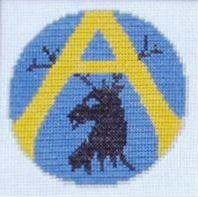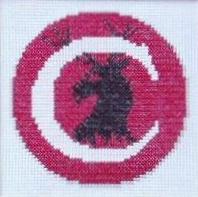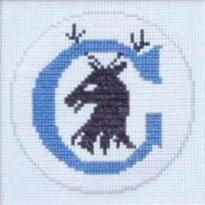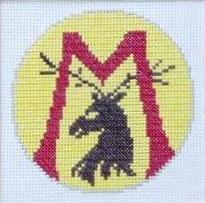I never knew much about my Uncle Frank’s death, apart from the fact that he’d died in an air crash. His letter to his sister, my mum, that I published two weeks ago, inspired me to search again for more information. This is what I found:
The Incident:
Aircraft WL J took off on a transit flight from RAF Reykjavík at 10:51 hrs, 15 March, 1942. The port engine failed on take off, the aircraft swung off the runway and hit an armory building. The aircraft was destroyed by a huge explosion and fire. All killed in the crash and rest in Fossvogur Cemetery:
P/O C Harrison †
P/O J H Hackett †
F/Sgt J G Turner †
F/Sgt L S Collins †
Sgt G H F Mc Clay †
LAC J W F Allan †
AC1 F Ryan †
(P/O = Pilot Officer; F/Sgt = Flight Sergeant; LA = Leading Aircraftman; AC1 = Aircraftman 1st Class)
The Aircraft:
Armstrong Whitworth A. W.38, Whitley Mk VII
Aircraft Code: WL J
Serial no: Z6807
Operator: 612 (County of Aberdeen) Squadron RAF
The Squadron was operating in Iceland from 15 Dec. 1941 to 18 August 1942.
Detachment from 12 Sep. 1941 to 3 Oct. 1941.
• Details on aircraft: Wikipedia.
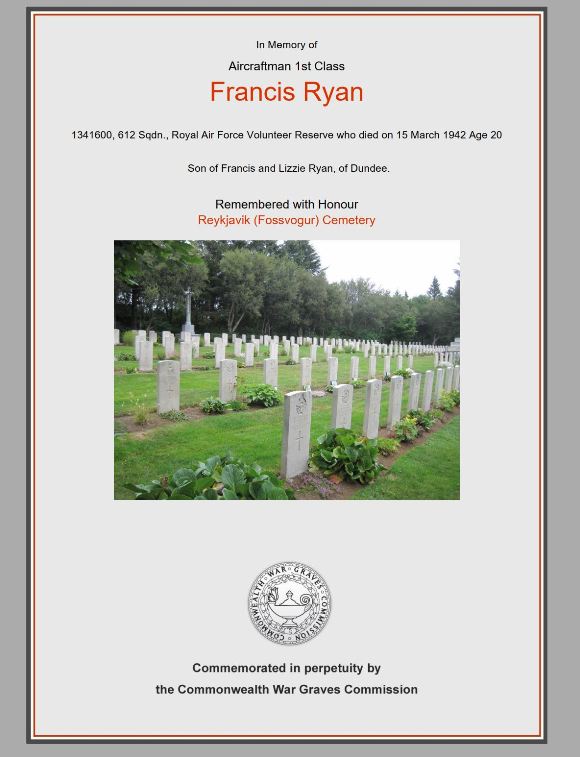 |
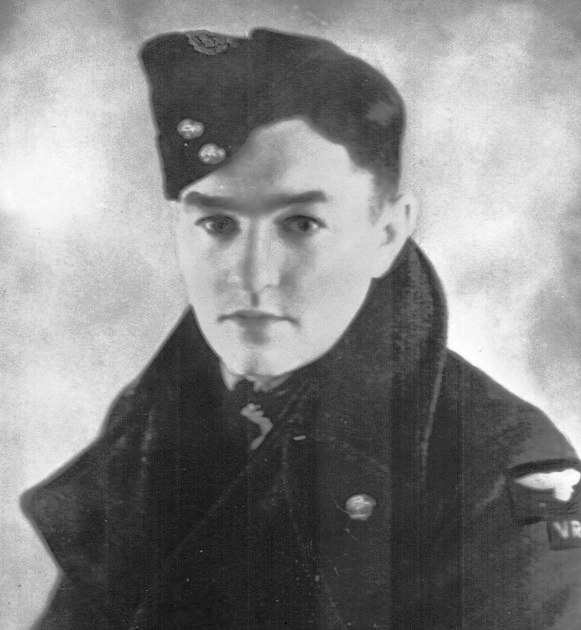 |
Frankie, nineteen years old
|
|
 |
 |
The Music and Dance of Scotland.
Brian Macdonald |
 |
 |
I have a more extensive knowledge of the music and dance culture of Scotland, the third of the three Celtic countries that make up Britain along with England.
My own land has little history of producing great classical or operatic singers. An internet search suggests that the rock-group singer, Annie Lennox, is Scotland’s most famous singer. She still performs, now aged seventy and her repertoire has broadened. She gained international fame with The Eurythmics in the 1980s and is by no means a folk singer.
The Celtic Rock Group, Runrig, originated on the Isle of Skye in 1973 and bade its farewell to an adoring Scottish audience of 52.000 in Stirling in 2018. Some of its numbers are in Gaelic. It can lay claim to being among Scotland’s best-known and most successful musicians. Runrig’s rendition of that most popular of Scottish folk-ballads, ‘Loch Lomond’, was always its closing number and created almost a riot as the audience enthusiastically joined in at every show in which Runrig performed. ‘Loch Lomond’ is thought to date from 1746, the year after the Seventeen Forty-Five Jacobite Rising of Bonnie Prince Charlie and to be the words of a Scottish Highlander, dying at the final battle of Culloden, who will be returning to Scotland in spirit by ‘the low road’ while his love can take ‘the high road’.
Scotland has a tradition of tenors who have specialised in Scottish songs and sopranos who have done likewise. The names of Kenneth McKellar, sometimes called Scotland’s finest singer, and soprano Moira Anderson, who often duetted with him, come to mind from my own era. These two became stars of Scottish TV in the 1950s and 1960s. The BBC, Britain’s publicly owned broadcaster, found it had a major hit on its hands, and not just in Scotland, with ‘The White Heather Club’ which ran from 1958 to 1968 on Scottish TV. The program was devoted to Scottish music, dancing, and comedy, for the Scots have an abiding fondness for their rich heritage of folk music and the tunes of Scottish Country Dancing. This Saturday evening program catered to Scots with a taste for the culture of their own country but had its detractors as presenting a parochial image of Scotland that was not to the country’s best advantage. The first presenter was the operatic singer, Robert Wilson. He was followed by the versatile singer, composer, and entertainer Andy Stewart, who rose to fame with the program and compered it for nine years.
The music for the show was mostly provided by Jimmy (later Sir Jimmy) Shand and his band, already well-known in Scotland for country dance music, when the program began. Shand was an ex-miner from Fife, a grim-faced, unsmiling man who disliked publicity and had no stage presence but was a genius at playing the accordion, an instrument popular in Scotland. Jimmy Shand and his band, with their strict tempo Scottish Country Dance music, were a delight to dance to and he has been called ‘The Victor Silvester’ (Silvester was the doyen of strict-tempo ballroom dance music in London) of Scottish music. Sir Jimmy Shand died aged ninety-two in the year 2000 and his band has been kept alive by his son of the same name.
Andy Stewart was a certain type of Scottish entertainer who flaunted his Scottishness. Born in Glasgow in the west of Scotland and raised in the fishing town of Arbroath on the east coast, he wore the kilt, sang Scottish ballads and comedy songs, and read poems, many his own compositions, and was always robustly ‘Scottish’. He was a prolific songwriter. A Scottish Soldier’ is a stirring song of his which endures and is also often played on Scotland’s national musical instrument, the bagpipes. ‘Campbelltown Loch’ and ‘Donald, Where’s Yer Troosers?’ are comedy songs he composed which also have remained popular in Scotland and ‘Donald’ is known to many outside its own country.
Stewart followed in the footsteps of Will Fyffe and Sir Harry Lauder, both of whom gained international fame. Lauder was reputed at one time to be the highest-paid entertainer in the world and performed in USA, Canada and Australia and headlined Britain’s annual Royal Command Variety Concert. Winston Churchill lauded him as ‘Scotland's greatest ever ambassador’ and the kilted Lauder with his cromach (Scottish long walking stick) was a familiar figure in newspapers and on screen. The White Heather Club’s Hogmanay program, which ushered in each new year at midnight on 1st January, always turned into an exuberant, well-lubricated party, featuring the accomplished comic actor, Duncan Macrae. His rendition of the comic song he wrote, ‘The Wee Cock Sparra’ was always a highlight.
But such uniquely Scottish entertainment is not the sum of Scotland’s musical culture. There is a catalogue of Scottish ballads that lend themselves to group singing, with tunes familiar to and loved by Scots. Many celebrate the land, such as ‘Westering Home’, which celebrates the island of Islay in the Inner Hebrides, famed for the peaty malt whiskies its distilleries produce. ‘The Road to The Isles’ praises the Isle of Skye, also of the Inner Hebrides. Mairi’s Wedding was written to honour the winning of the Mod, a Scottish Gaelic-language music festival comparable to but not as well-known as the Welsh Eisteddfod. Sir Hugh Roberton wrote lyrics to the tune which are enduringly popular.
Not by any means are all folk-ballads from antiquity; some are from poems composed by Scotland’s most-loved and famous poet, Robert Burns, in the 18th century. The well-known Skye Boat Song has lyrics written in Victorian England to an eighteenth-century tune and celebrates the escape of Bonnie Prince Charlie after the defeat at Culloden in 1746 that ended the second Jacobite Rising. The writer and scion of a lighthouse-building family, Robert Louis Stevenson, also wrote lyrics to the tune but they are not well-remembered.
A twentieth century song which has become a loved folk song and been adopted as the official anthem of Scotland’s rugby and football teams is “The Flower of Scotland’. Some think it an awful dirge, but it rouses patriotic sentiment in the breasts of many and is sung with gusto before international games. It was written by Ronnie Williamson, a member of the 1960s popular folk-revival duo, The Corries and celebrates the Scottish defeat of the English by Robert the Bruce (Robert 1st King of Scots) at the Battle of Bannockburn in 1314. ‘Football Crazy’ was a song written in the 1880s which was reworked as ‘Fitba’ Crazy’ by another sixty’s ballad-singing duo, Robin Hall and Jimmie MacGregor, and became a most unlikely runaway pop hit, but, alas, does not fit the mould as legitimate folk music.
Scotland can boast of its world-renowned Glasgow Orpheus Choir, founded by Hugh Roberton in 1901, at the dawn of the twentieth century and ruled by him for many years. Roberton was later knighted for his services to the arts. Unlike Treorchy, the Orpheus had both female and male members in its near-one hundred-strong band of singers, all of whom had to be of a high standard. Out of respect, the choir was disbanded on Roberton’s death in 1987 but was immediately replaced by the appropriately named Glasgow Phoenix Choir, which, good as it is, has not scaled the heights of fame of its predecessor as choral singing has largely gone out of favour as public entertainment.
But Scotland, while it does not lack singing credentials, leans more towards dance and the toe-tapping music of Scottish Country Dancing. There would never be a dinner dance held in Scotland that did not include at least one Scottish Country Dance. There are many dances, each with its own set of movements and dancing steps, normally danced by a set of four men and four women. There are three types. The reel is a fast, energetic dance, often performed enthusiastically as a ‘warmer-upper’ at events or later in the evening when dancers are more relaxed. There is much spinning of the couples and fast movement in a reel, often with the male dancers raising their arms and letting out loud skirls (shrill scream). The jig is a light-hearted and merry dance with skipping footsteps and the strathspey is a leisurely, graceful dance with gliding steps.
While dance display teams are composed of competent dancers, the men wearing a kilt and a long-sleeved white shirt and their partners in long white dresses with a tartan sash worn diagonally with a silver brooch at the right shoulder and the formality of steps and movements is rigorously maintained, this is not always the case with most dancers. For Scots who love to dance, informality is the rule with enjoyment rather than style and grace the objective. Dress is optional and the steps and movements are less strict. Apart from organised dances, Country Dancing is always a major part of a Scottish wedding or other celebratory party.
Scotland also has a flourishing tradition of Highland Dancing, competitive solo dancing whose birth was in the Scottish Highlands. It features intricate footwork on the toes and precise, formal movements. It has strong links to Scottish culture and history and is very athletic. Highland Dance competition is as much a staple of Highland Games gatherings, with bagpipe music as accompaniment, as are the Highland Sports, heavy field athletics events competed in by brawny men. The dancing is mostly performed by slim young women. The Sword Dance, an ancient dance of war performed on two swords, or a sword and its scabbard laid crosswise on the ground, is a well- known Highland dance. It is said to hail from as early as the 15th century and to be a celebration of victory, performed by both men and women, but frequently now by soldiers from Scottish regiments.
Each country will strongly maintain the reputation of its own music and dance culture, as it should. I hope I may be forgiven for my enthusiasm for Scotland’s treasure.
Just as Wales and Ireland have their harps as their national musical instruments, so does Scotland have the bagpipes. There are those who abhor the sound produced by bagpipes, but there are more who enjoy the stirring music they make. Bagpipe music is used to accompany dancing, stands alone, or is used in military bands, often with the pipe band providing marching music for a phalanx of kilted troops and is best heard in the open air. Other countries have adopted the bagpipes for military use from association with British troops or from a strong connection to Scotland, such as Canada. They are also native to some lands.
I was never a singer. My voice would have embarrassed a frog with a sore throat. I get my pleasure from music by listening to it and dancing to it. With the assistance of hearing aids, I can still listen to my outdated records, tapes, and CDs.
The dancing is ended but the memories linger on.
|
|
 |
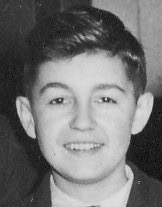 |
Family Treasure
Hugh McGrory |
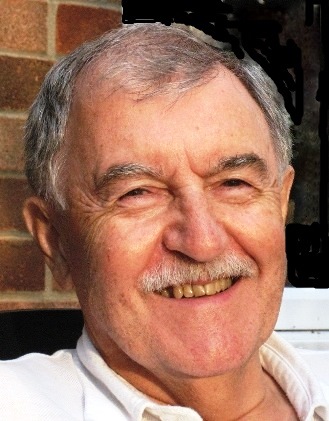 |
 |
My brother Mike has just returned to Yorkshire after spending a couple of weeks with us in Ontario. As our family archivist he brought a treasure that he had found amongst our Mum’s papers. I want to share it with you.
It’s a letter written by our Uncle Frank to our mother, his sister, while he was on active service in WW 2 . I was surprised at how profoundly it affected me to be holding the same pieces of paper that my uncle had touched and written on more than 80 years ago.
I’m going to let you read it before I add a few thoughts:
I was thrilled to see the letter. It was like a window had opened to let me see what life was like in wartime Scotland when I had just entered primary school (February 1942). For example…
The envelope leaves no doubt that this was wartime, from the “on active service overseas”, to Frank’s Id # 1341600, and the Censor’s stamp.
A brief background… Frank was the baby of the family, and growing up, he had three older sisters -for example, when he was 10, Evelyn was 22, Elsie (our Mum) was 16, and Eleanor was 14. Poor Frank - it must have been like having four mothers to keep him in line! They called him Frankie.
Apparently, I was a chatterbox/gasbag as a four year old – I’m surprised – I thought that I was a shy kid... It seems that Frank and his siblings were on very good terms and were able to correspond regularly - a credit to the logistical capabilities of the British forces – a morale booster, I’m sure.
Frank’s mention of nylon stockings rang a faint bell for me. These went on sale to the general public in the US on the 15th of May 1940 and were a resounding success.
About 192 million pairs had been produced by the time the US entered the war in December 1941, and DuPont turned over all nylon to the US War Production Board to be used for parachutes, rope, and any other essentials for the war effort. The availability of stockings for civilians became extremely limited, and women were encouraged to take good care of their stockings to make them last longer.
Many British service men felt that the US military were not only “Overfed, overpaid, oversexed, and over here”, but they seemed to be able to get their hands on bootlegged nylons, which in turn helped them to get their hands on British women... Uncle Frank probably used cigarettes to barter for nylons for his sisters.
On the subject of cigarettes, about 75% of the British troops were smokers, those who didn’t used them to trade for other goods. Uncle Frank seems to have been saving up cigarettes to take home on an upcoming leave that he was looking forward to.
It was heartwarming for me to feel the love that Frank felt for his family and which they reciprocated.
He wrote the letter on March 6, 1942. Nine days later he was killed.
|
|
 |
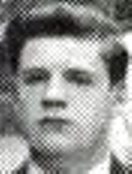 |
A Malta Highlight 2
Gordon Findlay |
 |
 |
There were a couple more marching displays, then it was time for the climax of the Retreat ceremony: the playing of The Last Post by the silver buglers of the Royal Marines. After all these years, I can still bring that scene to my mind as brightly and clearly as if it had happened yesterday.
We were brought to attention, sloped arms, and stood stiffly as, up on the ramparts high above the harbour, four Royal Marine buglers in their blue uniforms with the white belts, marched stiffly along the ramparts, then halted one after the other about four paces apart, and did a quick left turn to face into the parade square.
All the other lights around the parade square were then shut off, until there were only four spotlights shining on the four Royal Marine buglers.
They slowly raised their bugles and, as one, began to play. There was no other sound. The piercing notes of The Last Post soared out from the ramparts and went echoing around the parade ground, the pure notes rising high above the rocky escarpment then fading away across the dark waters of the Grand Harbor below.
Standing there at attention, I felt that shiver which jolts the spine, makes the skin pucker as if shocked by electricity. Not a shiver of fear or fright, but one of pure cosmic pleasure, something to tell you that this special time, this feeling, this moment, is like nothing you have ever felt before. The throat tightened as the pure and liquid notes of The Last Post rose and died away in the warm night sky.
I stood there, moved with emotion, and I thought to myself: “I never want this moment to end.”
|
|
 |
 |
Did You Wish You Were Here?
Bill Kidd |
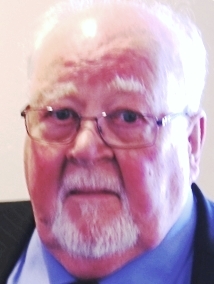 |
 |
It’s on the Cards
Cigarettes were an expensive luxury item until the 1880s when the invention of the cigarette making machine industrialised what had been a highly skilled handmade item. This with aid of aggressive marketing led to a worldwide cigarette smoking boom. Mechanically made cigarettes were sold in paper cartons that were vulnerable to damage and manufacturers introduced cardboard stiffeners to counter this. By the 1890s some market savvy salesman realised that by printing information and illustrations on the hitherto blank cardboard stiffeners a desirable item could be created. Within a few years a new collectable hobby, the collecting of cigarette cards, had evolved. The marketing folks quickly realised that by releasing a numbered series of up to fifty cards on a specific theme they had found a mechanism to ensure that smokers would be faithful to their brand. Over the next half-century cigarette cards and sometimes albums to house them were issued featuring film, radio and theatre stars, sportsmen and women, aviators, politicians, flora and fauna, and just about anything else that you can think of! This bonanza of collectible trivia continued in the UK until the WW2 need to save paper put and to it in 1940 when I was barely five years old.
I can remember asking for and being given cigarette cards by my uncles and family friends. I have no idea what I did with them or where they ended up and as they never made a reappearance after WW2 ended that was the sum total of my interest in cigarette cards. However, sometime towards the end of my primary school education the local shops around the school started selling a new catchpenny product, Swap Cards. These cards were sold, five in a packet, for 3d. The cards were of a similar size to cigarette cards, and they were printed on poor quality thin card with the illustration on one side and text on the other. As I recall, there were an assortment of topics in each package. The individual cards each had the series title and number and a brief text on one side and a tinted photograph, drawing or caricature on the obverse. Their quality bore little resemblance to the cigarette cards, but they were fun to have and play with.
Once these cards became fashionable with the majority of one’s school friends the serious business of swapping to build complete sets began. Soon a market built up, clearly some cards or series were more common than others and could command a premium. Complex bargains were struck, syndicates were formed, rumours of who had some hotly pursued treasure were circulated, theft and threats were not uncommon. I can still recall the sense of elation when my purchase contained the image of a longed-for film star or international footballer. It was a different story when I found cards that I already had in my new newly purchased pack.
Even the common duplicate cards served a purpose, those that could be profitably disposed of were swapped but those that remained became the important part of gambling games. As I recall there were two such games, the most popular was known as “Same or Diff.” This involved placing a card, unseen by your opponent, either picture up down on the back of one hand and covering it with the other. Your opponent, having done the same, guesses “Same or Different,” both players remove the hand covering their card, if both cards show the picture side or text side then whoever said “Same” wins and keeps both cards. Usually this game was played fairly and without rancour, but I do recall a major losing streak playing with a much older boy who cheated by placing his card between the palms of his hands and letting me show my card first. It took me a couple of sessions to realise that he could guarantee a win by simply turning his hand. (If you are reading this, I know who you are!) The second, less popular game was a version of Pitch and Toss that involved flicking cards towards a wall, the winning card was the one closest to it. There were many variants to this game but none of them ever appealed to me.
Collecting these cards continued to be popular for a couple of years then simply faded away. Their demise was probably due to the absence of the marketing effort that was put into cigarette cards as an aid to selling a particular brand of cigarettes. The Swap Cards of my day needed a similar and probably less dangerous product to support them. No doubt the forthcoming World Cup will see further issues of Panini Stickers. Imagine what a set of Scotland players would be worth if we won!
Note
Panini is an Italian company that produces books, comics, magazines, stickers, trading cards and other items through its collectibles and publishing subsidiaries. Headquartered in Modena, it is named after the Panini brothers who founded it in 1961.
|
|
 |
 |
Fellowship of the Ring
Hugh McGrory |
 |
 |
On arrival in Canada in 1966, I joined the consulting engineering firm that had offered me the position while I was still in Scotland . Sometime during that first year I noticed that many of my colleagues wore similar rings and finally asked one of them what that was all about. This is what I learned:
In 1907 work was underway on the Quebec bridge, crossing the mighty St. Lawrence River and destined to be one of the engineering wonders of the world. It would be the largest structure of its kind and the longest bridge in the world, outstripping the famous Firth of Forth Bridge in Scotland.
Sadly, on August 27th, due to a mix of incompetence and arrogance on the part of design and construction engineers, the bridge collapsed. Seventy five of the eighty six workers were killed including thirty three
world-renowned Mohawk ironworkers (Skywalkers) from the local Kahnawake community. The tragedy was compounded when ongoing construction of the ill-starred bridge was interrupted again on 11th September 1916, when a new centre span being hoisted into position fell into the river, killing a further thirteen men.
The bridge was finally completed and still serves today (it is the longest cantilever bridge in the world), but
the tragedy of its construction damaged the reputation of the engineering profession.
In 1922, a University of Toronto civil engineering Professor, Herbert Haultain, came up with an inspiring idea. He wanted to establish an organization to bring graduating Canadian engineers together and featuring a membership ceremony to highlight their ethical commitments to the citizens they serve – somewhat akin to the Hippocratic Oath of the medical profession (‘Do no harm’).
The Quebec Bridge tragedy acted as a catalyst, and the idea gained support from the Engineering Institute of Canada. Haultain contacted the Nobel Prize-winning author, Rudyard Kipling who had featured engineers in several of his works (particularly the ‘Sons of Martha’ in which he refers to all the engineers of the world, who toil ceaselessly to make sure that the world goes on functioning smoothly, letting the “Sons of Mary”, i.e. the rest of mankind, enjoy the fruits of their labour).
Kipling was interested, helped to design the ceremony, and wrote an Oath of Obligation. He said "The Ritual of the Calling of an Engineer has been instituted with the simple end of directing the young engineer towards a consciousness of his profession and its significance, and indicating to the older engineer his responsibilities in receiving, welcoming, and supporting the young engineers in their beginnings".
| |
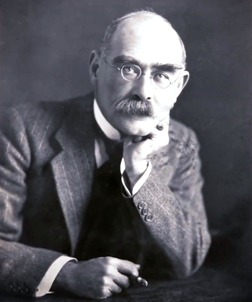
|
On completion of the ceremony, each engineer is allowed to select a ring that fits the small finger of his/her dominant hand, either made of iron or stainless steel, and is expected to wear it every day as a reminder of their Oath.
I liked the idea but assumed I was not eligible since I didn’t graduate from a Canadian University. However I later found out that the ceremony was encouraged for all
engineers licensed to practise in Canada, attended a ceremony at the University of Toronto, and became the proud owner of an Iron Ring that I wear to this day.
| |

|
|
|
 |
 |
The Music and Dance of Wales, Ireland, and England.
Brian Macdonald |
 |
 |
A remark in an email by a Welsh family member that he was going to settle down with a cup of tea and enjoy a broadcast of the Welsh National Eisteddfod got me thinking about the musical and dance cultures of the countries that make up the British Isles. It’s always a dangerous thing to generalise but here goes.
All four of Scotland, Ireland, England, and Wales have traditional folk songs much loved and kept alive, generation by generation. And not all folk songs must be from antiquity. From time-to-time new songs are composed which take the public’s fancy and become part of the fabric. The American group of Peter, Paul and Mary was one of the early groups of the 1960s folk revival, out of which many folk songs have come, to be adopted into the catalogue along with songs from antiquity and those composed over the centuries up to the present day.
But not all the four countries have the same powerful culture of music and poetry which is high in Welsh life. The word ‘Eisteddfod’ is from two words in the Welsh language meaning ‘sitting together.’ An annual Welsh National Eisteddfod at which specially composed songs and poems are performed takes place in August. There are competitions to decide the best contributions. There will also be displays of traditional dancing, which to me looks and sounds like a looser form of Scottish Country Dancing, something I have found to be the case of the folk dancing of other English-speaking countries. The basic format of a set of four couples performing figures and movements is likely to appeal to many diverse cultures.
At the Welsh National Eisteddfod a bard’s crown is competed for over the composition of a poem which must conform to a strict compositional form. The ceremonial ‘Chairing of the Bard’ is a highlight of the Eisteddfod, and the award is prestigious. A chair is designed and constructed specifically to be ‘The Bard’s Chair’ each year. There may be no bard chosen if the judges deem the quality of the entries to be of too low a standard.
Wales also has a flourishing tradition of choral music and there are many choirs, often male voice choirs such as the world-famous Treorchy Male Voice Choir, male because 150 years ago, when the choir was founded, women did not participate in such organisations. Choral music fitted with but was not confined to the Welsh devotion to the Christian religion and hymn-singing. The Welsh harp is not just a musical instrument that may accompany a choir or with the harpist as a solo singer but is a national symbol. Wales has also produced fine tenors. The name Harry Secombe will be known to many of my generation. Secombe was not only an actor and a comedian but had a good tenor voice and made a number of records that sold well. He was also a founder-member of The Goons, who revolutionised radio comedy in the 1950s when radio was king and who inspired a generation of schoolboy imitators. Aled Jones is a current Welsh tenor of note and Bryn Terfel is a fine operatic bass-baritone.
I do not know of a comparable national music and poetry celebration native to England, Ireland, or Scotland, although Scotland does have a Gaelic music festival. We each celebrate our nationhood by voice in our own way. England has a robust history of folk songs of regional significance. Often thought to be ancient is ‘The Lass of Richmond Hill’, a rousing love ballad written in 1789, that celebrates an admired young woman of the historic hill town of Richmond in Yorkshire, not the town of the same name in Surrey, as many think. That town, largely flat, is best known for the splendid Hampton Court Palace, built by Henry VIII’s advisor Cardinal Wolsey to be his home, and later gifted, involuntarily, to Henry.
England does not have a general dancing culture. Morris Dancing, dating from the fifteenth century, is seen live and on TV but is usually performed in a town square or a street by a team of male dancers wearing white clothing and traditional bells on their shins and shoes. Sticks, swords, and handkerchiefs are common accessories. A solo musician or band, in the same costume, will accompany them.
England is strong in classical and operatic music and has produced many fine singers. A favourite of mine was Kathleen Ferrier, a rich-voiced contralto from Lancashire. Her fame as a stage, concert and recording artist was international. She died in 1953 at a young forty-one, without fulfilling her promise.
England has long been fond of opera and has several highly regarded opera companies. The Savoy Opera Company and the Doyly Carte Opera Company are two noted companies which specialise in light opera. W.S. Gilbert and Arthur Sullivan created several comic operas in the late Victorian era which continue to be enjoyed by audiences.
The former coalmining areas of England have a history of brass bands from close-knit coalmining communities and of competing with one another at festivals. The Grimethorpe Colliery Band, formed in 1917, is one of the most successful and continues long after the local coalmine was closed. It was used in a film, ‘Brassed Off’ which is based on that community’s social and economic struggles caused by the mine’s closure when coalmining virtually disappeared in England in the late twentieth century.
Ireland’s song tradition, in Gaelic and English, is thriving and lends itself to ad hoc group singing. A fond memory of mine is of wandering into an empty room in a country bar in County Cork with my wife, for a quiet drink, late one afternoon. The room slowly filled with silent people, until a fiddle-player walked in. This was what folk had been waiting for and an evening-long singsong of folk music ensued.
Many Irish folk songs are patriotic, for the three provinces, Leinster, Munster, and Connaught, that now comprise Eire suffered long under English domination, with the majority native Irish population poor and oppressed and longing for freedom from the English yoke. To many Irish the fourth province of Ulster, which forms Northern Ireland, still a part of Britain, should be part of free Eire and they believe that the struggle for freedom is not over. Ireland has a tradition of producing tenors and there is a library of sentimental songs to suit such voices. ‘Danny Boy’ and ‘When Irish Eyes Are Smiling’ are two examples of this genre. John McCormack is the best-known Irish tenor of the 20th century.
Not all folk songs are centuries old. The singer Domic Behan, of the 1960s Irish folk group, The Dubliners, wrote an Irish version of a song, originally about Newfoundland, called ‘Thank God We’re Surrounded by Water’. It became wildly popular in Ireland, and its chorus was sung with gusto at dances as an accompaniment to uninhibited dancing. It is still enjoyed as a patriotic Irish folk song.
The sea, oh the sea, is the grá geal mo chroí
Long may it roll between England and me
It's one sure guarantee that some hour we'll be free
Thank God we're surrounded by water.
(Note:The Irish phrase Grá Geal Mo Chroí is pronounced graw gee-yal mu chree. It translates to "shining love of my heart" and is a poetic expression of deep affection, similar to "my darling".)
‘Tommy Makem and the Clancy Brothers’ was an American Irish folk group of the same era which became hugely successful in Ireland and many of their songs had a patriotic flavour. ‘Johnson’s Motor Car’, written in 1921, celebrates an Irish Republican Army ambush of a doctor in Northern Ireland to steal his car for their rebel activities. ‘Kevin Barry’ is an Irish rebel ballad. It tells of the death of Kevin Barry, an Irish Republican Army member who was hanged in 1920. The Northern Irish Loyalist equivalent is ‘The Sash’ (aka The Sash My Father Wore), which is the anthem of the Royalist Orange Order and celebrated the Protestant William of Orange’s (William IV of England) winning of crucial battles in Ireland in the seventeenth century. The singing of either by its adherents in public is likely to lead to a rendition of the other by an opposing group, and an escalation.
Irish dance, with its formal, straight-backed, arms unmoving and straight down by your sides posture, is an unusual style of dance and has both solo and group forms. It is believed to have its roots in ancient Celtic dance. It still features strongly as a competitive art form at festivals, and is now mostly performed by girls.
In the 1990s, the American Irish dancer, Michael Flatley, took the world by storm, with the ‘Riverdance’ stage show that showcased Irish Dance as popular entertainment and continued with more shows till recent years when advancing age curtailed this strenuous form of dancing for him. Flatley, with his snake hips, slim physique and nimble legs, adapted Irish Dance as a spectacle with new movements and large dance troupes dancing in strict tempo. Riverdance and its successor shows live and on TV were extremely popular. Flatley's shows have played to more than sixty million people in sixty countries, have grossed more than US$1 billion and have reinvented Irish Dancing as an art form and as entertainment.
The Irish harp, also known as the Celtic harp, is a national symbol of Ireland and a significant part of its cultural heritage. With a history of a thousand years, it has enjoyed a twentieth century resurgence. It is used by the Guinness brewing company on its label and by other Irish organisations and companies and features on the Irish Coat of Arms. It is related to the Welsh harp and to similar instruments of other Celtic countries.
|
|
 |
 |
Caring and Sharing
Hugh McGrory |
 |
 |
My wife, Sheila, has a part-time volunteer job at the local Care and Share Thrift Store in Stouffville. The store is run by the Mennonite Central Committee. The Mennonites are a religious community based in southwestern Ontario. Their core values are a commitment to Christianity, hard work, family and community.
On the business side, they operate a number of farms, farmers markets, a restaurant and several thrift stores. All the profits from the thrift stores are given to local and international charities, such as the local food bank, homeless shelters, support for victims of the wars in Ukraine and Gaza, etc. Last year, the store cleared over $1 million in profit. This year, they are on track to do more.
Items sold in the store include housewares, clothing, sporting goods, books, games, toys, electronics, bedding, some furnishings, hardware, tools, stationery, pictures, craft supplies, etc. The store receives donations from people in the community which are then sorted, priced and sold. Prices are very reasonable. Stock remains for no longer than one month it’s sold at a large discount to another organization to support the needy. The stock changes quickly and depends on the donations, so customers never know what they will find. Customers say that shopping in the store is like treasure-hunting.
Customers include:
- folks setting up a new home, cottage
- students looking for household goods for their dormitories
- people looking for inexpensive work clothes, party clothes
- immigrants setting up new homes in Canada
- folks looking for Christmas or birthday presents
- parents and grandparents with kids in tow looking for new toys, puzzles, educational items
- teenagers looking for sports equipment
- golfers and tennis players looking for cheap balls
- poor people, rich people, all sorts really.
The store is about 15,000 square feet in size and is staffed by seven permanent staff (the managers) and about 200 volunteers. Many of the volunteers are high school or college/university students getting work experience. Many are retirees looking for a hobby through which they can contribute to charity in the community.
There is a section of the store where high-end, unique donated items are on display in a big showcase. Items are numbered and customers register and bid on them anonymously. There are incredible deals to be had in this area.
For example:
- four high-end designer label ladies’ purses, thousands of dollars retail, for less than $100
- a set of 12 boxes of Lego for children, again retail value of thousands for less than $100
- a violin in a wooden case, over $2000 retail sold for $400
- a set of 25 Royal Doulton china dolls, thousands at retail, for $300
- collection of vinyl records by the Beatles, Rolling Stones and other great stars for $400.
You get the idea. This section is watched by customers looking for a deal. It’s not unusual to see customers monitoring the showcase and the amounts-bid sheets and then checking via their phones for the same or similar items on online bidding sites such as eBay.
Sheila says that there are a lot of people who are regulars. Some of them have told her that they love the store. It’s a nice cool place in the summer, a nice warm place in the winter, they can wander up and down the aisles at their leisure, no one bothers them, there is nice easy-listening ‘Golden Oldies’ music that everyone is familiar with playing in the background and many customers hum or sing along to it.
There are a few people who shop at this and other thrift stores for ‘deals’. It could be high-end women’s clothing or household goods. They buy the items and re-market them on other specialty websites, such as PoshMark which allows people to re-sell women’s clothing and fashion items. Sheila’s hairdresser says that one of her clients does this as a full-time business and makes a good living at it.
You never know what will sell. Sometimes the most unlikely items are gone almost immediately. A lamp in the shape of a guitar took less than 15 minutes to sell. A pair of women’s shoes with five inch heels and lots of rhinestones took 10 minutes. Staff couldn’t even get it onto the shelf because three women spotted them and stood in line to try them on. Mason jars are very popular even if the lids need to be thoroughly cleaned. On the other hand, some items seem to sit for quite a while. For example, complete dish sets, a large Waterford crystal bowl, retail several hundred dollars and priced at $40, vintage dolls, virtual reality headsets, fondue sets, coffee makers, air fryers. As mentioned, those unsold items are moved on after a month and sent to an organization that provides them to the needy.
Due to changes in the economy, thrift stores seem to be increasing in number, and they do have the extra benefit of being a sensible way to recycle products and reduce the amount of goods being send to landfills.
Some people seem to regard them as ‘junk shops’ and it’s true, there is some questionable stuff in them - but ‘one man’s junk is another man’s treasure’, and treasure-hunting has fascinated people for centuries.
|
|
 |
 |
More Coincidences...
Jim Howie |
 |
 |
Recently, on leaving our holiday cottage in Kirkcudbright (pronounced Kir-COO-bree, about 180 miles from our home in Dundee) we stopped to admire our neighbour’s garden. As we did so a couple of similar age approached, and we got into conversation with them.
My wife asked where they were from, and “Kilmarnock” was the reply - we told them we were Dundonians and on holiday - the man said “I used to play for Dundee Football Club". I asked his name, and he said “Ian Ure”. Then came my Doctor Livingstone moment when I replied (not “Oh, I remember you playing”) but - wait for it...”You were Raymond Stern's Best Man.” He was flabbergasted…
I phoned may old schoolmate Raymond, and after a conversation, told him I had someone beside me who would like to speak to him and handed the phone to Ian. Raymond was blown away at the coincidence.
In a further coincidence Ian Ure had lived in Barnes Avenue while playing for Dundee, and I was born on that street!
You couldn't make it up… and we’re not done yet:
Five days after meeting Ian Ure I was speaking to Paul Hegarty Dundee United Football Club’s League-winning captain, and a centre half like Ure.
So, two league-winning, Scottish International centre halves within less than a week - not bad going for an octogenarian!
|
|
Any time I see a baby on TV my mind always says “Ahhh” to me - it almost always makes me smile and sometimes l even laugh out loud… I suspect you may well react the same way – probably baked into us through natural selection.
Speaking of which, have any of you ever looked at a baby and thought to yourself “Babies are so helpless and inept how does the human race manage to perpetuate itself?” Presumably the answer also lies in the natural selection processes of evolution. I decided to explore the issue:
 |
"Oh for pity’s sake - what the hell is altriciality?"
|
Altriciality is the opposite of precociality, of course. Precocial species in birds and mammals are those in which the young are relatively mature and mobile from the moment of birth or hatching. Horses for example - newborn foals are neurologically mature and are capable of standing, walking, and coordinating their bodies shortly after birth - this allows them to flee danger and nurse from their mothers relatively soon after being born. Some ducks are born fully feathered and able to swim after their mother almost immediately after birth.
Altricial species are those in which the young are underdeveloped at the time of birth and require the aid of their parents to mature after birth. Humans of course, domestic cats and dogs, most rodents, and many birds like songbirds, hawks, and owls.
So how does this give humans an advantage over other species? There are a number of reasons:
Forty weeks seems to be, on average, the optimum time for human gestation. It ensures that the baby’s head doesn’t exceed the size of the mother’s pelvis. It’s also a sweet spot in the trade-off between the physical demands on the mother’s body versus the benefit for further development of the baby in the womb.
The baby’s head and brain continue to develop after birth enabling sophisticated cognition, language, and social learning at the expense of having to be supported by parents for a longer period.
Being helpless encourages infants to focus on their caregivers, leading to the development of strong social bonds and the ability to learn complex social skills, language, and culture.
When I look at the photo above, I have to think that the process of natural selection has done a pretty good job over the past millions of years.
Bet you smiled at both photos...
|
|
 |
 |
The Case of the Swedish Ambassador’s Daughter 2
Clive Yates |
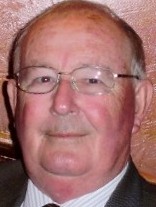 |
 |
The long over-night London sleeper train pulled into Leuchars island platform, and I was standing there looking about me to see if anyone was alighting. I noted the guard taking luggage off at the head of the train. I looked for the passenger, and after a brief delay, a young lady popped into view at the very far end of the long line of sleeper-carriages. I went to meet her as she took in the windswept fields surrounding the island platform. By the time I reached her, I heard the clatter of doors, the guard’s whistle, and immediately the train began to move away northwards. When I reached the young lass, I turned around and saw that there was now a long, deserted, platform.
The young lady became visibly distressed telling me that the guard had not off-loaded her trunk from the Guard’s van at the head of the train. Full of confidence, I asked if it had the special ‘St. Andrews’ sticker on it? Assured by her that it did, I comforted her by confidently saying that it would be taken off at Dundee, and not to worry. for I would ‘rescue’ it later that day when I went to Dundee. The Porter reassuringly told me he had re-loaded the Trunk because it did have ‘our’ special stickers on it. I took the young lady as a passenger to her Hall of Residence where she was duly made welcome. Much later that morning, I went to collect a load of luggage from Dundee bound for St Andrews and took the opportunity to search around for this specific ‘arrival’ from that morning train.
It was NOT there! Worse still, nobody at Tay Bridge station recollected it being off-loaded from this London-Aberdeen sleeper. I asked them to telephone Aberdeen and to start a search for it. Perhaps, too confidently I reasoned (not unreasonably) that the same sleeper carriages would be re-used for the next evening South-bound London sleeper. Again, no joy. Then came some unwanted and really bad news! Contrary to all my thinking that the carriages would remain coupled together, I discovered that this guard’s van had been re-used on a Cross-Country express departure that very morning from Aberdeen to Penzance. Now even worse news! This same guard’s van had already passed through Dundee and Leuchars on it’s southbound journey by the time I was informed, and had not been checked by Leuchar’s staff who had absolutely no reason to expect ‘stickered’ luggage from the North! It only had arrived on ‘local’ trains going North!
A degree of concern - actually, blind panic - began to set in at this point, especially as by 6 o’clock in the evening, I had to visit University Hall to advise an overly protective Warden that somehow, we had lost her charges ‘trunk’ containing all her belongings. I dutifully grovelled, apologised, and suggested that the young lady be assisted with whatever she needed at ‘My’ expense in the meantime.
Later that evening, I re-visited Leuchars station staff and explained what had happened and they agreed to instigate search proceedings throughout the British Rail network seeking information as to the present whereabouts, and urgent return of ‘the trunk’! I had to give all the details to them including the young ladies name, and it was at this juncture, I took the liberty of ’upping the anti’ by adding an ‘inspirational’, fabricated detail ! The young ladies real name had a Scandinavian ring to it (and for present confidentiality, I ‘encrypt’ it now as ‘Olafsdotter’!) In desperation, I gave British rail employees her proper name – adding that I had been told that she was... ‘The Swedish Ambassador’s Daughter', and all Hell was being let loose!
On the following day, about midday, we had a telephone message to the Students Union that the trunk had been located somewhere in the West Country and it was being re-routed back through London for onward travel to St Andrews. Good News and relief for me in particular. Later that same day, I was informed that the ‘trunk’ had been delivered from Edinburgh by courier delivery direct to University Hall. As far as I was concerned, “all’s well that ended well!” It was now firmly in the past. Everybody had done their job; been rewarded; enjoyed their ‘tips’, beers, and curried flavours. Now to the serious business of endless Studies and complaining about the food!
Except there was a sequel. At a Student Union reception for ‘Freshers Week’ workers - to which I was invited a few weeks later, the Master of the University, (the late Dr Kay McIver) sidled up to me during the reception and was chatting away generally about ‘other-things’ when she suddenly switched topic with an incidental... “I must thank you personally for rescuing the ‘lost trunk ...”
(I had to guess she probably had been informed about it by the Hall Warden.) Fortunately, I did not react in any way, but simply just listened to see where this was going. Warily and vaguely, I defensively muttered that I had only done what any reasonable person would have done to rectify the situation.
Suddenly, completely out of the blue, she went on to enlighten me for the first time that the British Railways Chairman’s Secretary had telephoned personally to the Principal of the University, (Prof. Stephen Watson) to offer sincere apologies for the embarrassment caused by having lost this trunk in the first place, and to advise him that they had located the missing article, couriered it to London Heathrow; sent it on the next available flight to Turnhouse Edinburgh, and that it would be delivered safely by courier to its owner in St. Andrews.
Immediately, my sixth sense warned me we had moved into completely uncharted and extremely dangerous territory! Then, fixing me with a glint in her intimidating eyes; she pounced and posed her intended question.
“I wonder where on Earth these people got hold of this ridiculous story that the ‘Trunk’ belonged to the Swedish Ambassador’s daughter?”
“Don’t ask me, Dr McIver...
Perhaps I can get you another Sherry?”
|
|
 |
 |
The Case of the Swedish Ambassador’s Daughter 1
Clive Yates |
 |
 |
I went to the University of St Andrews in 1977 at the age of 39. One would be correct to say that I was a very ‘late’ developer! Excepting by then I was commercially ‘worldly-wise’ and always quick to spot opportunities to obtain extra ‘pocket money’ when the occasion arose.
Many will know that St. Andrews no longer had its own railway station (thanks to Dr Beeching) and had to rely upon nearby Leuchars Junction, for local services, and for two daily direct trains from or to London (including the ‘Aberdonian’ Over-Night Sleeper.). British Rail did offer its passengers who advance-purchased their tickets a helpful option to forward their luggage 'in advance' to the destination station on proof of their actual ticket.
I persuaded the Students Union Council to advertise this widely to incoming ‘freshers’ (some 60-70% of our students came from the South.) I then offered and ‘contracted’ myself to collect and deliver that luggage (for an appropriate ‘fee’) from the station to Halls of Residence. We advised incoming students about this facility and provided them with instructions and a special WHITE sticker with a BLUE St Andrews Cross with their name and Hall details. These were to be affixed prominently to one end of each item (trunk, bike-saddle, cases.)
The Union expected me to pay all my own expenses from these associated pre-paid fees. This proved to be an absolute ‘El Dorado’ which supplemented my student grant enormously. Many distant ‘English domiciled’ parents positively encouraged their offspring to use rail (rather than parents travel time commitment and over-night expenses incurred in assisting them). We simply were inundated with requests –and to my delight and much more to the point, the prepaid ‘fee’ cheques!!
So far, so good ... except Leuchars Station had not sufficient storage space available. However, they did agree to re-direct trunks, bicycles and other cases forward to Dundee Tay Bridge Station which had plenty of indoor space. Problem solved! Despite the extra distance involved, it allowed me to store, sort, and optimise for my own convenience deliveries into each Hall of residence. I did not tell anyone that I had the free use of my brother’s large, 35-cwt Volkswagen van in Dundee. The sorting task kept me busy for several days at the beginning of several successive ‘Annual’ Freshers Weeks. It really was a dream operation where I was able to employ others willing to collect fees and answer queries at a help desk in the ‘Union’ in return for smokes, beers, meals, and a celebration Curry meal at completion.
All went well, successfully, and very profitably, ... ... until one Tuesday morning when I met the over-night London sleeper train at Leuchars at seven in the morning, and the Swedish Ambassador’s daughter entered the picture…
To be continued…
|
|
 |
 |
Telegram Boys
Hugh McGrory |
 |
 |
During World War 2, over a nine-month period in 1941/42, my grandparents shared the sad experience of losing a son – so my dad lost a brother, Wullie (who died at the age of 32 when his merchant ship was torpedoed mid-Atlantic), and my mum also lost a brother, Frank (who died at the age of 20 in an RAF airplane crash in Iceland).
I was four at the time, so I don’t remember anything of that traumatic period for our family, but it occurs to me that my grandparents on both sides of the family most probably received the 'dreaded telegram' such as the one below.
In the first half of the 20th century the ‘last mile’ of telegram delivery was by means of cadres of ‘Telegram Boys' who worked for the GPO (General Post Office) until the service was ended in 1982. These were boys from 14 to 17 (school-leaving age was 14, and at 18 boys could become postmen). They were paid about one pound per week and worked six eight-hour days. They were provided with two uniforms a year, one winter and one summer weight plus one pair of shoes and one pair of boots a year, plus overcoat and walking cape and a pillbox-type hat. They were also provided with one of the heavy old red bicycles used by the Post Office at the time.
| |
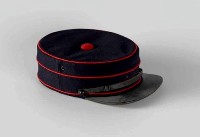
|
The delivery protocol was that the boy knocked on the door, gave the telegram to the addressee, then waited to see if there was a reply (if so, they wrote it down on a form then took it back to headquarters).
With the advent of war, a change had to be made. Imagine this scenario… a 14 year old kid knocks on the door, the lady of the house opens it and reads the message - basically it says, “Sorry, your husband / son has been killed in action.” What happened next would have ranged over a spectrum of reactions, not one of them likely to be well-handled by the poor young messenger boy.
A change was made so that ‘death/ injury/ missing’ telegrams were identified so that when faced with such a delivery the telegram boy would simply hand it over then depart immediately.
A telephone boy relating, in his old age, his experiences said, “I can remember delivering one such telegram to a 3rd floor flat and, having handed it to the lady turned to go back to the lift and whilst waiting for it to come I could hear screams and smashing crockery coming from the flat I had just left.”
Another said “I can still remember vividly a lady who on seeing me at the door when she opened it, took the telegram, danced a little jig in front of me, and called to someone at the rear of the house "Oh, its a telegram from Bill, - he's coming home on leave and has sent a telegram to say what train he will be on" . Alas it was not to be, it was a message from the War Office to tell her that he had been killed in action. On reading the message, the poor girl collapsed in front of me and sobbed her heart out. I was then only 14 or 15 years old, and I hadn't witnessed an adult react quite like this before. I felt so helpless and didn't know what to do."
People were very sensitized to the sight of a telegram boy appearing on the street, hoping it wasn’t for them, and when it wasn’t, there would be an army of womenfolk descending on the bereaved house and they would take over the practical side of things, like taking the children away, making tea, and generally just being there.
Almost ten years after losing her youngest child, Frank my (by then widowed) gran on my mother's side received the letter below from the British Legation in Reykjavik:
|
|
 |
 |
A Malta Highlight 1
Gordon Findlay |
 |
 |
One of the highlights of my time in Malta was the Retreat ceremony. This was a once-a-year event staged on the parade ground overlooking the grand harbor of Valetta – one of the truly great views on the island. Essentially it was “showing the flag”, a chance for the British and allied troops on Malta to put on a show for the islanders.
The big day itself, of course, was preceded by a full day of preparation: washing, cleaning and blanco-ing of belts and webbing, polishing brassware, brogues and boots, pressing kilts, brushing bonnets, cleaning and shining up rifles. Everyone was involved. Even we nerds in Intelligence would be marching with the rest of 1st Highland Light Infantry in best battledress tunics, kilts and sporrans, checked hose, white gaiters and brogues.
The parade began around 4.00 o‘clock in our barracks at Aijn Tuffeiah with an inspection by our own C.O. Then we piled into 3-ton trucks and were driven to the outskirts of Valletta, where we formed up behind our own pipe band (a very good one) and a military band from the Royal Marines.
I think there was also a regiment of the Kings Own Scottish Borderers on hand, since they were in Malta at the same time as we were.
Around 6.00 p.m. the sun was still bright but beginning to come down, when the ceremonial march through the city began. The bands struck up the first notes, we came to attention, sloped arms, our R.S.M. screamed out “Quick March!” and to the strains of “Scotland the Brave” our columns moved off, thumping in unison down the rough stone streets of Valetta.
I have to be honest: there’s no feeling quite like it: in your best outfit, your kilt swinging above your knees, shoulder-to-shoulder with your mates, rifle on your
shoulder, eyes fixed straight ahead, chin up, hearing the steady beat of the kettle drums and the wailing of the pipes backed up by the thumping notes of the military band, marching past the throngs of Maltese lining the streets, waving and clapping and cheering . . . Man oh man! You feel ten feet tall.
We marched down to the big parade square which was ringed with elevated seats for spectators plus a grandstand for the VIPs just as the shadows lengthened and darkness fell over the island. One by one the various units came crashing to a halt, we ordered arms, and the Retreat ceremony began.
It featured the massed bands playing some famous marching songs like “Colonel Bogey”; there was a bit of countermarching from a couple of drill squads, and a display of drumming from our own pipe band.
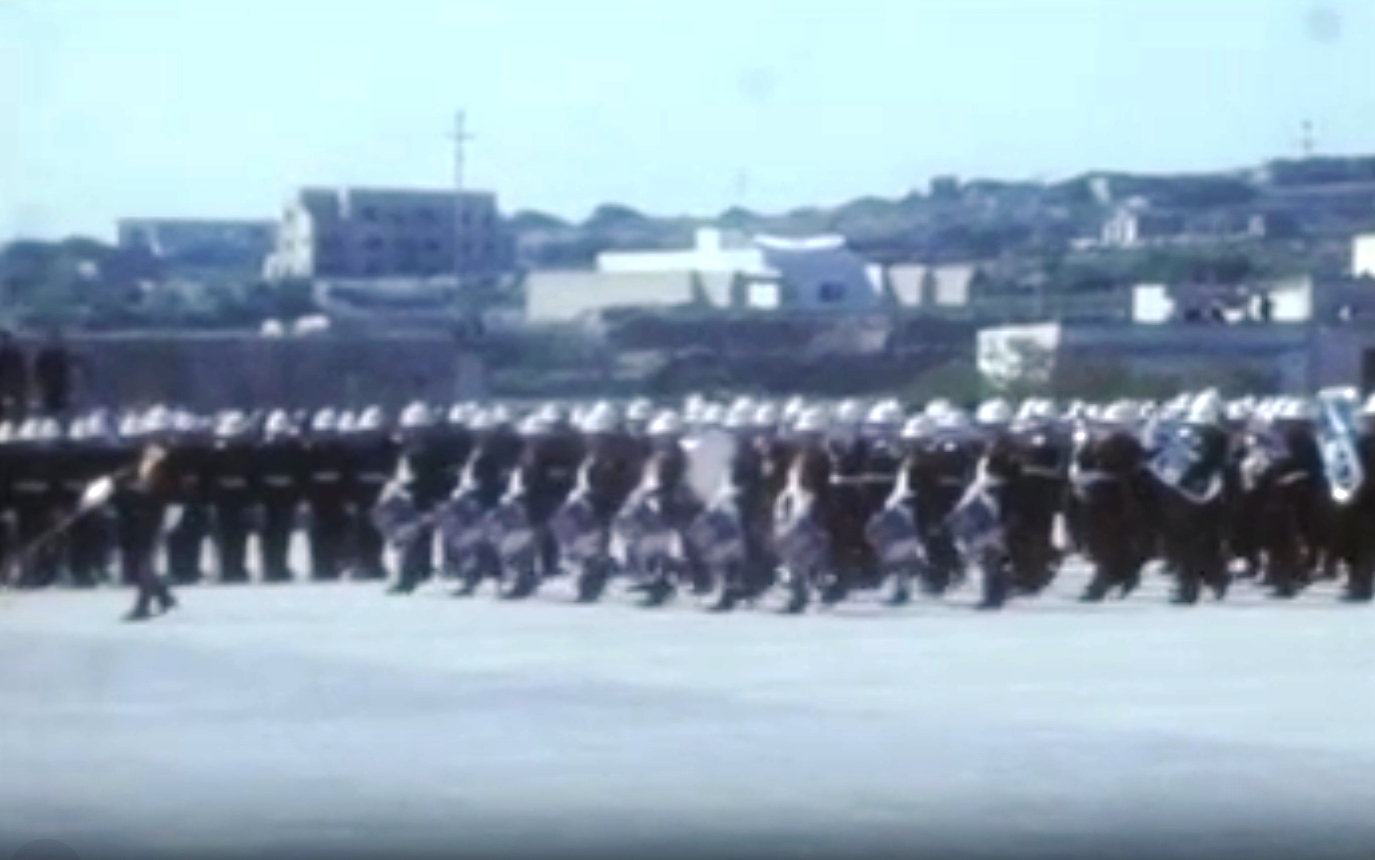 |
Massed bands on Parade Ground in Valetta back in the day.
|
I recall there was also an inspection by the Maltese prime minister, the local Governor, and a visiting dignitary from Britain, plus the mayor of Valetta. By then it was dark and the spotlights around the square came on.
To be continued...
|
|
 |
 |
Testing ...Testing...
Hugh McGrory |
 |
 |
Spending so much time on these stories over the last ten years has resulted in a lot of introspection on my part. One of the things I’ve recognised is that I like being tested. I like measuring myself against various norms to see how I do…
Maybe this was something I grew into, since I remember, in early primary school, each of us being asked by the teacher to stand up and do some very simple mental arithmetic – and hating it. I don’t know if I just wasn’t very good at it, or perhaps, because of my shyness, I didn’t like being in the spotlight. However, by the time the 11+ came along I seem to have adapted to sitting tests/exams and quite enjoyed the experience.
( The 11+ examination tested a student's ability to solve problems using verbal and nonverbal reasoning in mathematics and English. The intention was that the eleven-plus should be a general test for intelligence (cognitive ability) similar to an IQ test. Students were then streamed to an academy, for five or six years, or to a secondary school, for three years.)
I remember we were also told that we were going to take part in a comparison of the English and Scottish systems by sitting the English version of the 11+. We duly sat this exam, which I quite enjoyed, - we never did hear how they compared…
When I was about twelve the Dundee Police began offering the Cycling Proficiency Test. I tried to get some of my classmates, or my street buddies interested to no avail, so I went on my own, one Saturday morning, to St. Michael’s Secondary School in Grahame St. The school playground was laid out with tape as a small
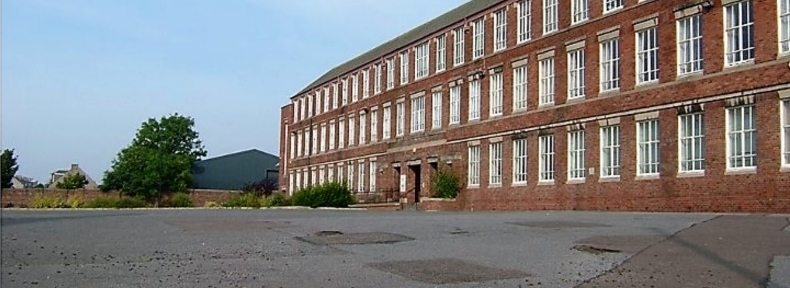 |
The school playground as it was then. St. Michael's closed in 1975.
|
street circuit. A big, intimidating, policeman was in charge, and we were asked to do various manoeuvres, stopping and starting, left and right turns, in and out of pylons etc. For everything we did we had to use the proper hand-signals. I’m told there was also a written test, but I don’t remember that. After a final critique I cycled home to show my parents my certificate…
In retrospect, I think the test was good conceptually, but I don’t think it did much, in the long run, to change the way I rode.
I’ve talked about the wall across the street from my home and how I challenged it ‘because it was there’. If you’re interested the story's here.
When I was working in the engineering department in Glenrothes. Fife, we used to get together each morning for a ten minute coffee break in the drawing office. Someone drew our attention to an advert for Mensa in a magazine. It offered a small test which you could try, then send it to them. If you did well, you’d be allowed to sit the official membership test. (Mensa is an international organization for individuals who score in the top 2% of the general population on standardized intelligence tests. It was founded in 1946 in England with the goal of providing a stimulating intellectual and social environment for its members. The name "Mensa" is Latin for "table," symbolizing a round-table society where all members are considered equal regardless of background.)
As a lark, we copied the test and about ten of us each completed it and sent it in. A week or so later most of us were invited to come to Edinburgh to sit the supervised test. I said, “Lets go guys.” I got no interest – nobody wanted to try.
The trip was about an hour by car and the small fee covered the test and the first year’s membership. So I signed up and went and sat the entry test on my own. (Re. the result, in simple terms, if you passed, then met with 99 random people, then one would be ‘smarter’ than you, and 98 would not.) Some cynics say that all the test really tells about you is how good you are at doing such tests…
So do I now have a seat at the table? Well, actually, no. They invited me, but I didn’t accept the offer.
Interestingly, some dozen years later, I sat the SAT exam for admission to the MBA program at the University of Toronto and got almost exactly the same result.
I’ve mentioned in the past that I played squash twice a week for about thirty years ending when I was 69. I loved testing myself against my opponent in a mano a mano competition – elation when you won and no excuses when you lost...
Finally, it’s good to remember that so-called ‘smart’ people can still do stupid things:
In the nature (DNA, genetics) v nurture (environment) controversy regarding what shapes our traits and characteristics I believe it’s about 50/50. Regardless, and no credit to us, my brother and I together with our two double cousins seemed to strike it lucky. We seem to have come from two lines of ‘good’ DNA and were brought up in loving, supportive families. We four became two Chartered Accountants, a Doctor and a Professional Engineer.
Which brings me back to ‘stupid’ and a lesson learned the hard way:
In my civil engineering studies at university, first year was not too heavy, so I didn’t need to do a lot of prep for exams. ( I suspect that I put this down to me being smart, forgetting perhaps, that much of the stuff we studied had been covered in our sixth year at school.)
Second year was different! The final consisted of exams in nine different subjects. I, of course didn’t need to spend much time studying for the finals – this gave me time for the important things in my life, field hockey, motor bikes and girl friends. Wen the results were posted I found that I’d failed three of the nine...
So did this mean I had to spend my summer prepping for three “re-sits’? Actually no, it was worse than that – the nine bloody courses were ‘grouped’ – I think there was one group of three, two sets of two, and two singles, The way it worked, if you failed one course in a group you had to re-sit the others in the same group. So I had to re-sit six exams (three of which I'd already passed)– and this was when I was working as a meat porter in a slaughterhouse during the day…
As someone said recently, “remember that so-called ‘smart’ people can still do stupid things.”
|
|
 |
 |
Let There Be Light
Bill Kidd |
 |
 |
It was shortly before my twelfth birthday that we moved into a tenement flat that had an electricity supply, until then our home had been lit by gas supplied from a meter that had, according to my parents, a voracious appetite for pennies. At that time gas lighting was not unusual in Dundee’s older tenements and wartime restrictions meant that the gradual electrification of the housing stock was put on hold until nearly the end of the 1940s. It wasn’t just wartime shortages that slowed the installation of a domestic electricity supply. The owners of many of the tenement properties were reluctant to pay for the work needed to allow their tenants to access the supply by having their flat wired for electricity. Money was scarce and as the cost of installing an electricity supply to an individual flat usually had to be met by the tenant it is hardly surprising that progress was slow.
The 1950s saw the increasing availability of desirable domestic electrical items such as refrigerators, washing boilers, vacuum cleaners, kettles, hair driers and curling tongs etc. All of them requiring an electrical supply. The cost of installing electricity in older properties was around 30 shillings a point. A point being a connection for a light fitting or (usually) a two-pin socket. This was such good business for many small electrical companies that it was only the older tenements that were in poor repair that were left to rely on gaslight. The advent of natural gas in the early 1960s saw the end of coal gas as a source of domestic lighting.
Coal gas was first produced as a very toxic by-product in the production of coke for use in metal smelting. By the end of the 18th Century coke became the by-product and the gas was being piped into factories and homes to provide a reliable light source. Initially the light was provided from a flame contained within a glass bowl and directed upwards. The amount of light given off could be controlled by the amount of air allowed to mix with the gas. At its best a gas light produced little more illumination than a candle, but it had the advantage that it could be used continuously with little need for attention.
The amount of light given off was greatly enhanced by the use of the gas mantle which had been developed
|
in the first quarter of the 19th Century. In order to use a mantle, the flame was directed downwards shining the light where it was most needed. Mantles consisted of a small, flat fabric mesh bag which was impregnated with a metal salt. At this stage it wasn't fragile. This changed when first fitted to a gas burner by means of ceramic ring, The bag was carefully lit by a taper, it inflated, the fabric was burnt away and the salt oxidised into a very delicate rigid structure, the same shape but somewhat smaller than the inflated bag. After first use, mantles were so delicate that the slightest knock made them disintegrate. Damaged mantles were common and made the light flicker and produce creepy shadows until a new mantle was fitted. To help protect mantles and to spread their light there was always a glass cover of some sort screwed round them. The
| |
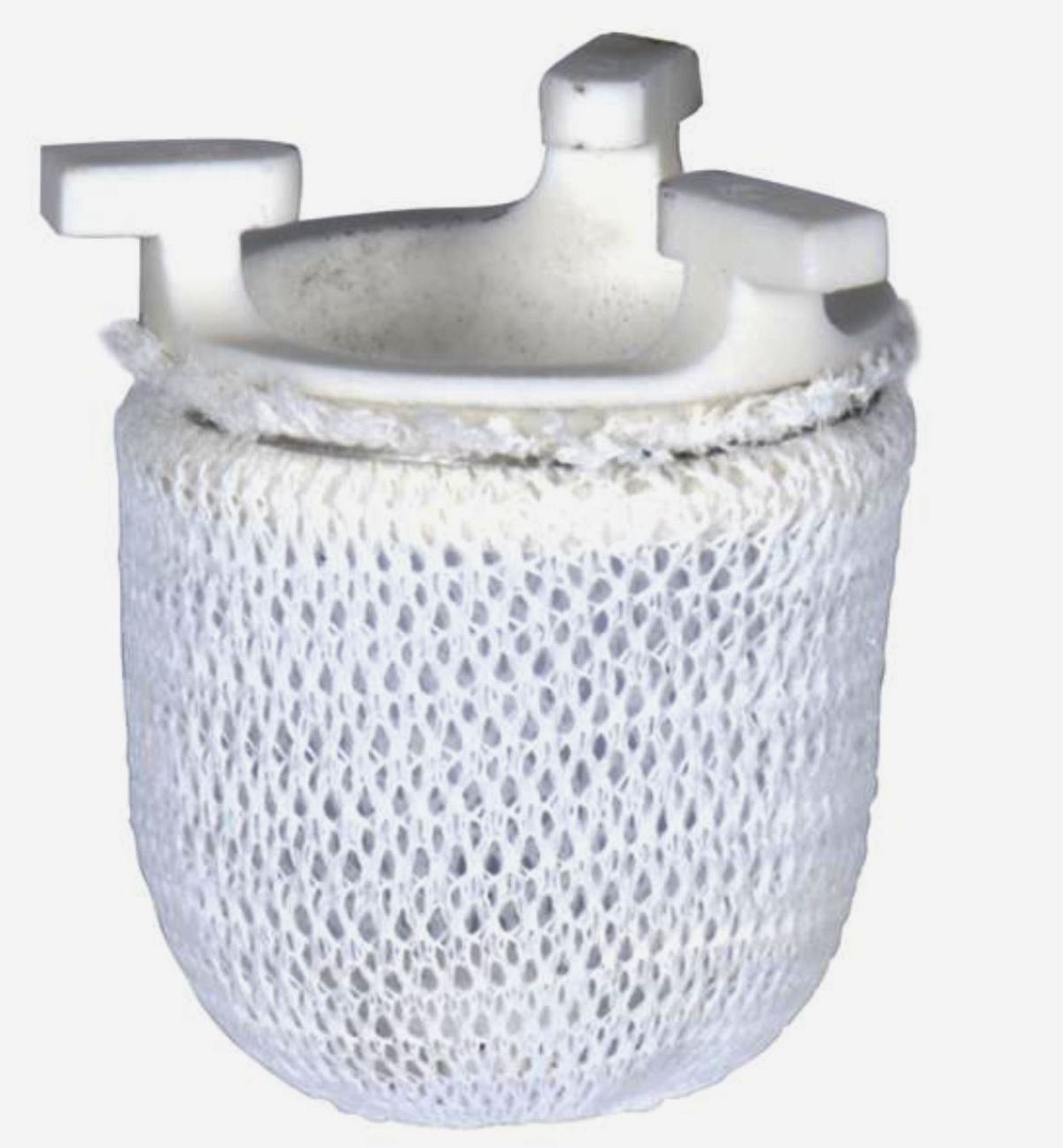
|
glass cover would often be decorative with some of the grander establishments having elaborate gaslight fittings and covers.
For much of the remainder of the 19th Century in cities and large towns gas was the fuel of choice for lighting. local gas companies were formed and underground pipes to factories and homes were installed. In Dundee around 1830 a gas works was built on a site at East Dock Street next to Peep o’ Day Lane. In the 1840s a rival company was set up on an adjoining site. Both companies continued to supply gas to the city until 1868 when they were taken over by the Dundee Gas Commissioners. Dundee’s gas supply continued to come from the same site until the national conversion to natural gas in the early 1960s. The site was demolished in 1963 and has now been earmarked for the location of the Dundee Eden Project.
From childhood I have been an avid reader. I cannot remember a time that I have not had a book on the go. Life for keen readers is much easier now. In the gaslight days, when I wanted to read in bed, I had to smuggle a torch to bed with me. When we first moved into the flat with electricity I thought it was wonderful, but as there was no socket in the bedroom, I had to rely on my faithful torch again. Over the years I have acquired more sophisticated means for my bedtime reading. I have a bedside lamp that I only have to tap for it to come on or go off. I even have a Kindle electronic book that has its own light source. But would you believe this? I sometimes feel nostalgic for the soft yellowish lighting and the friendly hiss of the gas light that I enjoyed all those years ago!
|
|
My wife, Sheila, has a part-time job as a Lunch Assistant at a local elementary school. She works from 11:30 – 1:30, Monday to Friday, looking after 40 junior and senior kindergartners, ages 4 – 6 years, to allow the teachers to have a lunch break. The kids call her Miss Sheila.
Most days when she comes home, she has some charming stories about the kids – here is a selection – the children’s names have been changed to protect the innocents:
Dora, a 5 year-old, is a drama queen. If she falls or gets hit accidentally or just feels that she has been overlooked in any way, she immediately starts crying very loudly. Staff at the school have learned to just ignore her while she screams and cries, as she is just looking for attention. They let her cry and pout – she soon realises that she’s not generating any interest and gives up.
One day, Dora announced that she was going to marry Ian. Ian is a 5 year-old hell-raiser. He likes to yell out bad words, hit people, kick people, stomp around, make demands, and when challenged, protests that he has done nothing wrong.
Ian said that he had two wives: Olivia was his first wife and Ivey was his second. He also said that he had 17 girlfriends. It is true that some of the girls from the higher grades would come up to the fence of the kindergarten recess pen so that they could say hello to Ian – I guess some girls just can’t resist a bad boy...
Of these ‘older women’ at the fence, Orla, a pretty 11 year-old was his favourite. Staff found this amusing but also annoying, as he got so much attention while they were focussed, of course, on trying to correct his bad behaviour.
Ian was not a fan of Dora, so, he told her he was not going to marry her. Dora decided she would marry Ivor instead. This was a switch because, while Ian was a hell-raiser, he was also good-looking while Ivor was an awkward 5 year-old redhead with a nose that was always running with green snot. Staff were always handing him a tissue and telling him to blow hard.
The teacher asked Dora why she wanted to get married. Dora’s answer was “Well, I don’t want to be without a man,” and undaunted, she continued to pursue Ian. She would go up to him in gym class and take his hand or try to sit beside him at Storytime. Ian continued to yell in her face and push her away. Dora would then start to cry loudly, protest that Ian was being mean to her. Staff would try to calm the situation. Dora would then pout in a corner and Ian would stomp around stating that he had done nothing wrong.
The school had an agreement with several local restaurants to deliver meals to the children daily. Monday was sub day, Tuesday was pasta, Wednesday was burritos, Thursday was burgers and Friday was pizza. Parents had to order online for their child. Dora got into a mood one day and began to cry because she never got delivery as other kids did. Staff suggested that she speak to her mother and see what she said. Dora replied, “My dad is the boss in our house. I’ll speak to him after he plays soccer. He likes soccer so he will be in a good mood.” I guess it doesn’t take very long for the female of our species to figure out how to handle the male…
Billy is a 6 year-old who loves cars – and wearing shorts. Everyday when Sheila comes in, he runs up to her and says with a big smile “Miss Sheila, I have shorts on today.” He often has a new toy car in his backpack which he wants to show her. His current favourite is a monster truck which he calls a graveyard truck. When asked why he calls it that, he said that it was because there was lots of room for stuff. Billy also likes to eat carrots. His mother always puts slivered carrots in his lunch. He calls himself ‘The Carrot Man.’
Billy is also a negotiator. For example, one day at recess, he wanted to make a fort with some of the other children. They started pulling together some small chairs and stretching blankets over them. Then Billy decided to get some yoga mats for the floor and roof. The children are supposed to ask for permission before they start to pull out yoga materials, but Billy hadn’t bothered. Sheila challenged him and he said sorry, but could they please use the four mats they already had out – Sheila said they could use those but no more. Billy’s reply was “But we really need 6. Just 2 more.” Sheila said strongly that no, they had enough. Billy responded “OK, just one more.” Sheila said, “Billy, this is not a negotiation, you have enough.” Billy finally gave in.
Irene, a 4 year-old, is quite precocious. Her mother is a French teacher, so she speaks some French and will say “Comment ça va?” frequently. Irene is very particular about her lunches. She likes turkey and cheese sandwiches on rye with mustard on one side of the bread and ranch dressing on the other side. She also likes Greek yogurt with berries, white bagels with herb and garlic cream cheese (must be herb and garlic), quesadillas with cheddar cheese (must be cheddar), and blueberry fruit strips (must be blueberry so that her tongue will turn blue). One day, as she was chomping on her turkey sandwich, Sheila said “Irene, we should call you the Queen of Turkey.” Irene liked the idea and started to giggle. Dora’s nose was a bit out of joint, since she was not the centre of attention, so she inserted herself into the conversation saying, “Can I be the Queen of Jello,” as Jello is her favourite dessert (but not grape – she does not like grape…).
Irene does not eat cookies because they have sugar which Irene says is bad for you. Irene pointed this out to Dora one day as she was licking the sugary icing off some Oreo cookies before she ate anything else in her lunch box. Dora said she didn’t care and continued to lick the icing.
Four-year-old Irene came in one day quite concerned about her water bottle. It was not full, and it needed to be filled right away. She said, “I need to remain hydrated...” Irene also decided to lead the ‘cool down’ at the end of gym class one day. She started doing some stretches (yoga-style) while the teacher was stowing away the gym equipment. The other children started to follow her until the whole class was doing it – the teacher was impressed with her initiative and asked the children to clap if they liked it. They did, so the teacher asked them who would like to lead the class next time. Of course, Dora’s hand shot up immediately.
I find Sheila’s stories quite entertaining to the extent that I’ve got into the habit of asking her, when she arrives home, “Any stories today? “
|
|
 |
 |
A Lifetime of Motorcycling
in Retrospect
Brian Macdonald |
 |
 |
I began this series of articles with my start to motorcycle-riding at age 16 as a beardless youth who just wanted to ‘ride a motorbike’. Now, ticking off the months till my 87th milestone, I am a retired motorbike-rider with a lifetime of riding a motorbike to remember. The time comes when every individual must admit to him- or herself that a point has been reached, when, for either physical or mental reasons, major life changes must be accepted. Just before I hit 85, I knew it was time to give up motorcycle riding. I still felt well capable of doing all I needed to in order to be a safe, competent rider of a moving motorbike in traffic. But modern motorcycles with large capacity engines are so loaded with features and so elaborately designed that they are very heavy. Most BMW motorcycles weigh in excess of 250 kg. That is a lot to manhandle when the motor is stationery or at very low speed or when manoeuvring in a parking area by leg-power. It is easy to lose control. You know you have lost the fight when your machine falls sideways and reaches an angle from which there is no recovery, and the only course open is to lower it to the ground as gently as possible to minimise damage. Then the rider may have to ask for help to return the poor beast to its vertical position. Time to call it quits!
After a year and a half of being a ‘once was’ a biker, and having accepted this reduced status, I can look back on those nearly seventy years and treasure what I have got out of that lifetime of being part of a particular group of people. For, in my case, motorcycling became a way of life that brought me many benefits, much enjoyment and a few painful experiences. I have a lifetime of memories of being part of a community.
In 1954, a motorbike was often seen as cheap transport, a way to get to work, a stepping-stone on the way to owning a car, that being a major aim of most young adult males then and still a high priority for many. A second-hand motorbike (no euphemistic nonsense about it being ‘pre-loved’ then) was within the financial reach of many. Young women on the cusp of adulthood had more sense and there were few, if any, then, who took to a two-wheeler. Lads who bought a bike with that motive moved on to a car as soon as they could and abandoned motorbikes without a pang. Their time on a motorbike gave them road skills and traffic experience that served them well, but they had no love for two wheels. Others, of whom I was one, had a more romantic view of being a motorcyclist.
For me, this was the start of a lifetime’s passion. A motorbike became not just a tool to get me to work but my everyday personal transport and freedom magic carpet, an attitude that persisted past middle life even though a second car was now well within our pocket. For a motorbike has a number of advantages. It can slip safely and legally through spaces in traffic that a car cannot. It is always possible to park, close to where you want to go, a machine that needs only a small corner. The state of Victoria in my adopted Australia allows a motorbike to be parked on the pavement almost everywhere with a few sensible restrictions. Regrettably, no other state in Australia is as enlightened. Little garage space is needed. A motorbike uses less fuel than a car and the registration fee is lower.
A motorbike is not just essential transport, although no longer a low-cost option. It is also a leisure fun machine. A major benefit is that most bikes are fitted with a dual seat and a second set of footpegs, the better to carry your partner, with arms round your waist. That is not strictly necessary but is to be encouraged. There is nothing to beat a short ride on your favourite twisty roads, throwing the bike into bends and taking a good line through corners, enjoying the sunshine and closer to nature than in an enclosed metal and plastic box. An enduring memory is of heeling your bike over into a big sweeping curve at speed, taking a confident line through the bend and just letting the machine have its head. For touring, the right configuration of seat, footpegs and handlebars makes long-distance riding comfortable and fun. A short ride to the favourite coffee-bar finds many like-minded people sprawled at table, their heavy protective jackets and helmets discarded, their bikes parked regimentally for tours of inspection and comment.
The sun does not always shine and the temperature falls. But a dyed-in-the-wool biker, with the aid of protective motorcycling gear, puts such minor discomforts down as all part of being a bike-rider and remembers the positive experiences.
It is not just at cafés that motorcyclists congregate. Motorcycle clubs proliferate, often based on one marque or model of motorbike, or on a common interest in a particular aspect of motorcycle life. Club rides are common, with strict rules regarding road behaviour and positioning in relation to those in front and behind. It is common at weekends to encounter groups of motorcycles travelling together. In Australia headlights are always on and speed limits are strictly policed. The camaraderie of club membership is strong, and a club provides a sense of belonging to a community, something we all value. Clubs usually have a formal meeting structure and organised social events are held to further increase the sense of comradeship. It is no exaggeration to say that a BMW motorcycle rider has more in common with a Honda or Ducati rider than with a BMW car driver. We are motorbike riders. Even though most have a car in the garage.
Ann and I have enjoyed many years of club social life and made long-time friends. The club’s mission statement, shown in each edition of the monthly club journal, is “ To enhance the enjoyment of BMW motorcycling, provide opportunities to interact socially with fellow-members and encourage safe riding”. Although I no longer ride, Ann and I still participate actively in club activities.
After enjoying ownership of a number of brands, I bought a BMW four-cylinder motorbike in 1986, when that range was new, joined the BMW Motorcycle Cub of Victoria and was introduced to this community. I have owned a number of BMW machines since then and been a member of the club ever since. BMW started marketing motorbikes in 1923, long before it first rolled out a car. The first range, which persisted until the 1970s, was of air-cooled two-cylinder-engined bikes, the cylinders being horizontally mounted and opposite each other across the frame of the motorcycle. This is known as a ‘Boxer’ motor. Subaru uses this type of motor and Toyota has recently come to an arrangement with Subaru so that it can use a Subaru Boxer motor in one of its models. The Boxer motor still powers BMW’s most popular motorcycles but now is a sophisticated, oil-cooled motor with four valves per cylinder instead of the original two.
Unlike most manufacturers, BMW favoured, from its first model, a shaft for its final drive to the rear wheel, not a chain, a successful initiative with benefits of longevity and a design that suited the horizontally-opposed engine configuration. Although BMW has always been at the forefront of technological development and was hugely successful in road-racing before WW2, this range of machines became popular with riders who liked to load their pillion seat up with camping equipment and travel vast distances, often to remote places and over less than friendly terrain. Australia gives unending opportunity for this type of motorcycle touring. And the bikes were perfectly suited, with lots of torque (pulling power) to facilitate low-speed travel over difficult country and simple but very robust construction.
In the later twentieth century this forward-thinking German company expanded its horizons, initially into a straight four-cylinder range in 1973, still with shaft drive but mounted horizontally, cylinders front to rear on the machine, in keeping with the company’s advanced thinking, and later to other engine configurations, using not only chain drive but also belt drive. Advanced suspension technology and steering features kept BMW at the forefront of technology. These initiatives opened BMW up to a wider customer base. Now you could buy a BMW with the most up-to-date technology and pick a model that suited exactly what you wanted of a motorcycle. Regrettably, an inevitable accompaniment of this model expansion was a matching growth in price. You can now spend as much on a motorcycle as on a high-end motorcar. This is true of many marques, not just of BMW. A BMW motorcycle now has the same level of sophisticated technology as a BMW motor car. But we still buy them!
I was one who liked to go off with a tent strapped to my motorbike. Later, this became a sleek, fibreglass trailer that an 1150cc motorbike engine towed effortlessly, still with the stove, tent, sleeping bag and supplies. We (for Ann has been a lifetime enthusiastic pillion) have quartered Australia, north to south, east to west, the east coast and the west, the equatorial north and the temperate south of the continent. We have also been fortunate to tour Western Europe and UK several times, often enduring snow in alpine regions or day after day of rain anywhere in Europe and especially in my homeland, Scotland. We have done a lot of day rides in Australia, where rain is, happily, less frequent. As I have averaged at least 16,000 km (about 10,000 miles), annually, I suppose I have hung on to a motorbike’s handlebars for more than a million miles.
Along with vehicle development has been the development of motorcycle equipment and clothing. The range of specialised riding clothing now available, made from brightly coloured leather 1.3 mm thick or Cordura nylon fabric with highly abrasion-resistant Kevlar, with strategically placed, impact-absorbing armour and automatically-inflating built-in airbags, with insulation for winter (and sometimes electric heating elements) and cooling factors and special heat-shedding fabrics for increasingly hot summers, has made life more comfortable and safer. Helmets are available with flip-fronts and communications-equipment and sun visors built in. High-tech information screens on the handlebars and GPS are common. Boots, which once meant making a choice between being protected and being able to walk, now offer the best of both worlds. Gloves offer full protection with flexibility and handlebar grips may have built-in heating. The engine sizes now range up to 2 litres. Regrettably, this all comes with an increase in weight. A huge range of waterproof, bolt-on and strap-on equipment exists to enable more than minimal luggage to be carried securely.
In my early days most motorcyclists developed an interest and competence in at least basic engineering. It was either DIY or paying out to motorcycle retailers. For many were the small but vital things that could go wrong and needed fixing. British motorcycles, which tended to have a reputation for leaking oil, complacently dominated manufacturing until the Japanese manufacturers got going after WW2. Currently, the Italian manufacturers Ducati and Aprilia are prominent. Today’s motorcycles are quite different to how things were in those earlier days. They are so high-tech that there is little beyond routine topping up of oil and tyre pressures that the average rider can do or would have the technology for. Fortunately, tyre pressures and oil and coolant levels need little attention between services. Quality standards of all major brands are high. No oil leaks, rare problems, long intervals between services. Just get on and ride. Most riders love the old machines and will gather to see them at shows but enjoy taking advantage of modern technology, with improved suspension, roadholding, braking and an astonishing amount of power at the twist of a throttle lever.
My riding days are over but not yearned for. I can still get enjoyment watching various kinds of motorcycle sport live and on TV and by attending events put on by my club.
Like Edith Piaf (for those old enough to remember), I can say “No Regrets”. “Je ne regrette rien”.
|
|
 |
 |
O, wad some Power
the giftie gie us…
Hugh McGrory |
 |
 |
In a previous anecdote I spoke of contacting two of my very first schoolteachers (beginning in 1942) Misses Macpherson and Laing, and telling them of a study I'd come across which showed that the best teachers of young schoolchildren do provide their students with the wherewithal to be successful in later life.
Recently I came across the letter of response I received from those teachers back in the late‘70s. I thought you might like to read it…
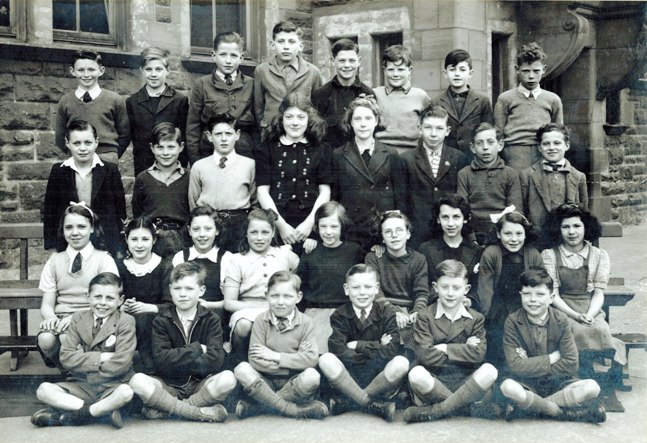 |
This is the class, though somewhat older (Grade 7 I believe)
|
Here is the letter written some 50 years ago and looking back some 30 more years:
“O, wad some Power the giftie gie us…
To see oursels as others see us!”
Many of you will recognise the above quote from the poem ‘To A Louse’, written in 1785 by Scotland’s beloved poet, Rabbie Burns.
I hope that all of you reading this can say to yourselves, "I too have experienced the joy of being taught by a really good teacher..."
|
|
 |
 |
Thompson Makes His Pitch
Gordon Findlay |
 |
 |
It was around this time that a couple of us within the “I” Section got a man-to-man pitch from Lieutenant “Pug” Thompson. He did it very quietly.
One afternoon, Russel Dagg, the other corporal in our “I” Section, came into the office and said to me: “Has Thompson given you the talk yet?” I didn’t know what he was talking about, so I said “No.” “Well,” Russell said with a laugh, “I think he’s going to.”
Sure enough, the next morning, right after breakfast, Lieut. Thompson said quietly to me” “I want to speak to you, Corporal Findlay, for a moment.”
We walked back into his office, and he closed the door. I was racking my brains to think of something I had recently screwed up, but Thompson was all smiles as he sat opposite me.
“Findlay,” he said, “you like Intelligence work, don’t you?” And I agreed that I did.
“Well,” said Thompson, “I’d like to make a proposition to you. I think you’d make a good officer. You’ve got the brains and the education. I will certainly give you a good recommendation. We’ll ship you back to the Officer Training Unit in England, and in a few months you’ll get your commission and rejoin this Battalion. You could even become the lieutenant in command of Intelligence here when I move up.”
Then he came to the meat of his proposition. “Of course, this would mean you signing on for five more years of service. But I can see you enjoy Army life, and” – here he grinned like a Cheshire cat – “I can assure you, it’s a much more enjoyable life as an officer than a corporal.”
Of course I was flattered, but at the same time the warning bells sounded in my head. Did I really want to spend five more years in the Army? Did I want to go to O.T.U. to get a commission and become a Second Lieutenant? Did I really want to spend more years away from Scotland and my parents and my friends in Dundee? Did I want to be the officer of Intel – and potentially work with Sgt. Krywald?
“Think about it for a couple of days, Findlay”, Lieut. Thompson said. “And let me know your decision”.
Later that day I asked Dagg why he hadn’t told me that he had also got 'the talk' from Thompson. ”Well,” he said, “I wasn’t sure if you might like to become a regular. Didn’t want to mess with your own decision.”
I’ll be honest. I did consider it. In fact, I thought about it hard. I would have loved to become a commissioned officer, but I also realized I was getting anxious to see the familiar sights of Scotland, and Dundee, my family, and all my old pals again. And five years seemed like a very long time to give to the Army.
I told Lieut. Thompson that I appreciated his offer, but I really saw a career for myself in civilian life, as a writer hopefully, and that while I had thoroughly enjoyed my life with the 1st H.L.I. and working in Intelligence, I didn’t see myself as a career regular soldier.
He was very good about it. Just smiled and said: “Can’t tempt you, eh, Findlay? Very well then.”
|
|
 |
 |
The Clock is Ticking
Hugh McGrory |
 |
 |
With regard to senior citizens driving motor vehicles, most jurisdictions recognise that losing a licence has a major negative impact on a senior’s lifestyle; because of this, most authorities try to allow seniors to drive provided they are able and can do so safely.
There is a wide range of approaches to this issue around the world. Many countries do nothing insofar as assessment of seniors. The European Commission recently proposed mandatory health tests for older drivers, including a vision and hearing test every five years for drivers over 70. This proposal was rejected by the European Parliament, so individual EU countries can each decide whether they wish to introduce compulsory tests. Currently there is a wide range across the EU – for example, France and Germany have no special requirements.
Italy has a compulsory health check for drivers under the age of 50. It's required again after 10 years, and then every five years. When drivers turn 70, the test is compulsory every three years, and after 80, every two years. People over the age of 80 must also submit a medical certificate proving they are free from heart disease.
In the UK, drivers over 70 must renew their license every three years and are required to make a health declaration confirming their fitness to drive. It seems to me that the process is somewhat as follows:
The Government and the senior have a conversation via a D46P form:
Gov: Are you a good, safe driver?
Senior: Absolutely. One of the bestest!
Gov: My, my, that’s just grand. Good chat – let’s do it again in three years…
Here, in Ontario, Canada, the authorities have gone in a different direction altogether. I’m not sure of how/why they chose the method they did, but I’m guessing that the process was probably something like this:
They looked at past annual records of accidents by age group which would have shown a familiar ‘U’ curve – high accident rates for new drivers, going down as they mature then, as they became senior citizens, the rate climbing again.
They then looked to see what factors seemed to be involved in the senior’s accidents and identified three major factors: vision; the effects of various diseases such as heart problems, stroke diabetes, etc.; and dementia. By processing this data they came up with the following system:
At the age of 80 and every two years thereafter, drivers have to attend a review session. It only takes about 20 minutes. A brief eye test is given and may result in the applicant having to supply a certificate from their eye doctor; similarly if there are disease issues, a referral to their GP or specialist may be required. Assuming no issues to this point, we come to dementia (medical science defines some one hundred different types, though Alzheimer’s and Vascular Dementia account for some 90% of cases). Which brings us to the Clock Test:
The applicant is given a sheet of paper and the following instructions:
“Draw a large circle, put all the numbers in to make it look like the face of a clock, and then draw the hands of the clock to show ten minutes after eleven. You have five minutes .Stop when completed.”
You may not be aware that this is a tried and true method of identifying dementia. It quickly and fairly evaluates basic auditory language skills, memory, motor functioning, and ability to plan and organize, and has been used in psychiatry, neurology and geriatrics for many years.
The illustration below, showing example results from around 3,000 actual tests, will explain further:
 |
The Score 5 column, is normal, while the Score 4 column shows minor visuo-spatial deficits. Columns 3 to 0 show increasing deficits and would be considered fails.
|
I have gone through this process five times now, the latest being two weeks ago. I have seen applicants struggling with the clock exercise, and, on two occasions, the sad sight of a senior (one man, one woman) being told that they failed, that there licence to drive was withdrawn, and that they could not drive themselves home...
|
|
The chaotic late Summer and Autumn of 1939 that led to World War II featured new regulations on an almost daily basis and caused family upheavals resulting from military mobilisation demonstrated the need for a means of dispensing accurate information and advice for those who needed it. Fulfilling that need saw the birth of the UK network of Citizens Advice Bureaux. For the last eighty odd years the local CABs have made available to all, a trusted source of free accurate non-judgemental information and advice.
In Scotland there are around fifty CABs usually run by a paid manager who recruits and supervises the training and performance of a team of volunteer advisers, some of the larger Bureaux also have paid specialist advisers. Each CAB is independent and largely funded by their local council. Because Scotland has its own legal, educational, and administrative arrangements all Scottish Bureaux are members of Citizens Advice Scotland, and each CAB undertakes to meet the standards that it sets. Citizens Advice Scotland is governed by an elected board drawn from member CABs. It is interesting to note that between 1999 and 2003 its chairperson was the late Bob Brodie, a Morgan Academy FP.
Over the years the type of enquiry that a CAB receives has changed. Out went problems associated with ration books and servicemen’s payments for wives and children and in came personal debt, employment rights, housing, and welfare benefits. Although a CAB adviser can usually help the client to resolve his/her problem there are very specialised areas beyond the skillset of a CAB, in such cases the bureau will advise on a suitable source of help.
Over the last twenty years the use of paper reference sources has been replaced by an intranet source of information, and this is constantly updated to ensure its accuracy. Citizens Advice Scotland staff produce and constantly revise training material for in-house use or on specially arranged courses.
CAB volunteer advisers come in all shapes and sizes and bring with them a very wide range of skills and experience. Many advisers have volunteered because they had to use the services of a CAB at some point in their lives. Others have recently retired from a career that had some relevance to the work of a CAB. I became a CAB Volunteer Adviser when I retired from being the senior HR Adviser for an Employers Organisation, effectively I became a poacher instead of a gamekeeper!
During the course of the fifteen years that I volunteered in my local CAB I came across many fine people that had fallen on hard times through no fault of their own and it is with some pride that I reflect on how our CAB provided at least some of the help they deserved.
We live in a sophisticated society governed by rules designed to minimise misuse of the rights and benefits available. Unfortunately, not everyone entitled to participate in those that are available to them are equally sophisticated, and they can be let down by the system. The CAB network is there to help correct the balance and I believe that over the years it has done just that!
|
|
 |
 |
More Street Talk
Hugh McGrory |
 |
 |
To me, one of the interesting aspects of the last two stories is how children’s street games have been passed down through word of mouth, from generation to generation, for hundreds of years. This reminded me of an earlier anecdote in our collection about the game of Hucky Duck.
It pointed out that Pieter Breughel the Elder, had, in 1560, produced a work entitled ‘Children’s Games’. This shows more than 250 kids playing in the street, and more then 90 games. I didn’t have to count those numbers myself, since someone had already done this and produced an interesting paper on the subject.
I spotted several familiar games: ‘Blind Man’s Buff’, ‘Tiddlywinks’, 'Hoop and Stick', 'Leapfrog', and of course, ‘Hucky Duck’. The paper goes into quite a lot of detail to identify the various games. If you’re interested, see it here.
I wonder if the advent of the Computer Age will mean that most of these games will be forgotten?
|
|
 |
 |
The Street – A Companion Piece
Brian Macdonald |
 |
 |
Gosh, that last article of Hugh’s was evocative to one old fart who was another bairn growing up in Dundee at that period, and it evoked more memories in me. I have written previously that there was a small battalion of kids all born just before WW2 growing up together and playing together in Kingsway Place in the North End of Dundee.
There was no useful communal wall against which you could sharpen your hand-eye co-ordination such as Hugh’s street had. Those of us who were lucky enough to have a good wall at home just annoyed our parents with the noise of a ball endlessly knocking against it for hours. Ours was an area of semi-detached and detached bungalows, so many of us were fortunate in this respect.
We were lucky in Fairmuir, with a T-junction where Kingsway Terrace met Kingsway Place, thus providing a larger playing area, which we utilised till dusk drove us home. In the later nineteen-forties and early ‘fifties, there was very little traffic in our quiet residential area. The Fairmuir Park a mere hundred yards up Kingsway Terrace was the natural venue for ‘fiba’.
All the street games Hugh writes of are familiar to me except ‘Bataan’, but we had our own, unique games too. There was an old-style gas streetlight at the T-junction, that served as not only the ‘Safe’ pole for ‘Hide and Seek’ but also as a wicket for our own version of cricket, played with an old wooden-frame tennis racquet and a tennis ball.
The rules were that the bowling had to be gentle, no hurling down killer fast balls, but it was possible and allowed to put a wicked spin on a tennis ball with your thumb and fingers. The batter held the ‘bat’ in front of the legs and stood facing the bowler, not sideways-on. You were ‘Out’ if the ball hit your legs or the wicket or your shot was caught.
Boys and girls played together. The batter had to be gentle, no big sixes to be hit into gardens or towards fielders but deliberate possible floaters for catching were OK, usually when the batter felt he or she had had enough time. Somehow it worked and those unspoken rules were (mostly) honoured. Many hours of fierce competition passed at street cricket.
As we all grew older, bikes appeared, sometimes second-hand, but often a shiny new Christmas present from Halford’s. As the prefab housing estate sprang up between Kingsway Place and the Kingsway, Elgin Terrace and Elgin Street were built, with Park Road along the edge of Fairmuir Park completing a natural rectangular circuit for bike races, still with little traffic and away from main roads. Many were the races and timed runs that helped to develop our leg muscles for later years, riding the bike to school, which, for most of us, was the Morgan Academy, only a mile or a bit more away, but necessitating the negotiation of the busy Old Glamis Road and Clepington Road, both of which carried buses. As well as motorbikes, I retained a love of bicycle-riding all my life from those early days.
Another bike game, played in the T-junction area, was slow cycling. The name speaks for itself. We all got on our bikes and attempted to stay on them while going as slowly as possible. The winner was whoever was the last to disqualify him- or herself by putting a foot down. One version of this game involved one child deliberately getting in front of a slow bike and attempting to get the rider to make a mistake without actually touching bike or rider.
As Hugh said in his article, all this physical activity and the need for mutual co-operation not only developed our social and interpersonal skills but also our bodies. Sadly, nowadays I rarely hear the voices of children at play although there are several in our quiet street. They are probably crouched, solitary, over their phones or tablets in what passes today for social activity and interpersonal communication.
|
|
When I was wee (pre-school and pre-teen) growing up in Fairbairn St, Dundee, Scotland, my world had three parts to it – home, school, and the street. Remember we’re talking about the 1940s – we didn’t have TV, computers/internet - heck, we didn’t have a telephone or a car either. So my contemporaries and I spent a lot of time playing on the street. It was common for a mother to answer a knock on her door and open it to see one of us standing there saying, “Can ??? come out to play?”
My experience was that, around the ages of three or four, boys and girls would quite often play amicably together, then for the next few years the boys wouldn’t consider playing with girls. As puberty began to make itself known, of course, playing together became much more interesting...
The games were age-related, sometimes for boys, sometimes girls, sometimes mixed. Many of the early games need no explanation; girls played house with their dolls, hopscotch, and skipped rope. Boys played Cowboys and Indians with toy pistols, or Pirates with wooden swords, or British Soldiers versus Nazis (we said Nazzies).
Some of the girls became very good at skipping rope using terms like, Double Dutch, Backwards Jump, Criss Cross and others – their athleticism put many us boys to shame. Of course we boys had our tennis balls which we used for pick-up football games, and headers (played in the backyard clothes-drying area where we could use only our heads to hit the ball over a clothesline competing against each other, sometimes one-on one sometimes doubles - rather like tennis….)
As we got a little older, it was quite common to have eight to a dozen of us playing any one of a number of street games, the rules of which the older kids would pass down through the years.
Several of the stories in this collection have touched on this subject, and I decided to see what I could remember of the games we played. I have to say, though, that my memory is not what it was, so the following may be somewhat flawed:
Often games began with one kid being designated as ‘It’ (usually by some process of ‘you drew the short straw, so you're it’) while the rest became part of the ‘pack’.
The simplest game was ‘Tig’ (Scots for touch) where the pack ran around trying to avoid being ‘tigged’ by ‘It’, since, if you were, you then became ‘It’.
Hide and Seek needs no explanation, but it could be combined with Tig in two different but similar games, ‘Reliefo’ (we pronounced it ‘really-foe’), and ‘Kick the Can’.
The pack would scatter and hide, and if ‘It’ tigged, or just spotted someone in their hiding place, that kid had to retire to a designated area or jail. Then ‘It’ had a second problem. He/she not only had to continue chasing down the remainder of the pack, but had to make sure that no one could break into the jail and free the prisoners (by tigging them or perhaps by kicking the can…)
The game of Pinner required that you first obtain a Pinner. This was a piece of scrap metal (steel or iron) about 2 inches square and half an inch thick (there was a big variation in shapes and sizes). (A good source was workers in the Caledon Shipyard ( no longer in business)).
The game began with each player throwing their pinner at a cundie ( a manhole cover (Scots word from the French ‘conduit’)). Whoever got closest to the centre of the manhole cover was then allowed to throw his pinner at the others and got a point for each one he hit.
There were several words that either player could blurt out at that point to help or hinder the attempted hit. (some of these were "Chappy" - bend down and chap or touch your opponent’s pinner with yours, "Drapped" - pinner had to be dropped from shoulder height or, "Stannie hard Bangie" - stand up straight and hurl your pinner hard at your opponent’s). Of course only the first utterance was valid, so you had to be quick… Sometimes a challenge would be issued for a one-on-one game - whoever won would take possession of their opponent’s pinner…
Cat and Bat, or Catty and Batty, or, with the Dundee glottal stop, Ca’y n Ba’y. The ‘cat’ was a piece of wood, square in cross section and about six inches long. Each of the four faces had a number from 1 to 4 that we had burned into it and both ends were tapered for about an inch. The ‘bat’ was a heavier piece of wood (the shaft of an old hammer was ideal). The cat was placed on the cundie and the player would strike the tip with the bat to cause the cat to fly up vertically about two or three feet at which point it could be hit in mid-air with the bat as far as possible. The distance achieved was paced out and multiplied by the number facing up when the cat landed to give the points earned.
Many of you will be familiar with Conkers - the battle of the horse chestnuts which we played in September/October each year. If not, see here.
Fairbairn Street consisted of nine four-storey apartment blocks on one side of the street, two flats per storey, but for us, ‘Our Street’ consisted of only the first three blocks which faced ‘The Wall’ (or ‘Oor Wa’).
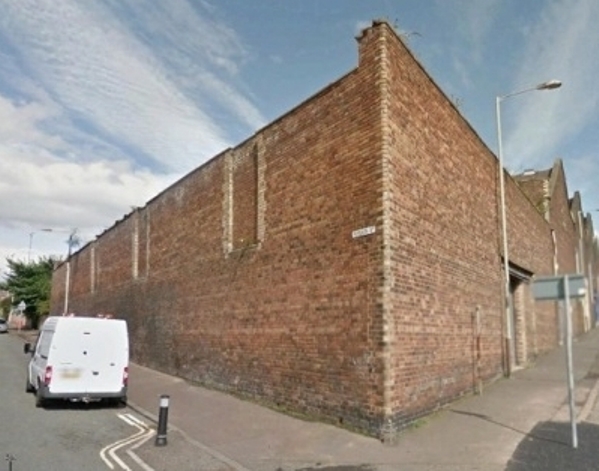 |
|
Oor Farbairn Street Wa' on the left |
This was about 100 yards long and was about twenty five feet high at the east end and about 20 at the west.
Some of the games we played probably existed for hundreds of years in many parts of the world. Some though were peculiar to us because of the ‘Wa’. (The best example of this was Bataan. It was described in an earlier anecdote repeated here):
“The 1945 movie Back to Bataan starring John Wayne and Anthony Quinn inspired us to invent a game called Bataan. One kid stood on the pavement opposite the Wa', and all the other kids gathered at one end then walked along in single file to the other end, turned around and walked back to the start. The kid with the ball would zing the ball at the line of kids the object being to hit (and hurt) a kid - any kid - though the game could be a way of settling past grievances if your aim was good enough. The kids in the line would duck and dive to avoid being hit, but once one was, they took over the ba' and the former thrower joined the line (and discovered, on occasion, that ‘what goes around comes around’.)”
The wall served multiple purposes. It had a football (soccer) goal chalked on it which kept wearing away and having to be refreshed often. One time my dad came home from work with a full scale cricket bat which he’d made at work from a single piece of wood. It didn’t have a rubber insert in the handle, but that didn’t really matter since we played with a tennis ball, the wicket being – what else – chalked on the wall.
The Wall served to return tennis balls for football or tennis practice. The girls used it in performing routines with a tennis ball inside a stocking – can’t remember what they called it. Boys used it to play ‘keepie up’ with a tennis ball using their head.
Looking back on those days now they seem quite idyllic. We were very active physically and we naturally learned interpersonal skills for adulthood. I wonder how kids do that today...
|
|
 |
 |
Sergeant Krywald
Gordon Findlay |
 |
 |
While Sergeant Krywald was usually a tyrant, he did have his “other” side.
Once, we had been out on an all-company exercise, doing the spotting from our OP (Observation Post) and a couple of others that had been dug for the exercise. It was a blazing hot day, and we had been kept busy spotting and recording and calling in all the “troop and vehicle movement”, charting it by compass reading, and radioing in all the information to tactical HQ.
You’re using field glasses a lot, and that is tiring. Calling in on radio handset gets wearisome too because they used to hiss and crackle a lot and you’d have to repeat information. For these exercises we were in full battledress, camo paste on the face, steel helmets in place – and soon you’re sweating buckets – particularly in the hot and cramped quarters of the OP.
Things are happening quickly and you’re trying to keep track of it all, report it accurately, and get it down on the daily OP log. Sweat is pouring off, your head boiling under your tin lid, and the camo cream is starting to run into your eyes making them sting. Late in the afternoon, you’ve been doing this for eight or nine hours in the baking heat, you’re tired, thirsty, and running out of energy.
That was when we suddenly noticed Krywald bouncing over the landscape on one of our section’s motorcycles (we had two, but one was always broken down and sitting in the REME workshop). He came roaring up to our OP with a huge grin on his face, stopped the bike and handed us a large metal mess pail– then waited for our reaction. We popped open the lid of the pail and inside was a beautiful mess of pure white ice cream just starting to melt.
How on earth Krywald had gotten his hands on six or seven pounds of ice cream we never found out. But he did. Stuck it in the mess pail, got on the motorcycle, and drove it out to the four of us. He just laughed at our total amazement, yelled: “Eat! Eat!” and roared off again.
The man had a heart after all.
|
|
 |
 |
Not by Bread Alone
Bill Kidd |
 |
 |
World War 2 started three days before my fourth birthday and while I don’t think that Adolf Hitler intended to spoil my party, he certainly changed many aspects of my young life! Wartime brought many changes to everyday affairs. It governed what and how much we ate, what clothing and household furnishings we could buy, it limited the amount of the fuel we needed to heat our homes and laws were passed and enforced to ensure that our windows and doors did not allow any light escape.
As a four-year-old I took all of this in my stride because it seemed normal to me. It wasn’t until my late teens that rationing finally ended. In addition to the items to be found in the adult ration, children’s food rations got orange juice and extra milk to ensure healthy growth. Although the quantity allocated to each individual was small the diet produced was good and many people enjoyed a better diet than they did before rationing came into force.
The beginning of the war did not mean that there were immediate shortages of food and other items, their supply depended on many factors, not least the military and naval situation. For much of the first year of the war food imports from France, Holland and Denmark continued along with those from what was then “The Empire”. The situation changed almost overnight when Germany over-ran most of Western Europe and their submarine fleet gained easier access to the Atlantic and the Mediterranean. Concerns that the UK might be starved into submission hastened the introduction of food rationing.
Worrying about what could be prepared from the meagre food ration was not a concern for my four-year-old self. My concerns were more concentrated on why my father no longer bought me an ice-cream cone or my grandparents rarely brought sweets when they visited. I saw pictures of bananas and oranges, but the real thing was no longer available. Like other children I soon learned that in addition to my sweet ration there were substitutes available. My favourites were flavoursome liquorice root and cinnamon sticks that could be chewed. Packets of sherbet powder that could help make a thin strip of black liquorice last for a long time. In the summer there were apples, pears, plums, raspberries and strawberries to be had. Some shops even managed to make off-ration toffee apples. Towards the end of the war, I recall standing in a queue at Marks & Spencer waiting to get my first taste of melon for thrupence a sliver.
It was only many years later when we were holidaying with a Danish friend that I realised how lucky the children of the UK were in comparison to those in the occupied countries. She told me how restricted their wartime diet was and of how during the occupation most of the food grown on their farm was shipped to Germany leaving them with only the bare necessities. She was often very hungry, and the family would talk about what they would eat when the Germans had gone. Their parents told her the most delicious thing that they had ever eaten was chocolate. Of course, she did not know what chocolate tasted like, so she imagined herself eating this wondrous substance. The Germans left Denmark and were replaced by US troops. Their mother returned from shopping and showed them a bar of chocolate that a US soldier had given her and told them that they would share it after dinner. They all sat round the table and were each given a piece of chocolate. My friend put hers in her mouth and bit on it. She spat it out - she did not like the taste! Even now, eighty years later she can feel the tears of disappointment. I was lucky, I still enjoy the occasional Sherbet Fountain.
|
|
 |
 |
To beard, or not to beard...
Hugh McGrory |
 |
 |
... that is the question:
Last Saturday the doorbell rang at 9:30 am. I went to the door and opened it – and something peculiar happened – it was a little surreal… A man stood there, he looked at me and I looked at him and neither of us said a word. The silence seemed to last a long time as I waited for him to tell me what he wanted – though it was probably just a few seconds.
For my part I was saying to myself “I know this guy from somewhere; but where…?” Then it came to me – I realised he was a former neighbour who had bumped into my wife, Sheila, earlier in the week. She mentioned it to me when she came home and said that she’d agreed to let him borrow our garden roller (the kind you fill with water) and that he’d be dropping by at the weekend to pick it up.
Then he spoke , haltingly, saying “ I... I was…, I am looking for Hugh or Sheila McGrory” just as I said “Robert”. He looked sheepish and relieved, and said “Sorry, I didn't recognise you with your new beard…”
When I was younger, I grew a beard three tines. Looking back I realise that it was a case of “the grass is always greener”… - I’d get tired of shaving every day, grow a beard, then realise, after a few months, how much ‘tending’ a beard needs and shave it off – then, after a few years, I’d go through the same cycle again!
In my old age the situation is a little different: You may know the term ‘snowbird’, perhaps for the migratory bird, the dark-eyed junco, or for the Canadians who spend most of the year at home in Canada,
and head south for the winter usually to Florida or California?
Well, as I’ve aged, my face seemed to think it’s a snowbird and should head south too – I’ve lost quite a lot of weight which has increased the sag. Much of my face that used to be above my chin line is now below it – if my wattle had a zip, I could store a credit card in it…
The result is that it makes shaving very difficult, since the skin just sort of flops around as the razor tries to get at the hairs. ( Imagine a balloon, blown up and with some shaving soap applied...it would be quite easy to take a safety razor and ‘shave off’ the soap – that used to be my shaving experience. Now let half the air out of the balloon and repeat. See – it’s almost impossible - and that’s my experience of shaving in old age.)
Nowadays I’m in a vicious circle where, through the winter, when I spend a lot of time at home, I grow a beard for a week or two then shave it off. Despite using two types of electric razors and a safety razor each time, I’m never satisfied with the result)…
Now, if you’ll excuse me, I’m going to try to shave off my latest beard so that when Robert brings back our roller, he’ll recognise me.
|
|
 |
 |
Training Our Replacements
Gordon Findlay |
 |
 |
Now that Dagg, Howson, Bannerman and I were all getting closer to the end of our two years of military service, we had to turn our attention to the replacements picked for the Intel Section, and to training them for the job. Knowing we were not far from being demobilized, it became an enjoyable task.
My particular responsibility was to bring them up to speed on Forward Observation and Map Preparation. The only effective way to teach the art of observation from a forward post is to actually do it.
Fortunately, our camp at Ghajn Tuffeiah was surrounded by open countryside, so we were able to take the Jeep or the 15-cwt truck out to an observation post we dug about two miles out. We ran a communications line out to it so we could monitor how well our new guys did in their radio call-ins and observation reporting. We would stick them in the OP, then the rest of us would set out a number of straightforward observation tests for them.
Dagg or me, or Bannerman or Howson would leave the OP and walk off to a spot perhaps 600 or 700 yards away and hidden from view. Then one or two of us would pop up briefly or maybe run 20 or 30 yards to a new position. Then we’d repeat this, sometimes separately, sometimes in pairs or as a group.
We managed to get our hands on some old ammunition boxes, and used them as props when we dashed about, to see if the new lads noted this correctly on their OP log as “ammunition replacement - noted.”
We did some compass work, taking the new lads out to various parts of the island, dropping them off with a compass, and having them walk back to the OP on a back-bearing by a set time limit. And we got them used to making the operational map overlays which we prepared for the infantry company officers.
It was all quite good fun for us (hey – we were 19 and 20 years old!) but it was also good training for our four replacements in honing their observation skills and giving them practice in quickly and accurately spotting “troop movement”, relaying information via the #4 radio set, and making changes to the master map overlay which had to be kept up-to-the-minute at all times.
We tried as hard as we could not to involve Sgt. Krywald in any of the radio communication training. Why? Well, even after being in the British Army for some ten years he still possessed a fairly thick Polish accent which became even thicker and more impenetrable when he became annoyed or angry – which was fairly often.
When he got pissed off at us he would always remind us that we didn’t know what tough soldiering was, since (so he claimed) after he got out of Poland he had spent a year and a half in the French Foreign Legion where a barrack room fight could escalate into a murderous knife fight to the death. We four had heard it all before, but the new recruits were suitably awed.
|
|
 |
 |
What A Load of Garbage!
Hugh McGrory |
 |
 |
Every Tuesday morning I get up at 7:00 am to put out the garbage for street pick-up. We have three categories – Blue Box (Recyclables), Green Bin (with a lid, for Compostables), and Garbage Can / Dustbin (everything else). The first two are every week, garbage is every second week.
This past week was all three, so I had two Blue Boxes and one Green Bin. For the garbage we use large industrial plastic bags as liners for the bin so, as usual, I pull out the bag, tie it off, and take it out too. (Add one more Blue Box to the photo and you’d have our set up.)
It’s bitterly cold, below zero with a strong, gusting wind from the north. To stop paper etc. blowing away I usually put one of the blue boxes on top of the one that holds the newspapers, then the Green Bin on top of that. I move as quickly as I can and am really glad to get back into the kitchen and start breakfast. I glance out the window and see the boxes have been blown out of position. I dress up again and rush out to reorganise them in a tighter group, with the narrow sides pointing into the wind.
Back to the kitchen, look out, and see that the boxes have just been blown over and are beginning to spill their contents. Dress up and out we go again, As I walk down the driveway I’m bombarded by the gale force, wind-driven newspapers, plastic bottles carboard boxes etc…
At this point I accept defeat, gather up the blue and green boxes and carry them back to the garage. Just as I press the button to lower the door, I realise the truck has arrived, so I carry the boxes back down the driveway and stand there freezing my butt off while holding the papers in place and waiting until my two neighbours have been serviced.
Finally I manage to get back to my warm kitchen and run warm water over my freezing-cold hands. As I do, I’m wondering what happened to the green garbage bag…
The next day I spent a half hour gathering assorted recyclables from the surrounding trees. We still don’t know where the garbage bag is…
|
|
 |
 |
A Lifetime of Motorbikes 4
Brian Macdonald |
 |
 |
The last part of this story ended with the triumph of Wayne Gardner late in his road-racing career, at the first Australian Moto GP in 1989. While he gave up competitive motorcycling only a few years later and passed the baton to his son, Remy, who won the Moto 2 world championship in 2021, the intrepid Macdonalds continued with a life that contained a heavy dose of motorcycling for a good many years after 1989.
In that year I was a lad(?) of just under fifty summers, with many years of motorcycling left in me. That year, Ann and I took what is called in Australia ‘Long Service Leave’(1) and flew to Munich, the Bavarian home city of BMW, to start touring Europe by motorcycle for three months on our own BMW motorbike.
BMW had been an aircraft engine manufacturer in WW1 and was forced to diversify by the treaty terms that ended the war. It first marketed motorcycles under its own brand as early as 1923, long before it ventured into the twin-track market. Perhaps capriciously it named the bike the R 32. It was a single-
cylinder 494cc machine with a shaft drive to the rear wheel and bore a black paint job with white pinstriping that became the hallmark of the brand for many years. Later BMW settled on what is called the ‘Boxer’ motor, a horizontally-opposed twin-cylinder engine with a reputation for strong performance and engine sizes grew to include different cylinder capacities up to 1000 cc. The brand became known as one favoured by riders who liked to strap a tent on the rear seat and ride long distances into the remote outback in Australia’s case. It did not conform to the image of British motorcycles which led the world and BMW bikes had a more ‘sit up’ relaxed riding position and wider handlebars, unlike many machines which has narrower bars, a ‘lean forward’ position and sharply bent knees.
Before WW2, BMW was at the forefront of motorcycle road racing and its large-engined machines won many solo(2) and sidecar championships, always performing well at the annual Isle of Man TT races. Their great champion was Georg ‘Schorsch’ Meier.
When WW2 ended BMW had restrictions placed on its products and for some years was not permitted to build big-engined motorcycles. By then the company had experience in manufacturing cars and this became the major part of its business. The increasing market for motor cars as affluence grew in the early post-war years was the driving force into car building and BMW’s reputation grew.
The development of the Japanese motorcycle brands Honda, Yamaha, Suzuki and Kawasaki(3) began then, too, with very small-engined commuter motorcycles first hitting European markets. The British manufacturers, still dominating the larger motorcycle market in the 1960s, complacently failed to recognise the engineering skills of the Japanese and their indefatigable energy and drive to expand their industrial base and end their policy of isolationism from the western powers. Soon they lost their dominance as the Japanese developed their model ranges and grew their engine sizes throughout the 1960s. Their products were good, attractive and well-priced and soon the Japanese manufacturers owned the motorcycle-manufacturing industry. The Honda CB 750 four-cylinder in-line motor across the frame of the motorcycle and the design of the motorcycle that appeared in 1969 shocked the market and set a
benchmark for the industry.
BMW did recognise these qualities and knew it occupied a small niche in the market and had to broaden its own range or leave the industry. The Boxer motor was simple and easy to access but it no longer led the market. Parallel twin and straight-line four-cylinder motors increasingly broke standards with innovative styling and sophisticated features. BMW had doggedly stuck to a shaft-drive configuration, Japanese machines almost exclusively opted for chain drive to the rear wheel, cheaper, simpler and lighter. Disc brakes were common on motorcycles long before they became standard on cheaper motorcars. BMW ventured into the four-cylinder motorcycle market, producing the ‘K Series’(4) 1000 cc four-cylinder machines. as early as 1983. There were several versions, all elegant and different in design to the Japanese motorcycles. They were liquid cooled, unlike their twin-cylinder siblings.
From 1973 the company had been marketing a version of its standard Boxer motor two-valve air-cooled model known as the R 90 S. When it first appeared, it became a sensation and dominated the large-
capacity ‘superbike’ class for performance and style. With specially designed paintwork and design the R 90 S became a cult classic and even today there are annual rallies in many countries devoted to this model. Those who have one value it highly even though production ended in 1983 when the K series appeared. The Boxer motor still drives a major part of BMW’s model range but now has four valves and is liquid-cooled as opposed to the first, air-cooled, two-valve versions. BMW’s GS(5) range of on-road, off-road motorcycles, which uses the now sophisticated Boxer motor, has a deserved high reputation for quality, performance and rider appeal both on and off road.
The company now markets a range of engine sizes and model configurations from a 310cc single-cylinder up to a six-cylinder 1600cc touring model, Boxer motors, the six- and four-cylinder and has even produced an 1800 cc Boxer for the American market and utilises both chain and shaft drive, even using a fibre belt drive on some twin-cylinder models.
The Macdonalds began their European odyssey(6) in early summer 1989 seated on a K 100 LT, the top-of-
the-line luxury tourer that had wide, heated handlebars, disc brakes, a radio and a huge wrap-around fairing that completely encompassed the rider’s legs and provided significant protection from the heavy rain that summer delivered all over western Europe. Even so we enjoyed the three months so much we repeated the experience four years later for a shorter time on a different BMW motorbike and again a few years later on a rented motorcycle.
Meanwhile we continued our motorcycle touring in Australia as well as my using whatever motorcycle I had as everyday transport. By 1989 I had settled on BMW as my favourite brand of motorbike and, over the years, had a number of different types My first BMW motorcycle was bought in 1986 and my last in 2013, simply because they were well made, well designed and a pleasure to ride. Before becoming a BMW devotee, I had a number of different Japanese machines. In an early article on this website I wrote of my first motorcycle, a BSA B31. At one stage I also owned a Honda Spacy 250 cc scooter which was
an excellent commuter motorbike with very good weather protection, especially for the feet and no need to worry about gear changing.
For some years we owned a sleek, aerodynamic, fibreglass and very lightweight trailer designed to be pulled by a large-capacity motorcycle, that we towed behind several motorcycles and that held all our camping gear. We rode many thousands of touring miles with that sleek blue trailer faithfully following
our motorcycle over the long, flat, straight road across the huge Nullarbor Plain in the south of Australia from Melbourne in the east to Perth on the west coast, up the east coast to Cairns in northern Queensland, up the west coast to Broome in tropical Western Australia, up the middle of the continent to Alice Springs and further and many shorter but still significant trips.
In 2023, at the age of 85, after 69 years of almost never being without a motorbike, I accepted that it was time to stop riding something that weighed a quarter tonne with only two wheels and a big engine. Bicycle-riding had already ended, and Ann had long had enough of being a faithful pillion (but then, our wives are usually more sensible than we men). We sold our faithful, then 11year old BMW 800 cc F 700 GS and with it went all our large collection of motorcycle clothing tools and accessories.
Now we drive sedately around the countryside for we have not given up enjoying travel in this astonishing continent-sized country , but riding a motorbike is now simply an abundance of golden memories. We maintain our long membership of the nearly a thousand-strong BMW Motorcycle Club of Victoria and enjoy its events. We look forward to the camaraderie of the festive lunch which is held during the club’s Christmas Camp, which is this year in a small Victorian town a mere one hour’s drive from home. Christmas and January are Australian annual holiday time and, much as in France, Australia largely shuts down for the annual break.
Footnotes
(1) Long Service Leave of three months duration with pay was devised by the Australian federal government so that, in this country heavy with immigrants after WW2, nostalgic New Australians could revisit their homeland and re-connect with family after twenty years of working for the same employer and living in Australia. There is debate as to whether it is still relevant.
(2) A solo motorcycle is one with two wheels, one each front and rear. A motorcycle with a compartment bolted on to it on a sub-frame and a third wheel is known as an ‘outfit’ , ‘chair’ or ‘sidecar’ although the actual sidecar may be a goods-carrying box or a passenger compartment.
(3) These companies were all heavy engineering and multi-industry companies and making motorcycles was not new technology to them. The British manufacturers were exclusively motorcycle manufacturers.
(4) The K Series BMW, although a straight-line four-cylinder machine, broke the rules and the engine was mounted on its side horizontally and front to rear in the frame and not the standard across the frame vertical configuration.
(5) GS is derived from the two German words ‘Gelände’ and ‘Strasse’ which translates as ‘Highways and byways’
(6) BMW is a major presence in Munch, with many establishments across the city. The headquarters of the company is a large complex at Olympia, the site of the 1936 Olympic Games and where the Olympia stadium is, where Bayerrn Munich FC played their home matches until 2005. Part of the complex is a huge building designed to look like four vast car engine cylinders on their side which houses their splendid car and motorcycle museum.
The Munich suburb of Freimann had, until its closure in 1993, an establishment where BMW enthusiasts could collect a car or motorcycle ordered in their home country, which would be ready, registered and insured for road use in Europe for a nominated time, for them to ride or drive away into Bavaria. At the end of their tour, the vehicle was simply taken back to this depot and was shipped by BMW to a nominated dealer in the owner’s home country to be made ready for collection. It was to Freimann that we went to start our European trip, which covered more than 14,000 km (9000 miles).
|
|
Gen is commonly used as a short form for intelligence (information), or to mean generation, as in Gen X. So here is some information about generations…
Generations are groups of people who are around the same age, and are widely used to study how various social factors change over time. The exact cut off points often vary depending on who is pontificating – for my purpose I’m going to use the Pew Research Center definitions.
I got interested in the question “If you could have chosen the generation to be born into in the twentieth centuury, what would be the best choice?” I want to make the case for mine i.e. The Silent Generation.
One of the problems of comparing generations is the age disparity within the group – given that a generation could have a 1 year old and an 18 year old, I decided to use myself as the representative member – born 1937, in Scotland – right in the middle of the generation:
Unlike my parents, I was born too late to experience,WW1 (1914-18), the Spanish Flu (1918-19), and the Great Depression (1929-39).
I was too young to be conscripted for WW2 (1939-45) and indeed, too young to understand or really even to notice WW2.
I was also the right age to benefit from the scientifically designed rationing regime during WW2. (Dieticians have long argued that wartime rationing provided the healthiest diet the British population has ever eaten,leading to dramatic post-war improvements in the nation's health.)
The standard of care in Scottish medicine was such that I survived a bout of diphtheria at the age of two or three, and my dad was cured of TB in the early ‘50s (spending two plus years in Ashludie hospital…)
When I was eleven, in July 1948, the National Health Service was established in the United Kingdom. Britain was the first western country to offer free medical care to the entire population.
Insofar as education goes, Scotland had, for centuries, put great emphasis on schooling of children, and not only was I able to attend first class primary and secondary schools and university, but it was all free!
After university we were allowed to work for two years before being ‘called up’ to serve in the armed forces for a further two years. Serendipitously, conscription ended just a few weeks before I was due to serve.
I then began my engineering career just as computers were beginning to be seen as useful tools and this allowed me to move sideways, as it were, into the space where engineering and computers came together, and never looked back…
Finally, on retirement, I was able to access several government and private sector, defined-benefit pensions (such as seem to be scarcer and scarcer to find these days.)
I look at the past eighty-plus years and compare them to today’s world and the existential challenges facing humanity, and it reinforces my view that my generation hit the ’sweet spot’…
I rest my case...
|
|
 |
 |
Can I see You Home?
Bill Kidd |
 |
 |
In the days before Personal and Social Education (PSE) was part of the school curriculum, study of this important subject, both theory and practical, was largely undertaken during and after regular visits to the various dance venues to be found throughout Dundee. For many, the introductory lessons began shortly after the student’s fifteenth birthday, usually after some encouragement from friends. In my own case those first steps were held at Kidd’s Rooms on the corner of Nethergate and Lindsay Street on Saturday
evenings. Popular venues for intermediate studies were mid-week at The Palais in South Tay Street or Saturdays at the J M Ballroom. More advanced lessons were provided in the shadow of the Royal Arch at the Empress Ballroom.
On Saturday evenings Kidd’s Rooms was filled with hormonal teenagers of both genders, the lads dressed in suits with hair tamed by an excess of Brylcreem. The lasses in dresses or blouses with flared skirts, make up applied and hair coiffed and sprayed in place. Each and every one present had paid their half-crown to gain entrance to a magic three hours of music, gossip and perhaps romance. At the start of the evening those present herded together in groups of school friends, girls separate from boys with distinct areas for Morgan, Harris, Lawside and Grove Academies. There may even have been a High School area.
The first dance never had many on the floor, only the inevitable show-offs who could actually dance, a few who were already couples and quite a few girls dancing together. The next two dances saw the less inhibited boys invite a girl to dance then the shy first-time boys were goaded or bullied into going up to a strange girl and asking her to dance. After half an hour or so when the band played for the first “Ladies Choice” of the evening the groups became rather less defined, and it was the turn of the lads to wonder if he would be the chosen one. If he was, and he and his partner liked each other, he would invite her to dance again. Names and personal details about school etc. would be exchanged.
Then comes the key question, “Where do you live?” (the answer to this may decide their future)! If he lives in Camperdown and she resides in Fintry seeing her home, then getting back home himself after the last bus would be a logistical nightmare that only someone who fully grasps the principles of Personal and Social Education will be able to resolve. Needless to say, within a few weeks of that first outing to the Saturday night dance, pretty well everyone passed the initial PSE exam and moved on to the next level, little realising how important that experience was as a foundation for a life well lived.
|
|
A few days ago I was driving along the main road in Stouffville (the small town closest to our home) when the road suddenly seemed to be much rougher than usual. However, the noise was regular, and so I quickly decided that I’d got a flat tire. I continued for a few hundred yards then pulled into a shopping plaza. Turned out I was wrong – I had two flat tires – both front tires had failed at the same time! No Way!
So once again I called the CAA. I got a helpful human (sometimes it’s a computer) and was eventually told that help would be sent – “It might take about 90 minutes...” A few minutes later I got a text saying “Your rescue request requires special equipment resulting in extended wait times…”
When I saw this, I was not a happy camper – by the sound of it I was going to be sitting in my car in below freezing temperatures for two hours or more… I figured I knew what the issue was – they needed a
flatbed tow truck for my car (like the one in the photo – I had the same issue a few years before). And this is where you’re going to say, “No way!”
I slumped back in my seat, thoroughly disgruntled, and looked around. As I did so I saw a truck pull into the parking lot. As it pulled across my nose, I realised that, a) it was a CAA truck and b) it was a flat bed tow truck.
When it stopped, I went over to the driver and asked if he was looking for me. He said “No.” I told him my story, and he asked me for my Rescue Request Number. He spoke to his despatcher then said that he would assist me. So my two-hour wait turned out to be two minutes! He loaded my car, dropped me off at home, and then took my car to my dealer’s yard.
If you live right…
|
|
 |
 |
Army life in Malta
Gordon Findlay |
 |
 |
After landing in Malta, I found our regiment had taken over the Army barracks, built by Italians well before the war, at Ghajn Tuffeia – about 6 miles from the capital of the island: Valletta.
I liked Malta instantly. It was nice to be on an island that had trees and greenery, unlike the barren sands of Libya. The island was hot certainly, around 80 / 85 most days, but it was tempered by the soft Mediterranean breezes which usually started to blow early in the afternoon.
Our barracks were impressive: built of white marble and sandstone mostly; no windows, just open cuts in
the walls to let the air flow through, so the place was nice even during the hottest days. And no straw palliases on the floor. We had regular Army beds with sheets (didn’t need blankets during most of the year).
Even the Ablutions (washrooms) were impressive: the wash basins were scooped out of solid marble slabs with nice, solid metal taps. The Italians who built the place probably thought they were building it for the Italian Army to occupy someday, not the British Army.
Life in Malta was much more pleasant than Tobruk, with its suffocating heat, sand everywhere, flies, dirt and sullen Libyans. The island was a British navy base and also had units of British Marines as well as us. Like Libya, duties stopped after lunch and didn’t re-start until 3.30 p.m. to avoid the hottest part of the day.
There was no beach at our barracks, but the land ended in black lava-like rocks which were pretty smooth and just a foot or so above the sea. We all bought a pair of cheap swim-fins and a swim mask from the gharri-boy and took to that warm Mediterranean water like seals.
After lunch we had a good couple of hours to swim or goof off – and we almost always went for the water. Once you dived in, you could swim right down the rock face under water and find it was honeycombed with a thousand tiny holes and caves and hiding in each was a tiny octopus or fish. They seemed to be as curious about us as we were about them, and I can remember having little octopi crawl out onto my arm, then bringing them up to the surface.
The water was very clear and very warm. We could have swum around in it all day if we had had the time. So, it was always a wrench when we heard the bugler up at barracks blow the three o’clock call that told everyone that siesta time was coming to an end and camp life was about to start up again.
| |
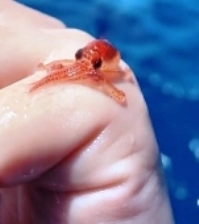 |
Around this time, we were getting ‘short’ in our Army time – within six months of the end of our two years – so Lieut. Thompson brought in four recruits to learn the secrets of Army Intelligence work. They were all reasonably bright, had a decent education, so each of us had to start introducing them to our individual specialty. For some of us that was coding and map preparation. For others it was forward observation, signals intel, interrogation, radio communication, and so on. Since my specialties were forward observation and map preparation, these were the courses I had to put together and teach our little band of I-Section recruits
I wasn’t sure I would be any good at that, but once started, I discovered I enjoyed the process. Even Krywald, our moody and erratic Polish sergeant, began to realize we weren’t half bad and seemed to mellow. This may have been partly caused by the fact that his wife was able to join him in married quarters in Malta–and she did. We still had to beware of his volcanic temper and his occasional ugly moods, but on the whole, he was a happier man.
|
|
 |
 |
Driving in Canada
Hugh McGrory |
 |
 |
I talked about Highway 401 in a previous anecdote ( for those of you who know Dundee, 401 is a city centre by-pass rather like Dundee’s Kingsway – except bigger). The photo shows it at its widest point, near
Toronto’s Pearson International Airport, all 18 lanes of it…
Driving on 401 can be a little fraught at times (fans of the TV program Heavy Rescue: 401 will know this) – and the older I get the more fraught it gets – I just have to take extra care. Sometimes however even that doesn’t work well. Case in point:
With global warming, we have had a few recent years with less snow than usual, but this year has seen some frigid, stormy, and snowy stretches. A few weeks ago we had two successive days of snowstorms, each of which dumped 14 or 15 inches of snow on us -about 28 inches in total. Storms of this severity take some time to clear – main streets a day or so, side streets up to three weeks… there just isn’t enough space to simply push the snow around, and so it has to be loaded onto trucks and taken to dumps.
Recently I had to drive into Toronto for a meeting and set out from home in plenty of time. We live on a circle at the end of a cul-de-sac - our driveway is just off the bottom left of the photo, so I came down the driveway and turned right to round the circle (see the pile of snow about 8 feet high in the middle) to head up the hill to the main road.
I was moving at about five mph and fiddling with my seatbelt when my car came to a grinding halt. I had run into the snow at the edge of the road ('X' marks the spot). The photo was taken few days later, after some thawing had occurred, so imagine a few more inches of snow sitting there waiting for stupid to come along...
My nose was sitting in about 8 inches of snow – too much for my small car which sits close to the ground (clearance between the bottom of my bumper and the road is 4 inches).
So there I was, after almost 60 years of using Hwy 401 with no accidents (one or two near misses though…) I was stuck about 40 yards from my home. I carry a small spade in my trunk but after a few shovelfuls I realised that the task was beyond me. I, and my neighbour John (who’d seen the idiot from next door get stuck), confabbed, and decided the smart move was to call CAA.
A tow truck was there in about 40 minutes and in about ten more minutes I was back on the road for my 40 yard trip back home – of course I missed my meeting!
One interesting thing I learned:
When the tow truck driver arrived, he said, “I need to get into your trunk“ and proceeded to rummage around below the spare tire and pulled out an eye bolt. (Like the photo but with a longer shank).
He then went to my front bumper and took the cover off an access panel (about 2½” by 1½” ) which allowed
him to screw the eye bolt into the chassis of the car. He then attached his tow cable to the eye and Bob was our uncle…
I didn’t know I had an eye bolt and never realised I had little access windows in my front and back bumpers!
(In my own defence, I’ve only had the car for 14 years…)
|
|
 |
 |
A Lifetime of Motorbikes 3
The 1989 Australia Moto Grand Prix
Brian Macdonald |
 |
 |
In the 1980s Australia already hosted a round of the Formula 1 World Championship, which is held on a street circuit round Albert Park Lake in inner-city Melbourne. In 1988 the Australian motorcycle racing control body negotiated for and was awarded a round of the official world championship series, to the delight and excitement of Australian motorcycle racing fans. The first Moto Grand Prix event was to be held in 1989 on the circuit on Phillip Island, which would be brought up to World Championship standard.
In 1988 the circuit was rebuilt, spectator and safety facilities were improved and the track surface re-laid. It opened for motorcycle racing that year. A world-class motorcycle race circuit will be a loop from 4.3 to 5.6 km long. There is a lot of space left beside the track on corners, with a deep layer of what is familiarly called ‘kitty litter’ of soft, shock-absorbent, machine- and rider-slowing, crumbed materials and no solid barriers or even bumps in the ground near to the racing surface. F1 cars prefer concrete walls. Track edges are white-and-striped round the corners with an outer, green-painted area where a rider incurs a penalty for infringing. When there is need, a yellow flag is waved, and riders must slow down and not overtake. In extreme cases a red flag is waved to bring the race to an immediate premature halt. Other flags indicate specific situations. This flag-signalling is part of the duties of a track marshal. Electronic signal lights are becoming common. Specially trained marshals stand by for fire-fighting duty and fully trained medical staff are trackside.
A Grand Prix race consists of around twenty-four laps, 110 kilometres, and will last approximately
45 minutes. The Phillip Island GP circuit is in scenic, rolling terrain near the southern coast of the island, with spectacular views of the coastline. It has a number of left and right corners including a hairpin, a high-speed straight, a long, moderate uphill and a short, steep downhill with a 90° right turn at its foot. Riders comment that they enjoy racing on it and that it is a flowing circuit, without the stop-start aspect of many other circuits. Although the views around the circuit and to the ocean are good, the weather, even in summer, is often less than kind, the corner of the track nearest the Southern Ocean being justifiably named ‘Siberia’. An unusual hazard is seagulls on the circuit. A rider has had his arm broken by being hit by a bird on the wing while doing 200 km/h. At a recent meeting, a pair of Cape Barren Geese decided to have a stroll on the track during practice and an official car had to go round and shepherd them away.(1)
Australia was allocated round two of the championship series, to be held early in April. In that era, the motorbikes used all had 500cc, two-stroke engines, notoriously difficult to control at high speed. The field would consist of, among others, Wayne Gardner(2) and two up-and-coming Australians, Mick Doohan, who went on to become world champion five times in succession in the 1990s, and Kevin Magee, who is remembered for his talent on both a motorcycle and a uni-cycle, on which he scooted around the race meeting paddocks. There were several Americans, the most notable being Wayne Rainey, who won three championships over his career, which ended with him in a wheelchair. It would be a highly competitive field with several world champions in it.
Beginning in late 1988, summer in Australia, the Victorian Race Marshals club continued to participate in race meetings and undertook further training in their marshalling duties. Selection was strict. Eventually those chosen were issued with distinctive white jackets bearing the sponsor’s logo, told to wear white shoes and trousers and given written notes and instructions about everything from on-track performance to off-track behaviour. This was to be Australia’s showcase to the motorcycle racing world and every aspect had to be done well.
We would be required to be on the track from 8 am on the Thursday until after the last race on Sunday, usually the Moto GP race, had ended and the track was cleared by an official car, about 4 pm. Accommodation had been arranged for all officials and we found ourselves sleeping at a holiday place some kilometres away, in huge imitation Conestoga wagons, eight to a wagon., on rudimentary wooden bunks. We discussed what connection such a feature of the Old American West had with an Australian island but found no answer. Breakfast and the evening meal were our own business. Lunch was a sandwich, fruit and bottled water brought to our appointed marshals’ point as we were not permitted to leave it except for calls of nature.
The meeting’s major sponsor was the old-established Western Australia-based Swan Brewery, whose logo was writ large on our uniforms. An unexpected benefit of this was a free Happy Hour put on for officials by the brewery every evening once on-track action was over. The walk back to the pits and hospitality area, in some cases of a couple of kilometres, was a daily pleasure.
Came the Thursday and we began our four days of being involved in the Moto GP international circus, soaking up the atmosphere, speaking to the riders and occasionally picking them and their motorcycles up after a spill, watching every minute of track action, responding as needed. Sunday is the day of drama. All up to then has been preparation, with hours of practice laps, testing tyre combinations and other set-up aspects. The order of grid position is decided by a special timed session on Saturday afternoon. Sunday is ‘race day’.
We enjoyed four rain-free days. The major race is held in mid-afternoon when air and track temperatures are warmest, for the sake of tyre adhesion for such powerful machines. The 1989 Moto GP was a race of drama with intense competition from flag-fall, with a small, changing cast of front-runners. The last lap saw Gardner, the American Rainey, the Frenchman Sarron, and the Australian uni-cyclist Magee in close combat. Rainey was unable to overtake his rival, with whom he had had several close encounters during the race. Wayne Gardner won narrowly by 0.35 seconds.
Apart from winning the world title, which is a season-long endeavour of amassing points, a GP racer’s dream is to win his home country’s GP. This the local superhero had done at the first modern-era Australia Grand Prix. Since then, several other Australian riders have done the same. After the chequered flag has signalled the race’s end the riders continue, slowing down round the track until they reach the pit-entry off-take ramp, which, at PI, is near the end of the lap. This is a time for the adrenaline level to fall, to relax, pass a wave of congratulation to other riders and to acknowledge the fans.
As Gardner rode into the pits, his then wife, Donna, came haring towards him, screaming in high
excitement, waving the Australian flag(3), which she thrust towards her victorious husband. This was unheard of. The track is supposed to be kept clear of all but the racers. Wayne grabbed the flag on its pole, stuck it down between his legs and set off on a celebratory lap of the track. Thus was established what has become a standard part of the GP pageant. The triumphal flag-carry was adopted by riders to general acclamation and now happens after every race.
Everything else was going to be anticlimax, the podium, the presentation, the speeches. But many of the 92,000, mostly motorcycle riders, who had flocked to the Island, streamed to the pits and control tower area to cheer and celebrate. Thus ended the first Australia Moto Grand Prix with victory for the home hero and for Australian motorcycle racing in general.
The long, weary trek home to southern Melbourne should have been an anticlimax too but it was not. Most of the 92,000 who attended were on their way late on the Sunday afternoon and most by motorbike. There is one road off the island, over a one-lane each way bridge. The police had come up with an ingenious way to maximise and control traffic flow. A blue line had been painted on this road, right across the island, from the circuit exit on the western side, over the bridge on the eastern and for some miles on the mainland, turning a single lane with a paved verge into two lanes. Motorcycles rode in procession, four abreast, at a steady 100 km/h, an exhilarating experience, but in good humour and with police motorcyclist control. Other traffic was simply held. The motorbike was king!
So ended an unforgettable week, with memories this motorcycle racing fan will never forget. I have watched many Grand Prix on Phillip Island over the years since 1989 but that week, that race and that result will remain imprinted in my memory.
Footnotes
(1) The Cape Barren Goose is native to all of Australia’s Southern Ocean coast. The birds are usually in monogamous pairs, slate grey in colour, up to 7 kg in weight, nearly a metre long, with a wingspan up to two metres. They stroll unconcernedly on roads, the surface of which is often very similar in colour to their feathers, and you would not wish to have contact with one while motoring. It is the motorist who must give way to these big birds, not the goose to the vehicle.
(2) Having established a reputation in Australia, Gardner secured a ride in the British Superbike Championship and by 1983 he was riding for the Honda factory team in the Moto GP series. He spent his whole GP career with Honda, which was then the dominant team. 1987 was his championship year, with seven victories from fifteen races, finishing lower than fourth only once (10th in Germany) and no retirements, an astonishing consistency of performance. By then he was an idol to Australian fans. He was runner-up for the title the following year and might have done better but for some bad luck. In one race his machine failed, possibly due to a lack of fuel, a few hundred metres from the finish when he was in the lead, and he coasted in for a lower position. In frustration, he thumped his petrol tank so hard he dented it. 1989 was not a good year for Gardner. He won only one race but was still a highly competitive front-runner. He ended his motorcycle racing career in 1993, when he finished sixth in the title race.
Gardner retired to Australia and competed very aggressively but without major success in Australian Supercar racing until 2002, gaining a reputation as a driver not to tangle with. Aged forty-three, he retired from all racing to concentrate on growing business interests and on his family. He is regarded as an icebreaker for Australian motorcycle racers at the very top international level.
Remy Gardner, Wayne’s son, after competing successfully in Australia and performing with distinction in the Moto 3 series, won the Moto 2 title in 2021 and now competes in the World Superbike series.
(3) The official Australian flag consists of the Union Jack in the top, left quarter, with the five-star Southern Cross in white on the remainder’s blue background. The entrepreneur Alan Bond adopted a gold boxing
kangaroo on a green ground (Australia’s national colours) as his team symbol when it wrested the America’s Cup from the New York Yacht Club in 1993. The green and gold boxing kangaroo flag is now the flag of Australia’s national sports teams.
|
|
Ice Cream has always been a favourite of mine – plain vanilla my choice, though sometimes I go wild and crazy and order French Vanilla…
A few days ago, while lying in bed and about to get up, I suddenly remembered, no idea why, an ice cream story which probably took place around 1946 – so I would have been about eight years old. The war was over, and things were normalising. Ice cream was again available and tasted great. My mother decided that we’d have a treat and sent me out with a bowl and some money to get enough for the four of us.
So I set off from Fairbairn St, along Dundonald St – the ice cream shop was about ten minutes away. I probably got about six scoops in my bowl then headed back, handling the bowl with care, with two hands.
I think I must have gotten uncomfortable holding the bowl that way and switched to one hand, fingers underneath and thumb on the rim. This allowed me to swing my arms a bit, a more natural way of walking, and as I got closer to home, I began to swing my arms a little more.
There are two phrases that have often played a part in my life “It seemed like a good idea at the time,” and, sometimes immediately, sometimes years later, “What the hell was I thinking?”
On this occasion, I think I must have learned about centrifugal force at school, and I decided that I should be able to bring my arm full circle, and the ice cream would stick to the bowl – provided I did it fast enough…
So, just yards from home I experimented… and this is where the ‘scream’ of the title comes in – me shouting “NO!!!” as all of the ice cream fell onto the pavement with a huge PLOP… What the hell was I thinking?
To make matters worse, an attractive young girl of sixteen or so was passing, saw the whole thing and couldn’t restrain her laughter. I was mortified as I scraped the pile back into the bowl, dirt and all and went to face the music…
My parents took it better than I deserved, and when they got over their initial reaction, they sent me back for another bowlful. I suspect that, given that a career as an experimental physicist was probably not in the cards for me, I probably didn’t give them a scientific description of the experiment, but lied instead, and said I tripped…
By the way, I did a little trial this morning, and I think it can be done by performing a 360 degree pirouette at the same time as swinging the arm… If any of you want to try it let me help you get started: get a bowl and fill it with ice cream, then…
PS
Apparently, there are about one hundred people in the world who have Superior Autobiographical Memories commonly referred to as ‘photographic memories’. Such people can be given a random date in the past and they can describe where they were, what they were doing, wearing etc.
I certainly can’t, but the fact that I had this memory of a trivial little event pop into my mind some eighty years later is intriguing to me.
I wonder if, in fact, we all have brains that can store information like this, but that most of us just don’t have the retrieval mechanism of the special few.
|
|
Long gone are the days when schoolboys (I’m not being sexist) puffed and panted on a heavy shop bike to bring a box of groceries to your home. If he was lucky, a sixpenny tip might have been added to top up the meagre wage that he got from the grocer’s shop.
In the early 1950s, following the end of the food rationing that was introduced at the beginning of World War II and the bureaucracy of ration books and points that underpinned it, many groceries reverted to the old system of encouraging their better off customers to open a monthly account and send in a notebook containing their order for their main weekly shopping. The shop would then make up the order during their less busy periods and deliver them to the customer’s home at the time indicated in the order book. Payment in full or part would then be made following receipt of the bill. Those less well-off customers were still able to enjoy the home delivery service, but they had to do their shopping in person and pay for it before delivery.
The advent of self-service stores and supermarkets in the 1960s heralded an end to this service. It remained dormant until revived because of the Covid lockdown and has now established itself as a permanent feature of many people’s shopping habits. Gone are the schoolboys and the shop bicycles and in came the purpose built, refrigerated vans driven by adult delivery drivers of either sex who have responded to our on-line order at the time of our choosing. Of course, this is no longer a free service but is subject to a variable charge depending on how popular our chosen day and time slot is. Payment is made by credit or debit card at the time of ordering but only actioned after the delivery is accepted.
During the Covid lockdown I did not use the Home Delivery Service offered by my preferred supermarket, but my deteriorating mobility has left me with little choice in the matter. I now get a weekly delivery, and it is two years since I was last in a supermarket. By and large I am happy with the service but using it exclusively has meant that I must be better organised than I was. Instead of thinking about my menu a couple of days ahead I have to extend this to about ten days.
Apart from keeping a half dozen pensioner-ready meals in the freezer I still do my own cooking. This means I need to maintain my stock of ingredients at a sensible level, this includes herbs, spices and condiments, oils and pulses, pasta and potatoes, tea, and coffee etc. Meat dishes I cook on the basis of one portion for that day and two portions for the freezer. I am disciplined enough to maintain a running list of items that I need to order when I place my order on a Tuesday for delivery on Thursday. I use this pattern because I can review and amend my order on Wednesday, more than once this approach has literally saved my bacon!
Like so many aspects of modern living the one absolute necessity needed to make use of Home Delivery is Internet access. Provided one meets this requirement the actual process of accessing the website and placing an order is very straightforward. The first step is to reserve a date and time for your delivery. Once this is done you are offered a list of available categories such as vegetables, bakery, or meat, selecting one of them brings up subcategories, for example fresh vegetables and frozen vegetables. Selecting a subcategory brings up individual illustrations of the goods on offer along with the price and the option of more detailed information such as ingredients and storage instructions. All that is required to order the item is to click on the space indicated. If the item is something that one is likely to order frequently there is the option to click on the ‘Add to Favourites’ button. There are other options available such as ‘Items on Offer’ and ‘Favourites’ and as one’s experience in using the facility grows the weekly shopping becomes easier. The final action is to check out and make the payment by card.
As you will have realised by now, I am a fan of Home Delivery. Are there any negative aspects to the system? You betcha there are! First supermarkets don’t seem to realise that many folks live on their own, so the much-vaunted ‘Special Offers’ usually require a minimum spend or are only available in a larger pack, both unsuitable for singletons. My other big gripe is the dreaded substitution. This occurs when an item that you ordered is no longer available and a member of the supermarket staff chooses a similar item as a substitute. In most cases this is OK but in others it borders on farce.
I ordered 5litre compostable caddy bags and got 25 litre pedal bin bags as a substitute. Espresso ground coffee was replaced by instant Espresso and tinned anchovies by sardines! To be fair an email is sent before delivery and any substitutes highlighted, if you don’t want the substituted item the delivery driver will take it back and your payment is adjusted, leaving you with a gap to fill in next week’s plan. A nuisance rather than a disaster.
Circumstances mean that I have little choice other than to make use of Home Delivery. It works for me, but would I still use the service if I had my mobility back? To be honest, given the hassle of parking, chasing around with a trolley and the vagaries of Scottish weather I think that I would still opt for shopping from the comfort of home!
|
|
 |
 |
Sidecar Racing
Hugh McGrory |
 |
 |
Those of you who are regular readers of these stories may remember that, during my university years, I had a couple of motorbikes, and for about four years I had great fun driving around the city and environs. They were both small bikes, but big enough that they could take me wherever I wanted to go, at a reasonable speed, and, when I got lucky, with a girl friend on the pillion snuggling in to my back.
Although I loved my bikes, they were really a stepping stone from my bicycle to my first car (which I couldn’t afford any sooner). I wasn’t a real motorbike enthusiast such as Brian Macdonald, and I’m enjoying his series here on his vast experience of living most of his life with a succession of large bikes.
He recently mentioned, in passing, the subject of sidecar racing, and that reminded me that I’d once been told that two of our extended family members used to race sidecars for fun (were they still alive today they would be around 120 years old) – the husband was the driver and his wife the passenger… Wow! This tweaked my curiosity about the sport…
If you want to see the very best motorbike road racing, solo and sidecar, the Isle of Man TT is the place to be in May/June each year. The Isle of Man circuit is 38 miles long and has over 200 turns with little to no runoff spaces. Races are structured in a time-trial format on public roads which are closed off for the event which takes place over one week of practice sessions and then one week of racing.
With regard to the sidecars, while the rules permit the sidecar to be on the left or right of the bike, the left is used since the course is ridden anticlockwise and there are more left hand bends.
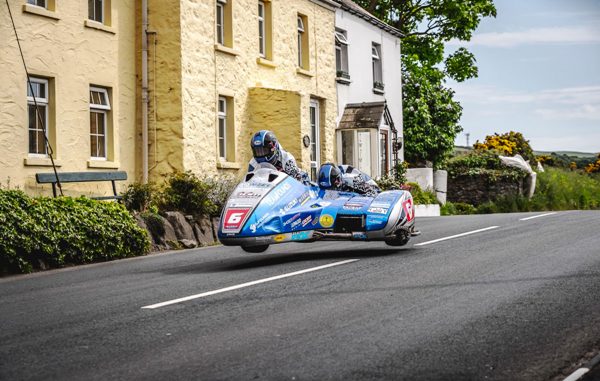 |
|
Cresting a slight hill with all three wheels in the air |
Personally, while both solo and sidecar races are fun to watch, I feel that the sidecar events are more interesting. The complex ever-changing juxtapositions of the driver and the monkey (a term of endearment used by the professionals to describe the passenger - for obvious reasons) are mesmerising.
After reading up on the TT races I was left with two competing thoughts - lets call them ‘benefits’ and ‘costs’:
The benefits are obvious – the money spent by the thousands of people who visit the island for the event - latest figure shows an estimated contribution to the island economy of £32 million; the forum it provides for top-class athletes to hone and demonstrate their unbelievable skills; the enjoyment of the crowds watching the fearsome competitions.
The costs are not as obvious and I wasn’t really aware of this until now… To set the scene, here is something I read: “many of the competitors make a point of hugging their loved ones before each run, whether racing or practice...”
They do this every time because they know that two or perhaps three of the competitors will die during the two-week competition.
The Isle of Man TT began in 1907. It did not run during World War I (1915-1919) and World War II (1940-1946), meaning no races were held during those years; the only other time the TT was cancelled in recent history was in 2001 due to the Foot and Mouth disease outbreak, and in 2020 and 2021 due to the COVID-19 pandemic.
So the 2024 event was the 103rd year. Over this span, 270 racers have died, 30 in sidecar events, 16 passengers and 14 riders. In 2022 three sidecar racers were killed in crashes, including a father-and-son team.
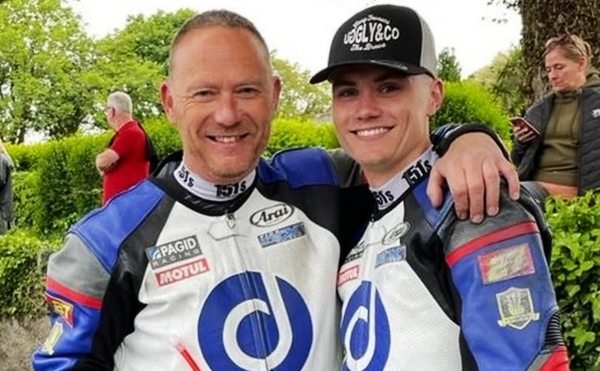 |
|
It was Roger (left) and Bradley Stockton's first TT race as a father and son team. |
I'm in awe of men such as these who operate at the peak of human ability. They must be extremely fit, strong, agile, adrenalin junkies - and I suspect somewhat nuts...
If you want to make up your own mind on this see the video here.
|
|
 |
 |
Libyan Postscript
Gordon Findlay |
 |
 |
Five years after our ignominious departure fromTobruk, I have emigrated to Canada. I have a job as Assistant Editor at Canadian Underwriter magazine. I’m walking along King Street one day in the summer of 1956 and as I get to Bay Street, I look at the Toronto Star newspaper box on the corner to glance at the headline of the day.
And there it is: “ANGLO-FRENCH FORCE INVADES SUEZ”. I buy a paper and stand on the street reading it in total amazement, because there, laid out clearly, and in detail, in the Toronto Star, is the exact same “Operation Rodeo Flail” our little I-Section had helped work on in the hot and sweaty sands of Tobruk five years before!
The bright lights of the British War Department had changed absolutely nothing. It was totally the same plan. The same drop zones for 3rd British Para Brigade, right on El Gamil airfield. Exact same drop zone for the French paratroopers (who also flew from Cyprus) who went in at the Rasma bridges and at Port Fuad. And our own Royal Marine commandos atacked – and quickly captured – the same strongpoints that had been pinpointed five years before.
I could not believe that they had not changed one single part of “Rodeo Flail.” In its wisdom, the British War Department had simply hoped that nothing of this 5-year-old invasion plan had somehow leaked out in the intervening years, or that the Egyptians had not managed to figure out where an Anglo-French force might strike.
In the end, sheer Egyptian military incompetence, rather than brilliant British military strategy, had carried the day.
|
|
In a recent anecdote Bill Kidd mentioned that, as a child of three, he was admitted to hospital (Dundee Kings Cross Fever Hospital), suffering from diphtheria. This struck a chord for me, since I shared that experience, at the age of two or three – I too had diphtheria and was in Kings Cross.
My memories are quite sketchy – looking back to such a young age I’m never quite sure if I remember an event or if I’m actually remembering what my elders told me about it… I think I remember being in an isolation ward - a wooden annex in a corner of the hospital grounds. It had a set of steps at each window so that parents could come to see their children – no visitors were allowed into the ward, of course.
Diphtheria (dif-THEER-e-uh) is a serious bacterial infection that usually affects the mucous membranes of the nose and throat. It can be treated with medications, but in advanced stages, can damage the heart, kidneys and nervous system. Even with treatment, diphtheria can be deadly, especially in children.
Symptoms usually begin 2 to 5 days after a person becomes infected, and may include:
- Swollen glands (enlarged lymph nodes) in the neck (Bull Neck)
- A thick, grey membrane covering the throat and tonsils
- A sore throat and hoarseness
- breathing or rapid breathing
- Nasal discharge
- Fever and chills
- Tiredness
In researching this piece, I came across ‘Helen’s Memoirs’ in the Bygone Dundee website – an excerpt follows:
“Being ill before the National Health Service I recall being ill at about 6 years of age. I had a very sore throat, and my mother got a neighbour to check me out. He looked down my throat with the aid of a spoon, realised how bad it was and suggested a doctor be called. My mother was very reluctant as she told him she was due the doctor 8/- (40p) for previous treatment (unpaid). However she ran from Hill Street to Byron Street for Dr Saggar and God bless him he came at once. Diphtheria was diagnosed.
I was duly carried down in the Ambulance man’s arms and transported to hospital. The windows of the ambulance were dark shaded, but you could see out of the top part. It was a tree lined street I was travelling along, and I could only think of Riverside Drive but later discovered Clepington Road had trees. I was duly admitted to Kings Cross the Isolation Hospital. There was a very strict hygiene regime in place. Visitors were only allowed at the windows which had steps up to view in. Everything was sterilised and I had a penny with a hole in it tied round my neck when I went in, and I never got it back after a very long 6 weeks entrapped.
The Matron was very strict but turned a blind eye to the children sliding with socks on their feet on a very highly polished ward floor. I wouldn't take my medicine one day and Matron showed her authority by holding my nose and tossing it down my throat, she was rewarded with it right back over her immaculate uniform as I duly brought the whole lot back up, Her stamp of authority shattered. All toys we were given by friends and family had to stay in Hospital after we left. We were all poor then, but family and neighbours got together and had a welcome home party in the back green. I will always remember I couldn't walk after so long in bed, and was sat in a chair by a wooden greenie pole and it was crawling with forkie tailies (earwigs) - I could not enjoy the fun for watching them in the cracks of the wood, I have never really thought about it before, but I've been a private health patient.”
Helen’s mention of the Matron dredged up another memory for me. (I’m pretty sure we’re talking about the same woman…) Some time into my incarceration I messed the bed. I don’t remember exactly what the matron said or did, but she really scared me regarding what would happen if I did it again. Either deliberately or subconsciously, I came up with a solution – I would stop pooping altogether…
Apparently, when I was well enough to go home, I was terribly constipated. Not only was my colon not operating properly, but when I tried to go it was very painful – a major disincentive, of course. My mother took me to our family doctor (Dr. Jacob in Victoria Street). I guess he probably prescribed some type of appropriate laxative, but he also had another suggestion… He told her to take a bar of soap and cut it into the shape of a finger, then before she put me on the pot, she should first dip the soap in hot water and use it to lubricate my poor little butthole. I can remember once lying across her knee in front of the coal fire while she did it. I guess it worked since I don’t think the problem lasted very long.
Diphtheria isn’t common in the western world because living conditions have improved, and children are routinely given a diphtheria vaccine. However it is still endemic to Asia, the Dominican Republic, Eastern Europe, Haiti, the South Pacific and the Middle East. In 2023 there were 25,000 cases reported worldwide.
I guess Bill, Helen, and I were fortunate to have been born in a country that had fever hospitals, skilled medical staff and appropriate medication.
|
|
 |
 |
A Lifetime of Motorbikes 2
The Love of Racing
Brian Macdonald |
 |
 |
As a young Scottish motorcyclist in the mid-1950s I well recall attending race meetings at Errol Aerodrome, a no longer needed WW2 aerodrome near the village of the same name, near Dundee. The track was marked out by hay bales and small bollards on what had become unused runways and service roads. Spectators stood where they could, behind flimsy barriers., often no more than a rope on poles.
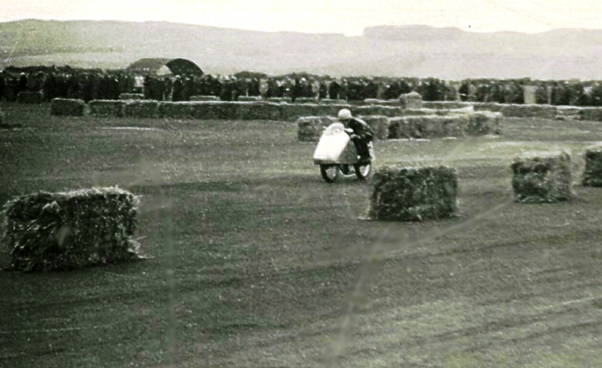 |
|
A Britax 50cc Hurricane racing at Errol Aerodrome, May 23rd, 1955. |
An international star of that era was Bob (Robert McGregor) McIntyre, a Glaswegian, who competed both at local events and in the World Championship, winning championship races but never a world title. He was dubbed ‘The Flying Scotsman’ by the press. He also won races at the annual Isle of Man Tourist Trophy meeting. McIntyre died as a result of a crash at a local meeting in England after losing control on a flooded track, aged only thirty-three.
A more local hero to a Dundonian of that era was Jimmy Buchan, a Perth lad, born in 1933, educated at
|
Perth Academy. Buchan won a gold star in the International Six Days, a major off-road event, won at the Isle of Man Tourist Trophy in 1955 and had greater success in 1956. He worked as a reporter for his father’s agency and one story about him is that he rode the 22 miles from his home town to Dundee, to the headquarters of the newspaper publisher D. C Thomson, with the results of a sports tournament, in 21 minutes on open roads with traffic, two cities and several villages to navigate, to meet a deadline. Traffic policing was not as strict then nor traffic as heavy as now. Buchan went on to win many motorcycle races, as had his father, Jack, and survived to die peacefully in 2016. His racing career ended with the 1950s and he followed a lifetime career in journalism on Scottish national newspapers. He is regarded as one of Scotland’s finest motorcycle racers but did not achieve the same level of
| |
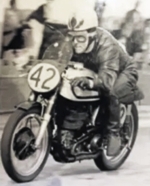 |
international recognition as McIntyre.
My own connection with motorcycle road racing began in earnest as a spectator, not a participant, in the 1950s and 1960s in Britain and regained its fervour in the 1980s, in Australia, where it was a big sport drawing large crowds to circuits. My wife, Ann, an enthusiastic pillion passenger, and I joined the Victorian Race Marshals club (now Race Marshals Victoria) about then. This club’s raison d’être was to provide trained track marshals at race meetings, thus enhancing our enjoyment of the sport while providing a valuable service to the racers. As only one racetrack was in Melbourne, where we lived, we spent many weekends riding to towns some distance from home and sleeping rough in old wartime airfield huts and worse. Meetings lasted from an early start to Friday practice, with racing all day Saturday and Sunday, ending late on Sunday afternoon. The days were spent at an exposed marshalling point located strategically by the track, with signal flags of different colours and a radio to communicate with the control tower.
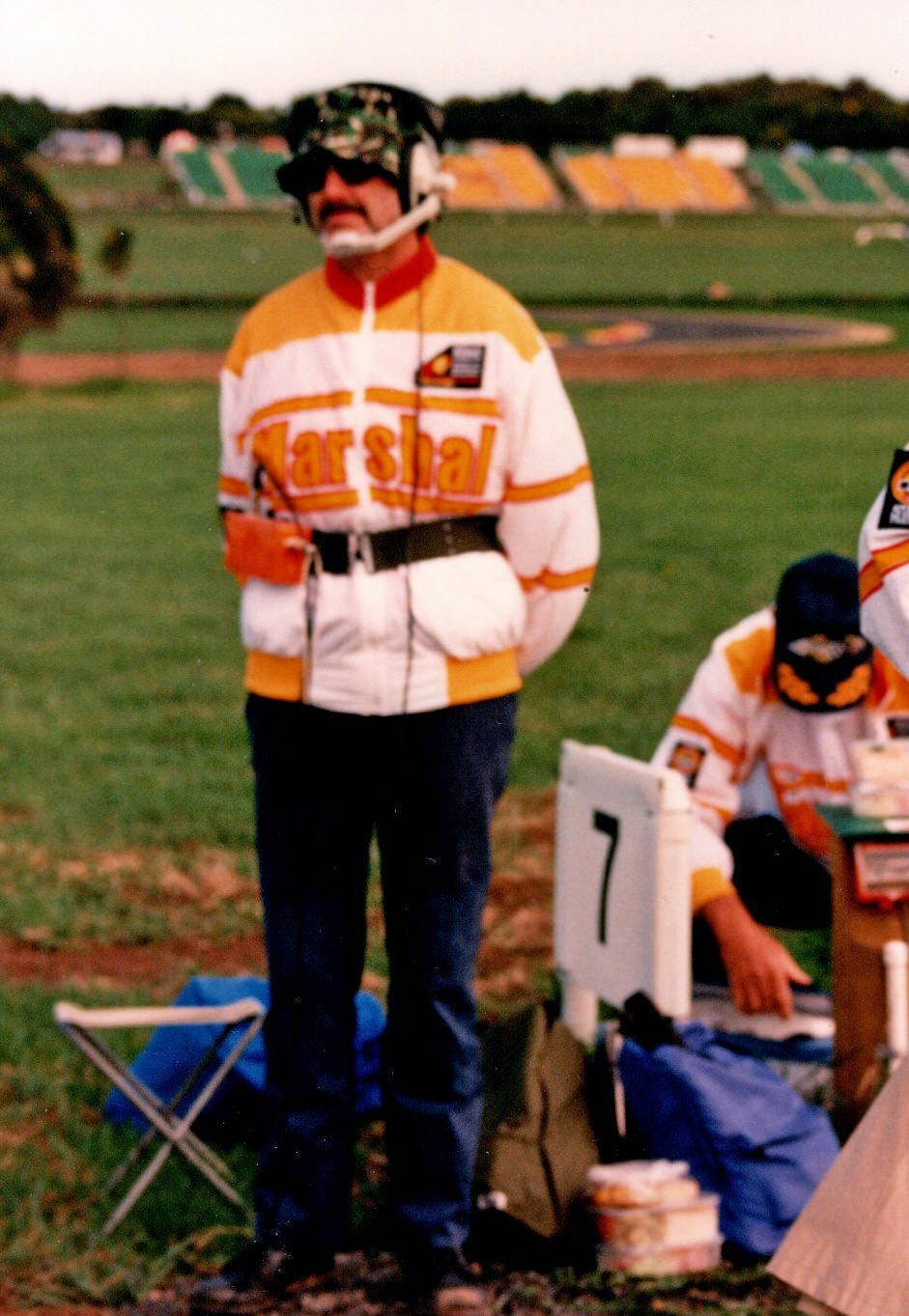 |
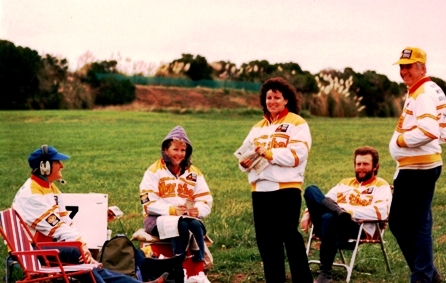 |
| Race marshal Brian |
Race marshal team on station |
Physical effort was often needed to drag a damaged motorcycle off the track. The fallen riders usually walked away no worse than bruised. The evenings were given over to eating, drinking, and socialising.
In the 1980 decade a movement began for Australia to have a round of the World Championship series. This series began in 1949 with races for a broad range of machines designated by engine size(1). For many years there was a class for sidecars(2) but this is now gone from the championship. Motorcycle racing was a popular spectator sport with many meetings held every year. The world championship was largely Europe-based but grew to encompass Asia, North and South America and, eventually, Australia.
One of Australia’s motor and motorcycle racing venues was on Phillip Island, a small island, perhaps best known for its large colony of Little Penguins, which emerge from the ocean every evening and waddle up the beach and into the hillside to their burrows, watched by adoring hordes of tourists. The island is accessed by a graceful bridge spanning the mouth of a bay, about 125 km (80 miles) south of the state of Victoria’s capital city of 4.5 million people, Melbourne.
From 1928 to 1936 racing took place on Phillip Island, on closed-off public roads (including a long-distance car race that later moved to the NSW city of Bathurst and became the Bathurst 1000 Supercar Race, which is still raced on a specially prepared, closed-off road circuit around the hill called Mount Panorama in that city) but racing on public roads could not continue generally. In 1952, the Phillip Island Auto Racing club (PIARC) was formed, ground was acquired, and a circuit was built. Racing began there, in the south of the island in 1956 and continued until 1978, when cost considerations saw its closure.
Australia had never hosted an official round of the Motorcycle World Championship although it held its own major championship meeting every year, at which our marshals’ club officiated. We saw the best of Australia and New Zealand’s racers, but we never saw the major international stars. Australia had a history of producing good racers, producing several world champions in different classes(3) but all the events were on the other side of the globe, in an era before live, full-colour TV became available universally.
The Australian government’s special multi-racial TV station, set up to cater to the large number of new citizens of many races, gave motorcycle racing a huge boost by acquiring the world championship series local live broadcasting rights when the price was still modest. The deep pockets of subscription TV channels eventually saw free-to-air Grand Prix racing disappear.
Footnotes
(1) 1: The classes originally included machines with tiny engines of 50cc and 80cc (popular due to the large number of small engine capacity mopeds in France and Italy, ridden by schoolboys and adults alike after WW2) raced by young teenagers, up to powerful 500cc machines capable of very high speeds. In that era, two-stroke engines were most common as they produced a lot of power for their weight and simplicity. Over the years refinement of classes and engine development have led to the situation now, when there are three classes only – 250cc, 765cc and 1000cc. The senior, Moto GP class has a prototype engine. The Moto 2 uses a Triumph Motorcycles engine which is also fitted to standard production motorcycles and the Moto 3 class is open, with several manufacturers involved. All the engines now used are four-stroke. The need to streamline meetings and to meet rigid world-wide TV broadcast schedules has contributed to the continuing development of the machines and the meeting formats. Machine failure is rare and fierce competition is guaranteed.
(2) The sidecar class had no engine size restrictions, and most racers chose the most powerful motor for its weight that they could obtain. The ‘outfits’ were hardly recognisable as motorcycles, having sleek, aerodynamic bodies with a basic platform on one side with two grab handles, which the ‘swinger’ used to stay on board as he leapt from side to side, crouching low, to aid the rider on bends. The ‘rider’ actually rode lying prone in most cases to minimise machine height and decrease wind resistance. When a sidecar racing motorcycle loses control it can go anywhere. Two-wheeled machines are more predictable. Race marshals are wary of sidecar races and those who race sidecars are often considered the ’wild men ‘of the sport.
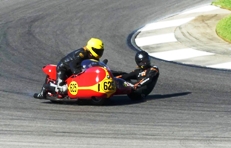 |
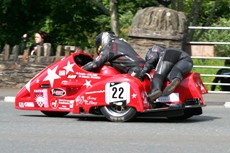 |
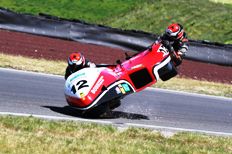 |
| Mid-turn to the left |
Mid-turn to the right |
Mid-crash |
(3) Tom Phillis, the first of a family of that name, won the 125cc world title in 1961. Kel Carruthers won a 250cc world championship in 1969 and later successfully managed the teams of two world champions, living to be eighty-five at time of writing. Barry Smith, born English but an adoptive Australian, won several international championship races in small capacity classes.
The first Australian to win a modern era world premium grand prix championship title was Wayne Gardner, born in the NSW city of Wollongong. He began his racing on grass tracks, so learned the art of controlled rear wheel sliding, a skill that stood him in good stead later. Progressing to road racing in his teens, he finished second in his first race, the 1977 Australian championship, on a second-hand Yamaha, with little financial backing. Not long after, he had his first win on tarmac. In 1981, he and his team-mate won a prestigious long-distance superbike4 race, racing for a privately financed team against major factory-backed teams.
Since Gardner ‘broke the ice’ there have been many Australian GP stars. Mick Doohan won five championships in a row, all riding for the Honda factory team, in the 1990s. Casey Stoner won two championships on different brands of machine in the 2000s. Australian riders also feature large in World Superbike Championship(4) (WSBK) history. Troy Corser was twice WSBK champion. Troy Bayliss won three. Chris Vermeulen won a World Supersport (600cc) championship.
Jack Miller currently rides for the Austrian-owned KTM factory team and won several Grand Prix races riding for the Italian Ducati factory team.
Regrettably, although Scotland has produced a number of highly competitive riders, none has won a world championship, unlike in F1 racing, where Jim Clark and Jackie Stewart are famous names. England’s main claim to GP fame may be the London-born Barry Sheene, who won two world titles in 1976 and 1977, although the earlier Mike Hailwood was a highly regarded race winner. Sheene is often credited with bringing major sponsorship money into the sport by adopting the placing of brightly coloured company logos all over his leathers and motorcycle for large fees.
(4) A superbike is a 1000cc four-stroke motorcycle that can be bought off the shelf for road use. The rules for superbike racing allow little in the way of modifications from original factory specification. The very popular World Superbike Championship (WSBK) series is supported by all the major manufacturing companies. Superbikes are not as fast as Moto GP machines, being heavier and road-standard, albeit state-of-the-art technology, whereas the GP machines are experimental factory prototypes, and every aspect is continually being upgraded and refined. They are also much lighter in weight, with a minimum weight limit imposed.
To be continued...
|
|
 |
 |
The Puhllishee
Hugh McGrory |  |  |
It was the mid-seventies, and I was back in Dundee for a couple of weeks, sitting in the kitchen having breakfast with my mother in her home. For those who know the town, it was a flat in a tenement building on the north side of Clepington Road, just east of Strathmartine Road.
We were chatting when suddenly - BANG – the house exploded! At least, as we were getting sprayed with broken glass it certainly felt like an explosion… We realised that it must have come from outside, since pieces of the window were spread over the floor. After we got over our shock, we tried to figure out what had happened – a gas explosion, a bird strike, a brick, a bullet…? We went to the window and looked out and quickly realised - we’d been puhllisheed!
Dundee had built many tenement dwellings throughout the 19th century, usually three or four stories, two flats per storey, mainly for families flooding into the city to work in the blossoming jute trade. One of the problems (before the days of clothes dryers) was how families could dry freshly washed clothes. It was very common for a large wooden pole (like a very large telephone pole) to be planted in the back yard then each
|
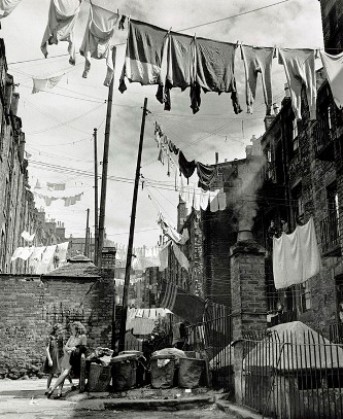 |
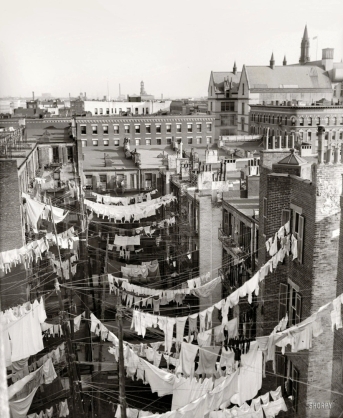 |
| Dundee, Scotland |
New York, USA |
of the flats above the ground floor could install a pulley system.
A pulley would be fixed to the pole for each flat above ground level, with a second pulley attached to the
building in a position such that the lady-of-the-house could reach it from her window. This worked best with double-hung windows where the upper sash could be lowered.
The DSL (Dictionaries of the Scots Language) notes various spellings for such a system over the centuries: in 1704, pullieses; 1751, pulleyshie; 1828, pillyshee; 1929, pullishees; 1943, pulley-hees… My gran and my mother referred to it as the 'puhllishee'.
Getting back to the day our home exploded, you’ve probably guessed by now what happened - the clothesline pulley for the home on the top floor had pulled out of the pole. The pulley, weighing a few pounds, swung like a huge pendulum on thirty or forty feet of rope and smashed through our window. If we had been closer, severe injury or death might have resulted – as it was, we were sitting some distance from the window and neither of us suffered any harm.
A few minutes later the upstairs neighbour knocked on our door to apologise. The window was repaired quickly and the puhllishee replaced - no harm done.
Outdoor clothesline pulley systems are still used around the world. If you're interesteed you can see how to construct one here.
|
|
During my eighty-nine years on this planet, I have moved home thirteen times plus some short sojourns in various Royal Air Force establishments. Every move was within the UK, the shortest distance only a stones-throw away and the greatest over six hundred miles. The one thing that each move had in common was that we moved with various bits and pieces that we should have left behind.
Taking full account of my advanced age, the fact that I am comfortably settled in my present abode and barring a major change of circumstances I think it is unlikely that I will be moving house again. Having reached that conclusion I decided that it was time to get serious about downsizing, a posh way of saying let’s get rid of the collected junk that we have gathered over the years. This was easier said than done!
Our final move into our present home, a bungalow, was from a flat in a large stone built Victorian villa. Our flat had eleven-foot ceilings with access to an enormous floored attic. Needless to say that, when we moved in, anything that was not for immediate use found a home in that attic until we got around to sorting through it. Not only did we fail to get round to dealing with what we arrived with but in the thirteen years that we lived there we managed to add to it a further significant amount of bric-a-brac and items of questionable use in various states of repair! We agreed that we must do some serious downsizing before we moved into the bungalow but of course preparing for a major move on top of our normal busy lives meant that we only just scraped the surface.
Just about everything that we looked at brought back a memory. Broken toys, damaged books, and sports equipment, out of date clothing, ornaments, and boxes of photographs, they all had to be looked at and memories discussed. Eventually time ran out and a new strategy evolved, we would put the unsorted items into the garage of our new property and sort it out at our leisure … aye, right! What actually happened was that we did put it all in the garage, but we didn’t get round to the second bit, and this is why I have spent the last couple of weeks dealing with past mistakes!
After living in our bungalow for nearly twenty years, events meant that over several months I, with the help of family and friends, undertook a major clear out of the cupboards, drawers, and hidey holes, within the house and shipped most of the product to a local charity shop. The completion of this project left me master of a comfortable, reasonably-well organised house and the nightmare of a garage filled with an ill-ordered jumble of bags and boxes stuffed with the detritus of a lifetime. I knew that I had to tackle this problem so I did what any right-thinking man would do, I sat down with a restorative glass of Scotland’s finest and gave it some thought. Six months later I had the solution...
I would find someone who would be prepared to undertake the clearance under my direction for a modest fee. After a fruitless search for someone whose definition of a modest fee matched my own, I met a young couple who did odd jobs and sold all sorts of bits and pieces at car boot sales. After inspecting the contents of the garage, we agreed that they would undertake the job for a flat fee and that they could take possession of any items I no longer required. I would be responsible for arranging a skip for the disposal of unwanted material.
Within a couple of weeks all was in hand. The skip arrived on time as did my hired hands I positioned myself as the arbitrator of what items were to be kept and work commenced. After about four hours there was a corner containing those items that I wished to keep and another corner containing those items that my workforce considered saleable. Outside the garage the skip was practically full of bits and pieces that we had once considered important. It was quite a sobering thought to realise that pretty well every item now residing in the skip had once been chosen and purchased by us. After removing their saleable items and sweeping out the now nearly empty garage my hard-working colleagues, seemingly content with the rewards for their efforts, departed. I was left rather tired but very happy that I had achieved the downsizing that we should have done twenty years ago.
What have I learned from this? First, if you want to be popular with your neighbours hire a skip! Every morning for the four days that the skip sat in our drive there was something added to it. One morning there was an old cast iron barbecue sitting proudly on top of the contents. I spotted this about 10.00 am. An hour later I noticed a white van draw up in front of my house, the driver got out and came to the door and asked if he could have the barbecue and any other metal for scrap. I was only too pleased to see the back of it! Second, get help from someone who is not emotionally attached to the items that you wish to get rid of, they can be objective about items that hold a memory for you, you can’t!
They say that a rolling stone gathers no moss. Don’t you believe it!
|
|
Researching my previous story got me interested in the hospital, and I dug a little deeper. Some background first:
Apparently, Danny Thomas, as a young Lebanese American and devout Catholic struggling to make a career in show business, went to a Detroit church to ask St. Jude Thaddeus to guide him in life, and vowed that if he ever became a success, he would build a shrine to the Saint.
Years later, in the 1950s, as a hugely successful comedian, nightclub entertainer and TV star, he told his spiritual adviser, Cardinal Samuel Stritch, that he was going to embark on that project. The cardinal apparently told him that there were enough shrines, that he should consider building a children’s hospital instead, and suggested Memphis, in the cardinal’s home state of Tennessee.
Danny agreed, and with the benefit of his fame, was able to put together a board of Memphis businessmen who worked for years on the project. They decided that the mission would be to advance cures and means of prevention, for pediatric catastrophic diseases, through research and treatment. At Danny’s insistence no child
would be denied treatment based on race, religion or a family's ability to pay. The project St. Jude Children's Research Hospital, came to fruition in 1962, with the appointment of the first director and CEO:
Donald Paul Pinkel was an American physician who specialized in pediatric hematology and oncology, particularly leukemia. He arrived in Memphis in early 1962 to a brand new hospital with empty rooms, no equipment or furniture, and no employees. One of the first things he did was to set up a lab where he could continue his cancer research in his ‘spare time’ while tackling the huge task of getting the hospital and research facility up and running.
While the hospital grew to treat all kinds of catastrophic pediatric diseases, Dr Pinkel was particularly interested in ALL, Acute Lymphoblastic Leukemia, the most common form in children.
At the time, a common situation was for a child to present with ALL and be treated with one of several chemotherapy drugs available. Often the disease would go into remission for several months, sometimes up to a year before returning. The child would then be treated with a second drug, and a briefer period of remission be achieved might occur. This process might continue for some time but almost always failed. The survival rate was around 4%. A diagnosis of childhood leukemia was considered to be a death sentence.
Dr. Pinkel and his team identified four major obstacles to its cure: drug resistance, drug toxicity, meningeal relapse and most important, pessimism. They instituted a treatment program called ‘Total Therapy’, based on all the available relevant laboratory and clinical research and experience – the goal was to eliminate
childhood leukemia.
There were four phases: remission induction, remission consolidation or intensification, specific pre-emptive meningeal treatment and continuation chemotherapy for three years. Instead of using the available drugs serially, they used them at the same time in a massive attack on the disease. Both radiotherapy and instillation of drug directly into spinal fluid were used for meningeal treatment. Some of the children suffered terribly from the chemothrerapy but the end justified the means.
A second line of attack was based on the developing science of genetics. By examining the child’s DNA and that of their leukemia, treatment could be customised.
Dr. Pinkel and his colleagues also pioneered the multidisciplinary team approach to children with solid cancers, the use of adjuvant chemotherapy to prevent metastases and of neoadjuvant chemotherapy to shrink tumours prior to surgery or radiation therapy.
Within seven or eight years the success rate at St. Judes rose to 50%. The approach is still used today with, of course, numerous modifications over the past sixty years. Increases in resources and trained physicians and nurses, better infection control, safer blood transfusion and newer drugs and drug schedules have increased the reported cure rates to 75-85% of treated children with ALL in developed countries. The most recent figure for survival rate of St. Jude patients with ALL is 94%.
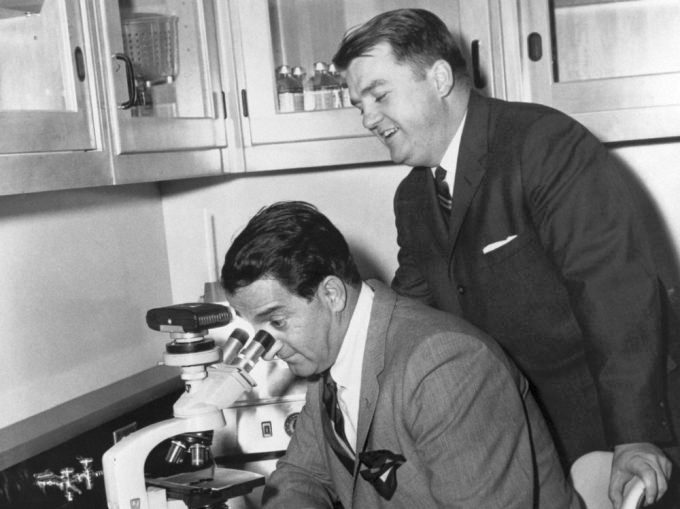 |
|
Don Pinkel explaining to Danny Thomas what he is looking at. |
Dr. Pinkel left St. Judes in 1973 and took leadership roles at a series of hospitals or faculties in Milwaukee, then Los Angeles, Houston, and Corpus Christi. He retired from the medical profession in 1994. He subsequently taught as an adjunct professor at California Polytechnic State University, San Luis Obispo. He died on March 9, 2022, at the age of 95.
Truly a great man...
|
|
 |
 |
A Shameful Scene
Gordon Findlay |
 |
 |
Once the rest of the regiment had left our camp in Tobruk, it suddenly looked quite isolated, lots of wide-open ground, discarded boxes, and some broken beds and chairs. We could see a lot of the locals had gathered outside the perimeter wire, adults and children, just staring in at us as we worked. Obviously, word had spread around Tobruk that we were leaving.
Some of the kids were ones who had drifted around our camp over the past months. They were a pretty ragged lot but usually pretty cheerful, and of course, were always looking for a handout. A lot of our guys gave them candy, or worn-out socks, or the odd bit of local change.
We would wave to the kids if we were driving past. The adults were a different matter; they weren’t openly hostile, but they also were not particularly friendly. They simply ignored us and we ignored them.
Our I-Section stuff got all packed (I checked my list a dozen times) and the other rear party troops all gathered for a last walk around the area to check and make sure nothing important had been left lying around. Then, I and just about everyone else climbed into the trucks on which our stuff was loaded.
As we gathered near the old gates of the now almost-empty camp, the last items were dragged out of the buildings which had housed the sergeants quarters and some of H.Q. Company. These were mattresses, dozens of them, that had been on our beds. For most of us these were pretty simple, thin things, but the mattresses of the sergeants and officers were thicker and of better quality.
A few were torn, some were stained, but most looked all right; however, it had been decided they were not worth taking with us. They were all dragged out to form a huge pile on what had been our parade square.
The Pioneer corporal who was in charge of this work crew then came out of the old sergeants’ building with a jerry can of gasoline. He opened it and sloshed it all over the mattresses. Then he took a signal flare, ripped off the tape at the end, and when it immediately ignited, he tossed it into the middle of the pile. There was a“whoomf!” and bright flame came bursting upwards. That was the signal for our trucks to start moving out – but I really wasn’t prepared for what happened next.
There was an instant surge forward from all the Libyans around the wire. Some of them pushed big empty metal drums against the wire where it was lowest, and they climbed up these and over the wire in an instant. We had no sooner cleared the front gates when the flood of Libyans reached the pile of burning mattresses and began pulling them out of the flames, thumping them against the ground, throwing sand on them and beating them with their hands to stamp out the flames.
It was a frantic picture, because some of the mattresses were well alight when they dragged them away from the centre of the pile, and here were men dressed in their flowing dishdashas and keffiyehs, trying to dodge the flames licking at them while beating and stamping at the flames.
Everyone was shouting and yelling. Even the little kids were helping, picking up handfuls of sand and throwing them on the smoking mattresses. With the clouds of smoke, the flames, the dust, the screeching adults and burning bits of fabric floating in the air, it was like a mad scene from Dante’s Inferno.
The thought that was driven hard into my mind was simply: Who drafted the order to burn all the mattresses we had decided weren’t worth the effort of shipping to Malta? Why the hell didn’t we just pile up the mattresses and leave them for the locals? Or invite them in as we left to take what we weren’t going to take with us – or had no use for. It was not an episode for any of us to be proud of, and I’ve never forgotten it.
But, for the rest of us, it was another long drive to El Adem, where we saw all our crates and boxes loaded aboard the Army transport planes. Then we climbed into the Spartan interior, clipped ourselves into skimpy little seats and an hour and a half later, were circling down to land at Hal-Far airfield in Malta. My days in Libya were over.
|
|
This little story comes with my guarantee – if you read it to the end and watch the video (it’s only 30 seconds long), then, despite the sad world we live in today, no matter how you felt when you began to read, you will feel better.
To the story:
Jude, short for Judas, and known as Jude Thaddeus to distinguish him from Judas Iscariot, was one of Jesus’ disciples. After the crucifixion he worked to spread the gospel until he was martyred around 65AD in Beirut. He was sanctified as St Jude, Patron Saint of Desperate Cases and Lost Causes.
St. Jude is the name chosen for the ‘Danny Thomas’ hospital – ( St. Jude Children's Research Hospital in Memphis, Tennessee, which has helped many children with terminal illnesses, and their families, since its founding in 1962). St. Jude is not a Catholic hospital, it’s a secular institution supported by donations, and patient’s families are never charged for treatment, travel, lodging, or food.
At about this time each year, St Jude runs extensive TV ads. to solicit donations. These ads. showcase
some of their patients and families. A recent one featured the story of Delta and her parents Hayden and Chelsie.
Delta who suffers from ALL, acute lymphoblastic leukemia, was diagnosed in December 2023, at the age of three and is receiving intensive chemotherapy treatment which will continue into 2026. The cure rate is an astonishing 94%.
The following video was taken by Mum as they waited for Daddy to come from work for a visit. I’ve seen it several times in the past month, and my eyes tear up every time…
See it here (it’s only 30 seconds in length - don’t forget to turn on the sound).
| |
 |
|
|
 |
 |
Kicking with the Left Foot
Brian Macdonald |
 |
 |
If you were brought up in Dundee in the mid-twentieth century you will know that the phrase above has a discriminatory colloquial meaning. But it also means exactly what it says. I found, when young, that I naturally swung my left leg, not the right one, when a fitba’ rolled in my direction. But this article is not about either religion or how I kicked a ball for those days are far behind me. It’s more about ‘handedness’ and of course, handedness and footedness go together. One side of a person’s body, and thus the limbs on that side, is usually dominant and more capable than the other.
The English poet, Philip Larkin’s oft-quoted poem, written a hundred years ago, about how the traits of one’s parents contribute largely to the individual’s own development certainly rang true in my case for my father was genetically left-handed and had no sense of smell, (which I found had a name - ‘anosmia’ but that’s a different story) and I inherited these traits. In mid-twentieth century Scotland, being left-handed was considered to be a physical aberration to be stamped out by determined and sometimes punitive correction and not just a fairly unimportant fact of life to be dealt with and easily overcome.
As ninety percent of humans have a dominant right hand, all devices, equipment, machines that need one hand to operate more dexterously (note the word) than the other are designed, rightly (note the word), to favour right-handedness. Handles are shaped to fit a right hand, not a left. Such simple things as tin-openers and scissors for example. One major bane of my life at school was pens. Writing was fine with a chalk or a pencil although teachers could not seem to understand the strange hand and arm position used by left-handers. An art master, Mr Kay, often called ‘Kayser’ behind his back, once slapped my head for he had a withered arm and thought I was mimicking him.
In Britain, in the script commonly used, a right-hander writes away from what has just been written, with the wrist straight. A left-hander has to write with the writing hand rubbing on the paper where words have just been deposited. So, when using an old-fashioned ink pen, which was the standard for most of my school years, many left-handers wrote with the writing hand looped tortuously round above the words being imparted to paper to minimise smudging. In addition, since nibs were made for right-handed writing, pushing the pen instead of pulling it across the paper often made it jag into the paper and create ink blots. It was only when I discovered Parker brand fountain pens that I found a nib that flowed smoothly for left-handed writing. Then, of course, came ball-point pens and fibre pens but care was still needed as the ink still smudged. I never won any plaudits for handwriting and for many years have written even personal letters with a computer. At least, that way, the reader can read my ‘writing’.
In the more enlightened twenty-first century, we know that approximately ten percent of humans favour their left hand over their right. Being left-handed was fine until I was five and stepped through the gates of the Morgan Academy for the first day of thirteen years. It was only then that I found my handedness being attacked. For most of my primary school years well-meaning teachers tried to ‘convert’ me from left to right. I was often singled out for little tests such as being told to pick up the free small morning milk bottle from its crate. I often, with no conscious thought, use my right hand for tasks that do not require fine motor control, and the teacher would take this as justification and say that there was no reason I used my left hand for some major tasks. Needless to say, none of them had any success. I remained, defiantly to them but naturally to me, dominantly left-handed.
At my now advanced age I have no difficulties. For most left-handers learn to be almost as capable with their right hand out of pure necessity, but still need to resort to the left when fine motor skills such as for penmanship and cutting are needed. I learned the art of hand-cutting shoe uppers from fine leather, known as clicking, because the blade personally shaped from a used hacksaw blade and honed to razor sharpness by the user makes a clicking noise as it is expertly guided round the edge of a card or metal pattern piece. This is a skill that takes time to absorb and concentration to get right, cut clean and accurate and avoid slicing into fingers. When young, I learned to use knife and fork in the right-handed manner although I hold a spoon in my left. I have seen some who need to change the knife and fork over, clearly with a lower level of both-hand ability.
As a young soldier I had no difficulty with rifle drill and my firing position was a right-handed and right eye one although I recall one poor devil who, no matter how much practice he did and how patient the drill sergeant was with him, still managed to end up with the weapon in a totally wrong position and in the wrong hand. He sometimes found himself marching in a different direction to the rest of our well-drilled squad. For any parades, that lad was discreetly left in the barracks.
Even descriptive words favour right-handers. The very words dexter (right) and sinister (left), from Latin roots, have come to mean more than they should. Anyone blessed with dexterity is good with his or her hands and more able to accomplish difficult finger tasks than the average person. The word ‘sinister’ also means that something ‘evil’ or ‘harmful’ is likely to happen. A ‘southpaw’ is a boxer whose natural stance is right foot and hand forward, unlike the majority and is considered a more difficult opponent for that reason. The Scots dialect words ‘pally jeukit’ and the English ‘cack-handed’ both mean left-handed but have a pejorative aspect of clumsiness to them. The person on the perceived more correct side of an argument may be said to be ‘in the right’. Anyone who is good with both hands is ‘ambidextrous’ i.e. has ‘two right hands’.
There is a faint light in the tunnel though. Some of the world’s greatest cricket batsmen (for they are mostly men) and tennis players of both sexes have been left-handed. It is said to have something to do with the speed of transmission of signals from brain to hand, for these are both skills that demand a very high speed of reaction. In baseball, a batter who has a left-handed stance is fractionally closer to first base, an advantage and may discomfort a right-hand pitcher, the majority, whose angle to the left-hand batter is different.
Sadly, just being left-handed alone does not qualify someone to ascend to great sporting heights but it is nice to know we plain old ‘lefties’ do have some small advantages. As for being ambidextrous, a good rugby scrum half needs to develop a high level of ability with both hands and both feet and coaches study which side of the body opponents favour. Maybe left-handers have a bit of a start there? Regrettably ambidextrousness on its own is not something that can be parlayed into a career or life-enhancing opportunity. However, a lifelong ‘leftie’ now need not fear discrimination on account of this trait in a western democracy although you need to be careful in an Islamic country for in many such lands the left hand is regarded as ‘unclean’ and is used for lower order tasks and not used for tasks of a higher order such as holding food.
I raise my whisky glass to toast you, my reader, with my firm, steady left hand but be assured, there is nothing sinister in that.
Slainte!
|
|
Some of you may remember my story about my Uncle Wullie who was killed in WW2, in the North Atlantic. The merchant ship he served on was torpedoed by the German submarine, U-108.
I’m in awe of the men who served as submariners, and would have liked to have a tour of a U-boat – while this never happened, I had a close second:
In the mid-seventies I was in Baltimore, MD, for a few days and one afternoon, having a few hours to spare, I wandered down to the harbour and found not only a genuine WW2 submarine, the USS Torsk, but it turned out to be a museum ship and open for tours. American submarines, at that time, were named after fish and Torsk is a Norwegian word for cod.
|
USS Torsk |
 |
 |
|
Length 311'8"; Beam 27'2"; Draft 15'3"; Complement 81. |
The Torsk was commissioned in December 1944 and only did two war patrols before the war ended – nevertheless it still has a claim to fame:
At the start of August 1945, USS Torsk departed Guam for her second war patrol. On 11 August, Torsk rescued seven Japanese merchant seamen clinging to a life raft - their cargo ship had been sunk several days earlier by U.S. aircraft. Torsk continued on to her patrol area, entering it that afternoon.
On the morning of 14 August, Torsk sighted a larger cargo ship accompanied by the Kaibōkan No. 13, an escort vessel. Torsk fired an acoustic homing torpedo which blew up the stern of the escort at a 30-degree angle - she sank shortly thereafter.
|
Kaibōkan - Japanese Escort Vessel |
 |
|
Length 280'0"; Beam 28'3"; Draft 10'0"; Complement 160. |
Another escort vessel, Kaibōkan No. 47, approached and located Torsk on her sonar. Torsk fired a torpedo at her (which ultimately missed), dove to 400 feet, and initiated silent running. Torsk then fired two more torpedoes on sonar bearings at the Kaibōkan. One found its target and exploded against the ship’s stern, whereupon she developed a starboard list and sank ten minutes later.
For the next seven hours, Torsk was held down by aircraft and other escort vessels before she was able to escape. The following day (15 August), Emperor Hirohito went on the radio and announced to the Japanese people that they would have to “bear the unbearable.” Japan had finally surrendered. Thus, Torsk fired the last torpedo shots of WWII and became the last U.S. Navy submarine ever to fire torpedoes in anger (thus far...)
|
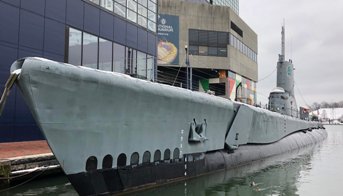 |
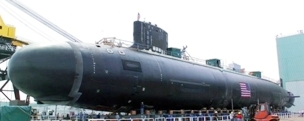 |
| USS Torsk |
Modern US Submarine |
Take a look at the two photos above. You’ll see that the boat on the left looks like, well, a boat. The modern sub looks like a cigar. Quite a change in design over the past 80 or so years. Why is this?
Well, most people think of subs as boats that operate under water. This wasn’t really true for WW2 submarines. They, in fact, spent most of their time on the surface and only submerged to evade being spotted by the enemy, whether they were hunting, or being hunted. So WW2 subs were designed with prows for riding surface waves. Modern submarines are designed to be as efficient as possible when travelling underwater.
A sub like the Torsk could stay under water for somewhere between 24 and 48 hours. Towards the end of that time, the crew could tell that they were running out of oxygen bacause the air was so fetid that it was hard to breathe, and their cigarettes took longer to light (talk about irony...)
Modern subs are air-conditioned having CO2 scrubbers, and manufacture fresh oxygen from sea water (they pump the hydrogen produced overboard underwater). They also desalinate sea water for drinking, cooking, and washing, and can stay underwater as long as there is food for the crew, typically up to 3 months.
I found the tour of the Trask to be very interesting and left with two overall impressions:
The first was amazement at how they managed to get so much ‘stuff’ into such a limited space. While a few
|
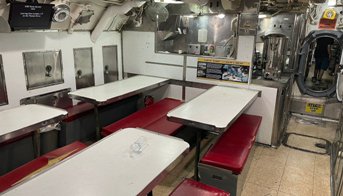 |
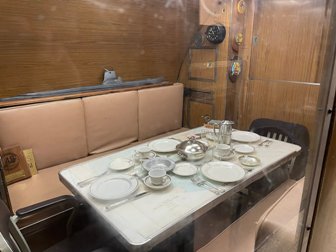 |
| Crews mess - seventy one crew needed three sittings for each meal. |
Officers mess shared by ten. |
of the rooms were relatively spacious, when travelling throughout the boat your shoulders are often within inches of machines, control panels, storage lockers, bunks etc.
The second was wonder at how men could live and fight in such conditions. (They were all men then - most navies of the world now have some female submariners.)
At the best of times WW2 submarines had a distinctive penetrating smell – a combination of diesel fuel, hydraulic fluid, amine (chemical catalyst used to clear CO2 from the air – smells like fish or ammonia), sweat and BO, cigarettes, cooking, and sewage.
Can you imagine sitting, in silence in such a metal tube under several hundred feet of water for hour after hour, hearing depth charges exploding nearby as enemy ships circle above, knowing that your oxygen would be depleted in a few more hours?
|
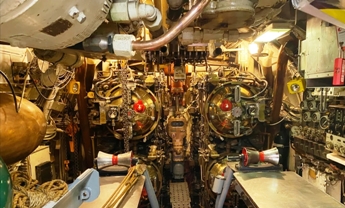 |
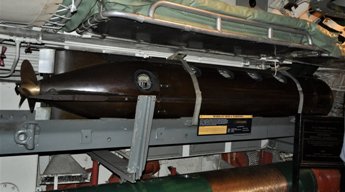 |
| Forward Torpedo Room |
Again showing a stored torpedo. Note the green at the top is a mattress on one of the crew's bunks. |
The two most dangerous occupations amongst military personnel in WW2 were bomber crews and submariners. Submarines played a major role in the victory. Losses during World War II were significant for many countries:
Germany lost 765 submarines; Japan 129; Soviet Union 98+; Italy 91; Britain 73; United States 52. This equates to approximately 100,000 men.
|
|
For most of the first two decades of my life I gave little or no thought to left handedness. No one in my immediate family was'pally-handed' and I didn’t play any sport that being left-handed was an issue. All this changed when I met my wife-to-be. Muriel was almost completely ambidextrous, she would write, draw, or paint with whichever hand happened to be convenient. Sometimes she would change hands while writing a letter and it took a skilled eye to see where the changeover occurred. As a party piece Muriel could write with both hands at the same time, although producing a different text simultaneously was beyond even her! She attributed this talent to her early years at school when teachers insisted that she learned to write with her right hand even ‘though she was naturally left-handed. Racquet sports and golf were the only activities in which she was exclusively right-handed.
It would appear that being left-handed has been frowned upon for a very long time and this is reflected in language. In Latin, the word for the right is “dexter” and in English to be dexterous is demonstrating skill with the hands. “Sinister” in Latin refers to the left, in English the word suggests trouble and ill fortune. The French word for the left and right is “gauche” and “droit” while their use in English about someone being gauche suggests that s/he is socially awkward while to be adroit suggests skill and cleverness. With this kind of thinking it is hardly surprising that children in
bygone years were forced into right handedness.
One of the bloodiest stories in the Bible can be found in the book of Judges (Ch3;V12-30), This tells the story of Ehud, a minor judge who was left-handed. Ehud was tasked with taking a tribute to Eglon king of Moab and while he was about it, to kill the King. In order to do this Ehud had to get past the King’s security. As right-handed people carried their sword on their left thigh Ehud carried his on his right. The security guards, not realising that Ehud was left-handed only checked his left thigh and allowed him to take his sword into the King’s presence and carry out his regicide. I assume that the training of security guards was reviewed following this incident. As Ehud was carrying out the will of God, he is the only left-handed hero named in the Bible. The Book of Matthew shows partiality for the right hand in describing how God will divide nations on the Day of Judgment, comparing this to a shepherd separating the sheep from the goats. The sheep will be on God’s right hand while the goats will be on his left. The goats will then be sent to Hell. Stories like this sometimes led to accusations that left-handed people were suffering from demonic possession or even witchcraft, neither a very happy thing to be accused of!
The truth of the matter is that the tenth of the population who are left-handed have had to adopt to living in a right-handed world. They become adept at overcoming problems involving the use of tools and other items designed for use by a right-handed person. In sport, being left-handed can often be advantageous as the left hander has probably had ten times more experience at playing against a right-handed opponent than the other way around. Sometimes individuals find that there are some things that do counter to their normal handedness. Although I am strongly right-handed, I discovered that I am a left-handed snooker player and archer and that I fire a rifle from my left shoulder. I cannot claim that I have enjoyed any success as a result of these anomalies, but I live in hope.
Physical situations that are difficult for the majority are often straightforwardly simple for the lefty. Nevertheless, there is a solution for anyone finding it difficult to adapt. Worldwide, including the UK, there are shops that sell left-handed goods such as tools, scissors, and kitchen appliances. Now there’s a thought, how about a special Christmas or birthday gift for a “southpaw” buddy?
|
|
 |
 |
Houseboating 5
Hugh McGrory |
 |
 |
In a recent anecdote Bill Kidd mentioned that, as a child of three, he was admitted to hospital (Dundee Kings Cross Fever Hospital), suffering from diphtheria. This struck a chord for me, since I shared that experience, at the age of two or three – I too had diphtheria and was in Kings Cross.
My memories are quite sketchy – looking back to such a young age I’m never quite sure if I remember an event or if I’m actually remembering what my elders told me about it… I think I remember being in an isolation ward - a wooden annex in a corner of the hospital grounds. It had a set of steps at each window so that parents could come to see their children – no visitors were allowed into the ward, of course.
Diphtheria (dif-THEER-e-uh) is a serious bacterial infection that usually affects the mucous membranes of the nose and throat. It can be treated with medications, but in advanced stages, can damage the heart, kidneys and nervous system. Even with treatment, diphtheria can be deadly, especially in children.
Symptoms usually begin 2 to 5 days after a person becomes infected, and may include:
A thick, grey membrane covering the throat and tonsils
A sore throat and hoarseness
Swollen glands (enlarged lymph nodes) in the neck
Difficulty breathing or rapid breathing
Nasal discharge
Fever and chills
Tiredness
In researching this piece I came across ‘Helen’s Memoirs’ in the Bygone Dundee website – an excerpt follows:
“Being ill before the National Health Service I recall being ill at about 6 years of age. I had a very sore throat, and my mother got a neighbour to check me out. He looked down my throat with the aid of a spoon, realised how bad it was and suggested a doctor be called. My mother was very reluctant as she told him she was due the doctor 8/- (40p) for previous treatment (unpaid). However she ran from Hill Street to Byron Street for Dr Saggar and God bless him he came at once. Diphtheria was diagnosed. I was duly carried down in the Ambulance man’s arms and transported to hospital. The windows of the ambulance were dark shaded, but you could see out of the top part. It was a tree lined street I was travelling along, and I could only think of Riverside Drive but later discovered Clepington Road had trees. I was duly admitted to Kings Cross the Isolation Hospital. There was a very strict hygiene regime in place. Visitors were only allowed at the windows which had steps up to view in. Everything was sterilised and I had a penny with a hole in it tied round my neck when I went in, and I never got it back after a very long 6 weeks entrapped.
The Matron was very strict but turned a blind eye to the children sliding with socks on their feet on a very highly polished ward floor. I wouldn't take my medicine one day and Matron showed her authority by holding my nose and tossing it down my throat, she was rewarded with it right back over her immaculate uniform as I duly brought the whole lot back up, Her stamp of authority shattered. All toys we were given by friends and family had to stay in Hospital after we left. We were all poor then, but family and neighbours got together and had a welcome home party in the back green. I will always remember I couldn't walk after so long in bed, and was sat in a chair by a wooden greenie pole and it was crawling with forkie tailies (earwigs) - I could not enjoy the fun for watching them in the cracks of the wood, I have never really thought about it before, but I've been a private health patient.”
Helen’s mention of the Matron dredged up another memory for me. (I’m pretty sure we’re talking about the same woman…) Some time into my incarceration I messed the bed. I don’t remember exactly what the matron said or did, but she really scared me regarding what would happen if I did it again. Either deliberately or subconsciously, I came up with a solution – I would stop pooping altogether…
Apparently, when I was well enough to go home, I was terribly constipated. Not only was my colon not operating properly, but when I tried to go it was very painful – a major disincentive, of course. My mother took me to our family doctor (Dr. Jacob in Victoria Street). I guess he probably prescribed some type of appropriate laxative, but he also had another suggestion… He told her to take a bar of soap and cut it into the shape of a finger, then before she put me on the pot, she should first dip the soap in hot water and use it to lubricate my poor little butthole. I can remember once lying across her knee in front of the coal fire while she did it. I guess it worked since I don’t think the problem lasted very long.
Diphtheria isn’t common in the western world because living conditions have improved, and children are routinely given a diphtheria vaccine. However it is still endemic to Asia, the Dominican Republic, Eastern Europe, Haiti, the South Pacific and the Middle East. In 2023 there were 25,000 cases reported worldwide.
I guess, as toddlers, Bill, Helen, and I were fortunate to have been born in a country that had fever hospitals, skilled medical staff and appropriate medication.
I said that my previous story, Houseboating 4, was my last on the subject… Obviously I lied, because here I am again.
As you may have gathered by now, I highly recommend houseboating . It’s sort of like having all the comforts of a rented cottage with the added benefit that it’s also a boat. So in a morning or an afternoon, at the drop of a hat, you can spend a few hours cruising from village to village or, if you prefer, to a secluded mooring spot on an island or the edge of a forest, and settle in with the flora and fauna.
(For a family, I suggest you wait until your kids are pre-teens – toddlers would be hard to tend – and, of course, especially for the weak swimmers, enough life preservers or PFDs.)
For me, this little series has been an interesting walk down memory lane beginning a couple of months ago when I asked family members for their memories, each of which triggered others. Most of us hadn’t thought much about those days until then, and the process brought back to us how much we all enjoyed our holidays on the water for those ten or twelve years. A few more vignettes to end with:
- Being docked on a large lake away from light pollution, on a still moonless night, and lying on the roof of the boat staring up at the sky and the myriad diamonds shining down is an entrancing and humbling experience (photo is a stock print).
|
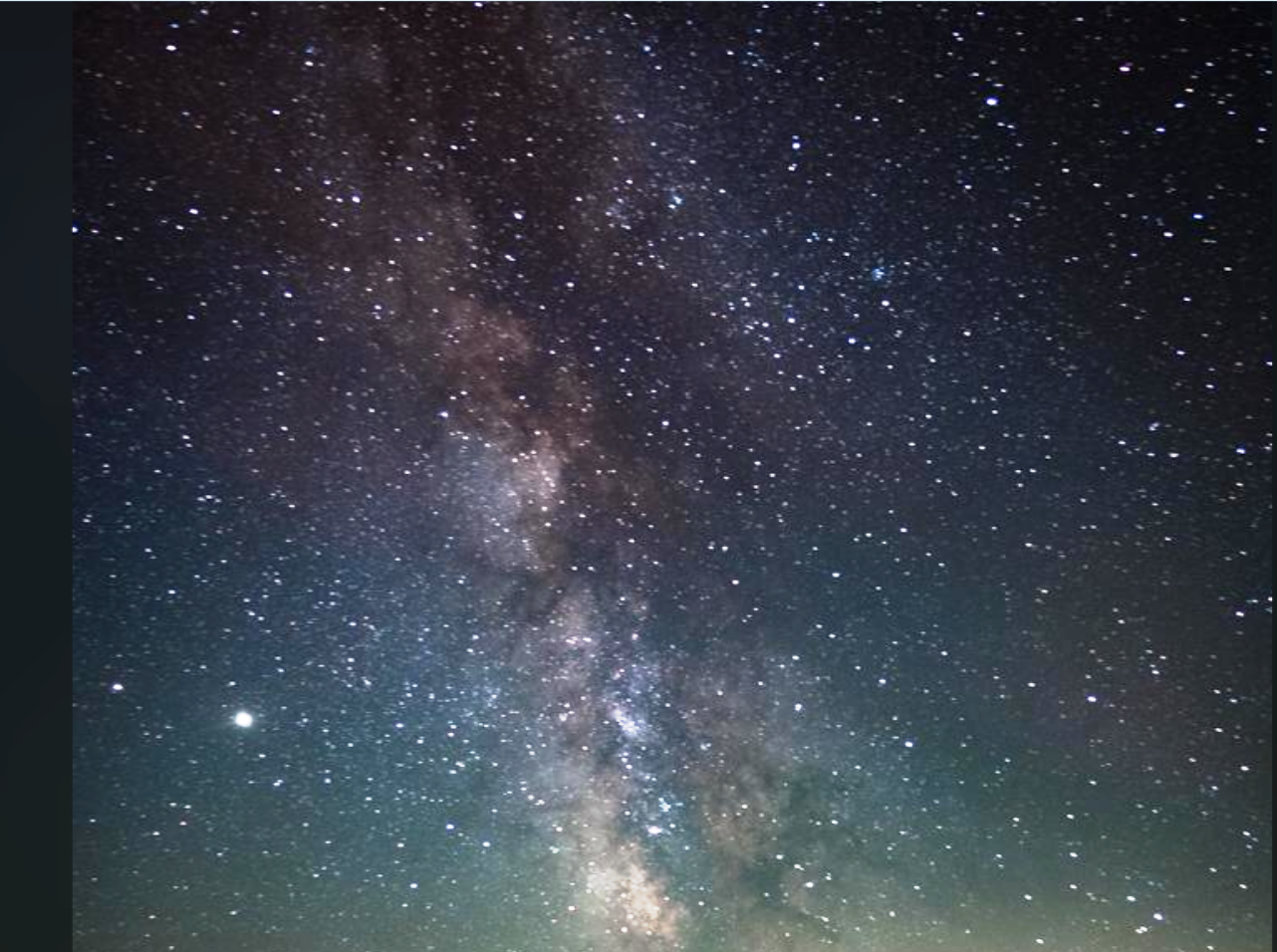 |
 |
| Night Sky in the Kawarthas |
The Perseid Meteors |
One year we stayed up to midnight to watch the Perseid Meteor Shower. This takes place from about mid-July to the end of August. I wish I could say that we saw a show like the time-lapse photo above, but instead, we were quite disappointed. While we saw a few meteor trails, enough to confirm the phenomenon, they were few and far between. Perhaps we missed the peak period which is around August 12th, when up to 100 meteors per hour may be seen.
- One morning we wake up, have breakfast and get ready to move on. I press the starter and there’s silence - not a spark of life… I go to check the battery and the problem is obvious: We had brought a couple of folding chairs with us – sort of director’s chairs with metal frames and fabric seats and back. One of them had toppled over during the night and a leg had landed on the battery, so perfectly aligned with the terminals that the battery was short-circuited - the leg actually welded itself to the posts! Not a major problem – we just had to chill until the company arrived with a replacement battery.
- On one of our early trips, my youngest, Debbie, a pre-teen at the time, came to me one day to say that she had recently seen the movie ‘Piranha’, and was now too scared to go into the water. I don’t remember this now, but she said that she and I came up with a work-around when she wanted to wash her hair.
On the back deck of the boat, she scooped a pot of water to wet her hair, then applied shampoo, and got it well-lathered. I then picked her up by her heels and dipped her head in the water - a swift rinse and then I pulled her out again (repeat as necessary...)
Apparently, this worked like a charm, and she soon got over her phobia.
|
|
 |
 |
A Lifetime of Motorbikes 1
An Early Addiction
Brian Macdonald |
 |
 |
I’ve been a motorcyclist since first I swung my right leg over the saddle of a second-hand 350cc BSA single-cylinder machine in Dundee as soon as I was old enough to do so legally. In Scotland, in 1954, that meant age 16. After some basic training from an older friend and fellow Morgan Academy boy, Cliff Grant, I was off. That training started with an invaluable hour-long session spent solely on repetitively starting the engine by vigorously stamping down the kick-starter lever with the right foot. In those days motorcycles did not have electric starter motors. I have never had a problem since then kick-starting a motorbike, no matter how recalcitrant it was.
I rode all over Scotland and as far as southern England and rambled far and wide across mainland UK. My normal motorcycling protective clothing was a WW2 sheepskin flying jacket and thick leather gauntlets with mitten fingers, with a leather helmet that had a small buckle chinstrap and roll-up ear flaps. That was soon superseded by a ‘Corker’ crash helmet, that did its job one day on wet granite cassies on the Dundee Hilltown. Wet-weather gear consisted of voluminous, shapeless jacket and pants of oilskin. Wellies were worn in wet weather, otherwise just your shoes or old boots.
But just riding a ‘bike’ was not enough when the addiction struck. It was an on-going job to keep your bike in good condition in Scottish east coast weather. Learning to do basic maintenance was essential in those days unless you were more affluent than I was, and a degree of skill and mechanical knowledge slowly grew. Frequent cleaning was needed, to protect the metal against salted winter roads. The ‘Green Un’ was the nickname of Motor Cycling, the most popular general motorcycle magazine. It had a plain green cover for many years since its birth in 1902 but later became more flamboyant. Avidly read every month, it covered everything from technical articles to all forms of motorcycle sport.
Developing an interest in motorcycle sport was inevitable to a rabid two-wheeler man and it was observed section trials riding(1) that first drew my attention. This is a sport conducted at slow speed, with rider finesse. The objective is to cover a short stretch of rough terrain marked out by white tape, without incurring penalty points by stopping, putting one foot or both temporarily down to the ground to sustain your balance or resting your body or bike against the trunk of a tree or a boulder, while keen observers watch your progress. After several such ‘observed sections’ have been attempted, the winner is the rider with the fewest penalty points against his name. There may have been women competitors, but I never encountered any. A medium-sized motorcycle, with non-essentials removed, a small fuel tank and sometimes a specially selected rear-wheel drive sprocket to change the gearing and give the machine greater low-speed torque was the standard weapon. High ground clearance was prized. The machine of your dreams was a Greeves trials bike Skilled exponents of this sport can achieve near-perfection. I was not of that class.
Speed is always an attraction to young car drivers and motorcyclists and a developing sport called scrambles(2) came to my attention, Scrambles is a form of off-road motorcycle racing, in which competitors race a designated number of laps around a rough, hilly circuit marked out over a patch of country. The winner is the rider who has managed not to fall off and has reached the finish line first. In this case the weapon used was often a lightweight, two-stroke-engined machine with everything possible removed for lightness. As the ground got very churned up, especially in wet conditions, the race often ended with riders and bikes liberally coated with mud.
The obvious next step of a love of speed and of motorcycles is an attraction to high-speed motorcycle racing. There are several kinds of speed racing. Grass track and speedway use a machine designed to go round a counterclockwise circuit for a small number of laps, in one case a grassy field and the other an oval stadium circuit surfaced with crumbed shale. A large rear sprocket and no other form of gearing is used, and it is hell-for-leather at full throttle from flag-fall to chequered flag. In both cases the motorcycle is set up so that the rider can use the left leg with steel-plated boot braced against the surface, to keep the machine from falling over as they go round a tight oval, rear wheel spinning, with the right leg almost fully extended, the foot resting on a footrest very close to the ground. Swerving to the right is to be avoided or that low right footrest will dig in and buck the rider into orbit.
The supreme form of high-speed motorcycle racing is ‘road racing’(3). Racing of cars and motorcycles has gone on since the internal combustion engine was developed and mated with a chassis, tyres and steering mechanism. As the name suggests, road racing occurs on a tarmac road surface. In the early days of the 20th century, ordinary roads were used even for major car grand prix races, but this is now less common. There are a few established races where city streets are barricaded to form a circuit, but more for cars than for motorcycles, because of the danger to riders from proximity to buildings. Circuits specially designed for high-speed racing, with many safety features included, are now the norm.
Northern Ireland is still a bastion of genuine – and very dangerous on-road racing, with The North-West 200 and other meetings and, of course, a major event is the annual Isle of Man TT, which does have deaths most years.
Footnotes
(1) Motorcycle Observed Section Trials is now a highly sophisticated sport with ingeniously designed
|
super-lightweight machines with special gearing and suspension and a tiny tank. The rider stands on the footpegs for balance and there is only a rudimentary seat. The annual World Championship series has a number of rounds held in outdoor and indoor sports stadiums and features superb professional riders on evolved machines, using highly-developed control and balance skills to conquer vertical and other difficult artificial obstacles and monster boulders, balancing on one wheel and often remaining motionless in that position while the machine is turned by the rider’s body movement and manipulation of the bike’s controls, on the
| |
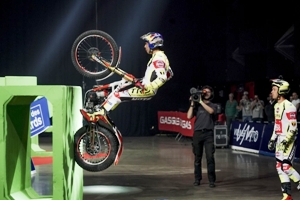 |
edge of an obstacle. See a good example of this spectacular art here.
Lesser mortals compete on less testing circuits, often featuring huge rocks, loose terrain and steep slopes.
(2) Scrambles became a popular participation and spectator sport in the 1960s in Britain and many
|
cold Saturdays were spent on steep hillsides watching stars with names like Jeff Smith, Arthur Lampkin and Dave Bickers. The sport quickly spread from its birth in British scrambling to Western Europe, becoming wildly popular in Belgium. Now named Motocross, it is flourishing, with an annual World Championship series and specifically designed motorcycles available off the shelf from most manufacturers. The standard race format is unusual. Races consist of a set time, often thirty minutes, plus one lap. Lower-level competition races often see lap after lap of the circuit completed with little real competition after the initial skirmishing. The massed start with its mad dash down a
| |
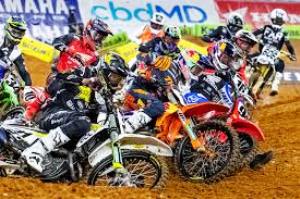 |
short, wide straight by 24 determined riders, funnelling into the first corner is a spectacular part of the race.
The world championship series produces hotly contested races. All the major motorcycle manufacturers produce specific motocross models for general sale. A feature is long suspension travel to absorb the shattering landings from major leaps over different heights of artificial bumps built into circuits. A big diameter but narrow front wheel for steering and a fatter, smaller, rear for grip. Engine sizes range from 125cc to 500cc, the latter giving a potent motorcycle capable of high speeds and frequent short aerial flights over rough country. Check here for a good taste of motocross. There is a condensed version known as ‘supercross’ which is held in sports stadiums on temporarily built smaller tracks.
(3) At Moto Grand Prix level, the peak of the sport, speeds up to 350 km/h can be reached on a straight
|
and, with modern suspension, steering, tyre technology and high-tech electronic aids, frightening angles of lean, as much as 60° from the vertical being common on bends. Riders brake from this top speed down to as little as 50 km/h in a very short distance for bends and accelerate fiercely again, putting huge strain on their arms. The design and technology invested in tyre design makes this possible and racing development has flowed on to ordinary road motorcycles. Very close racing occurs, and spectacular crashes and spills happen, fortunately with little permanent damage to racers in most cases. Unlike with F1 car drivers, lateral g force on corners is not an issue as motorcycle geometry makes
| |
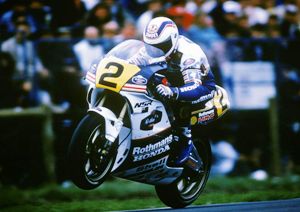 |
cornering a motorcycle a matter of juggling machine power, technology, the laws of physics and rider skill but does not create huge lateral force.
Very few road-racing events are still held on public roads, the best known being the annual Isle of Man Tourist Trophy Races and the North-West 200 in Northern Ireland. These are dangerous events, with walls and stone blocks very close to the racing surface and deaths occur.
Now, specially designed and built road-racing circuits exist, with surfaces as smoothly laid as possible and with a large range of racer safety measures in place. Trained race marshals are in place all round the circuit, as are first-aid personnel and a full mini-hospital is on standby trackside at major events. There are huge run-off areas with surfaces of soft, ‘slow down’ materials, inflated rubber cushion barriers and signals to ensure racers are made immediately aware of an incident that leaves a rider or a machine in a dangerous position. Signal flags and lights warn riders of oil or rain on the track surface and riders are obliged to slow down when yellow flags are waved or yellow lights flashed. The machines can receive text messages on their handlebars from their pit teams.
Deaths and life-changing injuries, though they still happen, are fortunately very rare, even when a rider has parted company with his bike at high speed. Motorcycle racing suits are of thick, abrasion-resistant leather with high-tech, shock-absorbing armour built into vulnerable areas. Suits now have strategically placed airbags inbuilt, and attention is paid to the design of the neck and back to minimise injury to the spine. It is normal, during practice sessions, to see a rider crash and leap to his feet for the race marshals to shepherd him away from the track to where a steward waits with a scooter to ferry him back to the pits, keen to jump on his spare machine and get back to work. A fall-off during a race means that rider’s race is over.
To be continued
|
|
 |
 |
Houseboating 4
Hugh McGrory |
 |
 |
As I’ve said, I knew almost nothing about boating when we first decided to rent a houseboat, and how intimidating it was to get a few minutes instruction, then set out in charge of a boat some 40 ft long, 10 wide and 10 ft high. Obviously, there was an extended period of me learning from my mistakes, and I managed, over several years, to make almost every mistake you can think of:
- When coming into the lock at Bobcaygeon, I had to ‘parallel park’ in a space between two other boats. The technique was to approach the space very slowly at an angle so that the front of the pontoon was a few feet behind the boat in front. Then one of our ‘crew’ would pass our mooring line around one of the vertical cables in the wall and so hold the front of the boat in position.
Unfortunately, I didn’t check that we were secure before I put the engine into reverse to pull the boat backwards and snug it parallel to the wall. Concentrating on the rear of the boat, I didn’t realise that the bow wasn’t attached to the wall and that, as the stern got closer the bow got further away! Had I had my wits about me I would simply have moved the engine control from reverse to forward and so snug the nose back in – but I didn’t, and the boat continued to drift towards collision with the boat behind or one of those across from us.
To digress for a moment… While some of the locks on the system are ‘out in the country’ some, like the one we’re talking about are in the middle of a village or small town. In the evenings, or at weekends, the locals often say to each other “Let’s wander down to the locks and watch the houseboat clowns”. Great entertainment as you may imagine!
Having said this, they are often helpful – “throw me your line” – and so, in my predicament above, disaster was averted when we stopped moving to find we were in the middle of the lock and held from the dock and two of the boats at risk…
I managed to persuade them, reluctantly, to let go, and allow me to take control again, and finally snug up to the wall – and then suffered the amused and pitying glances from the crowds lining the walls…
- Once, early in our houseboat years, on the first day of our week, we were motoring up Pigeon Lake when I saw a long row of floating plastic containers. I assumed that it was a fish net and turned to port to skirt the edge (if I’d decided starboard, we would have been OK – I should have been paying more attention to the chart).
Suddenly our pleasant cruise was violently interrupted as we ran up onto a large rock outcropping, a couple of feet below the water (I think this may have been Long Point Shoal). I tried to reverse – no good. We went over the side and tried to push the boat off – no good.
This was before cell phones so, if we’d been out in the wilds, we would have had to signal a passing boat to seek help. Fortunately, we were less than half a mile from a shore with many cottages.
We had a canoe with us, so my daughter Debbie and her school friend Sandra, with us for the week, paddled to shore and asked one of the cottagers to let them use the phone to call the houseboat company. This worked well, and we were rescued about two hours later.
Deb reminded me that when they got ashore, they heard some one using a chainsaw to cut some fallen trees and when they saw him, he turned out to be a hippie-looking individual wearing a do-rag. They were worried they might be his next meal, but he turned out to be pleasant and helpful.
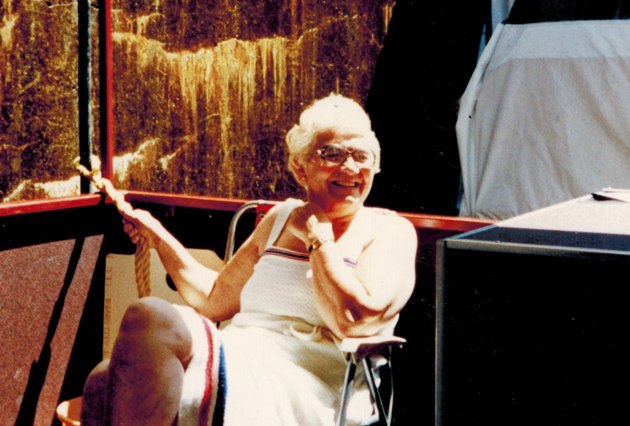 |
|
Gran (my mother) doing her duty in a lock by keeping the boat close to the wall. Demonstrating how experience can allow one to do one’s duty in comfort… |
- Gran was a willing and contributing crew member – but she didn’t always get it right…. On one occasion we tied up by the locks in Fenelon Falls when a larger houseboat than ours appeared. My son says it was half a dozen college kids with enough beer aboard for a month. They began to manoeuvre, too quickly, in the channel in an effort to tie up, and made a hash of it. So as usual the people on the other boats all manned the sides of their boat to fend of the monster. Our crew sprang into action too, and at one point we were all pushing the other boat away as it swung really close to our boat. My son reminded me that Gran, in her seventies then, was doing her bit too – unfortunately she was pushing with all her might against a vertical stanchion which was actually part of our boat…
- I mentioned previously that we tried our hand at fishing… My son reminded me of the time that he and his younger sister were having trouble unhooking a fish in order to release it and asked me for help. I did the necessary and let the fish go. I then picked up the rod and made a casual cast with it, immediately realising that I’d hooked something – it was my son. The poor kid had been holding the hook on the end of the line when I cast, stupidly, without checking. . So, I had to ‘unhook’ his thumb – he was quite stoic about it if I remember, but I was kicking myself for being so careless.
- It's probably the teacher in me, but as the ‘Captain’, I liked to teach the ‘crew’ the proper way to do things – how to pick out the channel markers, how to coil the mooring rope after tying up to a dock and so on… On one particular occasion we were about to get under way, we had untied and the engine was running, but in neutral. I was at the helm which was in the foremost starboard corner of the cabin, with a fixed window to the front and a sliding window to the right.
I said, “Ok we’re ready to pull out – but, since the view astern is so limited, the last thing you should do is look back through the side window to make sure there isn’t a vessel creeping up on you.”
I proceeded to demonstrate and made one tiny error – I forgot to open the window… Fortunately, neither the window nor my head were broken. My ego did take a bruising though…
- Once we tied up for the night on the edge of a forest and did so nose-in to a rocky shore, tied to trees. During the night the wind changed, and we found that the boat had swivelled so that it was almost parallel to the shore – I guess the mooring ropes weren’t tight enough – no harm done. However, the crew wanted the boat nose-in so that they could swim and dive from the stern into deeper water.
The Captain said, “No problem, I’ll just start the engine, swing her round and you can tie us off again”. I might have looked over the side before I said that, but I didn’t, and as soon as I fired the engine the clatter told me that the prop had been resting on rocks. The photo shows the damage. While it doesn’t look much, a damaged prop can affect the boat performance, it can vibrate parts loose,
cause uneven stresses in the boat’s structure, or even damage the engine and/or transmission.
I had to pay for the damage, of course…
|
|
 |
 |
Goodbye Tobruk
Gordon Findlay |
 |
 |
Shortly after the aborted invasion of Suez in 1951, word spread through our camp in Tobruk that we were on our way somewhere else. Speculation and rumour ran through the place like wildfire.
We were going back to Britain. No! – we were on our way to Germany to join B.A.O.R. (British Army on The Rhine). No! – we were going to replace other British troops on Cyprus. I really didn’t care, so long as we left Tobruk behind because, although I liked the heat of the Libyan desert, it was a scruffy place, and we had no contact with the Libyans other than employing a few of them to work inside our camp. The city itself was a bit of a wreck, being rebuilt painfully slowly after the relentless pounding it had taken during the war years.
At last, the word was out: we were flying out to Malta and would relieve other British troops on the famous “George Cross” island which endured months of devastating bombing from German and Italian planes during World War Two.
But Malta had a delightful Mediterranean climate, a friendly populace, and a warm ocean all around it . . . that sounded pretty good to me.
At the same time we learned this news, I was also told that I would constitute the one-man I-Section “Rear Party” when our regiment moved out to Malta.
Any time a regiment moves to a new camp or geographic location or country, there has to be a Rear Party for every segment – like Signals, or Artillery, or H.Q. or Intelligence, to stay behind and make sure that all the stuff that should follow along does follow.
In our case I would be responsible for I-Section’s secret code books, plus all the maps and overlays (we’d need new ones in Malta); our chart tables; for the back-up radios and field cases,; our spare generators, field glasses, and extra weapons (we had a couple of Sten guns and a Bren machine-gun plus a crate of spare magazines).
I was both excited and a bit nervous about being the sole Rear Party for I-Section. I would have to be on my toes to make sure nothing was missed or left behind. The Libyans had a well-earned reputation for slipping into Army camps and filching anything that wasn’t nailed down. I heard that they had even acquired stolen British Army uniforms and had used these to gain access to camps in other areas. They had never managed to steal weapons – but anything was possible.
I had a master list of all that had to come– but I recall making out my own list as well, in alphabetical order so it was easier to remember, and with the critical and/or expensive stuff like the weapons and the generators and the field glasses written in red so they would stand out when I checked them all off. All the stuff except the generators would be packed in massive wooden crates, and we had a bunch of handy British Army Pioneers to knock them all together.
|
|
 |
 |
Houseboating 3
Hugh McGrory |
 |
 |
Last time, we spoke of being ‘in the water’ (think swimming). This time, I want to talk about being ‘on the water’ (think surfing). Of course, where water is concerned, ‘on’ can become ‘in’ in the blink of an eye…
Mattresses
We would take one or two blow-up mattresses with us on the houseboat – handy for a guest sleeper, or as an ‘on the water’ device. Not only can it be used as an aid for morning ablutions, but it's great for simply lounging on for a peaceful float. The kids also had fun being trailed along behind the houseboat (at the breakneck speed of about seven or eight mph).
Canoes
A couple of times we took a canoe with us – it sat on the roof of the boat very nicely when not in use. Handy for fishing from, or for paddling around looking at the many docked boats of all shapes and sizes.
Surf Jet
One year we stopped at Bobcaygeon to find that some young entrepreneurs were offering rentals of a Surf Jet. This is a surfboard which has a two-stroke motor which sucks in water from underneath and squirts it out the back so you can surf (or sit) and fly around at up to about 30 to 35 mph.
We couldn't resist having a go, and found that it was a lot of fun. We all fell off at one time or another – fortunately there was a dead man’s switch which attached to your clothing or wrist and cut the engine if you fell off the board.
|
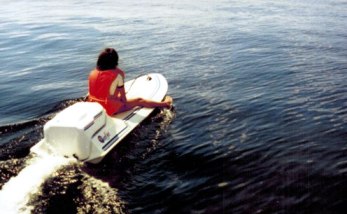 |
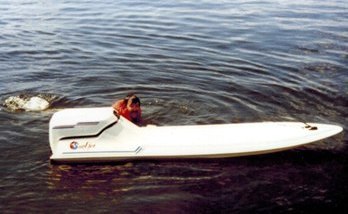 |
| Twelve-year-old in charge... |
Captain overboard - again... |
The Surf Jet was first manufactured in 1980 and, sadly, was out of business by 1997.
Windsurfer
As an alternative to the Surf Jet, they also had windsurfers available to rent. We couldn’t resist having a go. It looked easy – get yourself positioned with your back to the wind, with the board and the sail downwind of you. Then climb aboard , pull the mast up and off you go. Turned out that ‘off you go’ was an apt description…
To wind surf you need a gentle to moderate breeze - unfortunately we were almost becalmed, which made it more difficult to get going. It was a lot of fun - though very tiring, getting up, falling off, then having to climb back aboard. We found out how easy it was to pinch fingers and toes and to get clobbered by the mast and sail if you fell the wrong way!
|
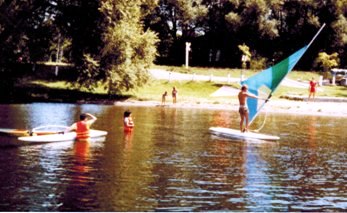 |
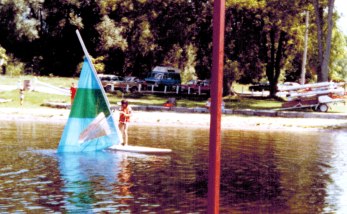 |
| Learning how it's done... |
Trying to do it... |
|
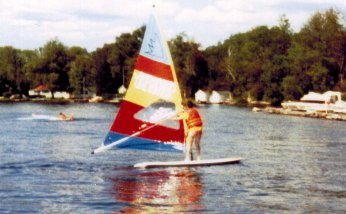 |
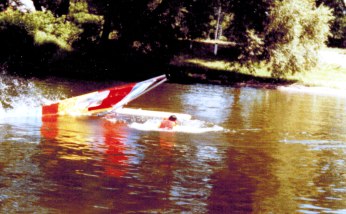 |
| "I think I got it..." |
"Och, bugger..." |
We did learn enough of the basics to be able to pick up the sport later – though we never did. It seems from my recent research that the sport is in decline. Competition from new sports such as stand-up paddleboarding and kitesurfing, together with the disincentive of having to lug all the gear around from place to place.
Next time, in the fourth and last of the series, we'll visit some of the misadventures of the intrepid houseboaters.
|
|
My old and well-used printer stopped working just as I was attempting to print out an important letter to an impatient official at His Majesty’s Revenue and Customs money hoovering office. This letter patiently explained the reasons for me being owed money by them rather than their belief that the opposite was the case. After trying in vain to repair my printer and in order to avoid further delay, I decided to revert to handwriting.
I have been on this planet for nearly ninety years and in that time, I must have, with varying degrees of success undertaken many thousands of projects that involved handwriting. I can recall pre-school copying out the capital letters of the alphabet in crayon or pencil and the shock of starting school and having to learn how to produce the lower-case letters on a sand tray using a finger or on a slate by using a screeching slate pencil. We had special writing lessons using a jotter that was ruled with a series of four lines, the centre pair was where you wrote the body of the letter and it was double the vertical space allowed for the lines above and below, these narrower lines were reserved for the top and tail of letters such as b and p. Slowly, I progressed to writing words, then sentences using pencil and paper until in primary three, or maybe it was primary four, I was introduced to the horrors of writing in pen and ink.
Every desk had a hole at the top right-hand corner, this was to be filled by a white, top hat shaped inkwell. A pint-sized bottle fitted with a pouring device and full of ink was produced and each inkwell was filled with the ink. A pen fitted with a metal nib was produced and the teacher explained and demonstrated how to use the pen without smudging the writing. In the spirit of nothing ventured, nothing gained I dipped my pen into the inkwell and started to write my name on the sheet of paper in front of me. Instead of the beautiful W that I intended, a big blob of ink spread beneath my nib. At that moment I knew that pen and ink would never be compatible and so it proved. Fortunately, most of my schoolwork continued to be executed with pencil and paper but exams and various essays that had to be written in ink were a nightmare. I was always in trouble for the state of my handwriting but no matter how I tried it did not improve.
By the time I was in my teen’s ballpoint pens had come into general use. For me, this meant that my handwriting became equally legible when using a pencil or a ballpoint pen and I no longer dreaded having to write a letter. I never felt apprehensive about failing to provide the content of anything that I needed to write, it was the presentation that made me unhappy. Over the years I have been fortunate in business to have access to dictation facilities or typists that could decipher my scrawl. For me, the moment of rescue from my handwriting nightmare was the advent of the personal computer and word processing software. Apart from the odd note or shopping list I have not used handwriting since the mid-1980s, and I am sure that my correspondents are as happy as I am about that!
Back to that letter to the HMRC. My first attempt was to copy from the computer screen what I had already written. Not a good idea, after three abortive starts ending in making a mistake, I decided to simply rewrite my letter. My original letter took me about fifteen minutes to get it ready for printing. I spent about three hours on the rewrite. I found it painful to hold my ballpoint pen and started to feel cramp in my arm. I had to think carefully about what I wanted to say in each sentence because if I made a mistake I would have to start over again. This meant that frequently I had to read over what I had already written. When I finally looked at the result, I was not happy, the content was fine, but it looked dreadful. My next step was to do what I should have done as soon as I realised that my printer was beyond repair. I sent the computer version to my son and asked him to print it out, forge my signature and post it recorded delivery to HMRC. A good solution, and I didn’t have to pay for the postage!
|
|
 |
 |
Houseboating 2
Hugh McGrory |
 |
 |
If you wonder about trying houseboating, ask yourself how you feel about water – lakes, rivers, canals – boating, sailing, swimming… If your answer is “not much”, then forget it, since water basically dictates the whole adventure. The youngsters in particular spend lots of time in, or on, the water.
Let’s look at ‘in the water’…
To begin with, the houseboats we rented didn’t have showers, so our personal hygiene routine was ‘soap-up then jump overboard’:
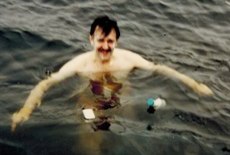 |
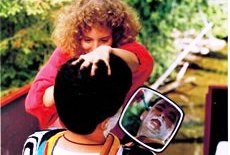 |
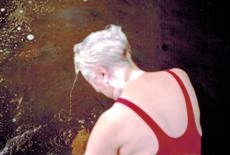 |
| Captain (note the floating soap). |
Captain's son and girl friend. |
Gran (Captain's mum). |
The kids had many ways of getting into the water – jumping, diving tumbling, from the pontoons, the fore and
aft decks, the roof of the boat. (The Captain did jump (not dive...) from the roof once, so that the crew couldn't call him a chicken, but preferred the lower launch points…)
To digress for a moment - if you'd like to go back to the story from two weeks ago and look at the houseboat, you'll see that the photographer serendipitously caught someone diving from the roof. The diver is horizontal so you can only see the head and arms, but there is a perfect shadow to the left of the large sunburst.
None of us were anglers, but we always took some cheap fishing rods with us, and made sure that everyone who wanted to, got to catch (and release) a fish.
There are many types of fish in the Trent-Severn Waterway. Top catches are Walleye, Brown trout, Brook trout, Muskies, Carp, Small & Large-mouth bass. Someone told us that the little fish we caught were Sunfish...
| The Anglers - Mixed Emotions? |
We did see a group of about six large fish in about 10 feet of water below the locks at Fenelon falls. They looked to be about three to four feet long and were dawdling along the bottom - I guessed that they were either catfish or carp...
Finally, I'd like to pay homage to the beauty and grace of our two synchronised swimmers:
Next time we'll talk about 'on the water...'
|
|
Here is the promised Glossary of food terms used in Scotland.
Arbroath smokie. Pairs of small haddock, about eight inches (20 cm) long, cleaned and head removed, tied at the tail, hung on triangular-section bars, are put into a purpose-built smoking oven, and subjected to smoke from a hardwood chip fire on the base. After about an hour and a half the cured fish is removed and is ready for sale. Although a superb dish straight from the oven, the smokie is also good cold and the cream-coloured flesh, easily stripped from the bone, is often used as an ingredient in salads or soups.
Beef Wellington. A whole-fillet dish tied in the round, with various ingredients, baked in a coating of flaky pastry and served in slices. The dish is said to have been created to celebrate the English general Wellington’s final defeat of Napoleon in 1815. It was a popular main course at Army mess dinners.
Black pudding. A sausage made from oats and other ingredients including the pigs’ blood that gives it the colour. When lightly fried in slices, it turns a deep black. White pudding is very similar but without blood, often called ‘mealie pudden’ in Scotland, a nod to the main ingredient, oatmeal. Haggis is from the same family, but adds finely minced liver, heart and lungs from sheep, a major food animal produced in Scotland, whose offal might otherwise be wasted. In many countries every part of an animal or bird is consumed, not just the muscle tissue. Unlike the English version, Scottish puddings do not have small lumps of suet in them.
Coquilles St Jacques. A French dish of scallop cooked in a creamy white wine sauce and served in the half-shell.
Cuppie. Dundee dialect. No meal at home was complete without a cup of tea.
Dinner. In Scotland, in my generation, dinner was the main meal of the day, although not necessarily the only cooked meal. It was taken at what is now called lunchtime. Most workers had an hour at lunchtime, as did schoolchildren, and went home for the meal.
Dundee cake. A rich fruit cake heavy with sultanas, cherries, and almonds.
Dundee pie. The Scottish pie is of mutton and may have onion in it. Round, the pastry thin and not hard baked, with a ring of pastry standing above the meat section, with a small, rolled crust on top. I call it a ‘Dundee’ pie for it is a famous local delicacy, produced by Wallace’s Bakery in Dundee. In the strong Dundee dialect, it is pronounced ‘peh’. A ‘peh and chups’ was a standard meal. My Auntie Mary used to take me to the Saturday market held in the now demolished, historic Overgate and buy me a ‘Saturday Buster, a pie with peas on top.
Forfar bridie. A flat semi-round meat pie, with the flat-rolled pastry folded over the meat inside and the edges finger-pressed together to give the bridie its distinctive and easy-to-hold shape. It is said to originate from Forfar, the small county town of Angus, of which the much larger Dundee is a part. Another famed Wallace’s product. It comes ‘plen’ (without onion) or ‘wi’ ingin’ (with onion).
Ingin. Scottish dialect for onion.
Irn-Bru. Scotland’s iconic, soft, fizzy drink. Made by Barr’s of Glasgow since the start of the 20th century and available in standard cans and full-size bottles. For the uninitiated, it is pronounced ‘Iron Brew’. Irn-Bru has a sweet, citrussy taste and a somewhat strange orange colour.
Lorne sausage. A dish of roughly minced meat with spices, produced in a long, rectangular block about 10 cm in section (four inches) from which slices about 1.25 cm (half inch) thick are cut and lightly fried.
Morning roll. The Scottish morning roll is a large, round white-flour roll, soft to the touch but chewy. An excellent wrapping for a fried egg and a rasher of bacon. In northern England and some parts of Scotland it is known as a ‘bap’, but I do not recall hearing it called that in Dundee.
Neep. A type of turnip. Partly purple-skinned but orange-fleshed. Served in Scotland mashed, watery tasting. A standard cooked meal inclusion. Traditionally a component, with haggis and mashed potatoes, of a Burns Supper, held on the 25th of January (Robert Burns’ birthday) but not held exclusively on that date.
Piece. The Scottish word for sandwich. The Liverpool word ‘butty’ was not used in Scotland. A ‘piece’ can be savoury, with such as cold beef or hot chips as filling or sweet as in ‘a jeely piece’ which is a jam sandwich, a common treat given to children. I am familiar with this delight as ‘a piece an’ jam’.
Porridge. Traditionally a breakfast dish of oats or oatmeal, soaked overnight in water then boiled till a thick, glutinous mix is achieved Usually served with milk or cream and often with sugar sprinkled on it. Many Scots take porridge as a savoury dish, substituting salt for sugar. The great English lexicographer, Samuel Johnson, somewhat unkindly, described oats as ‘a grain, which in England is generally given to horses, but in Scotland supports the people’. There are differing opinions on the desirability of porridge having chewy lumps in it. Porridge has now become a popular, healthy, breakfast alternative and many premixed, easy-to-cook packaged versions are available. A die-hard Scot will eschew these types.
Potted hough. A cold meat dish made from slow-cooked beef, lamb, or pork leftovers, cooked on the bone, if necessary, with condiments and spices until the flesh parts from the bone. It is then left to set into a terrine, often in the rectangular shape of the container, but sometimes in decorative jelly moulds. The result is a delicious meaty dish which, placed on top of hot, mashed potatoes, slowly melts, spreading the flavourful juice to be absorbed and enjoyed. Sometimes called ‘potted heid’ (head). The English equivalent is brawn.
Scottish breakfast. This is the great heart-stopper. The full version includes fried eggs, Lorne sausage, link-sausages, bacon, black pudding, fried bread, baked beans, tattie scones, mushrooms. It may also have haggis and white pudding. It is a fearsome thing!
Tattie. Potato, usually served ‘chapped’ or ‘chappit’ (mashed) with hot meals if not in the form of deep-fried chips. By custom, the correct type of potato must be used, peeled, boiled till soft, drained of water in the cooking pot then heated again to dry the remaining moisture till the potatoes are floury in texture. They are then mashed vigorously until creamy, with butter, salt and pepper, and sometimes milk thrown into the mix.
Tattie scone. A flat cake of mashed potato and flour, usually served deep-fried in Scotland as part of a fish supper or in a ‘Scottish breakfast’. Called ‘potato cake’ in England.
|
|
Canada is the second largest country (by area) in the world (next to Russia), it has the longest coastline, and the longest land border (with the USA). It’s been described as 5,000 miles long and 100 miles wide (ninety percent of the population lives within 100 miles of the US border).
Almost half of Canada is a huge rock formation known as the Canadian Shield and consists of rocks, forests and lakes. The land is not good for farming and the population is sparse. It’s not surprising then, that many Canadians like to make use of the lakes - many with day trips from the urban areas, some build cottages and some, like us, chose houseboating.
During the time that kids are growing up and moving from ‘wanting to be around their parents’ to ‘never wanting to spend any time with them’ (for us basically the 1980s plus or minus) we would rent a houseboat for a week on the Trent Canal system.
More properly known as The Trent–Severn Waterway, it is a 386-kilometre-long (240 miles) canal
route connecting Lake Ontario at Trenton to Georgian Bay, Lake Huron, at Port Severn. Its major natural waterways include the Trent River, Otonabee River, Kawartha Lakes, Lake Simcoe, Lake Couchiching and Severn River. Its scenic, meandering route has been called "one of the finest interconnected systems of navigation in the world".
We spent our time mainly in the central, Kawartha Lakes, area, rented from several companies and lived on several different styles of houseboat (though essentially all very similar). The photo shows a typical boat, the one we most often rented.
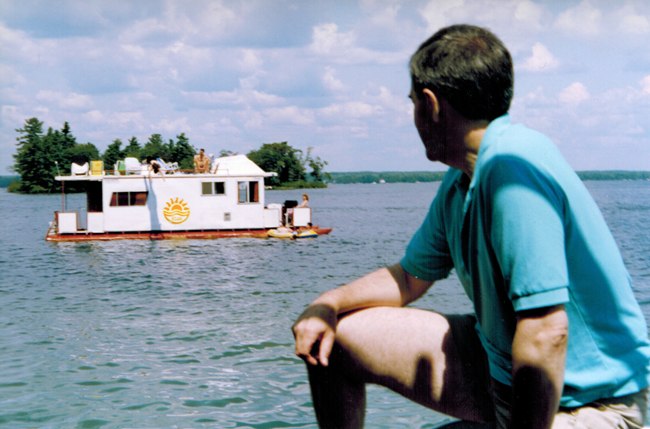 |
Me, sitting on the roof of our boat, looking at an identical boat rented by some friends of ours.
|
The layout of the boats were variations on a theme. For example, there would be a small front deck with room for perhaps three folding deckchairs. The small rear deck would have the ladder for accessing the roof (designed to be able to support the occupants for sunbathing etc.), the engine cover, battery, and perhaps a barbecue.
Internally the boat would be divided into two main compartments: the front half would be the kitchen/dining/living room area. In the corner there would be the helm with a Captain’s/Pilot’s chair and controls – steering wheel and throttle. There would be a table with two bench seats for four - the table could be lowered to the level of the benches to become a small bed. A kitchenette with stovetop cooker and sink would be behind the helm. Moving towards the back we would then have the toilet, closet and fridge(or icebox). Finally, the last compartment would have two bunk beds sleeping four adults or up to eight kids.
My wife doesn't care for camping, so it was me and the kids plus, usually, one school or neighbourhood kid (my kids alternated the selection each year. This was ideal for me, since they were all good swimmers (unlike me who, when in the water, liked to be no more than a few yards from the boat…). They kept each other entertained, in the water or ashore, whilst I sat with my book, and a rum and coke… We would also have relatives, my mother and my niece from Yorkshire one year, or friends visiting for the day.
The first year was somewhat fraught, since the Captain (me, of course) had no idea what the hell he was doing. Everything was a ‘first’ with a new challenge – pulling away from the dock for the first time with the staff watching (and the scarier pulling into a dock…) and the first time passing through a canal lock, and the… I could go on!
But we survived, and enjoyed it so much that we did it for a good ten years. More on our adventures next time.
|
|
 |
 |
We Don’t Go to Battle
Gordon Findlay |
 |
 |
We sat in that damn L.S.T. for a full week waiting for the word that the invasion of Egypt and the occupation of the Suez Canal was under way. And that message never came…
We were to learn later that the Anglo-French action had been “postponed”, mainly because things had quietened down in the Suez Zone, and in Ismailia where there had been attacks on British property and on British people living in that area. King Farouk had asked for calm, and the Egyptian people had backed away from any further violence.
Our time spent on the L.S.T. in Tobruk Bay was a bit of a drag. There was no space to do any training, and most of our time was spent checking the I-Section inventory: maps, map cases, radios fixed and portable, code books, situation report books, and so forth. We endlessly cleaned our weapons, and one day mechanics from R.E.M.E. showed up to give our Jeep a thorough check.
Then, at the end of the week we went through the whole damn procedure again– only this time in reverse. The magic words “Stand down!” were passed along and soon they unchained all the armoured heavyweights down in the hold of the L.S.T. One by one they rumbled back on to concrete ramps, followed by us in our trucks. We marched back to our camp outside Tobruk, handed back our bandoliers of live ammunition at the armoury, unpacked our No. 1 kits – and that was the end of it. No war this week.
At the time I think we were all pretty excited (and secretly nervous) about the thought that we could have found ourselves in action, under fire, and being put to the test. But in retrospect, and looking back on this episode in my young life as a National Service recruit in the British Army, I’m profoundly glad that the order never came through in 1951. I really had no wish to kill Egyptians – or for that matter, to be killed myself.
|
|
Thanks to my Irish/Scots forebears and the DNA they shared with me, I’ve always felt comfortable studying mathematics and used to quite enjoy working on the problems in algebra, geometry, and trigonometry, seeing them as little puzzles to be worked out. My choice of engineering as a career was probably preordained, since applied math (as opposed to pure math, of which more later…) is a major tool of engineers. Pure math deals with the theory of mathematics while applied math puts some of those theories to work for practical uses.
My previous story on cones reminded me of an area of math study known as conic sections and so I thought I’d introduce you to the subject - without actually getting into the math (i.e. no formulas).
Imagine you had a cone like the standard ice cream cone with the ‘pointy’ bottom. Imagine that it’s made of a material that is easy to cut while still retaining its shape. We’re going to have the little gremlin below make
four different cuts across the cone and examine the results.
A little wrinkle first: since the number system we use isn’t just 0, 1, 2, 3… but also 0, -1, -2, -3… we need a ‘positive’ and a twin “negative’ cone see the figure with one above the other:
As you can see if we make a horizontal cut and look at the shape of the slice, we see that it's a circle. A cut across which isn't horizontal results in a piece that is an ellipse (some people might refer to this as an oval, but they’d be wrong, since ova comes from the Latin word for eggs which have one end more ‘pointy’ than the other. Ellipses have identical curves at each end).
Cutting down parallel to the side of the cone gives us a curve know as a parabola, and the final cut, which cuts downwards through both cones produces a hyperbola.
It turns out that all four of these curves can be represented by one overarching quadratic equation (which I’m not going to show you…) but here’s what all four look like plotted on an x-y graph.
| |
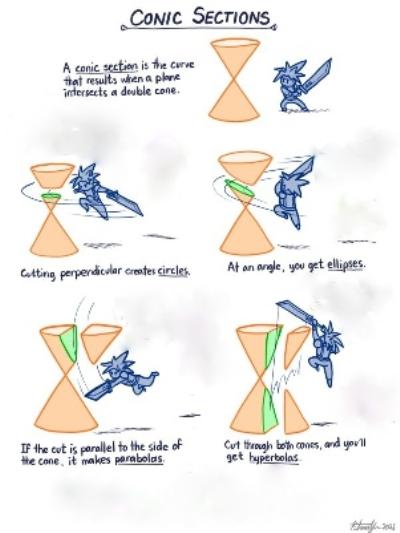 |
If these two-dimensional figures are turned around their vertical axes to make them three-dimensional, as real-life objects, then the circle becomes a sphere (a ball), the parabola becomes a paraboloid (like a lampshade), and so on.
 |
Which brings me to the pure math versus applied math issue. The work which defined the math of conic suggestions was pure math and was carried out some time ago – actually about 2,400 years ago, by a man named Menaechmus, a friend of Plato, in Asia Minor (now Turkey). (It’s said that Isaac Newton came up with the concept of gravity from seeing an apple fall from a tree. I wonder if Menaechmus was slicing and eating a pear perhaps, when he came up with his ideas on conic sections?)
As to applied math using the theory of conic sections, this didn’t happen for almost 2,000 years when Johannes Kepler, the German astronomer and mathematician proved that the planets don't travel around the sun in circles, but as ellipses. In the last 400 years since Kepler. Conic sections in 3-d form have proliferated in our day-to-day lives:
The Circle
No need to dwell on the circle or sphere – wheels, balls, plates and saucers,clock faces, and round and round we go...
The Ellipse
As well as representing orbits of planets, satellites, and moons, ellipses are found in the shapes of boat keels, rudders, and some airplane wings.
A medical device called a lithotripter uses elliptical reflectors to break up kidney stones by generating sound waves.
Some buildings, have rooms called whispering chambers, designed with elliptical domes (ellipsoids) so that a person whispering at one point (known as a focus) of the ellipse, can easily be heard by someone standing at the other focus.
The Parabola
If you pitch a stone, or fire a shell , or throw a basketball these will all travel along a parabolic path.
You can see the parabolic shape in bridges either underneath the roadway, as in arches, or above, as in the main cable of a suspension bridge.
Water fountains demonstrate parabolas.
Parabolic reflectors are used as antennas for transmitting or receiving of radio, tv, or microwave signals.
The Hyperbola
When scientists launch a satellite into space, they must first use mathematical equations based on the hyperbola to predict its path.
Objects designed for use with our eyes make heavy use of hyperbolas; these include microscopes, and telescopes.
Power stations generating electricity also produce waste heat and cooling towers are used to cool the water and allow it to be re-used. These are designed as hyperboloids because of their efficiency in cooling the water. The hyperbolic form also allows the towers to be built very efficiently (a 500-foot tower can be made of a reinforced concrete shell only 6 or 8 inches wide!)
In conclusion, when I think about the story of conic sections, the thing that most amazes me is not all of the applications that have been implemented over the last four hundred years, but rather the fact that the pure math was understood by our forebears in Ancient Greece, some twenty four hundred years ago!
|
|
 |
 |
A Game of Thorns
Bill Kidd |
 |
 |
There can only be a few people that are still unaware that on 4th July 2024 there was a UK General Election for the purpose of choosing our preferred Member of Parliament and which political party would form our Government for the next five years. The outcome was seen by some as the end of the world as we know it and by others as the first step towards a Utopian society. The third group, dare I suggest the majority, simply shrugged their shoulders and got on with their lives as best as they could! As for myself, I watched the antics of the politicians selling their snake oil every waking hour in the weeks leading up to 4th July with the cynicism that I have carefully built up over the years.
Being less than three months old when it was held in November 1935, I have little recollection of my life’s first General Election, but I do have a clear memory of the next one, held on 5th July 1945. The ten-year gap was a result of WW2 causing the election due in 1940 to be cancelled. As a ten-year-old I had no idea what a General Election was, but I realised that it was important as the adults talked of little else. There were posters and leaflets telling us of the wonders that we would enjoy only if our vote was cast for the party favoured by the author. I was saddened because I was too young to be entrusted with a vote. I made up for this by standing as a candidate in the election game that we local children arranged. Modesty prevents me from giving you the result. Suffice to say that I am as honest about this as any modern-day politician! I learned that Dundee was one of the few areas still using the bloc vote system. This meant that Dundee had not one, but two MPs and that the voter could select two of the names on the ballot paper. This was to be the last time that this would happen as from the 1950 General Election onwards the Dundee constituency would be divided into Dundee East and Dundee West each sending one MP to Westminster.
I attended many outdoor meetings where a candidate would arrive in a car and make a short speech to those gathered there and attempt to answer questions. At one such meeting one of the sitting MPs, Dame Florence Horsburgh, had a bucket of bones thrown over her car because of a speech she had made in the 1930s extolling the use of bones to make a cheap, nutritious soup! I later learned that Ms Horsburgh was a government minister during the war and had worked on food supply and did some early work in preparation for the revolution in health care that became reality in 1948.
For most of the 19th Century Dundee was represented by a series of Liberal MPs (Whigs). From 1906 there was one Labour MP serving with a Liberal until 1922 when Winston Churchill was famously defeated by a Prohibitionist, Edwin Scrimgeour. It has been suggested that Churchill’s downfall had more to do with his opposition to women’s suffrage than any abhorrence of alcoholic beverages! Scrimgeour continued to serve as a Dundee MP until defeated by Florence Horsburgh in 1932. The two Members of Parliament that Dundee sent to Westminster from 1931 to 1945 were Florence Horsburgh, the only Unionist (Tory) politician to achieve this and Dingle Foot, a Liberal. For the 1945 election they were faced with three opponents. John Strachey and Tom Cook, both Labour, along with Arthur Donaldson of the Scottish National Party.
The result of the 1945 General Election was that both Strachey and Cook were elected, and Clement Atlee was swept to power with a huge majority. John Strachey became Minister for Food but lost a lot of popularity when he introduced bread rationing. Tom Cook served as a Junior Minister until his death in a car accident in 1952. Florence Horsburgh became one of the first female Life Peers, Dingle Foot as a Labour MP became Solicitor General for England and Wales in Harold Wilson’s first administration and Arthur Donaldson went on to lead the Scottish National Party in the 1960s. Winston Churchill is certainly the best known of Dundee’s MPs but there are many others that have made their mark in our political history.
|
|
I have always enjoyed ice cream. Being only two when WW2 began, I don’t think that I had any until I was
eight and the war ended. I say that, though I have a vague memory of an ersatz product which I think was a local entrepreneur’s attempt to create a substitute - it had a powdery feel and was disgusting…
(Wicksteed Park in Northamptonshire in the English Midlands was an exception. Famous, locally, for its ice cream which was made on the premises, they managed to continue to produce it throughout the war years. They did this by buying and maintaining a herd of goats to supply the milk. It was hugely popular with local kids…)
I said in a previous anecdote that I remember my first banana, after the war and how good it was.Though I don’t remember my first ice cream cone, I suspect the same sort of scenario played out.
In another previous story I talked about my favourite fish and chip shop where I used to enjoy haddock and chips followed by a soft ice cream cone. Sitting at a table I would use a teaspoon to eat the ice cream – but it always reminded me of the way I used to eat cones when I was a kid.
| |
 |
I had a technique for eating the ‘hard’ ice cream (not squeezed from a nozzle but scooped from a container and pressed onto the top of the cone, like the photo).The ice cream was piled high, but didn’t fill the cone. Since it was usually summer, it would begin to melt quite quickly, so as everyone did, I would lick around the circumference catching the potential drips before they could make a sticky mess.
It usually didn’t take very long for the ice cream to be lowered to the point where it was flat across the top of the cone. Then, of course you could simply eat down the cone. I didn’t like that approach, however, since the ice cream would end before the cone, and the last few bites would be rather dry…
My approach was to wait until I had licked the ice cream flat, then I would bite the bottom off the cone and suck the ice cream until it reached the bottom. Then I could eat cone and ice cream together to the last bite. (I thought I invented this idea, but I suspect that most kids probably did the same…)
Although I don’t remember this, it’s said that, during WW2, children were offered carrots-on-a-stick as substitutes for ice cream, and the photo seems to bear this out:
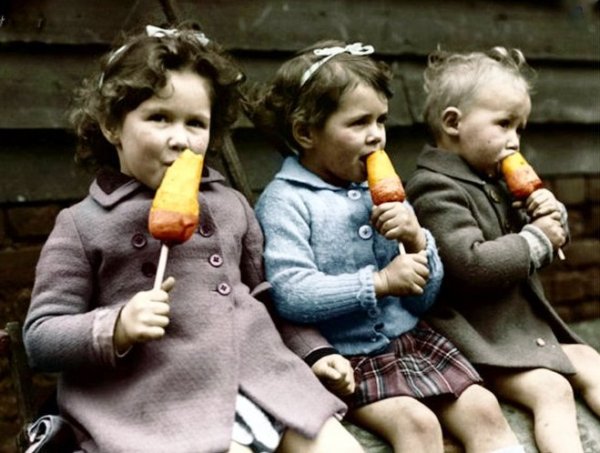 |
Next time I want to talk more about cones - but from a different perspective... seriously...
|
|
 |
 |
Food, Glorious Food!
Brian Macdonald |
 |
 |
Growing up in Dundee in the nineteen-forties and -fifties, with parents who both had jobs, my main meal was similar to that of most of my contemporaries, consisting of basic, wholesome meat, mostly mutton or beef, since the county of Angus produced both, carrots, neeps(1), ingins, cabbage or cauliflower and tatties with not a lot of variety but healthy, filling fare nevertheless There were big, white, flour-sprinkled morning rolls with butter, pies, bridies and, sometimes, fish and chips from the Cabrelli family’s busy shop at the top of Caird Avenue. My mother being English, there was usually a roast with Yorkshire pudding for Sunday dinner. Porridge, made with Scott’s Porridge Oats soaked overnight before cooking, was a ‘stick-to-your-ribs’ breakfast for a Scottish east coast winter.
I followed the prophecy of the Morgan Academy school song, as did so many of us and took the train southward, over the Tay Bridge, in young adulthood, to make my way in the world. Life took me to different countries and my culinary experience broadened A superb cook in an army officers’ mess taught me the joys of such as Coquille St Jacques, Beef Wellington, and other sophisticated dishes. The mess mourned when Sergeant Scully of the Women’s Royal Army Corps was posted elsewhere.
While Scotland’s Italian immigrants of the early twentieth century enthusiastically adopted Scottish dishes and became the entrepreneurs of ice cream and fish and chips, in the post-WWII nineteen-fifties, genuine Italian cuisine was winning a toehold in England as affluent English ventured into Europe for holidays. Veal, pasta dishes and pizza were more exotic dishes I learned to enjoy. In the nineteen-sixties, then life’s currents swept my young family to Australia after a spell in Northern Ireland enjoying their excellent bacon.
Australia was, at first, a back-to-the-past experience. Sixty years ago, Australia had very much a British culture with many packed food brands recognisable to a Brit in the shops and the unimaginative British food culture we had just left. The height of culinary adventure in Australia was a ham salad with chips at a service station restaurant on a road trip with limp lettuce and a ring of pineapple atop the cold, pressed ham as its centrepiece. Wine was drunk only by European immigrants, coffee was unknown but many country towns boasted a nineteen-twenties art-deco café(2) and milk bar in the main street, founded and still run by Greek immigrant families, that sold ice cream sundaes in tall aluminium beakers and provided a meeting-place for the local youth as well as an evening out for their parents. A modest Chinese restaurant that sold standard Chinese dishes of a type familiar and acceptable to the locals was also a frequent feature of small towns. The Chinese had come to Australia in the later 19th C as gold miners and stayed to become part of the community.
Since then, successive waves of immigration have given Australia a society of many nationalities, from every continent, each of which has brought its own culinary culture and donated it to the pool. This country now boasts as diverse a culinary structure as you will find anywhere, and most suburbs offer a choice of cuisines in cafés and restaurants. Melbourne is sometimes dubbed ‘the coffee capital of the world’ for its love of pavement-café coffee and the proliferation of small, independent cafés(3).
My generation left its expensive leisure travelling until the children were raised and the family future was secured, and it was not till the nineteen-eighties that we began using passports and further developing our interest in other than the Anglo cuisines.
Our nearest neighbour is New Zealand(4). It is a fascinating visiting experience with its ‘Lord of the Rings’ scenery but a similar Anglo-based culture to Britain and a somewhat ‘Put your watch back twenty years’ air about the place to an Australian, where creeping American influence is pervasive. Travel from Australia to anywhere else except the nearer parts of south-east Asia is expensive, long, and gruelling and my years of overseas travel now are done. Fortunately, our appetites and tastes have not much diminished. We still enjoy a wide and catholic range of foods.
But as I have gotten old, the nostalgic Scottishness of a Scot of the diaspora has increased in many respects, not the least of which is my enjoyment of Scottish dishes. I was delighted to discover a Scottish butcher whose establishment was a modest drive from our Melbourne suburb and who shipped Scottish delicacies all over Australia. Lorne sausage, black pudding, tattie scones and haggis have again become regular items on our table, the occasional can of Irn-Bru is poured and a Forfar bridie wolfed. Porridge made with real oats is seen at our breakfast table. The butcher, aided by his Welsh wife, also makes Scottish pies with the distinctive rolled, stand-up pastry rim. I call them ‘Dundee’ pies in memory of Wallace’s iconic pies and bridies. Stevie Mowat is the real deal, Glasgow accent, fervent supporter of Glasgow Rangers FC and a producer of many dishes gratefully consumed by a loyal cohort of customers, most of whom have retained recognisable regional Scots accents, despite the greater part of a lifetime spent far from our native land.
Regrettably, one treat I am unable to find in Australia, and which is a lifelong favourite, is the Arbroath smokie, a famed delicacy from the fishing port a few miles from my hometown, Dundee. I was brought up on this fish dish. There was a smokehouse round the corner from my mum’s shop, at which I was a frequent visitor, who enjoyed watching the cleaning of the haddock, the tying in pairs by the tail and the hanging on the blackened, triangular section smoking poles, which were placed across the oven and the lid closed, then the smoking process from a hardwood fire on the bottom. What emerged a couple of hours later was a cream-coloured succulent fish with the flesh easily separated from the bone and the skin
We took our family holidays in Arbroath, in a fisherman’s cottage in a street no longer there and smokies made that morning were often on the menu. On later-life return visits to Scotland, an excursion to Arbroath was a must, with a smokie fresh from the Spinks family’s oven consumed al fresco, with fingers, by the picturesque harbour a key part of the enjoyment.
Another favourite was potted hough, lower quality beef cuts, often the leftovers still on the bone, boiled till soft and encased in their own jelly. A block of hough set on top of hot, mashed potatoes to melt slowly and feed its flavour to the tatties made a delicious meal. Hough was made by butchers as a by-product and sold by weight from a large slab.
For afters, a piece and jam was popular, often used as a between-meals snack for children and as part of a working-man’s dinner (eaten midday) if he did not go home for his meal, which was common. Alternatively, a slice of Dundee cake went well with a cuppie.
There are other old favourites, too many to mention. Compose your own list. But please permit me this nostalgic wallow. Let the digestive juices run!
Footnotes
(1) This and other Scottish food terms used willl be dealt with in a Glossary (To be published next time).
(2) Australia enjoyed an inflow of Greek immigrants in the early twentieth century. Many living in country towns filled a gap by opening a café in which the whole family worked, in the main street. As Art Deco was the flavour of the twenties and thirties most of these establishments followed that trend. Sadly, most have now been remodelled or torn down but a brave few still serve their community, restored to their original glory, Art Deco buildings now being a treasured feature in a country town. A rare few are still operated by descendants of their founders.
(3) The five-million strong city of Melbourne has largely resisted the multi-national coffee palace companies and small, locally owned, intimate, coffee shops abound. Where possible, the seating flows out on to the pavement and visitors to Melbourne have learned that it is not only Starbuck’s who can make good coffee and provide a congenial environment.
(4) Australia and New Zealand are essentially both still white-skinned, Western European societies in a southern Pacific part of the globe, but change is rapid. They have had to learn to respect their Indigenous people and to understand their many dissimilar neighbours. New Zealand is a four-hour flight from Australia’s east coast. Everywhere else is a much longer journey. Even from Sydney on the east coast to Perth in Western Australia takes four hours.
|
|
 |
 |
What’s in a Name?
Huge McGregory |
 |
 |
We all tend to accept our names and not think too much about where those names come from, how, and why. The ‘given name + family name’ system used in the English-speaking world hasn’t been around for ever – through millennia, when we tended to live in small extended family groups, such a system wasn’t necessary. In Britain it wasn’t until around the Norman Invasion that the practice took off as villages began to coalesce into towns and cities.
Most family names fall into one of seven categories:
- Patronymic/Matronymic, surnames such as Stevenson, or Madison (from Maud)
- Occupational surnames, using people’s jobs to identify them, such as Carpenter, or Miller
- Characteristic surnames which describe forbears such as Large, Strong, Stern
- Place surnames like Hampshire, Burton, Sutton
- Geographic surnames based on local geographical features such as Hill, or Moore
- Estate surnames when landowners used the name of their property – King George V adopted the name of Windsor for the Royal Family
- Patronage surnames where, if you worked on someone else’s land, you adopted their name, for instance Kilpatrick, a follower of Patrick (shades of the slave trade)
The name McGrory is an Anglicised form of the Gaelic Mac Ruaidhri (pronounced 'Rooree' or 'Roree'), ‘Ruaidhri’s Son’ (ruadh, ‘red'; righ, ‘ king’), Rory’s son, or ‘son of the red-headed king’. There are many variations in Anglicised spelling (even Rodgers or Rogers).
With nothing better to do I visited a genealogical database and had it count the number of people using some of the many spellings – see below:
| McGrory |
16854 |
McCrory |
15004 |
McCrorie |
7532 |
McRorie |
4199 |
McRory |
3442 |
MacRorie |
2350 |
| MacRory |
2266 |
McGroary |
782 |
McCroary |
451 |
McGrorie |
206 |
MacGrory |
137 |
McRoary |
83 |
| MacCrory |
80 |
MacCrorie |
52 |
McCroarie |
18 |
MacRoary |
5 |
MacGroary |
2 |
McRoarie |
2 |
| MacCroary |
1 |
MacRoarie |
1 |
McCroarie |
0 |
MacGroarie |
0 |
MacGrorie |
0 |
McGroarie |
0 |
|
These are only some of the variants – over the centuries, with no standardised spelling, each scribe for any document wrote the name phonetically, as it sounded to them. Since the owner of the name was probably signing his name ’X’ it didn’t really matter…
I very often get called McGregory on first meeting ( McGregor has 379,000 entries in the database I used, and McGregory actually has 4,800 entries).
On top of that, the name Hugh can be a puzzle to many – it often comes out as ‘huge’. (Just last week, I was sitting in a waiting room for my name to be called when I heard the announcement "Next, Huge McGregory".)
I usually have three modes of response when this happens:
- I ignore the issue and move on, or,
- I explain it’s not Huge but Hugh, pronounced like ‘few’, or,
- Sometimes, when the situation is appropriate, I say something like “ So, you’ve seen me in the shower, then…"
|
|
 |
 |
Water Polo against the Navy
Gordon Findlay |
 |
 |
Again, my recollection of the next few days is a bit hazy. I do know that we sat in Tobruk Bay for the best part of a week, and that to pass the time, the Navy invited the Army types to a water polo contest.
Sure enough, the word came through the Tannoy on our L.S.T. that anyone who was: A water polo player; Was a strong swimmer; Was keen for a little inter-British Armed forces competition; was invited for a “tryout” at 0900 hours the next morning.
Being a total jock, of course, and knowing I was a decent swimmer, and also knowing also that I had played water polo ONCE in my life at Morgan, I volunteered for the tryout.
Well, the tryout was a total farce. In fact, there was no tryout. Whoever showed up was going to play against the Navy. Almost nobody in 1st H.L.I. had come forward and a pitiful few of us showed up on the main deck of the L.S.T. The Navy lads could scarcely hide their laughter as they led us to the little jollyboat bobbling at the side of our vessel. We were chugged over to HMS Glasgow where we saw they had rigged two booms out from the side of the cruiser and above the water.
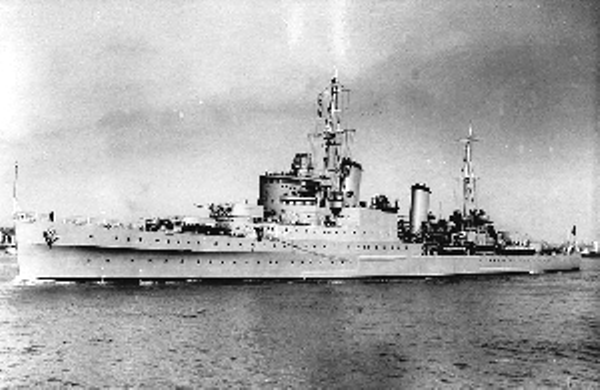 |
HMS Glasgow – a Town-class cruiser – 1937-1958.
|
From these were suspended the two goals for the water polo match. Obviously, there would be no “shallow end” of the pool (where you could touch down with your feet if you got tired . . . there would be only two “deep ends” – and I mean as deep as the Mediterranean is inside Tobruk Bay. So it was that the pathetic “water polo team” from the Highland Light Infantry was led to the slaughter at the hands of the British Navy.
We did our best. At the time I was a fairly strong swimmer, and there were a couple of officers from H.L.I. who at least had some clue about the game. But it wasn’t too pretty once the ball was tossed into the sea between our two teams. I think the Navy team scored in the first minute of play, and continued to score pretty much at will for the next fifteen minutes.
We might have got a half-dozen shots on their goal during our time in the water,
but it was basically a slaughter of the unskilled against the sheer raw power of the well skilled. By the end of the game I was so exhausted I felt sick . . . churning up and down that patch of the Mediterranean beside H.M.S. Glasgow, trying to catch up to the fast swimmers from that damn cruiser . . . I felt the game would never end.
Mercifully, it finally did, and in fairness to the Navy boys, they took us all down into the ship afterwards, let us all have a wonderful hot (sea water) shower, then up to their Wardroom for a good tuck-in. I think it was steak-and-kidney pie, but I was so famished by that time I would have eaten the mess deck table.
|
|
Fair Isle is a small Scottish island. It’s part of Shetland, and sits halfway between Orkney and Shetland, three
miles long and about a mile wide with a population of around sixty. It’s known worldwide as the home of Fair Isle knitting.
Knitting has been around for perhaps a thousand years (examples have been found in 11th century Egypt). On Fair Isle, the women have a long history of using the wool from the local sheep to knit sweaters to keep their menfolk warm as they fished the North Sea and the Atlantic Ocean. Sometime in the 19th century a style of knitting developed that became known as ’Fair Isle’.
| |
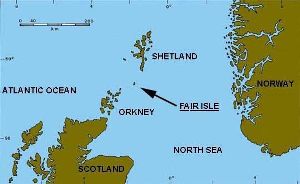 |
The traditional Fair Isle style relies on what is termed colourwork. This refers to switching two colours of yarn from row to row or within the same row. In the latter case, the colour not used at the moment is held at the back of the knitting until it’s needed again. This leaves small strands or 'floats' of yarn on the reverse side – known as 'stranded colourwork'. This technique is used in repetitive patterns which identify Fair Isle work – see example below.
The world of commerce being what it is the term Fair Isle is used for apparel that doesn’t actually come from Fair Isle. Genuine Fair Isle knitwear made in Fair Isle carries the trademark 'Star Motif' as a guarantee of quality and place of origin and is not available in any retail outlet, instead being sold direct to customers visiting the island or by mail-order.
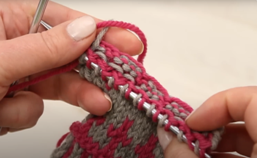 |
 |
.jpeg) |
| Reverse side showing floats. |
Fair Isle Sweater. |
Fair Isle Trademark. |
So, what’s my interest in Fair Isle knitting? Well, through our seven Morgan Academy schoolmate reunions over forty years I’ve had the great pleasure of meeting up with a former schoolmate and her husband – I’m referring to Muriel Allan and her husband Bill Kidd.
When we three were first catching up, some thirty years after leaving school, Muriel asked me, “Do you still wear Fair Isle sweaters?” Although I hadn’t thought of those sweaters since leaving school, I immediately remembered them….
I don’t think of my mother as being a dedicated knitter, but when I was about thirteen or fourteen, she decided to knit two Fair Isle sweaters for me – why, I have no idea...
She followed a pattern which guided her in the proper Fair Isle technique, but she used her own colours. The results were not what you could call subtle. One of the sweaters I vaguely remember as a mixture of red, green, yellow, black , while the other was sort of blue, grey, and black (my memory is a bit sketchy).
I didn't like them – too gaudy– and put up some resistance but Mum had put a lot of effort into the sweaters and became the ‘She who must be obeyed…’, so I had to wear them.
Funnily, once I got over the initial embarrassment of looking a bit like a Christmas tree (perhaps why Muriel remembered the sweaters) I don’t remember suffering any major angst from the experience and I don’t remember being ribbed about them by any of my classmates.
This all took place in the early 50’s, and about ten years later Fair Isle had a resurgence when Paul and Linda McCartney got into wearing it. I discovered this when searching for an example that looked like my mother’s creation, and
stumbling over these photos of Paul, in two different sweaters, as the nearest I could find.
|
|
 |
 |
Another One Gone
Bill Kidd |
 |
 |
I am rather depressed as I write this! I have just heard that I have lost the constant companion of my teenage years and the occasional friend that I caught up with from time to time, usually at the most unexpected times and places. Yes, I suppose it is only to be expected at our age, but I can’t help feeling sad at the demise of the UK Edition of Reader’s Digest.
I first came across Reader’s Digest not long after I started secondary school. Someone had given my mother a twelve-month subscription as a birthday gift. Frankly, l think that she would have preferred something else, but the regular delivery soon became a much-anticipated event to the extent that she renewed her subscription the following year.
The magazine was in the form of a booklet about 8” x 5” in size filled with articles on a wide variety of topics. The style was always rather cosy, but usually an enjoyable and informative read. Interspersed among the major articles were funny short stories and word puzzles. There was also a “Condensed Book” that outlined the story of a contemporary novel in about twenty-five pages. The condensed book was a mixed blessing because for many years I would settle down with a newly acquired book only to find something familiar about it after a couple of chapters. I had already read the condensed version!
I suspect that I got more benefit from my mother’s subscription than she did and by the end of her second year’s subscription she had come to the same conclusion!
| |
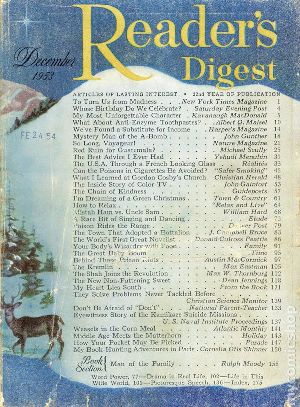 |
The invitation to renew her subscription arrived about a month before it became due. My mother wrote back to say that she did not wish to renew it. About a week later she received a response from the publishers offering her, as a valued customer, a special 50% reduction in the cost of the full subscription if she would agree to an eighteen-month deal. This seemed to be a bargain and she accepted the deal. My casual reading was saved!
Some things in life are difficult but few were as formidable as ending a subscription to Reader’s Digest. After the eighteen-month deal had been accepted, a stream of Special Offers to Subscribers began to pour through our letter box. There were special Reader’s Digest editions of books and records exclusive to subscribers, these were followed up by other suppliers with special offers on various gadgets and household items none of which were of any great interest. I recall buying a set of L.P. records of popular classics and my mother buying an atlas and a dictionary from the exclusive offers. I doubt if the profit from our purchases even covered the postage costs generated by the marketing effort. My mother decided enough was enough and simply ignored the next subscription renewal request. This led to several letters reminding her of what she would be missing if she didn’t accept their proposal for a special two-year deal. My mother was made of stern stuff and continued to ignore the publisher’s heart-rending pleas. Despite the non-payment we continued to receive the magazine for a further six months and the special offers until my parents moved house several years later.
When I was in third year, I discovered that there was a shop in Victoria Road, not far from the foot of Hilltown, that bought and sold comics, magazines, and records. I went along and chanced my arm by swapping our old Reader’s Digests for used science fiction magazines. When our regular supply of Reader’s Digest ended, I continued to visit the shop to buy the odd copy.
For many years, no visit to the doctor or dentist would have been complete without glancing through a well-thumbed copy of Reader’s Digest. Come to think of it, I don’t think that I have seen a copy of Reader’s Digest for about thirty years. I am saddened at its passing, if for no other reason than it marks yet another part of my youth biting the dust!
|
|
 |
 |
Testing Times
Hugh McGrory |
 |
 |
The issue of seniors driving motor vehicles is recognised all around the world. On the one hand, driving their own vehicle allows the older person to maintain their independence, on the other, driving skills deteriorate with age, to the detriment of the drivers and the other road users. Countries around the world deal with this in many different ways.
For example, in the UK, everyone with a driving licence has to renew their photo card every ten years up to the age of seventy. Thereafter, every three years the driver is required to fill in a form reporting any issues that may adversely affect their driving competence – an honour system.
In Canada, there’s a bit more to it, a test process (though it doesn’t begin until the age of eighty). The concept behind the test system is to identify those with obvious cognitive deficiencies who should not be allowed to drive.
My first test required me to book to attend at a specific classroom location. When I got there it had a boardroom table that could sit about sixteen people. We were given a 40 minute lecture on safe driving techniques for seniors. Each of us was then tested for peripheral vision. Then we had to sit the written test. This consisted of the ‘Clock Test’ followed by the ‘Letter Cancellation Test’, both standard tests for dementia, (see the illustration:)
We were shown a clock face set at ten past eleven. It was then hidden, and we were given five minutes to draw it. The clock above to the left shows a typical acceptable drawing. The other four show some of the many unacceptable responses common to people whose cognitive faculties are damaged by dementia.
We were then given the Letter Cancellation Test. In our case it was many ‘M’ and ‘N” characters interspersed with ‘H’s, and we had five minutes to score out the H’s. At first glance this looked to be more difficult than I’d imagined, but I realised that, if I turned the paper upside down it made it a little easier.
At my second test, two years later, the in-class lecture had been dropped in favour of an injunction to “read the information on our website.”
At my third and most recent test, another two years later, the ‘Letter Cancellation Test’ had been dropped. Apparently, studies had found that the Clock Test alone produced essentially the same result as taking both tests.
Each time I did the test, the serious impact on lives was brought home to me:
The first time, as we were settling into the exam room I noticed a younger man, around 60 I’d guess, and I thought, “You’re in the wrong room”. However, I realised as he talked to the examiner that he was with an older man (looked like his father). The younger man left the room, and we got under way. When we got to the clock, the older man seemed confused. He looked around for assistance, and his neighbour began to try to help. The examiner immediately said, “No helping, please – that defeats the purpose.”
At the end of the test when we our test papers were returned to us, the older man was taken aside and told that he had failed. The son was called into the room so that he could help explain to his father that his licence to drive was now cancelled. I imagine that he and his family knew that the father shouldn’t be driving but wanted the ‘authorities’ to be the bad guys…
At the second test it was a lady who was told that she had failed, and that her licence to drive was cancelled as of that moment. She was asked if she had driven herself, and when she said yes, she was told that she needed to call someone to come and pick her up, with a second person to drive her car home.
At my third, most recent, test I saw a woman trying to catch the examiner’s eye at the beginning, and seemingly being ignored. Eventually the examiner took her aside and I overheard her being told that she wasn’t supposed to be returning to the test area as she continued to do, and that she had been told several times to make an appointment with her family doctor. The examiner said "Do you have your book?” When she produced a notebook, the examiner flipped it to the appropriate page and said “You see, I wrote it out here for you. Now please don’t come back to the test area again – you must go see your doctor”.
Sobering experiences, and fraught with foreboding for my own future…
|
|
 |
 |
Dennis Waterman
Brian Macdonald |
 |
 |
Dennis Waterman died of lung cancer on 8 May 2022 at the age of seventy-four. Few who have watched British-made TV series over the span of my lifetime will not have enjoyed the work of this talented actor and singer who made a career out of portraying a knock-about Londoner, sometimes on one side of the law and sometimes on the other, although this was not the sum of his talents. He leaves a legacy of likeable and competent fictional characters, as well as a number of theme songs for TV series in which he acted, of which he was the singer. Dennis Waterman also enjoyed a ‘lively’ private life and his name sometimes appeared in the press in connection with domestic
ructions. I've always had a soft spot for him and enjoyed watching him at work. As an actor he was underestimated.
Waterman was born a south-east Londoner in Clapham, in 1948 and died at his retirement home in Spain. His acting career spanned the years 1960 to 2020, although he left the cast of the last long-running series in which he starred, New Tricks, in 2014. Dennis had two sisters. One of his three brothers, Peter, was a British and European professional welterweight boxing champion. The sport ran in the family. His father had also been a boxer. He was taken by an older brother to a boxing gym at age three, and that training and his boxer’s physique stood him in good stead in his role as Terry McCann, in Minder, for he found himself having to indulge in fisticuffs in that series. At age ten, Dennis became a member of Caius Boxing Club in Battersea. An instance of art reflecting life in Minder, the series in which Waterman had his biggest and most popular role, was an amusing scene when a gang boss ordered one of his own minders to teach the Waterman character, Terry, a lesson. The two squared up, but each recognised the other as a former ring opponent in the England Amateur Boxing Association’s national championships and they mutually agreed not to fight, nonplussing the gangster.
Waterman’s first role of note was as the small son of the villain in a film, Night Train to Inverness. An early starring role on stage was as Oliver Twist in the hugely successful Lionel Bart-written musical of Charles Dickens’ Oliver Twist, Oliver, and his is Oliver’s voice on the hit record of the show. His first TV series starring role was as children’s author Richmal Crompton’s William Brown, in the TV series, Just William.
 |
Waterman, at the age of 12, as William.
|
Many of us read the Just William books as children. He had a major part at age 20 in the then fashionable ‘kitchen-sink’ film set in working-class London in 1968, Up the Junction, where his native London accent came into play.
Dennis Waterman’s breakthrough TV role was in the 1970s’ The Sweeney as Detective Sergeant George Carter, sidekick to Inspector Jack Regan, played by John Thaw, long before that actor suffered the effects of
a boyhood accident that eventually gave him dropped foot, a disability which was evident in Thaw’s role as Inspector Morse many years later. Physical fitness was important in The Sweeney because both roles involved lots of running after crooks and violent movement, including fist-swinging.
The series was named after a crime-fighting task force of the London Metropolitan Police, ‘The Flying Squad.’ That force was known to the London underworld as ‘The Sweeney’, the name derived from Cockney rhyming slang from the name Sweeney Todd, from the ‘Demon Barber of Fleet Street’ a homicidal cutter of hair of Victorian fiction. Waterman was
| |
 |
in the first seven series of the ten that were made, as well as two films. In that show, the Waterman character had an amateur boxing background, as did Dennis.
Possibly his best-loved starring part in a TV series was in the title role in Minder. Both Minder and The Sweeney were made by the same team for Britain’s ITV. Waterman played Terry (known to his intimates as ‘Tell’) McCann, a likeable Londoner, bodyguard (minder) and factotum to the archetypal spiv and second-
 |
 |
hand car dealer, Arthur (‘Arfer’) Daley, played by George Cole, another London-born actor with a similar background to Waterman. Arthur Daley operated on the fringes of the law, buying and selling almost anything that was slightly ‘dodgy’.
Terry was a lot smarter than he showed, handy with, but reluctant to use his fists, attractive to women, and a declared fan of a not-very-successful South London football club, Fulham.
Although more honest than his boss, Terry often pulled Arthur’s irons out of the fire after that individual had got into a predicament.
|
The show ran from 1979 until 1994. Waterman starred in the first seven series. He also sang the Minder theme song, 'I could Be So Good for You' which was heard at the start of every episode. It rose to number 3 on Britain’s hit parade. This, and other TV series theme songs he sang laid the foundation for the parody in the TV comedy show Little Britain of Waterman refusing good roles because he was not allowed to sing the theme song. The other lead actor, George Cole, was largely typecast throughout his career as a shady character, of which ‘Arfer’ Daley was a prime example, as was his role as ‘Flash Harry’, a fringe-of-the-law purveyor of black market goods that may have ‘fallen off the back of a lorry’ in the St Trinian’s film series of the 1950s.
George Cole, too, had several hit TV series and films to his credit and was awarded an OBE (Order of the British Empire) but Waterman never received a civil honour. Cole and Waterman were friends for many years and, together, they made the record What Are We Gonna Get For 'Er Indoors? ‘Er Indoors’ was Arthur’s way of referring to his rule-the-roost wife, often referred to on Minder but never seen or heard.
Waterman played the starring role of the team captain in a 1982 TV film, The World Cup: A Captain's Tale, a true story about an early attempt at a European Cup of Football tournament played during 1909 to 1911, won by a part-time, amateur team from a grim, north-east England mining town. Dennis Waterman was a lifelong fan of London’s Chelsea Football Club. It is almost inevitable that a sporting lad, such as he was, in England, in those days, played the game competitively when young.
As well as his TV roles, he appeared on London’s West End stage, and starred in Windy City, a 1982 stage musical. Another actor in that production was a young Amanda Redman, with whom he had a long relationship and whom he would encounter professionally again later. A good singer, apart from the Minder theme and the song with George Cole, Dennis Waterman made a number of records that sold well. He continued to appear in TV series and mini-series throughout the last decades of the 20th C.
New Tricks burst onto British TV screens in 2003. Again, Waterman’s was the voice of the theme tune, It’s Alright. The show’s title referenced the saying “You can’t teach an old dog new tricks.” New Tricks, first shown on a BBC channel, unlike his previous hit series, starred three well-credentialled, older English actors who played quirky, elderly police detectives called from retirement to form a special squad to review ‘cold cases,’ old, unsolved cases still on the books but not being actively pursued. Waterman was retired detective sergeant Gerry Standing, a man with three former wives, with all of whom he had good relationships, and with a strange affection for a scorned British sports car of the 1970s, the Triumph Stag.
In charge of this unorthodox group of veteran detectives was a serving senior officer, played by Waterman’s former lover, Amanda Redman, by now an established star. It was a strong cast. The show was hugely
successful and ran for twelve series on British TV, with Waterman in every series. He was the last of the original leading group of actors to leave, during the final series. It held its own on audience figures against all opposition throughout its life.
Up until the 2020s, Waterman continued to command senior roles, including a comedy-drama film made in Australia in 2019, Never Too Late, which included several highly rated Australian actors in its cast. By then he and his fourth wife had retired to Spain.
He is quoted as saying, “I’ve found out a remarkable thing
| |
 |
about myself - that I’m really good at doing f*** all. I’ve always sneered at people who have gone into early retirement and thought, 'What are you going to do?', but I’ve taken to it like a duck to water. We’re spending a lot of time in Spain so we’re lolling in the sun, having a splash when it gets too hot and then going and having a game of golf. And there is drink involved. It’s murder. I am really, really, good at it.”
Dennis Waterman’s private life included several liaisons, including a much-publicised and stormy
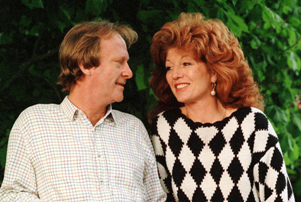 |
 |
relationship with an English actress, Rula Lenska, whom he married, and later acrimoniously divorced, a couple of drink-driving convictions, and a domestic violence incident. In an echo of his role in New Tricks, he was married four times. Each marriage lasted ten to eleven years before ending in divorce. His last marriage, to Pam Flint, had reached the eleven-year level when Waterman died in 2022.
His CV of star roles in entertaining, highly rated TV series, on stage and in films is impressive and spreads across sixty years of his life. His acting was underrated because his best-known roles were as similar, easy-going, male men.
|
His personal life was verging on the chaotic and sometimes fodder for tabloid newspapers. All in all, a fascinating character and an actor who has given many of us much enjoyment.
Vale, Dennis Waterman.
|
|
 |
 |
The Case of the Bookcase
Hugh McGrory |
 |
 |
(In my previous story (The Common Room). I mentioned an elderly teacher who kept her bike in our room, and whose name I couldn’t recall. My thanks to schoolmate, Sandra Moir Dow, who wrote to say that her name was Mrs. Ramsay known as ‘Ma Ramsay,’ who taught Latin.)
In that same tale I mentioned a bookcase in the sixth-year common room. Over the last 70 years my memory has faded, but I think, when new, it had four shelves, stood about five feet high, and had two doors with glass panels. It looked like the photo, but perhaps not quite as tall, and about twice as wide.
A story I was told many years later is as follows…. Apparently, the previous sixth year, one year older than us, had an accident. They managed to break the glass in one of the bookcase doors (don’t know if it was hit by the bike or some other kind of horseplay).
There was general dismay, of course. They cleared up the broken glass from the floor and removed all of the broken pieces from the frame to make it look as tidy as possible. Then they stood around trying to figure how to deal with the situation and the possible retribution to come…
One of the guys came up with a plan – he pointed out the problem that the two doors now looked so different from each other that it would be obvious to everyone what had happened – so why not make them look the same – break all of the glass in the other door and dispose of it too!
So that’s what they did; apparently it worked like a charm, since not one of the ‘powers-that-be’ ever mentioned it. (If you were there that day and can add to, or correct my story please get in touch.)
| |
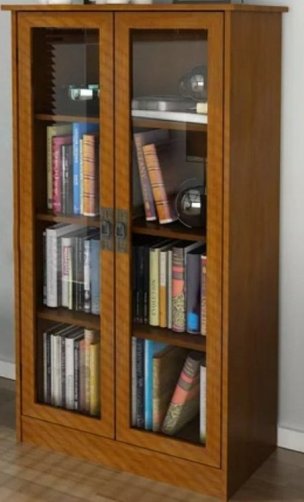 |
I’d like to shake the hand of the fellow who came up with that idea – brilliant and ballsy – I imagine he did well in his life after school (perhaps in prison?).
|
|
 |
 |
Afloat on Tobruk Bay
Gordon Findlay |
 |
 |
When our turn came, our truck drove s-l-o-w-l-y into the L.S.T. and the Navy deckhands soon lashed the
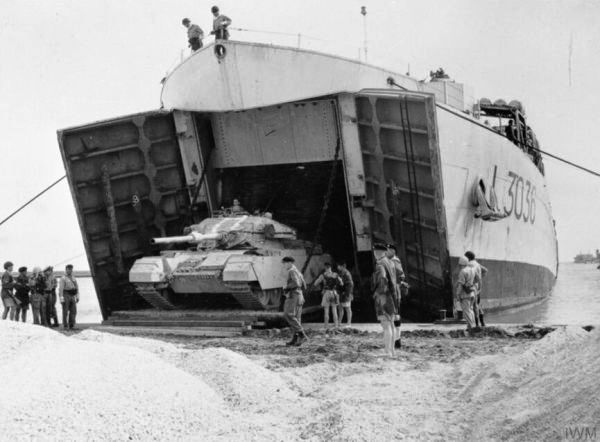 |
A tank of the 6th Royal Tank Regiment leaving a Royal Navy Tank Landing Ship at Port Said.
|
truck down with chains. There we sat, in the gloomy darkness of the landing craft, with a lot of other Army types sitting in trucks or Jeeps, and all of us wondering what the next few hours were going to bring.
When I recall that time in my life, sitting there in the semi-dark, I can remember thinking: “Migawd – if anyone tries to smoke an illegal fag down here, this whole damn ship could go up with one helluva bang.”
My recollection of the time spent in the L.S.T. is a bit hazy… it was so long ago. But I can recall the Tannoy (the loud-speaker system in the L.S.T.) telling us that we were in “Meal Group Number Four – and to wait until we were called. Then to go topside and get our food.”
A little later, we heard the massive front “door” of the L.S.T. come clanging down, and our vessel chugged slowly out into the main channel of Tobruk Bay, where it dropped anchor. Then we sat and quietly chatted, until the Tannoy blared with the order “Meal Group Number One assemble on the main deck.”
A lot of the lads down below with us grabbed their mess tins and mugs and headed up the metal stairways at the side of the ship, heading for the main deck – and food. Soon it was our turn, and up we went, to find the small deck of the L.S.T. set up with the usual cook’s metal tureens of soup and other hot food.
Everybody filed past and got their gob of stew, potatoes, and gravy plus a thick wedge of anonymous sweet cake, plus a mug of hot, sweet tea, There was nowhere to sit and eat on the cluttered deck of the L.S.T., so we all had to retreat down the metal gangways to the lower levels and find a spot somewhere among all the trucks and armoured vehicles to sit and eat our grub.
That part of Army life never really bothered me: I was able to eat in any position, at any time, and under all sorts of weather conditions, rain, cold or sleet. Hunger is a great equalizer. . . especially when you’re young and fit.
I can remember that Lieut. Thompson came down to find our truck, and to tell us that our “Rodeo Flail”
force was in a holding position here in Tobruk Bay. Apparently, we were being held in reserve: we would go into the Suez Canal Zone only if the Anglo-French paratroop brigades, Marines and other forces could not swiftly overcome the Egyptian forces. If called upon, Thompson told us we would be going into Port Said.
When evening came, we simply bedded down in the 3-tonner. Obviously, there was a strict “No Smoking” edict throughout the L.S.T. So, we simply re-arranged some of the boxes to give us some space, and I think it was Cpl. Howson who managed to scrounge some tarpaulins from the Navy
| |
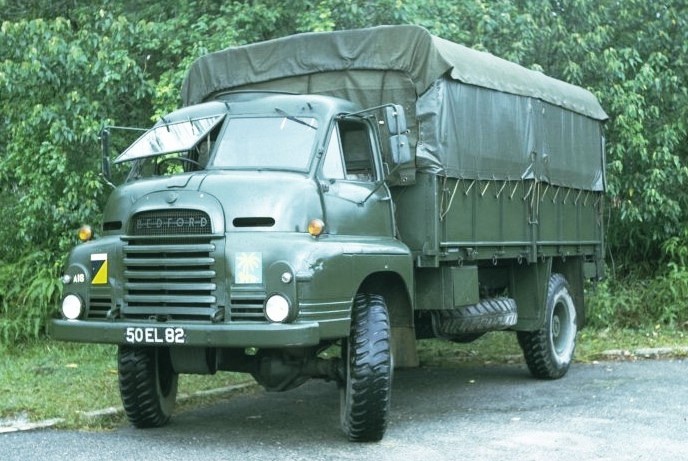 |
types; on these we arranged a bed for ourselves – and that was it. When you’re young and healthy – and have just shoveled a hot meal down your neck you can pretty well sleep anywhere at all, so that’s what we did.
|
|
 |
 |
The Common Room
Hugh McGrory |
 |
 |
Back in the day, Morgan Academy students who were heading for university entered 6th year at the age of 17. Being seniors, we had a few privileges, one of which was the use of a common room. This was a room where we could hang out before, after, or between classes. It had a few seats, a couple of tables, and some bookshelves around the walls.
This was the boys’ room, situated in the NW corner of the ground floor. The girls had their room on the NE corner, third floor. (The 'powers-that-be' were smart enough to know that two rooms were needed – a single room filled with 17-year-old testosterone and estrogen would, sooner or later, ignite…)
I don’t remember anyone studying in the room, but we did play a lot of shove-ha’penny on the larger table. Actually, it wasn’t really shove-ha’penny, it was a very simple game, sort of a cross between shove-ha’penny and fussball. At opposite ends of the table two goals were marked out on the table edge. Each player stood behind their goal armed with a ha’penny and a 12 inch ruler. The ‘ball’ was a sixpenny piece, and the players took turnabout attempting to shove the ha’penny with the ruler to hit the sixpence such that it was propelled into the goal. A lot of fun, though an inordinate amount of time was taken up finding coins that landed on the floor.
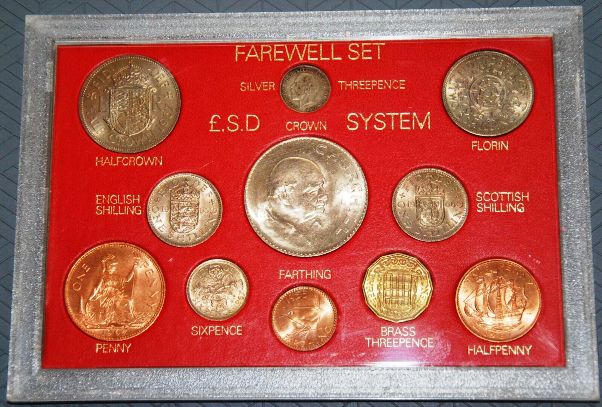 |
| For those who have forgotten (or never knew) the pre-1971 UK sterling coinage. |
We also used to have bike races around the tables. Some background – one of the elderly female teachers (can’t for the life of me remember her name) used to cycle to school and the Head had given her permission to keep her bike in our common room. It was a minor nuisance leaning against one of the bookcases, but fun to ride… So we would take turns to see who could circle the two tables, a set number of circuits, in the fastest time.
I remember on one occasion riding the bike, and in mid-circuit the door of the room opened just as I approached it. I braked and got off the bike just as the bike owner entered the room! She looked at me standing there with her bike and I said, as I leaned it against the wall, “Sorry miss – just need to get a book from the bookcase.” She paused for a second, looking around suspicious-like, then harrumphed, grabbed her bike, and left.
Those were the days…
|
|
 |
 |
As Time Goes By...!
Bill Kidd |
 |
 |
Good night, Greenwich Mean Time, and good morning to British Summer Time! Sacrificing an hour of sleep, I get up at my usual time and start the chores associated with adjusting the timepieces around the house. This is less of an onerous task than was the case in the past. The battery-operated kitchen clock, the time display on the microwave and my wristwatch are the only remaining items that require manual attention. Everything else, computers, telephones, television sets, smart meters and radios adjust with the aid of a passing satellite. In the process of this semi-annual ritual, I discover that the battery of my wristwatch has expired. I don’t know when this happened because I no longer wear my watch and rely on my smart phone for telling me the time of day. As is so often the case nowadays I cast my mind back to childhood.
Both sets of grandparents had large case clocks in their homes. Every Sunday evening my grandfathers would adjust their pocket watches from the time signal that accompanied the Nine o’ Clock News on the radio and then wind up the mechanism of their case clocks and where necessary, synchronising them with their pocket watches. In our house my father performed a similar ritual with my mother’s treasured Eight Day Westminster Chime mantel clock. Of course, in March and October when BST started or ended the ritual was amended to cover this. Getting an accurate reading of the time seemed to be heavily dependent on the radio and this got me thinking about how one got this before the wide availability of radio.
If we go back to prehistoric days, time was marked by sunrise and sunset. As Hunter Gatherers evolved into farmers day/night remained but understanding the cycle of seasons became important in deciding when to plant and when to harvest. Over centuries of observation of the sun and the length of shadow cast by a fixed object established a calendar of months and days. The development of various religions encouraged further refinement and accuracy until we arrive at our present day, nearly universal calendar.
Over the years it became desirable to divide each day into smaller segments. Mathematics helped define these segments of time as hours, minutes, and seconds. The main use for these segments was to establish the interval between one event and another. This led to various devices being used to measure the length of time passing; how long it took for a candle to burn or for water or sand to pass through an aperture. .
Initially it was of no great concern to have a specific named time recognised by everyone in the area but again religions and other communal gatherings called for some means of defining when something would happen. In some parts of the world a sundial and a Town Crier could provide the necessary information. Mechanical clocks powered by a controlled water flow, or the gradual release of a defined weight were used for timekeeping. These systems were rendered obsolete by the invention of spring and escapement clockwork around a thousand years ago.
By the 16th century it was realised that an accurate measurement of time was essential for precise navigation, and this led to further improvements to clockwork mechanisms and the near perfection of the chronometer in the mid-18th century. Clockwork remained King until the 20th century and the use of atomic, electronic and satellite timekeeping.
Back on land the general populace was content with their own local time, usually taken from the local church clock. The industrial revolution made use of factory horns or steam whistles to signify starting and finishing times. The “Bummers” of the jute mills was a feature of Dundee life until around 1965. It was not until the railways were established that it became necessary to have a single time standard throughout the UK and ultimately, the rest of the world. Greenwich Mean Time was first used by a railway company in 1834 and since 1884 as longitude 0º it has been the basis for defining international time standards.
Is it because I am getting old that I find many of the changes confusing? I have just been told by a grandson that I should be careful in using the radio for checking the time as there is a small difference between the time that the FM and DAB signal arrives. I am grateful for that information; all I need to do now is find out what DAB and FM are!
|
|
Hogmanay is the Scottish word for the last day of the year, and for the celebrations of the New Year that take place after the stroke of midnight on December 31st.
 |
| There are big celebrations in Edinburgh for Hogmanay each year and the castle is lit up by a spectacular firework display at midnight |
The word Hogmanay is not from the Gaelic - most experts feel that it came from France when Mary, Queen of Scots, returned to Scotland in 1561. In Normandy, presents given at Hogmanay are 'hoguignetes'."
Scots have a tradition of celebrating at Hogmanay, by ‘first footing’ family, neighbours, and friends. This refers to the superstition that the first foot to cross your doorstep in the new year will dictate whether or not it will be a good year for the household. Ideally the first visitor should be dark-haired male (fair hair brings thoughts of the Viking invasions…) The ‘first foot’ should bear gifts (a lump of coal, cake or shortbread, and a bottle of whisky to ensure that the home will have warmth, food, and drink throughout the year).
My most memorable Hogmanay was, for a number of reasons, 1964:
At about 11:00 pm on December 31st I was sitting at home, alone, when there was an unexpected knock at the door. The reason I was alone was that my wife was in Netherlea Maternity hospital about to give birth. (This was before the practice of husbands attending births had caught hold, and I’d been told to go home and wait until they had news for me.)
I went to the door and discovered a neighbour, who invited me to join him and his wife to see in the new year while I waited for news. I did, and while enjoying a nip of whisky with them the phone rang: “Is Mr. McGrory there by any chance? He’s just had a son and both mum and child are well. He can see them during visiting hours tomorrow.”
Wonderful ! So we had another nip to celebrate, then it was midnight - New Years Day had arrived – and, of course, we had to toast it with yet another nip of whisky. (I suspect that, by now, you have an inkling where this is heading…
The neighbour said , “Let’s go first foot some neighbours and spread the good news about your new son.” This sounded like a great idea, at the time, so the three of us set out… The procedure followed a pattern – a nip for the New Year and a second for the new baby. (Don’t worry, being as smart as I am I knew that I shouldn’t mix alcoholic drinks, so I stuck to straight whisky…)
Some couple of hours later, I was still one of a first-footing threesome, but with two new companions. My neighbours had had enough and headed for home, while another couple - no idea who they were – took me with them as they visited their friends (no idea who they were either).
Somewhere around dawn, I found myself alone, staggering (literally staggering) from side to side. Ay one point I detoured onto the site of a house under construction and vomited into the foundation (my dad, a bricklayer would have been ashamed of me….)
I managed to find my way home and collapsed on my bed. I was awakened after a few hours by a different neighbour with whom we shared house keys, and he tried to impress on me how important it was to get up and go to see my new son. I was dying – never felt so bad (no doubt suffering from alcohol poisoning) – and I’m still ashamed of how nasty I was to him, telling him to go to hell…
I lost the whole of that day and finally managed to the maternity ward on day two. It was a six-bed ward, and all six occupants gave me the old stink eye when they realised who I was. It seems that the Matron had, the previous day, announced to the whole room that Mr. McGrory wouldn’t be coming because he was too drunk.
I was in the doghouse for an indeterminate sentence The only good thing to come out of the affair (apart from the baby) was that I vowed never to have a hangover again – and I haven’t. In fact, for several years afterwards even a slight whiff of whisky was enough to start my stomach heaving.
|
|
 |
 |
The Archers
Brian Macdonald |
 |
 |
In 1950 we did not have television in Dundee. Electronic entertainment came via the ‘wireless’. Scottish Saturday evenings were enlivened for many by The McFlannels, a weekly comedy drama series about the life of a Glasgow working-class family living in a tenement. It ran on the Scottish Home Service from 1939 till 1954.
The more intellectually minded may have awaited with impatience the weekly broadcast of The Brains Trust, on which panellists with a broad range of knowledge answered serious questions mailed in by listeners. It leapt from radio to television in 1949 and died quietly in 1961, being superseded by such as Mortimer Wheeler(1) discussing archaeological artefacts and more lightweight entertainment quiz shows like What’s My Line with the irascible, moustachioed journalist, Gilbert Harding(2), on its panel and the unflappable Eamonn Andrews as host. That ran till 1963.
But, in an era when radio was king, the way to keep an audience hooked was to run a serial programme, with a regular cast of characters and a continuing plot line thread. Dick Barton, Special Agent was one such, aimed mostly at teenagers but listened to by adults too. Dick, with his pals Jock and Snowy, fought crooks and scooped triumph from disaster. That fifteen-minute radio programme had a fast-paced, frenetic music theme entitled The Devil’s Galop (sic). It was on at 6.45 pm, just before the main seven o’clock BBC news. Starting in 1946, it ended in 1951, as the powers that be decided on a more ‘suitable’ series. That turned out to be ‘an everyday story of country folk’.
Anyone growing up in post-World War II Britain and still today will surely remember The Archers. Originally this radio series was established at the behest of the government to communicate to the British public advances in agricultural practices and to deliver information about current affairs that the government wanted to get across in a palatable form.
A small number of pilot programmes was produced and tested in one region of England in 1950. Results showed it was acceptable and The Archers supplanted poor old Dick Barton as the fifteen-minute serial leading up the flagship news, on 1st January 1951. The format was of a farming family, indeed, the Archer family, living on Brookfield Farm near the village of Ambridge in the county of Borsetshire. You will not find these places on maps, but they are modelled on different English places and establishments. A cast of core characters was assembled, Farmer Dan Archer, the patriarch and his wife Doris, their son, Philip, Walter Gabriel the village worthy, Jack, the landlord of The Bull Hotel in Ambridge and several others. Around those circulated more peripheral characters who came and went. The theme was contemporary English village and farm life.
The Archers took off with a vengeance. By 1953 it had a regular audience of over three million. I well recall that when the jaunty theme tune, Barwick Green(3) (‘tum ti tum ti tum ti tum, tum ti tum ti taa-ta’) was heard at 6.45pm, and the voice-over announced, “The Archers, an everyday story of country life”, the radio was turned up and the family listened eagerly. It was first aired Monday till Friday but later, a digest of the complete week’s episode was aired on a Saturday. Still later, it went to six daily episodes.
The Australian TV soap opera, Neighbours, has just ended after 37 years, having been wildly popular in Britain as well as in Australia and having produced, from among the many young actors it has employed, the major singing star, Kylie Minogue, and the noted actor Jason Donovan. The on-screen marriage of their characters, Charlene, and Scott, was a blockbuster episode. But Neighbours is gone.
The British commercial TV series, Coronation Street, which, like Neighbours, charts the lives of the residents of a street, but in England, not Australia, still runs, now 62 years after its start in 1960 and commands a loyal following. A much-loved character in that programme for twenty years was the sharp-tongued Ena Sharples, played by Violet Carson. Before that, Carson had been the pianist in the long-running British radio light entertainment show Have a Go hosted by Wilfred Pickles. Apart from appearing on British screens, Coronation Street is shown in Ireland, Australia, Canada, and New Zealand.
Blue Hills, an Australian radio series similar in nature to The Archers, ran on ABC radio from 1949 till 1976, a total of 27 years, every episode scripted by Gwen Meredith. It, too, suffered the axe.
The Archers lives on, well into the fast-paced, electronic, 21st century, at the grand age of 72. The cultural significance of what is justifiably called a soap opera is its astounding longevity and its place in British life. Its main characters are now the third generation. Dan Archer’s son, Phil, is dead and the farm is owned by his son, David Archer, and his siblings. The village’s lovable old character, farmer Walter Gabriel, with his catchphrase “Oh dear. oh Lor’” and distinctive voice, created by the English actor, Chris Gittins, is long departed. Walter’s son, Nelson Gabriel, inherited none of his father’s lovable nature and was a bad lot. Among long-term stalwarts were the characters John and Carol Tregorran, for over thirty years.
A major plot event quite early in the programme’s life was the death, in a fire, trying to save her horses, of Phil Archer’s wife, Carol. Although this was not the first death portrayed on BBC radio, it created quite a furore. The programme’s director later admitted that his motive for killing off poor Carol was that the actor who played her had been trying to unionise the other actors.
The Archers has run continuously for 72 years. This is far and away the longest period that any radio or TV serial has run anywhere, and it still commands a daily following of around five million over a range of media. The BBC regards it as one of its most listened-to non-news programmes, now broadcast on the main sound channel, Radio 4. From being, originally, almost a propaganda tool, it has become more general light drama in style. The organisation now describes it as ‘a contemporary drama in a rural setting’.
Scripts have always been up to the minute, often literally, when major newsworthy events have just occurred. I recall the British budget, delivered that day, being discussed on the programme that evening when it included changes significant to farmers. Major news events have been hurriedly written in. Many British notables have made cameo appearances. Camilla, Duchess of Cornwall, Princess Margaret, actor Dame Judi Dench, TV gardener Alan Titchmarsh and a host of others have joined the fun, often to promote charitable causes or events or to discuss topical happenings.
Until very recently, one member of the original cast, June Spencer, who played the role of ‘Peggy’ from a young woman newcomer to Ambridge in the first pilot episode, later becoming the licensee of The Bull with her husband and, at the last, an aged matriarch, sat down daily with her script(4) to read her part, the sole survivor of the original cast. She retired in August 2022, aged 103, after 72 years in the same role. Her 100th birthday was celebrated on the set with a large cake. Then the cast went to work on the next day’s episode.
There have been parodies, of course. Anyone familiar with the work of the morose comedian, Tony Hancock(5), will remember his sketch ‘The Bowmans’, in which he plays a Walter Gabriel character in a similar programme. Hancock sinks into his role, adopting the hat, dress, pipe, walking stick, accent, and mannerisms of the character. The character becomes so popular with the listening public that the actor develops megalomania about his importance to the show and engineers a script in which the whole cast walks across a field and all are swallowed up by a big hole in the ground, leaving only the Hancock character.
Occasionally, on a visit to UK, I have heard that familiar theme bursting out of a radio of an evening and had a gust of nostalgia. Well may we say, “Long live The Archers” for it has established that longevity beyond any question and shows no signs of running out of steam. It may well out-live me.
Footnotes
(1) Sir Mortimer Wheeler, an imposing-looking man with wavy hair brushed straight back, a ‘Flying Officer Kite’ moustache, a pipe, and a commanding manner, was an eminent British archaeologist. He enjoyed the frequent occasions on the TV programme when he could say “I know all about this. I was there when it was dug up”.
(2) Gilbert Harding was a round-faced man with bristling moustache and an irascible persona, whose role on the quiz show was to try and elicit answers from the hapless contestant that could not be answered without giving the game away. As a result, he would often lose his temper and have to be calmed down by affable Irish host, Eamonn Andrews.
(3) Barwick Green was written in 1924 as a Maypole Dance and is a lively, rememberable tune. The Maypole Dance is believed to date from the time of Roman occupation of Britain and was a celebration of the coming of spring. Maidens danced around a tall pole mounted in the ground, holding long streamers hung from the pole, interweaving them as they danced. The maypole itself may have other symbolism, spring being the season of fertility.
(4) There have been many pictures of The Archers cast, sitting comfortably before microphones in a small studio, holding their scripts, as they record the next episode.
(5) British comedian Tony Hancock was a talented performer, but his success owed much to his two scriptwriters, Ray Galton and Alan Simpson, whose amazing brains gave Britain not only Hancock’s Half Hour but also the unforgettable Steptoe and Son, about a father and son pair of rag and bone merchants. When Hancock parted ways with Galton and Simpson, late in his life, his career faltered.
|
|
 |
 |
Over - But Not Easy!
Hugh McGrory |
 |
 |
We’re talking about fried eggs here... and, as you know, there are four basic ways of preparing them. Using North American terminology (since the UK doesn’t seem to have a comparable set of terms):
1) Sunny Side Up: Fried only on one side and never flipped, for completely liquid yolk and barely set whites.
2) Over Easy: Fried on one side, then flipped briefly for runny yolks and soft whites.
3) Over Medium: Fried on one side, then flipped longer for very slightly runny yolks and hard whites.
4) Over Hard: Fried on one side, then flipped even longer for hard yolks and whites.
My personal choice is Sunny Side or Over Easy if I’m going to be eating them from the plate, with Over Hard if they are going into a sandwich.
So, many moons ago, my wife, Sheila, was off on a business trip for a few days and I was left to fend for myself (you may have gathered from some of the stories below that I’m not a great ’fender’… nevertheless I decided to cook my self some eggs. These were to be eaten from a plate not in a sandwich).
| |
 |
I decided against Over Easy since I don’t usually find flipping easy – I have trouble getting the spatula cleanly under the egg, or I burst the yolk, or the egg folds as it goes over… so Sunny Side it would be.
Just before she left, Sheila mentioned that we had a new fry pan , non-stick, so it didn’t need oil. The eggs began to cook, and the whites went just fine and were soon going to be ready – the yolks not so much...
Usually, I would have had some oil to baste with – but not this time My favourite fried eggs are those cooked in the fat from frying bacon – but not this time. I’ve since heard solutions like “put a lid over the eggs”, or "put hot water into the pan” – but neither occurred to me at that moment… what to do, what to do…?
Then my engineering training kicked in “You need a concentrated source of heat from above the yolks – think laddie”. The solution was immediately obvious – I dashed up to the bathroom, grabbed Sheila’s old hairdryer, plugged it in next to the stovetop, and 20 seconds later the yolks were perfect…
|
|
 |
 |
Moments of Nonsense . . .
Gordon Findlay |
 |
 |
While waiting for the war to begin in earnest, there were moments of pure nonsense. Another Daily Order was posted. It said all ranks must have, and must present for inspection, a bayonet– which must be clean and sharp and in perfect working order. At that time, we each had the regular British Army bayonet of the early 1950s: the Mark 4 Spike Bayonet, 10 inches long and known as the pigsticker for that was about all it was good for.
But we all had to dig out our bayonet from its little khaki scabbard, make sure the damn thing was shiny and clean, then present it for inspection. Our guy, Lieut. Thompson, thought the whole thing was quite ridiculous and barely glanced at our pigstickers. Even the testy Sgt. Krywald thought it was all a bad joke and after inspection told us to “throw the bloody things back in your kitbag.”
It was at this same time when Krywald burst into our little Intel hut and hurled a black object past us and against the wall. We looked down. It was a Sten gun, still with traces of Cosmoline , the greasy preservative used to protect firearms from rust. It had obviously just come out of storage for issue to NCOs.
“Look at ze useless peez of shit zey give us!” he roared.
He had a point. The only thing in favour of the Sten sub-machinegun was that it was cheap to produce, being stamped out of sheet iron, and with only one major moving part, the breech block which, if you were not careful, could snip off any careless finger that slid into the open breech housing.
The Sten was built for close-up work and fired the 9 mm bullet which had a fairly low muzzle velocity. The saying was that if you were standing close enough to shake hands with an enemy– then when you fired your Sten you had a reasonable chance of hitting him. Otherwise, it was mostly a waste of ammunition.
Word got around that we were to embark on some of the vessels which had been accumulating in Tobruk Bay over the past few days, slipping in quietly at night and anchoring close to each other in the sheltered water. We realized this was an invasion force, that this was indeed serious stuff. Operation “Rodeo Flail”– the Anglo-French invasion of the Suez Canal Zone– looked like it was actually going to take place. And we were to be part of it.
It all became even more real when later the next day, 1st H.L.I. marched down to the docks at Tobruk and there – sitting out in the bay – was H.M.S. Glasgow, one of Britain’s best cruisers. It was accompanied by a pair of destroyers, plus a small troop ship painted in desert beige. And sitting quietly at anchor were more interesting craft: half a dozen L.S.T.’s – Landing Ship Tanks. . . those massive, purpose-built transporters with squared-off fronts which drop down to let tanks and trucks drive straight in.
I must admit, we were all a bit amazed by all this and I guess the thought occurred to each of us: “Bloody hell . . . we are actually going to do this! This is the real thing. Am I really going to go to a war? To be shot at? To try to kill other people? Maybe even to be blown up? I’m a National Serviceman, called up to do a couple of years of Army time in the service of my country. Did I sign up for this?”
I think most of our battalion was ferried out to the troop ship, but I really can’t remember where everyone went on that morning. It was all very busy and confused with shuttle boats moving back and forth between the shore and the vessels at anchor in Tobruk Bay. Our I-Section was ordered into a 3-ton Bedford truck loaded with all our supplies and a bunch of other boxes.
We climbed aboard and our truck then drove down to the special concrete ramp at the far end of the Tobruk dock area where one of the massive L.S.T.’s was waiting. We joined a line of other vehicles waiting to drive into the L.S.T. Most of them were trucks like ours, but at the end of the line (so they would be first out of the L.S.T. when it reached its destination) there was one large tank, a self-propelled field gun, and a couple of armoured cars from the Royal Marines.
|
|
 |
 |
Three - and I Enjoyed Both
Hugh McGrory |
 |
 |
Apparently, there are some 4,000 sites of castles in the British Isles. These range from piles of stones to fully maintained and lived-in edifices. I’ve visited a few over the years, amongst these are: Dunnottar Castle, Edinburgh Castle, Eilean Donan, Glamis Castle, Tower of London.
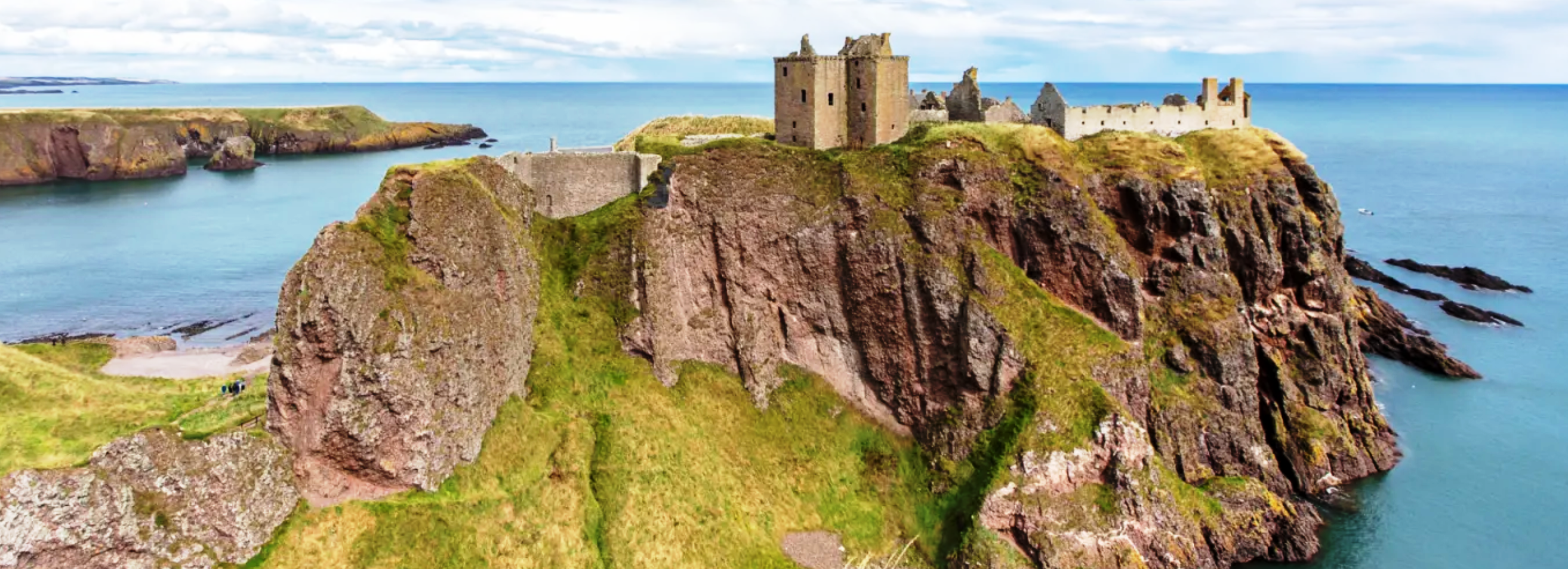 |
Dunnottar Castle
Dunnottar Castle is a ruined medieval fortress located upon a rocky headland 160 feet above the sea, on the north-eastern coast of Scotland, about 2 miles south of Stonehaven. The surviving buildings are largely of the 15th and 16th centuries, but the site is believed to have been fortified in the early Middle Ages. Dunnottar has played a prominent role in the history of Scotland through to the 18th-century Jacobite risings because of its strategic location and defensive strength. |
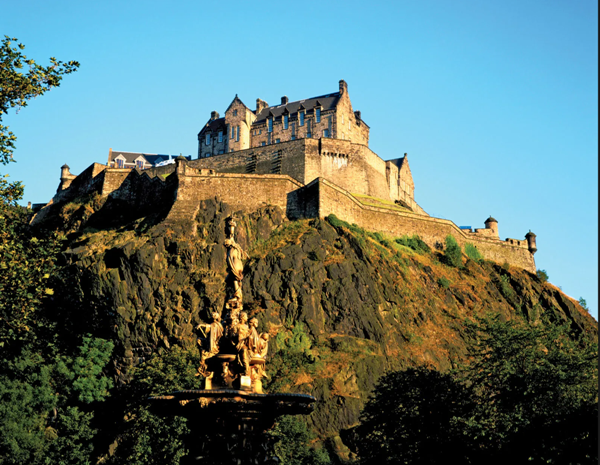 |
Edinburgh Castle
Edinburgh Castle stands on Castle Rock in Edinburgh, and has been occupied by humans since at least the Iron Age. There has been a royal castle on the rock since at least the reign of Malcolm III in the 11th century, and the castle continued to be a royal residence until 1633. From the 15th century, the castle's residential role declined, and by the 17th century it was principally used as a military garrison. Its importance to Scotland's national heritage was recognised increasingly from the early 19th century onwards, and various restoration programmes have been carried out over the past century and a half. |
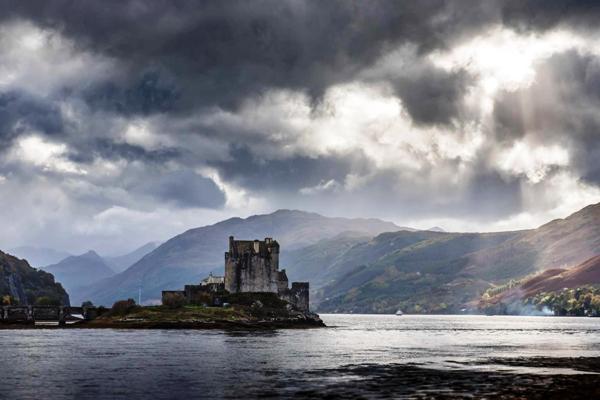 |
Eilean Donan
Eilean Donan is a small tidal island situated at the confluence of three sea lochs (Lochs Duich, Long, and Alsh) in the western Highlands of Scotland. It is connected to the mainland by a footbridge that was installed early in the 20th century. The island's original castle was built in the thirteenth century and became a stronghold of the Clan Mackenzie, and their allies, the Clan MacRae. In response to the Mackenzies' involvement in the Jacobite rebellions early in the 18th century, government ships destroyed the castle in 1719. The present-day castle is Lieutenant-Colonel Jon Macrae-Gilstrap’s 20th-century reconstruction of the old castle.
|
 |
Glamis Castle
The home I was born in is less than ten miles, as the crow flies, from Glamis. The castle has been the ancestral seat to the Earls of Strathmore and Kinghorne since 1372. Once the inspiration for William Shakespeare’s Macbeth, Glamis is renowned for its rich history and famous visitors, from Mary, Queen of Scots, to James V. The Castle was the childhood home of HM Queen Elizabeth The Queen Mother. Her younger daughter, HRH Princess Margaret, was born here and was also a frequent visitor during her childhood, alongside her elder sister, HRH Princess Elizabeth. Glamis is currently the home of Simon Bowes-Lyon, 19th Earl of Strathmore and Kinghorne.
|
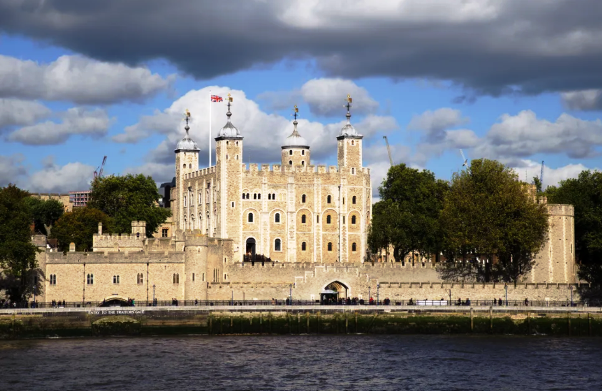 |
Tower of London
The Tower is a historic castle on the north bank of the River Thames in central London. It was founded toward the end of 1066 as part of the Norman Conquest. The White Tower, which gives the entire castle its name, was built by William the Conqueror in 1078 and was a resented symbol of oppression, inflicted upon London by the new Norman ruling class. The castle was also used as a prison from 1100 until 1952 although that was not its primary purpose. A grand palace early in its history, it served as a royal residence. As a whole, the Tower is a complex of several buildings set within two concentric rings of defensive walls and a moat. There were several phases of expansion, mainly under kings Richard I, Henry III, and Edward I in the 12th and 13th centuries. The general layout established by the late 13th century remains despite later activity on the site.
|
--------------------
I hope the above may remind you of visits you’ve made to these or other castles or stately homes - it also sets the scene for the little story below:
I usually had two reactions on my visits to these magnificent edifices: First, awe at the skills and industry of those craftsmen of several centuries ago, and then, the feeling that I really wouldn’t like to live in their large, cold spaces...
I remember, however, three further visits I made, many years ago, to castles that seemed to me to be built to a more human scale and that I could see myself living in.
The first is Lindisfarne Castle on Holy Island near Berwick-upon-Tweed, Northumberland, England. The
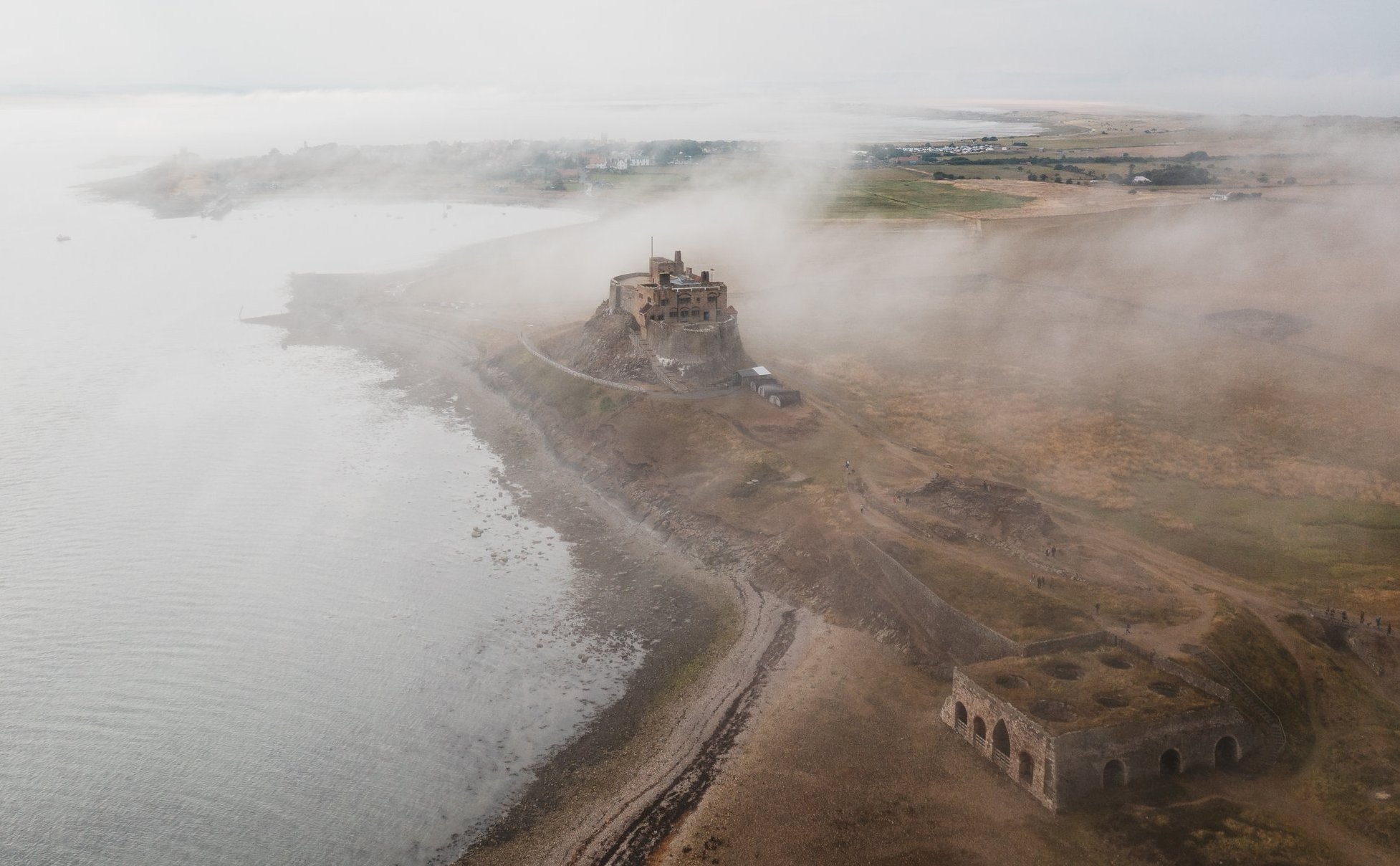 |
| Lindisfarne Castle |
island is accessible from the mainland at low tide by means of a causeway and has been a place of pilgrimage since the 6th century. The 16th-century castle was much altered and turned into a home by Sir Edwin Lutyens in 1901.
Some of the rooms felt quite cosy, and it had one long gallery with large windows giving impressive views across the island and the surrounding waters.
The second castle of the three, on the west coast of Scotland, is Duart Castle which stands on a cliff top dominating the eastern seaward approach to the Isle of Mull. Duart has been the base of the Clan Maclean Chiefs for over 400 years after the 5th Chief married Mary MacDonald, daughter of the Lord of the Isles, and received the Castle as her dowry.
The castle had extensions built up until the end of the 18th century when the Macleans had to surrender it to the Duke of Argyll, who used it as a garrison for Government troops until 1751. It was then left to become a ruin until 1910 when the 26th Chief, Sir Fitzroy Maclean, bought it and started restoring it.
Again, there were rooms that seemed to have been designed for the comfort of the occupants rather than for their ability to keep intruders out. The photos below show two such rooms, and another gallery reminiscent of Lindisfarne.
My third castle visit, many years later made the same impression on me as the previous two - comfortable living spaces including a gallery. I added this castle to my 'habitable' list...
Then, long after my visit, I was idly thinking of the trip when I had a sudden thought. I got out an atlas and confirmed my suspicion: The name of my third castle was Duart Castle... I had re-visited Duart without realising it at the time! No doubt you're thinking, "What a numpty. How could anyone...?" A perfectly valid reaction, for which I can only offer a partial explanation:
One of my visits was made by car on Mull, the other was by sea - a small boat trip from Oban, on the mainland, to a small dock at the castle, then back to Oban. The photos below show how the castle looked on each occasion, as I approached it.
As I said, "There were three, and I enjoyed both"
|
|
I don’t like guns! In the UK, apart from the military, guns don’t much feature in our everyday lives. However, because of the threat of terrorism, gun carrying police officers have started to appear more frequently at airports and railway stations. I know that these officers are well trained and responsible, but I still get a feeling of unease when I come across them. Like most males of my vintage, I experienced the use of firearms during my National Service. Thankfully, this was in controlled conditions on a rifle range and not on active service. With the ending of National service there can now only be a small proportion of the UK population with any experience of using firearms other than in pursuit of their employment or hobby and they will be subject to strict licencing regulations regarding the use and storage of their weapons and ammunition. Of course, guns are used in criminal activities, but their involvement remains rare enough to hit the headlines.
When visiting continental Europe I remain uneasy about seeing that most uniformed police officers are armed with a handgun. I have frequently discussed this with residents of various countries and the response was usually that they couldn’t comprehend why our police officers didn’t routinely carry firearms! I particularly recall a visit to Paris at a time of a high terrorism alert. There had been several bomb threats directed at banks and airlines, particularly those with any connection to Israel. Our hotel was in the Opera Quartier, an area with many shops, restaurants, banks, and airline offices. We had explored the area on previous visits and enjoyed the busy, free and easy atmosphere. On this visit there was an uneasy atmosphere about the area. There were more police on the streets, and we were conscious of extra security at the entrances of the grand magasins Galerie Lafyette and Printemps. I started to feel even more apprehensive when I spotted police in body armour armed with sub-machine guns guarding the entrance to banks and airline offices. Despite my concerns we spent a pleasant day before returning to our hotel to freshen up before dinner.
We had an excellent but expensive dinner at a nearby restaurant. This was only slightly marred by my still being aware of the increased security that seemed to permeate the whole area. I noticed that the armed police were still stationed by the banks and airline offices and that there were more than the usual number of police vehicles driving around. When we returned to our hotel, we decided to have a nightcap in the hotel bar where we got into conversation with some of the other residents. After swapping the usual stories about shops and restaurants the subject of security and the threat of terrorism was discussed. I found myself in the minority when the presence of armed police arose. The consensus was that their presence was a deterrent and that the populace felt safer for seeing them.
All seemed quiet when we returned to our third-floor room for the night. As we got ready for bed the sound of a single shot rang out. For a few seconds we just looked at each other in shock. Then came a burst of rapid fire followed by another single shot. My long forgotten military training came back to me and instructed Muriel to keep away from the window and get down on the floor. A further burst of automatic fire speeded up our reaction and we lay on the floor while several further exchanges of fire took place. After ten or fifteen minutes during which we could hear occasional single shots and police sirens silence prevailed. Very cautiously I inched towards the window that overlooked the street and peeped out. There were a few pedestrians visible but no sign of the carnage that I feared so I came out of defensive mode and deemed it safe to get some sleep.
On awakening next morning at around 8.00 am I looked out of the window to see a busy street and no evidence of anything resulting from the previous night’s events. On the way to breakfast I decided to ask the fount of all local knowledge, the Concierge, what had happened. I found him in his usual place and asked if anyone had been hurt in the shooting. He seemed puzzled and asked when this had happened. Enlightenment ensued. There was no shooting but some students celebrating the end of their exams were setting off Chinese firecrackers. He expressed his regrets that we had been disturbed and wished us an enjoyable day. After providing him with such a good tale and the appropriate recompense for his information I left to confess to Muriel that I had allowed my dislike of guns to cloud my judgement.
We returned to the same hotel about eighteen months later and as we arrived, I saw my friend the Concierge. I know that he recognised me because he pointed an imaginary pistol at me, pulled an imaginary trigger, then bringing his index finger to his lips, blew the imaginary smoke away!
|
|
 |
 |
My Friend Richard
Hugh McGrory |
 |
 |
Have you ever been driving your car, while giving your attention to something inside the car? Say you’re trying to tune your radio into a new station… You know that you should give 95% of your attention to the road and the surrounding traffic, but when your wheels begin to drive over the verge you realise that 95% of your mind had been on the radio! My friend Richard learned this the hard way…
When I say friend, we were more friendly co-workers - worked for the same organisation but were based some 80 miles apart so our paths didn’t cross too often. After retirement we both attended a lunch group of retirees every couple of months and got to know each other a little better. He was an interesting guy, very bright, good sense of humour, drove a sports car, and piloted his own small plane – always a pleasure to be around.
I didn’t see him for a few months then, at a lunch, noticed that he had damaged his hand quite badly, and it wasn’t completely healed. He said he’d been in a plane crash and told me the story:
His plane was a Van RV 7-A. (Van's Aircraft is a leading designer and manufacturer of kit aircraft, with
 |
| Same Model as Richard's |
more than 10,000 flying aircraft and a wide selection of available models.) The 7A is a side-by-side two seater, and comes with a choice of two cockpit canopies, a slider or a tip-up. Richard’s was a slider. I don’t
remember him saying that he built the plane, so I assume he bought it already assembled.
In 2015, at the age of 77, he took off from a small airfield in Southern Ontario, and as soon as he was airborne, realised that he hadn’t closed the canopy properly. He reached up and began to try to slide it properly into place and lock the latch. Sadly, he said, he forgot the 95/5% rule…
Accident report: “The private Vans RV-7A aircraft was departing from CNZ8 Grimsby Airpark for a local flight with only the pilot on board. Shortly after take-off, the aircraft descended and touched down in a soybean field. The nose wheel dug in, failed and the aircraft flipped over. The pilot was able to egress the aircraft unaided and emergency services attended shortly after. The pilot suffered injuries requiring hospitalization and the aircraft was significantly damaged.”
The photo below shows the actual plane after the accident. Richard said that, when the dust settled, he found
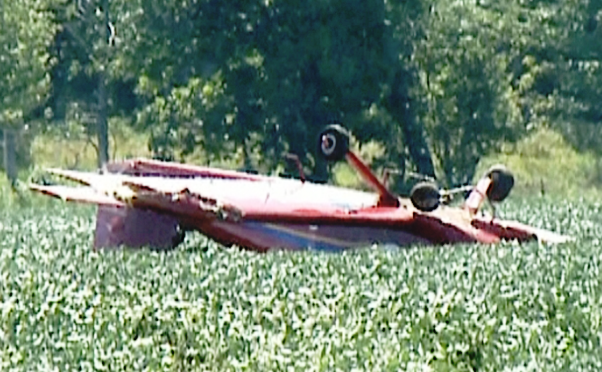 |
| Richard's Plane - the Aftermath |
himself hanging upside-down from his seatbelt. He had some difficulty figuring out how to release himself without breaking his neck, especially with his badly injured hand, but managed to be outside the plane when help arrived. He knew how lucky he was to have survived his last flight as a pilot.
Sadly, despite making a full recovery, Richard died in May 2020, of Covid. I’m sure he’s missed by many.
|
|
 |
 |
Sir Robert Gordon Menzies
Part 2
Brian Macdonald |
 |
 |
Bob Menzies is Australia’s longest-serving prime minister and likely to remain so. He presided over a period of stability for Australia, which prospered as a provider of food, coal, wool, and iron ore to the world after WWII. He retired at his own behest at age 71, having served as PM for a total of eighteen years and having held the federal seat of Kooyong for thirty-two years, to a house in suburban Melbourne, bought for him and his wife by wealthy friends and supporters in recognition of their contribution to the nation, and in which they lived until his death. As he had been Warden of the Cinque Ports, Menzies was entitled to make use of Walmer Castle in SE England’s pleasant county of Kent and there they spent part of each year.
Robert Gordon Menzies was an unashamed monarchist in an era when this was common in Australia. An oft-quoted excerpt from a speech is “I did but see her passing by and yet I love her till I die”, from a poem by the 16th C English poet, Thomas Ford, referring to Queen Elizabeth II of Great Britain. Another famous Menzies quote is that he described himself as “British to my bootstraps”.
He was honoured by the United Kingdom, to which he pledged his personal loyalty, by being made a Knight of the Order of the Thistle, a high chivalric order of the limited number of sixteen knights and ladies plus the then queen (now King Charles III) and under her personal control. He was made Lord Warden of the Cinque Ports, a British ceremonial office, succeeding Sir Winston Churchill. He had been a Privy Councillor of Britain during his prime ministership. Menzies also was awarded honours by the USA and Japan.
Possibly the honour that pleased Bob Menzies most, in his retirement, was his number one membership of the Carlton Football Club(1), of which he was a lifetime supporter. In the later years of his life the club built a special ramp so that his wheelchair could be wheeled up to his favourite watching spot in the Members’ Stand at the club’s home ground, Princes Park in Melbourne.
At one stage during his political career, he acquired the nickname of ‘Pig-Iron Bob(2)’ due to a policy of selling smelted iron ore to China. Another, longer lasting and kinder nickname was “Ming” and sometimes “Ming the Merciless’, drawn from the archenemy of Flash Gordon in the eponymous cartoon series. Scots readers will know that the name ‘Menzies’ is often pronounced ‘Ming-izz’ in Scotland and this was Robert Menzies’ preferred pronunciation of his family name.
Robert Gordon Menzies died in 1978 in Melbourne. His hometown, Jeparit, erected a twenty-metre-tall spire, with a thistle, Scotland’s national flower, on the top, to honour him.
Robert Menzies left a large legacy in Australian politics. He would not now recognise the party he founded, for, in the 21st C, it has drifted much further to the right as a party of big business and the wealthy. Menzies’ form of liberalism was right-wing but not excessively so. He believed in democracy and strove to make life better for all his constituents, not just for the fortunate better-off. He is rightly called ‘The Father of the Australian Liberal Party’ and his effect on Australian politics was profound.
Dame Pattie Menzies (1899 – 1995)
In 1920, when she was 21, Robert Menzies married, at a Melbourne Presbyterian(3) church, Pattie Maie Leckie, a young lady who had attended an upmarket Melbourne private ladies’ school. The daughter of a
former member of the Victorian Legislative Assembly (the upper house of Victoria’s legislature) who was later a member of the federal parliament and served as a federal minister in his son-in-law’s government, during and after WWII, she was an excellent choice as a political wife.
Pattie Leckie grew up as a working member of a politician’s family, often accompanying her father to meetings, campaigning for him and attending political events and dinners. Trained in political life, she became the model domestic and political partner for a prime minister. She bore Robert Menzies three children and ran the family home in a Melbourne suburb for twenty-five years, hosting Sunday dinners for invitees from Robert Menzies’ party, chairing committees and attending events. She accompanied her husband on his tours when he was prime minister and was a confidante and adviser to him.
| |
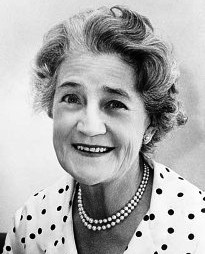 |
On her Royal Visit to Australia in 1954, Queen Elizabeth II conferred on Mrs Menzies the honour of Dame Grand Cross of the Order of the British Empire, in recognition of Mrs Menzies’ public work.
It is reported that Pattie tried to dissuade Menzies from travelling to Britain in 1941 to consult with the British prime minister, Winston Churchill, as Australia stood with Britain and the USA in WWII and was in some danger from Japan’s forces. She warned him that his absence would provide the opportunity for his enemies to undermine him. She was proved right, for he was ousted as leader of his party after his return to Australia. His party went into opposition at the next election in 1941 and Menzies became a backbencher until after the war’s end when he again became leader of his party and Leader of the Opposition in 1946.
Pattie Menzies loved The Lodge, the official residence of the Australian Prime Minister in Canberra(4) and was loth to leave it in 1941, after overseeing major extensions and renovations. In 1949 she returned to live in The Lodge for a further sixteen years.
After Robert Menzies’ death in 1978, Dame Pattie lived on in Melbourne, continuing her support of many causes, until 1992, when she and her daughter returned to the city of Canberra, which she loved, and which had by then expanded to be a city of over 300,000 souls. She died in Canberra in 1995.
Footnotes
(1) The Carlton Football Club is part of the Australian Football League and is a Melbourne inner-city Australian Rules Football club with strong community roots. Its playing colour is dark blue, which chimes with Menzies’ pride in his Scottish ancestry. ‘Aussie Rules,’ ‘Rules’ or just ‘Footy’ is a game played on a large oval ground by teams of 18 players and consists largely of long kicks and spectacular leaping to catch the oval ball. Although there are now AFL teams in all the mainland state capital cities, the sport was born in Victoria’s capital, Melbourne, where its rule is absolute. Growing up in country Victoria, and being tall and solidly built, Menzies undoubtedly played the game. New south Wales and Queensland both have strong attachment to a different code, Rugby League, and Aussie Rules is not the major sport in these cities.
(2) When iron ore is smelted it tends to flow into a shape somewhat reminiscent of a resting sow. Hence its being called ‘pig iron’.
(3) The Presbyterian Church is a reformed Protestant Church that grew out of the official Protestant Church of Scotland and is most common in that country.
(4) Canberra was officially founded in 1913 to be Australia’s federal capital city, since neither of the country’s two major state governments, in Sydney in New South Wales and in Melbourne in Victoria, would accept the other city as the federal capital when Australian federation occurred in 1901.
Canberra was built as a planned city. It was designed, after a competition, by an American architect, Walter Burley Griffin, in partnership with his architect wife, Marion. It was set on sheep paddocks in the middle of New South Wales, in a natural bowl surrounded by hills. A dam was built to create a lake, named Lake Burley Griffin, which is now a major feature of central Canberra. The lake is at an elevation of 550 metres. A special, self-governing federal territory named The Australian Capital Territory was legislated for the city. By 2022, Canberra had a population of over 430,000 and is a gracious, modern city housing the national institutions and galleries.
|
|
 |
 |
Would You Credit It?
Hugh McGrory |
 |
 |
Have you had the experience of having some scammer make purchases on your credit card? I’d be surprised if you haven’t. It has happened to me or my wife, Sheila, half a dozen times over the years – once it was for $23,000 Canadian for air tickets to India! We’ve never, once the dust settled, lost any money, but the process of getting the card company to sort it out is annoying and a nuisance.
Our most recent incident began when I came home one day, and my wife announced that she had just contacted our card company about false charges. They established with her that the charges were indeed an attempted rip-off and that the amounts would be reversed. In the meantime, she said, we should cut up our cards and should receive the replacements – in five to ten business days...
I grumbled and whined but dutifully did so. After a week or so she announced that she had her new card and I assumed that mine would probably be in the next post. It wasn’t, and after another couple of days I asked her to call them and see what was going on.
She did, and I listened as she explained that I hadn’t received a replacement card for the one I’d cut up. She was then asked why I had cut up my card... ... ...
Dummies! If we had thought for a moment, we would have realised that our cards, while they are both associated with the same joint account have, of course, DIFFERENT numbers – so mine hadn't been affected...
The agent assured us that she would get another card to me – in five to ten business days…
After we hung up I reacted to the fiasco the only way that seemed appropriate, in the moment... click here.
|
|
 |
 |
Live Ammo for All
Gordon Findlay |
 |
 |
That bandolier of live ammunition...! I have to be honest. As soon as we got back to our billet, each of us opened up ours and took out a few clips of that .303 ammunition, just to look at and admire it. The sleek,
shining brass and the copper-jacketed bullet snug in the top. These weren’t the crimped-off training cartridges we’d been issued on training exercise. No – these were the real thing, and each of us had a bandolier stuffed with them. Real bullets. That could kill people.
And just as soon, we each filled our rifle magazine with five .303s, seeing how snugly they clipped down against the spring, how deadly they looked in there. There was something weird, something basic and cruel about all of us, sitting there fondling these rounds of shiny ammunition, wondering how it would sound if we had to fire it, trying to
| |
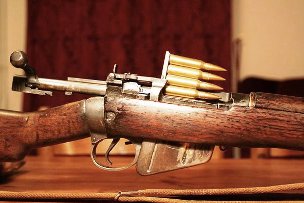 |
remember the sound of the bullets overhead at the firing range, the whipping crack of them as they flew over our heads. Were we going to be hearing that?
Again, I have to be honest. Secretly we all lusted to be given a chance to fire our weapons in warfare. Of course, we had no real idea of the agony and misery of war – we thought we were pretty special, well-trained, fit and ready to go. I can remember there were the usual bloodthirsty yells around our billet. “We’re going to hammer those wogs!” Silly stuff like that.
Next morning, new Daily Orders. The battalion was to assemble in the parade square at 0900 in battle dress and No. 1 pack only (that’s the lightest field pack you can go out into the field with). It comprises one spare shirt, one change of underclothes, spare socks, shaving gear, knife/fork/spoon and the like, plus our personal weapon, plus one filled water bottle together with a field dressing.
|
|
I seem to have gotten my wheels stuck in a rut after my last story, in that, having exhausted my pedal-powered-vehicle memories, my thoughts turned to the various cars I’ve had. I should say that I’ve never been a real car enthusiast, seeing them as more of a box on wheels that gets me from A to B – so don’t expect this tale to be very technical…
Actually, my transition to cars after my faithful Hercules bicycle was by way of the two motorbikes I had while at university – my Excelsior Roadmaster, followed by my Triumph Terrier. I had them through my
university days and loved them both. I sold the Terrier when I moved to London to work and was ‘wheel-less’ for a couple of years.
When I left the world of engineering consulting (in an office, designing structures), I joined the engineering contracting universe in Dundee (out in the field, building structures). My employer provided a vehicle, a Land Rover, which I could use as a personal vehicle when not at work.
This worked very well for a couple of years – saved me from having to buy a car. It had four-wheel drive which made it hard to bog down, but I remember one weekend when I drove to the Glens north of Dundee, with my girl friend, for a day trip. On a rather narrow road I pulled over to the side to let a vehicle pass, got too close to the ditch and slid in so that the Rover was at about a 45 degree angle. Fortunately, there was a picnic spot nearby with lots of people enjoying the highland air. I appealed to some of the younger guys and, with half a dozen of them lifting and pushing, the four-wheel drive pulled us out.
On another weekend I took my mother and her older sister, my Aunt Ev, for a day trip to Methil, Fife. We packed a picnic lunch and stopped on a quiet country lane in the shade of a tree. As we enjoyed our tailgate meal one of us knocked over a bottle of milk which spilled across the floor. We managed to wipe up the mess with some newspaper. It was a few weeks later when I began to notice a faint smell in the vehicle – sour milk! Since I left the firm soon after it wasn’t a problem for me, but I pitied future drivers…
My next position was in the office of the City Engineer, Dundee, and I began to look for a car. Serendipitously, my boss was looking to sell his 1937 Morris 8 – I made the deal and became the proud owner of a car the same age as me. I enjoyed driving it and it served me well for a couple of years.
On one occasion, when I was on the way to play a game of field hockey it began to spew out black smoke. I was under time pressure, so I kept going, and the hardy little engine, about the size of a sewing machine gamely kept going. I remember climbing up east Kingsway and seeing people waiting at a bus stop, pointing, and laughing, as I approached. They weren’t laughing after I passed, and they got enveloped in the cloud of smoke…
The garage that repaired the car said that when they took the engine out , one of the pistons fell out in two parts – it had split vertically through the middle. After repair, the car soldiered on, and my brother had it after me for a year or two.
Meanwhile, I had moved on to a buff-coloured Morris Mini Van having discovered that, as a commercial vehicle it escaped the tax on personal vehicles. It was great fun to drive and the space in the back was very handy. I can remember how small it felt when stopped at lights alongside a bus or truck with your head about level with the top of their tire…
The Mini was succeeded by a Ford Consul Classic the one with the ‘reverse-rake rear window’ which served us well until we emigrated to Canada in 1966.
On arrival in Canada buying a car was a necessity. I had to sit a driving test but was allowed to drive while waiting for it. The first month we were there we decided to take a trip to let the kids see Niagara Falls. I went to hire a car and found that I couldn’t resist a Ford Mustang – it was a fun trip…
Two years later Steve McQueen gave the Mustang a boost in popularity when he drove a modified 1968 Mustang GT 2+2 Fastback in the film Bullitt. This famous movie featured an iconic chase pursuing a Dodge Charger through the streets of San Francisco.
Having had my fun in the Mustang, I then bought a Plymouth Valiant, a low end unremarkable family car which served its purpose just fine.
Next came a 1969 Buick Skylark Coupe. I had to attend a conference (on computers and engineering) in Miami and decided to turn it onto a family road-trip vacation. We crossed the Canadian border and joined US interstate 95 (I-95) on a return trip of about 3,300 miles, to Key West and back. To make it more interesting we were pulling a tent trailer, which caused me some white-knuckle moments facing huge oncoming semi-trailers on the Overseas Highway, the 113 miles of roadway from Key Largo to Key West that incorporates an astonishing 42 bridges leapfrogging from key to key over the open waters of the Atlantic Ocean, Florida Bay and the Gulf of Mexico.
A few years later I was made an Associate in the consulting engineering company I worked for, and this entitled me to a company car. I assumed that this was a standard process – they would tell me go to a specific dealer and he would tell me which cars I could choose from. Not exactly! They gave me a dollar number and said, “Don’t spend more than this…”
Perhaps I was going through a mid-life crisis, since I ended up in a two door coupe, a Pontiac Firebird… I remember sensing some negative reaction from the head of administration when I reported my purchase to him - I remember asking him if this was inappropriate and he said it was up to me…
Perhaps I was being brash, or naïve, but that was the car that I had fun driving for the next few years – until
it started to misfire. I took it in for service and they told me that a gasket had failed, and the cooling system had leaked. Unfortunately, the coolant wasn’t leaking onto the ground, but into the engine – which meant that a new engine would be needed – and that was the end of my Firebird…
The replacement was a Honda Prelude, followed by a Nissan Maxima. Both were decent cars which served me well. The Nissan wasn’t particularly attractive to look at, but it had a great engine – I drove it for about 13 years, then my granddaughter had it for another couple.
Finally , my current car a ‘Baby Benz’ C230. It’s a 2008 model – it had been a trade-in to a local Mercedes
Benz dealer as a two-year-old car with only 3,500 Kms on the odometer! I’ve had it for 13 years – as a ‘retirement car’ the gauge reads 110,000 kms, about half the expected average distance. It’s still in decent condition so it may well be my last car…
|
|
I was the first-born grandchild to both sets of grandparents and was spoiled rotten by my five bachelor uncles. I was very fond of all of them, but I developed a particular affection for one of my father’s three brothers, my Uncle Andy. My first clear memory of him was shortly after the outbreak of WW2 being taken by mother into the shoe shop where he worked and being fitted by him for a new pair of shoes. Within a few months of this he joined the Royal Air Force and was trained as an instrument mechanic, enhancing his new skills by mending the clocks and watches of colleagues and friends.
Apart from brief spells of leave, I saw little of him over the next couple of years. He was based near Bristol and was courting the young lady who was to become my Aunt Vera. When he was given embarkation leave before being posted to Algeria, she came to Dundee with him and returned to Bristol with an engagement ring on her finger. My eight-year-old self was enthralled by the glamour of it all. I should say that by this time some of my other uncles had arranged for me to have aunts and even a couple of cousins but only my Uncle Andy had introduced a potential aunt from far away Bristol!
For the next eighteen months the only news that I had of Uncle Andy was through an infrequent exchange of letters. Mine were about my various activities and hobbies and his about Algeria and the people that he met. My eyes popped on learning of a party given by French Air Force colleagues for his “Anniversaire” with a cake with André written on it. Towards the end of WW2 Uncle Andy returned to the UK and was again posted to a base in Southwest England. Understandably he spent whatever time that he could with his fiancée but when he did visit his parents, he brought a hundred or so Algerian stamps for me and showed that he remembered that I had an interest in astronomy by giving me a book on the subject. How lucky was I to have an uncle like that?
In 1946 Andy left the RAF and decided to settle in the Bristol area. Vera became my aunt Vera and Andy put his RAF experience to use and started work as a watch repairer in Central Bristol. Within eighteen months he decided to set up a workshop at home and to specialise in the repair and servicing of specific types of quality watches. Three girl cousins arrived over the next five years which made the logistics of visits to Dundee rather difficult. Despite this Andy and Vera made the occasional trip north and I could see how happy they were with the life that they enjoyed together. Vera soon resumed her career with the Post Office and they both started to play golf.
In the Autumn of 1953, I accepted the long-standing invitation to visit them. As I couldn’t afford the luxury of travelling by rail, I undertook the journey by a complex series of connecting coach trips that took twenty-six hours. I was met by Andy, Vera and the girls at Bristol Coach Station and whisked to their home in Wick, a village just outside Bristol. I had a great time and for the first time had the opportunity to talk as an adult to Andy and to see how he organised his life. Working from home gave him a lot of flexibility. There was a demand for his special skills with a small range of quality watches and he had both trade and private customers. He had bought an engraving machine advertised in Exchange and Mart so that he could produce name plates as a sideline. Within a short time, he had established a niche market in producing coffin plates for the local Funeral Directors. When it rained he worked long hours, but when the sun came out he could go to the golf course. My Uncle Andy had attained the perfect work/life balance!
Towards the end of my National Service Muriel and I spent a week of my annual leave with Andy and Vera. Shortly after our arrival Uncle Andy took me out for a drive in his new Vauxhall Wyvern. After travelling a few miles, we stopped in a lay-by, and I was invited to take the wheel. Although I had held my driving licence for a couple of years I had very little experience of actually driving. Despite this I drove around for a few miles and when we returned home I was presented with the car keys, a road map of the area and told that there was an almost full tank of petrol for use during our stay. How did I deserve an uncle like him? Apart from getting blocked in a car park at the Cheddar Gorge we spent a very happy time exploring the area.
The following year Muriel and I married and moved to Caithness. Among the wedding guests were Uncle Andy and family, this was the last that we saw of them until we moved to Berkshire only an hour away from Bristol. Over the next three years we exchanged visits. The girls became young ladies and they each chose their career path while Andy and Vera furthered their own careers. With the girls leaving home to complete their education their parents were able to spend more time on the golf course. By this time Andy was in his mid-fifties. By becoming even more specialised in the watches that he repaired and serviced he cut the time spent in his workshop. This gave him the opportunity to play more golf and participate in the running of their club. Over the next thirty years my Uncle Andy became well known throughout the Southwest England golfing community both as a player and as an administrator.
By his sixtieth birthday nearly forty years of peering at and handling small parts had taken its toll on his eyesight hastening his decision to retire early. Andy and Vera both retired at the same time and settled down to a contented life of golf and grandchildren. They downsized to a modern house in the same area. The only reminder of the watch repair workshop was the engraving machine in the garage that still provided a small but steady source of extra income. They both continued to live happily surrounded by family and friends until Vera had to have residential care following a stroke. Andy, my last surviving uncle, lived on for another five years in the family home until his death aged ninety-five. During this period we exchanged telephone calls most weeks, and I still receive regular text messages and occasional visits from his two surviving daughters when we reminisce on a life well lived.
I owe a lot to my Uncle Andy. In many respects I have tried to model my on life on his. He was the first member of our family to move more than a few miles from the area in which they were born. He worked hard to achieve his goals in life but left time for his family and his other interests. He retired from work before it became absolutely necessary but filled in the newly available time constructively. Most importantly, he built a family that loved and respected him.
Despite achieving almost every goal that he had in life, one ambition continued to elude him, a hole in one. It was not until shortly after his eighty-fifth birthday that I got an excited phone call from him to tell me that he had made his hole in one. I still miss my Uncle Andy.
|
|
Funny how your mind works…
The other day, I had lunch with a couple of former colleagues and when walking back to our cars one of them said “Your front tires look soft”. They did, and I hadn’t noticed. When I got home and checked them, they were low, and I had to get out the compressor and add air to all four wheels.
The only point of that little story is that, while blowing up the tires I got to thinking of wheels, and I thought to myself, "I’d like to meet the person who invented the wheel and axle (apparently about 6,000 years ago) that had such an impact on our civilisation”. When you think of how many ways we use wheels every day – from baby carriages and toys, to planes, trains, and automobiles...
Obviously, I have no memory of being in the pram my mother got when I was born. I do though have memories of when my wee brother (seven years younger) was a baby in his pram (perhaps the same one?) and being jealous of him lying in comfort while I had to try to keep up with mother as she pushed the pram
on shopping expeditions. I think he graduated to a Tansad when he was a little older – the kind with smaller wheels and a drop-down foot space).
My first vague memory of ‘my’ wheels is of the tricycle that I had when I was two or three years old.
The
photo shows me riding it in my grandparents’ house in Wilkie’s Lane, Dundee, some 84 years ago. Made by Triang, it was a cheap little, rather 'tippy', vehicle, with no brakes other than the pedals or the soles of my shoes on the ground. If you leaned the wrong way, it would tip over sideways, with one rear wheel and the front wheel (and your nose) on the ground. I imagine though, that it gave me and my pals a lot of fun, and my mother a few grey hairs as I came crying with the latest scratch or bruise.
My next set of wheels was a four-wheeler pedal car. I don’t have a good memory of it – I couldn’t find a
photo to match the vague mind picture I have, but conceptually it was like the photo, red and metallic.
My buddies and I used to ride two at a time, one driving, and the other either on the hood or behind the driver. More than once we rounded the corner of Fairbairn Street onto the slope of Arklay Street and headed at ever-increasing speed down the hill which ended at a tee-junction with Dens Road, a major road and tramcar route. This made us use our feet as brakes, in a panic…
One time we almost ran into the side of a stationary tramcar – dumb kids. I have a feeling that the
| |
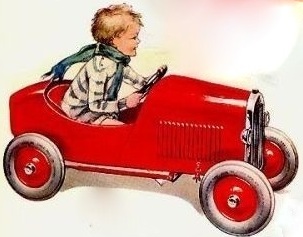 |
car didn’t last long – I suspect due to my mother’s disapproval…
Some time later I got a surprise when my dad came home one day with several bits and pieces (like two axles and wheels from an old pram) and announced that he and I were going to build a soapbox – I have no memory of asking him for this, I think he decided on his own – pretty sure he didn’t discuss it with my mum because I guarantee the answer would have been “No way!”
I have no memory of the making of the machine, but it looked very like the one on the left in the photo. No
pedals, of course, though it had a rudimentary brake (just a piece of wood mounted on the side – grabbing it and pushing made it rub against a tire – didn’t work very well and tended to make the cart slew to one side. The other photo shows a professionally-built car – included because it shows a brake).
We used the cart for a brief time until it disappeared rather suddenly... Pretty sure my mother saw us heading down Arklay Street in it and told my father to get rid of it…
Last, but certainly not the least of my non-motorised wheels belonged to my Hercules bike. I wrote of this in a previous story, so I'll simply repeat what I said there:
"In my early teens, my parents took me down to Halford's in the High St. and bought me a bicycle – a Hercules. I remember I wanted drop handlebars, but my mother insisted they were dangerous and so I had to settle for an upright. Arguably the single, best, most life-changing present I ever got in my life – from then on that bike was with me almost every time I left the house, and vastly expanded my world."
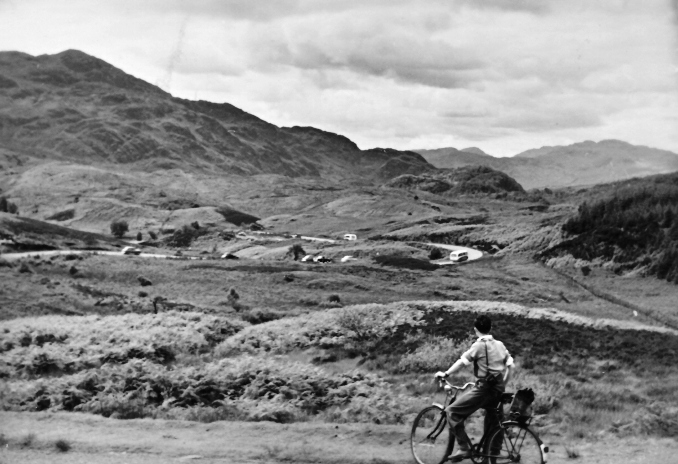 |
| My trusty Hercules and me on the Duke's Pass, the Aberfoyle/Trossachs road. |
All those memories dredged up by the simple act of blowing up the tires of my car.
As I said at the beginning of this tale "Funny how your mind works” – perhaps I should have said "Funny how my mind works..."
|
|
 |
 |
Sir Robert Gordon Menzies
(1894–1978)
Brian Macdonald |
 |
 |
Sir Robert Gordon Menzies KT (Knight of the Order of the Thistle(1)), AK (Knight of the Order of Australia), CH (Companion of the Order of the Companions of Honour, a British order of the Commonwealth realms), QC (Queen’s Counsel), FAA (Fellow of the Australian Academy of Science), FRS (Fellow of the Royal Society) was the founder of the Australian Liberal Party, the dominant right-wing federal political party.
The two previous Scots ‘Fathers’ of some major aspect of the development of my adopted country,
Australia, were military men of the late 18th and early 19th century. The third of the trio, Robert Gordon Menzies, although born in the 19th century, is a twentieth century man and fought his battles in the courtroom and in the Australian federal parliament.
‘Bob’ Menzies was born in the tiny town of Jeparit(2) in the western part of Victoria, since January 1st, 1901, an autonomous state of Australia but in 1894, prior to federation, when he saw the light, a separate colony of Britain. This agricultural region is known as the Wimmera, after a major river, and the town of Jeparit, where he was born, 370 km west of the Victorian state capital, Melbourne, was an agricultural settlement of under one hundred people at the time of his birth. His parents, with two sons and a daughter, had moved there from the gracious, Victorian gold-mining boom town of Ballarat, a year earlier, to run the general store, a change for
| |
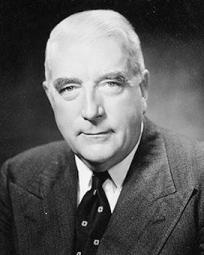
|
his father from working in a Ballarat foundry, building locomotives and, later, with his own tractor-painting business. Robert was born in a back room of the family’s accommodation at the rear of the store. A further son was born after Robert, making the family one of four sons and a daughter.
Menzies’ Scottishness is less close than that of Macarthur or MacQuarie, yet its flame burned as brightly in him as in either of them. His maternal grandparents were both Cornish. His paternal grandfather, Robert Menzies, came from Renfrewshire in Scotland. Those three ancestors had come to Australia separately, lured by the 19th century Victorian gold-rush. That Robert Menzies met and married, in Australia, Elizabeth Band, daughter of a cobbler from Fife in Scotland. There is no further family connection with Scotland. While his middle name, Gordon, is a recognised Scottish boy’s name, in his case it was bestowed as homage to General Gordon, ‘The Hero of Khartoum,’ an English general with no Scottish connections.
Jeparit had a one-teacher primary school, which the young Robert Menzies attended from 1899. He later attended the Methodist Grenville School in Ballarat on a scholarship. following in his older siblings’ footsteps and living with a grandmother. While his primary education records nothing significant, Menzies sailed through his final secondary education at the prestigious Wesley College in the state capital, Melbourne, collecting awards and lucrative scholarships that paid for his secondary and tertiary education. He graduated as a Bachelor of Law from the University of Melbourne(3) in 1916 and was called to the state of Victoria’s bar two years later. He quickly established a reputation for his skill as a barrister and as an authority on constitutional law.
While he was growing up, an uncle and his father both became members of the Victorian Legislative Assembly, and another uncle was elected to the federal House of Representatives. Menzies’ grandfather was president of a trade union. With such a background it is not surprising that Robert Gordon Menzies sought and won a seat in the Victorian Legislative Council (the upper house) in 1928, and, a year later, stood for and won a government-party seat in the lower-house Legislative Assembly, having already established himself, over a ten-year period, as a leading Melbourne barrister specialising in constitutional matters. Clearly from the right wing of politics, he supported constitutional democracy, the rule of law, the sanctity of contracts and the value of society’s existing institutions. He was always suspicious of the left-of-centre Australian Labor Party and believed in the superiority of free enterprise. He quickly became a minister and, later, the deputy premier of the state.
In 1934 he won the seat of Kooyong(4) in the federal parliament, for the United Australia Party, a coalition of right-wing factions. Appointed Attorney-General of Australia, he retained that position until 1939, when he was elected leader of his party and thus appointed Prime Minister of Australia, on the sudden death of his predecessor, during the first year of World War II. It was during the early part of this, his first prime ministership, that the long-lasting alliance between what later became the Australian Liberal Party and the then Country Party(5) was forged.
His first period as PM saw the rise of Hitler in Germany and the outbreak of World War II. Menzies took Australia into the war as a staunch ally of Great Britain. His prime-ministerial tenure lasted until 1941, when, as is often the way with politicians in parliamentary democracies, having had a difficult time, he lost the confidence of his own party and was forced to resign its leadership and the prime ministership.
The Australian Labor Party became the governing party until after the war ended in 1945 and Menzies remained an opposition back-bencher until 1946, when he assumed the leadership of the Australian Liberal Party(6) , of which he had been a prominent founder.
At the 1949 federal election, Menzies and the Liberals won back power, replacing Labor and the railway engine-driver turned politician, Ben Chifley. This was the start of the Liberal-Country Party alliance which governed Australia for the next twenty-two years. Robert Menzies remained PM until 1966. These early years of post WWII Liberal-Country Party rule set the scene for the federal political dominance that has extended until the 21st century with infrequent periods of Labor government. It was a time of post-war prosperity and affluence and mostly peaceful although, adhering steadfastly to his loyalty to Britain, Menzies took Australia into both the Korean and Vietnam wars in support of the UK. Menzies was not universally admired and an official portrait of him in Parliament House in the then not long-established federal capital of Australia, Canberra, was badly slashed in 1954, occasioning the need for a replacement to be painted.
Footnotes
(1) The purple blossom of the spiky thistle is the national flower of Scotland. It has been said that it symbolises the Scots character, attractive but spiky and needing to be handled carefully.
(2) At the 2016 Australian census, Jeparit recorded a population of 342. This was down from the 394 of the 2011 census, a sadly common trend in small rural Australian towns in the 21st C.
(3) The sandstone University of Melbourne was founded in 1853, a mere 65 years after the first fleet of convicts from England landed in 1788. The second oldest in Australia, it was Melbourne’s only university when Menzies studied there. Now, it is Melbourne’s most prestigious university and considered by many to be Australia’s finest.
(4) Kooyong, as well as being (until the federal election of 2022) a blue-ribbon conservative Australian federal electorate, is an upper-middle class, older suburb of Melbourne, part of the then city of Kew.
(5) As the name suggests, the Country Party represented mainly rural electorates, huge in territory but sparsely populated. Australia’s economy was primarily based on agriculture and mining during most of the 20th century and the needs and wishes of residents of rural properties and small country towns were quite different to those of city-dwellers. By far the largest part of Australia’s population lives in cities around the south and east coasts of the island continent. Sydney and Melbourne each have a population of five and a half million.
(6) The Australian Liberal Party began as a moderate right-wing party to replace the old United Australia Party. In a coalition with the smaller, rural-based Country Party – now the National Party – which continues to this day, it has been the dominant force in Australian federal politics since its foundation in 1944.
|
|
When I was a schoolboy growing up in Dundee, Scotland, my mother would sometimes ask what I’d like for our evening meal (we called it tea – usually around 6:00 pm). My standard answer would be ‘chip and egg’ (two fried eggs with lots of french fries.)
These chips were deep fried and delicious – Mum had a chip pan, actually a pot, about 8 inches high containing, I think, lard. After a batch was cooked , the melted fat would be strained to remove the little crumbs of potato, then the pot would be put in the cupboard where the fat would solidify and be ready for the next time.
My dad died in his late 60s, and my mother lived on alone for another quarter of a century. During that time, she experienced two chip pan fires – which she neglected to mention to me or my brother, no doubt on the
principle of ‘what they don’t know won’t bother them’. Neither of us has any details of the incidents, though apparently the fires were contained, and no one was hurt. On one of the occasions the fire department attended, and some cupboards were damaged and had to be re-worked.
Chip pan fire is the term used to describe fires which share certain features: residential; kitchen; deep frying using oil or fat; pan left unattended… doesn’t necessarily mean that chips were involved, though in many cases they are – come home late after a night out, have an attack of the
| |
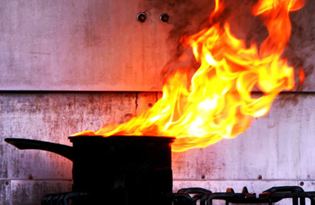 |
munchies, put the chip pan on to heat up, sit down in the living room for a few minutes, dose off…
Such fires are a serious issue in most countries, and fire departments have published many ‘Dos and Don’ts’ on the subject. Here is one from the City of Manchester. There are many stories of death and devastation arising from such fires. Some examples:
“The victim of a horrific chip pan accident in Whitburn, West Lothian, ran across a street with skin hanging off his body and leaving a trail of bloody footprints, shocked neighbours said today. John Bage suffered severe burns to around a third of his body after the handle of his chip pan broke off, covering him from head to foot in blazing oil. He even suffered injuries to the inside of his throat as a result of inhaling fumes.”
“A chip pan left on a hot plate in 2015 was the most likely cause of a devastating fire that claimed ten lives at the Glenamuck halting site in Carrickmines, south Dublin. Investigators examined an electric cooker at the scene of the fire, and they found that a chip pan had been left on a hot plate on full power.
The traveller victims were Thomas Connors (27), his wife Sylvia (30) and their children Jim (5), Christy (3) and six-month-old Mary. Willie Lynch (25) and his partner Tara Gilbert (27) who was pregnant, and their daughters Jodie (9), and Kelsey (4), also died, along with Jimmy Lynch (39) a brother of Willie.”
“A beloved dad of five died in his Swadlincote hostel following a chip pan fire. The smoke alarms were not working, an inquest has heard. Peter Greenshields had been cooking chips in a chip pan after drinking "a large amount" of alcohol and the pan caught fire. Despite the fire going out on its own, Mr. Greenshields had already inhaled too much smoke which sadly led to his death.”
"A mistake cost a family man his life when he tackled a chip pan blaze with water. Retired railman John Frisken stood no chance when the flames flared up and engulfed him, an inquest heard. His death sparked a safety alert today with fire chiefs warning people not to try to put out chip pan fires, but simply get out of the house. Well-loved granddad Mr Frisken died from 80% burns on March 18 following the fire at the home he shared with his wife June, 63, in Addison Close, Heaton, Newcastle."
The effect of putting water on an a boiling oil fire has to be seen to be believed….
My mum had one earlier chip pan fire encounter… I was about 15 or 16 years old, it was ‘tea’ time, and she, my dad, and I were sitting in the living room. She was in the process of preparing the meal and got up to walk into the kitchen. As soon as she opened the door she screamed “Fire, Hugh!” (That was my dad she was calling to, not me…) He and I dashed after her to see the chip pan engulfed in flames, just like the photo above.
Dad took control. He told me to get out of the way, and my mother to open the back door. He bent down and picked up a carpet from the kitchen floor. Fortunately, it was a thin(ish) carpet, and this allowed him to wrap it around the pot to protect his hands and body as he lifted it from the stove top, and stepped through the back door with the flames shooting a couple of feet higher than his head.(Not recommended, but effective...)
We lived in the semi-detached home on Clement Park Road shown, on the left in the photo. The back
garden was the same level as the street at the front of the house, with, as you can see, three steps down to a path, then four steps down to the street/backyard level. The second set of steps were straight ahead from the back door, not off to the side as they are at the front.
Suddenly, disaster struck! Dad couldn’t see where he was placing his feet, for obvious reasons, and he tripped. As he pitched through the air, he threw the pot to one side and fell, head first, into a flower bed on the other side – it was quite spectacular…
Fortunately, his presence of mind (and Lady Luck) saved the day. The fat burned itself out harmlessly, neither Mum nor I were harmed and there was very little damage to the kitchen. As to my dad, I’m sure he must have been bruised, and maybe singed a little, but he didn’t need medical attention.
I was very impressed at how Dad handled himself – I hate to think what might have happened if he hadn’t been there. I’m proud of him – he was small on the outside (only 5’3” in height) but big on the inside where it counts.
Sort of like the TARDIS…
|
|
It began when a company runner came over to us at breakfast and told us, breathlessly, that we were all to report to our Intel room “at once!” Sgt. Krywald, Dagg, Howson, myself, and Bannerman all quickly gathered together to find Lieut. Thompson already there. He quickly and quietly told us that we were to prepare the 22 or so maps and overlays for our group of officers “immediately!”
We all set to, putting all the information we were aware of onto the acetate overlays above maps of the Canal Zone at the locations which had been assigned to 3rd Infantry Division – and to 1st Battalion, Highland Light Infantry.
When we emerged later in the morning, our whole camp had taken on a sudden air of urgency. There was an air of excitement rippling through everything. You could sense the difference, the feeling of purposefulness, as if we were all being caught up in something important and perhaps even dangerous. All at once the steady and predictable life of our camp had been tossed aside. The pace picked up and took on an urgency of its own.
A torrent of new equipment and supplies began to pour into our camp. A dozen new 3-ton trucks rolled in and were parked, ready to receive our H.L.I. decals. More trucks arrived and disgorged crates of new Bren light machine guns plus cases of new Bren magazines.
Then came extra Vickers’ heavy machine guns, new 3-inch mortars, a half-dozen tracked Bren gun carriers, a flock of new Jeeps, and case upon case of ammunition in its distinctive rope-handled wooden boxes.
Huge rolls of gleaming barbed wire piled up, with long piles of steel stakes which would support it. A stack of new truck tires grew, and so did spare tank tracks, jerry cans, groundsheets, camouflage nets, radio sets and batteries. The stuff just kept rolling into our camp area, truck after truck, and there was so much of it our small armoury had to start dumping the crates and boxes around the building, with guards posted beside it.
We were kept hard at work, preparing the overlays for all officers. Problem was, new information kept funneling in with updates about the Egyptian positions along the canal, the weaponry they had, the number of troops, changes to landing zones, and so forth. Our previous information had to be scrubbed off the transparent overlays and the new Intel inserted in its place.
It was very labour intensive and of course, we had the temperamental Sgt. Krywald breathing down our necks. And a day later it got more interesting still. Daily Orders came out, and the first order of business was contained in one dramatic line:
“All ranks will draw live ammunition.”
All the line companies (A, B, C, etc.) were first. They were followed by HQ Company, of which we were a part. We marched up to the armoury, and one by one filed past the orderly corporal who checked our name then handed each of us a cloth bandolier containing 200 rounds of .303 ammunition plus one coloured smoke grenade (mine was yellow).
Each of us was also handed a field duty first aid kit: a khaki-coloured package about the size of a pocketbook, containing compression bandage, gauze squares, burn ointment, sterilizing solution in a tube, and adhesive tape…
|
|
 |
 |
Dundee Worthies 2
Hugh McGrory |
 |
 |
A worthy is someone who, for some reason, attracts attention. They fall into two categories, those who are eccentric/notorious, and those who have done something worthy of admiration. Brian MacDonald contributed an anecdote some time ago dealing with the first category. This story is about someone in the second group that I admired – George Kidd.
George was born in Hill Street, Dundee in 1925, and was educated at Clepington Primary and Stobswell Secondary School. He served in the navy during World War 2 and on retuning home, decided that he wanted a career in professional wrestling. This surprised many since he was only 5’6” tall and weighed just 9 ½ stones (133 lbs). Nevertheless, he was a determined man and records show that he appeared in the professional wrestling ring in Aberdeen in late 1945 and in Dundee’s Caird Hall on January 8th, 1946 (while he showed promise as a fast and clever wrestler, he was KO’d in the 3rd round…).
Realising that he had a lot to learn about wrestling, he spent the following year in Yorkshire, fighting, and learning both the technical and the business side, under the tutelage of Norman Morrell, a famous British Olympian wrestler. In addition to this, he began to develop his own unique style based on the principles of ju-jitsu and hatha yoga. The muscle-stretching exercises of yoga allowed him to develop the contortionist moves for which he was famous. He spent countless hours learning every wrestling move he could and how to counter them.
George’s timing was good. In the ‘30s and ‘40s professional wrestling had fallen into disrepute – it was full of gimmicks with large heavy men, often in fancy costumes, throwing each other from the ring, jumping from the ring posts on to each other, headlocks, pile drivers, and bloodshed. The time was ripe for something new - smaller, more agile, men who were more technically oriented. The term ‘technical chain mat work’ is used to describe it. The wrestlers spend much of their time on the mat using various technical moves to put their opponent into a hold, or to escape from one, and chaining these moves seamlessly together in extended sequences – a cat-and-mouse battle, waiting for an opportunity to pin the opponent.
He excelled in this type of wrestling. After two years as a professional he won the Scottish lightweight championship, when he knocked out Tony Lawrence at the Caird Hall, Dundee. In 1948 he defeated Jack Dempsey to win the British title, and in 1949, on 25th October, defeated Rudy Quartez for the World Lightweight Championship. At just 24 years of age George Kidd was a wrestling star.
Of course, what the fans wanted to see most of all was George bamboozle the villains of the ring. He was more than capable of obliging, as were the biggest names in the business who played the role of the luckless opponent – Mick McManus, Jackie Pallo, Adrian Street, even heavyweight Jumping Jim Hussey.
| Mick McManus |
Jackie Pallo |
Over more than 20 years, George successfully defended his championship title 49 times. In 1971 he defeated Adrian Street, and in 1972 Jim Breaks. He fought more than 1000 times, many of these in Dundee’s Caird Hall, and, in his last bout, 2nd March 1976, he defeated Steve Logan, announcing his retirement from professional wrestling as the undisputed, undefeated, World Lightweight Champion.
| George early in his career |
George in his Final year of wrestling. |
Wrestling fans fit into a scale – at one end, those who say that it’s all faked, and at the other, those who believe that the two men in the ring are trying to kill, or at least seriously injure each other. The truth is somewhere in the middle… Professional wrestlers are also professional entertainers. They have families to support, they need regular work, and understand that intentional injury is not part of the business. Bouts are usually ‘fixed’ to the extent that the winner is known before they enter the ring, and which round and, sometimes, which submission hold is specified.
| Adrian Street |
Jumping Jack Hussey |
But professional wrestlers are athletes, like circus performers or ballet dancers, or stuntmen in movies, risking their limbs and sometimes their lives, skilled men taking part in a risky performance, working with a level of co-operation to produce a contest that satisfies the fans. Bobby Boland, the Dundee boxer. and later wrestler (mentioned in last weeks anecdote) said, “All I can say is that in my years as a professional wrestler I picked up more injuries than I did in 12 years as a boxer.”
George Kidd’s longevity in the ring was due to his ability as an athlete and an entertainer, and to the respect he earned from the wrestlers he encountered in the ring, who worked with him to provide great entertainment for the spectators.
After retirement, George had a career in Scottish television as presenter of Wednesday People and The George Kidd Show and his engaging personality and quick wit led to viewers voting him Grampian Television Personality of the Year in 1965.
He also owned a series of pubs in Dundee including the Ellenbank, on Alexander St (where he once had worldwide boxing great Sugar Ray Robinson as a guest). After his wife died, George led a quiet life in a flat on Lawrence Street in Broughty Ferry, until his death, aged 72, in 1998.
To appreciate the man, you really needed to see him in action. Sadly, there seems to be few examples available. I did find two videos - Match against Black Jack Mulligan and George's final match...
Postscript
I thought I had completed this story and was ready to post it when I stumbled on the following:
Kent Walton was asked a question (he is best remembered as the predominant commentator on ITV's coverage of British professional wrestling from 1955 to 1988).
The question was "Who is the greatest professional wrestler you ever saw perform?" Since he was employed by ITV, and not by the promoters who actually produced the wrestling shows, Walton was seen as an impartial voice with an encyclopedic knowledge of professional wrestling.
He said, in response, that there was one revered master of escapology, dubbed "the Houdini of the Mat", who earned the most respect from his peers of that era. He was known for extracting chain wrestling elements, submission holds, and weaving them into highly intricate sequences. The result was an often-emulated, breathlessly entertaining art form in which the mat wrestling element of the match became the real focus of crowd fascination.
Walton said he considered this innovator to be a consummate professional and held him in higher regard than all the rest. Short in stature, but a genius in invention - his name was George Kidd.
|
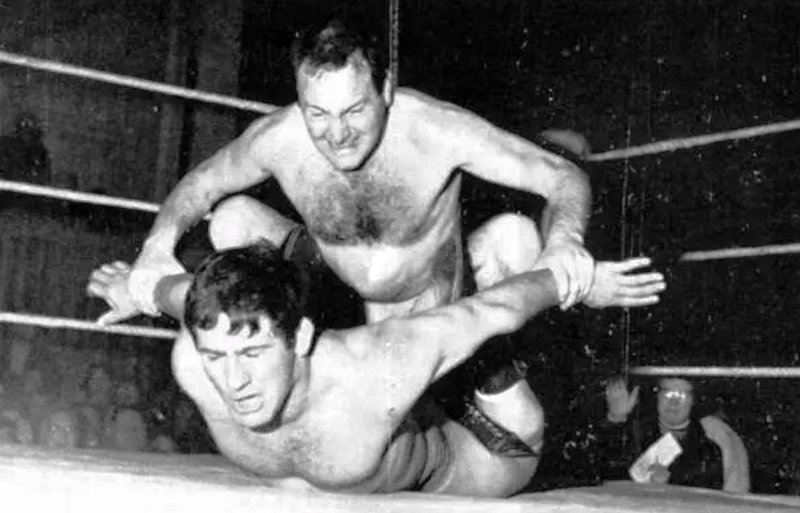 |
| George Giving Jim Breaks a Lesson... |
|
 |
 |
Seconds Out in Dundee
Bill Kidd |
 |
 |
Over the years sport has been an important part of my life, sometimes as a participant and others as a spectator. I have played football, both rugby and association and taken part in athletics, all without any notable success. I have spent much of my leisure time on court for badminton, squash, and tennis. I have dabbled in table tennis and basketball, and it was during a basketball session in Ward Road Gym that I found a casual interest in boxing. This came about because one of the basketball players was Peter Cain who was a professional boxer. You could search for a year without finding anyone less like the popular image a boxer. Peter was in his mid-twenties at that time, he was a modest, gentle, and charming individual and a gifted athlete. Over the few weeks that I attended the basketball sessions with him I learned quite a lot about the professional boxing scene that had come to the fore between the 1930s and the 1950s. Peter retired from boxing shortly after I met him but continued his interest in local sport as a trainer and coach.
Every Dundonian is aware of Dens and Tannadice Parks as football stadia but not as the venue for major boxing promotions, the last open air promotion taking place at Dens Park when Norman Tennant boxed Terry Allen in June 1949 in front of 16,000 spectators. The Caird Hall and Dundee Ice Rink also hosted championship boxing. Dundee’s own dedicated boxing arena, Premierland in William Lane was the scene of lesser events while the travelling Funfair held at Gussie Park usually featured a Boxing Booth where Pro Boxers would take on all comers. Many of the events were promoted by Dundee Bookmaker George Grant who went on to promote an open-air boxing world championship at Hampden Park in 1946 when 45,000 spectators watched Jackie Paterson defeat Joe Curran to become World Flyweight Champion.
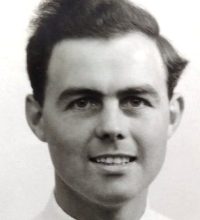 |
 |
The big names from Dundee in the 1930s through the 1950s were Jim Cowie, Jim Brady, Freddie and Norman Tennant, Bobby Boland, and Ken Shaw. However, the best remembered Dundee boxer was never a professional, I refer of course to Dick McTaggart, the 1956 Olympic Lightweight Gold Medallist from Melbourne. In addition to his gold medal, he also won the Val Baker Trophy for the most stylish boxer at the Games.
One of the most famous Scottish boxers was Glasgow’s Benny Lynch but very few are aware that in 1932 Dundee’s Freddie Tennant was one of the very few who defeated him on his home patch. Freddie Tennant became Scottish Fly Weight Champion on the same 1938 Dens Park spectacular that Jim Brady won the British Southern Area Bantam Weight title in front of 10,000 spectators. Jim Brady also featured in the bizarre wartime boxing open air show held in Tannadice Park on New Years Day 1941. Jim Brady defeated Kid Tanner of British Guiana to become British Empire Bantam Weight Champion. Although the event was a sell-out only 2,00 brave souls braved the blizzard conditions to watch the bout.
In the years immediately following WW2 Norman Tennant, Bobby Boland and Ken Shaw were the rising stars in Dundee’s boxing firmament. Appearing regularly at the Caird Hall and Dundee Ice Rink. Ken Shaw (a former Morgan Academy pupil) probably had the most successful career, holding the Scottish Heavyweight Championship for around six years while frequently challenging the top heavyweights for a shout at the UK title.
On retirement from boxing many left the bright lights for more mundane activities. Jim Brady ran a small newspaper cum tobacconist booth on the Lochee Road. Bobby Boland, at the end of his boxing career, and with some help from his friend George Kidd, the famous Dundee pro wrestler, got into the world of pro wrestling for several years. Thereafter he ran a newsagent shop on the Hawkhill before taking up taxi driving. Ken Shaw emigrated to New Zealand and continued his boxing career there for a few years.
|  |
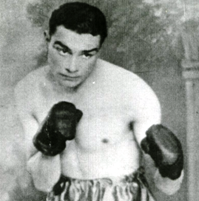 |
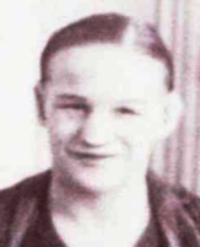 |
 |
 |
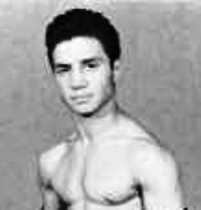 |
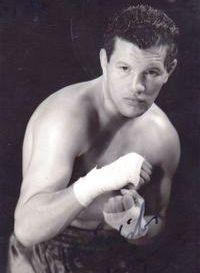 |
 |
 |
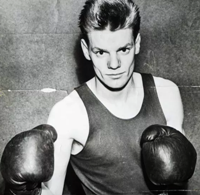 |
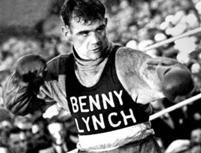 |
 |
 |
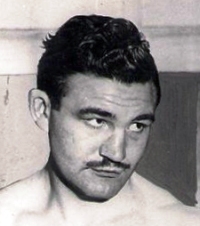 |
Despite what must have been the hard life of a professional boxer and unlike many of today’s sporting heroes, none of them retired with a vast fortune. I only hope that they enjoyed the satisfaction of brightening up so many lives at a difficult time in our Nation’s history.
|
|
When researching my previous story on the Mona Lifeboat disaster, I learned that the craft was not ‘self-righting’ – meaning that if it capsized it would not automatically right itself. This caught my interest…
Why do boats not sink? Archimedes gets credit for explaining this:
Imagine you’re sitting in a rowboat on a perfectly calm lake. Part of the boat will be below water level and part above. Gravity, of course, is trying to pull the boat and you down but something is pushing up to prevent this - we call it buoyancy.
There’s an old joke about owning a boat, “a boat is a hole in the water that you fill up with money.” We can think of our rowboat as, indeed, creating a hole in the water. To make this hole the boat has to push some of the water aside (known as hull displacement). Archimedes experimented and found out that the weight of the water pushed aside is always exactly equal to the weight of you and the boat. So, as the water tries to flow back to fill the hole it exerts an upward force that just matches the weight - and the boat floats.
As you add more weight to the boat - passengers, fishing tackle, sandwiches, beer, the process continues - more water pushed aside adding an equal upward force and everything is fine – until you overload the boat, the water creeps over the side.
Bodies of water are never really perfectly calm and sometimes there are huge waves to contend with. If a boat is caught in a storm it may end up beam-on to the waves (parallel to the waves) and this can lead to a capsize – as is believed to be the case with the Mona.
From the mid 18th century people who wanted to be able to go to sea in bad weather in small boats – mostly smugglers as it happens - put a lot of time and energy into creating ‘unsinkable’ craft. They were quite successful using cork and air container inserts inside and high up below the bulwarks.
With the advent of lifeboats, a hundred years later, the search began for a self-righting capability, and again there was progress (mostly modifications of the approaches above), but not perfection.
Another method developed uses inflatable bags mounted high in the boat that automatically inflate, using CO2, when the boat is upside down. Such a ‘balloon’ has very little weight but presents a large surface area for the upward pressure of the water to work on.
The RNLI (Royal National Lifeboat Institution) fleet of over 400 lifeboats has two main types of boat:
1) All-weather lifeboats (ALBs) which are capable of high speed and can be operated safely in all weather conditions.
2) Inshore lifeboats (ILBs) which usually operate closer to shore, in shallower water, near cliffs, rocks and even in caves.
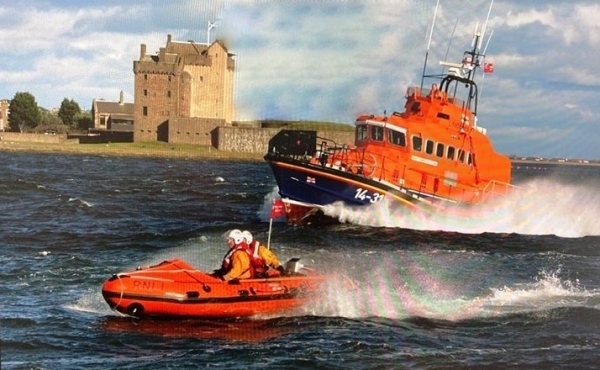 |
| The current Broughty Ferry lifeboats - the ALB following the ILB. |
All are self-righting. The ILBs rely on the single-use, inflatable bag method actuated by the crew. The ALBs have a much more complete solution. In my musings I imagine some naval architect some sixty or more years ago saying, “so, to pull the boat upright, we need to put the heavy stuff, like the engines, as low as possible to pull the bottom of the boat down, and a big space high up in the boat that the water can’t get into, like a balloon, to pull the top of the boat up...” then “wait a minute, nowadays we have watertight door technology, unbreakable windows – we can make the whole wheelhouse into a bubble!”
(Note: The term wheelhouse means not only the place where the pilot sits, but includes all of the other parts of the superstructure including the space for the crew, for the people who are rescued, for the engines, for storage of gear etc.)
Of course, for daily operations they need ports to let outside air into the superstructure so that people, and the engines, can breathe, and these would have to automatically close on capsize, then re-open - the engines would have to change to idle, and the radar antenna would have to stop rotating, then start again. These and other issues were overcome, and the RNLI were able to decree that all of their ALBs would, in future (from 1980 forward), be able to self-right in no more than 10 seconds!
The change in design is starkly depicted when comparing the Mona to the current Broughty Ferry ALB below. If you're interested in seeing self-righting in action click here.
|
|
 |
 |
British National
Service in the 1950s
Part Two
Brian Macdonald |
 |
 |
The British army in the 1950s had a number of large establishments dotted around Britain. Local regiments had their own regimental barracks and did their own basic training, but the various services corps and general regiments drew from the main intake. I was a regular recruit, not a national serviceman but the initial stages of military life were the same. After St Andrews University and I mutually decided we should part at that stage of my life, I enlisted as a regular soldier, knowing that my call-up papers were not far off and being inclined to the military life. I already had five years of Morgan Academy army cadets and one of the university’s territorial army unit under my blancoed and brassoed belt.
I chose to join the Royal Corps of Signals and was sent, for basic training, with a group of fellow-recruits, mostly conscripts, to a 19th century barracks building of the Green Howards(1) light infantry regiment, on a hillside in the historic Yorkshire town of Richmond(2). At this initial stage, young men from all over UK and from different social strata were flung together and sometimes enduring friendships sprang from this time of their lives.
From the basic stage, I was selected as a potential officer and went on to a pre-officer cadet unit in the nearby huge Catterick Camp garrison, where the Royal Signals have a major presence. This barracks was of 20th century construction and more comfortable (The bare floorboards did not have wide cracks, nor were there dried-out sash window frames that refused to open but nevertheless permitted strong, cold drafts like the Richmond barracks windows), though far from luxurious, with basic toilet facilities and the ubiquitous communal showers and washbasins. Here, hopefuls were assessed and culled and those progressing were tutored in aspects of military training that would improve their chances of passing WOSB(3) and progressing to the short-term officer initial training school at Mons barracks in the English town of Aldershot(4) in Hampshire. Although my army career took a different trajectory from the average other-rank recruit, I know the basic training process well enough and, later, I served as a platoon officer in a unit that trained truck drivers for the then Royal Army Service Corps.
After conscripts and regular recruits alike had been knocked into the basic shape of soldiers over a six-week period and taught how to look reasonably military and well turned-out in ill-fitting khaki clothing, they were ready to be moved on from basic training. With a need for infantry as well as cooks, drivers, vehicle mechanics, engineers, electricians and medical orderlies, there was a range of training establishments. Conscripts were given no choice; they went where they were needed. There is many a tale of a motor mechanic in civilian life being posted as a cook. Regular recruits had given a wish-list when they joined up and, as far as it suited the army’s personnel needs, these wishes were respected and new career soldiers went on to learn their chosen trade and serve in the regiment or service area of their choice.
This, then, was what the vast majority of young British men experienced when the dreaded call-up papers appeared in the mail. Although many spent their whole service time somewhere in Britain, counting the days down till demobilisation, there were overseas postings that were prized. Britain, as a member state of NATO(5), provided at the end of WWII a force, the BAOR(6), to serve in Western Germany, first to help in the control and re-building of a conquered and devastated land and later as a bulwark against the USSR(7) and postings to BAOR were valued. Hong Kong and Singapore also harboured British garrisons and those who were posted there or to Malaya(8) will recall shouts in the mess hall of “Get yer knees brown!” from troops who had been for some time in these tropical locations to new arrivals, as baggy uniform shorts were worn in those locations and new boys were easily spotted. Another common cry in the mess hall was “Two days to go!” from those about to end their service.
A key to enjoying national service in peacetime was to boast a measure of sporting prowess. All the major sports were played competitively in an organisation of young men and those who shone at a sport often found themselves in a sinecure posting, as commanding officers competed for the pre-eminence of their units in sport and collected good players for their unit teams. I served in a unit which had a big throughput of national servicemen and the colonel collected boxers and tucked them into permanent staff jobs. He collected so assiduously that some went on to become champions professionally and our unit team won the Army Boxing Championships one year, to his great satisfaction and kudos and the enjoyment of the whole unit, for it was obligatory to attend the rounds of the tournament when they were held at our establishment. As a training unit, the excuse of driver training was used to ferry truckloads of soldiers to other establishments to provide vocal support for our team in away rounds.
The other side of this sporting coin was that a club-level player often found himself playing for his unit team against an international star or other luminary of some major sport who was well above his level. My own best-remembered incident of this was watching my unit team playing a rugby match against another unit team, that had at scrum-half the then reigning English rugby league half-back, the great Alex Murphy, who was serving his two years in the Army Pay Corps.
So the two years passed, some parading and marching, some military training and field exercises, some real guerrilla war in Africa, Cyprus and the Malay peninsula, some leisure, some fun, until the day came when you took off the khaki for the last time, your two years compulsory national service done, and returned, gratefully, maybe fitter, maybe wiser and more mature, certainly two years older, to your civilian life and ready for the next phase. One more life-ladder climbed, another yet to conquer.
For a smile and a jog of the memory to any who went through the national service mill, I commend to you ‘The Talkin’ Army Blues’(9) by the late Scottish folk singer, Josh MacRae. I think you will enjoy it.
Footnotes
(1) The Green Howards light infantry regiment, more properly Alexandra, Princess of Wales's Own Yorkshire Regiment, was one of several light infantry regiments in the British Army. Some light infantry regiments wore dark green uniforms. They did not have heavier weapons like other infantry and were used when there was a need for fast-moving infantry that could march into battle for guerrilla attacks and skirmishes. The traditional light infantry marching pace is faster than the standard and the troops were usually smaller, nimbler men. Scottish readers may remember the Highland Light Infantry, which recruited in the Glasgow area and had a fearsome reputation in battle.
(2) Richmond is a historic town in northern Yorkshire. It is the nearest town to the huge military garrison of Catterick Camp.
‘The Lass of Richmond Hill’ is a popular English folksong written in the 18th century, with a rousing tune. It honours a young lady of this town, not the better-known Richmond in the outer London area where the famous Hampton Court Palace is located.
(3) War Office Selection Board (WOSB, pron. was-bee) was set up during WWII to vet and select candidates for training for commissioned officer rank, initially to overcome a shortage of leaders in wartime and later for the granting of national service and short-term commissions (aka ‘temporary gentlemen’). Refined over the years, by my time (1957) it consisted of a three day intensive selection process that incorporated written tests, psychological interviews, mental and physical tests and group challenges. It was conducted at an establishment near Andover, a pleasant town in Hampshire in SE England. The accommodation standard was high, with silver settings and good glassware at meals and individual bedrooms. Doubtless there was an element of vetting about this aspect of the candidate’s suitability to fit in, in an officers’ mess environment.
(4) Aldershot in Hampshire is a town with a large army garrison, having a number of different barracks located in it and extensive training areas nearby. At one time it was the largest military garrison in UK. There are other towns with military establishments in the general area. In my time, many of the barracks were of 19th century construction and quite primitive. An extensive reconstruction program was undertaken during the 1960s.
(5) The North Atlantic Treaty Organisation (NATO) was set up by the UK, USA, Canada and the Western European countries after WWII to provide a military bulwark against the USSR9, which controlled Eastern Europe and much of Asia and harboured empire-building ambitions, with covetous eyes cast from the German Democratic Republic (the former USSR-ruled East Germany) on Western Germany and other countries which bordered its client states.
(6) The British Army of the Rhine (BAOR) was the force provided by Britain initially to aid in the control of post-war Germany and later as a component of NATO’s forces in Europe, part of the bulwark of Western Europe against the perceived threat of invasion by the USSR7, whose rulers cherished the memory of past Russian imperial glory and had ambitions to relive it
(7) The Union of Soviet Socialist Republics (USSR) was the name given by Russia to the conglomeration of Eastern European and Asian states over which it ruled from its conquest of them in and after the last stages of WWII in 1945 until it began to break up in1989, heralded by the literal crumbling of the Berlin Wall.
(8) Prior to the founding of the Malaysian Federation in 1963, the Federation of Malaya endured a bitter guerrilla war against communist insurgents, known as the Malayan Emergency, with the significant aid of a British force. This was not a highly favoured posting for British conscripts. The new federation of 1963 included Singapore, Borneo, and Sarawak in addition to the original British Malay states. In 1965 Singapore became an independent country and has remained so.
(9) ‘The Talkin’ Army Blues’, written and sung by Josh MacRae, can be found here.
|
|
So, what did happen to the Mona that December morning in 1959? No one can know for sure, but the Royal National Lifeboat Institution did carry out a full investigation and issued a final report.
The report said that the boat was in good condition, there were no structural defects, no decay, and no leaks in the hull. Furthermore, it stated that the coxswain, Ronald Grant, was very highly thought of and possessed the full confidence of the life-boat crew and of the Institution.
The report further noted that the evidence of oil marks on the engine room deckhead and bilge dirt on the cabin deckhead indicated that the boat undoubtedly capsized…
The summary stated:
" It is clear from internal evidence that the life-boat capsized. The capsize was almost certainly caused by the life-boat being thrown off course and across the sea some time between 05.15 and 06.00 in the morning. The life-boat was probably in the shallow water just to the south of the entrance to the River Tay at the time. The life-boat then appears to have drifted bottom up in a north-westerly direction until her signal mast touched bottom in the shallow water between Buddon Ness and Carnoustie. This had the effect of righting the boat.”
So, the crew performed well, and the boat had no defects (but it wasn’t self-righting - more on this later)…
The Mona, 49’6” in length, was a Watson class, built in 1935 - there were 19 Watsons built, and the other 18 had no history of serious problems.
The little town (population probably around 12,000 then) was devastated by the news.
A service was held at St James’ Church, the Fisherman’s Kirk, across the street from the lifeboat station. The Church only seats 450 and the service was relayed to another 300 in the church Hall and to hundreds who stood in Fort Street on a cold windy, wet forenoon. People started to queue outside the church doors an hour
| East and west sides of Fort Street. The lifeboat station is seen at the far end. The buildings to the left are the Fisherman's Tavern Hotel (a pub where, over the years, I have spent many happy hours). The kirk is across the street from the Fisherman's. |
before the service began, but few of them were able to get in. In the few days thereafter seven funeral services were held attended by hundreds. A national appeal to help the bereaved families raised £77,000 in a few weeks.
The Mona was quickly replaced by another lifeboat, the City of Bradford II, another Watson class. Then the RNLI had to decide what to do with the gallant Mona – she had served faithfully up to the last, and during her years of service at Broughty Fery was credited with saving 118 lives. Though still seaworthy after the disaster, it was decided that lifeboatmen should not be asked to serve on a boat that had such a tragic history.
The Mona was taken secretly to the Forth estuary and beached at Cockenzie, near Edinburgh. All fittings were stripped, and, at 4:30 in the morning, the boat was set on fire. People who lived in a tenement less than 100 yards away wakened the next morning to see the smoking ruin on the rocky beach.
| Photo on left shows a magnificent model of the lifeboat as she looked on launching in 1935 - taken at the 60th memorial service - first two rows occupied by the current crew. On the right, the remains of the Mona the morning after burning. |
The RNLI advertised for volunteers to serve as crew on the new lifeboat and no fewer than 38 applications were received – a special breed!
To be continued...
|
|
Very soon after we were told of the upcoming operation to take over the Suez Canal, we received several bulky packages from 3rd Infantry Div. headquarters in Tripoli, each marked “SECRET. OPEN UNDER AUTHORIZATION ONLY.” I didn’t see all the stuff, but much of it came sifting over our desks in our nice snug I-Section room, which was housed in a building which had formed part of officers’ quarters in the old Italian barracks we now occupied
Much of the material comprised maps of the Suez Canal showing the exact location of Egyptian Army positions all down both sides of the Canal: heavy weapons (like 155 mm howitzers and field artillery) army fortifications and strong points, machine gun positions, troop barracks, mechanized units, and any known armoured vehicles.
We (and the other regiments which formed 3rd Inf. Div.) began to build up a very comprehensive picture of Egyptian Army forces and capabilities in the area, and what we did not know or were unsure about, we set about learning. This was done in two ways.
One was through the use of paid informers within the Egyptian Army forces (usually locals who were pressed into service within the camps, in cookhouses, or as cleaners or merchants to provide the Egyptian Army with food and other services).
The other way was by stealth. S.A.S. or other units like the Royal Marine Commandos, were sent in covertly, usually as 2-man teams, to photograph, measure and check on all the weaponry and fortifications and armed Egyptian personnel our forces would be likely to face. This information then came feeding back to all the Intel units within the Division.
In our own Intel Section, we updated the information and maps we already had on the so-called “masters.” These were the master maps of the area which, when Operation Rodeo Flail went active, would be copied by us (and all the other Intel units in the rest of 3rd Infantry Div.) to be given to all the field officers just before they were to go into action.
As you may know, each field officer is equipped with a map case and a map of the area in which his unit is operating. Fitted over the topographical map is a clear acetate overlay, on which Intel has entered all the Blue (friendly) Forces’ positions plus the Red (enemy) Forces known positions.
Special icons and Code names also appear on this overlay “talc” as it’s called, identifying mechanized forces, and heavy weaponry. Last but not least these overlays also include the F.U.P. (Forming Up Point) for troop assembly before advance, plus the expected L.O.A. or Line Of Advance.
All this was pretty fascinating stuff for us all in I-Section, and I can remember that even Sgt. Krywald, our Polish-born and highly temperamental non-commissioned leader, became quite sober, grim, and taciturn when checking on our work. I suppose he could see clearly that this was no fun peace-time exercise that would be quickly forgotten. This was planning for the invasion of Egyptian sovereign territory by force of arms, a bloody business at the best of times.
What was truly fascinating was –even to our unsophisticated eyes– we were helping put together a very detailed picture of the Canal Zone defences, a picture that left very little to chance. To me, it was a fascinating look into how a modern army prepares itself before going into battle.
We knew the size, range, and field of fire for every heavy weapon the Egyptians had all down the Canal, including precisely how much ammunition they had for each gun. We knew how many personnel each gun had to operate it, plus where the gun crew slept and ate– and how well, or badly, the weapon was guarded. We knew exactly where their transport vehicles were parked, so they could be disabled with a single artillery burst or by an aerial bomb.
I’m sure the British Army had been collecting all this military Intel for years, but when it was all put together it was quite remarkable how great an advantage an attacker would have, knowing all this detailed information in advance. However, it all seemed to be so much treading of water. We kept getting more intel and we kept updating the master maps– but nothing happened.
Until one bright morning.
|
|
I was not living in Dundee when the North Carr Lightship was almost lost (having moved to London, England, the previous year), and I don’t believe I even heard of the incident at that time.
When the ship broke free from its main anchor, the Fifeness Coastguard Station (on shore less than 2 miles away) spotted that it was moving off station and notified the Lifeboat Service.
(As a maritime nation with some 20,000 miles of coastline and lots of opportunities for mariners to get into trouble, the government created the RNLI (Royal National Lifeboat Institution) in 1834. Today, this charity maintains 238 lifeboat stations around the British Isles, has over 5,600 crew members, mostly volunteers, and more than 3,700 shore crew around 12% of whom are women.)
Neither the Anstruther nor the Arbroath Lifeboat Stations could launch due to a combination of low tide and the fierce south easterly gale. However, the Broughty Ferry Station could launch in any tide (Broughty Ferry is a suburb of Dundee about four miles east of the town centre, and being on the estuary, rather than the North Sea itself, was slightly less affected by the storm).
At 2.42 am on Dec 8, 1959, the acting secretary of the Broughty Ferry lifeboat received the message that the North Carr lightship had broken loose and was drifting in a north westerly direction. He authorised the launching of the lifeboat, the Mona, by telephoning the coxswain and the lifeboat mechanic. They in turn notified the other volunteers by telephone or, in one case by walking about 100 yards, and knocking on his door…
They also fired the maroons (like firework rockets on steroids). About a foot long, two of them soar across the sky and explode with a very loud noise and an extremely bright flash of light. This summons the crew, lets the town know that the lifeboat is going out, and if those in peril are close enough, assures them that they have been spotted, and help is on the way.
The Mona had a crew of eight: Ronald Grant, George Smith, Alexander Gall, John Grieve, his son John T Grieve, George Watson, James Ferrier, and David Anderson. All volunteers, there were three who worked
in the Caledon Shipyard in Dundee, a mechanic, a self-employed contractor, a plumber, a boatman at Dundee Harbour, and one who worked for a marine engineering firm.
Under the direction of the Chief Launcher, the Mona was safely underway by 3:13 am and set off down the
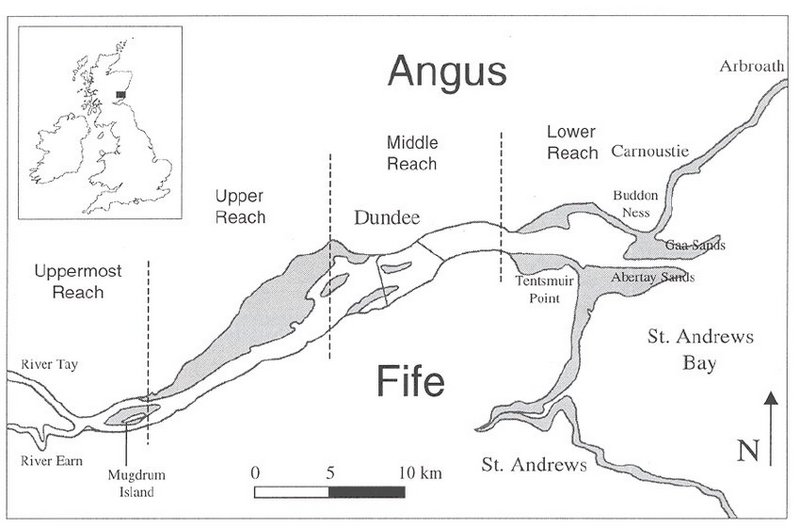 |
Firth of Tay, where the river debouches into the North Sea. The shaded areas show
land which is visible at low tide and presents either as beaches or as sandbars. |
estuary into increasingly large waves Much of the following comes from the official report of the events of that day and from published research by Iain T McIntosh:
The weather was overcast with frequent fierce rain squalls. The wind was from the south-east, force 7 to 9, with a very rough sea and a heavy swell. Visibility varied from 2 to 6 miles. Low water neap tide was at 02.52.
The two middle buoys marking the bar at the entrance of the river had been absent from their normal positions since the 20th of November. It is almost certain that the Fairway buoy, the most seaward lightbuoy, was extinguished and adrift from its position at this time.
The Mona sent her first R/T message to the Fife Ness Coastguard at 03.20 and made her way down river at 6 knots. They tried to call the North Carr Lightvessel but without success. The North Carr was also sending up rockets at regular intervals to give her position.
At around 04.00 the senior coastguard at Carnoustie, David Mearns, caught his first sight of the Mona as she cleared Buddon Ness, he reported later that she appeared to have reduced speed and was constantly disappearing in the mountainous seas. He watched as she crossed the bar of the Tay.
At 04.06 the Mona reported that she was abeam of the Abertay Lightship. The North Carr fired another distress rocket at 04.25 and the Fifeness coastguard asked Mona if she had seen it. The Mona radio operator only managed to gasp out “No…our position…. We have just passed the middle buoys on the Bar and we are just hanging on.” Coastguard David Mearns saw the Mona turn south into St Andrews Bay at about 04.45.
At 04.48 the Fifeness coastguard told the lifeboat that the North Carr had sent up a red rocket and they asked
if the Mona had seen it. The Mona reported “Yes, we saw that one. We have just cleared the bar.” That was the last message heard from the Mona.
The Fifeness coastguard saw the Mona’s masthead light in St Andrew’s Bay at 05.39, they were unable to estimate how far away the Mona was, they radioed the lightship to see if they could see the lifeboat, the reply was “Yes, I think it is the lifeboat, will burn another flare.”
Fifeness coastguard sent a signal to the Mona on the distress frequency asking the Mona if their receiver was working, and to fire rockets and flash their searchlight up into the sky. There was no response, and the masthead lights disappeared a few minutes later.
At first light about 08.30 a search was organised by the
| |
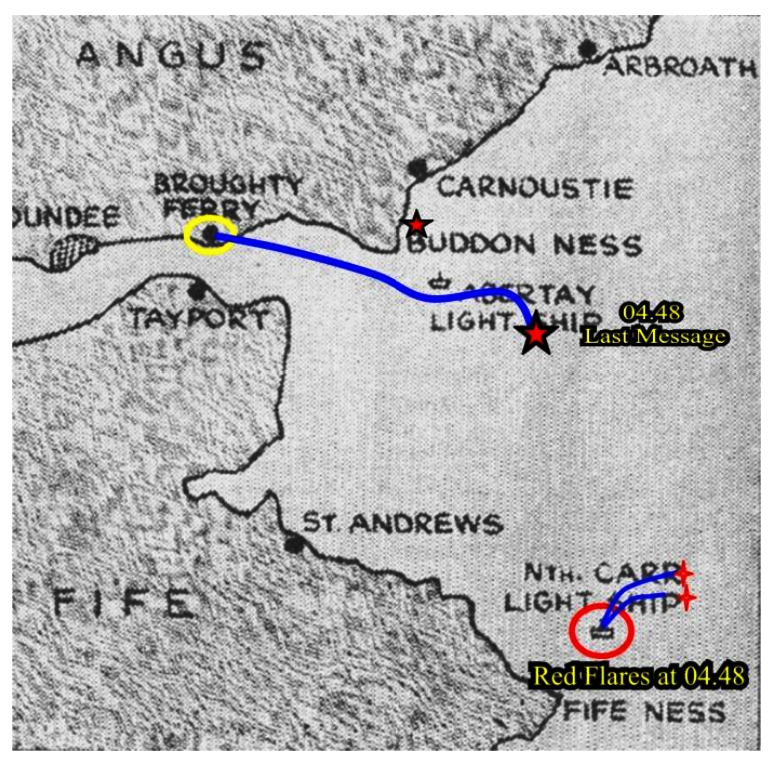 |
coastguards in which a shore party and a helicopter took part. Mr William C. Philip, a barman of the Carnoustie Station Hotel, was the first person to reach the scene of the disaster. He usually went for a walk on the beach first thing every morning and spotted a boat in the distance bobbing in the water. At first, he thought it was a ship’s small boat that had come in with the storm. When he reached the boat, he shouted to see if there was anyone there, but with no response. He stayed around for a while, and when he started to walk back, he saw a man’s body floating in the surf.
Mr. Philip tried to pull him in, but the body was too heavy. Just then Coastguard John Hamilton came along the beach and together they pulled the body up onto the sands. It turned out to be the youngest member of the Mona’s crew, John T. Grieve.
John Hamilton was a Corporation employee, who was also a relief coastguard. When the rocket went off, he left his municipal job and hurried to the coastguard station. He actually took part in both the beginning and the end of the Mona’s disastrous trip. He had been on coastguard duty from 2 am to 8 am that morning (Dec 8th) and he had received the message at 02:45 am from the coastguard at Fifeness that the North Carr Lightship had broken adrift. He had called senior Coastguard David Mearns and the message was relayed to Broughty Ferry to call out the Lifeboat. Shortly after Mr. Hamilton had returned to his job as a Burgh Labourer in Carnoustie he heard the maroon being fired from Westhaven. A message on the pad at the Coastguard station told him the Mona had been driven ashore at Buddon.
When the live-saving apparatus crew with breeches buoy equipment arrived, Mr. Hamilton was sent to telephone the police. The Carnoustie Coastguard Station officer was the first person to board the lifeboat. This was about 09.20. He found five bodies all wearing lifejackets.
Half a mile to the southward of the lifeboat was found the body of ex-coxswain Alexander Gall. Near it was the lifejacket of George Watson along with the broken foremast of the lifeboat. The police walking to the scene found the body of the seventh member of the crew on the beach at South Flat, about half a mile from where the Mona had gone aground.
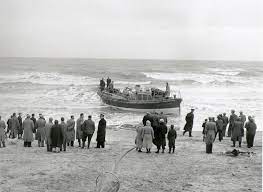 |
The Morning After - The Mona, Beached, North of Buddon Ness.
Note both fore and aft masts are missing. |
All seven men died from drowning; they suffered no injuries apart from abrasions. The seven bodies were taken to the police mortuary at Carnoustie. The eighth (the body of George Watson) was never found.
To be continued...
|
Saturday forenoon was when my mother dragged me into Dundee City Centre to go round the shops. This was a regular occurrence for the first decade of my life. I do not recall these outings with any great amount of pleasure. I didn’t understand their purpose as it was only rarely that she bought anything. Occasionally there was some activity that I did enjoy. I liked the Students’ Charity Parade. I liked seeing the Spitfire that was parked in the City Square as part of a fundraising project. I enjoyed anything out of the usual that distracted my Mum from the relentless trek round the shops. I now understand that this was an important social activity for her. Being part of the hustle and bustle was an opportunity to dress up and sometimes casually meet her friends and acquaintances.
At some point of the morning we would visit at least two of the “Big Five.” I refer to the five major department stores that graced Dundee City Centre from Victorian times into at least the 1960s. They were D. M. Brown, located opposite G. L Wilson on the northern corner of Commercial Street and Murraygate, while on the southern corner Smith Brothers could be found. Further to the west on the corner of Whitehall Street and Nethergate Draffens ruled in solitary splendour. Almost hidden on the east side of Reform Street the smallest of the five was Cairds. They all sold a similar range of goods, but each had its own specialities, style, and ambience. Social standing could be assessed by who regularly shopped where and whether or not one paid cash or put purchases on one’s account.
Without doubt the magnet for the posh and those who aspired to be posh folks was Draffens. Rather like
Captain Peacock in Are You Being Served? the Buyer in charge of each department would ensure that favoured customers were recognised and properly attended to. The store had a well patronised coffee shop that served silver service coffee with choice of white or brown sugar. It had a restaurant that served lunch and afternoon tea and was the place to go for fine fabrics. My mother only rarely ventured into Draffens and then only if she was looking for a specific item. I understand that the only Draffens now left in Dundee is a cocktail bar in Coutties Wynd.
| |
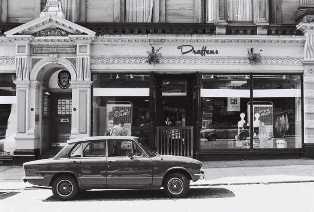 |
My experience of Cairds was largely as a result of my joining the Scouts. Cairds was the approved
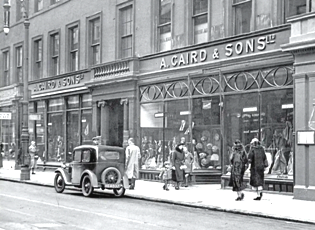 |
 |
retailer for Scout uniforms and accessories. It was there that I bought my first woggle, neckerchief, hat, and staff. Gents outfitting and school uniform was also a major part of their business. I vaguely remember there being an upmarket toy department that I liked to visit because it sold Mamod model steam engines etc. Cairds also was only rarely visited by my mother.
We always went into D M Brown’s. This was where my mother felt at home, and this was where she purchased soft furnishings, kitchenware, and bedding. Many of these purchases were made when DMs had its Summer or New Year Sales. These were big events with advertisements
|
plastered over the Courier weeks in advance. Each
department had its sale goods piled high on the counters. My father and I had our shirts and underwear bought in the DM’s sale and my mother tried to zone in on items that she had seen during her weekly visits rather than the items that had been brought in specifically for the sale. The store had a broad range of departments but was rather more impersonal than Draffens or Cairds, there was more attempts to sell the goods and it gave the impression of being the “People’s” store
G L Wilson was another of my mother’s favourite stores. In many respects it fitted neatly into the social space left
| |
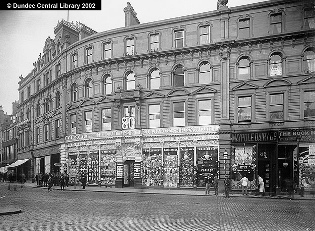 |
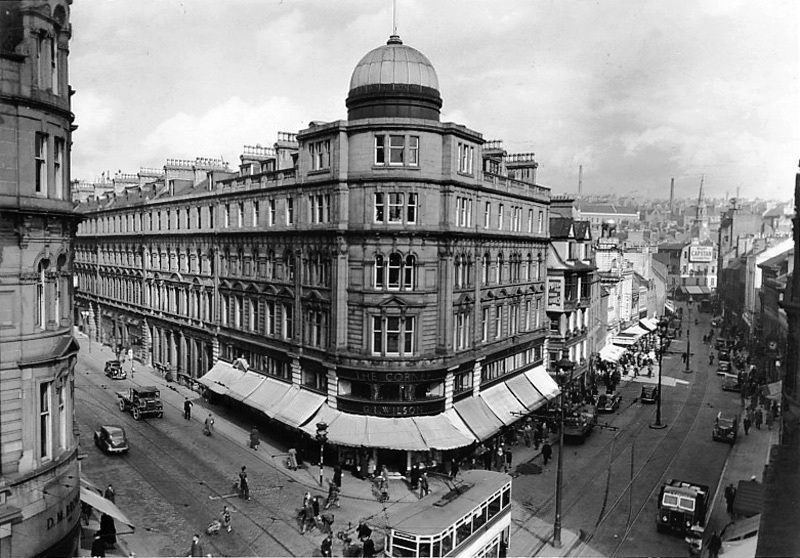 |
 |
between Draffens and D M Brown. In my era it was the only one of the five that was still owned and operated by the founding family. Sir Garnet Wilson was the very active Lord Provost of Dundee during and immediately after WW2. His brother John was also active in the business and was often seen on the shop floor, recognisable by the carnation he wore on his lapel. As a child I loved going to G L Wilson’s because it had a lift with a lift attendant who was always very chatty to the children. I learned later that as a company policy and whenever possible the lift attendants and the boys that helped around the store were injured WW1 veterans or youngsters with
|
learning difficulties.
The highlight of G L Wilson’s year as far as I was concerned was the Christmas Grotto and my annual meeting with Santa. I do not have a clear recollection of what this store actually sold, but I think that it was primarily a draper with some more specialised range of clothing, particularly for ladies, added on.
The first four stores were definitely Dundee enterprises
| |
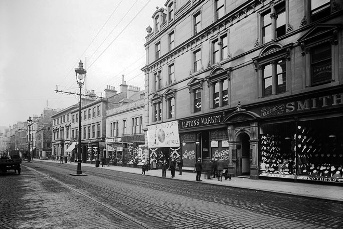 |
and developed from small family firms. The final member of the big five was an English institution that spread into various parts of the UK. I don’t think that my mother was terribly fond of Smith Brothers, and we rarely ventured inside for a look round. What I do remember is that when my mother was doing any kind of dressmaking she went there for material, patterns, thread, and buttons. I seem to recall that the store had quite a sizeable furniture department and that they sold clothing. As the store occupied a prime city centre position for so many years it must have been a popular outlet for some but clearly not for us!
To the best of my knowledge all of the buildings are still standing and are currently in use. The interiors have been refurbished and been put to a different use. The exteriors have largely been restored to their former glory but where have all the crowds that used to congregate in Dundee City Centre gone? Are they at out-of-town shopping centres or are the hunched over a computer buying on-line? On thing is sure, they aren’t going into department stores, nor are they likely to!
|
|
The North Sea is the northeastern arm of the Atlantic Ocean between the British Isles and the mainland of Europe and is known as one of the most treacherous seas in the world for ships to navigate. It’s often rough,
stormy, or covered by thick fogs, and is shallow, and laced by swift, tangled currents. Its fishing grounds are probably the richest that have ever existed, and more than a quarter of a million ships use the North Sea annually.
Any ships heading for the Firth of Forth, if coming from the north, have to steer well clear of the North Carr Rock before turning west into the mouth of the River Forth. Numerous ships have died on these rocks over
the centuries, and, in the early 19th century, after sixteen ships were lost between 1800 and 1809, the government decided that something had to be done. This resulted, eventually, in a lightship being positioned there.
The photo shows the third of these ships the North Carr Lightship III (1933 to 1975) on station, (it now sits
at its final resting place in Dundee harbour, waiting to be scrapped.) You can tell from the photo, why they call it a lightship – not so obvious is the fact that such ships don’t have propulsion engines, they simply get towed to their station and anchored there. They function like lighted buoys, or lighthouses (with foghorns).
The North Carr was manned by a crew of seven, and on 8 December 1959 a full gale was blowing, and the lightship was rolling and pitching heavily.
| |
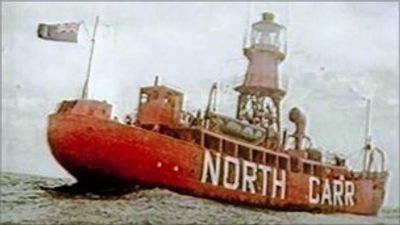
|
Suddenly, the moorings gave way, the anchor was lost, and the ship began to drift north-westerly towards the shore. The crew behaved heroically, and after sending out a distress call, set to work to deploy one of their two spare anchors. They were successful, but soon thereafter the gale was so strong that the mooring line parted again; they finally managed to deploy the second spare anchor so as to hold the ship some 900 yards off the rocky shore at Kingsbarns, near St Andrews.
The ship and crew were still in serious danger, and an attempt was made to tow the ship to safety. This failed, and the decision was made to evacuate the men by helicopter. The rescue would have to be made in extremely adverse conditions. A full gale was blowing, and the Lightship was rolling and pitching heavily.
To assist in the rescue operations the Lightship crew cut away the 40ft aftermast, which allowed the helicopters, two Bristol Sycamores from RAF Leuchars, to fly as low as 5ft above the lantern and pick up all
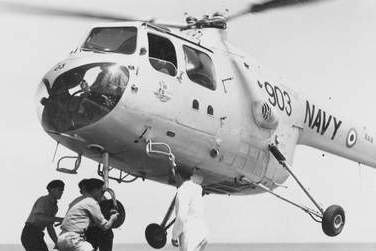 |
|
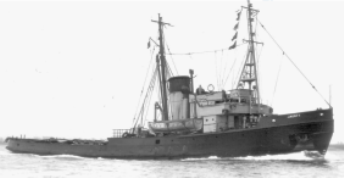 |
| The Bristol Sycamore |
|
The Earner was an Assurance Class sea-going tug identical to the HMRT Jaunty shown here. |
seven members of the crew from the chart house roof. The Lightvessel was eventually taken in tow by the Admiralty tug "Earner" on 11 December, repaired at Leith, and put back on station on 16 March 1960.
Brave men all – but not unique. There were others on that December night more than sixty years ago…
To be continued...
|
|
 |
 |
British National
Service in the 1950s
Part One
Brian Macdonald |
 |
 |
In 1949 the British government had a military commitment to the North Atlantic Treaty Organisation (NATO) and the need to fight fires in other parts of Great Britain’s crumbling empire that could not be met by the regular armed forces. The answer was to enact compulsory universal male national military service legislation. From then until 1960, all able-bodied British males between eighteen and thirty years of age were obliged to complete two years of service in one of the armed services. The last few of two million conscripts gratefully threw off their battledress in 1963. So my contemporaries and I were subjected to the delights of non-voluntary military service.
Exemption could be obtained on grounds of conscientious objection to serving in a military force or for compassionate reasons. National service could be deferred until a university or other post-secondary education was completed, but it was a deferral, not an exemption and many a highly-qualified young man found himself marching up and down on a wet and windy parade ground at the mercy of the eagle eye and sharp tongue of a zealous drill sergeant whose sole aim in life was to achieve total uniformity of movement from a group of disparate individuals or crawling about in long, wet grass, at night, encumbered with rifle, ammunition pouches and small backpack and wondering why his talents and expensive education were not being made better use of. Some professional qualifications were taken appropriate advantage of, and the forces benefitted from the work of doctors, dentists and teachers who were, sometimes grudgingly, giving their service to their country. But many with technical qualifications were not properly used and saw national service as two years lost out of their lives and a hiatus in their careers.
National service was not universally welcomed by those who underwent it. My own military experience was with the British Army, and I assume the RAF and the Royal Navy did things similarly in the early stages, when the service was trying to achieve obedience, conformity and a standard of cleanliness and self-discipline that may not have been highly regarded aspects of life till then. Most conscripts saw it as an unwelcome intrusion into their lives and few looked forward to the high degree of regimentation and restrictions on personal freedom and activities to which they knew they would be subjected.
Older generations of men, who had lived through WWI or WWII as adults, often expressed the thought that national service would ‘make a man ‘ of someone, especially of a youth who was out of control or who needed ‘toughening up’ and maybe it did for some. But in others it bred an increase in a pre-existing hatred of authority and the two years were spent in resentment and silent disobedience. It was not unknown for magistrates to offer young offenders who were out of work the choice of a gaol term or of signing up to military service. While this may have been a useful recruiting tool, it did nothing to improve the overall quality of recruits.
For many, the enforcement of the sometimes ridiculously high military standards of presentation of dress and equipment and ‘spit and polish’ came as a shock. The short back and sides military haircut and the blouse
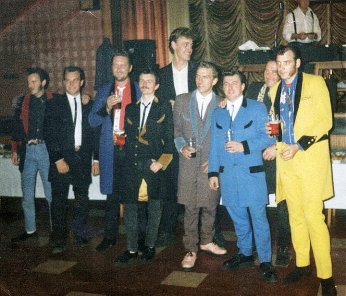 |
|
 |
| Teddy Boys before ... |
|
... and after |
battledress were unwelcome changes of style for many in an era of Teddy Boys and DA(1) hairstyles. Having to sleep and relax in a large, spartan room with a number of other men was very different to their former lives. The constant polishing of unending items of brass, ironing of clothing to achieve razor-sharp creases and the detested ‘bulling’(2) of boots were tasks few young males had encountered before. Jumping out of bed without hesitation at an early hour every day and queueing with mug, knife, fork, and spoon for breakfast were more unfamiliar routines. The scrupulous cleaning of the barrack rooms and the laborious polishing of floors were new and unwelcome jobs.
A much more active life, which included physical training, often in inclement weather and trotting long distances on boot-shod feet, loaded down with equipment and weapons, wearing uncomfortable, heavy, uniform clothing, and the torturous and usually wet, muddy assault course were a major shock to unaccustomed minds and muscles. Marching in formation with a highly stylised rhythm and stride, the stamping of boots in unison and the maintaining of ruler-straight lines and ramrod posture while doing so was quite alien to all in civilian life. There were some, fortunately for the blood pressure of drill instructors, a very few, who never mastered the strictly timed and obscure movements of rifle drill, at which all were obliged to become proficient, regardless of their future service direction.
A national serviceman’s pay was a pittance, far less than even a modest civilian wage. In my time it was twenty-five shillings a week, barely enough to buy the essential materials needed to present the high standard of polished and pressed uniformity of dress demanded and buy a cup of tea and a bun or a beer in the NAAFI(3) of an evening. If you smoked cigarettes as well, which many did then, the pay was inadequate. Married servicemen got a little more but not enough to support a wife and maybe a child who were back at home. Pay was delivered in cash, weekly, from an officer seated at a table, with much saluting and boot-stamping.
Enlisting as a regular soldier was available as an alternative to being called up but it was an option that most shunned, the minimum term a young man could sign up for being three years instead of the two of national service. ‘Regulars’ were paid about fifty per cent more than conscripts. In the period of which I write, the military had a need for infantry, truck drivers, labourers and other unskilled workers that could not be met by volunteers. Britain’s educational standards were not universally high in the post-war years so there was a good supply of suitable candidates and an inadequate supply of civilian jobs.
First came the initial shock of the raw recruits being shouted at, marshalled into squads, loaded like camels with clothes and baffling military equipment, shepherded into the barracks – their home for the foreseeable future – taught how to make up a bed with the coarse blankets provided and how to fold them just so in the approved style to avoid the wrath of their superiors. Most learned to deal with this new and strange environment. The initial few weeks kept us confined to the barracks, learning the rudiments of military behaviour and getting fitter, thanks to the constant physical exercise and sound, if uninspired nutrition. Youth is resilient for the most part and all was not doom, gloom and misery, however. After three weeks of initial training, we were allowed out of barracks for an evening for the first time. Predictably, this aimed us at the nearest pub and there were some who overdid it and suffered the disciplinary consequences.
An enduring memory of basic training is of being given, one Friday afternoon, an inoculation that was designed to protect you from almost everything, after being told we were being given the weekend off. The rest of the ‘weekend off’ most of us spent in misery, huddled on our beds, with a fever and a sore, stiff arm that lingered well into the following week. There was no suggestion that we had a choice of accepting or refusing that inoculation! Most adapted well enough to army life, but not all. Those few who fell by the wayside psychologically were quietly returned to civvy street. A physical injury earned the victim no such blessing. He was simply treated and put aside to recover from the broken limb or illness and resumed his training with a later intake.
To be continued
Footnotes
(1) The Teddy Boys phenomenon was a British 1950s subculture whose main focus was dandified clothing, the ‘DA’ hairstyle and an interest in the developing rock ‘n roll music. The most identifiable items of clothing were a longer than usual, drape jacket with velvet collar and matching stovepipe trousers. There was somewhat of a gang culture about these youths.
The DA hairstyle had the slightly long, greased hair brushed back from the forehead, with a quiff at the front and was combed into a form at the back reminiscent of a duck’s rear end. The name Teddy Boys is believed to have come from the idea that it was the Edwardian dress culture that was being copied.
| |
 The Famous DA The Famous DA
(aka Duck's Arse) |
(2) Bulling is the tedious process of imparting a thick layer of black boot polish to the heel and toe area of army boots with a soft cloth and the aid of spit, the cloth, with forefinger poked into it, being revolved in small circles to impart polish until the treated area acquires a perfect high gloss. As wearing the boots tends to damage this gloss layer, the process needs to be repeated endlessly as the boots had to be set out for display. Some who could afford it bought a special pair of high-quality boots kept specifically to be displayed but never worn.
(3) The Navy, Army, and Air Force Institutes (NAAFI) was set up by the UK government in 1920, and still exists, to provide services for troops. The NAAFI runs a variety of retail and service establishments for those serving in the British forces and their dependants and its cafés, bars, clubs, supermarkets, etc. are found wherever there is a UK military establishment. During the initial training period, when recruits are confined to the barracks, the on-base NAAFI club is the sole leisure establishment available and where most spend their evenings after the obligatory pressing, cleaning and polishing work on uniform and barracks was done.
In my time, the NAAFI ran tombola evenings in the barracks club. This number-checking game is known to civilians as bingo and is favoured mostly by older women as a leisure activity where money can be won. All recruits were ‘encouraged’ by their non-commissioned officer superiors to attend and participate in tombola evenings rather than stay in the barracks, lounging on the bed, reading, or writing letters.
|
|
Covid – makes me think of how I, personally, have been affected – and while there are many ways (perhaps fodder for a future anecdote) I wanted to address just one:
For many years of my working life, lunch mostly consisted of a sandwich and coffee eaten at my desk, but every now and then I enjoyed taking an hour to go out, find a place where I could eat on my own while I read one of the scientific magazines that I got each month (Discover, and Scientific American).
I had two favourites depending on geography and time available:
Fabian’s Café
A pastry chef named Horst Fabian, emigrated to Canada in 1956, and in 1974 opened his own
bakery based on the traditional German Bäckerei. It had an excellent, though limited, lunch menu and a huge collection of pastries.
In 2005 he decided that semi-retirement sounded good – if he could find a suitable person to take over his
beloved café. Luckily, he found a personable, trained pastry chef with whom he got along well, and soon Gnanabaskaran Narayanapillai, who came to Canada from Sri Lanka in 1991, was the new owner
Gnanabaskaran was smart enough to make very few changes to the successful business, and the favourite lunch offerings and pastries remained unchanged. Some of this was no doubt due to the fact that the two men got along, and Horst dropped by quite often to help.
| |
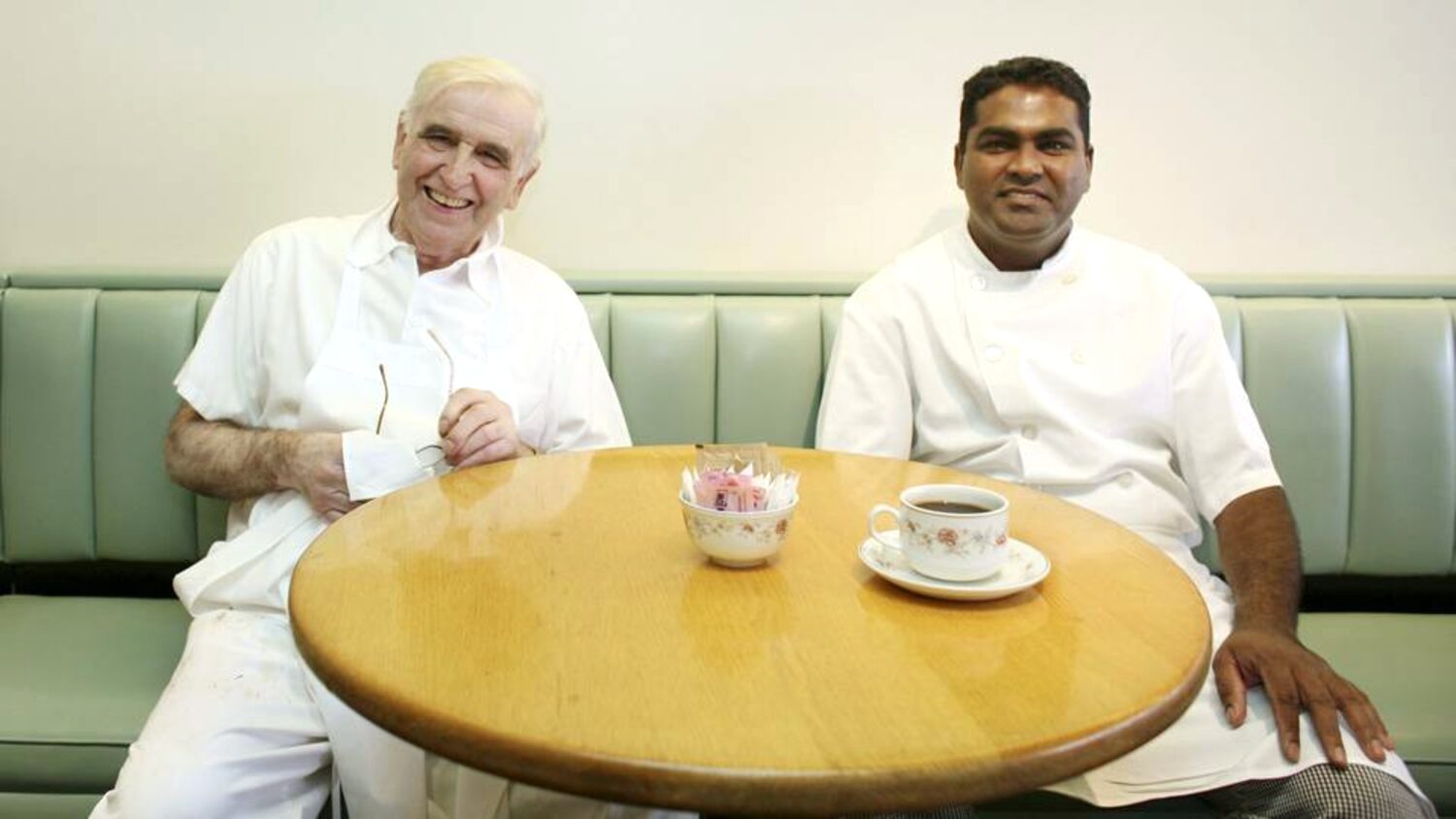
|
I always ordered my favourite lunch, a shrimp-and-egg open sandwich followed by a custard slice (Napoleon, mille-feuille?).
Once, back in Horst’s day, they ran out of custard slices, so I went for my fall-back – a strawberry tart. It wasn’t up to its usual standard, and as I was waiting to pay Horst walked out of the back room. I told him that there was something wrong with the tart – it was soggy and just crumpled under a fork – not up to their usual standard.
He grabbed one from the display counter and took a bite “ Nothing wrong with that”, he said. “OK”, I shrugged, thinking to myself, “You need a better complaints department, fella…”
On my next visit he noticed me and came over. He said “I was a bit brusque with you last time in the way I dismissed your complaint – it’s always my first response.” I thought to myself, “You need a better complaints department, fella…”.
Then he said, “You were right, we forgot to coat the inside of the shell with melted chocolate.” Good for him – I’m sure we both felt better…
Stouffville Fish-n-Chips
Jerry Heikens, a Dutch Canadian, opened Stouffville Fish-n-Chips in 1973 and sold the business to his son John and wife Susan in 1998. I discovered them in the early 2000s when we moved to Stouffville. They made excellent fish and chips, and I dropped in about once a month for haddock and chips followed by dessert – a soft vanilla ice cream cone.
Susan and I had a running joke – “what happens in the fish and chip shop stays in the fish and chip shop” – I would have the ice cream, she wouldn’t tell my wife…
Jerry, though retired, would sometimes drop in to help out on busy days, and he and I would sometimes chat briefly, usually about European football.
Then January 2020 arrived – and so did Covid. Both establishments tried to exist by offering take-out only. Within a few months both closed, and my two favourite cafés were out of business permanently.
The United Nations has said the following:
“COVID-19 has turned the world upside down. Everything has been impacted. How we live and interact with each other, how we work and communicate, how we move around and travel. Every aspect of our lives has been affected. Decisions made now and in the coming months will be some of the most important made in generations. They will affect people all around the world for years to come.”
At this point, you may be saying to yourselves “Makes your ‘poor me’ story above sound rather trivial, doesn’t it?” And I see that. But think about the story from the perspective of the two families, the Heikens and the Narayanapillais. Decent hard-working people who had built successful small businesses for themselves and their families and suddenly had them snatched away through no fault of their own – like hundreds of thousands of other people around the globe…
I guess it will be left to historians to fully document just how much Covid changed the future of our world.
|
|
While we were stationed in Tobruk from 1950 -51, tensions had been building in Egypt, next door to Libya.
At the time, Egypt was ruled by King Farouk, an Anglophile ruler who had been schooled in England and generally kept out of the way of government activities. But Farouk’s indulgent tastes and profligate personal spending ruffled the feelings of the populace, and in particular the nationalistic political party of one Nahas Pasha, who began to sell the idea that all “outside” interference in Egyptian affairs (i.e. mostly from Great Britain and France) was simply colonialism at its worst and had to end.
There began to be real concern for the safety of British ex-pats living in Egypt and for the security of British properties in the country. Pasha and his nationalist party began to threaten that – if they won power – they (or the military junta they would appoint to do their dirty work) would dismantle the Anglo-Egyptian Treaty of 1936 which guaranteed Great Britain permanent use of the Suez Canal... which, was and is, essential for a maritime nation like Great Britain which depends on sure and swift passage of its imports and exports.
(The Suez Canal is, of course, the 193-kilometre, north-south waterway through Egypt, opened in 1869 to link the Mediterranean and Red Seas. It saved 15 days for ships leaving London for Bombay compared to the trip round the southern tip of Africa.)
Britain could see the handwriting on the wall: an Egyptian military junta would arbitrarily close the Suez Canal, or would immediately impose massive increases in the rates charged for shipping. Such a move could put Britain’s finances in a serious situation. Quietly, Britain and France together began to plan for an armed invasion and occupation of the Suez Canal Zone in order to protect the orderly passage of shipping through the international channel.
Israel would be the catalyst for this action. Israel would invent an Egyptian offensive action against it as an excuse to attack Egypt. Britain and France would then pile in to “end the aggression and restore peace.” (This action would not take place until I was, fortunately, safely out of Britain’s armed forces, in 1956 when the Anglo-French invasion of the Suez Canal Zone actually took place).
Our commanding officer of Intelligence, Lieut. Thompson, called us all in one morning, and placed copies of the War Department’s official Secret’s Act in front of each of us. Before being accepted into Intelligence we had all read and signed a copy of the Act (you couldn’t work in Intelligence without doing so) but apparently the War Department wanted everyone in Intel to re-sign the form, and to be aware that we were going to be exposed to many new and significant secrets in the weeks ahead – and were we to divulge any of these, the penalties would be severe.
So it was that we came to learn of Operation “Rodeo Flail”: “The air, sea and land occupation of the Suez Canal Zone by the Armed Forces of Great Britain and the Government of France.” Thompson made it clear that we were to say nothing to anyone else in the regiment of what we were doing, reading about, or preparing.
|
|
If you were male, had lived in Dundee between 1869 and 1929, and misbehaved on occasion, you might have heard something like the following from your parents: “If you don’t smarten up, laddie, we’ll send you to Mars...” To explain this reference to outer space, I need to provide some background:
In the UK, in the latter half of the nineteenth century, life expectancy at birth was about 45 years. There were many poor people struggling to survive and many children were orphans or living in homes where their care was totally inadequate. Many of these kids ended up on the streets and living off their wits, often in bad company.
In 1834 Parliament had passed the Poor Law Amendment Act which resulted in more and more paupers entering workhouses, since other relief measures were essentially eliminated. This increase in admissions meant that workhouses were overflowing, and the Poor Law Board needed to find places to house all the new admissions.
One way that they accomplished this was by sending pauper boys to training ships. These ships were generally moored on the Thames, and pauper boys could be sent to live on the ships once they reached the age of twelve, with the option to remain on board up to the age of seventeen. This was extremely helpful to the over-crowded workhouses of London.
On board the ships, the boys were taught how to become sailors (fit to serve in the British navy). They were also expected to complete ordinary schoolwork and to learn to swim. They were taught carpentry, how to
make sails and ropes, to repair sails when they ripped, and other skills necessary for sailing and rowing.
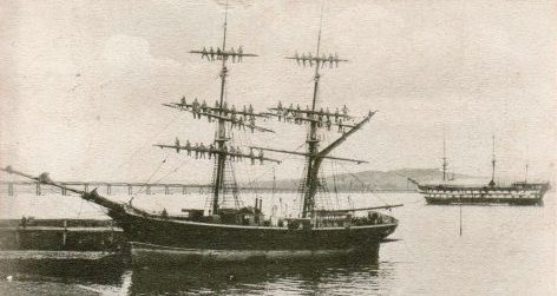 |
| In the foreground the brig HMS Francis Mollison, tender for the Mars and also used to teach sailing skills. Note the boys manning the rigging... |
It was generally agreed by the ‘powers that be’ that the training ships provided excellent care and schooling for the boys, and that keeping them out of the workhouse (but also off the streets) was mutually beneficial. In the twenty years from 1860, industrial training ships began to spread beyond the Thames, and ten were established on major rivers around England, Scotland, and Northern Ireland.
So, the rascal at the beginning of this tale who thought he was going to be sent into space had misheard what his parents had said – it was actually “If you don’t smarten up, laddie, we’ll send you to the Mars...” The Mars was an Industrial Training ship first moored in the Tay in 1869. (It was just off the Fife bank of the River Tay roughly halfway between the landfalls of the rail and road bridges.)
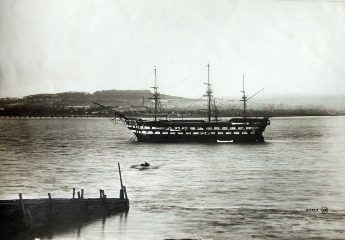 |
|
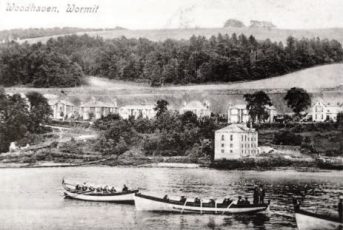 |
| The Mars off Woodhaven – Balgay Hill and the Tay Rail Bridge visible middle left. |
|
Looking south from the Mars – the three-storey building, Rock House, was used as the ship's hospital and still stands today. |
Such industrial schools were meant to house and educate the poor, as distinct from the reformatory school for children convicted of crimes. In practice, children were sentenced to time in an industrial school by magistrates for things like begging, to being in the company of reputed thieves. For the children, the experience would have been difficult to distinguish from a criminal proceeding.
On arrival on the ship, the similarity to a prison continued. Children were first stripped and examined by a medical officer. Their hair was cut close to the scalp. Then they were bathed and given a uniform to wear. Their names and details of their families and ‘sentence’ were noted in a logbook. In a practice very much drawn from prison camp life, each child was assigned a number which replaced their name. From that point on, even just amongst the children themselves, they were only referred to by their assigned number.
Efforts to strip away individual identity from the boys were part of their training for a life at sea, but also greatly reinforced the effects of removal from their homes. Boys were deliberately given little opportunity to maintain connections with family and friends.
Discipline was strict, and for serious misbehaviour, such as making a break for freedom, boys would be stripped to the waist, tied across one of the ship’s cannons, and lashed (up to a maximum of eighteen strokes).
For 60 years the Mars was a local landmark, but improvements in the education system, changes in the law on juvenile crime and the deteriorating condition of the ship marked its end in 1929. This old warship served as home to over 6000 children with there being around 400 boys living on board at any one time.
My thanks to Libraries, Leisure & Culture Dundee for some of the text and photographs above.
|
|
 |
 |
When I was a Lad!
Bill Kidd |
 |
 |
After many years of despairing at the declining standards of behaviour of the upcoming generations I have reached the stage of my life when more time is spent in mature reflection than in thinking about the future. One outcome of my honest reappraisal of my own behaviour during childhood and adolescence is the realisation that the following generations were little different to me and my contemporaries. What was different was the culture and economic circumstances in which we grew into adulthood.
I was born in 1935, a time of economic difficulty for most of the population. There was very little cash to spare, and expectations were modest. The majority of families lived fairly close to their immediate family members, and this provided a strong support network. By the time I started school much of this had changed because of WW2. The economic situation strengthened. Women took advantage of the well-paid work that became available and a whole generation of young men were called into the military. Additional responsibilities were thrust upon grandmothers and grandfathers. More cash was around but there was not a great deal available to spend it on. The support network was fraying at the edges, and it was inevitable that changes in society would take place.
All of this affected the children of the time. Many more mothers were at work, many fathers were away from home for long periods, childcare arrangements certainly would not meet present day standards. Older children, particularly girls were expected to look after younger siblings and ensure that they went to school and returned home on time. The firm discipline normally imposed by parents also began to fray around the edges.
In the summer months the streets, in the absence of traffic, became playgrounds. Ball games and skipping games were the girls’ favourites while the boys enjoyed cowboys and indians and other warlike games. Chasing and capture games like Tig and Reliefo were enjoyed by both genders and although we were not exactly feral, we did enjoy a lot of freedom. Wherever and whenever you went there would be a lot of noisy unaccompanied children. Where are the children today? Certainly, the birthrate has fallen, but not to such a great extent. Apart from school starting and finishing times unaccompanied pre-teen children are a rare sight today.
In the winter months the life of wartime children changed. It was dark, there were no streetlights or stair lighting in tenement closes. We read books and comics, we listened to the wireless (not the radio), we went to the cinema, we joined the Lifeboys, Cubs or Brownies while our older siblings attended Boys Brigade, Scouts, or Girl Guides. Virtually every child spent at least some time in these uniformed organisations which were often run by men and women who had participated in WW1. A great deal of the evening, usually in a church hall, was spent in drill and marching but there was also games and lessons in various skills, domestic for girls and military for the boys.
The cinema was a magnet for us, and we would often go two evenings a week. A seat at the very front cost threepence, a little further back sixpence. I you went with a parent or other adult you would likely sit a lot further back in seats costing the adult one and threepence or even one and ninepence, your seat in the same area was half price. The theme for play during the next week was often established by the subject of the film. Errol Flynn like swordplay was re-enacted with a piece of wood and the flowing cloak by a trench was coat slung over the shoulder and buttoned at the throat. No replicating of a kissing scene was even contemplated until many years later!
The dark nights were also the opportunity for various kinds of mischief. Nothing terrible but just extremely irritating to our adult victims. Sometimes while returning from the cinema, we would decide to play Chap and Run. This consisted of knocking at someone’s door and watching for the door to be opened by the resident and having a quiet laugh to ourselves over the puzzled expression on his face when there was no-one there. The big joke was to repeat the exercise a couple of times before we got shouted at and made ourselves scarce. This form of loutish behaviour palled somewhat after one of our number rose to the challenge of knocking on every one of the eight doors of one tenement close. Not being very bright he started knocking on the bottom doors before going upstairs ……. he couldn’t sit down for a week!
A variation on this activity involved a rubber washer from a wire topped lemonade bottle, a wood screw, and a length of string with half a dozen knots, each an inch apart, at the end of it. This was used after dark to stick to the corner of a blacked-out window. When the string was held taut and the knots, gently pulled the wood screw would rap on the window. To see what was causing the resultant knocking the victim would have to extinguish the room light and remove the black out curtain. A tedious and annoying process.
This treatment was mainly reserved for those adults who objected to our noisy play outside their house. To us it was a bit of fun, to the victims it was a case of “Children today are spoiled and have no concern for others.” Exactly the same opinion that I have voiced about successive generations to my contemporaries over the years. Perhaps we need to be a little more tolerant and take aboard the changes in culture when we compare the current generation to ourselves at the same age.
|
|
You’ve probably all seen shows on television featuring the annual migrations of millions of turtles to lay their eggs on beaches around the world. In the Atlantic, from the Caribbean up the US East Coast to Canada, and, in the Pacific, from Southeast Asia (Indonesia and Malaysia) to California and then up to Alaskan waters. If you are interested, see this short Smithsonian video
Sheila and I have never seen these great turtle migrations, but we live in the country north of Toronto, and from time to time we see a variety of small animals in our backyard, from field mice to deer and coyotes. Annual visitors include several snapping turtles. We have a small pond to the east of our house and a wet, marshy area to the west. Most summers we will see one or more lumbering across the back of the house from one to the other.
We’d always assumed (without evidence) that this was the females’ annual egg-laying trip. Snapping turtles are a type of freshwater turtle known for their distinctive and often aggressive behavior. They are a common sight in North America. They can be quite large, with some individuals reaching sizes of 18-20 inches in shell length and weighing over 35 pounds. Imagine a tea tray with head, tail, and four flippers sticking out… They’re quite ugly, and sometimes covered in algae which doesn’t help…
| |

|
One day, some ten years ago we noticed one at the front of the house on the edge of the road – apparently
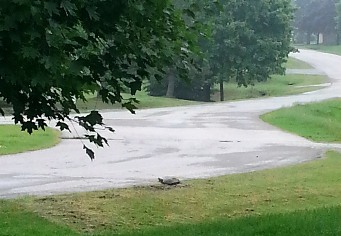 |
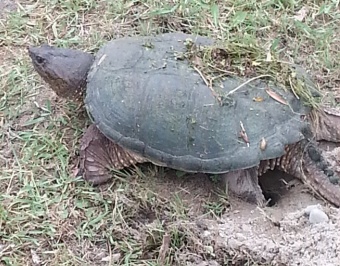 |
the soft shoulder of country roads is often a favoured position for egg laying. We watched it settle itself and begin to dig and we realised what we were seeing and grabbed my phone. It was quite amazing how she dug so accurately with her flippers – she manipulated them as if they were hands.
She finally was satisfied with the nest and settled down to lay – apparently you can expect twenty to thirty eggs (though only one or two of those will grow to maturity). By this time, we were right at her backside, but our presence seemed to bother her not one whit. Not sure how many she laid, but below you can see two photos – these are actually the same photo twice (I manipulated the contrast etc. to make the eggs visible):
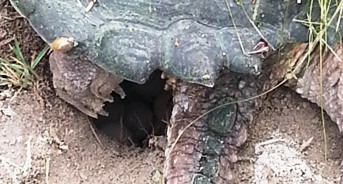 |
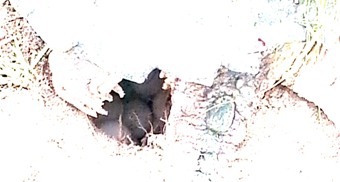 |
She covered the nest, made an excellent job of tidying up, then seemed to settle down for a rest – we lost interest at that point, and when we checked some time later, she was gone.
The story becomes rather anticlimactic at this point. We had hoped that we would see the babies emerging – I wondered whether they would head for the pond or the marsh. Since the eggs take some 80 to 90 days to emerge, we realised that we would probably miss the event – but still, we kept checking every now and then…
As it turned out, we didn’t see anything – the spot remained undisturbed – sadly, for some reason, the eggs didn’t hatch…
A few years later, I saw my next door neighbour digging by the side of the road, about 40 ft from the nest
site. I asked him what he was doing, and he said that a turtle had laid eggs there and he was going to dig them up and put them in a more secure spot in his back garden. He said he’d done it once before, successfully, and had hand-carried the hatchlings down to the pond. He dug a hole, put the eggs in, then placed a wooden box on top weighed down with stones to keep out predators – raccoons, skunk, foxes, birds, and dogs.
Some months later I asked him if it had been a success and he said that it hadn’t – that he eventually dug up the nest and said that he couldn’t find any signs that the eggs had ever been there, despite the fact that the box on top was undisturbed… another one of Nature's mysteries, I guess!
| |
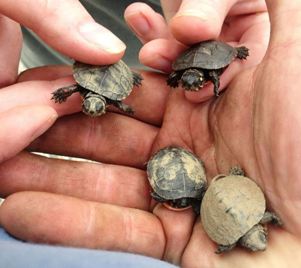
|
|
|
 |
 |
Growing up in Kingsway Place
Brian Macdonald |
 |
 |
My parents got married in 1937, my father the Dundee-born son, with two sisters who both worked in jute factories, of parents who hailed from rural Aberdeenshire. They were late 19th century immigrants to Dundee looking to find work in the growing industrial city, and my mother was a London East Ender, whom my dad had met during his wandering as a merchant seaman. It was my mother who had to relocate, so they started their life together in Dundee. My father’s seaman’s skills were not very useful on dry land, and he became an insurance man, travelling around Dundee in all weathers on his big, heavy Hercules bicycle, selling small life insurance policies to poor jute factory workers so they would have enough to bury the head of the family when the time came, and collecting the weekly premiums.
My mother was from an industrious East End Jewish family of Polish heritage that had established a fishmonger’s shop and she understood retail and had a ferocious work ethic; she and her brother Nathan both had to help out in the family business from an early age, although neither stayed in the family business: my mother became a nurse and her brother a London fireman who drove a fire engine throughout the WWII blitz. But it was natural to my mother to establish a shop. Not a fish shop in her family tradition, but one that sold sweets, cigarettes, lemonade, milk, ice cream and dry groceries from a tiny wooden building on a street corner on Old Glamis Road in Dundee, then an area of many small factories so there was a ready and keen market for her range of products.
Right across the road was Old Glamis Fabrics, a specialist jacquard-weaving factory set up by Donald Brothers, a firm with its origins in Dundee’s main industry of the early 20th century, jute processing. The then queen, Elizabeth’s family (Bowes-Lyon, the earldom of Strathmore) lived in Glamis Castle some miles from Dundee and were said to be patrons of the factory and made occasional visits. There was a factory that made sharp pins for flax and jute processing called hackles (or heckles in Dundee) and the simple gramophone needles used then. A sawmill stood nearby. There were two engineering factories. The Cabrelli family, of the early 20th century Italian immigration to Scotland, whose name became well known in Dundee for ice cream and fish and chips, lived on the corner of Balgray Street, just opposite the shop. The Dundee North End Football Club ground was – and still is – a short street away and Saturday afternoons in winter were good for business.
The shop prospered and was not only my mother’s business for most of her life but also the financial mainstay of the family. Both my father and I did stints behind the counter over the years and proficiency in mental arithmetic in pounds, shillings and pence became a skill of mine. Often, of a Sunday, as a teenager, I was on duty and, with few customers, spent most of my time outside cleaning or tinkering with my cherished burgundy-coloured BSA motorbike.
My parents looked for a home near the shop and a new housing estate was just springing up ten minutes’ walk away, on the northern side of Fairmuir Park, which was all grass with football pitches marked out and with a fringe of trees. A railway line with a steel footbridge over it ran along the south side, past Dundee North End FC’s modest stadium. Park Road bordered the park on the north side, with a row of houses on one side, facing the park and a private bowling club was on the east side. Park Road ran ruler-straight, from Old Glamis Road to Strathmartine Road, along which the Downfield to Blackness double-decker trams rattled and swayed. Old Glamis Road carried the number eleven bus from the then tiny rural village of Trottick to Shore Terrace in the city centre. From Park Road to Dundee’s loop road, the dual carriageway Kingsway, it was largely lush paddocks, grazed by milking cows, with a few streets slowly developing. Strathmartine Road was bordered by grander detached houses. Beyond the Kingsway was the Downfield suburb, Caird Park golf course and countryside.
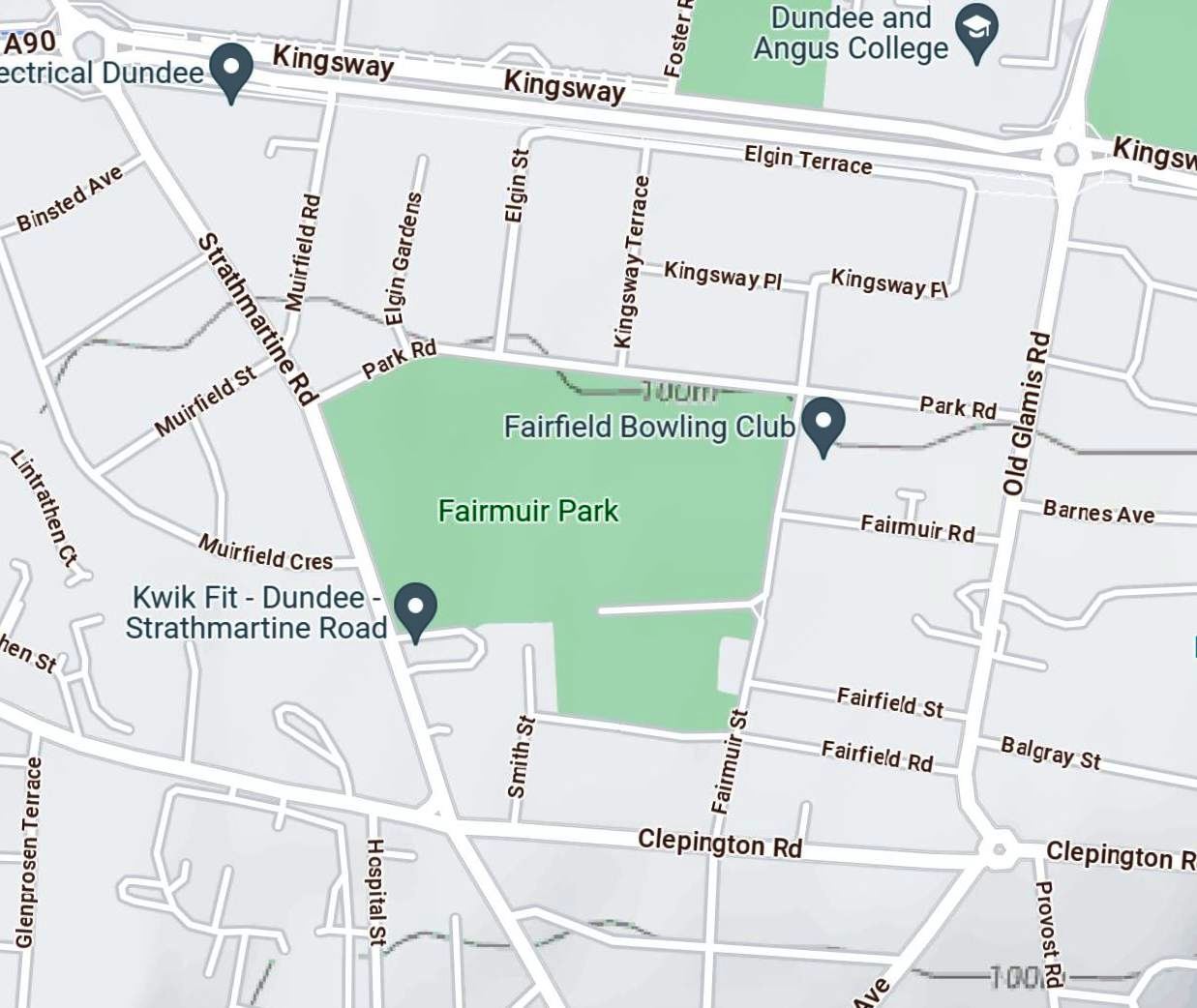 |
| The Fairmuir Enclave Today |
Just before I was sprung on an unsuspecting world in June of 1938, my parents became the owners of 13 Kingsway Place, the first house occupied in the street, a modest, two bedroom, semi-detached bungalow
with a stone front wall with railings on top that were cut off during World War II for the war effort. The houses quickly grew along our street to Kingsway Terrace, Elgin Street and Elgin Gardens, both of which were offshoots of Park Road, although a dairy farm still ran at the Strathmartine Road end of Park Road till some years after the end of WWII.
Park Road had bigger houses than those in our street and the occupants had a fine view of the weekend activity on the football pitches that patchworked the park. Until after the war ended, the few houses on the
| |
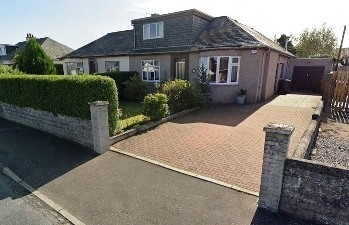
|
Kingsway side of our street had cows staring over their back fences.
As the whole area became populated by young families very like our own during the year or more leading up to World War II, there was a crop of children born all about the same time before the war, with only a few younger stragglers. Most families had one child, a few two, the conflict that began in 1939 putting a damper on thoughts of bringing another child into the world in many minds and it was an era of small middle-class families. When the time came, most families who could afford it enrolled their children at the Morgan Academy, one of Dundee’s better schools and a not unreachable distance from our district, which was called Fairmuir. One black sheep went to the Dundee High School, but I can’t recall another in the street who did not attend the Morgan. The McGills, whose family’s large department store, McGill Brothers, stood on Victoria Road at the top of the Wellgate in central Dundee, lived on Kingsway Terrace, facing Kingsway Place and the son was a part of our group, even though he, too, was a High School lad.
So we were a crowd of boys and girls growing up mostly within a year’s age of one another, living close to one another and going to the same school and this was our playground, on the little, outer suburban street, before cars became commoner in the 1950s. There was a kink in the middle of Kingsway Place, where Fairmuir Street and North Street formed a T-junction, which made a bit of an open space for bikes and ball games, with a gas-light lamp post that made a useful wicket or the post for games of Touch. There was a cundie(1) that was used for the game of pinner(2). It was also where we collected rubbish for Guy Fawkes(3) day and where the annual bonfire warmed November faces, tatties were dry roasted in the embers and fireworks were let off. All the neighbours turned out for the bonfire and fun once a year.
That space was the start and finish for the many bike races that were run for all the boys had bikes. It was at the foot of Fairmuir Street North, a short and not very steep but sloping street that ended with a T-junction left and right into Kingsway Place. The slope was used as a sledge run in winter and in summer offered the daring a chance to scrape the pedal of a bicycle on the tarmac as the rider hurtled round the right-angle corner into Kingsway Place. When I was older and started riding a motorbike, it became a point of honour to scrape the centre stand mechanism going round the corner. In those days before TV reached us in 1953, kids played active games outside all the time and we were a lively group, always at something. The boys often used to take a football the short distance up that little slope to the corner of Fairmuir Park and set up an impromptu game of ‘fitba’ till it got dark.
As we got older, we were allowed to stay out playing in the street later and I well recall the long northern summer evenings when daylight lingered till after10 o’clock and only the parental calling of a child’s name forced that bairn reluctantly to leave the fun and go home. In a cold, east coast Dundee winter, dark before we left school at 4 o’clock, snowball fights and sledging on the car-free street would go on well into the dark evening. There was much house hopping, especially on Christmas morning (to the disgruntlement of parents who wanted peace and quiet) as we were all eager to see what our friends had got in their Christmas stockings and show off our own treasure.
After WWII ended, the Scottish economy slowly grew and changed, as did the population. Men returned to civilian life and wanted nothing more than to settle down to a job, set up a home and start a family. The demand for housing was insatiable. Kingsway Place was extended towards Old Glamis Road and became Elgin Terrace, forming a rectangular block between our street and the Kingsway, which it was separated from but parallel to. Dundee had to expand outwards beyond the Kingsway, where there had already developed a large industrial estate that became the home of NCR(4) and Timex(5) factories, both major employers as the jute industry was overtaken by synthetic rope, paper sacks and plastics and Dundee’s not insignificant shipbuilding dwindled. Both male and female labour was plentiful.
This rectangular street loop became a handy bicycle race circuit until increased prosperity brought more cars to the neighbourhood. There were no garages in the new ‘Pre-fab’(6) houses that soon covered the whole area and it became not uncommon for there to be cars parked on the street and more commercial traffic. Not now safe for dare-devil kids on bikes! Many of us rode our bikes to school but the growing traffic made that an increasingly hazardous activity and I remember the tragic death by a collision with a school bus, one lunchtime, of a fellow Morgan boy, who lived nearby.
By the mid-fifties, we were well into our teens, our bodies and minds were changing, and other interests were taking over from bike racing and street games. The halcyon days of our childhood were slowly ending, and society was changing as rampant technology reshaped the twentieth century. Kingsway Place is still there, with its now elderly and much-extended houses, as is Elgin Terrace. The pre-fabs were removed at the end of the 1960s and replaced by larger, more substantial houses. most now owner-occupied. Fairmuir Park still has its quota of football pitches but the public bowling green that nestled in a corner of the park, by the long-gone railway line, is closed. No tramlines run down Strathmartine Road, although buses still use Old Glamis Road and car yards occupy the places where factories stood. The H Samuel jewellery store that stood on the corner of Reform Street in Dundee’s city centre and sold Timex watches, once the place in the city centre to meet friends, is gone, as is McGill’s department store. Although my part of Dundee is still similar to the past, there are many places and streets I do not recognise.
I left Dundee at the age of 18 and never returned to live there. On a return visit to the city of my birth, spending a day or two with an old friend in the old street, I sometimes think, in my old age, that I hear children’s voices and see the flash of a bicycle or a bouncing ball as I walk up Fairmuir Street North. Faint, but still there, in a back corner of my mind. The echoes of a distant childhood.
Footnotes
(1) Cundie is the Dundee dialect word for the cover of a cast iron street drain or manhole. A cundie was used as the target of a boys’ street game known as pinner.
(2) Pinner, in Dundee, was a boys’ street skill game played with a square metal object, usually a piece of broken file about two inches square, with the rough edges ground off. The object of the game was to throw or slide your pinner as close as possible to the centre of a metal drain cover and, if you could, shunt the pinners of other players away. The name is used for other games elsewhere.
(3) The Guy Fawkes Bonfire Night celebrates, with a stuffed dummy which tops the bonfire and fireworks, all over Britain, the failure of the plot to blow up England’s Houses of Parliament on November 5th in 1605. (It did not become the United Kingdom’s parliament until the 1707 Act of Union, when the Scottish and English parliaments combined to sit at Westminster. The Scots King, James VI, became also the first king James of England in 1603, thus becoming king of the United Kingdom.)
(4) National Cash Register (NCR) is a multi-national technology company that set up in Dundee to manufacture cash registers and mechanical adding machines. Later, automatic cash point machines were manufactured at the Dundee factory. The company still has a small research presence in Dundee.
(5) Timex is a multi-national watch-making company that manufactured lower-price watches in Dundee, putting watches on to the arm of the ordinary person for the first time. Timex closed its Dundee factory after a bitter labour strike in 1993.
(6) The Pre-fab or prefabricated house was an early post-WWII innovation, a small single-storey house built off-site in modules and installed rapidly in numbers on concrete slabs in hastily constructed estates to provide quick and gratefully received rental housing for a growing populace of young post-war families.
|
|
 |
 |
The Innocents Aboard...
Hugh McGrory |
 |
 |
My previous story of my dad’s seafaring adventure reminded me of another tale …
This one is set, once again, in Algonquin Park, in the early ‘70s. My parents had come over to Canada to see their grandkids, and we decided to take a day and drive them up to the Park to see some of our Canadian ‘wilderness’.
We left early(ish) for the three hour plus drive and finally arrived at one of the outfitters in the park that rented canoes (since the kids, and their dad, wanted to have a little canoe trip).
I rented a canoe which would take two adults and two kids complete with PFDs (Personal Flotation Devices – life jackets). I asked who wanted a canoe ride - the kids said, “we do, we do”, and the adults said, “we don’t, we don’t!”
So, the kids and I set out. I sat in he rear seat and the kids shared the bow seat. We had made sure that the kids had PFDs that fitted them and they looked ready to enjoy the trip - like the children in this stock photo.
There was a light, steady breeze from the north, but the lake was quite calm. As soon as we pushed off , the canoe naturally oriented itself to the breeze and pointed south. As Captain, I should have realised the significance of this (the adage “what goes up must come down” or “every mile downwind eventually means a mile upwind…” comes to mind) but it just didn’t register at the time…
The edge of the lake was oriented north to south and the ‘land lubbers’ in our party wandered down the road keeping pace with us as we paddled, actually really drifted, along – it was very pleasant, and the kids and I enjoyed the new experience. All good things come to an end though and I
| |
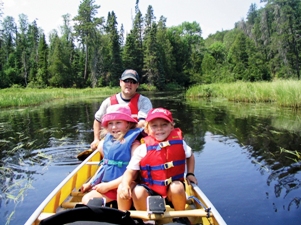
|
finally decided it was time to reverse course and head back.
I turned the canoe so that we were pointing north, into the wind, at which point Mother Nature said, “I don’t think so”, and the wind turned the canoe back to point south again. At first, I didn’t think it was a problem, but I soon realised that it was more than that – no matter what I did I couldn’t get the canoe to settle into a northbound course. The nose would approach north then swing back or it would go through north and circle back. I was stuck!
While this issue was no doubt known to indigenous people all over the world for thousand of years, not a
single one of them thought of mentioning it to me, so I had no idea what to do, such as, for example, tacking, or using the J-stroke, or turning the boat around, sitting in the bow seat facing the stern and paddling the canoe backwards – this puts you forward in the canoe and helps trim it for wind-paddling, i.e. more weight forward.
Our landlubbers had been watching us, bemusedly, as we twisted and turned and made no progress - actually we made negative progress getting pushed further and further south each time - and gathered on a little dock to ask what was going on. My solution to the problem was to pull into the small jetty and ask my daddy for help.
Despite his fear of water, Dad got himself into a life jacket and climbed into the bow seat while I remained in the stern. (The role of the bow paddler is to supply power – the stern paddler supplies power and also steers.) This extra power up front made all the difference, and we were soon back at the outfitter’s dock and returning the canoe.
The kid’s and I enjoyed our little adventure, but I’m sure that I didn’t appreciate just how nerve-wracking it must have been for my dad - he never complained once…
Sadly, I’m sure if I found myself in a canoe today, I’d be just as gormless as I was then…
|
|
 |
 |
War Frozen in Time
Gordon Findlay |
 |
 |
While we were stationed at Tobruk, 1st H.L.I. took part in a long-range reconnaissance as part of “military preparedness” for all the parts of 3rd Infantry Division, to which we were attached.
Our I-Section was distributed among several of the vehicles which set out from Tobruk; I was aboard a specially equipped Jeep which among other things carried a heavy-duty radio to handle some of the communication between the elements of our group.
There were 3-ton and 15-cwt Bedford trucks, a flock of Jeeps, plus a couple of armoured cars from the Royal Signals Regiment. We headed towards Bir Hakeim (Old Man's Well), a small oasis south and west from
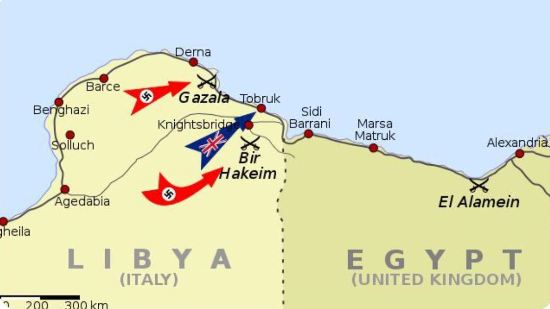 |
| Bir Hakeim and the battle for Tobruk in 1942. |
Tobruk, the site of a famous armoured division battle during WII when Rommel’s Afrika Corps clashed with British, French, Australian and South African forces.
Contrary to what many people imagine, the Libyan desert is far from flat. It has mountain ranges and hundreds of miles of low hills. Many of the trails across these areas are simply that– trails or tracks followed by the nomadic people who cross the area. They’re not roads in the way we think of roads, solid and well-defined and easy to follow.
Much of the time the only indication of a “road” is a small pile of rock with a matching pile of rock a few hundred yards further on; you try to keep your vehicle close to the rocks, because to veer too far off means sinking into soft sand and instantly getting bogged down.
When that happens, it’s everyone out of the truck, digging out the wheels and throwing wooden-slatted tracks under them, so the driver can s-l-o-w-l-y inch forward on the wooden slats, a foot at a time which fresh sections of slats thrown in front of the tires until the truck can regain firm sand again. It’s hot, sweaty, and exhausting work.
We ground over this grey-brown and gritty landscape for several hours, then all at once we were sliding down into a shallow valley and into a living museum of warfare, for all around us were littered the shattered and burned-out hulks of Allied and German trucks, tanks, half-tracks, anti-tank guns and armoured cars.
The battle at Bir Hakeim had ended in 1943 and this was only 1951, but the scrap-metal scavengers hadn’t managed to find their way out into this isolated desert area. The bodies had long since been removed and buried but the mechanized components of a modern army were still scattered everywhere: blasted apart, riddled with holes, and torn into piles of twisted metal.
A self-propelled gun was lying upside down with its barrel peeled apart. There were a couple of tanks that had had their turrets blasted away. Others were lying on their sides with the tracks blown off. Most were torn open and blackened with the fires that had raged nine years ago.
One Australian armoured car was sitting on its own on a low rise, and it looked quite new and untouched, with well-defined camouflage and paintwork still clean and bright. It was only when we drove closer that we could see one perfect hole just below the small turret. A single anti-tank shell had obviously made a direct hit and had exploded inside.
You could only imagine what sudden, shocking, and bloody death that had caused for the crew inside. We all stared at it in total silence.
We were not allowed to get down to look closer because there was still live ammunition and unexploded shells buried in amongst the wreckage and lying around the sand and rocks.
There were also reported to be many landmines still buried in the area. . . another reason why the metal scavengers hadn’t visited this area. So, instead, we drove slowly past, keeping to the well-marked trail, all of us silent, looking at this grotesque open-air museum of desert war where so many men had died.
|
|
Many of you will remember Butlin’s Holiday Camps, particularly the one in Scotland, outside of Ayr which opened in 1946.
Holiday Camps were very popular in the late ‘40s and ‘50s as the country began to re-build a ‘normal’ life after six years of war. The Heads of Ayr holiday camp contained all of the typical Butlin's ingredients: the
army of support workers (known as Redcoats for their red blazers) who helped guests make the most of their time, early morning wake-up, chalet accommodation, a dining hall, bars, coffee lounges, indoor and outdoor
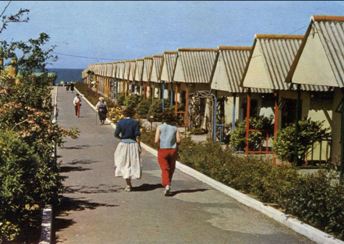 |
|
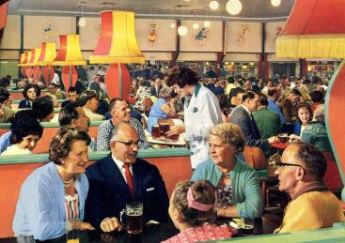 |
| Chalets |
|
Continental Bar |
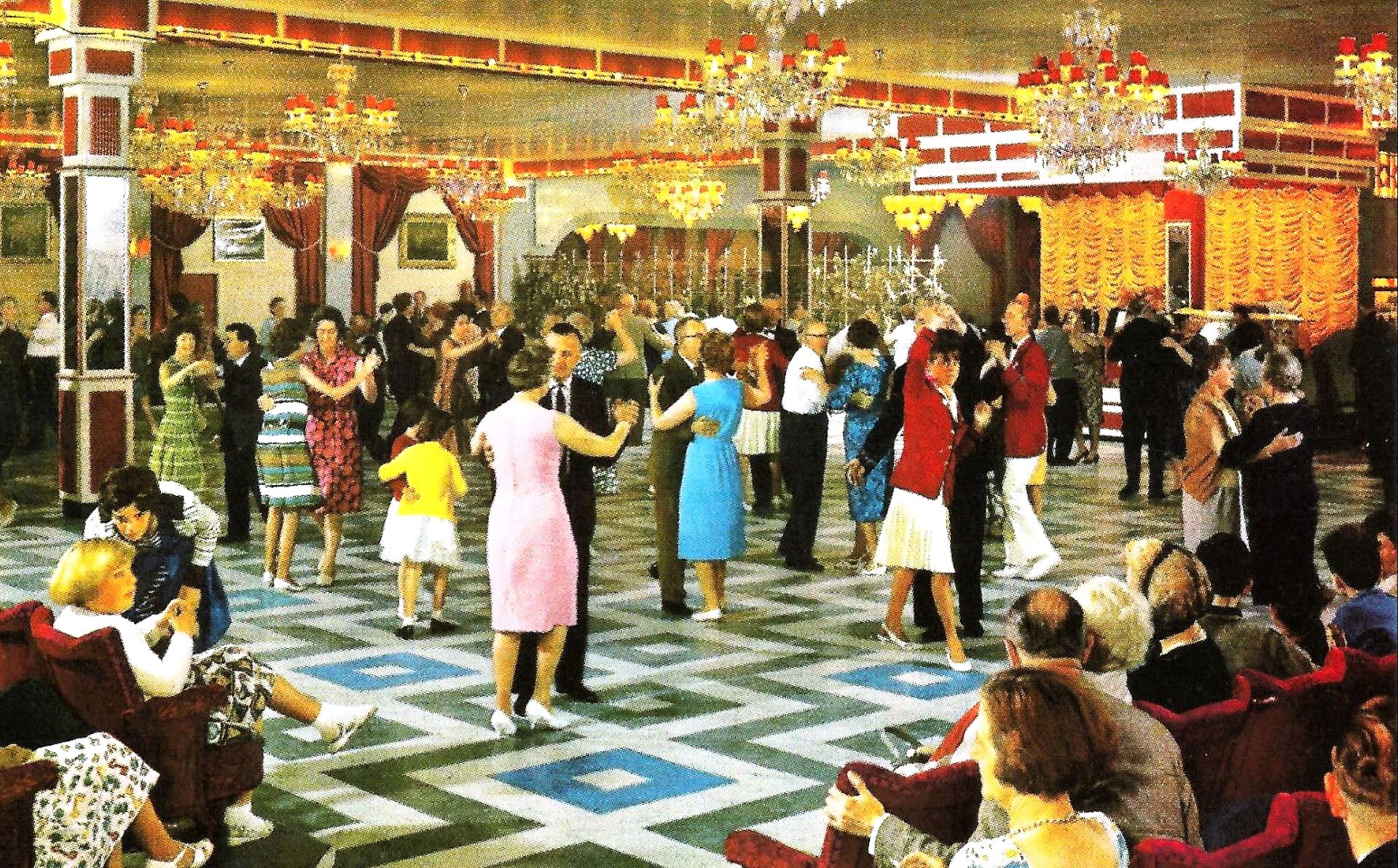 |
|
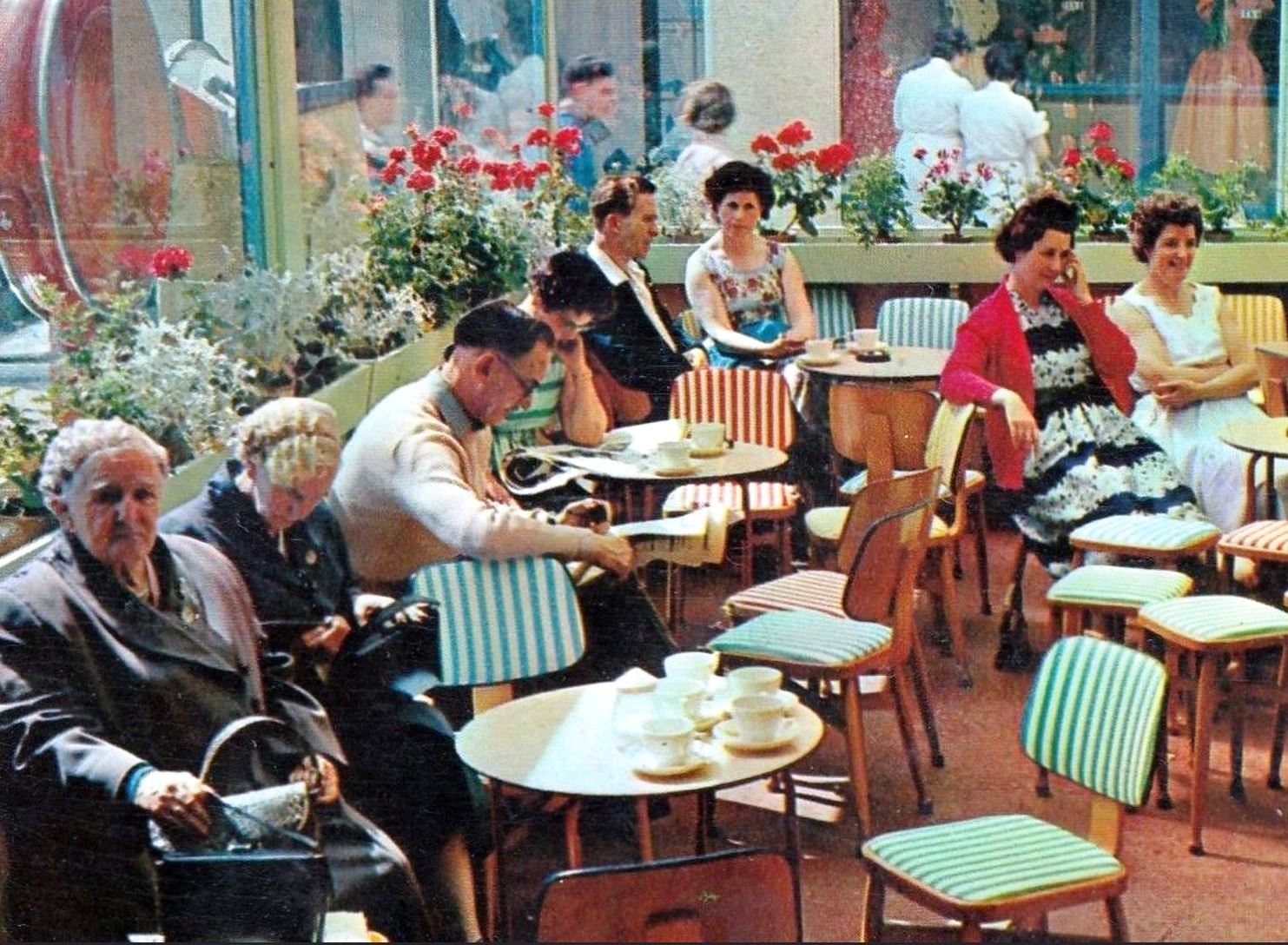
|
swimming pools, a ballroom, a boating lake, tennis courts, a sports field (for the three-legged and egg & spoon races and the donkey derby), table tennis and snooker tables, an amusement arcade, a medical centre, a theatre, arcades of shops, a chairlift system and a miniature railway.
| Ballroom |
|
Coffee Lounge |
I’ve never been to a Butlin’s myself, but I was reminded the other day of a story my dad liked to tell:
Sometime in the early fifties, my parents and my dad’s younger brother and wife (my Uncle Mick and Aunt Ina) decided to have a week at Heads of Ayr - without the kids… Probably the main idea behind the week was to get away from me and my wee brother, and our two cousins, Isa, and Margaret.
I’m pretty sure that the idea of taking a turn in a rowboat on the boating lake came from Uncle Mick. My dad couldn’t swim, and I think he was afraid of large bodies of water, so it wouldn’t have been his idea, but then again, he wouldn’t have wanted to spoil his brother’s fun.
I’m sure the ladies said something like “Not on your nelly” when asked, (then whispered to each other “It’s going to be more fun watching Laurel and Hardy in a boat…”)
Since this was about seventy years ago, the details are rather sketchy in my mind – I don’t know if the ’fun’ began before they went off for a trip on the inland sea, or whether it was as soon as they got near the boat but as I remember the tale my dad told it went something like this:
Uncle Mick was towards the stern, with the oars, and my dad was towards the bow. Somehow the boat began to rock and shipped some water so that they were ankle deep. My dad panicked at the thought of drowning (unlikely in some 18 inches of water) and since they were adjacent to the shore he decided to evacuate.
He managed to get himself on to terra firma, splashing more water into the boat in the process. When his weight was removed, gravity did its thing, the bow rose up, the stern went down and the water in the boat moved towards the stern.The result was that the water was no longer up to his brother's ankles - it was up to his butt...
I can just picture Aunt Ina and my mum sitting in their deckchairs laughing so hard they almost choked on their ice cream cones. I’ll bet it was the highlight of their week…
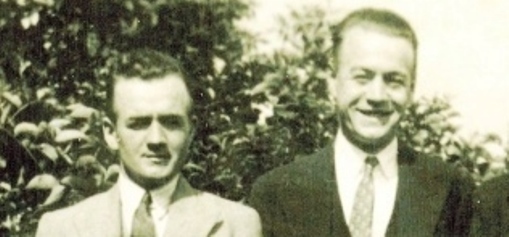 |
| The intrepid McGrory seafaring brothers (my dad on the left.) |
|
|
For business and pleasure, I have found myself having to negotiate the streets of many cities in the UK and Western Europe. On most occasions this has been during the day when there were many people around and I always felt very secure. At other times I had to cope with deserted streets late at night and I was always very conscious of how vulnerable I was to becoming a victim of crime. To minimise the danger, I always tried to keep to well-lit areas, ideally with a reasonable amount of traffic on them. I always avoided underpasses or short cuts through narrow lanes even if in doing so this lengthened my journey.
By following these self-imposed rules, I survived, without incident, many journeys through the late-night streets of Paris, Amsterdam, Lisbon, and Brussels. Nearer to home, I survived unscathed many visits to Glasgow, Liverpool, Manchester, Birmingham, Edinburgh, and London. Yes, in my late teens and early twenties I even traversed Dundee’s Stobswell, Kirkton, and Beechwood areas very late at night. I won’t pretend that I was never frightened but my prudence or, some might say, my cowardice, paid off and I always got to my destination safely. As the years moved on and the need for such adventures reduced, I became more confident and less nervous about late night treks. Truth to tell, I made more use of taxis and only made very short journeys on foot. I followed the rules, I had nothing to fear as long as I continued to do so. They say, “Pride comes before a fall”. Alas, how true this is!
In the first Spring following our retirement Muriel and I decided to have a holiday in the South of France, and we decided that Marseilles would be the ideal place to base ourselves. We had spent a couple of nights there several years before and it seemed to be a good place to explore further. After an uneventful journey we arrived and booked into our hotel which was located at the quayside of the Old Port.
Having made ourselves comfortable after our journey we went out to explore our immediate surroundings. The quays of the old port are in the form of a “U” with the two main legs each about 600 metres in length and the quay joining them around 200 metres. The buildings surrounding the quays were set back about 30 metres. There were several small hotels in addition to ours but most of the buildings were restaurants, cafés, and nautical supply stores.
We learned that the short quay hosted a fish market every morning. On the water there were cabin cruisers, yachts, fishing boats and even a floating restaurant housed on a sizeable sailing ship. We were in tourist heaven. As the evening wore on the area became more and more lively and we sampled the fare in a restaurant that we chose at random, it was excellent and not very expensive! After a libation, well several, we left the lively scene and returned to our hotel only a few yards away. I was familiar with the reputation of Marseilles as a centre of crime and had watched The French Connection, but I was confident, that provided we kept to our rules, no harm would come to us at any time of the day or night in the vicinity of the Old Port.
Each of the next few days followed the same pattern. A leisurely breakfast followed by some sightseeing
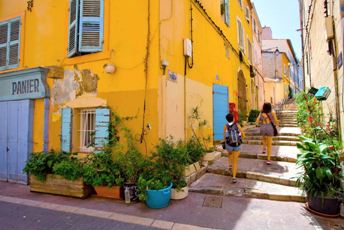
|  |
ometimes taking in a feature of the city or a day trip by rail to Aix-en-Provence or a boat trip to Château d’If, the prison island home of the Count of Monte Cristo. Back to the hotel to rest and recuperate before returning to the Old Port and its restaurants and cafés for evening meal and a bit of socialising. At school my attainment in French was almost non-existent but over the years I have learned from holidays in France that at least three or four glasses of wine is needed for fluency in the language. I hope that every teacher of French who happens to read this takes note and will in future provide pupils with wine as well as irregular verbs!
|
Saturday morning started in the same way as the days that preceded it. We decided that we would walk to a market near to the Old Port. It was a bright sunny day, and the streets were busy with pedestrians but perhaps
| because it was a Saturday, there were many more cars than usual parked nose to tail on both sides of the side streets. On some of the narrower streets the cars were parked half on and half off the pavements. I had stopped off to look in camera shop window while Muriel carried on ahead. Most of the pedestrians, Muriel among them, were walking in the middle of the road. When I had finished my window shopping I saw that Muriel was quite a long way ahead, and that I would have to thread my way through crowds of people to catch her up. Being observant I noticed that the
| |
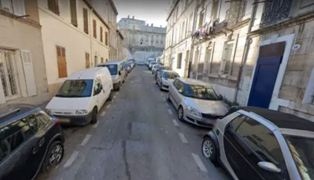
|
pavements that had cars parked on them provided a clear path to the end of the street where I could catch up with Muriel. Naturally I opted to take the fast route!
I had travelled about twenty metres when a car door about five metres ahead of me opened and a man in his twenties got out of the car. As he stood up he dropped a large bunch of keys that he was carrying. Being the gentleman that I am, I stopped to allow him to pick them up. I became aware of something touching my socks and then the area of my hip pockets. I turned round to find another young man smiling at me and holding my arms. I immediately went into victim mode and shouted, “Au Secours!”, proving that all my teacher’s efforts weren’t wasted. Whilst I was having my modest panic attack the two young men got into the car and out the other side and merged into the crowd. I continued to the top of the street where I rejoined Muriel who was blissfully unaware of my ordeal.
With the aid of a small Cognac I soon recovered, and had an audit of my remaining assets, a few coins, and a credit card! I think that I had about forty Euros that were no longer in my hip pocket. I was concerned that my assailants may have somehow cloned the credit card, so I decided to report the matter to the police. They were sympathetic but assured me that even if I recognised them, I would not get my money back. The credit card was left to me because they only take cash. If they are identified and arrested and only have cash on them, how does one prove that it is my cash? After all those years of following my rules for staying safe I suffered the gentlest of muggings by not staying in the crowd – and in broad daylight!
|
|
Smoke Gets in Your Eyes... Remember when many, many people smoked, whenever and wherever, including on aeroplanes – and we just lived with it?
I wrote a previous anecdote about a trip I made to Brussels, late ‘70s or early ‘80s as a member of a Canadian Trade Mission. (I remember it as more of a junket than anything else.)
Be that as it may, the ’duty’ part ended on the Friday, and the flight back was on the Monday. This gave us the weekend to explore Brussels, but I decided to fly to Spain for the weekend to visit my cousin, Mike McGrory, and his family - he worked for BP and was based in Madrid.
I booked a flight on Sabena (Societé Anonyme Belge d'Exploitation de la Navigation Aérienne), the Belgian national airline. I remember the experience as being a pleasant one.
I hadn’t seen Mike and his family for some time and spent an enjoyable couple of days catching up with him, his wife Jan and daughter Alison (their son Stephen was at school.)
Mike was busy on the Saturday morning, so Jan took me to the world-famous Prado, Madrid’s wonderful Art Museum. My wife, Sheila, liked Bruegel, so I visited the gift shop and bought her a souvenir - a print of
Pieter the Elder’s ‘Winter Landscape with a Bird Trap’. It still hangs on our wall, a pleasant reminder of an
enjoyable weekend with family.
Sadly, the nadir of that weekend was the flight back to Brussels. My return flight was with Iberia (Líneas Aéreas de España) Spain’s National Arline. I didn’t know it at the time, but apparently, back then, Spain was a nation of ardent smokers…
When we took off and the no-smoking sign went out, it seemed that everyone except me (a lifelong non-smoker) lit up. The flight lasted about two and a half hours, and everyone seemed to be smoking old jockstraps… I remember watching the smoke gathering on the ceiling and the noxious cloud slowly moving down until we were enveloped in it. At one point I actually wondered if I might smother to death before we got to Brussels.
It was to be around twenty more years before non-smoking air flights were establised universally. I still remember how much I hated every minute of that flight – definitely the worst I ever experienced!
Yuck!
|
|
 |
 |
Scots ‘Fathers’ of Australia
Part 3 of 3
Brian Macdonald |
 |
 |
Major General Lachlan Macquarie, CB; 31 January 1762 – 1 July 1824 – The Scots ‘Father of Australia’
Part two
Lachlan Macquarie’s tenure as fifth governor of the Colony of New South Wales was longer than any of the four who had gone before him but was not without its trials. Macquarie alienated many of the middle class as years passed by an enlightened policy towards the Australian Native people, previously treated with contempt and hostility and often the object of raids that have been called massacres. These raids were usually because of the white settlers’ desire to take possession of land, for farming, land over which Aborigines roamed and as punishment for the theft of livestock for food, which the Aborigines saw as acceptable in their culture. Macquarie established a Native School for Aboriginal children, built a village for the Indigenous people, set up an Aboriginal farm and organised an annual Aboriginal convocation. In this very progressive attitude he was at least 100 years ahead of his time, and it was not appreciated by his fellow-Anglo-Celtic citizens. He also was obliged to institute punishment by the military when some of his initiatives were not well received by the Aborigines, whose culture and deep spiritual attachment to land but without an ownership aspect to it was not easily understood by a European.
Despite the long-awaited birth of a son in 1814 after several misfortunes and the early deaths
of previous children, the second part of Macquarie’s governorship did not go as well as the first and he applied to resign with a pension after eight years, as he had been promised by Lord Castlereagh. A commissioner had been appointed to enquire into an incident concerning an American vessel and an unfavourable report of Macquarie’s overseeing of it was handed down. This report circulated widely in England after Macquarie’s return from Australia in 1822, to his disadvantage.
He was twice refused retirement from his post but finally his resignation was accepted in 1820, although he was not able to hand over until 1822, leaving the colony to the sixth Governor, Major General Sir Thomas Brisbane. Macquarie and his family returned to Britain to the small estate he had bought in absentia on the Inner Hebridean island of Mull and named Jarvisfield in memory of his first, short-lived wife, Jane Jarvis.
From 1823 Lachlan Macquarie spent much time in London, fighting a drawn-out battle against the blows to his reputation and the damage inflicted by the report published on the American ship incident. He unsuccessfully sought the promised pension, exhausting his private funds and his health. He retreated to Mull but was financially unable to set up his estate as he had wished or to sell the land. In 1824, at age 62, in very straitened circumstances, Lachlan Macquarie learned, after an arduous trip from Mull to London, that he would finally receive a generous pension but would not be granted a title, something he believed he was due. Before he could leave London for his beloved Inner Hebrides, he fell ill and died soon after. His funeral was attended by a large gathering of the great and the good. His body was taken back to Mull, by his wife, who had raced to London to be by his side. He was entombed on Mull.
Lachlan Macquarie’s influence on many aspects of the development of the structure, economy, finances, morals, and architecture of the Colony of New South Wales into a modern country is inestimable. His work is perpetuated by many graceful buildings from the pen of his architect, Francis Greenaway and his name lives on in Macquarie Street, a major Sydney thoroughfare and in many other Sydney locations. A university in Sydney bears his name. He is less noted in Melbourne, Australia’s other major city, which was a child of the later 19th century Victorian Gold Rush but a street in an inner-city 19th century suburb carries the family name.
The NSW city of Port Macquarie, 240 miles north of Sydney, founded by him, bears his name and the graceful inland city of Bathurst, although born of a gold rush, was encouraged and legally proclaimed by him. He was as much respected and admired by those convicts whom he had restored to their rank, appointed to positions of responsibility and encouraged to take up land after their time expired, as he was disliked by the free settlers and the higher-ranked citizens for the same reasons.
Lachlan Macquarie acknowledged that the colony had been founded as and was intended to be a penal colony – a place to dump unwanted British citizens. But he always took the view that, one day, the colony that became Australia should be a thriving and valuable member of the British Empire and his gubernatorial policies reflected this view. His faults were those of a man of absolute rectitude and a strict moral code, characteristics learned from his birth and upbringing and which he displayed by his actions throughout his life. His prediction that 'my name will not readily be forgotten after I have left it' holds to this day. He is justifiably labelled ‘Father of Australia’.
Elizabeth Henrietta Macquarie (née Campbell) (1778-1835
No picture of Lachlan Macquarie would be complete without mention of his devoted second wife, Elizabeth Henrietta Campbell. She was Scottish born in 1778 of poor but genteel and well-connected parents and was educated and highly intelligent. A distant cousin of the 17 years older Lachlan, she met him as a widower at a family funeral on Mull when she was 26. He had spent most of his life overseas as a soldier and not encountered her before then. A quick engagement followed but marriage had to await the completion of Macquarie’s next tour of military duty. They were married in Britain when he returned to take command of a regiment which later became a component of the famed Black Watch, whose depot was in Perth in Scotland.
Reported to be a ‘strong-willed and determined woman’ with a lively mind, she went with her new husband to Australia. Apart from accompanying the governor on the many visits he made to far-flung parts of his territory, such as the southern island of Tasmania, the northern town of Port Macquarie and the inland Bathurst, an arduous trip over the Blue Mountains, she took an active part in initiating, designing and even supervising the progressive public works Macquarie instituted during his tenure. She supported his progressive policies towards the Native Australians. She worked with Mrs Macarthur, wife and working partner of the Merino wool industry pioneer and Rum Corps officer, on the development of better agricultural policies.
Mrs Macquarie’s Point is a small promontory jutting into Sydney Harbour. From it there are panoramic views of the harbour, now including Björn Utzon’s Sydney Opera House and the Sydney Harbour Bridge (familiarly known to Sydneysiders as ‘The Coathanger’), as well as the Heads, the narrow passage thorough which all vessels must sail to enter Sydney harbour. On the point, the governor caused a large rock to be carved by convict labour into the shape of a bench, on which Elizabeth liked to sit for long periods, enjoying the splendid Sydney Harbour views and watching ships from England sailing in through the heads. The bench is still there, now in the Botanical Garden, and is a well-known landmark, officially named Mrs Macquarie’s Chair.
Lachlan Macquarie’s resignation as governor took the family back to live on his estate, Jarvisfield, on Mull, named for his first wife. Lachlan Macquarie’s death in 1824, a mere two years after they departed Australia to go into retirement, left Elizabeth a widow at 46. She campaigned, until her death in 1835, to ensure her husband’s achievements in Australia and as a soldier were justly recognised.
The Macquarie clan left no family line in Australia, as the Macarthurs have done. Elizabeth and Lachlan Macquarie had a son born in 1814, halfway through the governorship and named Lachlan, as had been his father, grandfather, and great-grandfather. This boy lived into adulthood and married but did not leave either issue or a good reputation behind him. He is not well-remembered.
The family tomb stands on Mull, with an inscription upon it informing of Lachlan Macquarie’s
achievemmentsThere rest Lachlan, Elizabeth, son Lachlan and another son and daughter who both died in infancy and also first wife Jane. That inscription and the huge effect on the development of Australia is their commemoration. On his tomb, which is administered by the National Trust of Australia, Elizabeth ensured that the following words from a longer inscription honouring his upright character and the services he gave to the future of Australia, were inscribed “… truly deserving the appellation by which he has been distinguished: THE FATHER OF AUSTRALIA”.
Elizabeth Macquarie is justly remembered as a faithful, devoted, and supportive wife.
| |
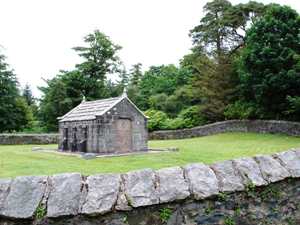
|
|
|
 |
 |
I spent five days, one afternoon, recently…
Hugh McGrory |
 |
 |
A ‘funny’ thing happened to me last week – but before I tell you the tale, you’ll need some background...
I’ve been losing weight, fat and muscle, unintentionally, for quite some time. My first thought was that it was simply old age (I’m in my mid-eighties), but as it continued, month after month, my thoughts turned to cancer, and eventually the medical profession decided we should go on a hunt to see if we could pin down the cause.
Over the past year I’ve had various scans MRI, CT, Ultrasound, etc. Nothing specific was found, but, as for most people, various cysts showed up in various organs. Most of us have them and most are benign and don’t cause any problems. One cyst in my pancreas required a more detailed look.
The pancreas produces digestive juices and insulin, as well as other hormones to do with digestion, and is a
long flattened gland located deep in the abdomen with the liver and stomach in front and the spine behind – difficult to get to, so I was scheduled for an Endoscopic Ultrasound. This means a tube down the throat which has a video camera, a light, and a miniaturised ultrasound transceiver on the end of it.
The procedure consists of pushing the tube down the throat until the sensor is in the stomach then turning on the ultrasound and scanning the pancreas through the stomach wall and, further down, through the duodenum (connects the stomach to the small intestine).
Sheila waited outside the theatre expecting the procedure to take about 30 minutes – it actually took about seventy. It turns out that, as the surgeon was pushing into the duodenum, he realised that he could see my liver – the instrument had gone through the wall of the duodenum…
His assistant told me later that I was lucky (since, after being unlucky to have this happen (out of thousands of procedures he’d only seen it happen once before)), I had a skilled surgeon who was able to close the wound endoscopically. Otherwise, I would have needed “major abdominal surgery". (The Mayo clinic says “The risk of this complication is very low — it occurs in an estimated 1 of every 2,500 to 11,000 diagnostic upper endoscopies.“)
The surgeon used a Padlock Clip) (similar in principle to self-drilling hollow wall anchors for drywall
when you can only work from one side of the wall). It seems to have done the trick and sealed the wound.
So, my afternoon turned into five days in a hospital bed, with no solid food and having, in addition to my endoscopic ultrasound, a gastroscopy and a colonoscopy.
PS
On the bright side, no sign of cancer was found anywhere.
|
|
 |
 |
Artillery Practice
Gordon Findlay |
 |
 |
The 1st Battalion of the Highland Light Infantry had a battery of 25-pounders to serve as our immediate
artillery support and anti-tank defence. We almost never saw them being used (we were, after all, just ‘showing the flag’ in Libya and not deployed against any enemy at that time).
But on one occasion it was decided that our artillery would get an active workout. As part of the work-up towards Operation “Rodeo Flail” (the 1956 Anglo-French invasion of Egypt and the military takeover of the Suez Canal) it was decided to stage a live fire exercise against targets towed offshore by the Royal Navy.
Tobruk is on the coast, so we had some nice headlands from which to shoot out into Tobruk bay and the Mediterranean. Our 25-pounders were wheeled up into position on a headland overlooking the bay, and the Navy dutifully arranged for a launch to tow a large wood-and-canvas target across the line of fire.
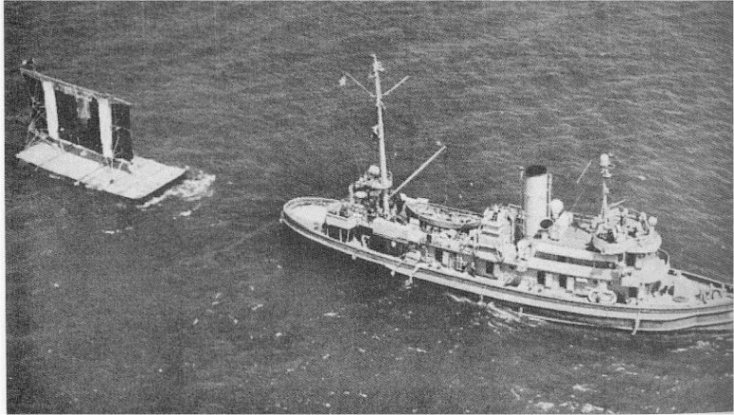 |
| Typical towed target back in the day - with a longer towrope, of course... |
The target was dragged very slowly by the launch at the end of a long towline, and our intrepid gunners opened fire at a range of perhaps half-a-mile. As the battalion’s Intelligence Section, we were designated to study the shots through field glasses and keep score of the hits and misses.
It was sobering to watch. The first shots from our gunners splashed well beyond the huge white target. The next series of shells sent spray shooting up well short – and well behind the target. The following blasts were well to the right . . . in fact, closer to the towing launch than the target. And so it went for the next half-hour as our 25-pounders boomed away.
Our teams of sweating gunners kept blasting, and the Mediterranean Sea absorbed a lot of punishment with spray flying up all over the place as the shots thundered out . . . but that large and taunting target escaped without a scratch.
Eventually, the Navy decided in their wisdom (and no doubt eager to see their launch come back unscathed) to cut the target loose and let it quietly and slowly drift across the bay. There it sat, gently bobbing in place, as juicy and inviting a target as you’re ever likely to see. And only then did our valiant gunners manage to send a couple of shells flying through the canvas structure.
There was a muted cheer from the ranks of our artillery support crew. When this happened the “Cease Fire!” order was given, our 25-pounders fell silent, and we were left to dwell on the thought that if that massive, almost stationary target had instead been a flock of Russian T-52 tanks racing towards us. . . . well let’s just say it would not have been pretty.
|
|
 |
 |
I See Trees of Green…
Hugh McGrory |
 |
 |
Red roses too…
Everyone recognises those lyrics - the 1968 song has been covered some 200 times – personally I think the great Satchmo’s version is the best. (Did you know that Louis Armstrong, didn’t refer to himself as ‘Louie’ – he preferred ‘Lewis’?)
Sometimes though, despite the sentiments of the song, when I’m sitting, cogitating, I ask myself “How did we humans manage to make such a mess of everything. There is so much wrong with the world we live in…
- global warming - heat , forest fires, tornadoes, floods
- poverty – amongst the richest countries, the top 1% of people have between 20% and 60% of the wealth, the other 99% of us share what’s left – we live increasingly in a world of rich countries full of poor people
- health – we’re a long, long way from the World Health Organization’s goal of ‘universal health care’
- education – UNICEF says, “Over 600 million children and adolescents worldwide are unable to attain minimum proficiency levels in reading and mathematics, even though two thirds of them are in school.”
I’m sure you could all add several other issues of major importance to the wellbeing of the human race… how about pandemics, extremists of left and right and their attacks on democracy, world armed conflicts (currently, depending on your definition of the term there are between 32 and 110 around the world)…
A couple of years ago I was depressing myself with such thoughts, wondering what kind of world we were leaving to the grandchildren of our grandchildren, when I happened to get an email from Tom Burt. Many of you will know Tom as a schoolmate, or perhaps as the author of several stories in this collection – he has made his home in New Zealand for many years.
It lifted my spirits, and I thought you might like to read, or re-read it:
------------------
Jerry Brown a flight attendant on Delta Flight 15,wrote this story following 9-11:
"On the morning of Tuesday, September 11, we were about 5 hours out of Frankfurt, flying over the North Atlantic.
All of a sudden, the curtains parted, and I was told to go to the cockpit immediately, to see the captain. As soon as I got there, I noticed that the crew had that "All Business" look on their faces. The captain handed me a printed message. It was from Delta's main office in Atlanta and simply read, "All airways over the Continental United States are closed to commercial air traffic. Land ASAP at the nearest airport. Advise your destination."
No one said a word about what this could mean. We knew it was a serious situation and we needed to find terra firma quickly. The captain determined that the nearest airport was 400 miles behind us in Gander,
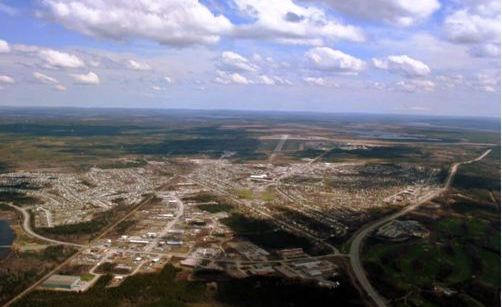 |
Newfoundland. He requested approval for a route change from the Canadian traffic controller and approval was granted immediately -- no questions asked. We found out later, of course, why there was no hesitation in approving our request.
While the flight crew prepared the airplane for landing, another message arrived from Atlanta telling us about some terrorist activity in the New York area. A few minutes later word came in about the hijackings. We decided to LIE to the passengers while we were still in the air. We told them the plane had a simple instrument problem and that we needed to land at the nearest airport in Gander, Newfoundland, to have it checked out.
We promised to give more information after landing in Gander. There was much grumbling among the passengers, but that's nothing new! Forty minutes later, we landed in Gander. Local time at Gander was 12:30 PM!...that's 11:00 AM EST. There were already about 20 other airplanes on the ground from all over the world that had taken this detour on their way to the U.S.
After we parked on the ramp, the captain made the following announcement: "Ladies and gentlemen, you must be wondering if all these airplanes around us have the same instrument problem as we have. The reality is that we are here for another reason." Then he went on to explain the little bit we knew about the situation in the U.S. There were loud gasps and stares of disbelief. The captain informed passengers that Ground Control in Gander told us to stay put.
The Canadian Government was in charge of our situation, and no one was allowed to get off the aircraft. No one on the ground was allowed to come near any of the air crafts. Only airport police would come around periodically, look us over and go on to the next airplane. In the next hour or so more planes landed, and Gander ended up with 53 airplanes from all over the world, 27 of which were U.S. commercial jets.
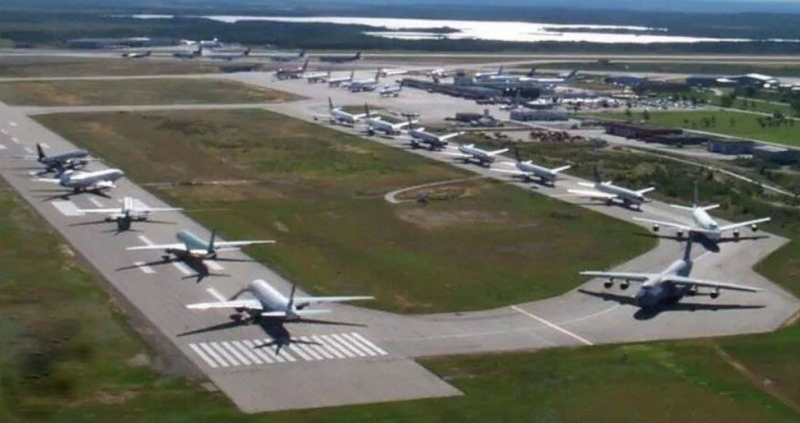 |
Meanwhile, bits of news started to come in over the aircraft radio and for the first time we learned
that airplanes were flown into the World Trade Centre in New York and into the Pentagon in D.C. People were trying to use their cell phones but were unable to connect due to a different cell system in Canada. Some did get through, but were only able to get to the Canadian operator who would tell them that the lines to the U.S. were either blocked or jammed.
Sometime in the evening the news filtered to us that the World Trade Centre buildings had collapsed and that a fourth hijacking had resulted in a crash. By now the passengers were emotionally and physically exhausted, not to mention frightened, but everyone stayed amazingly calm. We had only to look out the window at the 52 other stranded aircraft to realize that we were not the only ones in this predicament.
| |

|
We had been told earlier that they would be allowing people off the planes one plane at a time. At 6 P.M., Gander airport told us that our turn to deplane would be 11 am the next morning. Passengers were not happy, but they simply resigned themselves to this news without much noise and started to prepare themselves to spend the night on the airplane.
Gander had promised us medical attention, if needed, water, and lavatory servicing. And they were true to their word. Fortunately, we had no medical situations to worry about. We did have a young lady who was 33 weeks into her pregnancy. We took REALLY good care of her The night passed without incident despite the uncomfortable sleeping arrangements.
About 10:30 on the morning of the 12th, a convoy of school buses showed up. We got off the plane and were taken to the terminal where we went through Immigration and Customs and then had to register with the Red Cross.
After that, we (the crew) were separated from the passengers and were taken in vans to a small hotel. We had no idea where our passengers were going. We learned from the Red Cross that the town of Gander has a population of 10,400 people and they had about 10,500 passengers to take care of from all the airplanes that were forced into Gander! We were told to just relax at the hotel and we would be contacted when the U.S. airports opened again, but not to expect that call for a while. We found out the total scope of the terror back home only after getting to our hotel and turning on the TV, 24 hours after it all started.
Meanwhile, we had lots of time on our hands and found that the people of Gander were extremely friendly. They started calling us the "plane people." We enjoyed their hospitality, explored the town of Gander, and ended up having a pretty good time.
Two days later, we got that call and were taken back to the Gander airport. Back on the plane, we were reunited with the passengers and found out what they had been doing for the past two days. What we found out was incredible.
Gander and all the surrounding communities (within about a 75 Kilometre radius) had closed all high schools, meeting halls, lodges, and any other large gathering places. They converted all these facilities to mass lodging areas for all the stranded travelers. Some had cots set up, some had mats with sleeping bags and pillows set up.
ALL the high school students were required to volunteer their time to take care of the "guests." Our 218 passengers ended up in a town called Lewis Porte, about 45 kilometres from Gander where they were put up in a high school. If any women wanted to be in a women-only facility, that was arranged. Families were kept together. All the elderly passengers were taken to private homes.
Remember that young pregnant lady? She was put up in a private home right across the street from a 24-hour Urgent Care facility. There was a dentist on call and both male and female nurses remained with the crowd for the duration.
Phone calls and e-mails to the U.S. and around the world were available to everyone once a day. During the day, passengers were offered "Excursion" trips. Some people went on boat cruises of the lakes and harbours. Some went for hikes in the local forests. Local bakeries stayed open to make fresh bread for the guests.
Food was prepared by all the residents and brought to the schools. People were driven to restaurants of their choice and offered wonderful meals. Everyone was given tokens for local laundromats to wash their clothes, since luggage was still on the aircraft. In other words, every single need was met for those stranded travelers.
Passengers were crying while telling us these stories. Finally, when they were told that U.S. airports had reopened, they were delivered to the airport right on time and without a single passenger missing or late. The local Red Cross had all the information about the whereabouts of each and every passenger and knew which plane they needed to be on and when all the planes were leaving. They coordinated everything beautifully. It was absolutely incredible.
When passengers came on board, it was like they had been on a cruise. Everyone knew each other by
name. They were swapping stories of their stay, impressing each other with who had the better time. Our flight back to Atlanta looked like a chartered party flight. The crew just stayed out of their way. It was mind-boggling.
Passengers had totally bonded and were calling each other by their first names, exchanging phone numbers, addresses, and email addresses. And then a very unusual thing happened...
One of our passengers approached me and asked if he could make an announcement over the PA system. We never, ever allow that. But this time was different. I said "of course" and handed him the mike. He picked up the PA and reminded everyone about what they had just gone through in the last few days. He reminded them of the hospitality they had received at the hands of total strangers. He continued by saying that he would like to do something in return for the good folks of Lewis Porte.
He said he was going to set up a Trust Fund under the name of DELTA 15 (our flight number). The purpose of the trust fund is to provide college scholarships for the high school students of Lewis Porte. He asked for donations of any amount from his fellow travellers. When the paper with donations got back to us with the amounts, names, phone numbers and addresses, the total was for more than $14,000! The gentleman, an MD from Virginia , promised to match the donations and to start the administrative work on the scholarship. He also said that he would forward this proposal to Delta Corporate and ask them to donate as well. As I write this account, the trust fund is at more than $1.5 million and has assisted 134 students in their college education.
I just wanted to share this story because we need good stories right now. It gives me a little bit of hope to know that some people in a faraway place were kind to some strangers who literally dropped in on them. It reminds me how much good there is in the world."
In spite of all the rotten things we see going on in today's world this story confirms that there are still a lot of good people in the world and when things get bad, they will come forward."
------------------
Strangers helping strangers - when I read this, I think of the people of London during the eight months of the Blitz of 1940/41, the people of Ukraine defending their country against rapacious Russia, the volunteers flocking to Maui to help after the recent devastating fires – so many examples.
I hear babies cry
I watch them grow
They'll learn much more
Than I'll ever know
And I think to myself
What a wonderful world.
I so hope that Satchmo got it right, and that my misgivings are unwarranted…
Thanks again, Tom Burt, for sending me the article.
|
|
 |
 |
Time Just Flies By
Bill Kidd |
 |
 |
When I was around six years old, in Dundee, Scotland, I remember being on the top deck of the Broughty
Ferry bus and my father pointing out to me the seaplane base at Stannergate. Like most small boys in the early days of the war I was fascinated by aeroplanes, and I was excited to see to see several seaplanes at once. It was many years later that I learned that the aeroplanes that I saw that day were actually amphibians, known as the Supermarine Walrus and that they were probably the ugliest machine to fly operationally in WW2. It was later still that I learned that the designer was R. J. Mitchell who also designed what was arguably WW2’s most beautiful aeroplane, the Spitfire.
| |
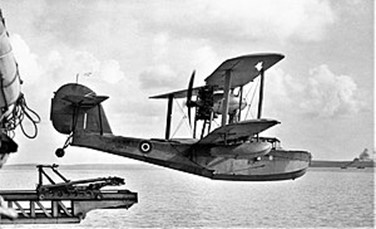
|
Dundee was an important location for seaplanes in both World Wars. In WW1 seaplanes were located at RNAS Dundee which was established at the Stannergate. Although their main function was maritime reconnaissance, they also saw action against the German Zeppelins that were attacking Northern England. Between the wars the site was largely unused but was recommissioned as a satellite unit of HMS Condor the Fleet Air Arm base in Arbroath and designated the imaginative name of HMS Condor II . The aircraft based at Stannergate were mainly used for aircrew operational training. Flights by the Dundee based Walrus aircraft often involved maritime rescue and anti-submarine operations. The base was closed in June 1944 before WW2 ended and it is now an industrial site without any trace of its glory days! A fuller and probably more accurate account of the history of the Stannergate base can be found on the Dundee Transport Museum website.
Although I have no clear recollection of it my parents told me that I had been taken up to the viewpoint near the entrance to Balgay Park to see another highlight of Dundee’s seaplane history. On Thursday 6th
October 1938 as many of Dundee’s population as could occupied vantage points along the Tay to watch the seaplane Mercury piggybacked on to the flying boat Maia take off from the river at the commencement of an attempt to break the non-stop distance record for a flying boat. See short video here.
The pilot Captain Donald Bennett and Ian Harvey, his co-pilot, would try to reach Cape Town before touching down and they anticipated being in the air for around 48 hours. Bennett, an Imperial Airways flying boat Captain, was no stranger to long distance seaplane flights. In the previous July he had piloted Mercury, initially attached to Maia, to make the first non-stop, commercial cargo flight across the Atlantic from Ireland’s mid-west coast, to Montreal, a distance of 3,175 miles, and he was therefore the natural choice for the record distance attempt.
To undertake the flight to South Africa the Mercury would have to carry an enormous amount of fuel. This would be stored in the wings and floats of the aircraft. The biggest consumption of fuel occurs during lift-off, and this is the reason that Mercury was attached to the Maia for take-off. Once the combination was airborne and at cruising height Bennett would separate Mercury while Maia returned to her base. This is exactly what happened that October morning. After making a perfect take-off the aircraft separated somewhere between Dundee and Forfar and carried on with their journeys. Damage to one of the engine cowlings on Mercury occurred during separation. This had an adverse effect on fuel consumption and ultimately meant Bennett had to end the journey some 390 miles short of their target and set down in Alexander Bay on the Orange River. Despite not reaching Cape Town they had set a world distance record of 6,045 miles for a non-stop flight by a seaplane, a record that still stands today. There is a commemorative memorial to the historic flight located near to the Dundee V&A Museum. This was unveiled in 1997 by Captain Bennett's wife, Lys.
Captain Donald Bennett (1910-1986) was born in Queensland Australia. In 1930 he became a cadet in the Royal Australian Air Force (RAAF) and in 1931 he was accepted for a short service commission with the RAF and settled in the South of England which became his home for the rest of his life. He trained as a pilot and on leaving the RAF in 1936 he joined Imperial Airways, flying to Europe and Africa then flying Empire Flying Boats to India and South Africa. In 1938 he took charge of the Mercury and Maia project described above. Bennett continued with Imperial Airways until September 1941 when he was commissioned in the RAF as an acting Wing Commander. In April 1942, his aircraft was shot down by ground fire over Norway. Bennett and several of his crew evaded capture and reached neutral Sweden. After release from internment, he returned to Britain and was awarded the Distinguished Service Order.
In July 1942, Bennett, now acting Group Captain, was directed by Air Marshal Sir Arthur Harris to form and command the Pathfinder Force within Bomber Command. The aircrew of Pathfinder aircraft were expert navigators, and their function was to use fast aircraft to mark targets with flares to guide the following bomber formations to the correct target. This proved to be a very successful strategy and greatly improved the overall effectiveness of RAF Bomber Command. By the end of WW2 Bennett at the age of thirty-five was an acting Air Vice-Marshall. Bennett left the RAF in 1945 to successfully contest a parliamentary by-election as the Liberal Party candidate. His Parliamentary career was a short one, he lost his seat in the General Election later that year and despite several attempts over the years he never managed to return to Parliament. The remainder of Bennett’s life was taken up with a variety of business ventures, not all of them successful. He published a book about the Pathfinders that resulted in a libel case. He continued his interest in politics in a fairly controversial manner, resigning from the Liberals in 1960 over the Common Market. He died in September 1986 aged seventy-six. A varied and exciting life but perhaps not achieving as much as he had hoped.
And to think that all my interest in this came from a Sunday outing to Broughty Ferry!
|
|
 |
 |
A Slow Learner
Hugh McGrory |
 |
 |
I can remember, as a young parent, every now and again looking at my very young children and wondering how the human race manages to perpetuate itself given that children are so helpless at that age and surrounded by all kinds of accidents waiting to happen…
Case in point: When my son Mike was around a year old (plus or minus a couple of months) we decided to give him a baby walker to help him learn to walk. For those not familiar with them, baby walkers are those wheeled devices that allow kids to push themselves around before they can walk (see photo).
We lived in a home (row house, rented) that was slightly unusual in design (see photo). Unlike its
neighbours, it was all on the second floor – we entered a small hallway at ground level and had to immediately climb a flight of stairs to get to the living quarters. I quite liked it, though it was a cold house – the winter wind in Scotland used to howl through the close below.
Mike took to the walker with enthusiasm (his mother liked it too) and he was soon darting around in it. He seemed very happy piloting it around exploring his environment. One day he escaped from the living room while our attention was elsewhere, and we heard a bumpity-bumpity bump, bump, bump noise
| |
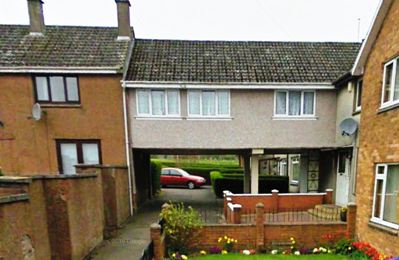
|
and then screams… The little guy had done a Thelma and Louise right off the end of the hall and down the stairs to the ground floor! Miraculously he didn’t seem to have any injuries.
I said that I’d build a little gate at the top of the stairs to make sure it didn’t happen again and put a temporary obstacle at the top of the stairs in the meantime.
Shortly thereafter Evel Knievel was at it again… you guessed it, more bumpity-bump bump and screaming. So much for my temporary barrier… Once again, he came through it quite unhurt – don’t ask me how!
I immediately went out, bought some wood, and made a gate – as I should have done right after the first escapade! So, despite the fact that I once again showed that I’m a slow learner, we were lucky… this could easily have been a real tragedy.
Postscript
About baby walkers: In the 1970s, when the market for infant walkers was booming, babies were frequently showing up in emergency rooms with injuries like broken bones, concussions, and skull fractures. Such walker-related injuries can be severe and can include brain injury, burns, poisoning, and drowning.
The US and UK addressed the problem by creating design regulations that manufacturers have to adhere to. This has much reduced accidents, though some 9,000 kids are still hurt each year in the US.
Canada took a simpler, more direct approach: As of April 2004, Health Canada, the government’s health regulator, banned the sale of baby walkers entirely. Anyone caught selling or importing baby walkers, even used ones, faces very heavy fines or even jail time. Try to cross the border with a baby walker and you face detention.
Mothers loved baby walkers – they kept the baby interested and allowed the mother to get on with her chores – they also helped infants to learn to walk – so the advertising said… In fact, pediatricians know that the opposite is true.
An infant has to master two main skills to be able to walk. First, they have to figure out how to get up on their feet (initially by crawling to the nearest chair, or sofa or friendly leg, and holding on to pull themselves up). Then, they have to learn how to keep their centre of gravity over their feet. Neither of these skills can be learned from a walker, so they actually delay the child’s development.
|
|
 |
 |
Scots ‘Fathers’ of Australia
Part 2 of 3
Brian Macdonald |
 |
 |
Major General Lachlan Macquarie, CB; 31 January 1762 – 1 July 1824 – The Scots ‘Father of Australia’
Part one
To continue this series on three Scots who have had a major impact on Australia, I offer you Lachlan Macquarie, the most ‘Scottish’ of the three for he was born in Scotland, married two Scots ladies and died in Britain, unlike John Macarthur, who was born in England of Scots parents and died in Australia. Macquarie rests in his family tomb on Mull, in the Inner Hebrides. The third member of the trio is the least ‘Scottish’ of the three, boasting one pair of Scottish grandparents but having been born in the late 19th century in Australia of first-generation Australian parents. His name is Robert Gordon Menzies, a 20th century man, no early colonist, very different from the earlier two. His story will come later.
Lachlan Macquarie is another Scot who had a decisive effect on the early development of Australia from a penal settlement into a well-governed, democratic land. He is often labelled ‘The Father of Australia’ for his progressive initiatives during his eleven years as the fifth Governor of the Colony of New South Wales (NSW) from 1810 till 1821, following the debacle of the unfortunate William Bligh, who was cast adrift by his own mutinous crew from his British Naval command, HMS Bounty, and then deposed as Governor of the Colony of New South Wales, 17 years later.
Macquarie was born in 1762 on the tiny island of Ulva, west of Mull in the Inner Hebrides, of a father of the same name, a carpenter and miller and a poor, one-third tenant farmer of the Duke of Argyll. Macquarie’s father was a cousin of the last chief of the Clan Macquarie. His mother was the sister of the chieftain of Lochbuie in Mull, by name Murdoch MacLaine. It was a poor upbringing but not unusual for the era and the place. He may have spent time as a student at Edinburgh’s prestigious Royal High School (founded in 1128 and one of the oldest schools in Scotland) but this is not certain. He would have had a sound, basic, Scottish parish education.
Macquarie became an ensign in the British Army’s 84th Regiment, the Royal Highland Emigrants, commanded by his cousin, colonel Allan Maclean, in 1777, at age fifteen. His uncle, Murdoch MacLaine, was in the same regiment, a common family linkage. After seeing action in America and Jamaica, Macquarie, now a lieutenant, was repatriated to Scotland on half-pay reserve. With the help of his cousin, now General MacLean, he soon re-enlisted for active service as a senior lieutenant, aged twenty-six, embarked for Bombay (Mumbai) and, shortly thereafter, was promoted to captain.
Lachlan did well in the Indian Wars and rose rapidly, becoming a brigade major and saving enough money to pay off the debts he had left behind in Scotland on his re-enlistment. In 1793 he married Jane Jarvis, the heiress daughter of a former chief justice of Antigua in the West Indies, then a British possession. Sadly, Macquarie’s 24-year-old wife died in Macao of consumption (tuberculosis), leaving him a sizeable inheritance. He continued his military progress, gaining promotion and prestigious posts. In one extra post he acquired, he had the emolument paid to its previous occupant, a friend in poor circumstances, a clear sign of his affluence and sense of rightness.
Appointed commanding officer of the 86th Regiment of the British Army, he took leave to return to Scotland and take possession of land on Mull which he had been able to buy. Now a lieutenant-colonel, he dreamed of being a Highland Laird and of having an estate, which he would name for his late wife, and could leave to his descendants. Returning to London, he moved easily in society and met royalty.
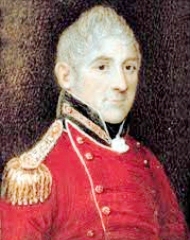
|  |
A swift return to service in India came next, followed by a return to England to assume the command of the 73rd Regiment
Macquarie married again, to a kinswoman, Elizabeth Campbell, some years his junior, whom he had met on Mull and asked to wait for his return from India. The regiment was soon posted to the colony of New South Wales, with its general, Miles Nightingall, to become the governor in place of fourth governor, William Bligh, who had, ignominiously, been mutinously deposed by corrupt New South Wales Rum Corps officers. The government in Westminster was anxious
|
 |

|
| Lachlan Macquarie |
 |
 |
Elizabeth Macquarie |
to see order restored in the young penal colony.
When Nightingall declined the position, Macquarie applied for the role and, supported by such dignitaries as the Duke of Wellington, who went on to defeat Napoleon at the battle of Waterloo and Lord Castlereagh, who held many high offices in Britain, was granted it. In 1809, the forty-seven-year-old Lachlan Macquarie and his second wife, Elizabeth, set sail for Terra Australis. Ironically, they crossed paths in Rio de Janeiro with the two leading mutinous Rum Corps officers, Colonel George Johnston and John Macarthur, the Merino sheep breeder, heading back to England, thus relieving the new governor of the problematic task of arresting them as his first duty. Macquarie sailed into Botany Bay at year’s end 1809 and was sworn in as its governor on New Year’s Day, 1810, a propitious day for a Scot. Ellis Bent, a lawyer, was a fellow traveller on the voyage to Australia, to take up his appointment as the first qualified senior legal officer of the colony. He and Macquarie, for now comrades, would one day cross swords.
The new governor took quick action to reinstate in control of the Rum Corps those upright officers who had not participated in the ‘dethroning’ of William Bligh and to ensure Bligh’s return from his imprisonment to Sydney, as it was now being called. Bligh and the disgraced Rum Corps were bundled off back to Britain as soon as possible and Lachlan Macquarie got down to governing the colony, restoring stability, and imposing civilian rule.
Lachlan Macquarie’s place in Australia’s history is marked by a period of development in many fields. Till then the colony had been run by the corrupt Rum Corps officers who overrode the civilian governors nominally in charge. His tenure ran from 1810 till 1821, a longer period than any other governor and one that saw the start of a civilian legal structure and growth in many areas. He found that the colony, despite the grip of the Rum Corps officers, was thriving. The early years of his rule saw the restructuring on an efficient basis of all the public departments. In this he drew on his experience as a staff officer and the administrative posts he had held in India and elsewhere. Previous governors, as naval officers, had not had this breadth of experience. Customs duties were imposed. Regular markets and fairs were established. The strengthened Police Force became the controller of public revenue. A coinage was established to replace the ad hoc barter and notes of hand system which had served till 1813. Three years later, Macquarie established the first bank, contrary, it may be said, to the wishes of the government in London.
Macquarie encouraged farmers to improve their practices, adequate food production being a necessity and cycles of gluts and famines the rule. He actively toured the outlying parts of the growing colony and encouraged exploration, the result being that the explored area was many times greater on his departure than on his arrival. The Blue Mountains, part of Australia’s Great Dividing Range, which separates much of the continent’s east and south coasts from the inland, were crossed during his tenure. This led to a road being built from the coast to the large inland settlement of Parramatta (now a major suburban centre of western Sydney) fifteen miles to the west and beyond to the inland city of Bathurst being planned over the mountains. Macquarie made two visits to the southern, island colony of Van Diemen’s Land (Tasmania) and founded the coastal city of Port Macquarie, 240 miles north of Sydney and another coastal city fifty miles south of Sydney, which became Wollongong.
An Army barracks was very quickly built and a general hospital, funded by what is now called ‘public-private partnership’, by granting the developers a trade monopoly over the importation of alcohol, the consumption of which Macquarie disapproved of but which he found it impossible to eliminate, as others have found before and since in other societies. His decision to legitimise and control alcohol sales was shrewd. He had strong views on public morality and passed laws to ‘encourage’ marriage rather than informal cohabitation and the keeping of the sabbath. Church parade became obligatory for convicts working for the government. The introduction of liquor licensing helped to reduce the number of drinking establishments although ‘sly grog shops’ (clandestine, unlicensed, drinking places) persisted.
But the attention to public morality was not all one way. Macquarie set up a number of schools throughout the colony. An orphanage was established, a Benevolent Society and a Bible Society. Organised horse-racing was allowed, the enjoyment of which is still high in Australia to this day. A blind gubernatorial eye was turned to the fact that several high officials were living without benefit of wedlock. A striking major reform of Macquarie’s was to make it possible for convicts who had served their sentences and were acceptable as citizens to be restored to their former rank in society as free people and to own businesses. Freed convicts were known as ‘emancipists’ and this term was also used for those who held the belief in such a policy. An Oxford-educated lawyer transportee was appointed as poet laureate of the colony, a remarkable position for a convict settlement. It also became possible for time-expired convicts to be granted land which they would work as owner-farmers. Emancipists were appointed as magistrates and Macquarie had them to dine at his table.
Francis Greenway (also Greenaway), transported for forgery, was an architect and was appointed by the governor as the first government architect, to design and oversee the building of gracious public buildings. Many of his works still stand and are on UNESCO’s World Heritage and New South Wales Heritage Registers. Convict labour was used by Greenway as was the case with public works in the Tasmanian colony. The extensive public building program initiated by Macquarie gifted modern Sydney many fine late Georgian and colonial buildings that adorn the city today. Like Macquarie, Greenway’s image has appeared on an Australian banknote.
Before taking up his role, Macquarie had been briefed by Lord Castlereagh and his policies generally followed Castlereagh’s strictures. Even so, Lachlan Macquarie’s progressive, emancipist policies were not well received by the colony’s growing middle class and free settlers, who saw them as an erosion of their privileged position. Some law officers and preachers refused to serve, work, or associate with emancipated convicts. Among the disaffected were Ellis Bent, who had arrived on the same ship as the governor to be the senior law officer and Colonel George Molle, a former friend and military colleague of Macquarie, who came with the 46th Regiment in 1814 to take up the post of lieutenant-governor.
To be continued
|
|
 |
 |
No Matter How Bad Things Are…
Hugh McGrory |
 |
 |
… with little thought you can always make them worse!
This truism has proved itself to me on many occasions - often associated with attempts to repair household appliances – but in other circumstances too…
In the mid-seventies I left work one evening in Toronto and walked to my car. It must have been spring or fall since I had a raincoat with me – not sure whether I was wearing or carrying it. When I got to the car, I opened the trunk put my briefcase in, threw my raincoat in after it ,and slammed the lid.
Instead of the usual ‘thunk,’ I heard a different sound, and the lid opened up a few inches. I pushed it down again - same result. Now with hindsight, I think I may have had a trying day and was in a bad mood. Instead of looking to see what was ‘broke’ I chose to slam it a few more times…
Each time I got the same result, so I finally opened the lid completely to investigate. I found that when I threw my coat in, I didn’t get it quite far enough, and the hem had landed over the closing mechanism.
When I slammed it shut the first time, the protruding part of the lock had pushed the cloth down and punched a neat hole in it. As if this wasn’t bad enough, it seems that every time the lid lifted up the raincoat was dragged sideways about an inch or so then fell back into position ready for the next attempt to close. The result was a line of five or six identical holes stitched along the hem. You have to laugh, don’t you…
Not, mind you, what I was doing, that weekend, when I was out buying a new raincoat!
|
|
 |
 |
Sphincter Practice in the Night
Gordon Findlay |
 |
 |
One of our Intel duties within the regiment and within 3rd Infantry Division was the unified radio ‘net’. This was a radio link which was maintained between lst H.L.I. and the other units which made up 3rd Infantry Division.
While in the Middle East we were part of a larger military group which included a 5th Royal Marine regiment, a R.E.M.E. (Royal Electrical & Mechanical Engineers) company, an R.A.S.C. (Royal Army Service Corps) component, and a regiment of Indian Gurkhas. All of these individual units maintained a radio link, and while we were all stationed in or around Tobruk, we kept in touch.
The idea was: in the evening each of these units checked in to a central call-in at 3rd Infantry Div. at 18.00 hours, 19.00 hours, 20.00 hours, etc. right through the night, to make sure all was peaceful and calm. We had a 3-ton Army Bedford truck which was fitted out with our most powerful radio.
The duty operator (provided by Intelligence, of course) was on duty for 4 hours at a stretch. His job was, at the appointed hour, to call up Headquarters at 3rd Inf. Div. ( “Three Item Dog. This is One How Light Item… Situation normal. Out.”) Pretty standard and simple stuff.
But. There’s always a “but.”
Our camp at Tobruk was well outside the old city itself on the coast, but we attracted attention . . . mostly from all the local dogs – and there were literally hundreds of them roaming around. They were all hungry most of the time, and when our camp was set up with a simple barbed wire perimeter, the dogs smelled opportunity... and food for the taking.
We employed some local Libyans to do the ugly work of food preparation: peeling spuds, trimming veggies, opening cans, and so forth. But we also employed them to do most of the cleanup, and let’s just say they weren’t the most fastidious fellows in that part of the world. A whole lot of food was carelessly tossed into the crap cans and naturally, this quickly attracted the dogs of the area.
These animals in the Middle East are called “pye” (for pariah) dogs. They don’t belong to anyone, they roam free, and they are hardened in their fight for survival among other dogs like them. In short– they are a force to be reckoned with!
Word began to spread within our encampment that there was a very aggressive pack of pye dogs roaming around, led by one massive white wild dog. The story was that one of our Libyan cooks had been out at the crap cans disposing of some food when he had seen a huge white pye dog at the head of a pack of wild dogs, and that the big white pye dog leader had leapt, snarling, at the cook and made him drop his pan of leftovers. The experience had terrified the cook, who envisioned having his throat torn out by this rogue animal.
The Libyan had run from the cookhouse and had quit on the spot. Other cookhouse workers supposedly also spotted this huge white pye dog, and at least a couple claimed that it had attacked them. Or so went the story…
Anyway, yours truly drew the midnight to 0400 hours shift one night on radio watch. Our radio truck was parked at the far edge of the wire perimeter, out on its own, where there would be no other radio or electronic interference. I relieved my opposite number and settled into the 3-ton Bedford, checked the radio, then settled in on the padded chair for the usual dreary watch where all you have to look at are the illuminated dials of the radio transmitter and the open square of darkness at the back of the truck.
As I recall, I had completed one routine radio check at 0100 hours, and was sitting trying not to doze, when I suddenly heard a heavy thump above my head on the canvas cover of the truck. I was startled, and looked up to see the protruding outline of four feet on the canvas above me – and as I looked up I saw these bumps in the canvas slowly moving towards the open back of the radio truck.
Instantly I thought of the massive white rogue pye dog. Mygawd! That bloody thing thinks there’s food in this truck and is about to leap in to claim it! I had visions of Corporal Findlay found in the morning in a pool of his own blood, his throat ripped to shreds.
I had no weapons of any kind in the truck. But, with my heart hammering in my chest, I slowly unbuckled my Army web belt (which had a substantial brass buckle on the end) and got up off the chair, which I then held in my other hand. (We all have childhood memories of lion tamers doing their work with a chair in one hand and a whip in the other…)
I stood there, in the darkness of that truck, and watched as those disconnected feet above me slowly advanced down the canvas and towards the open back. Would it look down over the canvas, see me, decide to chance it, and leap in? Or would it just leap in looking for food?
It seemed to take forever, but I watched those imprints advance to the very back of the canvas cover… my mouth dry… my Scottish sphincter being put to the test… then just as suddenly there was a flash of white as the animal on the roof of the truck leapt past the open back and into the night.
Had it been the huge white pye dog pack leader? Had it been casing our radio truck as a possible food source? Had I just escaped a battle or mauling by sheer good luck? I’ll never know . . . but what I do know, and remember, is that it took my heart and my blood pressure a few minutes to return to normal, and that, come 0200 hours, I was able to croak over the Division ‘net’: “Three Item Dog. This is One How Light Item. Situation normal. Nothing to report. Out.”
|
|
 |
 |
Slaving Over a Hot Stove...
Hugh McGrory |
 |
 |
Cooking - one of the many things in life that I can’t do well…
Case in point… Many years ago, when Sheila and I were both working long hours, we didn’t always make it home at the same time, and so the evening meal would be whatever we could find in the fridge or the pantry to throw together.
On one such occasion I got home first and, being hungry and knowing that she would be late, decided to ‘do for myself…’
When she came in, I asked her what she wanted to eat and she said that she’d decide later - just wanted to put her feet up and watch some TV for half an hour, so I carried on preparing my meal.
Our living room had an alcove for the dining table which in turn had a door to the kitchen, so she was able to keep an eye on me as she sat on the couch.
After a bit she said “You walk back and forward a lot…” I pointed out that I’d never had any schooling in cooking whereas she was taught by her mother from a pre-teenager. In particular, I said that I often had trouble trying to get everything to come together, hot, at the right time.
She asked what I was making, and I said, “boiled eggs and toast.”
She looked at me for a silent moment then erupted into a gale of laughter. I made matters worse by saying something about timing the tea, and the hardness of the eggs, and the colour of the toast… This made her laugh even more - and even I realised how ridiculous I sounded...
At least I can say that I made her day! Sadly though, my cooking skills haven’t improved much since then…
|
|
 |
 |
Intensive Culture
Bill Kidd |
 |
 |
In some of my past contributions I have referred to the time when Muriel and I lived in Caithness in the ‘60s, and how we often share happy memories of the seven years that we spent there. It was a busy time for us, both professionally and socially. However, having been used to the facilities available to us in Dundee, we did miss having a wide selection of shops and although there was a great deal of quality amateur theatre and music available to us in Thurso we did miss going to the “Rep” in Nichol Street and to the orchestral concerts in the Caird Hall. In order to fill these gaps in our lives we decided that when we could afford it, we would take a “Cultural” trip to London where we could sate ourselves on those missing elements.
Our first sortie to the bright lights would be carefully planned, our budget was very tight, but we wanted to cram in as much as we could in the six days that we would have there. We decided that the optimum time for our trip to London would be mid-July before the English schools broke up towards the end of the month. This would allow us to spend a week in Dundee to visit parents and friends before setting off for London.
In March we started to think seriously about the best way of going about this adventure. Neither looking at the adverts for coming events in the Sunday Times nor seeking the advice of colleagues and friends who came from the London area were a great deal of help, the latter knew even less about the London scene than we did! We knew that we could easily book theatre tickets in advance but as we wanted to see a lot of shows during our stay, advance booking for more than a couple of performances would limit our freedom to take potluck and take advantage of what was available on the day.
Having decided on this somewhat haphazard approach we thought that it would be prudent to arrange our accommodation. Clearly this had to be somewhere fairly central and very cheap. Two areas sprung to mind, Kings Cross, and Paddington. After taking advice from some, more worldly, friends I learned that one does not take one’s wife to a cheap hotel near Kings Cross but that there were some suitable hotels near St Mary’s Hospital which was close to Paddington Station. After a quick trip to the local library and the use of its London Hotel Guide and a London Tourist map, I identified a number of possible hotels that I could contact shortly before we set out for the big city. Our only other piece of advance planning was writing to the BBC seeking audience tickets for TV and radio shows for that week, but we only received two for a radio game show.
At last, the great day arrived, and we set off from Dundee Tay Bridge Station on the overnight train for King Cross. After an uneventful journey we arrived at our destination around 6.30 am and had some breakfast in the station buffet. As we had suitcases, we decided that we should go to the hotel and leave them there. We did realise that our room would not be available until after 1.00 p.m. but if we registered and paid our deposit, we would be free to explore. Neither of us had any experience of London so it became a bit of a shock to us to discover how busy the Underground was at 7.00 a.m. on a Monday morning and that tourists carrying suitcases were not exactly welcome. After some fruitless requests for information from station staff we eventually found ourselves staggering off the Bakerloo Line at Paddington. I immediately went to W H Smith and purchased that essential little book the London A-Z and from the information gleaned from this we made our way to our hotel.
The hotel lived down to our expectations, it was clean, impersonal and the only amenity offered was the breakfast room. Although there was no charge for using the WC, a bath had to be booked in advance and
three shillings was added to your bill. By the time we had deposited our luggage and made for Piccadilly Circus via the Bakerloo Line it was mid-morning and time to do some exploring. We spent the rest of the first morning and early afternoon of our holiday just wandering around Central London and in the process managed to get two upper circle tickets for that evening’s performance in the Strand Theatre of a Funny Thing Happened on the Way to the Forum starring Frankie Howerd, a great favourite of mine. We returned to our hotel about 3.00 p.m. to book in and freshen up then have something to eat and return to the theatre in time for the theatre at 7.30 p.m.. We enjoyed the show and got back to our hotel absolutely shattered at about 10.30 .pm.
On Tuesday morning having breakfasted and enjoyed six shillings worth of baths we set off again to see the sights. We agreed that our aim was to enjoy the facilities available to us without exhausting ourselves so today was going to be less frenetic so why not a visit to the National Gallery?
|
 |
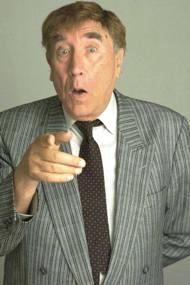
|  |
 |
Frankie Howerd |
 |
So off we go on the tube to Trafalgar Square and by 10.30 a.m. we were looking at least some of the wonderful pictures on display. We left the Gallery at about 2.30 p.m. and sought out some lunch before getting tickets in the “Gods” for a play at a nearby theatre, both picked at random. After a quick trip back to our hotel for a freshen up we were off again for some exploration before enjoying the easily forgotten play at the equally forgotten theatre. After the theatre we enjoyed an inexpensive meal nearby before heading back to the hotel.
Having now established some sort of routine we stuck to it for the rest of our stay and managed to take in

|  |
Robert and Elizabeth, a musical starring Keith Michel who later found fame as Henry VIII on TV; Wait a Minim, a hilarious review at the Fortune Theatre; a wonderful As You Like It at the Regent’s Park Open Air Theatre where Muriel was thrilled to find Patrick Troughton sitting in front of her! We also managed a lunch time concert at the Wigmore Hall and to make use of the BBC radio game show tickets, this turned out to be based on tennis scoring and was so memorable and complex that I can’t recall who was on it or what it was called. By the end of the week we
|
 |
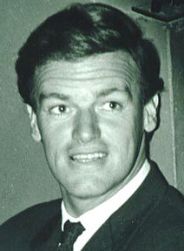
|
| Patrick Troughton |
 |
 |
Keith Michel |
had become expert in the use of the underground system and reached culturally sated status. We returned exhausted but happy to our busy social life in Thurso with excellent bragging rights.
We repeated the exercise again in July the following year but at a less frenetic pace and were able to take in a couple of Promenade concerts and by a simple ‘phone call to the BBC Ticket Unit, a TV show as well. Two years later we moved to Berkshire, only an hour or so away from London and very near to Oxford, each with its theatres, museums and concert halls, the strange thing is, we only very rarely went near any of them!
Does this mean that absence really does make the heart grow fonder?
|
|
 |
 |
Escape from El Adem
Hugh McGrory |
 |
 |
In a recent story about his period of National Service in the army, Gord Findlay mentioned arriving in Tobruk, Libya, in trucks that had carried them from RAF El Adem, where his regiment had disembarked.
(Some background on Britain’s National Service in Peacetime:
After World War II ended, the country still had an urgent need to keep up high levels of military manpower in parts of the world where Britain had strong ongoing commitments – in Germany, Palestine, and India. The government concluded that these requirements could only be met effectively by continuing National Service in peacetime. This was not, however, popular, especially now that Britain was no longer at war.
So it was with difficulty that Clement Attlee's Labour government persuaded Parliament in 1947 to pass the National Service Act. It came into force in January 1949 and meant that all physically fit males between the ages of 17 and 21 had to serve in one of the armed forces for an 18-month period.
They then remained on the reserve list for another four years. During this time they were liable to be called to serve with their units but on no more than three occasions, for 20 days maximum.
Students and apprentices were allowed to defer their call-up until they completed their studies or training. Conscientious objectors had to undergo the same tribunal tests as in wartime.
In 1950 a further National Service Act lengthened the period of service to two years. During the 1950s national servicemen took part in various military operations in Malaya, Korea, Cyprus, and Kenya.
National Service ended in 1960, though periods of deferred service still had to be completed. The last national servicemen were discharged in 1963.)
I personally was facing the prospect of being ‘called up' in 1960 when my two-year exemption ended. However, towards the end of 1959 the government announced that National Service was to be ended. I remember having two reactions – on the one hand I had thought it might be an interesting couple of years and that I might see a bit of the world; on the other, one or two friends who had ‘been there, done that’ characterised it as “a bloody waste of time”. Which brings me back to El Adem.
Believing that I was going to be called up, I hadn’t thought too much about where I wanted to work afterwards. With conscription ended, I decided that I might find a job abroad somewhere. To cut a long story short, I applied for several positions and the first one I was offered was from an engineering contracting company to work on airfield extensions at El Adem. I accepted their offer then went back to Dundee for Christmas.
While there I met a fellow who had been at university with me, and he said an uncle of his had just returned from a visit to El Adem. He said if I wanted to talk to him, he’d arrange it – and he did. It turned out that his uncle worked for a construction company in Scotland and had been to El Adem to consider the possibility of bidding on a construction project.
He described the place as a “boring hellhole” and said he wouldn’t dream of working there. (Gord Findlay in his tale described it thusly: “ El Adem is surely one of the dirtiest and most depressing parts of Libya... at that time a collection of battered metal structures, the usual perimeter wire, and an airfield surrounded by
discarded oil drums and other detritus.”) The ‘Uncle’ also said that the company he worked for had an opening for a young engineer in Dundee if I was interested.
I considered this new input, realising that his description of El Adem may have been biased by his need to fill a position in his firm… I decided to contact the firm that made me the El Adem job offer. I told them of the description of the site that I had received from someone who had been there, and suggested that they might like to up the salary. Apparently not, since I never heard from them again… I accepted the job offer from ‘Uncle’ and returned to Dundee to work for several years.
In researching this story, I found a description of conditions in El Adem written around the same time (early ‘60s) by an RAF National Service inductee. Here are some of his comments:
------------------
• As we stepped down from the air-conditioned comfort of the TransAir Viscount we immediately became acquainted with the sort of temperatures with which we would have to contend in Libya: although it was in the small hours the gentle breeze wafting over us felt as though it had originated from a hair drier.
• We awoke to an intense all-surrounding brilliant glare. On peeping out of the tent we realised that the brightness was just how one should expect it to be in these parts at 05.00, and we hurriedly fished out the dark glasses.Surveying our surroundings more easily we could see that beyond the tents and control-tower was a thin perimeter wire fence and then open scrubby desert, whilst in the opposite direction lay the majority of the camp. Of more urgent interest was the grim concrete ablutions block which was a hundred yards away across the dusty ground and we were soon experiencing our first saline lather-defeating shower: we later learnt that water for drinking came in a ship from Malta, but water for washing purposes came from an Artesian well within the camp.
• We were warned in all seriousness that sunburn requiring medical treatment was a crime not far short of being a capital offence, and then we were advised of the dangers of scorpion bites. An unexpected hazard was announced next: it seemed that the entire surrounding desert was a minefield left over from the war and that many of the decaying mines had become self triggering. This was the explanation for the mysterious bangs which we might have heard in the night, and therefore we would be most ill advised to ramble outside the perimeter wire.
• We changed into our short sleeved pyjamas by the light of a hurricane lamp, and each put himself, his clothing and shoes into his mosquito net and tucked that in firmly around the edge of the mattress, this being standard anti-scorpion drill. The heat was still overpowering and our little room airless. We quickly found that the most comfortable way to sleep was pyjama-less but loosely covered by a sheet : those sleeping entirely naked found themselves subject to stomach cramps and 'the runs' the next day, as the temperature dropped significantly towards dawn. I should add that the close-mesh mosquito netting provided some measure of cocoon-like privacy besides its intended function of bug protection.
• However, we were not protected from all bugs, for in the morning each of us found that he had suffered a trail of flea bites. Henceforward our sheets received copious doses of the Keatings Powder readily available from the stores, and this was generally effective. One morning we found a huge millipede about six inches long, dead on the floor in a spilt pool of dhobi Daz water. Our knowledgeable MT sergeant who had been in these parts before declared that we had been lucky as it had a dangerous bite.
------------------
All in all, I think I had a lucky escape from El Adem...
|
|
 |
 |
Scots ‘Fathers’ of Australia
Part 1 of 3
Brian Macdonald |
 |
 |
The Scots have a long and proud reputation as successful immigrants. A part of that reputation came about due to historical, economic necessity, when Scots crofters were summarily and often brutally driven off their small patch of land in Scotland to be replaced by sheep and more efficient large-scale production. This was the infamous Highland Clearances of the later eighteenth century, when landlords, often clan chiefs, needed to slash costs and increase income to avoid bankruptcy. In later years of greater affluence, landlords sometimes paid the fares to the British colonies of the Scots they were obliged to evict.
Some went as the result of the need to escape persecution by a ruthless enemy bent on mass punishment and oppression after the 1745 Rebellion. Before the growing need for factory workers in expanding cities, many chose to go to new lands, far from their island home, where they hoped to make a fresh start and a fortune. Most of those were poor, peasant folk but, many had at least the rudiments of an education, thanks to Scotland’s parochial education system and the existence of libraries. The Scots peasantry had a higher education level than the English or the Welsh.
In a later century, Scotland exported engineers and seafarers to the world. Some emigrants were from affluent, educated backgrounds and sought adventure, fame, wealth, discovery, or freedom from the constraints of home. Many Scots immigrants have made significant contributions to young countries. At least two of the signatories of the American Declaration of Independence were Scottish and a good number claimed Scottish descent(1).
I have spent fifty-five of my eighty-three years in my adopted land, Australia, and learned a bit about it on the journey. I want to tell you of three towering Australians, all of whom have been justifiably dubbed “Father” of some significant aspect of life in this country. They all claim Scots ancestry and their tales are worth the telling.
John Macarthur (1767 – 11 April 1834) The Father of the Merino Wool Industry
John Macarthur’s father was a Scottish fugitive from the 1745 Rebellion who escaped to the West Indies. He
did not make a fortune and returned to England. John Macarthur was born in Plymouth. John had an all-consuming drive to rise in society and was ashamed of his father’s lowly trade as a haberdasher and tailor. From biographies of him it is clear he always had an eye on the main chance and a willingness to do what was needed to succeed in his aims. He somehow obtained a commission as a lieutenant in the newly founded British Army New South Wales Corps, a regiment set up to serve at the new colony of Botany Bay in Terra Australis under its governors appointed from Britain. He, his wife, and infant son sailed with his regiment and about one thousand convicts on the Second Fleet(2).
The regiment was commanded by Major Francis Grose, who took every opportunity to increase its power in to the downtrodden convict men and women, throughout the growing colony. Its officers developed a cartel that controlled much of banking, trade, justice, discipline, and general government. Macarthur was up to his neck in it, a veritable Al Capone of his day, who used any and every means to improve his position and wealth in the colony. While maintaining his commission in the Corps, he obtained a grant of forty hectares of land in a good area for soil and water and the free use of convicts to work it. He built his house and rooted

|  |
his future there. He also came into possession, from the captain of the vessel who brought them, who was a crony, of four Merino(3) ewes and two rams, from the first of this breed of sheep to reach Australia. His sheep-breeding vision was established.
|
 |

|
| Merino ram |
 |
 |
Merino ewe and lambs |
Macarthur later found it necessary to travel to London to fight charges of corruption brought by the British government and emerged from this encounter exonerated and granted five thousand acres of land in a prime area of the colony, with a further similar grant to follow, for the purpose of developing a large-scale wool-growing industry. He thus became an early, if not the first, large-scale grazier. While in London, he was also able to buy nine Merino rams from the Royal Flock at Kew. His sheep-breeding and wool-production enterprise went ahead exponentially. Most of the wool was sold to the British government.
A later governor of the colony, naval officer William Bligh(4), attempted, in 1808, to arrest Macarthur and to bring him and his corrupt regimental cronies to justice for their many misdeeds. Such was MacArthur’s power in the colony’s affairs that the outcome was the setting free of Macarthur and the arrest of Governor Bligh by a coterie of the corrupt officers of the Corps(5). Macarthur was becoming the richest and most powerful man in the colony and had left his regiment. Another attempt to court-martial him in Britain failed as he was no longer a serving officer. He later served on the Legislative Council of the colony and continued to wield power for illicit purposes. His financial and political dominance continued for many years.
John Macarthur was legally declared a lunatic in his later years. He died on his sumptuous estate in 1834. He has been commemorated in several ways for his admittedly huge contribution to the Australian economy in
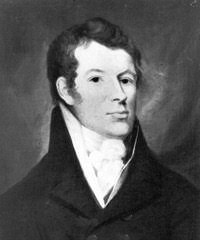
|  |
founding the Merino wool industry, which was a major plank in Australia’s prosperity throughout much of the twentieth century. He was featured on a stamp on the centenary of his death and on a two-dollar note in 1986. A suburb of Australia’s federal capital, Canberra, is named for the family and an electoral division in the federal parliament. Most recently a football club has been founded, Macarthur FC.
The Macarthur story is not complete without mention of his wife, Elizabeth
|
 |
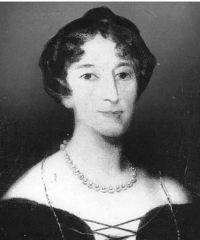
|
| John Macarthur |
 |
 |
Elizabeth Macarthur |
(1766-1850), who outlived him by sixteen years. As the daughter of a wealthy English farmer, she was educated to a good standard of reading, writing and arithmetic. Her letters home to family of the voyage to Botany, a year after her marriage, are a valuable part of the records of the early voyages to the colony. As a woman of education and the wife of an officer, she held a privileged position in the colony’s limited society, although, as her husband’s infamy grew her place in society diminished and most of her later life was spent at Elizabeth farm. During his time in the Rum Corps and on his absences in England, Elizabeth Macarthur ran his household and the growing farm. She was also responsible at such times, as a farm daughter, for the development of the Merino flock and was an active participant in the development of the industry.
John Macarthur and Elizabeth had four sons. The two youngest were born at Elizabeth Farm, the estate Macarthur established and named for his wife. They also had three daughters. Established at the top level of NSW society, advantageous marriages were made, and the family grew in status and influence, which it continued to wield until near the start of the twentieth century. The extensive family, now Macarthur-Stanhams and Macarthur-Onslows, is no longer influential in public affairs in the state of NSW or federally but remains wealthy.
With all his warts, John Macarthur rightly takes his historical place in the development of Australia, as The Father of The Merino Wool Industry.
Footnotes
(1) The number of the fifty-six signatories of the American Declaration of Independence who claimed Scottish ancestry has been said to be as high as forty-one. There were fifty-six signatories.
(2) The Second Fleet reached Botany in 1790, two years after the founding First Fleet, with a quarter of the convict passengers having died on the journey, it being managed by former slave traders, who did not much value human life. Conditions for convicts were appalling, in contrast to Arthur Phillip’s First Fleet, where attempts were made to allow convicts on deck for fresh air and to maintain as good conditions below decks as possible. The Second Fleet earned the soubriquet of ‘The Death Fleet.’
(3) The Merino is a large sheep, known for the high quality and prolific growth of its wool. It originated in Spain.
(4) William Bligh, Royal Navy officer and colonial administrator, has his own colourful career to relate. He was the victim of a mutiny in 1789 while in command of HMS Bounty of the British Royal Navy and was set adrift in an open boat with eighteen loyal men with some provisions. They reached the south-east Asian island of Timor safely, all alive, after an epic voyage of 3,618 nautical miles (6,700 km). He then returned to naval duty. Seventeen years after this adventure, Bligh was appointed Governor of the colony of New South Wales. The mutiny and the later overthrow of the governor by the Rum Corps officers may say something about Bligh’s martinet management style. William Bligh went on to reach admiral rank in the British Royal Navy and died peacefully in London.
The 1962 Hollywood film, ‘Mutiny On The Bounty’, starring the craggy-faced English actor Trevor Howard as the disciplinarian William Bligh and the American Marlon Brando as the mutiny’s leader, Lieut. Fletcher Christian, is a fictionalised version of this historical episode.
The mutinous group of nine seamen hid on the remote Polynesian Pitcairn Island with some kidnapped Tahitians. The somewhat closely-bred descendants of this group still live on Pitcairn and bear the surnames of the mutineer seamen.
(5) This sorry episode was an effective coup d’état and is known as ‘The Rum Rebellion’. Bligh was confined in Sydney, and then anchored off Hobart, the main town of the southern settlement in Van Diemen’s Land (Tasmania), for two years while the military continued to rule at Botany. In 1810 Major-General Lachlan Macquarie arrived from Britain to take over as governor.
The splendidly named Lachlan Macquarie will be the subject of another essay on Scots ‘Fathers’ of Australia.
|
|
In a previous World War II story, Gordon Findlay told of the crash of an aircraft, which, for more than fifty years, he thought was a Spitfire, in Dundee’s Caird Park. It turned out that the aeroplane was actually a Hurricane and sadly the young pilot-in-training, from Tealing Airfield, died.
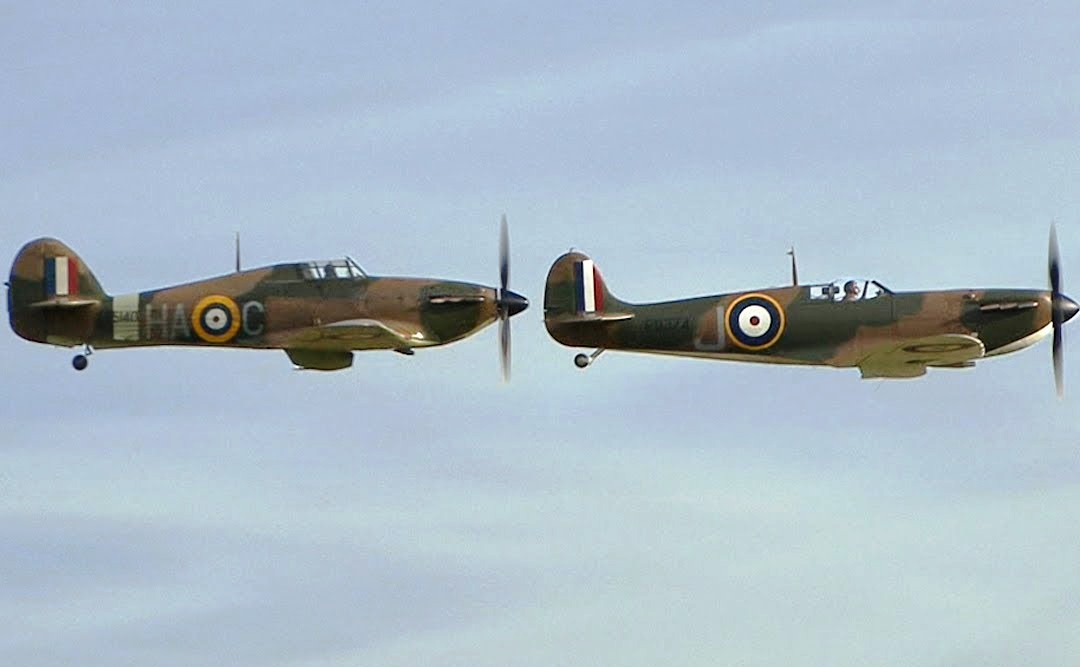 |
| Hurricane behind Spitfire |
We discovered that, by a strange coincidence, a few months later, another aircraft, a Spitfire, did crash about two and a half miles away. It was another student pilot from Tealing Airfield who was undergoing training in low-level flying.
(Flying at low level is used to avoid detection by radar systems; to escape from enemy planes; to avoid certain types of ground weapons; to fly underneath poor weather where it’s important to keep in sight of the ground or water; to strafe enemy personnel and vehicles on the ground; and to prepare for low level search and rescue operations. It is one of the most dangerous parts of military flying and has led to the deaths of many young, and even experienced pilots.)
There were two different versions of where the crash occurred – one said Drumgley near Forfar, the other Balmydown farm on the outskirts of Dundee. This confusion existed in some circles for more than sixty years. See the excerpt from a forum for WW2 vets:
------------------
05-Nov-07, 04:47 PM (GMT)
"Spitfire P8650"
In Numerous Communications I have seen it stated that this aircraft met its end at or near RAF Tealing. This is not correct. It hit trees while low-flying at Drumgley, between Forfar and Kirriemuir. This happened on 29/12/43. The pilot, who lost his life, was 1313908 F/Sgt J M Jones of 58 OTU, Grangemouth. A medical party from Tealing attended the incident and this may have given rise to the misunderstanding.
Harry.
-------------------
I decided to investigate this further, and finally managed to talk to several people with knowledge of the affair:
My first contact, by phone, said that he had heard, while at school, that an airplane had hit trees near Drumgley, but that he hadn’t seen this happen, nor had he seen the crash site.
I also contacted, by phone, a long-time resident of Tealing in his mid-eighties, who said that he and a school friend were first on the site of the crash, and that it was in a field on Balmydown Farm, near Tealing, NW of the farmhouse. Confirmatory evidence came from the current farmer at Balmydown. My contact offered to take me to the site on my next visit to Scotland.
I believe that both of those reports are genuine, and that the scenario which connects them is probably that
the Spitfire hit the trees at Drumgley, the pilot pulled his stick back and increased power, then tried to regain control of the airplane. He continued on the same heading passing about two miles east of Glamis Castle(1). Presumably the damage was too severe, and he crashed at Balmydown Farm.
The approximate coordinates, I estimate as 56°30'33"N 3°00'01"W. From trees to farm
field is about 9 miles and would’ve taken less than two minutes.
The young pilot was a Welshman:
JONES, John Morgan - F/S (Pilot) – 1313908.
"A family tree on ancestry.co.uk records that he died in a flying accident in Scotland. The Graves Registration Report Form lists his unit as 2 T.E.U.
The family tree includes the following information: John Morgan Jones, Flight Sergeant (Pilot), 1313908, Royal Air Force Volunteer Reserve. John was the brother of Tom Jones, Post Office, Pentrecwrt.
He volunteered to serve with the Royal Air Force and was posted to No. 58 Operational Training Unit at RAF Tealing near, Angus, Scotland, for training as a fighter pilot. On 29 December 1943, John was flying Spitfire P8650, when he hit some trees during a low flying exercise, and crashed. John was killed in the accident and was brought home for burial at Bwlchygroes Independent Chapel graveyard. Source: Llangynllo War Memorial - Cardiganshire."
| |
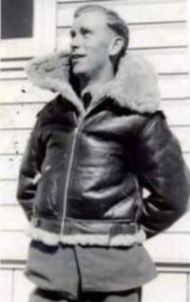
|
Footnotes
(1) Glamis Castle is the ancestral home of Lady Elizabeth Bowes Lyon (later Queen to King George VI, and mother of Queen Elizabeth II, and of Princess Margaret, who was born there).
|
|
Our camp in Tobruk was pretty basic. The only permanent buildings were the guardhouse, a couple of cookhouses and the armoury where all our heavy weapons and ammunition were stored. The battalion was housed under canvas, and for the first two weeks we slept on the ground, in two-man tents, on palliasses stuffed with a mixture of local grass and straw.
Inevitably, your body weight squeezed most of this stuffing to one side or another and you found your hip digging into the unyielding surface of the Libyan desert, a greyish compound of light sand and gravel. And while it was extremely hot during the day, it got cold quickly at night.
Another problem: trying to set up your mosquito net above your palliase. First you ran a string along the inside ridge line of the tent and hooked the top of your net to that. But it was a long way to the ground, and it was very difficult to get it right when there were two of you in each tent, trying to sort out your sleeping arrangement.
After a couple of weeks however, a shipment of metal army cots arrived, and we were able at least to get up off the desert floor. And these cots came with an adjustable wire frame over which you could hang your mosquito net.
You quickly learned to be careful in dressing after reveille sounded... Sand flies loved to slip into the folds and creases of your shirt, so you shook it out and ran your finger along all the seams before you put it on. And you learned to carefully turn your boots upside down and shake them hard– for nothing attracted the local scorpions more than the nice dark and warm confines of an Army boot.
More than one squaddie who ignored this step would feel the agonizing sting of a scorpion and would suffer half a day of throbbing pain in the toe or the soft tissue of the foot.
Sand flies were everywhere and if you were unlucky enough to be bitten, you were almost certain to get a dose of sand fly fever. Bannerman. who was in our Intelligence Section, got bitten by sand flies, and contracted the fever.
The Medical tents area was at the far side of our camp but you could hear Bannerman yelling and raving all across the area. He shouted and moaned on and off for three solid days. When he finally rejoined the Section he had lost 20 lbs. and all his colour. He looked like a ghost.
It was hot at Tobruk. Every day was the same. By 7.00 a.m. the sun was climbing in a brilliant blue sky and the temperature was rising fast. By 10.00 a.m. it was 85 degrees and by noon, a stupefying 100 or more.
The heat rose in shimmering waves from the desert sand and bounced off the whitewashed walls of any stone buildings like the door of an oven thrown open. It enveloped you like an invisible and suffocating blanket.
Sweat trickled down the side of your face, from your crotch, and down the side of your legs. It pooled in the hair under your hat, then slowly leaked down the side of your face to gather in the creases of your neck and shoulders. It ran in tiny rivulets down your arms and the centre of your chest. No matter how much you drank during the day you were always thirsty.
The dress code was relaxed in the desert. You wore your beret or tam o’shanter, shorts, socks, and boots. Your sergeant or corporal stripes were attached to an elasticized band which you wore on your left arm. Otherwise, you were stripped to the waist (this was before concerns about sun damage to the skin, and certainly before the era of sunblock lotions and creams). In short order we were all brown as walnuts.
By contrast, night-times were cool in Tobruk. Without a cloud in the sky the air quickly got cold once the sun went down. Shirts came on, then green Army-issue sweaters. Men on guard duty around the camp perimeter wore heavy greatcoats and were grateful for them.
But if you walked away from the camp lights into the darkness and looked up, you saw the great vast blackness of the sky encrusted with a billion points of light from the stars. It was a silent and deeply impressive show you never tired of.
|
|
 |
 |
I Don't Remember
Hugh McGrory |
 |
 |
The incident happened about eighty years ago – I would have been about five years old – and there is so much that I don’t remember about it...
I don’t remember who else was there that morning in Fairbairn Street, Dundee (where I was born and brought up until the age of twelve); I don’t remember who the child was, about a hundred yards away; I don’t remember who I was playing with; I don’t remember why the child cried out the way she did; I don’t remember who the people were who responded.
I do remember her blood-curdling scream of agony; I do remember being scared; and I do remember some people responding.
What I will never forget, was one man (whom I didn’t recognise - a neighbour or a visitor) who appeared suddenly. He was dressed in only a singlet and pants, and I was intrigued to see that half of his face was covered in shaving cream.
I don’t remember how the incident ended (I’m sure I would have heard if the child had been badly injured – I’m thinking a broken bone, or torn ligament, or some such), and I don’t know if the man contributed anything significant to the affair.
But I will always remember how, as a five year old, I was given an insight into the way so many of us, as social animals, have an innate need to respond to others in peril, and why so many ordinary people become heroes in response...
I’m going to stop here, because I’ve nothing more to add, and because anytime I think about that man – in the midst of shaving, dropping his razor and taking off running in response to the cry of a terrified child – my eyes tear up... as they’re doing now...
|
|
During the late 1940s and early 1950s I was part of a hidden workforce. This came about as the result of a brother of a friend relinquishing his morning roll delivery job because he was leaving school. The job was easy. All that was required for the ten shilling per week on offer was that I turn up at the local bakery at 5.30 am Monday through Saturday, collect a basket containing around thirty bags of warm morning rolls and deliver them to the address marked on each bag. It was expected that I return with the empty basket by 6.30 am. The opportunity of a lifetime and despite the misgivings of my parents I decided to grasp the opportunity with both hands!
On a chilly morning just after Easter I was less sure that my decision was a wise one when I entered the warm bakery to pick up my basket of already bagged rolls and a list of the names and addresses of my customers. I saw that some of the names had specific instructions regarding delivery. On further inspection I noted that because of these instructions I would have little choice in the route I would take or the order in which the deliveries would have to be made. I decided that I would just get on with it and study the customer list in detail after I had completed my initial venture into paid employment. The first thing that I discovered was that although one bag of rolls weighs very little thirty of them in a basket is quite a heavy load. The second thing was that the most morning roll eaters tended to occupy the top flat of their tenement. My third, and ultimately most important discovery, was that I was joining a layer of society that only existed before most folks got up in the morning.
At the time of my first brush with the world of work Dundee was an industrial city and most of the working population was engaged in some form of manual labour. In most of the UK married women did not have employment outside their home and many employers terminated the employment of female staff when they married. Even those enlightened employers who continued to employ married women usually dispensed with their services when they became pregnant. In Dundee, the jute industry needed skilled female labour and continued to employ married women and, in many cases, even had nurseries to look after their pre-school age children. This all had a bearing on the need for a delivery of morning rolls.
The early morning society that I had just joined came about because virtually every household took daily delivery of a morning newspaper and as there was no domestic refrigeration at least one bottle of milk. In most homes that had rolls delivered the wife went out to work at the same time as her husband. In those far off days porridge or cereal was only part of a cooked breakfast. The enjoyment of this and a look at the newspaper before setting off for an 8.00 am clocking on time at work was the normal start to the day. To make this possible it was important that the milk newspaper and rolls were on the doorstep before 06.30. What about those folks who didn’t have rolls delivered? The less discerning made do with bread and jam but, where the wife didn’t go out to work, she often went down to the bakers herself before returning to cook the breakfast. Who said that the women didn’t work?
Over the next few weeks I realised that there was rather more to the job than I had first thought. I quickly got to know the other, exclusively male, members of the pre-dawn army and almost as quickly I realised that there was a symbiotic relationship between the delivery of a newspaper and a bag of morning rolls. Within the first week I had arranged to meet up with a newspaper delivery boy and share out the common customers. This meant that I delivered his newspapers to all the homes in a particular close where I had customers while he delivered my rolls and his newspapers to another close. From this I learned that a job gets done easier and quicker if you can cooperate with others, a lesson that has served me well over the years. Cooperation with the milk delivery sector was more difficult not least because the adult milk float drivers were not very friendly but also because it was physically difficult to manage newspapers, bags of rolls and bottles of milk while going up the stairs of a tenement building!
By the end of the summer I considered myself to be a fully skilled member of the early morning work force and had already learned that in addition to my regular wage I received weekly tips from many of my customers. One customer stands out in my memory. I was offered one shilling per week if I would deliver her rolls at 6.15 am every day and while doing so, enter the house (the door was unlocked), knock on the bedroom door until either she or her husband answered, then go into the kitchen and light the gas under the already filled kettle before leaving. Needless to say I performed logistical somersaults to meet the 06.15 deadline and secure that extra bob a week.
I didn’t find juggling schoolwork and roll delivery too difficult, I got into a routine of doing my school homework in the time between returning from work and leaving for school. I went to bed soon after 9.00 pm and my alarm clock was set for 5.15 am. I very rarely slept in. Sundays were a special day when I often slept until noon. The cold dark mornings of winter were not my favourite time of year, but summer mornings were a delight. School holidays were just days that I didn’t go to school. On the rare occasions that I joined the family for a few days holiday I had to find someone to take over my delivery round and of course give him my wages!
My most common arrangement was with a classmate who delivered the Evening Telegraph. He would stand in for me in the morning and when he needed someone to undertake his evening round, I would be his locum. I continued my early morning employment until well into my third year of secondary education when I found that having a social life would be a good idea, and that a Saturday job in a local shop was an easier way to earn pocket money.
|
|
 |
 |
What a Dive 2
Hugh McGrory |
 |
 |
Brave, cowardly, or just plain dumb?
American Cyanamid was a large chemical company that, in 1909, began to manufacture calcium cyanide (used as an agricultural fertiliser) in a plant in Niagara Falls, Ontario, a couple of miles from the famous Falls. A major reason for the choice of site was the plentiful supply of both water and electricity from the Niagara River.
In the mid ‘30s, George Cox, Cyanamid’s plant manager for many years, spied a group of young boys sneaking under the fence to swim in the cooling-water channel. Instead of calling the police to chase them off, Cox went in a different direction – he decided to create a safe place for the youngsters to swim.
The channel was soon enlarged to accommodate a huge swimming tank that was 210 feet long and 105 feet wide. The tank was shallow at one end and gradually deepened at the other. Many truckloads of beach sand arrived to turn the south side of the pool into a miniature beach. On the north side, maple trees were planted to provide shade for the large and inviting picnic area. Two stone fireplaces were also provided for cooking purposes.
All of the water in this massive pool was completely changed each and every hour and a half. Anyone who swam in the Cyanamid pool will remember the currents as 500,000 gallons of water moved from one end of the pool to the other before entering the plant.
The pool proved to be very popular with locals and tourists alike. Within four years of opening in 1936, the changing rooms were expanded, and the emergency station doubled in size. New spaces for volleyball and horseshoe facilities were also added. In the early 1950s, a concession stand was built and proved to be a popular pit stop for many hungry swimmers.
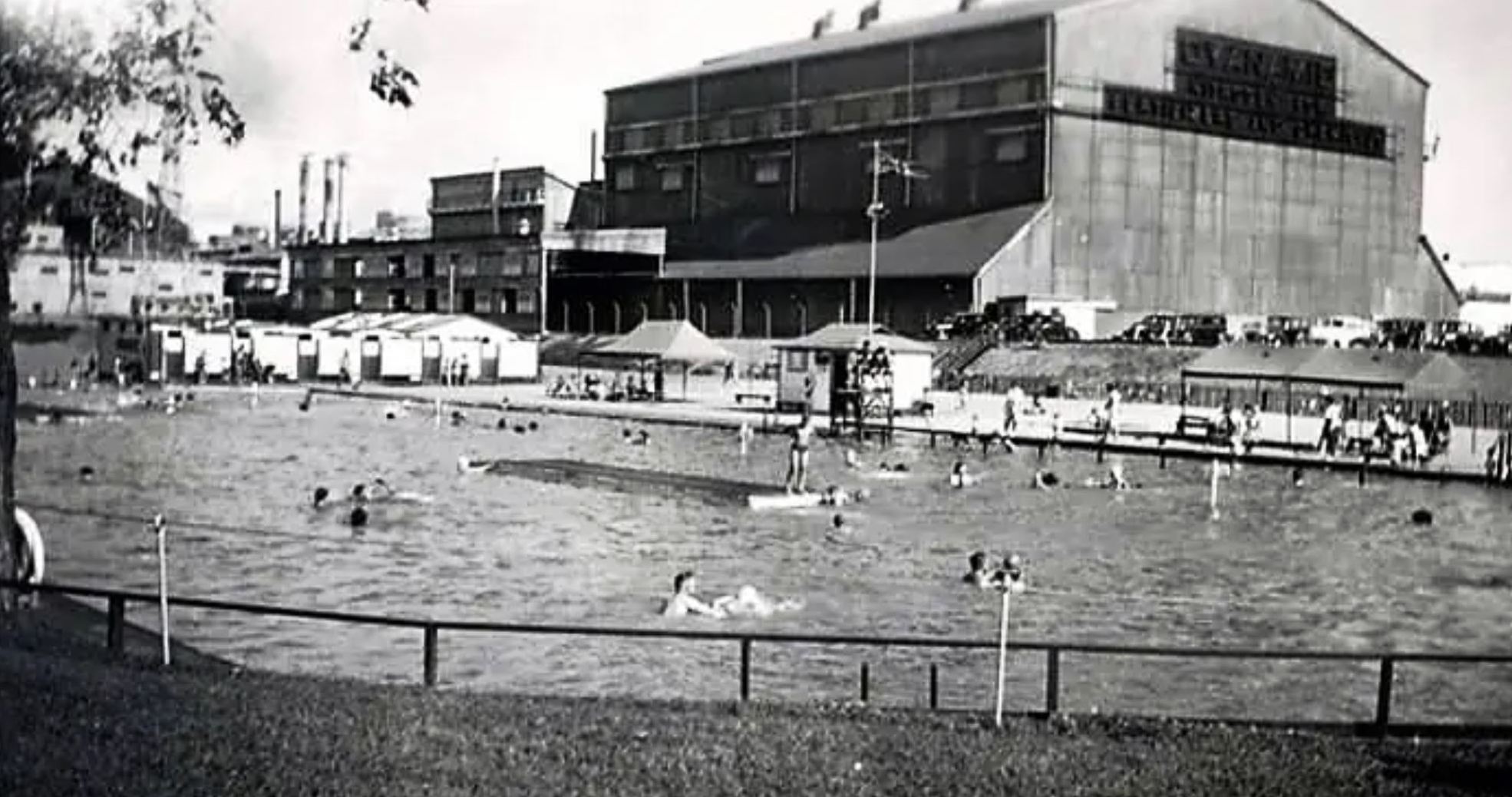 |
| The Pool with the Manufacturing Plant in the background. |
Some sources say crowds of up to 150,000 people visited the Cyanamid pool yearly during their opening season, traditionally the last day of school in June until Labour Day. Sunday was the busiest, with daily attendance reaching 6,000 visitors.
So, in 1967, the three stooges, I, Bob and Iain (whom you met in the previous story) decided to make the two-hour trip to the pool, so our families could have a day at the beach.
At lunch time, as we sat by the sand, we watched two young men diving from the high board (about ten or
twelve feet above the water surface - see photo of the actual board). They were very good, and hundreds of people around the pool were being entertained by them. I then had an idea…
I suggested to my two buddies that we three should have a go. Where that idea came from, I’ll never know! What the hell was I thinking? I could barely swim, and the last time I tried diving (see previous story) it hadn’t worked out too well – and that was from a height of zero feet above water level!
Surprisingly, my suggestion was not well-received by Curly and Larry… After some discussion and prodding on my part, the best I could get was, “Yeah, right, you go first…”
This was a perfect opportunity for me to call them chickens then lie down for a nap, but instead I said “Right.” then got up and walked over to the diving board where the two divers were taking a little rest.
I climbed the ladder and went to the edge of the board and looked down. At that moment I felt like the dog that caught the car bumper. “Whoa“, my left brain said to me, “that must be twenty feet if it's an inch. Just so we’re clear,
| |
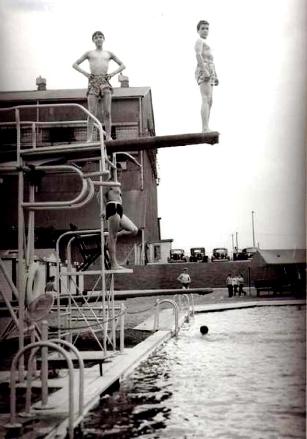
|
numbnuts, there’s no way on earth we’re diving off this platform!”
I looked around for inspiration and all I could see were hundreds of upturned, expectant faces waiting to see another beautiful dive. My right brain said “Now just hold on a minute! We can’t turn around and climb down again. Oh, the ignominy…”
What to do, what to do?
Well, I didn’t dive. To be clear, I didn’t do a climb-down either. I did a very bad imitation of a dive, throwing myself headfirst off the platform and hitting the water in a huge belly-flop – it certainly wasn’t anything you could call a dive!
I remember coming back towards the surface and holding on to the wall of the pool, under water, for as long as my breath lasted, before I let my head break the surface. I figured if people thought I might be drowning, maybe they'd forget about my total incompetence as a diver...
I climbed out, and, as my belly and chest turned red, the two guys who had been diving came over and were very nice to me. They gave me some tips (which I can’t remember now, since I had already decided my diving career was over)!
I headed back to Curly and Larry and said, “Ok guys, whose first?” They looked at me and said, “No way – you must think we’re as dumb as you…,” and I said, “#$%^(&*!!!”
Sadly, the pool closed after the 1971 season due to high renovation costs needed to bring the facilities up to new provincial codes and standards.
(Note: It seems that diving with no training is a really stupid thing to do. Diving from a height of 10 or 12 feet, as I did, isn't likely to do any serious damage – a red, stinging face or belly, perhaps some bruising. However, from a greater height, say 30 feet and higher, abdominal injuries that affect internal organs, such as the liver, kidneys, pancreas, and bowels, have occurred.
Of course, if you know what you're doing, the result can be quite different. See world record-breaker Professor Splash in action here.)
So, was I brave, cowardly, just plain dumb, or perhaps all three? Looking back, it occurs to me that a smarter alternative would have been to jump rather than dive – perhaps do a cannonball (why does hindsight never appear when you really could use it, eh?)
|
|
 |
 |
A Scottish take on Aussie English
Part 3 of 3
Brian Macdonald |
 |
 |
Regrettably, to my generation, colourful Australian English is disappearing with Aussies my age and a generation or two younger as a dwindling coterie of custodians. Today’s young Australians do not indulge in conversation face to face or write lengthy articles or letters but communicate remotely by smart phone, with text messages so cryptic and punctuated with emojis that I have to ask my 12-year-old granddaughter to translate for me, and by contributions to social media. The written and spoken word as art forms have gone out of favour with many. Poor grammar and a lack of respect for accurate, polished English or verifiable truth are common aspects of the online social media platforms to which so many have taken so enthusiastically.
To finish this tale, here is a short primer of words and phrases from the colourful Australian English lexicon for the ‘newbie’ to learn and use if he or she wishes to fit in when visiting us or coming here to live. Australians are by a huge majority urban dwellers and are far from stereotype Crocodile Dundee’s or characters from the comedy films of the 1970s about an ocker(1) Australian, Barry (Bazza) Mackenzie’s assault on England but there are examples of them flourishing and they do, at least, perform the useful function of keeping this part of Australian culture alive. A working knowledge of Aussie phraseology will stand you in good stead in many social situations.
Mate. The essential Australian word. Depending on the length of the vowel sound and the tone, this word can be a confirmation of close friendship as in “Duncan’s me mate”, a friendly greeting to anyone, not necessarily a close friend, as in “G’day, mate”, an expression of scorn, as in “Don’t come the raw prawn with me, mate!” or a sound of disbelief or disappointment when uttered as “maaate”. There are innumerable versions, and it helps to learn the appropriate facial expression that accompanies each.
A standard Aussie greeting, even to those with whom the speaker does not have any prior relationship at all is “G’day. How ya goin’” The standard reply is “Good! How a’ you?” Radio talk show hosts have lost their minds trying to get callers not to waste time on this salutation with absolutely no effect.
A useful variation is to have a pithy reply ready. “G’day, mate. How ya goin’.” ‘Flat out, like a lizard drinkin’!”
If you are accosted in a shop by an assistant, with the aggressively uttered phrase “Are you right?”, be neither offended nor frightened. It simply is the standard way of asking if you wish to be served.
The word ‘bastard’ is another staple, like ‘mate’, with a wide range of meaning. “G’day, ya old bastard” is a greeting to a good friend. “Mind you, he can be a right bastard” lends a very different meaning to the word. “’E’s not a bad bastard” is an affirmation of someone being a ‘good bloke’.
“Whadda you do for a crust, mate?” Australians have no compunction about asking even a stranger what he does for a living, in any social context. This may be partly because there is a strong level of egalitarianism in behaviour, dress and socialising between men and it can be impossible to distinguish a street cleaner from a managing director in the pub, on a sports field or at a barbecue and a wide social range is common in such environments.
The Sunday arvo (afternoon) barbie. In a land of (now hotter and hotter) sunshine, backyard barbecue parties are a standard event. The invitation may be given as “D’ya wanna come and sacrifice a steak?”. This is a good way to get to know your neighbours and is a major group activity of amateur sports and social clubs. The snag or mystery bag (sausage) is likely to be on the menu. A recognised ritual offspring of the barbie is the ‘Satdee morning sausage sizzle’ in the car park at the local Bunnings (a category-killer hardware chain) always to raise funds for some local organisation. As in UK, DIY-ers are out in force at the weekend, raiding the hardware stores.
Other colourful expressions:
As mad as a cut snake – very angry
Kangaroos loose in the top paddock – not very smart and prone to erratic behaviour
A beer short of a carton (or ten cents short of a dollar or any similar expression – of low intelligence or ‘not the full quid’, a quid being a pound (or dollar)
“You wouldn’t be dead for quids!” It’s great to be alive!
A man with red hair or a red-haired dog is inevitably called ‘Bluey’.
Someone who hasn’t got a zack is broke, a zack originally being a sixpence, now a five-cent piece.
In Australia, a team’s supporter barracks for his or her team.
A larrikin is a person who is prone to unorthodox, but not usually harmful behaviour, but is likeable.
A lair is a man addicted to flashy, vulgar behaviour and clothes. He may also be described as a ‘show pony.’ A ‘mug lair’ is just a bit worse.
A ratbag also indulges in unorthodox behaviour but is not likeable and may go too far with loutish or minor criminal behaviour.
If you are going for a swim in Melbourne, you will need your bathers. In Sydney you’ll want a cossie (costume) but in Queensland it’s ‘togs.’
An untrustworthy person probably ‘couldn’t lie straight in bed.’
‘Fair dinkum’ can mean authentic (of anything), genuinely Australian, true (of an unbelievable tale) or a suggestion that something is not genuine, or of surprise if spoken in a questioning tone. Other versions are‘dinky-di” or ‘dinks’ with or without the question mark.
‘In like Flynn’ means to be accepted in society or to have insider access to something. It derives from the reputation of the 20th century Australian film star Errol Flynn as a seducer.
‘She’s a beaut day, eh!’(2)
‘The Penguin Book of Australian Slang’ by Lenie Johansen was first published in 1988. In the millennial edition it was a dictionary 536 pages long, three columns to a page. It and ‘Strine’, ‘Let Stalk Strine’ and ‘Nose Tone Unturned’ by Afferbeck Lauder are all available from Amazon. Lauder also wrote Fraffly Well Spoken and Fraffly Suite, in both of which he focuses on the strangulated English spoken by the English upper classes.
‘They’re a Weird Mob’ is a novel published in 1957, a period when there were many Italian immigrants. It is purportedly written in the first person by a newly arrived Italian immigrant, Nino Culotta, about his entry into Australian working-class society by way of joining a building crew as a labourer and featuring his difficulties in adjusting to the idiosyncratic ways and incomprehensible language of Australians. The author’s name is John O’Grady, who was born and died Australian. The book was made into a popular comedy film by the well-known filmmakers Emeric Presburger and Michael Powell. This book, too, is readily available.
“Hooroo!” Goodbye.
Footnotes
(1) An ‘ocker’ may be defined as ‘an uncouth, uncultivated, or aggressively boorish (usually young), Australian male, stereotypically Australian in speech and manner’.
(2) In some parts of Australia, particularly in Queensland (viewed by some in the southern states, where people think of themselves as more sophisticated, as a redneck state), the ejaculation ‘eh’ is often tagged on to the end of a sentence as a form of punctuation or emphasis. This tends to confuse foreigners, who think they are being asked to respond.
|
|
In past stories I’ve mentioned more than once my belief that chance plays a larger part in our life stories than we credit. I’d guess that most of us can think of occasions where another time or place, a few seconds or inches, could have made an enormous difference to our life from then on.
One that comes to mind for me took place in 1966, the year we moved to Canada. We got together one weekend with two of my colleagues, Bob and Iain, from Scotland, who’d emigrated the previous year,
and we decided to visit Sibbald Point Provincial Park with our families. A previous story set in the park may be seen here.
We all enjoyed the supervised swimming area, much of the time spent keeping a close watch on the kids, but when they tired out and retreated to the beach for a rest Bob, Iain and I got a chance to relax in the water.
The swimming area was delineated by a rope tethered in position and kept on the surface by multiple floats along its
| |
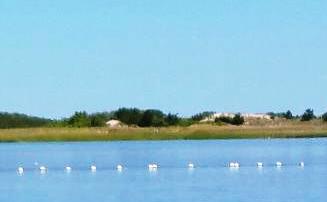
|
length. The area, of course, had been cleared of debris, such as fallen trees, when first established, and was well maintained and guarded by a lifeguard perched in a tower.
So, we, The Three Stooges, were larking around and at some point, I, as Moe, had a ‘bright’ idea which
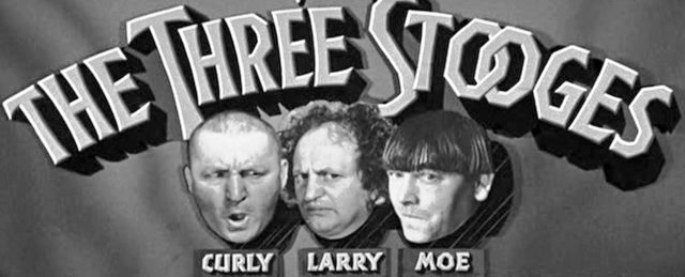
|  |
Curly and Larry went along with – if they held on to a stretch of the
guard rope, I would climb on top of it and dive off. It seemed like a good idea…
We figured we’d have to be quick (before the lifeguard spotted us) so we got into position, standing in water about four foot deep, they held the rope tight, I got on top of it and launched myself outwards…
|
I draw your attention to the word ‘outwards’ – not one of the Stooges cottoned on to the fact that it might have been better to have performed this, admittedly stupid, manoeuvre by diving inwards. It did occur to me a split second later…
It seems that someone had placed a large boulder just there (conceptually, imagine a huge cannonball about three feet in diameter, about a foot below the surface, and invisible).
This is where chance came into effect - in the form of good luck for me! I had dived in at the side of the rock, my arm hit the boulder first and my forehead in turn hit my arm – while it scared the life out of me, I got away with only a skint elbow and a few minor bruises…
Addendum
(source CBC/Radio-Canada)
In the month of July 2020 alone, the trauma centre at Montreal's Sacré-Coeur hospital saw five cases of spinal cord injuries related to diving, three of which occurred in the last week. Dr. Piette, head of the trauma team at the regional health authority that oversees Sacré-Coeur said that these were all young people diving without knowing the dangers, and hitting their heads…
He further emphasised that, before doing any kind of diving, people must make sure they know how deep the water is and check for hazards like rocks.
All five of the people admitted are now quadriplegic...
|
|
 |
 |
The Middle East
Gordon Findlay |
 |
 |
When you are a member of Her Majesty’s Armed Forces, flying is not a comfy business. The planes that flew us out of the U.K. were utilitarian in the extreme.
Down each side of the interior fuselage was a single row of simple tube steel and canvas seats facing inward. The centre part of the plane was for your kitbag and weapon.
We were allowed off the aircraft, but only thirty yards from the doorway to a small metal building which contained a row of smelly toilets. Back outside we stretched our legs, sniffed the warm air of southern France for a few minutes, then it was back on board again
It was late afternoon before we touched down at Tripoli’s military airport. By that time, we were all heartily sick of the bellowing noise and the oily smell of our plane. Off we trooped and into 3-tonner trucks for the short drive to a military base nearby. We were all wearing thick British Army battledress, and since it was 85 degrees at least, everyone was soon drenched in sweat as we lugged kitbags and personal weapons into the trucks.
But at least one small part of this military exercise had been thought out properly. As soon as we arrived at our wooden barracks, we dropped off our kit, then were marched across to another building where – oh, miracles of miracles! – we were issued our Mid-East gear: two pairs of shorts and short-sleeve shirts, thin socks and light underwear. Our U.K.– weight battledress would go to the bottom of our Army kitbags and stay there for the rest of our stay in the Middle East.
We didn’t stay long in Tripoli, just long enough to make sure we got acclimatized to the heat and got used to wearing our new Middle East togs. Then it was back into those bellowing airplanes again for a shorter flight – this time to El Adem.
El Adem is surely one of the dirtiest and most depressing parts of Libya... at that time a collection of battered metal structures, the usual perimeter wire, and an airfield surrounded by discarded oil drums and other detritus. We didn’t really have a chance to look around, for the usual collection of 3-ton trucks was waiting for us at the edge of the airfield and we were stuffed into them for the hot and dusty drive into Tobruk – that famous World War Two battlefield that changed hands several times and was largely shattered and flattened in the process.
|
|
In 1893, the Ontario government of the day established Algonquin Park as a Forest Reservation and National Park. Now known as Algonquin Provincial Park, the area, for thousands of years, was home to the Indigenous people known as the Algonquin. The area was very sparsely populated, with scattered family
groups of Aboriginal peoples coming to fish, hunt and pick berries, but their numbers were never large. It wasn't until the 1800s that momentous changes came to the rugged Algonquin highlands when the demand for white pine from the expanding British economy became huge, and the logging industry mushroomed.
The park was not established to stop logging, but rather to establish a wildlife sanctuary, and by excluding agriculture, to protect the headwaters of the five major rivers which flow from the park.
Over the years since then, the Park has become a beloved place for all those who cherish Canada’s natural and cultural heritage. It attracts over half a million visitors yearly who participate in day-use activities, camping, or back-country travel. It occupies 7,630 square kilometres of land and water, with water making
up approximately 12% of the area and contributing an extensive network of canoe routes. (This is a huge park – for comparison, its 3000 sq miles is half as large again as the Orkneys, Shetlands, and the Western Isles combined. Scotland itself covers 30,0000 square miles.)
Somewhere around 1970 John, a friend and colleague, and I decided to take a day trip to the park for a canoeing adventure. We left really early on a Sunday morning for the three-hour trip and by about 9:00 am had hired a canoe and set off. I was in the bow, since it was my first time in a canoe – John was the experienced one having once sat in a canoe – the blind leading the…
We had splendid weather, warm but not too hot – now, fifty years or so on, many of the details escape me, but I have a few cherished memories:
| |
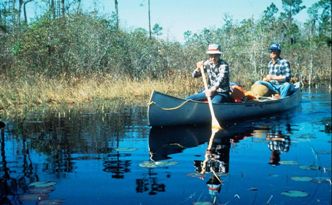
|
• We pulled away from the dock and headed north up a slow-moving river. In no time we were alone,
surrounded by water, trees, and rocks – indeed the whole day we met very few people.
After about ten minutes, John spotted a deer ahead on a small rise about a couple of hundred feet from the bank. We kept very quiet and paddled gently. She watched us until we were almost abreast then turned and walked quietly away.
• We came to a point where the stream narrowed, and the water flow was stronger. We saw a sign indicating that we needed to portage, so paddled ashore, figured out how to get the canoe above our heads and set off. It was
| |
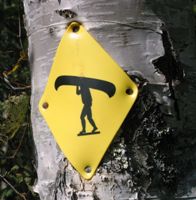
|
only a few hundred yards, but the hired canoe was built to withstand the depredations of amateurs like us and was quite sturdy – meaning heavy!
I was glad when we reached the end of the trail and were able to lower the canoe into the water again. Not fun, but we did feel a little more like voyageurs.
• We headed out onto a large lake and decided to try to cross it to the opposite shore and look for a river that we could explore. An hour or two later we saw a ledge of rock on shore about two feet above water level and
decided to stop and have lunch.
When we were ready to get going again, I held the bow while John attempted to get in. He ended up with one foot on shore, one in the canoe, and the stern of the canoe moving slowly away from the rock. It was so funny watching him slowly doing the splits and teetering on the edge of total immersion that, I have to admit, I seriously considered letting the event play out. At the last minute, my better angel intervened – I stuck out my leg and hooked it into the gunwale – it took all my strength to stop the canoe and John teetered there on the edge of disaster for a few moments before the craft began to slowly come back. (A little bit of me still wishes that I’d let it go – it would’ve been spectacular!)
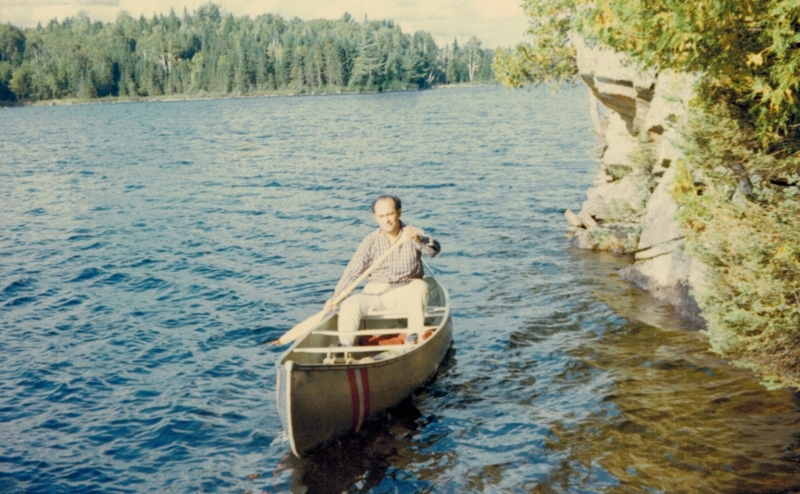 |
Addendum: A week after this story was published I stumbled across this photo.
It shows my friend John, just after he almost fell into the lake... |
• One thing that made quite an impression on me was paddling from the river into the lake and heading straight out, then, after ten minutes or so , turning, looking back, and realising that the river had disappeared from view. The effect was as if we had come through a curtain in the trees which had then closed up again…
One stretch of dense forest trees looks just like any other, it behoves the boater to pay attention by looking back frequently and making sure that the location of the access point is related to the wider geography. (Of course, much better to take along a pocket compass and note the outbound course readings…)
• On the return journey, some many hours later, we came to the portage point again (it really hadn’t struck me that we would be there again until we arrived). Of course, we were now going in the same direction as the water. Being such amateurs, we could have portaged down again, but that wasn’t what voyageurs do! So, we carried on…
After a few minutes we saw that the channel was becoming quite narrow and, the water picking up speed.
We were both quite uneasy, but there didn’t seem any way to stop and get out, so we did our best to keep the canoe in the middle of the passage and hoped for the best. Soon thereafter we realised that just ahead there looked to be a waterfall and that we were about to go over…
(Full disclosure, it was indeed a waterfall – total drop must have been at least two feet…)
We shot over the little drop into a wide pool below, managing to remain upright. We both let out a whoop of adrenalin-fuelled relief then saw that, floating in front of us, there was a capsized canoe with two very wet
guys trying to right their craft.
We asked if they needed help, they said no, and we carried on downstream (no doubt with a modest air of superiority…)
The rest of the paddle was uneventful for such experienced paddlers… We turned in the (undamaged) canoe and set off on the three-hour drive home. We were, of course dead tired, and aching from muscles we didn’t know we had…
A wonderful day!
|
|
 |
 |
A Scottish take on Aussie English
Part 2 of 3
Brian Macdonald |
 |
 |
People speak more slowly in remote country Australia (the outback) than in the cities, as is the case in many English-speaking countries, but not significantly so. Spoken Australian English has become colloquially known as ‘Strine’ and our country as ‘Straya’, due to the tendency to fast speech and to clip both vowels and consonants ruthlessly. Several humorous books have been written on this strange tongue by the pseudonymous Afferbeck Lauder(1). In my early days in Sydney I was a ’reffo’, the contemptuous term used for all immigrants, refugees or not. I wondered who the often-mentioned lady ‘Enara May’ was until I twigged that it was the National Roads and Motors Association (NRMA), the New South Wales equivalent of the British Automobile Association.
The original convicts who founded modern Australia came largely from the London area, not mostly from Ireland (although some did), as many believe, because most of the convicts on the First Fleet and subsequent further shiploads were from the overflow prison ships known as hulks, moored in the Thames and off the south-east coast of England and were, preponderantly from that part of the country. Thus the Aussie twang was born, an offshoot of cockney. Most larger towns in Australia developed on the strip of coastal land around the east and south coasts, with the Great Dividing Range at first providing a wall to the inland, running from tropical northern Australia to as far round the south coast as Adelaide, SA. Sydney was the largest city.
The second largest city, Melbourne was founded in 1836 as a commercial venture, from the southern island of Tasmania, which was originally named Van Diemen’s Land after a Dutch governor of the East Indies. It was so named by the first European sailor to discover the island, the Dutchman, Abel Tasman. Subsequently it was the British who renamed it Tasmania to honour him. It had been colonised directly from Sydney. The expedition back to the mainland was led by John Batman, a grazier and explorer, and founded a colony of free settlers. Batman landed at what is now named Blairgowrie, which many readers will recognise as a town near our own home city of Dundee in Scotland.
Named for Victoria’s first Prime minister, Melbourne’s mushroom growth in the later 19th century was due to the discovery of gold in the inland of what became the state of Victoria. As well as miners from many lands, there was a good number of Chinese settlers who established their own mines but, with a hard eye on profit, became growers of vegetables, shopkeepers, and traders. Several large Victorian gold mining boom towns of the 19th century have a heritage of splendid buildings and continue to have significant populations of ethnic Chinese origin, which are well integrated but maintain their ancestral culture and whose temples, dragon festivals and museums are a major part of community life in these cities. Other parts of Australia grew more slowly as agricultural hubs and industries developed.
Australia became a federation in 1901, when the separate colonies agreed to become one country with a number of states, under the British queen, Victoria, a component country of the British Empire. The states had a substantial level of autonomy but were subject to federal government control over national matters. A Governor-General, at that time always a senior member of the British nobility, represented the crown.
Largely British immigration continued, by government policy, even after convict settlement was ended, to build Australia until after WWII. Indeed, although Sydney, Port Arthur in Tasmania and Fremantle in Western Australia were originally convict settlements, South Australia and Queensland were founded by free settlers. English remained the statutory language.
I quote the words of a song written some years ago by a member of the hugely successful Australian pop group of the 1960s, The Seekers,
“We are one, but we are many. And from all the lands on earth we come”.(2)
Many races have contributed strongly to the still-changing culture of Australia(3). This island continent is the beneficiary of successive waves of immigration in modern times, starting from the immediate post-WWII period. First came large numbers of Italians and Greeks, as well as many displaced persons from every European nation, then immigrants from the other lands of the eastern Mediterranean. These were followed by Vietnamese. More recently, immigrants have come from the African continent and from many Asian countries with strong ethnic Chinese populations. We must not forget the importance of acknowledging and understanding the complex culture of the First Australians, with their deep, spiritual attachment to the land, whose voices are only now beginning to be heard.
There continues to be a flow of immigration from Britain, which is still the major source of New Australians. The Pacific Ocean island nations have made a huge contribution in the last couple of decades, not least to the sports of rugby union and rugby league, although they have made little impact on the local football code, Australian Football(4). That game is all about tall, strong but lightly-built men running and twisting and leaping high into the air for a game lasting two hours on an oval pitch twice the size of any other football code’s area with four goal posts each end and no corners. A team consists of eighteen players on the ground at the same time. It does not suit the more heavily-built Pacific Islander peoples.
Many languages are spoken; there are districts where English is not the language of the shops, businesses and medical and legal practices. Ethnically-based social clubs, sports clubs and community organisations proliferate, but English is still the major and the official language. Fortunately the sometimes shamelessly manipulated language test which was used to keep Australia a white-skinned country of European ethnic origin(5) was abandoned in 1966.
To be continued
Footnotes
(1) Think about it and say the name fast a few times. The author’s real name is the splendidly Scottish Alastair Ardoch Morrison. Not much doubt about ancestry there, although he was born and died Australian. Apart from the books on Strine, he wrote the song ‘With Air Chew’ on the same theme.
(2) The link to the Seekers singing the song ‘I Am Australian’ is here. It has become popular in this era of inclusion of many races in Australia.
(3) As an example: Australia has a hugely diverse culinary culture. The major cities boast restaurants and cafés of every major and many minor national cuisines and major markets offer an endless variety of fruits, vegetables, cheeses, meats, breads and specialty foods and ingredients. In particular, Melbourne, is known for its coffee culture (The Italian influence was strong in Melbourne.) and small cafés and ethnic restaurants abound, not just in the central city, but throughout the suburbs too. Interestingly, Australians prefer locally-owned coffee shops to the large multi-nationals. Starbucks is not a major chain here. Alas, McDonald’s and its fellow fast food mills are popular but not for the quality of their coffee!
(4) ‘Aussie Rules’ or ‘Footy’ is the only football code in which points are awarded for missing with a kick at goal. One point is scored if the ball misses the tall inner pair called the goal posts (not less than 6 metres [20 feet] with no cross-bar) but goes through the shorter outer set, which are called ‘behind posts’ and rise to a minimum height of 3 metres [10 feet] either side of the main set. If the ball passes untouched through or even above the goal posts a generous six points is awarded. There has been notably successful recruitment of Gaelic Football players from the Irish Republic to the Australian Football League. The game is unique to Australia except for minor, amateur competitions set up in other countries by nostalgic expatriate Melburnians, as the game had its birth in Melbourne and is virtually a religion there.
(5) The language test of the White Australia Policy that ruled immigration from 1901 till officially abandoned in 1973 was shamelessly used to ban from entry to Australia anyone the federal government wished to keep out for political reasons. There is a well-known tale of an little-used, obscure language being found for the application of a test to deny entry to a foreign left-wing intellectual who spoke a number of major European tongues fluently. A federal immigration minister of the 1950s, Arthur Caldwell, is infamously credited with saying publicly, “Two Wongs do not make a white”.
|
|
Do you know what it’s like to be caught in a tsunami? Probably not – I certainly don’t. Indeed, I don’t think that anyone can really appreciate what it feels like to be caught in one of Mother Natures cataclysms – tornadoes, major floods, earthquakes, landslides, avalanches, forest fires… unless they actually experience one.
In a recent story I told of our experience with a derecho, a straight ahead windstorm with the force of a tornado that, in 90 seconds left us with five uprooted trees and a dozen more damaged. My wife and I wouldn’t have believed it if we hadn’t lived it.
Getting back to tsunamis, I once had an experience that gave me a wee taste of what it might be like…
It happened over 60 years ago. I was a young engineer in the City Engineer’s office in my home town of Dundee. We got a report that there was some flooding on a bridge on the A90 (The main road between Dundee and Aberdeen) where it crossed the Dighty Burn (pronounced Dichty).
I went to the location with Jim Johnstone, another young engineer (and a year behind me at Morgan
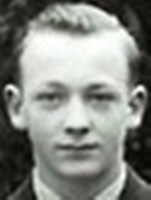
|  |
Academy) who worked in the City’s Water Department. We assumed that it was because of heavy rain that we’d experienced, and not from a burst water main – but we had to be sure, of course.
We parked a few hundred yards uphill from the bridge, put on our Wellie’s and walked down. It was immediately clear that we didn’t have a water main issue, and that the drains on the bridge had probably gotten silted up with mud and
|
 |

|
| Jim back in the day. |
 |
 |
The Venerable Wellie |
debris and would need clearing. We advanced onto the bridge to get to the lowest point – with a bit of luck we might have been able to clear the drain as a temporary fix. We were smart enough to tread very carefully in the six inches or so of water so that we didn’t cause waves that would overtop our boots – we didn’t want to get wet and there’s nothing worse than wellies that are full of water…
As we stood there looking for the drain, I glanced back up the road and saw a large truck bearing down on us, very close, and moving quickly. I realised that he was not going to slow down – I could see the driver’s smiling face…
I shouted, “Look out, Jim!” (A lot of good that was...) All we could do was turn our backs, pull up our collars, and brace... A tidal wave engulfed us – overtopped us – and in an instant we were like twa drookit rats...
Yes, I know that was nothing like a tsunami, but still...
|
|
 |
 |
Things Start to Look Up.
Gordon Findlay |
 |
 |
Completed in 1796, Fort George, at Ardersier, some dozen miles north-east of Inverness, has to be one of
the draftiest and coldest barracks in the Western world, but we had to make the best of it. Within a couple of days we shed our MP hats, white belts and holsters, and were issued tam o’ shanters, kilts, sporrans, black brogues and gaiters.
And of course, we were daily reminded of just how chilly it was any time we wore our kilts on parade – since the rule is historic, cast in stone, and absolute: in a Scottish regiment NOTHING is worn under the kilt. (And the standard joke is: Q: “Is anything worn under a Scotsman’s kilt? A: “Nothing’s WORN – everything’s in perfect working order.”)
But, at this point, my old friend Lady Luck came strolling by and paid me a visit. Perfect timing. For although I really didn’t mind Army life or life in an infantry regiment, I didn’t fancy spending the rest of my service lugging a rifle and bayonet and being ready to serve as cannon fodder for the next bit of nastiness to confront the British Army.
I wasn’t aware of it, but 1st H.L.I. had been tagged for overseas duty and the regiment was busily working itself up into battle readiness, should overseas duty turn into something requiring British military clout. Part of that readiness campaign required the regiment to bring an Intelligence Section into being.
An “I-Section” acts as the eyes of any regiment, using OPs (Observation Posts) out in the field. The I-Section prepares all the maps showing the disposition of Blue (friendly) forces and Red (enemy) forces; these maps are allocated to each officer of each rifle and mechanized company, and are regularly up-dated as events and positions change.
The I-Section looks after the code books used for secure communications; maintains radio contact with other friendly forces; monitors enemy radio transmissions; knows the battle formations, troop numbers, likely armaments and military tactics of enemy forces.
And more important, all our training henceforth would not come from our Highland infantry regiment: it would be provided by The Intelligence Corps, a part of MI-7 in Great Britain, responsible for all Army Intel.
For example, our training in SigInt (Signals Intelligence) – which involved monitoring both our own signals traffic and that of a potential enemy force – came from I-Corps specialists who came to us and spent a couple of weeks bringing us up to speed on the latest (for then) Intelligence coding, masking and cyphering, as well as the transmitters and receivers used to do all this.
And of course, we all had to be instant and proficient in radio-alphabet usage: you know, “A for Able, B for Baker, C for Charlie, D for Dog, E for echo, F for Fox” and so on.
When I showed up at Fort George, the 1st H.L.I’.s Intelligence capability consisted of one Lieutenant – “Pug” Thomson– one sergeant, Jonas Krywald (a Polish-born trooper who had reportedly served time in the French Foreign Legion) and one corporal – Russell Dagg, a product of Heriot’s School in Edinburgh.
It seems that Lieut. Thompson looked over all the personal backgrounds and education of all the current recruits within the H.L.I. and spotted the info on yours truly, recently kicked out of the Military Police but a private school boy with a decent education. Very shortly I was told to report to Thompson for an interview, most of which involved talking about rugby, since he’d noted that I had played club and Old Boy rugby in Eastern Scotland.
There were a few questions about education and interests, but it all went quite well, and Lieut. Thompson informed me that I, Corporal Findlay, was now a fully-fledged member of the regiment’s Intelligence Section. Training in military intelligence work, Thompson said, would start immediately and would continue once we arrived at our overseas posting.
Naturally, I was delighted. No more monotonous square-bashing or obstacle-course training. No more main gate guard duty. No more kitchen duty, vehicle “maintenance” cleaning, or ceremonial parade “volunteer” duty when VIPs came to visit our battalion. All that was behind me. I was now– whoop dee doo– an Army specialist with special duties.
Within a week, he had spotted another catch – one corporal Les Howson, from Birmingham (what are Englishmen doing in a Scottish rifle regiment, you ask?) Well – often the answer is: they chose it because of a love for the traditions of the regiment, their pipes and drums, and their history of prowess on battlefields down through the ages...) Later, Lieut. Thompson added one private– Ian Bannerman – and the Regiment’s Intelligence Section was ready to go.
The timing was perfect, for within a month, we were all stuck with needles for typhoid, anti-rabies, dengue, and yellow fever, after which the 1st Battalion the Highland Light Infantry – as part of 3rd Division – was loaded into transport planes for the long flight to Tripoli in the Middle East.
Try as I might, I cannot remember which airfield in Britain we were driven to for the flight to the Middle East, or the types of planes we flew in. I just remember that, for quite a few of the 1st H.L.I. this was the first time they had ever flown in a plane, so there was a definite under-current of excitement as we boarded.
|
|
In my previous story you met Alex – accomplished tow truck driver, gold prospector and – wait for it – paranormal investigator… He said that he had a company (he and his partner, a woman) and was available for hire.
As you know, the term paranormal refers to occurrences which are impossible to explain by known natural forces or by science. I asked if he meant that they were ghostbusters, and he said that was one term that people sometimes used to describe them. He said that quite often, though, they are able to ascribe what was happening (strange noises or visions, perhaps) to normal causes, and in so doing set their clients minds to rest. I asked him if he had psychic powers, and he said no, but that he believed that his partner did.
As I said last time, listening to strangers can often be eye-opening…
The paranormal is often broken into two areas, religious and non-religious, in both of which people, faced with something they can’t understand, choose to believe in a mystical or magical explanation – reincarnation, the spirit living on after the body dies, ghosts and so on.
With regard to the non-religious paranormal realm my belief is that there is always a rational explanation for the occurence – we just haven’t found it yet. Indeed, a number of possible causes have been documented for many so-called paranormal events:
Carbon monoxide poisoning can cause auditory hallucinations, a feeling of pressure on your chest, and an “unexplained feeling of dread.” A well known story from the 1920s about a family hearing footsteps, seeing apparitions, and feeling malicious paranormal presences, turned out to be the result of carbon monoxide poisoning from a broken furnace.
Many ‘haunted house’ events occur in old houses, and it has been discovered that certain types of black mould can produce effects similar to carbon monoxide.
Infrasound is just below the range of human hearing and can cause some strange sensations. Some people subconsciously respond to lower frequencies with feelings of fear or dread. In 1998, engineer Vic Tandy of Coventry University spent a night in a supposedly haunted lab. He and his colleagues experienced anxiety and distress and felt cold shivers down their spines, and Tandy even reported seeing a dark blob out of the corner of his eye. It turned out that there was a silent fan creating sound waves at just below the sound threshold and at a frequency that can cause the human eyeball to vibrate and “see” optical illusions. When the fan was switched off the effects disappeared.
In my own home, I sometimes think that I’m hearing several people in the basement having conversations – can’t make out any words but it sounds like a cocktail party... It’s actually the forced air HVAC system that’s generating the noise.
Other sources of such low frequency sounds are events like earthquakes and volcanic activity or lightning; animals including elephants, whales, and hippos that communicate using infrasound; nearby industries can also be a source – diesel engines, electrical generators, wind turbines, and even some loudspeakers.
Sleep paralysis happens when the brain gets the process of falling asleep or waking, wrong. When we are in REM sleep, we can have all kinds of dreams some involving physical activities. The brain normally turns off the bodies ability to move so that the sleeper does not attempt to lash or kick out or attempt to run.
Your brain usually turns this paralysing effect off before you wake up, but in sleep paralysis, you awaken while it’s still happening – it’s like dreaming with your eyes open, and people may believe that the events are real.
Electromagnetic waves are all around us and are a combination of electric and magnetic energy. They can’t be seen or heard by humans directly, and include radio waves, microwaves, infrared, ultraviolet, x-rays and gamma rays. Ghost hunters use EMF meters and often find electromagnetic fields in ‘haunted’ dwellings.
Studies using helmets that delivered weak magnetic stimulation to people showed that eighty percent of test subjects said they felt “an unexplained presence in the room” when they wore the helmets.
The attraction of horror movies is partly explained by the fact that neurologists have found that our brains release dopamine, a chemical associated with pleasure, when we’re afraid. Also, it’s been shown that high levels of dopamine can increase the likelihood of finding meaning, patterns or significance where none exist (Apophenia) and this results in a higher tendency to believe in ghosts or alien encounters.
Finally, my brother and I have some personal experience with apophenia: When our mum was in her late eighties she began to show signs of dementia. (We later learned that this was probably caused by several TIAs that she had suffered unknowingly.)
In particular she would awaken sometimes in the belief that she had seen people in her room during the night. These varied from family or acquaintances to, for instance, a ballerina who floated down from the ceiling and danced at the foot of her bed. (Fortunately, these were pleasant experiences for her, and she would talk about her ”visitors”.)
This was explained to us as her brain, half asleep in the semi-darkness of her bedroom, trying to make sense of what she was seeing, patterns of light and shadow, and putting these together in a form that made sense to her.
On one particular occasion when I was home on a visit, she told me in the morning that my dad had visited her during the night.
The following conversation took place:
“Ma, you remember that Dad died about 20 years ago?”
“Eh, but he’s still gae’n aboot.” (Yes, but he’s still going around.”)
“Really, how did he get here?”
“He has a car now – he parked on the street out there,” and she went to the window and looked out, “it’s awa’ now.” (“It’s away now.”)
Not quite knowing how to proceed, I said “Well I hope he drives carefully, Ma, you remember Dad wasn’t a very good driver…”
Not missing a beat, she said “Eh, but he’s had twenty years to learn!”
And all I could think to say was, “Right enough, Ma, right enough.”
|
|
 |
 |
Memories – Who can Forget Them?
Bill Kidd |
 |
 |
I am now of an age when the journey that started in the bedroom ended on the way to the kitchen when I realised that I no longer remembered why I was going there. The really annoying thing is that when I returned to the bedroom, I knew that I still needed the item that I was going to fetch from the kitchen! What was so important that I had to make a second trip to the kitchen you may ask and I in all honesty would reply “I can’t remember”.
Memory is a funny thing. I can still remember that 6/8 is one third of a pound and that a dozen at 1/3 each amounts to 15/- but I cannot remember how much a second-class postage stamp today costs or where I last saw my spectacles. Oh, now I remember I was going into the kitchen for my spectacles, I remember putting them in the fridge!
What is the very first memory that you can still clearly recall? Mine occurred three days before my fourth birthday, it was Neville Chamberlain’s broadcast saying that we were at war with Germany. Why has this memory been retained so clearly? I had no idea who Neville Chamberlain was or even what war meant. I think that that the event was etched into my mind because my parents transmitted its importance to me as they listened so intently. I have heard recordings of that broadcast many times and they never fail to take me back to that Sunday in September and that top-floor tenement flat in Dundee.
Of course, I can remember many things from my childhood. Things like the white model racing car with front wheels that moved when I turned the steering wheel. This was a gift from my mother’s bridesmaid, the lady that I knew as Aunty Madge who disappeared from our lives early in the war. It is a very long time since I last sat in a Dundee tramcar, but I do recall kneeling on the downstairs bench seating looking out of the window while eating from a package of red sweetmeat that I had rested on the window ledge. When the tram reached our stop, my mum grabbed me and ushered me off the vehicle. The moment my feet touched the pavement I remembered that my delicious treat was still on the window ledge of the tram. I will never forget or forgive that loss so early in my life.
Because I spent much of 1940 living with my grandparents in Forfar, I didn’t start school at the start of term but joined my class some months later. My first day was memorable because I got lost! I was brought into Miss Findlay’s class by Miss Gow, the formidable Infant Mistress, shortly after 9.00 am. At 10.15 I had my third of a pint of milk then, for our fifteen-minute playtime, was marched out with the rest of the class. I managed to get separated from my classmates by going into the boys’ toilets which were located at the end of the playground. By the time I found my way back to where the infants were allowed there was no-one there. Meanwhile the upper school interval had started so I joined in with them. When it came time to line up to return to the classrooms there was nowhere for me to go. The teacher in charge had never seen me before and asked who my teacher was. I didn’t know so it was suggested that I should get myself home. When I found my way home there was nobody there. Fortunately, Mrs McIntosh, our next-door neighbour, found me and took me back to school. Through Miss Gow I was returned to Miss Findlay’s class only to find that nobody had noticed my absence. I was not party to the conversation between the two Misses, but I think that I can still feel the burning in my ears! I was given a couple of playtime minders for the rest of the week.
The more observant of you will realise that even after eighty odd years I can still remember the names of my mother’s bridesmaid (not that I was at the wedding of course), our next-door neighbour, my first teacher and the Infant Mistress at Blackness School. I can recall the names of the butchers, bakers, grocers, chemists, and newsagents that we patronised. I remember the names of pretty well anybody, anything, any place, or any event that occurred between 1939 and 2010 but don’t ask me what I was doing on Tuesday or what I watched on TV last weekend.
Is this because of my advancing years or is it just what I consider to have been important in my life?
|
|
I’ve found that, if you’re thrown together by happenstance with a stranger, it can be quite surprising how much you can learn by listening – it can often be enlightening, entertaining and educational…
The ‘Alex’ of the title is the tow truck driver from my previous story and he and I spent several hours together, particularly driving from Dundee to Glasgow Airport with the car I damaged. He said that we’d break the journey, as he always did, at Balhaldie Filling Station on the A9, north of Dunblane. I treated him to his favourite Starbucks Vanilla Latte and a muffin, and we had a chat as we ate.
I asked him if this was a full-time job for him and he said that it wasn’t, that he liked variety and had a couple of hobbies/part-time work that kept him busy and earned some money (I defy any of you to guess what his two interests are...)
The first… gold prospecting in the Scottish Highlands – and yes, there is gold in them thar hills and people have been recovering it for hundreds of years...
At Cononish, in the Tyndrum/Crianlarich area of Perthshire (the area I worked in for a couple of years while living in Killin), the new (five-year-old) underground mine is currently producing nearly 1000 ounces of gold per month. This is much more than has ever been produced in Scotland before.
However, we’re not talking about mining but rather recreational gold prospecting – panning for alluvial gold in streams. Alluvial gold is the flecks and tiny nuggets found in Britain’s rivers exposed from mining, earth movements and erosion over millennia. The gold does wash downstream, but its relatively heavy weight means that only strong currents can move it. When the flow slackens the gold sinks into the gravel and dirt of the riverbed. Locations in the river where the current is weakest, particularly at bends, are choice locations.
Gold is usually removed by panning. This is quite simple to learn, and panning kits can be purchased. The amount of gold found from panning is generally small and it’s believed that most people who get into it never recover their costs… If you’re interested see panning in action here.
To put this in perspective, the first photograph below shows Britain’s largest ever gold nugget, found in a
stream in Perthshire in 2017. (The exact location has been kept secret to avoid a ‘gold rush’.) Known as the ‘Douglas Nugget’, it now resides in The Hunterian Museum at the University of Glasgow. Weighing in at about 86 gm or 3 oz, the value of the gold itself would be around £4,500 though it’s suggested that, at auction, it might sell for over £50,000 thanks to its ‘fame’. In contrast to the 'biggest ever', the second photo shows a gold pan with a more likely content – lots of sand with (sometimes) a few gold flecks.
I wondered at the time why Alex would bother, but when I think about it now, in little more than a one-hour drive from Dundee he can be in the beautiful, rugged Highlands, breathing the fresh air and getting exercise, enjoying the anticipation of treasure hunting (and the now and again adrenalin rush of actually finding some and making a little money).
As I said earlier, listening to strangers can be interesting. Next time I’ll tell you about Alex’s second pursuit – you’ll never guess what it is…
PS
If you’re interested, see panning in action here.
|
|
 |
 |
Shetland Revisited 2
Brian Macdonald |
 |
 |
Another place worth visiting is Unst, the most northerly of the Shetland Islands. It is reached by island-hopping from Mainland to the nearest island of Yell, then another by ferry from there to Unst. It is not possible to get to the very northern tip of Unst, as there is now a military radar establishment at the tip and the most northerly land of Britain, the volcanic rock called Muckle Flugga, reachable only by boat,
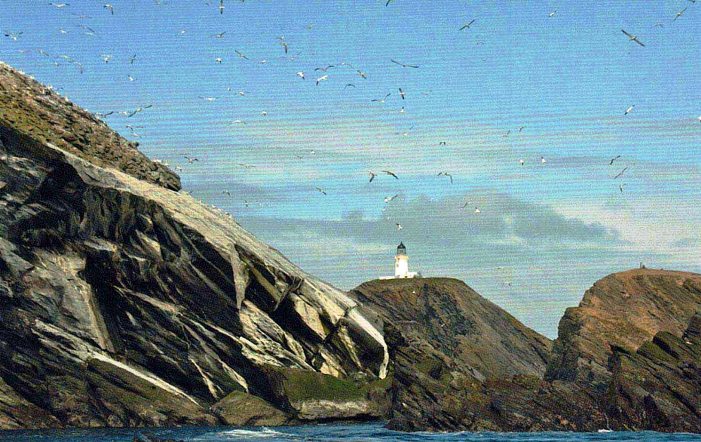 |
| Muckle Flugga |
can only be glimpsed. On the way, you pass through the small village of Baltasound, which has within its little general store the most northerly post office in Britain. The postmistress will happily sell you a picture postcard of the village and frank it with the commemorative rubber stamp before accepting it for the mail. Unst is the home of the charming but often quick-tempered tiny Shetland pony. There are breeders of the ponies around Shetland, but you will see many on Unst, grazing in fields by the roadside.
As you tour around Shetland, marvelling at the starkly beautiful, rugged coastal scenery and the many cliffs with their populations of nesting seabirds, in the outlying villages you may find a modest café that provides tea and coffee but offering only a few sweet cakes as food. I will briefly mention some other aspects of this most northern archipelago you may find of interest, if this tale motivates you to make a visit, as I believe that doing your own research and the subsequent exploration are a big part of any such expedition.
Esha Ness is a headland on the Atlantic west coast of Mainland, less than an hour from Lerwick, with magnificent rugged coastal scenery and a Stevenson lighthouse. A geographical feature of Esha Ness is a dramatic gorge that runs a kilometre inland from the sea as if slashed by a Viking axe.
Haroldswick is a settlement in the north of Unst. As the name suggests, there is a strong Norse influence and there are a Viking Museum, a longhouse, and a longship to explore. Everywhere there is evidence,
 |
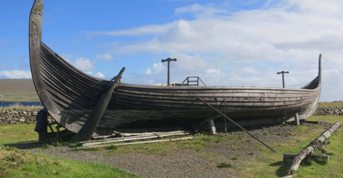 |
| Longhouse |
Longship |
by way of ruins and names of places and people, and particularly by the melancholy sight of ruined churches and abandoned graveyards, of widespread occupation to the furthest extent of the islands, of the Vikings who settled there, and of a flourishing rural population till the early 20th century.
Shetland’s Viking culture is celebrated each New Year by the Up Helly Aa torchlit procession of bearded and
armed ‘Vikings’ that culminates in the ceremonial burning of a specially constructed Viking longship. Orkney and Shetland fly their own regional flags and, in this, demonstrate their difference from the rest of Scotland. Shetland’s is a white Nordic Cross on a blue ground, in its colours similar to the Scottish Saltire(1) but with the vertical cross rather than the diagonal Scottish one. You will rarely, if ever, see the Union flag of Britain that combines the flags of Scotland England and Wales flying in either Shetland or Orkney. You will see the Scottish Saltire printed on the plastic bags of the Lerwick Tesco supermarket but not elsewhere.
Throughout the islands you stumble over little museums dedicated to some aspect of Shetland life. In Lerwick the large Shetland Museum, ceremonially opened in 2007, is comprehensive and gives a broad picture of the culture and history of Shetland. The culture is strong in seafaring activities. A boat known as a ‘sixareen’ was formerly used for fishing in the Atlantic Ocean. The heart quails to think of such a small boat
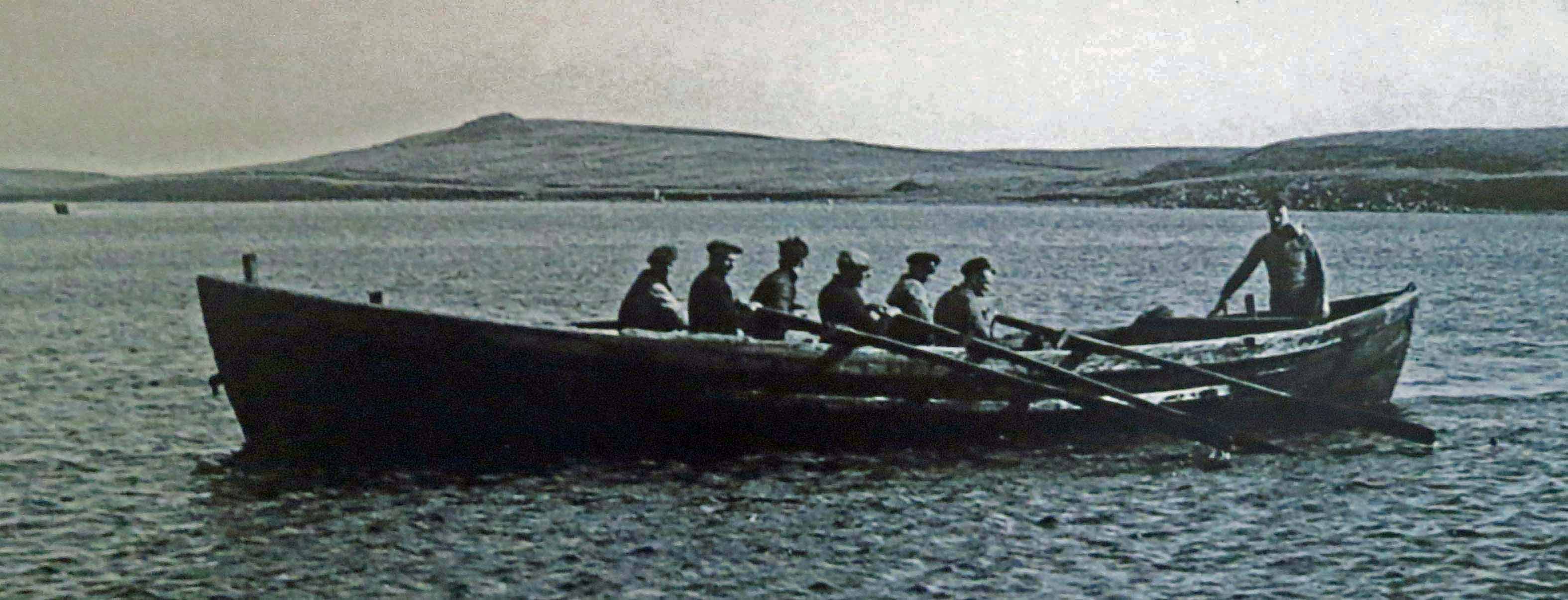 |
| A Sixareeen |
rowed by six men competing with the Atlantic waves and history tells of many fishermen’s lives lost for Shetland at one time had a fishing industry that sold fish to the cities of the Hanseatic League.
While Orkney has a larger collection of prehistoric settlements and structures, Shetland is not without such attractions and there are brochs(2) to be seen, most notably the restored Clickimin Broch in Lerwick, where you can crawl in and marvel at the drystone-building skills of the ancients.
The smaller town of Scalloway, a mere 15-minute drive from Lerwick, on the west coast of Mainland, has a dramatic 17th century castle, the key to which is available on request, and you can wander through it. Scalloway is also where the World War II 'Shetland Bus'(3) was based and there is a museum dedicated to it in the town. Shetland Islanders are proud of this wartime activity these many years later.
The furthest north the visitor can drive on Mainland is to Isbister, just a couple of houses and a few incredibly white sheep huddled away from the wind. The ‘bister’ part of the name is commonly found and signifies a settlement. The furthest south is Sumburgh. On the way there you can visit St Ninian’s Isle, a small grassy island, named for an early Christian saint. It is connected to the mainland at low tide by a narrow strip of sand known as a tombolo. It is possible to walk to the island at low tide, but the visitor should pay heed to the posted warnings about returning before being trapped by the rising tide. St Ninian’s Isle is said to have the largest such geographical feature in Britain. Closer to Sumburgh on the same road is the Scatness Broch, another example of this Iron Age dwelling.
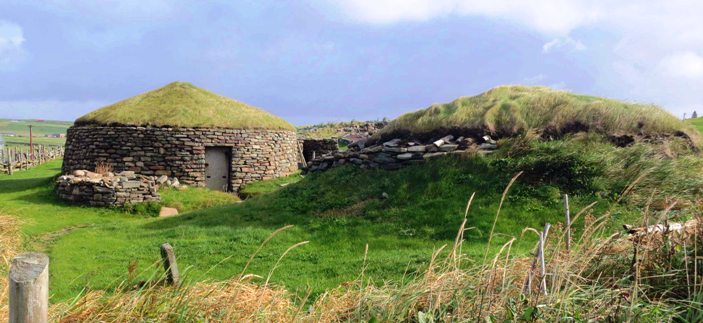 |
| Scatness Broch |
On our own visit, we heard many English accents. On asking why they were there, many said they had ‘emigrated’ from the overcrowded, industrial parts of England, particularly the Midlands and south-east England and had done so to get away from the busyness and pressures of life in those regions. None expressed regret over their move. Although Shetland maintains a robust spirit of independence there is frequent traffic by ferry and passenger plane between Shetland and mainland Scotland.
If you wish for a travel experience different from the normal tourist runs and a chance to see a part of our own country that still has an isolated and unique culture, and which many of us know too little about, you could consider Shetland, a part of Scotland but with a different flavour and back story, which gets fewer tourists than it deserves and which remains largely unspoiled. You will be able to feast your eyes on a rugged beauty of land- and sea-scape, observe the many colonies of seabirds and seals, browse ancient ruins from Scotland’s prehistory and communicate with a populace that is courteous and approachable but still retains some of the independence of spirit that stems from its history of Norwegian nationality, which is still cherished. It is an experience to savour and remember.
Footnotes
(1) The Saltire is the Scottish white diagonal cross on a blue background. It is incorporated in the union flag
| The Saltire |
Norway |
Shetland |
of Great Britain. The Saltire is also often called the St Andrew’s Cross. The Saltire is the official flag flown on Scottish government buildings. The St Andrew’s Cross spider lives in Eastern Australia and is commonly seen hanging in its vertical web, splayed out in a diagonal cross configuration.
(2) A broch is an Iron Age, round, drystone construction, somewhat beehive-shaped, found all around Scotland, including the Western Isles as well as in the Northern Isles.
(3) The Shetland Bus was a clandestine small boat ferry service that operated in WW2 between the little port of Scalloway on western Mainland and the Norwegian coast. Originally crewed by Shetland fishermen but later taken over by the Royal Navy,
it carried spies, saboteurs, arms, supplies and documents in both directions until Norway was liberated in 1945.
|
|
 |
 |
An Accident? – 2
Hugh McGrory |
 |
 |
It was a Saturday evening in April 2018, and I was in Dundee – actually I was in the suburb of Broughty Ferry, driving back westward in my rental car along Queen Street (aka Ferry Road, to Dundonians). I had just spent a pleasant evening at the home of my friend, Dunc, eating dinner and watching Manchester United beat Tottenham 2-1 in the semi-final of the FA Cup.
It was just before sundown, and the blinding sun was aligned perfectly with the
stretch of road I was on
making it very difficult to see ahead. I had the sunshield down and had to sit up straight so that I could keep my eyes above the bottom of the visor.
I was the first car in a platoon and had to stop at traffic lights at the junction with Fort St, just by the Post Office Bar. When the lights turned green, I pulled away – the road began to climb – this caused the sun to slip below the visor and hit me like a searchlight. I was blinded for a moment – then suddenly in shadow.
The relief I felt was instantly wiped out when I realised that
| |

|
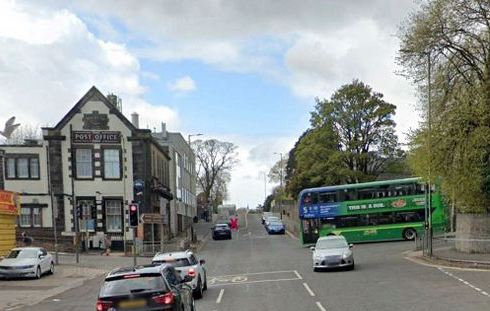 |
the cause of the shadow was a single-decker bus parked by the side of the road. I slammed on the brake and wrenched the wheel to the right – too late, as the front passenger side of the car hit the right rear corner of the bus - see red 'X' in photo. (The bus was owned by a company called Stagecoach which provides local bus service under contract to Dundee City.)
The good news was that no one was hurt. The young driver of the bus appeared, I asked him if he’d call the
police and he said he’d already informed his dispatcher. As you can imagine from the photo, the car was not driveable, but as we waited I managed to reverse it out of the traffic and tuck it in behind the bus. There wasn’t much damage to the bus, and the driver said that he hadn’t realised what had happened until the passengers told him – said he did hear a noise but thought it came from his engine.
Two police cars showed up and one, with two constables who looked awfully young, stayed. I explained that I was blinded by the sun and they said that it was a well-known problem at this location. The cops were very pleasant, and apologised for the fact that they were required to breathalyse me.
It happens that at dinner that night, Dunc had offered me a beer or a glass of wine with the meal which would normally have been a very acceptable choice for me – but
| |
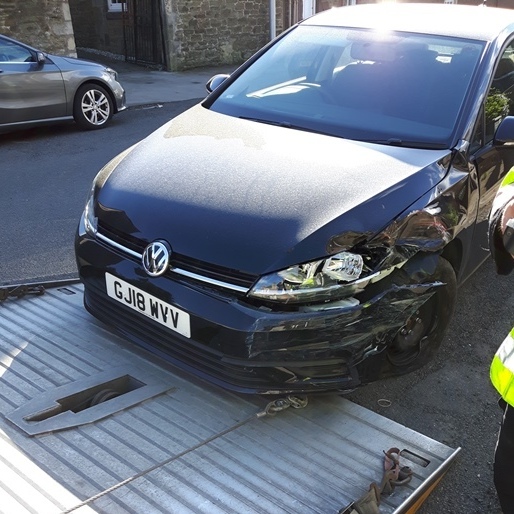
|
that night I said I’d prefer a glass of Irn-Bru (a favourite Scottish drink from my chidlhood), if he had any, which he did – thank goodness – so I was able to say to the constable, “That’s fine, I haven’t had any alcohol and it’ll be a new experience for me.”
So he gets out the machine, fits a new mouthpiece and says “Blow hard until I say stop”. I do. He says “Just a minute”, fiddles with the machine, then says “Try it again.” I do. He says “Just a minute”, fiddles with the machine, then says to his partner, “This thing isn’t working.” They both fiddle with the machine then say, “Try it again.” I do… They say, “Forget about it – it’s obvious you haven’t been drinking.”
Then I reached for my phone to report to the hire company and found that I’d forgotten to bring the damn thing with me… One of the cops said “We’ll call them for you”, and they did – a tow truck was on its way.
My cousin Frank lived just a couple of minutes away, so I asked if they would call his number for me and he headed down to help.
When the tow truck arrived the driver, Alex, hooks up the car and says, “Where do you want me to take it?” I say, “I’ve no idea, you tell me…” It turns out that he works for a towing company contracted to the hire car company and just gets told where to pick up and where to deliver. So he calls base and they say “The car and driver have to come to Glasgow Airport tomorrow”, and that we should put the car somewhere overnight. So we found a place on a side street for the car, the tow truck driver said he’d come back in the morning, pick me up, then the car, and we’ll head to Glasgow. Frank drove me home, and the next day I travelled to the Airport in the tow truck.
The car hire company said the quick estimate of the cost of repair was £2,300. They charged £1,000 to my VISA card, this amount would be adjusted after repairs were complete and I would be responsible for the full final amount. They then gave me gave me another car and I headed back to Dundee.
At this point a little primer on rental car insurance:
My car insurance does not cover rental cars in the UK. When you hire a car there, Third Party Liability is included by law, and the charge is added to the hire cost. (Third-party liability insurance protects you when you're at fault in a motor vehicle accident. It covers the victim's property and any medical costs due to injury.)
The car hire company will offer you a Collision Damage Waiver. This is not insurance but it will cover damage from an accident, vandalism and/or theft of the car that you are renting. They may be quite aggressive in trying to get you to buy this. It will cost you a daily charge on top of the cost of renting the car and may be around double the rental cost. A big money earner for the rental companies…
I was able to refuse this since I had coverage from the VISA credit card issued by my bank (and that I used for the transaction). This was the first time I had to access this cover, and I was somewhat anxious as to how it would work…
To cut a long story short, whilst it took several months and quite a few email and phone exchanges, at the end of the day I was completely reimbursed.
All-in-all it was an interesting experience, and while I can hardly say “No damage done,” it could certainly have been much worse.
One bright moment in the whole affair came a couple of days afterwards… My friend Jim Howie (in the same year as me at Morgan Academy and author of several stories in this collection) called me up. He said,
“Have you seen today’s Courier (the local paper)?”
“No”, I said, “why?”
“You’re famous, even got a headline…"
“You’re kidding – what did it say?”
He said, “I’ll read it to you.”
“STAGECOACH HOLDUP ON FERRY ROAD – POLICE QUESTION PENSIONER”
|
|
 |
 |
Yugoslavia 6
Michael Marks |
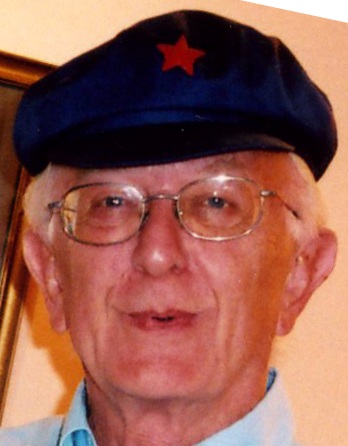 |
 |
Following my Morgan/British Council sponsored visit and my next visit 25 years later, Sheila and I spent many happy holidays with Deso and his family, and we discussed the possibility of buying a piece of land near Deso’s own holiday house. This proved impossible as foreigners were banned from – Fitzroy Maclean excepted.
We had often had lunch in a secluded inn about twenty minutes from Ljubljana. So often that we got to
know the innkeeper very well. Once, we arrived at the inn only to find it closed – for the first time ever. Just as we were leaving, the innkeeper saw us and invited us in. We asked him why he was closed, and he explained that the inn was booked for a private function later that day.
After our rather later than intended lunch and just as we were about to leave, the guests for the evening started to arrive. To our great surprise, they were all male and smartly dressed in business suits. On our way out, the innkeeper introduced us to one of the guests and explained why we were there, including how we came to know each other – Morgan Academy and all.
The guest listened with interest to our history of connections
| |
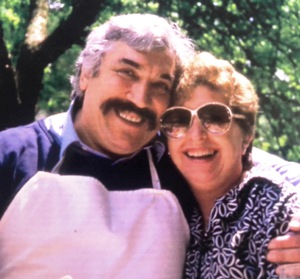
|
with Slovenia and what we loved about the country. Then he asked a strange question – what was there about the country that we did not like? I explained that while he, for example, could buy a house in Scotland or England, we could not do the same in Slovenia. He said, don’t worry, you soon will be able to do this!
The next day I told Deso about this and he asked me what this man looked like. He turned out to be the leader of the Slovene non-communist secret opposition party and about a year later became the first president of Slovenia.
Hugh asked me to write a little about the difference between communist and non-communist and the anecdotes above shed a little light on this. Basically, the difference is freedom. The freedom to do within reason what you want rather than what the state decides you may do. The freedom to own property or to own things. The freedom to decide what to do with your life.
Nothing is perfect. Some of the charm of the country has been lost. But the great majority of the population live better lives now than was ever possible under the communists. Many people have regained some of their assets lost not only to the partisans but to the communist regime. On the whole, the current leadership is for the best.
|
|
My previous story dealt with correcting vehicle skids, and an email in response, from an old friend, reminded me of a related issue…
Many of you will have been driving for many, many years – some more than 60...? In that time, I’m sure that, amongst us, there have been a few major accidents, quite a lot of fender-benders, and more than a few near misses? I’ve been fortunate to have escaped the first category but have had quite a few of the other two over the years.
Some thirty years ago on my way home, I stopped at a little plaza to pick up some milk. The actual location, for those who know Toronto, was Lawrence Avenue at Curlew Drive. There are traffic lights at the
intersection and the X on the maps shows where the incident occurred just at the entrance/exit of the plaza.
I had been parked in front of a little convenience store (now the office of a physiotherapist) and had reversed
out of the parking spot and headed for the exit. I looked to my left, didn’t see any traffic, then gave my
attention to my right. I was concerned since it was close to the traffic lights, and I was afraid someone might come through the lights quickly. Seeing nothing coming, some part of my stupid brain said “no need to stop at the exit, then” so I kept going. As my gaze came back to straight ahead, I saw a car right in front of me and proceeded to plow into the right passenger-side door (a classic 'T-bone' collision).
The driver of the other car (a young woman in her twenties) told me that, at that moment, she saw me and was thinking "Oh I hope he’s going to stop” while I was saying
| |
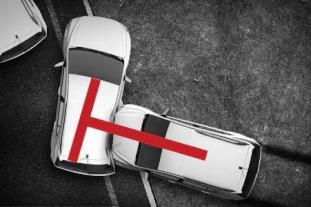 |
to myself “Where the hell did that car come from?”
Once the initial shock wore off, we realised that the fates had been kind to us – neither of us was going that fast (I, because I was just beginning to accelerate, and she because she was slowing for the traffic lights), no one was injured, and no other vehicles were close enough to be involved.
Ontario had recently created a system of Collision Reporting Centres for ‘fender-benders’ (a self-reporting
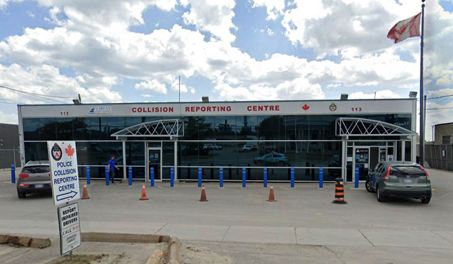 |
 |
system designed to make better use of police officers by concentrating on major accidents) and since both cars were driveable, we set off to report the accident. The process turned out to be reasonably simple. The woman’s husband turned up (and I did tell him that his wife was in no way to blame).
I still couldn’t figure out how I managed to miss seeing her car, so I retraced my steps to the scene drove into the parking lot and it was obvious… There was a row of
|
newspaper boxes – three selling national papers via money-in-the-slot (the Globe and Mail, the
Toronto Star, and the Toronto Sun) and a couple with free offerings. There was also a telephone cable system box, and, I think, a post box, all lined up in a row forming a little wall just before the exit from the lot.
Her car was obscured from my view when I checked left – not that this is any kind of excuse for my hubris – I should, of course, have stopped before pulling out onto the street.
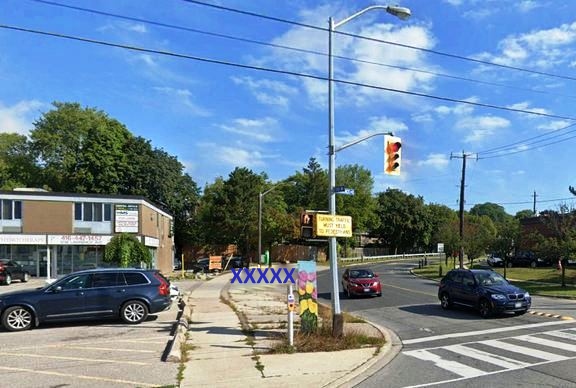 |
| The 'Xs' represent the boxes (the red car is in the position of the victim at the moment of collision). |
I remember, as a bairn, my mother telling me to “look right, then left, then right again”…
Always listen to your mother!
|
|
 |
 |
An Escapade Goes Bad...
Gordon Findlay |
 |
 |
My career as a Military Policeman came to an end in a rather ignominious fashion. Here’s what happened.
After a couple of months at the Musselburgh detachment a few of us were getting a little antsy, bored, and in need of some diversion. That’s when we came up with The Idea. It was the brainchild of Bob Finlay (again I hasten to add – no relation).
One evening he said: “Look, we’re stuck out here, miles from anywhere, no good pubs, no decent dance halls – nothing. But,” and here he paused dramatically, “I’m good pals with the RASC sergeant who looks after all the vehicles in the yard. When I asked him, he agreed not to lock the gate to the yard some evening when we want to go into Edinburgh for a night out.
“The keys to all the trucks are in the maintenance office. All we have to do is pick out a 15-cwt,get into the
city, have some fun, then bring the truck back before reveille, lock the gate – and we’re home free!”
Four of us didn’t need much convincing. We looked at our duty schedule and found a date when we would all be off the duty roster. That would be our boys’ night out...
It worked like clockwork. On the evening in question four of us dressed in our civvies, slipped out of barracks and quietly opened up
| |
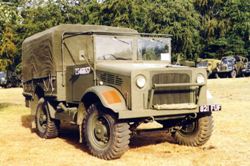 |
the gate to the RASC motor pool yard. We picked out a nice clean 15 cwt truck that had come in for maintenance, checked that it had been serviced, found its key in the maintenance office and ten minutes later we were bowling down the road to Edinburgh and a night on the town. We went to one of the good, lively pubs off Princes Street, then found our way to the Heather Club dance hall just off Lothian Road.
As you probably know, I was no better a dancer then than I am now, but after two or three McEwen’s strong ales, well – everything looks bright and inviting and you even imagine that you can dance pretty well.
I recall it was around midnight by the time we made our way to a fish-and-chipper and had a late supper (for me, a batter-covered black pudding and a massive helping of chips – that is, french fries). Then it was back to our truck and a nice easy drive back to Musselburgh MP barracks, with the prospect of a good snooze, knowing that we had quietly beaten the system and won ourselves a good night out.
Only – we hadn’t.
Of all the nights for the four of us to pick for our slightly illegal night out, which night did we pick? Of course – the night of the National Census throughout Great Britain, when at midnight of that day everyone in the country had to have been counted and checked off. On that day, all over Britain, checkers went door to door verifying residents, checking on family members, on the number of parents, children, and other dependents; on the size of the homes and apartments, on the cars they owned, on the money they earned, which school they attended, and so on, and on.
And of course, when the Census-takers came to the Musselburgh barracks of Military Police detachment 33-ES (East Scotland) they found that four MPs who were off duty were not on the premises, and had not signed out (as they were required to do by Army regulations). Moreover, it was also quickly discovered that a 15-cwt trick was missing from the RASC motor pool.
It was not long before our neat little plan came apart like wet newspaper. We were “absent without leave and unaccounted for” and on a more serious note: so was a valuable piece of Army property.
Which is why all four of us were all roused from our beds before reveille the next morning and told that we were all being charged with being “absent from barracks” and “theft of military property.”
It was all over pretty quickly. We were marched in together around 9.00 a.m. into the C.O.s office where the charges were read out to us and we were asked if we had anything to say. Well – what was there to say? We hadn’t signed out from barracks as required; we had illegally taken an item of Army property, namely a 15-cwt truck; we had illegally used Army petrol in driving the truck; and we had neglected to sign in when we returned from Edinburgh. We were up S - - t Creek with no paddle in sight.
None of us said a word. We were dismissed and within the hour we learned our fate. All four of us were to be released from the Military Police (law-breakers are not allowed) and we were to be re-assigned to another branch of Britain’s military machine. I can remember the four of us were pretty subdued as we read the notice posted on the bulletin board.
The next day when we were again marched in front of our C.O. we were mum when we were told that we were off to join an infantry regiment – the 1st Battalion The Highland Light Infantry, currently stationed at Fort George in Inverness, Scotland.
As a parting piece of advice, our C.O. said: “I would recommend that when you get to the H.L.I. you keep it to yourselves that you are all former military policemen. As you probably know by now, MPs aren’t too popular with the rest of the Army.” It was good advice. We took it.
|
|
The MacDonald-Cartier Expressway in Ontario, Canada, runs for almost 560 miles, all the way across
Ontario from, in the west, the Detroit/Windsor border crossing, northeast to the Ontario-Quebec border. It is better known as Highway 401 or simply the '401'. (Some of you may recognise this from the Discovery TV channel programme 'Highway to Hell / Heavy Rescue: 401').
It acts as a by-pass for traffic that wants to avoid downtown Toronto, but also carries lots of urban and suburban trips by
Torontonians. Where it passes the Pearson International Airport it is 18 lanes wide – traffic
counts on this stretch have shown almost 500,000 vehicles a day which makes it the most heavily travelled road in North America ahead of the Santa Monica Freeway in Los Angeles, and the I-75 in Atlanta.
In the ‘80s my wife, Sheila, and I decided to go back to school – Skid School that is; not sure now what inspired it – perhaps just the idea of something different to do one weekend, with a useful new skill on completion.
It was a four-hour course and took place at what looked like a large former parking lot southwest of Toronto, halfway between Mississauga and Hamilton. It was on Bronte Road north of Lakeshore Road West (I just checked and it's no longer in operation).
We were two of six students – they wisely split up husbands and wives, so I found myself in a car with an instructor and two strangers. The surface had been wetted with water and some kind of additive to get an appropriate slippery condition. The instructor did some demonstrations of what he was going to teach us, then we each had a turn at the wheel with the spare two in the back seat.
The car was fitted with a handbrake on the instructor’s (passenger) side so that he could lock the wheels and cause a skid that we then had to deal with. I was OK when driving, but as soon as I got in the back the sliding, spinning, jerking, and sudden stops brought on my innate tendency to car sickness, so I had to be let out and stand on the sidelines to recover when it wasn’t my turn to practise (embarrassing, but it hadn’t occurred to me…)
Apart from this, the course was quite good, and we left knowing a lot more about what to do if our car suddenly made a break for freedom – of course, the proof of the pudding...
A few years later, I was driving on the 401 between the 404 and Markham Road. The 401 along this stretch was twelve lanes wide in four three-lane roadways, two east, two west. I was in the core eastbound roadway (generally used if you were going further – the outer (collector) roadways were used for shorter trips and had the interchanges with the major cross-streets).
It was winter, cold, but bright and sunny. There had been a snowfall the previous evening, but if there's one
thing Canadians know it's how to manage snow, and the snowploughs had been out during the night. The road surface had some remnants of snow, but it seemed fine to drive on and I was cruising along at about 110 km/hour (about 70 mph) in the slowest lane, not a care in the world...
Suddenly the front of my car decided, in a split second, to turn left – I still have no idea why – perhaps I tweaked the accelerator or moved the steering wheel too sharply, or...?
| |
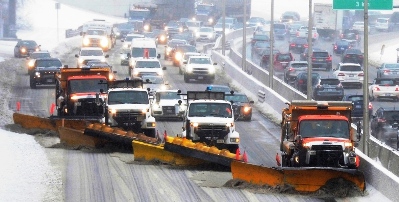 |
In any event, I was suddenly heading across the next lane to mine and my car seemed determined to perform a doughnut!
Would you believe it, in that split second my brain remembered the instruction from skid school (this was before ABS (Anti-Lock Braking Systems) became standard...) summarised as: “feet off the accelerator and the brake; look in the direction you want the car to go; and turn the steering wheel like a maniac in that direction.”
It worked – the nose of the car jerked back to the right – an over-correction which needed a swift turn of the steering wheel to the left followed by a few more, minor corrections to straighten us up in the original lane.
By a stroke of good fortune, there were no cars or eighteen-wheelers close enough, either to the side or behind, to be involved. I was able to drive on as before, though slower, as my heart rate slowly returned to normal. I hate to think what might have happened if the road had been busier – unusual for the 401. How lucky was that? If there had been cars and trucks closer to me, it might have needed the ‘Heavy Rescue’ units to clear up the mess!
|
|
 |
 |
A Scottish take on Aussie English
Part 1 of 3
Brian Macdonald |
 |
 |
English is not one language. It is many, all essentially the same but all different in a number of ways. The rules of grammar and syntax are the same wherever English is spoken but their observance is often cavalierly disregarded or modified by local usage. As for spelling, the USA has adopted a simplified version for many words that may confound standard English pedants. Very different regional accents have developed around the globe from contact with the way native people whose prime language is not English pronounce English and from the variety of accents that the first English speakers brought with them from home to their new environment.
English spread, during Britain’s era as a colonising sea-power, from its source, the melding of Roman Latin, Anglo-Saxon, Norse and Norman French languages, largely through the presence of English speakers, often the members of British military forces imposing imperial sovereignty on the local populace, but sometimes by peaceful colonisation. In such cases the language of the in-comers usually became the official language of government and bureaucracy. Local languages became restricted to the native people and dwindled in importance and use as the local upper classes adopted the language, mores and dress of their conquerors, with whom they wished to be identified. In my adoptive Australia, the original Australians spoke over two hundred different tribal languages, most of which are now, sadly, dead. Some have survived and are being robustly revived.
From an early age I was a voracious reader. I kept DC Thomson(1) in profit by buying the Beano and the Dandy weekly comics, then the Wizard, the Adventure, the Rover and the Hotspur with their tales of Matt Braddock, the bomber pilot, Wilson, the mysterious athlete clad in a black, one-piece bodysuit, Alf Tupper, the working-class runner, the Tough of the Track (who trained on a fish and chip diet), Blockbuster Brown, a mild-mannered schoolteacher who moonlighted as a wrestler and Gorgeous Gus, a rich man whose right foot could propel a football with amazing ferocity. The Eagle was a more elevated and educational comic, founded in 1950, just as I hit my teens and I enjoyed not just Dan Dare and his arch-enemy, ‘the Wee Green Mekon’ but also the scientific articles and the exploded diagrams of great engineering projects.
The Dundee Courier, the Evening Telegraph, the Weekly News (especially the sports pages with Dinny Drappit the goalie and Aulden Dunne the centre-forward) and the Sunday Post were all grist to my insatiable mill, and were read from cover to cover, even Francis Gay’s Friendship column. As I have said in another article, I was the holder of an account at Frank Russell’s bookshop, then located in Barrack Street in central Dundee, and made good use of it over a number of years. I found at school that I had a facility for and an enjoyment of languages that extended even to the minutiae of English grammar and parsing. The joys of written and spoken language and a love of reading and writing are traits that endure in me to this day.
I have had the luck to live in a number of different English-speaking countries. With a lifelong interest in spoken and written language, I relish the regional uniqueness in the spoken tongue and enjoy (and often adopt) colourful local expressions. I have delighted in the differences from my native Dundee or from standard BBC English that are found in England, Northern Ireland, the Irish Republic and Wales. When our daughter was born in Northern Ireland, I was asked by a workmate if the child was ‘plain or stone-finished’. Took me a wee while to work that one out.
In 1966, my young wife, our new-born daughter and I emigrated to Australia. We arrived one day before Australia Day(2) in 1967 and have lived in four different states of this vast land since then, most of the years in Melbourne. We were prepared for warmer weather, a different diet, a new job, different housing styles and numerous challenges to be dealt with, although we naively believed the culture would be similar to that we had left. But I was not prepared for the many differences in our common language that I encountered with delight, amusement and sometimes bafflement.
Australian English, as spoken by ordinary people, spoken quickly, as foreigners complain it often is, can be hard for the untutored ear to understand. When colloquialisms are added to the mix it can be incomprehensible to the stranger. How Europeans, many of whom speak excellent standard English, understand us, I wonder. They are, in contrast, usually well enough understood by locals. There is not much by way of distinctly different local dialects and accents in Australia, even comparing cities as far apart as Sydney on the east coast and Perth, WA, on the west. Even a lifelong Australian resident with a good ear would find it hard to place an accent geographically although there are some differences in word usage from one part of the country to another that are giveaways.
To be continued
Footnotes
(1) D C Thomson is the largest independent publisher in Britain, founded in 1886 but not so named till 1905. It has always been based in Dundee, Scotland. It represents the ‘Journalism’ in the ‘Jute, Jam and Journalism’ label formerly applied to the city.
(2) Australia Day, 26th January, commemorates the arrival of the First Fleet(3) which sailed from Portsmouth on England’s south coast and landed on that day in 1788 at what the explorer James Cook had named Botany Bay, to colonise what the British government assumed to be an uninhabited land. In the 21st century the Australian Native people, who have inhabited this land continuously for 40,000 years, are now demanding that the date of this day of celebration of white Anglo-Celtic colonisation be changed, as that day is known to them as ‘Sorry Day’.
(3) The First Fleet consisted of eleven ships, of which six were convict transports, commanded by the naval officer Arthur Phillip, bent on establishing a penal colony at the place in Terra Australis where the then Lieutenant Cook had landed on his previous exploratory voyage in 1770. The first colony, Sydney Cove, which became the city of Sydney in the state of New South Wales, was composed of those convicts (both male and female) plus a contingent of soldiers and their officers. A stream of later voyages brought more convicts and members of noble families sent by their families to be out of the way as black sheep. The last shipment of convicts was to Western Australia in 1868. By then there was a good flow of free settlers to a young country.
Melbourne was founded in 1836 as a commercial venture, from the southern island of Tasmania, which was originally Van Diemen’s Land after a Dutch governor of the East Indies. It was so named by the first European sailor to discover the island, the Dutch Abel Tasman. Subsequently it was the British who renamed it Tasmania. It had been colonised directly from Sydney. The expedition to the southern mainland was led by John Batman, a grazier and explorer, and founded a colony of free settlers. Batman landed at what is now named Blairgowrie, which was most probably named after a town near our own home city of Dundee in Scotland.
Named for Queen Victoria’s first prime minister, Melbourne’s mushroom growth in the later 19th century was due to the discovery of gold in the inland of what became the state of Victoria. As well as miners from many lands, including a good number of Chinese settlers who established their own mines but sensibly became growers of vegetables, shopkeepers and traders. Several large Victorian gold mining boom towns of the 19th century continue to have significant populations of ethnic Chinese origin, which are well integrated but maintain their ancestral culture and whose temples, dragon festivals and museums are a major part of community life in these cities.
South Australia’s capital city, Adelaide, was also a free colony. Inland Perth in the far west, originally founded from the city’s port town of Fremantle, had a convict source.
Today, claiming convict ancestry from the First Fleet is highly prized.
|
|
 |
 |
Tell Me When I'm Having Fun
Hugh McGrory |
 |
 |
Many years ago, my wife Sheila worked for the Ontario Government in the Ministry of Economic Development and Trade. One of her main tasks was to encourage and assist businesses to locate in the Province.
She came home one evening and announced that we had been invited to an evening function at the home of a prospect. Being my usual supportive self, I probably whined something like “Do I have to go?” Once I understood that I did, she gave me the invite which said “black tie” or some similar phrase.
I said “OK, I can rent a tux,” to which she replied “No, I think a business suit will be fine.” I was doubtful, “but maybe the phrase means something different in Canada than it does in the UK.”
“Well, one of my colleagues, Maureen, and her fiancée, Robert have also been invited I’ll get her to check with him.” The word duly came back that Robert, a Canadian, would be wearing a business suit to the ’do’ – so no problemo.
So, the day arrived, I dressed in my dark blue suit with a modest matching tie, and we drove over to the client’s small-mansion-type home.
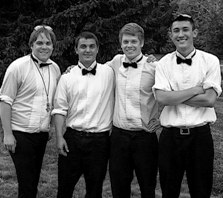 |
 |
I had my first “Oh, oh…” moment when I saw that there were young car-jockey’s in white shirts and bow ties parking guests’ cars. The second came moments later when I realised that the music we heard was coming from a mariachi group on the front steps.We walked into the house and I got my final “Oh, oh…” when I saw that all of the men in sight looked like a colony of penguins.
|
 |
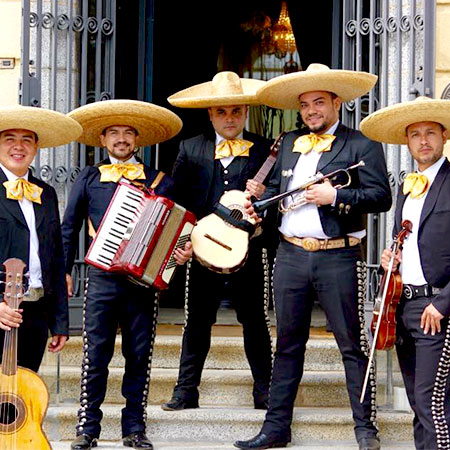 |
I thought, “Oh, damn, I guess Robert and I will be the only two schmucks not appropriately dressed.”
I asked Sheila if her friend had arrived yet and she said “No”, then “Oh yes, they just came in…”
I looked up to see Maureen, whom I'd met before, walking towards us followed by Robert, a tall good-looking fella looking very sharp in his TUX AND BLACK BOWTIE...
 |
$%^#$%^&*!!!
I could have looked like this guy... |
|
|
 |
 |
Yugoslavia 5
Michael Marks |
 |
 |
The remainder of my month with the Yavornik family passed too quickly and we parted company at the railway station, promising to keep in touch. My journey home was uneventful.
We did keep in touch, but inevitably less and less frequently. As the years passed I married, and we soon had two daughters to look after. There was always a good reason to postpone a return to Ljubljana and Deso also had travel restrictions caused by the communist regime. By 1971, I was living in Manila so there was yet another potential barrier to a return trip. How to get from Manila to Ljubljana and on to the UK?
When 1979 arrived my wife and I decided to bite the bullet and celebrate a very long postponed anniversary - a quarter of a century from my introduction to the Yavorniks. We realized that if we didn’t go that year we might never do so.
We took our annual home leave in December to be with our daughters for Christmas together with our families in Invergowrie and Blairgowrie and agreed to go to Ljubljana en route. We could fly to Trieste, hire a car, drive to Ljubljana, meet the Yavorniks for a couple of days, drive back to Trieste and on to the UK - simple! And that is where Fate took a hand.
For reasons not relevant to this story, our flight from Manila involved changing flights in Athens. At this point we were told that there was thick fog in northern Italy and Trieste airport was closed. We rearranged our flight and managed to get a flight to Rome. At least travelling in the right direction!
We had hoped that we might find an alternative flight to somewhere else in north Italy and get to Ljubljana that way. No joy. The airline paid for a rather rundown hotel for the night near Rome airport. Next morning we got to the airport early and tried our luck. Bliss! The fog in north Italy had lifted and there were two seats on the next flight to Trieste. We landed in Trieste and went to get our hire car. There wasn’t one.
We explained our problem and they not only found a car for us but upgraded us to a BMW. Now we had sunshine and a car and had only lost a day. We arrived that same morning in Ljubljana.
Now all we had to do was find Deso’s new apartment.
We stopped and asked for directions and soon arrived at the correct address. Or rather where it ought to have been. All we could see was a row of shops. There was a door in the middle of the row, so we tried it and got in. Now at last our luck had changed. Not so.
On the first floor we found the correct apartment, with an envelope pinned to the door and our name on the envelope. Inside the envelope was a note saying that Deso was sure we would turn up (even a day or so late) but he had to leave and would phone us that afternoon at a nearby hotel where he had booked us a room.
We easily found the hotel and yes, there was a reservation for us. Better news still, the hotel was a new Intercontinental! More on this in the next installment.
Deso duly phoned and explained that this was a bank holiday. The family were spending it in their country house (see also my next column). We agreed that I would drive down to the nearest village where Deso would meet us and take us to their house. We would meet at the village of Visna Gora. No problems. We did a little shopping, had a dinner and a drink or two and so to bed.
All was at last going well - or was it? Next morning we woke to see thick fog!
We set off driving very cautiously and managed to find the village and a few minutes later Deso arrived. The reunion with the family was a great success. The whole family were there and Sheila (my wife) got a great reception.
I know she was relaxed because that evening we had a swim in the hotel’s indoor heated pool. Sheila can swim but is nervous, and never swims unless her feet can touch the bottom. That evening she swam several lengths!
|
|
In my last story, Dr. Sophie had asked me about taking part in a research project as a subject – so what was that all about…?
Well, as you know, our blood circulates around our body through arteries – which take oxygenated blood outwards from the heart, and veins – which bring the blood back again. The transfer of the blood between these is accomplished by capillaries, vessels which are so tiny that blood cells have to pass in single file.
Glomus bodies, like capillaries but independent of them, also provide a connection between arteries and veins – the purpose is to shunt blood away from the skin surface when exposed to cold temperature, thus preventing heat loss, or allowing maximum blood flow to the skin in warm weather to allow heat to dissipate.
There is a rare condition affecting these glomus bodies called glomangioma, where multiple benign (non-cancerous) growths of blood vessels occur. These are apparently caused by a mutation in a gene known as FAP68 (don’t ask me…). I was born with this mutation (which causes small visible, blue-coloured tumours under the skin) hence the request that I might become part of the study.
As you can see from the photos below, these tumours come in a variety of shapes, sizes, and various shades of red, blue, and purple. They also appear individually or in various clusters. Fortunately, despite having had these tumours since birth, they haven’t really bothered me apart from the odd collision with a ball, a stick, or a racquet, when they can be painful.
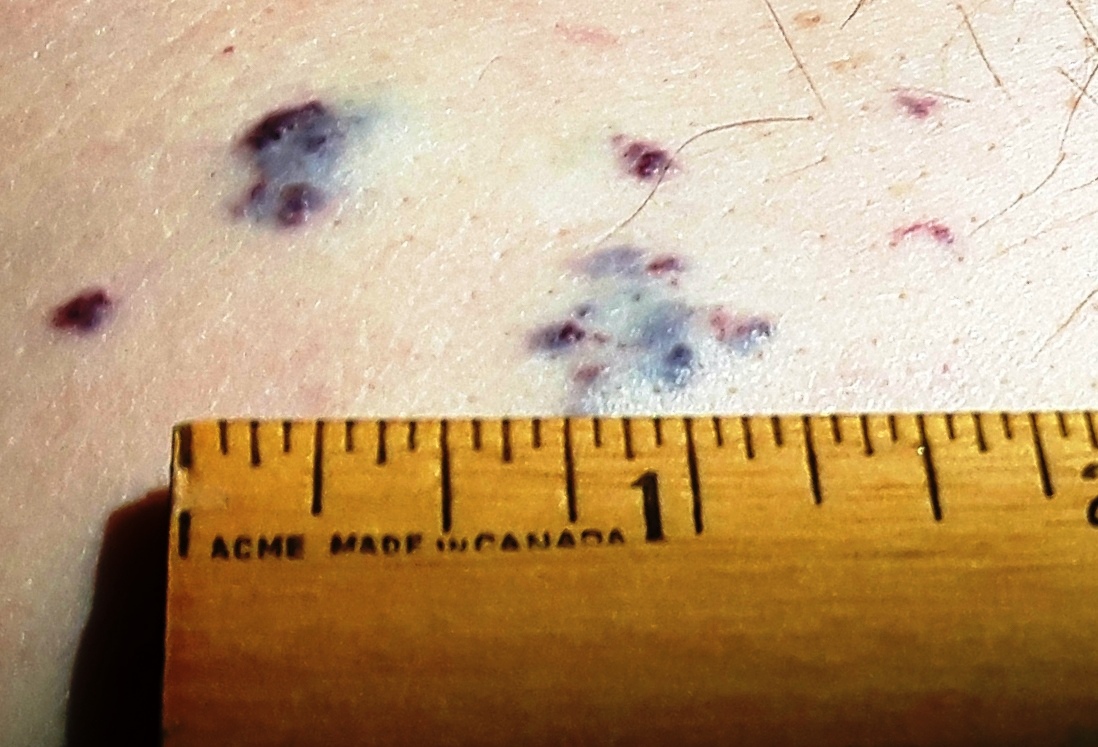 |
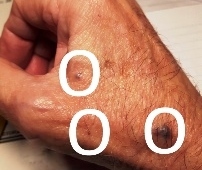 |
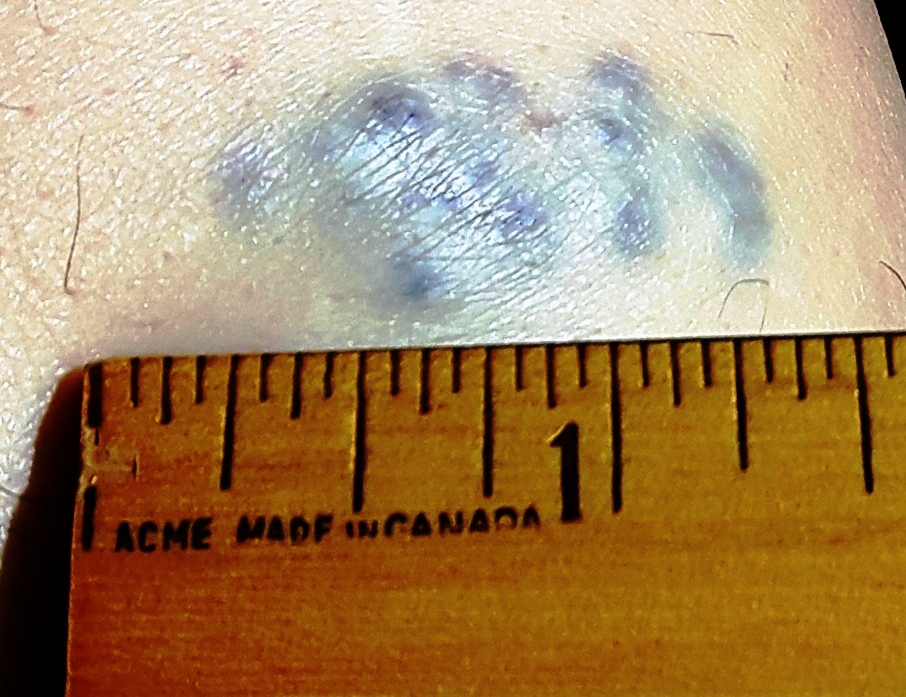 |
| My Chest |
My Right Hand |
My Right Hip |
So, to cut a long story short, a few weeks later I found myself in an examining room in the Dermatology Division at Women’s College Hospital in Toronto with the young(ish) Study Director and a colleague, both female. They wanted to examine my skin from top to toe, to document and count the tumours, photograph them, and biopsy one for study under a microscope.
They asked if I’d like privacy while I stripped and I said that since I had to be nude anyway it didn’t really matter so “I’ll just strip, you two can get your clothes off, and we can get started.” They stared at me for a moment amid dead silence in the room until I said “I figured it was worth a shot…"
So, they went over every inch of me, using a magnifying glass on occasion – final count of tumours was well over 100. They had asked if they could biopsy one, and in fact, talked me into a second one.
They said that they would be presenting their findings at an upcoming dermatology conference in Toronto and asked if I would attend to show off some of my tumours. I agreed, but when they sent me the details, I realised that I would be in Scotland on that date. So I lost my one and only chance to show off my magnificent body in front of hundreds of people…
As I said, this condition is rare. In organising the study, they contacted dermatology colleagues across Canada to see if they had patients with this condition and turned up the grand total of four (including me). At around this time my brother and I had been delving into our family history and in talking with the study director it occurred to me that there was a small chance that the four families may be related. I asked her if we could explore this, and she said the Ethics Board at the University of Toronto wouldn’t allow the release of the information.
I said “How about I give you written permission to release my details to the other three so they can choose
whether to contact me or not." She said it was worth a try and eventually got the OK from the Ethics Board.
In the end, two of the three corresponded with me. It would have been great to be able to tell you that we were able to identify a common ancestor – that didn’t happen.
However, it turned out that we three all had Irish ancestry, me in County Donegal, and they in Leitrim, Fermanagh, and Tyrone all of which have common borders with Donegal. So it suggests that we had a common ancestor in this part of the world back in the
| |
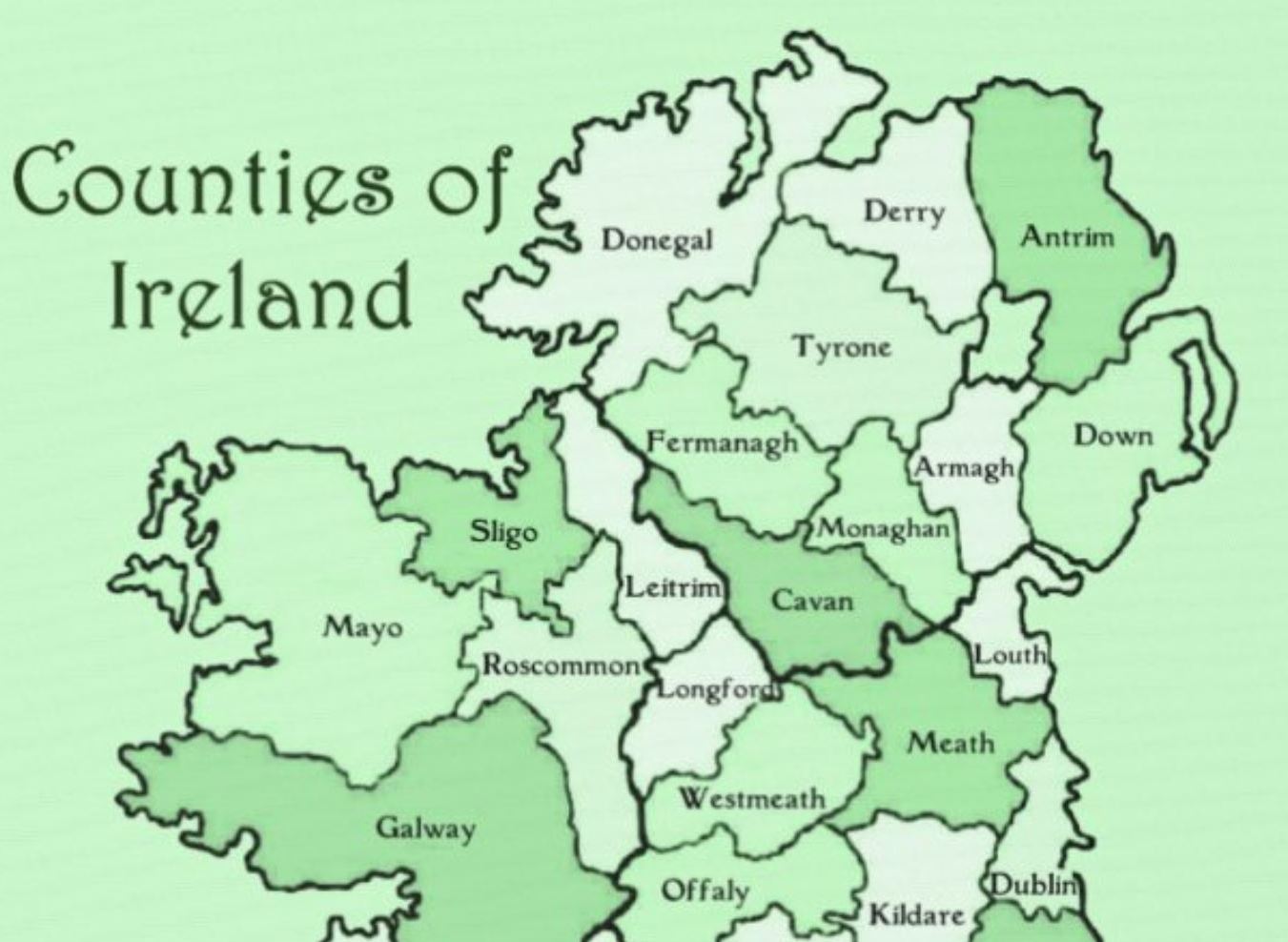 |
mists of time, who had this mutation, and passed it down to each of us...
|
|
 |
 |
A Little Live Action
Gordon Findlay |
 |
 |
Two or three weeks after we arrived in Edinburgh, I got my first taste of policing. Two of us had just finished our 6.00 to 10.00 p.m. shift and were walking back to the parking area behind Waverley Street Station where we expected to find our 15-cwt truck waiting to take us back to Musselburgh.
Instead, one of the sergeants from our detachment came running out of the station area and yelled at us to “get over here!” We followed him at a trot into the railway station itself – and came on a scene of battle. Half-a-dozen Army types were mixing it up with Air Force personnel, in a welter of bodies, arms and screaming curses. One Air Force fellow was lying full length on the platform, bloodied around the head and groaning softly. “Get ‘em apart!” roared our sergeant. Easier said than done.
Ever tried to get between two grown men, drunk but viciously angry and doing their best to flatten the other? The trick is to wait until a punch is thrown and try to grab the puncher’s other arm and twist it in the opposite direction so he’s thrown off balance. We tried that, but it really takes two of you to subdue one man – and by that time his opponent is trying to take advantage of your intervention and is whirling in to thump him while you hold his arms.
For a couple of minutes we looked like we were part of the fight, wrestling Army types or Air Force blokes apart only to have them break away and try to get at each other again. Funny thing was, for all the painstaking effort we had exerted in putting together our shot-filled “saps”, we realized later that we never had a chance to get them out before we were suddenly smack in the middle of that dustup. We had to separate the fighters with the strength of our arms.
At this point – hallelujah! – in came the reinforcements. Someone in the station master’s office had called Edinburgh Police and a minute later a squad of bobbies – very large and solid men in dark blue equipped with night sticks –came pouring on to the platform. In no time at all they whacked and bashed the combatants down to their knees and the fight was over.
Our job then was to get the personal information from the fighters, both Army and Air Force, but since they had been “disturbing the peace and endangering citizens” the Edinburgh Police took over and hauled the lot of them to holding cells at the local prison
It seems that one or two of the Army types had made a nasty comment about the Air Force men as they exited the train – more insults were exchanged, then a punch was thrown, and the battle was on.
For our part, we handed over the names, service numbers and regiments of all the battlers, handed them over to the police, and we were then free to climb into our 15-cwt truck to head back to barracks in Musselburgh – breathing a bit harder, a couple of bruises here and there, but all of us still in one piece.
|
|
Some twenty or so years ago I had an annoying rash on my forehead that my GP couldn’t shift, so he sent me across the corridor to Dr. Sophie, a dermatologist. She identified the rash and cleared it up for me quite quickly. This was the first of a series of visits for minor skin ailments over the next ten years or so.
Dr. Sophie was Polish born, about 4’10” in height, strong-minded, very knowledgeable and respected in her
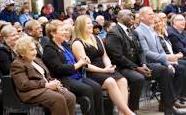
|
| Dr. Sophie front left |
field. She retired at 88 – sadly she died a few years ago at the age of 96.
We had a friend in common, and so spent a little time chatting during my visits. One time I told her that I didn’t like coming to see her. She asked why not, and I said, “Because every time I come you find a new way to torture me – you’ve stuck needles in me, sliced me with a scalpel, stitched me, frozen me – the only one you’ve missed is burning me!”
She laughed, and, I believe, decided then and there to go for the full house… You see, while I was there for some reason I can’t remember, I had mentioned that I had quite a lot of annoying skin tags and wondered if she could remove them. She said that she could do them then and there – then she asked:
“Do you haf a high tolerance for pain…?
My mind immediately said to me "Did I hear that right...?" and I’m sure I must have looked like a deer caught in headlights…
I can’t remember what I said exactly – probably hedged my bets... I mean if you say No, you look like a wimp, but if you say Yes, you might very well not enjoy what ensues. Whatever I said she took it as a Yes and said, “there are a number of ways to do this: cryotherapy to freeze them, cut them off with scissors or scalpel, or my preference, electrodessication – using an electric needle to burn them off.”
“With a local anesthetic,” I asked, hopefully?
“No,” she said, “that’s why I asked the question, dummy!” (OK, she didn’t say dummy – she just thought it...)
So, she got out her latest torture device and a pair of tweezers and in two shakes had taken off about a dozen tags.
The pain couldn’t have been that bad since I don’t really remember it, but I thought it amusing that, when it was over, there was a smell in the room like barbecued steak…
| |
 |
Then she said “Before you go, I have a colleague doing a study of a rare congenital defect and I wondered if you might volunteer as a participant…”
But that’s a story for another day…
|
|
From time to time when I am flicking across the hundred or so TV channels available to me, I stumble upon
a badminton match and while watching the amazing athleticism of the present-day players I reflect on our own badminton journey. This started in 1960 shortly after we married and moved to Caithness. Among the new friends that we made were a couple of keen badminton players who invited us to come along to a badminton session at the local social club. We were both tennis players with only the barest experience of badminton, but nothing ventured... etc.
We went along and quickly discovered two things. First, that the only thing that badminton and tennis had in common was that the racquets both had strings and second, that because of the local climate, badminton was a
| |
 |
serious year-round sport in Caithness. Thanks to the patience of our new friends we enjoyed a couple of games and accepted their invitation to return the next week. Over the next few months we bought our own racquets and became regular members of the club. Muriel showed great aptitude for the game and within a couple of months she was representing the club at friendly matches. My own journey was less spectacular, and I became a regular travelling supporter at those friendly matches.
During the course of that winter we learned that there was a very active and competitive badminton league in Caithness with almost every village and township with a suitable hall having its own badminton team. Over the next five years we spent a great deal of time improving our standard of play and travelling around the county sampling the idiosyncrasies of the various venues.
Schools in both Wick and Thurso had excellent venues with the high roofs needed to play good standard badminton but regretfully this wasn’t the case with most village halls where low roofs, light fixtures, rafters, and obstructions on the playing area meant that local rules had to be observed.
One village hall had a working coke stove on the corner of the court, fortunately it had a wire guard round it. The local rule was, if the shuttlecock landed on the top of the stove and was burned, it was a foul, if it was undamaged, it was a let. Another hall was too short to accommodate a full-size badminton court so the base line at one end was painted a foot above the floor, if the shuttlecock hit below the line it was ”In” and “Out” if it was above. One hall had roof trusses, if the lower part was hit it was a “Let.” Needless to say, the local players had made serving through the trusses a fine art form and gained quite a few victories by exploiting this.
The off-court facilities were also very basic. At one match I asked one of the opposition where I could find the Gents toilet and was told to go to the back door. I followed the instruction but could not find the toilet, so I went back and asked if he could show me. He did, he took me to the back door and with a wave indicated the miles of moorland saying, “There it is!” The lack of such facilities did not indicate any lack of hospitality nor did the keen rivalry affect the warmth of the welcome and friendly banter. These were happy days when sport was an important part of the social scene.
In 1966 we moved to Berkshire and quickly resumed our badminton activities by joining the A.E.A. Wantage Badminton Club. This was a serious, competitive club with a good reputation in the Berks, Bucks and Oxon Counties League. By this time we were both competent players and were welcomed into one of the club teams. Once again the facilities were a little quirky. The club met in a WW2 aircraft hangar; it had a concrete floor with four badminton courts marked out on it. There was a rota of members responsible for erecting and dismantling the system of portable lighting the nets before and after each session of the club. Nothing quirky about that you may be thinking but what about the operating irradiation plant grumbling away in the corner of the hangar. That is quirky and although perfectly safe, caused much trepidation amongst visiting teams.
Badminton become a major part of our lives and we joined a second club in 1967. This was another A.E.A. sponsored club that met on a Saturday evening in Abingdon’s Old Jail. This Facility had been purchased by a consortia of local badminton clubs and altered into a dedicated two court facility with excellent changing facilities, a clubroom and bar, However, being part of our badminton journey, there had to be something quirky! How about the two fuselage sections of WW2 Horsa Glider placed at one end of the courts to provide the original changing rooms of the facility?
This was a serious competitive facility that Judy Hashman (née Devlin) used for training. Judy Hashman was
probably the greatest ever female badminton player. Born in Canada but moved to UK when she married in 1960. She won 86 international tournaments including 10 All-England singles Championships and was runner up 3 times, 7 All-England Ladies doubles and was runner up 5 times. Once in The Old Jail I watched her when she was four months pregnant play singles with and thoroughly demolish, a male county standard player. What a competitor!
Starting a family and a change of job for me brought our competitive badminton career to an end, but when we moved to Leighton Buzzard we took our badminton kit with us and soon found a badminton club that concentrated on the social aspects of the game. The only quirky venue that we played in was the National Spinal Injuries Hospital at Stoke Mandeville
| |
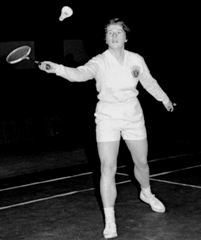 |
where we played a friendly match with the staff club. The highlight was being able to have a swim after our game, a long way from Caithness village halls!
Our next move was to Congleton in Cheshire and yet another badminton related experience. The club that we joined was a large one and we played in the town’s disused Territorial Army Drill Hall. During our time there the club got the opportunity to buy the hall and I ended up as the convenor of the fund-raising committee. In a flash of brilliance I arranged a Wrestling Show in the town hall and we had a fascinating time seeing what went on behind the scenes at a professional wresting show. This consisted mainly of negotiating with the wrestling management, helping to set up the ring, and during the show, removing the kids who, to the painful discomfort of the wrestlers and the delight of the perpetrators, scattered grains of rice onto the ring. It certainly added a grain of quirkiness to our lives.
Our last move involving badminton was to Cumbernauld, no club this time but a system of booking a court in the large sports centre and bringing along your group of friends. Nothing quirky, a pleasant evening out with established friends in a well-equipped venue. Looking back over more years than I care to remember I have come to the conclusion the Caithness experience in village halls was the most fun and that for anyone
moving around the country, badminton was a great way to meet new people.
|
|
 |
 |
Feeding the Backyard Animals
Hugh McGrory |
 |
 |
My friend Ross and I competed against each other at squash twice weekly for about thirty years – we finally had to give up at the behest of Mother Nature in our late sixties (his rotator cuff, my knee replacement...).
One day, after a match, he mentioned that he’d put up a hummingbird feeder in his backyard hanging from a branch of a maple tree, and he couldn’t believe how much sugared water (one cup of table sugar to four cups of water) those tiny birds could consume.
The following week he said that the syrup was disappearing at a ridiculous rate and there had to be some critter getting at the feeder – it couldn’t be the hummingbirds alone…
We went over the list of known predators:
| |
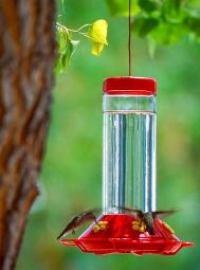 |
Raccoons? (our first choice) No – the feeder was 'raccoon-prooof' – held up by twine that wouldn’t support the weight of a raccoon.
Squirrels? No – he didn’t get a lot of squirrel activity and didn’t think they could drink that much.
Chipmunks? No – same as for squirrels.
Other birds? No – he hadn’t seen much activity near the feeder.
Bats? No – same as for birds.
Black bears? (We were reaching...) Nah – not in suburban Toronto.
That was as far as we got – we were both baffled and gave up.
A couple of weeks pass, we’re in the change room getting ready to play, and he says he’s finally solved the mystery…
He said he was in the backyard about to go in for the evening when he sensed a movement out of the corner of his eye. At first, he wasn’t sure what it was then suddenly realised that the feeder was moving – it was disappearing upwards into the leaves of the maple…
He slowly bent down into a squat and looked upwards. There was a family of raccoons, dad, mum and three youngsters in the tree and dad was pulling the feeder string up hand-over-hand.
Ross said, “I watched amazed as that bloody masked bandit picked up the feeder in his little human-like hands and proceeded to scoff the sugar water!”
|
|
 |
 |
Chance Meeting
Clive Yates |
 |
 |
Your recent story about a coincidental meeting reminded me of a personal story also set in New Zealand:
Some years ago, in Auckland, I was in the recreational area called ‘Onepoto Domain’ which is on the North Shore (part of Aukland, north of the harbour). I was there indulging myself in Egyptian PT... (actually, having a snoozy nap in the sunshine on a seat).
Along came a chap with a white West Highland Terrier on a lead. I patted the Westie and mumbled
something about how ‘good’ the little dog looked and how affectionate he appeared to be. My wife and I had always wanted a Westie, so the conversation drifted into ‘Where to obtain such a dog, and general comments about how they behaved.’
The owner suddenly asked me about my accent (still quite Dundonian despite every effort for years to disguise it!)
I replied, “I am from Dundee.”
| |
 |
He said “ I have a friend who is from Dundee. He used to be in the Merchant Navy as a Deck Officer on tankers.”
“What's his name?” I asked (half-interestedly). He replied “Morrison, Charlie Morrison.”
“I knew a Charlie Morrison once” I said, “That Charlie Morrison had a sister called Janet who married an Engineer on the Shaw Saville Line operating to New Zealand. They moved to New Zealand back in the 1960’s.”
The unknown man remarked that he would tell his friend that he had met someone from Dundee. He asked me for my name and phone number, which I gave him, and thought no more about it.
You can imagine my surprise when I got a phone call a day or two later; “I am Charlie Morrison from Dundee, Janet’s brother.” He went on to tell me that she and her family are still in NZ. However, her husband had died quite recently with Big C.” At this we had a conversation and he told me that he had ‘retired’ in NZ after years at sea ‘driving’ large oil carrier vessels around the globe.
Small world; even smaller islands; minuscule chances of such an encounter. And if you think the story a bit strange, how about these extra bits:
Tommy Burt, a classmate at Morgan Academy, rugby player (and a contributor to this story collection) lived half a mile from me in Auckland;
and Dorothy Fenton (as was) in a former Primary school class, (who left Morgan and went to the Harris,) bumped into me at a conference in 1996!
Some of you will remember the words of our school song - “O’er the bridge that spans the river;” etc.
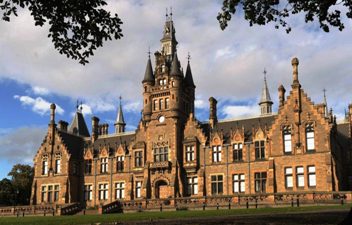 |
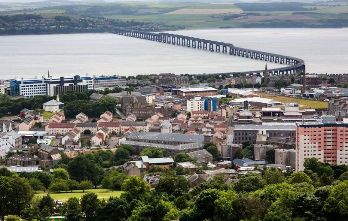 |
| Morgan Academy |
The Bridge that Spans the River Tay |
A Song of the Morgan
O’er the Bridge that spans the River
Moving slowly to the sea,
Looks ‘The Morgan’, now as ever,
Fairest school in all Dundee.
And as day by day we view her,
Standing stately on the hill,
Proudly pay we homage to her,
Gladly sing with right good will.
Chorus:
Hail “The Morgan” stately, splendid,
Hail the teachers, every one!(1)
Cheer we every goal defended
Every hit and every run!
We would strive with every lesson,
As we strive when at our play,
Learn with every passing session,
“Who would rule, must first obey.”
O’er the Bridge that spans the River,
Soon we pass away alone,
Leaving comrades keen and clever,
For the lure of the unknown.
But, though much or mean our treasure,
Though our fame be great or ill,
We shall still recall with pleasure,
Our dear “Morgan” on the hill.
Repeat chorus
Though the Bridge that spans the River,
Take us far from home and friend,
Hide them from our sight forever,
Till the “long trail” has an end,
There’s a beacon that will light us,
Lone on land, or far at sea,
There’s a name that will unite us,
‘Tis “The Morgan” of Dundee.
Footnote
(1) It's a school tradition that pupils sing "Jail the teachers, every one."
|
|
 |
 |
Cherries Jubilee
Hugh McGrory |
 |
 |
The famous chef, Escoffier, creator of the Peach Melba (for a dinner honouring opera diva Dame Nellie Melba), also invented Cherries Jubilee, in 1887, to celebrate Queen Victoria’s 50th year as monarch.
It was well known that the Queen loved cherries, and he adapted the old French method of preserving fruit in sugar and brandy to make this celebratory dish.
Briefly, you gently warm sour cherries in a pan with sugar, salt, lemon juice, and scraped vanilla bean. When the sugar dissolves, turn up the heat until the mixture thickens. Add Kirsch or Brandy (away from the heat source) return the pan to the heat and then flambé by igniting the alcoholic vapour. Allow the pan to cool until the flames disappear.
Today, the mixture is usually poured over vanilla ice cream for each serving (Escoffier did not do this originally.)
So, as I mentioned in a previous story, I was in Houston, Texas, in 1971 attending a conference on (as usual) computers and engineering. My great friend, Sam, who lived in Houston, was the Conference Chairman, and, as part of his duties, had had to set up a dinner for all of the attendees.
Some time before, he had met with the appropriate manager at the hotel who introduced him to the chef. After discussing the menu, he and Sam chatted. The chef wasn’t a Texan; Sam asked him how he ended up in Houston, and he proceeded to tell the following story:
He'd been working at a major hotel in Denver, Colorado, and was asked to prepare a meal for some kind of major charity function to be attended by many hundreds – everyone who was anyone in Denver – black tie and evening dresses, of course.
He wanted to make a splash – he put together a plan to serve Cherries Jubilee for dessert, and to make the flambéing a spectacular event.
The ballroom was filled with tables, but a space had been left in the middle. At the appropriate moment the lights were dimmed, an anthem played, and a spotlight followed his staff as they wheeled in a platform with a large pot/cauldron in which the warm melange was ready to be flambéed.
He followed in his chef’s uniform and tuque, shining bright in the spotlight. He carried aloft a bottle of brandy, and when they reached the centre, the music ceased and there was silence. With a flourish he held the bottle aloft then poured it into the mixture, lit a long taper then held it to the rim, and BOOM… The mixture exploded and launched an expanding wave of cherries out over him, his staff, and the surrounding tables.
Fortunately, no one was badly hurt, though apparently the bedraggled spectators were a sight to behold. He was fired that evening – and that was how he eventually arrived in Houston…
PS
Flambéing is a technique that can be used for many types of dishes, but it’s often associated with desserts – Baked Alaska, Bananas Foster. While it can improve the look and taste of the food, it’s not without its dangers:
In Coral Gables , Florida, in November 1979, two elderly women (aged 88 and 81) were burned when a Cherries Jubilee dessert at a country club dinner exploded and set their clothing on fire. One of them died…
In Tampa Bay, in June 2011, four diners were injured while awaiting their Bananas Foster dessert. Particularly badly hurt was a 25 year old primary school teacher who suffered third degree burns.
In 1999 a California woman suffered third-degree burns when a server prepared Cherries Jubilee tableside at a steak house.
A woman in London was seriously burned in 2005 when a flaming Portuguese sausage dish exploded after it was topped with rum.
A 5-year-old girl and her 8-year-old sister were burned in Arizona in 2006 when alcohol in a hollowed-out "onion volcano" was ignited at a Japanese restaurant.
In 1996, a waitress died after suffering severe burns at a Dublin wedding reception when an open liquor bottle caught fire as staff prepared a flaming Baked Alaska.
In the late 70's, the hotel administration department at the University of New Hampshire, put on theme dinners. The students would go all out, and the multi-course meal included Cherries Jubilee as the grand finale.
The "chefs" in their starched white uniforms and caps, wheeled a shiny cart laden with a huge bowl of cherries into the center of the room. All eyes were on them. With a dramatic flourish they poured alcohol over the cherries and set them aflame…. A stray elbow suddenly bumped the alcohol flask. It fell to the floor splashing alcohol in a long stream... directly toward the seated diners and disappearing under a table.
The band played on as everyone watched the flames jump from the cherries, down to the floor, working their way toward the seated diners. No one moved until the flames ran under the table and up an unfortunate gentleman's pant leg. He leapt into the air and headed for the platform only to be tackled by guests who sprang into action and smothered the flames. Fortunately, he wasn’t badly hurt.
Getting back to our main story, do I believe it…? I’m sure that’s the story that was told to my friend Sam, (as best I remember it after fifty years).
Given the litany of accidents above, something of the like could well have happened. There was no Internet fifty years ago, and my latest research, though it turned up the list of accidents above, did not uncover any story set in Denver.
We’ll never know for sure – I’m inclined to think that the basis for the story may be true but that it was somewhat embellished in the telling...
But it’s a good story is it not...?
|
|
 |
 |
Shetland Revisited
Brian Macdonald |
 |
 |
In a previous traveller’s tale, I mentioned that one day, we would re-visit the Northern Islands of Scotland. At the time of our first visit, only one short look-see was contemplated as we were enjoying mainland Europe too much, with its varied cultures, peoples, scenery, and cuisines. As we neared the close of our eighth decade and knew our overseas travel days were coming to an end, due to the brutal marathon journey from Australia just to get as far as Europe, one final journey of discovery was pondered.
Then came the TV series of author Ann Cleeves’ Scottish detective, Inspector Jimmy Perez, which we watched from the comfort of our Melbourne armchairs. It was named Shetland, set and filmed on the Shetland Islands, which we had visited and enjoyed seeing again on the TV screen. That settled it! It would be a return trip to the Northern Islands, ten years after the first. We now knew how small distances are in Shetland, everywhere being well within a day trip, so we sought and found an apartment in Lerwick(1) for the full ten days we would spend there. That would give us a chance to experience the local culture in more depth than as itinerant visitors and to meet and talk to Islanders. We planned to spend more time on Shetland than on Orkney, which is more akin to the Scottish mainland in its landscape and culture as well as being much closer to the Scottish mainland.
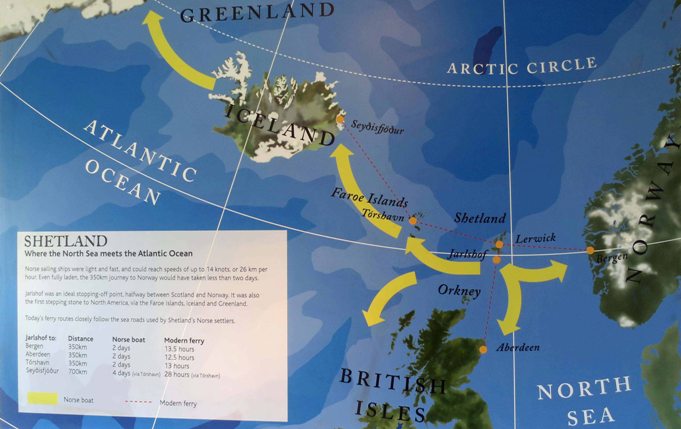 |
The ferry trip from Aberdeen is a painless overnight experience and Shetland comes into view as low-set islands as you approach the Sound of Bressay, as daylight brightens. Installed by mid-morning in our apartment in one of a terrace of stone houses, a five-minute walk from the centre of Lerwick, and with a trove of supplies from the supermarket, you are set and ready to go. On the short stroll to town centre stands Fort Charlotte, an artillery fort dating from the 17th century but most recently rebuilt in the 19th century, strategically facing the Sound of Bressay, on which Lerwick stands.
Little planning is needed for a stay in Shetland. Just get in the car and drive. Take your best cold- and wet-weather clothing, even for summer, as Shetland is a fair way north . The inter-island ferries are frequent and
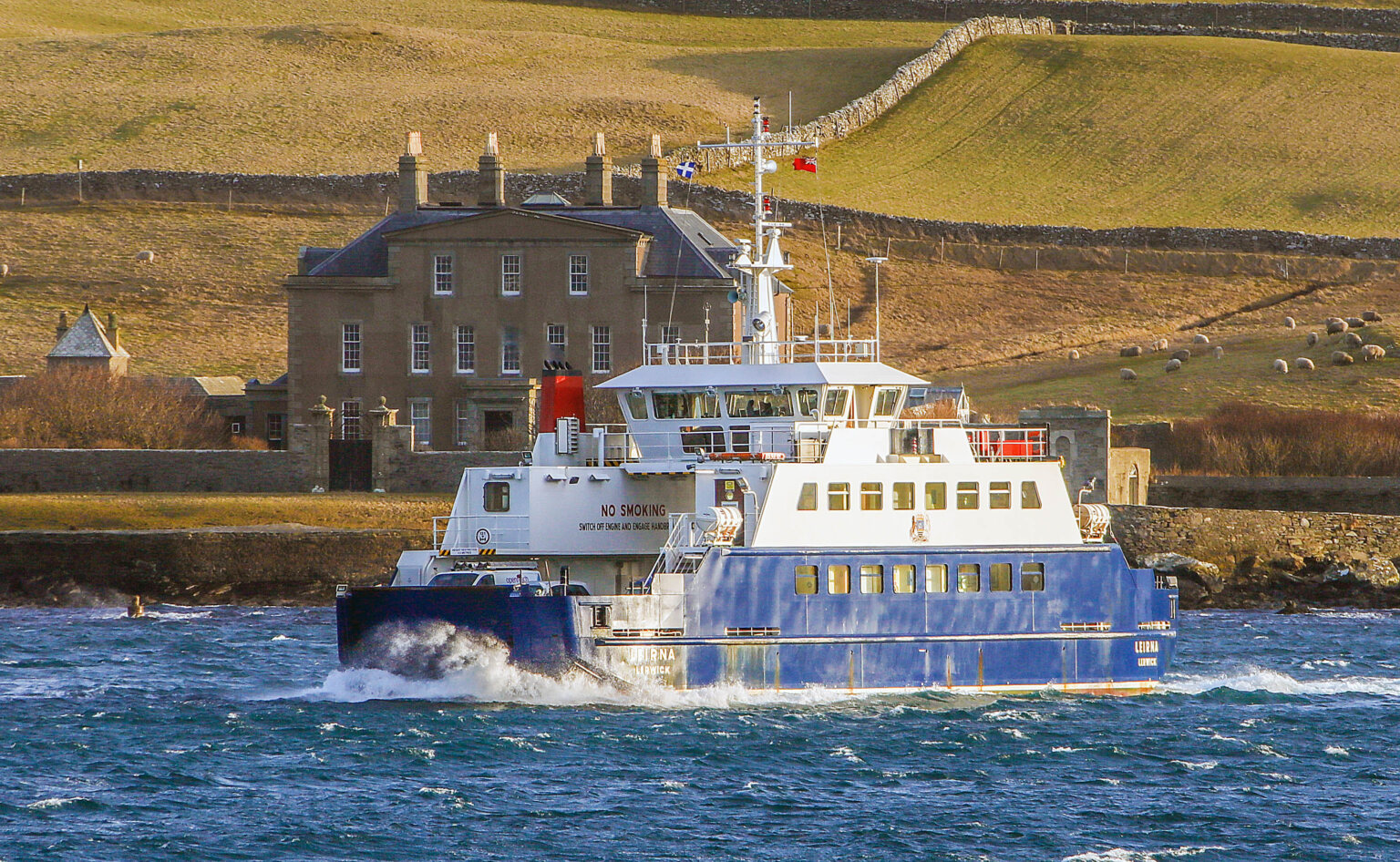
|
cheap drive-ons.
As all roads start at and return to Lerwick, it is there you pay your modest fare. After that, there is no checking and you simply go, hopping from island to island and returning to Lerwick by the same route. Occasionally it is necessary to wait for a second ferry if you are going to one of the smaller and more remote islands, if a few vehicles – usually goods transports and tradesmen’s vans – are already waiting for the small ferry. This simply encourages a relaxed view of life and makes the big-city visitor slow down a bit. As Lerwick faces steadfastly east, looking towards Bergen, in Norway, some 200 miles away, it is possible to travel from there north, south, and west to the furthest extremities of Shetland.
Lerwick is a working town, mostly standard Scottish provincial architecture, the grander buildings with a touch of the Scottish baronial or civic about them. There is little of architectural interest to the tourist. A few smaller cruise ships dock there(2) briefly but not many tourists are to be seen. The town sprawls round the coast of the sound in a rough L-shape. A couple of cafés huddle on and near Commercial Road, the flagstoned, building-hemmed main street that wanders through the mostly original residential area and town centre from north to south, and which is patiently shared between vehicles and pedestrians. Narrow lanes, often called ‘wynds’ in other parts of Scotland but here known as ‘closses’, dart off from Commercial Road between the buildings and up the steep hillside.
In the centre small square stands the modest Market Cross. the tourism office and one of the town’s two music pubs, The Lounge. A busier road, the Esplanade, runs parallel to Commercial Road, but along the shoreline, lower down the sloping hillside.
It carries the commercial traffic and services the harbour precinct and the ferry terminal.
| |
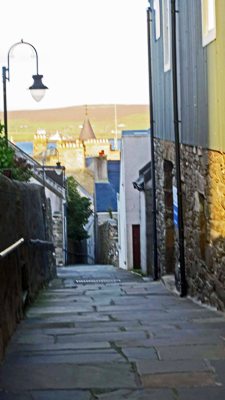 |
At the southern end, The Esplanade turns right, away from the coastal fringe, leaving the older part of the town, towards a little headland, The Knab, which projects into the Sound of Bressay and has an interesting walk round its cliffside. The road then becomes again the A969, the main road, which runs from the northern end of Mainland to Sumburgh Head, at the southern tip. A newer part of Lerwick with a housing estate is in this part of town and the ubiquitous Tesco supermarket. There is a growing accommodation shortage in Shetland, partly due to increased immigration of recent years. It is planned to build more housing in this part of Lerwick.
If the visitor is hoping for sophisticated or exotic experiences on the islands, there is disappointment to come. There are a couple of restaurants whose menus show some pretensions, but the height of fine dining is Sunday lunch in the Grand Hotel, a dignified stone pile that stands tall in the inner town. There, a toqued chef presides over a buffet and the tail-coated head waiter takes your order. The food is good, solid, unimaginative, traditional fare, the atmosphere quiet and restrained. The few cafés are quiet, dark places with many coat hooks for the heavy coats and waterproof jackets that are essential here and often have an atmosphere redolent of the damp outer coats of patrons. Below the wall of Fort Charlotte stands a popular fish and chip shop, usually with a hungry queue outside around tea-time. A few Indian and other takeaway restaurants exist to provide variety.
On our first visit some ten years earlier, cinema entertainment consisted of periodic shows in a hall, with a travelling projectionist who brought his own huge canisters of film. That may still happen but now there is high-definition digital TV reception and internet connection is fast and reliable so there need be no shortage of canned entertainment.
There are two ‘music pubs’ in town. The Lounge is a fairly plain lounge bar where music is played once a week. The Douglas Arms is a cheerier establishment, with a lively bar with a roaring fire and a row of Viking shields above the curving bar counter. By happy chance it was a mere hundred yards from our apartment, and
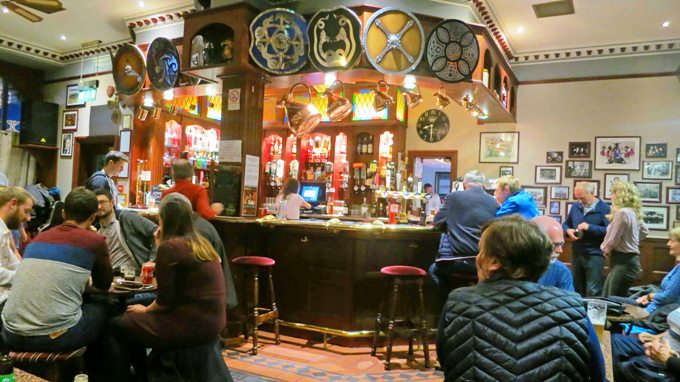
|
| The Douglas Arms |
we were in Lerwick for two music evenings. Shetland is as known for lively fiddle(3) music as it is for its little horses and it is a grand evening sitting in The Douglas with your drink of choice, tapping your foot to the music of the fiddles. There may also be an accordion being squeezed and a guitar or two.
Travellers do not visit Shetland to lie on the beach, a good summer day being windy and about 15°. Nor is it a place with amazing buildings or grand art galleries. What Shetland offers is stark natural beauty of coastal scenery and a history of occupation that dates from 2500BC with ruins a-plenty. A week spent on Shetland is not wasted. Driving is easy with little traffic and distances are short, but it is wise to take your own car. It is necessary to learn the protocols and courtesy of traffic crossing on the narrow single-lane roads with their frequent passing places. While the scenery is entirely grassland, what few trees there were having long been cut down for building or firewood, and the climate not friendly to anything standing at a height, it is by no means boring and great coastal vistas are open everywhere.
The most famous prehistoric settlement is the extensive Bronze, Iron, Stone Age and Viking Jarlshof, which
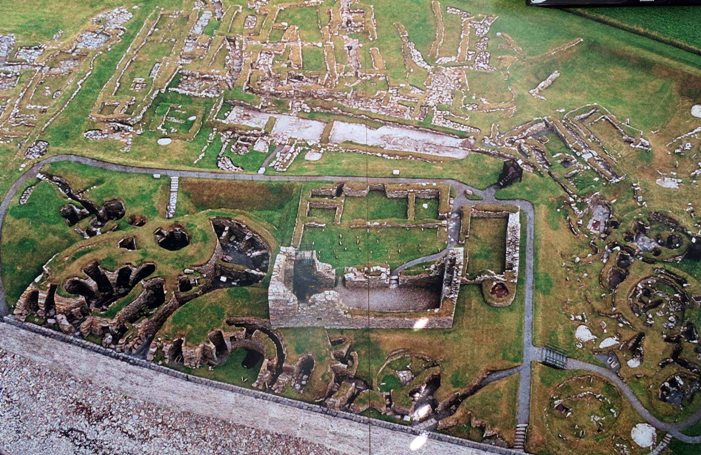
|
| Jarlshof |
also holds ruins of a 17th century ‘Laird’s House’. Situated on the coast at the southern tip of Mainland, at Sumburgh, this fascinating settlement first was revealed to a farmer near the end of the 19th century when its cover of centuries of soil was blown away by a ferocious storm. It has since been extensively excavated and restored and it is a mind-boggling experience to walk around and marvel at the millennia of history revealed. Jarlshof’s name was probably plucked from a novel by Scotland’s famed 19th century novelist, Sir Walter Scott, and a loose translation may be ‘The Earl’s Court’.
To reach the exhibit, it is necessary to pass through the grounds of the Sumburgh Hotel, a good place to fuel up the body after your ramble round Jarlshof, usually in the teeth of a bracing Atlantic wind and sometimes driving rain, before you tackle the steep kilometre-long walk up to Sumburgh Head lighthouse at the very tip
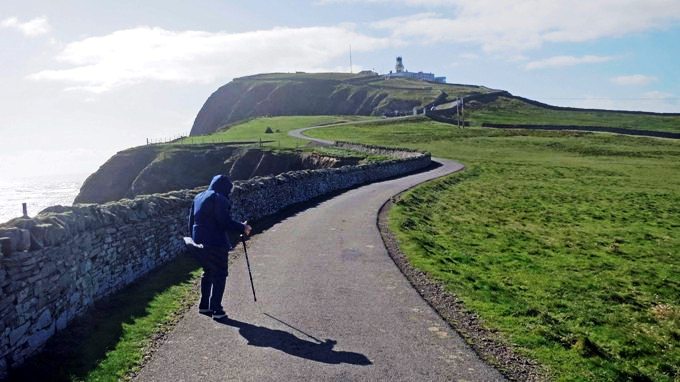
|
| Sumburgh Head |
of southern Shetland. There you will find one of many lighthouses around Scotland built by members of the Stevenson dynasty(4).
Footnotes
(1) Lerwick is a royal burgh, the most northerly in Britain and, at about 7000 population, the only sizeable town on Shetland. Ask a local and you will be told that both pronunciations of the town’s name are used – ‘Lerrick’ and ‘Ler-wick’. This is not how it is with the town of Berwick-on-Tweed, the border town between Scotland and England, where the only acceptable version is ‘Berrick’.
(2) The local shopkeepers and café owners are not enthused about cruise ships for they disgorge their passengers, who stroll through the town looking around but mostly buy nothing and return to their ships for meals and refreshments.
(3) All over Scotland the violin is known as the ‘fiddle’ and its exponents as ‘fiddlers’. The Shetland Fiddlers’ Society is a renowned group of fiddlers which not only plays at festivals and events on Shetland but has also performed at the Edinburgh Tattoo and around the world. Its many members turn up for pub music evenings too. Scottish fiddle music is lively and gets the blood going.
(4) Four generations of ‘the Lighthouse Stevensons’ family designed and built many of the more than 200 lighthouses around the coasts of Scotland. Many still stand although most have now had their mechanisms replaced by modern electronic lights or are out of use. The author Robert Louis Stevenson was a member of this family (Treasure Island and The Strange Case of Dr Jekyll and Mr Hyde are possibly his best-known novels, although other works are familiar to generations of Scottish youngsters.). He was not a lighthouse builder.
To be concluded next time...
|
|
 |
 |
The Smart Brothers...
Hugh McGrory |
 |
 |
Some time in the early ‘90s my brother and I took my mother and her sister, both in their late 70s, down south (of England that is) to see their brother who was not well. We stayed a couple of days with our cousins in Tewin Wood, Herts, (Michael and Jan).
Being two smart fellas, we had the bright idea to take with us Mum's two shoe boxes filled with old family photographs (no doubt many of you have the equivalent treasure trove). We figured it would be a great opportunity to scour the memories of Mum and her sister and have them name people and events that would otherwise disappear into the mists of time...
It was some thirty years ago, but I still remember a very pleasant evening, sitting after dinner for a couple of hours with family, drinking wine and listening to the sisters as they remembered long forgotten people and events, and told little stories about ‘the old days’. It was an evening of nostalgia and laughter, and I believe all six of us thoroughly enjoyed it.
Did I mention my brother and I were smart cookies? We realized that we should record the names for posterity and so we had each taken a pile of photos and alternated passing them around then noting the names on the back (a few, of course were complete mysteries...)
Halfway through the evening, the following conversation took place between my brother and myself. (To protect the guilty, I’ll refer to us as A and B - but I won’t tell you which is me and which my brother...)
A: “Can I see that photo again,” then, “You’ve got the names round the wrong way!”
B: “Oh, do I? Let me see,” then, “No - that’s right.”
A: “Mum, who is that on the left in this photo?”
Mum: “Mary.”
A to B: “See you're wrong.”
B: “No - it’s right.”
A: “But you’ve got her name on the right and she’s on the left.”
B: “Right.”
At this point we were more like Abbot and Costello in their famous ‘Who’s on First'. sketch, than two smart brothers...
To cut a long story short, one of us was looking at a photo of say three people X, Y, and Z, turning the photo over and writing on the back, X, Y, and Z.
The other was turning the photo over, looking through it at the table lamp and printing the names right behind the person. The result on the back was, of course, Z, Y, and X .
So we’d ended up with dozens and dozens of photos, half labelled one way, and half the other!
Smart brothers indeed...
|
|
 |
 |
Yugoslavia 4
Michael Marks |
 |
 |
During the war there were rival partisan groups – they fought each other rather more than fighting the
Germans. Initially the Allies mainly supported a Serbian group, which was a Yugoslav royalist entity. The British military sent Fitzroy Maclean to investigate the rumours and he decided that Tito and his partisans
should get all the required support, leaving the royalist group harmless.
This decision, made personally by Churchill, meant that massive financial and arms support helped tie down the Germans, which was of great help to the allied forces in Northern Europe. It also helped Tito to form a new government when the Germans were defeated.
Tito initially formed a post war government along democratic lines but his personal power due to his wartime leadership enabled him to forge a more typical communist regime.
Before the war, the Yavornik family had been wealthy, owning a beautiful house in the centre of Ljubljana as well as a forested estate in the countryside. During the war, they had been very supportive of the partisans, even
| |
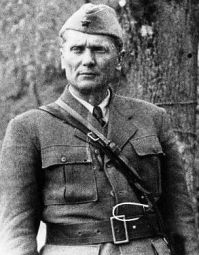 |
giving them some of their property including their own cars, plus financial aid. It was due to this that they didn’t suffer too much after Tito came to power.
As an example, they confided in me, the communist authorities gradually stripped them of many assets including their country estate and a paper mill which had produced paper from the trees in their own forest. The town house had been reduced to an apartment with just enough room for them on a single floor. While I was staying with them, they had just been informed that they had to start paying rent for the use of it.
They owned some beautiful furniture and paintings by a leading Slovene artist. These paintings still hung on their walls, but a communist civil servant visited them from time to time to ensure that they hadn’t sold them as they were considered to be national assets.
So I suppose I shouldn’t grumble about those slatted wooden train seats...
|
|
 |
 |
Out of the Mouths of Babes 3
Hugh McGrory |
 |
 |
Sometimes it just depends on how you look at things…
One Sunday, about twenty years ago, we were expecting the whole extended family, 12 or 14 of us, to turn up at our place for dinner. As usual, I lost track of time and, belatedly, jumped into the shower to get ready for the doorbell ringing.
I had dried myself, slipped on my underpants and was sitting at the bottom of the bed, about to put on my socks when I hear, "Where’s Granddad?" then the clatter of little feet.
My granddaughters, Sarah and Katie, about five and three at the time, burst into the bedroom. Sarah sits
beside me and Katie stands facing me.
Sarah asks, “What are you doing granddad?”
“Getting dressed – and what have you two been up to.”
Katie says “Nothing,” puts out her arm - and pokes me in the testicles…
“What are you doing, Katie?” I ask, whereupon she raises her shoulders up to her ears, grins, and does it again…
At this point, I’m saying to myself “Don’t make this into some kind of big deal when it isn’t!” I believed that my son and daughter-in-law used proper anatomical names for body parts with the kids – ‘penis’ not ‘pee-pee’ etc. So, I say to her “What are those called, Katie?”
Up go the shoulders again. “I bet your Dad told you and you’ve forgotten – do you know Sarah?” turning to her.
| |
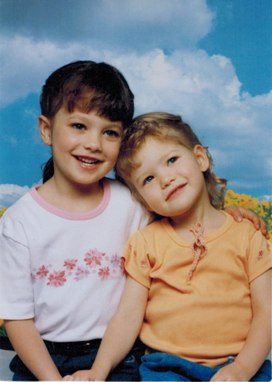 |
She gives me that look that speaks volumes - the one that kids give to stupid old folk – in this case I think it meant “Of course I know Granddad, I’m five years old!”
“Tell your sister then”, I urged
Sarah leaned towards her wee sister and, enunciating carefully and slowly, so that she'd understand, she says:
Nailed it, Sarah!
As I said, "It all depends on how you look at things..."
|
|
Waiting for the postings to be announced, and being early in the alphabet, I hoped that they would allocate the “good” postings early, but when I joined the mob goggling at the posted bulletin, the first voice I heard was from Bill Finlay (no relation) who yelled: “Hey – you and I are going to Edinburgh.”
Four of our lads saw that they were heading for Northern Ireland where “the troubles” were starting up again and the IRA liked nothing better than taking pot shots at British redcaps on traffic duty. So Edinburgh it was to be, and a day later four of us were on our way north.
We wound up reporting to our detachment: a small Army barracks at Musselburgh, about six miles outside Edinburgh. We shared space with an R.A.S.C. (Royal Army Service Corps) unit who maintained the small and medium Army trucks used by units in and around the Edinburgh area, so our barracks included a wired-off compound where Army vehicles were stored and serviced.
We four newcomers were quickly brought up to speed by the staff sergeant MP in charge of our detachment. Our responsibilities were to patrol the main thoroughfares of Edinburgh, to ensure that military order and discipline was observed by all the troops in the area. We would also be available to handle any “disturbances” caused by military personnel.
Our sergeant was matter of fact about it all. “Most of the time you’ll walk the beat and do bugger all,” he said. “But we’ll have a few rumbles in the pubs now and then. So, get yourselves a sap.”
A sap? What the hell was a sap? The old hands in the detachment soon showed us. A sap –or a “snake” as some of them called it– was a long, narrow leather tube, about fifteen inches long, and filled with lead or steel shot. At one end it had a loop. After sewing the steel shot into the leather tube and attaching the loop, you had yourself a very handy “pacifier.” You cut a small entrance in the side seam of your battledress pants, slid the snake into place down your leg, and left the leather loop showing at the top – ready to be pulled out quickly when needed. One whack with the snake to the head or jaw of a drunken private would send him to the deck – or at least stun him into submission.
They weren’t Military Police issue; in fact, they were brazenly illegal, but the Army almost never equipped you with truncheons or night sticks, and if you were facing some drunk and aggressive soldier who wanted nothing better than to paste a redcap – you had to rely on something more than your size and your strong arms. That was where the sap, or snake, came in.
My first foot patrol in Edinburgh was calm and uneventful. Two of us (you always patrolled in pairs) started out at Waverley Station – the main in-city railway station in Edinburgh – and thence along “The Royal Mile” of Princes Street, passing Edinburgh Castle on our left and on to Lothian Road where we crossed Princes Street and walked back towards Waverley Station on the north side.
A normal shift was four hours; we started at the almost always peaceful time of 2.00 p.m. and walked our beat on Princes Street until 6.00 p.m. Most of the interest in us came from civilians who’d stop and ask us directions.
Question: “Can you tell me how we can visit Edinburgh Castle?” Answer: “Walk down to the Castle and you can buy a ticket at the front gate.”
Question: “Where is the nicest pub in this area?” Answer:“All the pubs in this area are very nice. And you can get a cheap meal inside.”
Question : “Is there a public toilet nearby?” Answer:“Nearest one is in Waverley Station. Or you can pop into any restaurant on Princes Street and use theirs.”
The Army types on the street tended to hurry past us, eyes averted, and checking that all their buttons were done up. Now and then, of course, you’d run into a couple of tough little tarts, all short skirts and lipstick, who’d come walking towards you and say: “Hey– show us yer pistol”, and cackle hysterically.
As I recall, my partner that first day on patrol was Bill Finlay: that may have set some sort of unusual record, having two military policemen on the beat, both called Findlay or Finlay . . . anyway, fellow clansmen from the same tribe.
The only excitement we got was stopping a recruit who came out of a pub near Lothian Road with his blouse all askew and his beret stuck in his belt. “Improperly dressed” as our military dress code would say. We were behind him as he emerged from the pub, and he didn’t see us until we yelled: “Soldier!” He was short and scrawny and when he wheeled around and saw us bearing down on him he almost soiled himself in fright.
Bill administered the bollocking while I wrote him up as my first 252: that’s the code number of a military charge for “being improperly dressed in a public place.” It was a bit like shooting fish in a barrel. The little squaddie was obviously terrified and was now aware that, once our charge was filed with his unit, he’d be good for at least one week “Confined to Barracks” or a spell on kitchen duty.
Ah me – the long arm of military law...
|
|
 |
 |
Another Cold Winter Night...
Hugh McGrory |
 |
 |
Bill Kidd's story last week reminded me of another cold evening, in Toronto. Sometime in the early ‘80s I attended a business meeting in mid-town, which ran into the evening, and when it ended, some of the participants, being hungry and thirsty by then, decided to go for something to eat at the aptly named CHICK’N’DELI on Mount Pleasant, south of Eglinton.
I decided to join them since they said the place was quite famous - also, my wife Sheila was working late that evening and it would save me from making my own dinner (boiled egg sandwiches) when I got home…
The ‘Deli’ had decent wings and beer, and live jazz – even dancing if you were up to it – and I spent a pleasant couple of hours there. (By the way, after a bit of research I discovered that the ‘Deli’ closed in 2011, but through several reincarnations – People’s Chicken, Seven44 (guess the street number on Mount Pleasant Avenue), and Smokeshow BBQ & Brew – it is now The Mount Pleasant Rose) – but, from what I can tell, the ambience seems to be very similar.
It was winter, and I had parked my car on Taunton Rd, one of the residential streets that run south of Eglinton Ave to Soudan Ave, quite a short walk away. It was bitterly cold; I had decided to leave my topcoat in the car since the restaurant was only a few minutes away. At the end of the evening, I hustled to get to my car and out of the wind…
I hurried up Taunton and was soon puzzled – I thought I’d parked closer to Soudan – and then panicked, as I got close to the end of the street. “Calm down, you idiot,” I thought, “you probably walked right past the car.” So, I re-traced my steps, and no, I hadn’t walked past it… “Somebody stole my bloody car!”
I headed back to Mount Pleasant and found a phone box (no cell phones in those days) and called the cops. They were polite but said that it might be a long wait before they could get a car there – they were very busy due to the bad weather. So, what now…?
It was cold in the phone box, but at least it was out of the wind… I looked at the time and wondered if by any chance Sheila was still at her office. Picked up the phone again and hallelujah, she was. Half an hour later she arrived, and I was able to sink into the warm car – wonderful…
After I stopped shivering, we sat there wondering what to do while waiting for the cops. Sheila said, “Lets drive around nearby streets just in case,” and I probably said something like “No point, I know where I parked it!” On the other hand, I realised that we’d nothing better to do…
So we went north on Taunton Road, east onto Eglinton then south on the next street over, Falcon Street. We drove halfway down – and there was my car , just where I’d left it – what a numbskull...).
Those streets were two of nine identical streets running from Eglinton to Soudan the others are Forman, Petman, Marmot, Banff, Cleveland, Hoyle, and Mann (who picks street names?) – and they all look exactly the same... We went back to the phone box, and I told the operator that I was the idiot who'd reported a non-stolen car...
I got into bed that night a happy (and humbler) man.
|
|
 |
 |
On a Cold Winter Night
Bill Kidd |
 |
 |
I spent most of my national service as a photographer at RAF Kinloss in Morayshire where I and my colleagues spent our days and sometime nights fitting cameras into Shackleton Maritime Reconnaissance Aircraft, removing them and processing and printing the resultant exposed film.
Most of the photographs simply showed a floating dummy submarine periscope with a splash at either side of it and were used to assess the bomb aiming skills of the crews under training. In addition to this boring routine, we provided the whole establishment with a comprehensive photographic service. However, photography played no part in the most memorable event of my time with the Royal Air Force.
At around 2.30 am on January 10th, 1958, the twenty occupants of our hut were rudely awakened by two RAF policemen switching on the lights and banging on the coke bin with their batons. As we blearily came to life one of the Snowdrops, (RAF police wear white covering on their hats) asked which of us was SAC Kidd. Wondering what I had done and more importantly how had I been found out, I rather nervously confessed that I was he.
I was ordered to get into my working uniform and greatcoat at once and accompany them. Within five minutes I was sitting in a Land Rover along with the driver, one of the Snowdrops and another two equally puzzled and nervous airmen. While we were being driven out of the sleeping camp, we were told that we had been selected for this duty because we were on the Fire Picket list for that day and that we were required to attend an emergency that had occurred about five miles from RAF Kinloss. We were also informed that we would be fully briefed when we arrived at our destination.
After a bumpy, partly overland journey, we were driven up a forest track to a scene of devastation. We were confronted with the wreckage of a Shackleton bomber that had ploughed into the tops of the trees and caught
fire. The smell of high-octane fuel and charred wood and metal was overpowering. We were greeted by an officer and a flight sergeant who told us what had happened and what was expected of us.
The aircraft had been on a routine training flight with a full crew of nine aboard. At about 22.00 hours (10.00 pm) it had abandoned a landing approach and was making a second approach when it failed to clear what was the only piece of high ground on its flight path. After the aircraft had come to a stop the automatic fire suppressant system had deployed. Both pilots were killed and three of the crew sustained serious injuries, miraculously the remaining crew members only had minor cuts and bruises. The Rescue team had arrived within thirty minutes of the crash, got the survivors to hospital, and made the site safe.
Our function was to remain at the crash site and deter any souvenir hunters or other unauthorised persons from interfering with the site. We would remain on this duty until we were relieved. An urn of tea, three mugs and some packs of sandwiches were unloaded from the Land Rover, and we were left to it.
During the course of our briefing, we were informed that the pilots who died were a trainee and the
instructor. We were horrified to learn that the instructor was Master Pilot Karl Stastny who was a well-known and well-liked character around RAF Kinloss. He was a Czechoslovakian who had served alongside the RAF during WW2. After war ended he returned to his native land, and not liking the regime, he made his way back to the UK and joined the RAF as a sergeant pilot. It was rumoured that he left Czechoslovakia by means of a purloined aeroplane that he flew to the British Zone of West Germany. He was a small man with a large moustache and a big smile. His memorial is in the cemetery at Kinloss Abbey, and he was mourned by all ranks at Kinloss.
When the Land Rover left at about 4.00 am the three of us, strangers to each other, took stock. It was very cold, and a frost was forming, there was no shelter other than the remains of the aircraft fuselage and for obvious reasons we quickly ruled out its use. The tea urn was insulated so its content remained hot, we thought of lighting a fire, but the strong smell of aviation fuel quickly changed our minds. We agreed that if anyone wanted to smoke they would have to move a hundred yards down the forest track.
| |
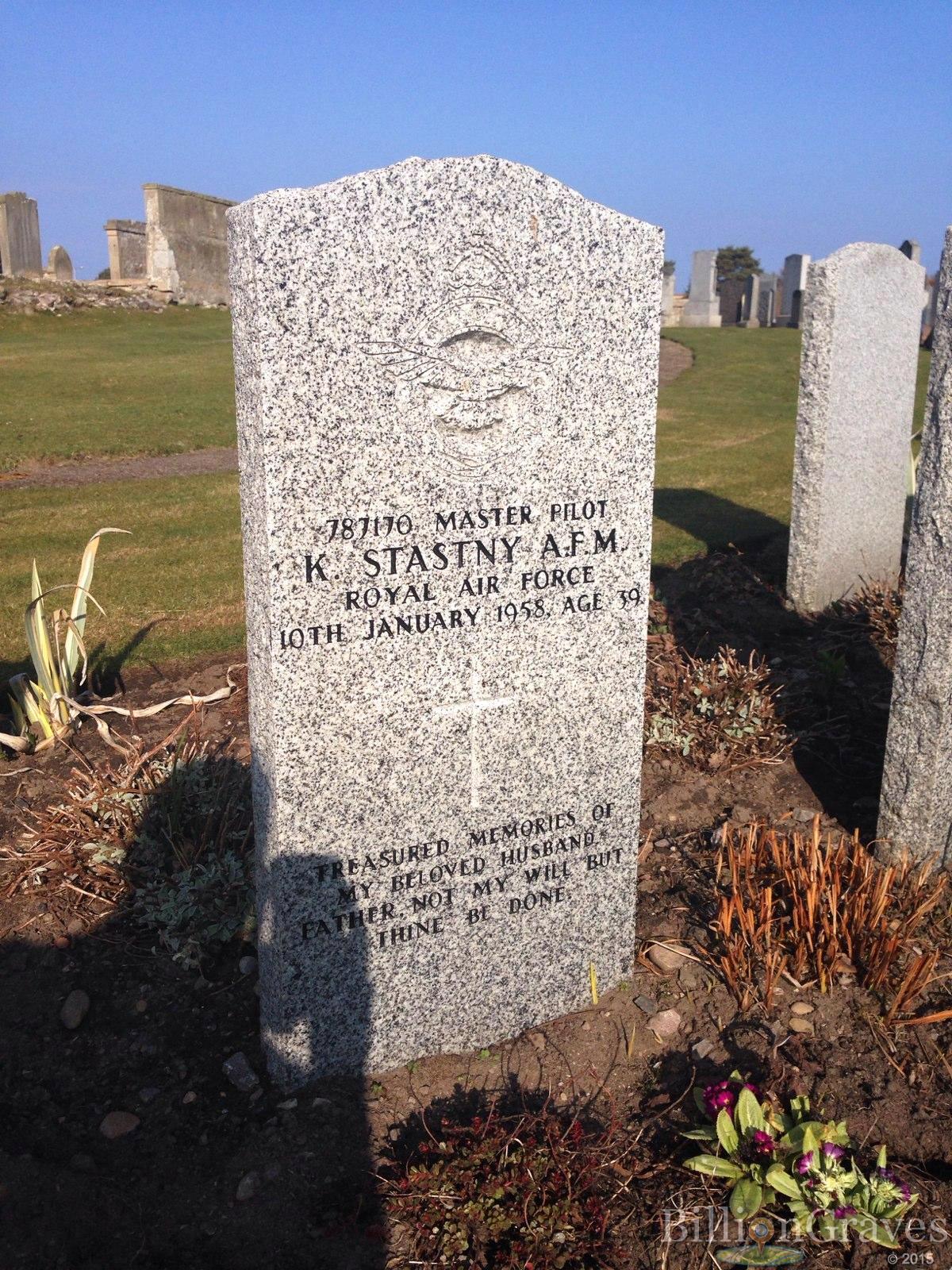 |
We were cold and miserable and couldn’t help feeling that the whole area was very creepy! We spent the next few hours in the dark, gossiping, drinking tea, and trying to keep warm. From time to time one of us would take a walk round the site or go down the track for a cigarette. None of us could clear our minds of the tragedy that had happened here or reflecting on the reality of service life.
At about 7.30 am we began to notice the first glimmers of light and by 8.00 am we could make out the length of the forest track. I was the first to notice some movement in the distance and thinking that it might be a deer I mentioned it to my companions. We watched the movement on the track for a few minutes before it resolved itself into a white patch that was slowly moving toward us.
After another few minutes we could see that there were two distinct images, but we couldn’t define what they were. We began to feel a little uneasy about what we were seeing, and we went very quiet. Then, in the improving light we could make out that there were two figures dressed in white and that they were not walking but seemed to be gliding along the track.
At this point the hairs on the back of my neck began to prickle and the blood seemed to drain from me. I was scared and so were my colleagues. Inexorably the figures continued to float upwards along the track toward us and they gradually became clearer. I didn’t believe in ghosts until that moment, but I felt that this was as likely a place to find one, or even two, as anywhere.
When the figures were less than a hundred yards away, they resolved themselves into two of the Benedictine Monks from Pluscarden Abbey which was only a short distance away. They had come to see what had happened and they brought a large and very welcome flask of soup with them.
I will not pretend that we saw the funny side of this right away and even now, more than sixty years later, I still get the creeps when I think about that cold winter night.
PS
Pluscarden Abbey, six miles south of Elgin by the Black Burn in Moray is the only medieval monastery in Britain that is still used for its original purpose by the resident Catholic Benedictine Monks.
|
|
If you know this word, I’m impressed – I didn’t until a few months ago. It’s Spanish, pronounced (de-REH-cho) or (de-RAY-cho), it means straight, straight ahead, or directly and is used to describe a meteorological phenomenon.
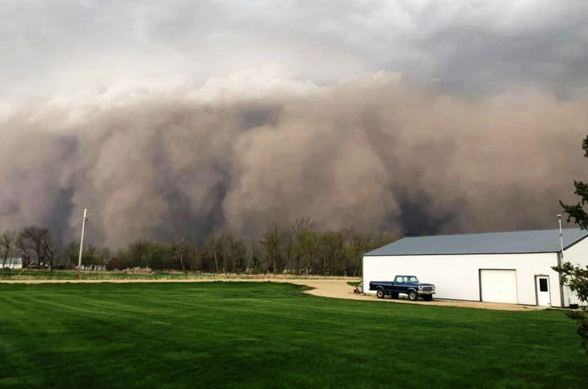 |
| Part of a derecho, South Dakota, 12th May, 2022. |
A derecho is basically a wide line of very active thunderstorms or microbursts. It can produce destruction similar to a tornado, but the damage typically is directed in one direction along a relatively straight swath rather than the meandering path of the typical tornado. To be termed a derecho, the wind damage swath has to extend more than 240 miles (about 400 kilometers) and includes wind gusts of at least 58 mph (93 km/h) or greater along most of its length.
Ontario and Quebec experienced a derecho on Saturday, May 21st, 2022, and as you can see, in about 10
hours it travelled from the US border at Detroit/Windsor to the St Lawrence Valley north east of Quebec City and into Maine, where it died out.
Lasted for nine hours during which time it covered more than 700 miles and was 50 to 60 miles wide. Ten people were killed and initial estimates of damage were approaching one billion Canadian.
My understanding of this phenomenon (and I may not have it quite right) is as follows:
Let one of your arms hang by your side then bend it at the elbow so that your forearm is horizontal pointing forward, your hand open, palm down, gaps between each finger. Imagine your hand is the derecho travelling away from you. Each finger represents one of the violent downburst winds of up to 80 to 100 mph dropping vertically to the ground then horizontally forward – it’s these that do all the damage – the gaps between the fingers are (relatively) calm. That explains why we got hit and the neighbours either side of us largely escaped.
It happened around 1:30 in the afternoon, the sky darkened and suddenly the house was shaking in a violent wind – it only lasted about 90 seconds!
I guess we were fortunate in that our house wasn’t damaged – but we had 17 trees that weren’t so lucky… Five were uprooted and the others sustained multiple injuries, branches snapped off, many caught up dangerously on other limbs. We had to bring in tree specialists – cost more than $10,000 Cdn. (not covered by home insurance).
We had a willow that we loved. I searched my computer for a photo but I don’t seem to have one. So I found one on the
Internet:
 |
| This tree looks very similar to our willow, sitting on the edge of a pond. |
This how it looked 90 seconds later:
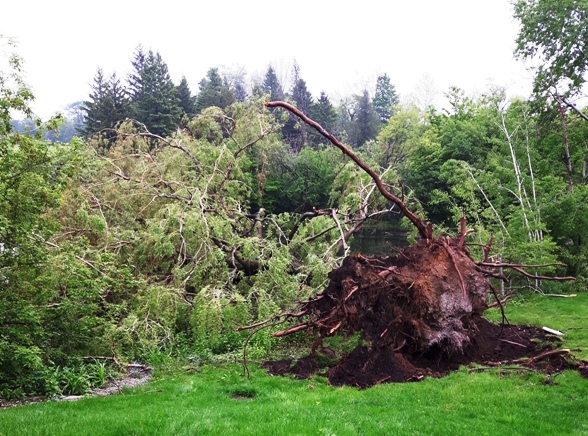 |
| Lying in the pond... |
And as a work in progress...
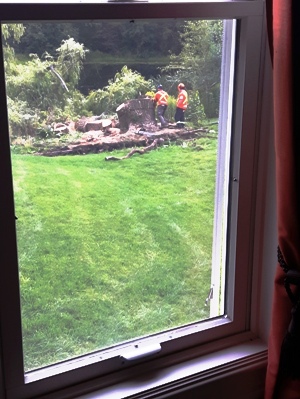 |
| Just as well it fell away from our house...(note the pond in the background) |
Like most of you, no doubt, we have been increasingly dismayed at the effects of global warming around the world. Forest fires, windstorms, floods, melting glaciers, droughts, food shortages, increasing numbers of displaced people...
Our personal 90 second derecho certainly underlined for us the fact that we ignore Mother Nature at our peril...!
|
 |
 |
A Road Less Travelled
Brian Macdonald |
 |
 |
In a previous article published in this collection I talked of my lifelong love of camping and how this began with a small tent in Britain and continues to this day in Australia, now by car and caravan. The love of camping and travel is an infection that never dies. But the range and the means grow and change through a life.
I wrote of our generation’s ethos of putting off such major discretionary expenses as travel till later, for the sake of establishing a life, a home, and a family. So, our travel during the earlier years of a long marriage and the growing and educating years of our children were confined to Australia, our chosen homeland since 1967. With a land the size of the continent of Europe to roam and a range of climates to experience, this gave us plenty of scope and a huge variety of places to visit and we did this with enthusiasm. We continue to do so.
Finally, the time came in our lives when our now-adult children had flown the coop and our future for the second half of our lives was secured. We could take a more expansive view of our travel horizons. We still enjoyed travelling Australia but were in a position to contemplate extensive visits to our homelands of Scotland and Wales. There was much to see and many to meet again and a yearning to refresh our love of our birth lands. Scratch an expatriate Scot and the blood will flow dark blue, Ann’s red Welsh blood maybe even more so.
By 2008 we had made a number of return visits to UK, the first around the Highlands on what is now the North Coast 500(1) by motorbike in almost continuous heavy rain. We had voyaged, drier and warmer, by car to many parts of Scotland, including the Highlands, again. We had revisited Dundee, made the obligatory pilgrimages up the Dundee Law, and gazed on the old school, the Morgan Academy, before the fire that devastated it in 2001. We had been in Edinburgh during its famous August festival and clasped hands for Auld Lang Syne at the last performance of the Tattoo on the last Saturday night. We had taken a Caledonian MacBrayne ferry to the Inner Hebrides. We had boarded the little ferry from Kyle of Lochalsh for the five-minute trip to Skye, the last summer before the Skye road bridge was built and rendered the ferry obsolete. We had toured the Borders and viewed magnificent, ruined abbeys there. We had driven through Ayrshire. We had visited Speyside and Islay distilleries. We thought we had seen and done all we wanted to.
Then. one evening, at home in Melbourne, my wife said it would be interesting to visit Orkney and Shetland.
We I had never thought of a visit and had never been there. You see programs on TV about the Hebrides quite often. They are tourist country and have been slowly becoming repopulated of recent years. The Scottish comedienne, Susan Calman, has made a TV series in which she quarters Scotland. But you rarely, if ever, see or hear even a mention of the Northern Isles unless it be about the traditional knitting patterns of Fair Isle, which sits alone in the Atlantic Ocean, halfway between Orkney and Shetland. An expedition was born.
Orkney and Shetland are usually bracketed together in people’s minds, but we were to find them very dissimilar, both culturally and geographically. Their history is interesting. Most Scots who think of these two archipelagos at all believe they were given to Scotland as a marriage dowry in the fifteenth century. This is not quite the case. By then both regions had long been Norwegian and had had thriving populations of Vikings since the eighth century. Before them there were the Pictish people of northern and western Scotland. Both races have left indelible marks on the northern archipelagos.
| |
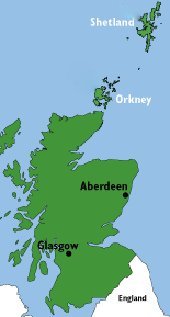 |
By the fifteenth century, Scottish influence had been growing through increasing immigration. A Norwegian king did pledge the Northern Isles against the payment of a dowry for the marriage of his daughter to a Scottish king. That dowry was never paid, and Scotland cannily took possession of Orkney and Shetland in the late fifteenth century. Scottish they have remained since, but exhibit a visible degree of independence in many ways. We expected the two regions to be similar. We were to find they are quite different from each other as both are different to mainland Scotland.
In summer 2008 we drove our car on to the Northlink ferry in Aberdeen. Northlink’s logo features a Viking warrior. It is an overnight sail to Lerwick, Shetland’s 7000-strong main town, more than a hundred miles

|
| Shetland seen early morning, from Northlink ferry |
beyond the Scottish north coast, reaching the Sound of Bressay as daylight shows the burgh of Lerwick, huddling 60° north on the eastern coast of Mainland. Orkney, to the south, within sight of the Scottish mainland, is on the return leg of the round sea trip from Aberdeen so a tourist’s introduction is to the far-flung and different Shetland rather than Orkney, which is closer akin in most ways to mainland Scotland and not just geographically.
Our five days in Shetland showed us a still somewhat isolated community of around 20,000 inhabitants with its own culture and bleak but beautiful, treeless landscapes and rugged coastlines with dramatic cliffs with great slashes of gorge running inland from the coast, where seabirds nest in their thousands and seals bask on rock shelves. The land is treeless because Shetland sits exposed in the cold, windy Atlantic Ocean, with North America a long way to the west and Norway’s coast to the east. The Atlantic winds scour the land and forbid
trees to flourish except where a garden plot is surrounded by houses and high walls. There is little shrubbery, just grassy land sloping to the sea. We saw no cows, and few horses, probably for the same reason. No creature of any height would be comfortable there – just the endemic rabbits, well-upholstered sheep and the miniature Shetland ponies, not drystone dyke height, whose ancestral home is the northernmost island of the
archipelago, Unst. Travel between the major islands is by cheap, fuss-free drive-on ferry, and is frequent and quick. Unst boasts the most northern post office in Britain, in the tiny settlement of Baltasound, and the most northern land of UK, the quaintly named lump of rock that juts from the sea just north of Unst, Muckle(2) Flugga.
The town of Lerwick is a conservative, industrious place of solid, substantial, grey stone buildings, hardly

|
| Lerwick seen from Bressay Sound |
a tourist mecca, with no evidence of urban renewal except for a housing estate on the outskirts, by the prehistoric Clickimin Broch(3), built to house a slowly expanding population. The Tesco supermarket
company has established itself in that area, with an eye to advantageous positioning. Commercial Street, the main thoroughfare of this thriving community, is a narrow, flagstone-paved lane that meanders from one end of the town to the other, hemmed in by grey stone buildings on both sides and amicably shared by pedestrians and vehicles. In some parts, it is necessary to press yourself against the building to permit a van to pass.
The splendid, modern Shetland Museum sits on the waterfront, opened in 2007 jointly by Queen Sonya of Norway and the Duke and Duchess of Rothesay(4). The museum tells the tale of the islands’ past, of the culture and crafts of the people, of the now almost extinct sea-fishing industry that once supplied the Hanseatic League cities of northern Europe, of the Viking culture with its annual New Year Up Helly Aa festival that culminates in the burning of a Viking longboat after a procession of bearded Vikings brandishing flaring torches, of the 20th century oil industry, that for some decades brought prosperity from the North Sea but is now past its prime. The museum offers a well-patronised café, a pleasant place to be eating and drinking while watching the rain coming horizontally outside, a frequent event, even in summer.
The presence of the Norwegian Queen at this occasion gives an indication of the strong connection the islanders feel to Norway and to their Viking heritage. Many names of people and places bear strong indications of the Norway connection. During World War II, a clandestine small boat ferry service, The Shetland Bus, operated from the little western port town of Scalloway, originally staffed by Shetland fishermen. It sailed to the Norwegian coast, carrying spies, saboteurs, supplies and documents to and fro until the end of German occupation of Norway in 1945. A museum and a memorial in the town are devoted to this operation, of which the islanders remain fiercely proud, seventy-six years later.
The whole of Shetland is dotted with small settlements of a few houses out to the furthest extremities of the land. There is strong evidence, by way of ruined houses, of centuries of habitation everywhere across all the larger islands. Further evidence is provided by small, ruined kirks with cemeteries whose gravestones have become illegible through age and exposure, in quite remote places. Lerwick, on Mainland’s east coast, is the only good-sized town and is a royal burgh. Scalloway, a town of around a thousand souls, is the only other town. There are a number of very small settlements. There are many sheep, well-nourished on the rain-fed grass, very clean and white, shampooed by Atlantic rainstorms and blow-dried by the strong winds. There is little pollution since traffic is sparse and industry is small-scale, and the air is sweet, if somewhat bracing, even in summer, that far north and in mid-Atlantic.
Our too short visit to Shetland ended with us driving on to the Northlink ferry for the three-hour sail to Orkney, where it would dock at 11.30 at night to pour out those disembarking there before its overnight leg back to the Granite(5) City of Aberdeen on Scotland’s north-east coast.
Shetland made a strong impression on us. We would enjoy the comparison with Orkney and the comparison of both with mainland Scotland and would revisit the two regions again in more depth, but that is a story for another time.
Footnotes:
(1) The North Coast 500 is a tourist construct. It describes a scenic loop route of just over 500 miles (the name inspired by the Scottish group, The Proclaimers’ pop song?) around the east, north and west coasts of northern Scotland, from Inverness to Inverness, and promotes tourism in the Highland region.
(2) The Scots word ‘muckle’ means ‘big’. There is no ‘Mickle (little) Flugga’. Maybe the even smaller lump of volcanic rock called Out Stack, just north of Muckle Flugga, stands in for that. Muckle Flugga is reachable only by boat and there is a closed-off military radar establishment occupying the northern tip of Unst, so it is not possible for civilian visitors to reach the very northern tip or even to get more than a glimpse of Muckle Flugga.
An old Scots proverb says ‘Mony a mickle maks a muckle’ – essentially ‘Save the pennies and the pounds will look after themselves.’ An almost identical proverb is familiar to Jamaicans. I can only assume it was transplanted into Jamaica by a frugal Scottish immigrant.
(3) A broch is a Scottish Iron Age dry-stone dwelling, round, beehive-shaped and built to withstand Atlantic

|
| Clickimin Broch |
weather. They are found all over the Northern Isles and in other parts of Scotland. The Clickimin Broch in Lerwick is restored (but not to full height) and open to tourists.
(4) The Duke and Duchess of Rothesay is the title by which Prince Charles and his wife, the Duchess Camilla, are known in Scotland.
(5) Aberdeen is often called ‘the Granite City’ as that is the local, handsome, grey, quartz rock of which most of the city centre is built. When the sun shines after rain, this stone sparkles and presents a marvellous sight, with the ancient Marischal College of Aberdeen University a stately pile at one end of the gracious main street.
|
|
 |
 |
Believe It or Not 2...
Hugh McGrory |
 |
 |
We’re still on the subject of coincidences (let’s use the definition: “a surprising occurrence of somehow-related events with no apparent cause”). When we encounter one we're amazed and ask, “What are the odds?”
In fact, though, such random events are really quite commonplace (because there are billions of people in the world and so billions of opportunities for such events to occur – but almost all of these aren't noticed...). What makes them remarkable (rightly so) is when we actually notice one.
Here’s another...
My dad had a younger brother (he was another Michael McGrory, and we knew him as Uncle Mick). He had two daughters, my cousins Isa and Margaret, and the latter married a man, Robert, known as Rab.
Rab built a fine career for himself as a member of a team of consultants experienced in many aspects of oil/gas production. He went all over the world on contracts to manage and provide site supervision at operational production programmes. He was inspired by the previous story from Big Mick and Jan to share one of his ‘coincidences’...
He was on a consultancy project for Shell Todd, in New Plymouth, New Zealand. The town is located on the southwest coast of North Island, (and no, that's not Mount Fuji below but Mount Taranaki, less then 20 miles distant).
It was Melbourne Cup Day in Australia, and Rab had stayed at the office while the rest of their small team went off to a BBQ and to watch the race.
He went back to the Brougham Heights motel and, as he walked through the garden to his room the lady owner called and invited him into their private quarters. A number of their friends had watched the race with beer and snacks, so he chatted with a few that he hadn’t met before.
An elderly lady recognised his Scots accent, and she was pleased to tell him how she and her husband had been back to Springburn, in Glasgow, to visit family and friends. They had enjoyed visiting the streets where their parents had lived.
They had also visited Dunfermline, Kirkcaldy, and East Wemyss in Fife. It was at that moment that Rab remembered something. He told her that he was born in East Wemyss, and she was quite amazed. He asked if, by any chance, it was an Agnes McMurray that she had visited in Dunfermline, since he knew her younger brother Bill had emigrated to New Zealand when Rab was sixteen. The lady almost fainted and in tears said that Bill and Irene McMurray were her best friends!
One phone call, and a short time later Bill came through the door. It was a very emotional meeting for him and Rab since they had been neighbours in Alexander Street, East Wemyss, and hadn't seen each other for 47 years!
On his next trip to New Zealand, Margaret went with him, and they visited Bill at his home. He produced a photograph of Rab and himself as teenagers, sitting on a fence in the back garden...
What are the odds, eh...?
|
|
 |
 |
Yugoslavia 3
Michael Marks |
 |
 |
One day it was proposed that we visit some relations who lived in the countryside some 45 minutes by train from Ljubljana. I was very happy to agree. I was warned that the train would be a bit uncomfortable and remembering my train journey from London resigned myself to this small additional trip.
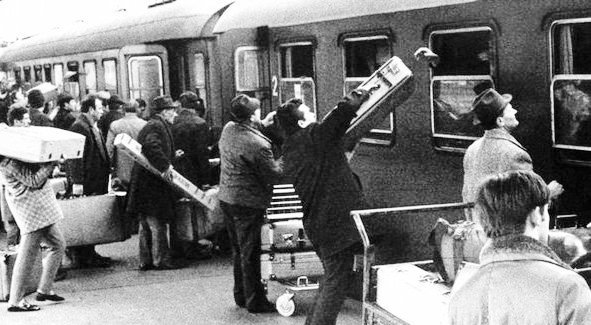 |
| All aboard Yugoslav train in 1950s |
Uncomfortable it was! Local trains in Yugoslavia had seats, which was a pity as they were very basic wooden slatted structures. Additionally, it was high summer and daytime temperatures were in the low 40s... Luckily, I was able to offer my place to a local and spent the rest of the trip standing.
We were to be met at the station and driven to the farm. Bliss. Unfortunately, the car turned out to be a pony and very small trap. For about six people.
We spent a very enjoyable day with the family and had a splendid barbecue lunch, with lots of good local wine. At some point Deso suggested that he and I leave together and try to hitchhike back to Ljubljana. Having imbibed a few glasses of wine, eaten a massive meal and feeling relaxed, I agreed.
Nowadays, there is a multi-lane motorway linking Ljubljana with Zagreb and Belgrade but in the early 1950s this was a wide dirt road. We joined this highway and started thumbing. We got covered with dust, but no vehicle stopped to offer us a lift. We discussed retracing our steps and catching the train but at that point a huge American saloon stopped, and the driver agreed to take us all the way to Ljubljana. Deso just had time to warn me that such a car was almost certainly owned by a high communist functionary and therefore to be very careful what I said.
It turned out that the passenger was indeed someone to avoid, and his driver was his son. There was a huge change in the road surface just a few miles from Ljubljana and we were soon almost home. Conversation in the car was the usual mixture of me speaking English, the Party functionary Slovenian and German and Deso trying to play dumb. The day wasn’t quite finished however as our benefactors insisted on taking us to a very nice bar where they bought us glasses of sparkling wine with fresh peach slices.
We avoided visiting that bar for the rest of my stay!
|
|
 |
 |
Believe It or Not...
Hugh McGrory |
 |
 |
We’ve all encountered coincidences in our life – about eight or so of the stories in this collection deal with the subject – and they are always a source of some wonderment. Often the occasion is a chance meeting with someone you know in an unexpected place or time.
My previous story, featuring my cousin Mick and his wife Jan in Nigeria, reminded me of another of their stories – one of the most amazing coincidences I’ve ever come across. The tale begins with a chance meeting with someone they didn’t know…
They were spending a week in the sun on the Costa del Sol, in Andalusia, Spain. They were having a drink in the crowded hotel bar while waiting for their table to be ready for dinner. The room was quite full, and they saw a couple come in and look, in vain, for a table. The newcomers saw that Mick and Jan were sitting at a table for four, came over to them and asked if they’d mind sharing.Of course, they agreed.
They began to chat, and it wasn’t long before the conversation turned to ‘where are you from.’ When the other lady – I’ll call her Mary – found out that Jan had lived in Dundee, Scotland, she said “Me too!” A coincidence, though not that unusual.
But wait – there’s more… In answer to the question ‘where did you live in Dundee?’ it turned out that they were both west-enders, living on the Perth Road, just west of Windsor St. Comparing Street numbers they realised that they had lived in the same walk-up apartment building!
But wait – there’s more… As they continued to talk, they established that they had both lived on the top floor of the building (see red oval in photo) and remembered the lovely view to the south, out over the River Tay estuary to Fife County.
But wait – there’s more… Mary asked Jan’s birth name and when she heard it said, “Your parents bought that apartment from my parents!”
But wait – there’s more… The outgoing family had more furniture than they were going to need, and Jan’s parents agreed to buy some of their furnishings – including the bedroom suite in the room that Mary was moving out of, and Jan into.
So those two young wives who had just met, by chance, for the first time, 2000 miles from Dundee, had both slept in the same bed…
|
|
 |
 |
An M.P. at Last
Gordon Findlay |
 |
 |
Midway through our training – around the 7 or 8-week stage –we were interviewed to see if any of us had an interest in joining the two specialist arms of the Royal Military Police: the Special Investigations Branch (SIB), or Close Support.
The first of these comes into play in criminal investigations where a member of the Armed Forces is involved. The training period, naturally, was going to be somewhat longer; successful candidates would become military detectives with all the meticulous investigation and forensic skills that civilian police detectives must have.
The second branch acts essentially as bodyguards for VIPs and foreign dignitaries who are in Britain and who are entitled to be guarded closely…
Most, if not all, of those who asked to train as SIBs had their goal set on a career in the military (that wasn’t me at that time). As for the second option – Close Support branch – I really didn’t fancy acting as a bullet-absorbing shield for some Arab sheikh. Who needs that?
I elected to take my chances as a regular Military Policeman, and, at long last, 16 weeks of Military Police training at Colchester came to an end. With all the successful members of our intake, 188 Squad (plus 185, 186 and 187 Squads) we dressed in best BD (battledress), white belts, gun holsters with attached lanyards and cross-straps; boots polished to a dazzling brilliance.
We marched out on to the main square for the last time. And on this special day each of us wore the red hat cover which signaled that we were now fully-fledged military policemen ready for active service.
No question about it: we were proud to have made it, and conscious that we looked pretty damn impressive as we wheeled out on to the square, one squad after another with our Staff sergeants leading the way. Squad by squad we came to a crashing halt and stood motionless in the sunlight for the formal inspection by our commanding officer.
He kept the speechifying mercifully short: told us we should be proud to have come through a “rigorous and demanding training schedule.” Reminded us that on the following day, the notice of where we were being sent on active duty would be posted at 9.00 a.m. on the bulletin board by the main guardhouse. And added that this evening we were all granted an 8-hour pass as a reward . . . and that we were not to cause too much trouble in Colchester as we celebrated.
| |
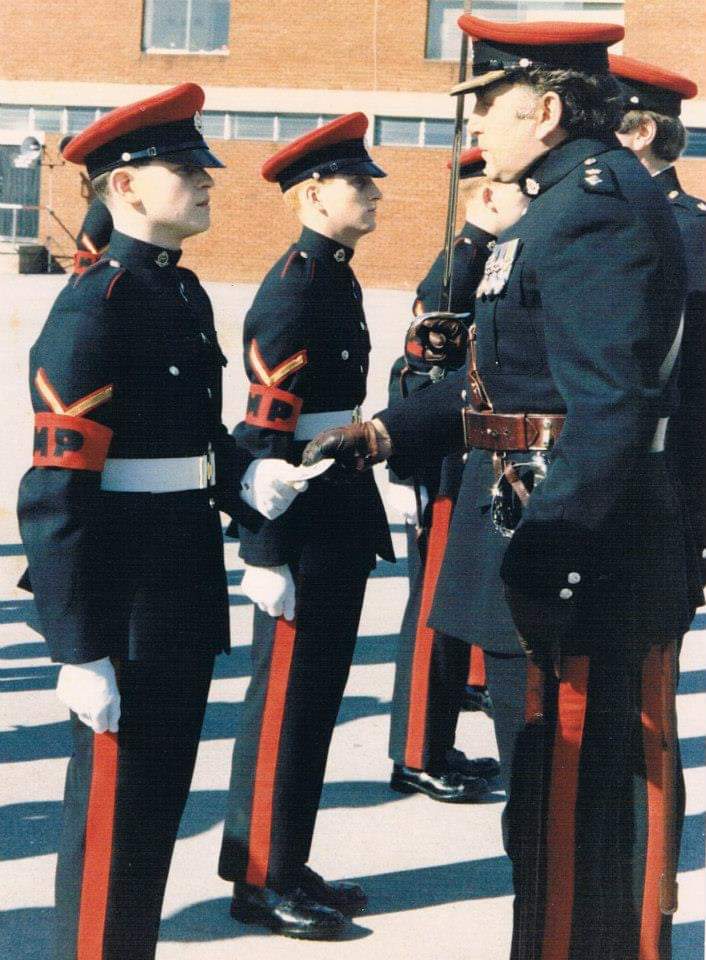 |
He then walked down the rows and presented each of us with our corporal’s stripes (when you qualify as an MP you are automatically elevated to the dizzying rank of Corporal). Then, he led us in three hearty cheers – and we were dismissed.
Sgt. Sheldrake circulated among us, shaking our hands, and wishing us well . . . telling us that we had been “one of his best squads ever.” And laughing along with us when we told him that he doubtless said that to every squad he trained (which I suspect he did…).
The rest of that day is a bit foggy, since we all went out to the biggest pub in Colchester and get stuck into pints of dark ale, Guinness, and lager. I got started on Guinness (it was on tap) and earned myself one of the biggest hangovers in my personal history. I can remember standing in the urinal at the pub, my head spinning, and leaning my forehead against the cold-water pipe to try and keep upright. Every one of us was totally fried and the walk back to barracks was more of a weave from side to side.
Everyone was dry-mouthed and thick-headed the next morning – but there was an electric air of anticipation. This was the day we found out where we would be serving. Everyone knew the cushy postings: four MPs went to Bermuda (who wouldn’t like to go there?); two were scheduled for duty in Jamaica; two would go to Belize; a couple to Malta – but most of us would be posted to Germany or somewhere in Great Britain.
|
|
 |
 |
The Sassenach
Hugh McGrory |
 |
 |
I’ve mentioned before that I have two double cousins, Mike, and Frank. Since our family has a liking for the name Michael McGrory, we had to qualify their names, so, within the family, cousin Mike was known as ‘Big Mick’, my brother was ‘Wee Mick’, an uncle was ‘Uncle Mick’, and Granda was known in the town as ‘Auld Mick’.)
Big Mick (we’ll call him Mick for this tale) and Jan, his wife, spent several years in Lagos, Nigeria, in the early ‘60s (Mick was a CA working for BP). He was a keen golfer and on this particular occasion he and Jan had made a trip north about 100 miles to Ibadan, the third largest city in Nigeria, for a golf match.
| Ibadan City and Golf Club |
After the game was over everyone retired to the club lounge – Mick and Jan were sitting at a table facing the bar, and Mick was looking at the back of a man standing enjoying a drink with some friends. He said, “I think I know that guy.”
“Really”, Jan asked, “from where?”
“From schooldays – I think he’s Graham Rosie who was in my class at Buckhaven High School.” (Buckhaven High was a six-year, co-educational school in Leven, Fife, Scotland, almost 5,000 miles and a dozen years away.)
“Are you sure?”
“Pretty sure – I recognise the back of his head – I sat behind him...”
“Well go see if it’s him.”
Mick did – he walked over tapped the fellow on the shoulder, and when he turned said, “Hi Graham”.
The fellow barely missed a beat – he looked at him and said “Hey, Mike, what are you drinking?”
What are the odds, eh? Graham was actually English, but his parents had moved north to Fife. Had he been a Scot, instead of a Sassenach, and his wits about him, I'm pretty sure he would’ve said:
“Hi Mike – must be your turn to buy a round...”
|
|
 |
 |
I Love to Go Awandering
Brian Macdonald |
 |
 |
As a young lad growing up in Dundee, I was preoccupied with the affairs of everyday and did not develop much of an interest in the wider world’s affairs until I became a bit older and started to look around me and from a higher elevation. Some things impinged, though. The coronation of Queen Elizabeth II in 1953 and The Suez Crisis of 1956 were events that hit my consciousness. The same short-sightedness was true of my view of geography. Life was home, school, working in the family shop, holiday trips to inland Kirriemuir and seaside Arbroath and a rare train trip to London with my English mother. Lochearnhead(1) and a picnic by the shore of Loch Earn was a favourite excursion destination of my parents of a weekend and that was as far afield as we went.
When I got old enough to ride a motorbike, I did venture further afield, covering many miles around Scotland and down as far as southern England. I was fortunate to spend time on a farm near Orleans in France as part of a multi-school group and to go to a military barracks in Lüneburg in Germany as a school army cadet, both in my mid-teens. A highlight of my teens was a month in Belgrade at age seventeen. I know now that I did not so much experience travel then as skim over the surface of places, did not absorb local culture or scenery, rather got a temporary fix from them, and often rapidly moved on, with little lasting impression made on me.
Then came the serious business of growing up, earning a living, establishing a nest, having a family. My generation did not do what many young adults do now, spend up on life, travel, the arts, while still young and worry about accumulating worldly goods later, after a couple of years of enjoying freedom and wanderlust after the bonds of school are removed. The ethos back then was that you got a job, worked hard, saved your money, and put off what was seen as non-essential spending till later. I do not grudge today’s young folk their lifestyle; it helps broaden the mind and develop a less parochial culture. But that was just how things were in the 1950s in Scotland. Even so, the life-building stage took me to England, Northern Ireland and then to Australia, and included the acquisition of a wife and children, and we have lived in Australia in a number of different states for the greater part of our lives. Our family has always had the wanderlust.
Australia is the place for wanderers and campers. It ranges from the cool, temperate climate of the island state of Tasmania in the south, where it occasionally snows on Mount Wellington, which looms over the capital city, Hobart, at 42° south, to Cape York in the far north of Queensland, only 10° south of the equator, well inside the Tropic of Capricorn. From Sydney on the east coast to Perth on the west is from London to Moscow, but with a vast, empty tract in between, unlike Europe. Australia has a mountain range that runs round the south coast from Adelaide and all the way up the eastern coast of the continent, with its tallest peak, Mount Kosciuszko(2) in New South Wales, over 7000 feet high. There are deserts of different types in the mostly flat inland, which was once largely a huge sea, magnificent cool-climate and subtropical rainforests, two cities of five million inhabitants with spectacular architecture, as well as a number of other large cities and gracious 19th century goldmining boom towns. Australia has its own unique fauna and flora too. Lots to see and do.
Australia has some of the world’s richest geology. Large tracts of Western Australia are composed of the world’s highest grade iron ore. There are geological features such as Wilpena Pound, in outback South Australia, a natural amphitheatre formed of two mountain ranges, with its own micro-ecology and gorges though the area where you can gaze on rock 500 million years old and discover fossils. There are extensive lava tube formations in tropical northern Queensland, miles of wonderful, unspoiled and almost deserted beaches all round the coast, parts of outback Queensland where dinosaur fossils are frequently dug up, most recently the whimsically named Australotitan cooperensis(3), said to be among the 15 largest dinosaurs ever found. There are moderately-trafficked major highways across the land and rough tracks to delight four-wheel drive addicts and adventure motorcyclists and terrorise suburban motorists. It is not surprising that people of many nations come to Australia to experience outback adventure and that many Australians love to travel in our own country, for over ninety per cent of us live in cities, our family among them.
Camping used to be a cheap travel and holiday option but has moved a long way up-market over time. Our life of leisure travel started with a small, white, cotton tent in rainy Ireland, bought cheap from a fellow-worker as young marrieds and much-patched by us before use. It did not resist rain. A big improvement was a domed, igloo tent of rain-resistant orange canvas, that had hydraulic poles, blown up with a foot pump, and
the great luxury of a sewn-in vinyl groundsheet. We took that tent with us to Australia, where it was used by us and by the local scoutmaster. Our first camping rig in Australia was the quaintly named Cargill Caravanette, a steel trailer with a superstructure of steel-pipe poles, canvas, and fly-screen mesh (essential in
Australia) that ingeniously slotted and zipped into a form of cabin. That clever setup, towed easily by a small car, not only carried all our travel equipment, including, on one trip, a large crib and a stroller for the latest addition to the family, but also housed us dry and warm all over Australia. It was followed by a semi-caravan that closed down to half height and a short towing length and rejoiced in the evocative name of ‘Sunwagon’. When you raised the fibreglass roof – by hand! – and pulled the ends out, it morphed into a four-bunk caravan with sink, fridge and cooking stove built in. Luxury! That served us well with two growing children and a Labrador dog for some years. Since then, we have owned every kind of camping and caravanning device. That includes a sleek, blue, lightweight, fibreglass trailer, designed to be towed by a motorcycle,
which quartered our continent north to south and east to west, two up on the bike, holding all our camping needs.
Now we are quintessential grey nomads. This is an affectionate Aussie term for older, retired Australians who tow their holiday home behind them, travelling extensively to enjoy the cultural and scenic variety of the country and to escape the dreary winter climate of the southern states for the balmy mid-twenties winter sunshine of the tropical north. Every year there is a winter exodus from southern Victoria and Tasmania of many thousands of hardy pensioners, like migrating swallows. With a nod to our age and desire for comfort, we have the latest in a number of caravans we have owned (see below). We trundle from holiday park to
holiday park and town to town as we trek, following the sun, heading for favourite places, often meeting the same folk again and again, soaking up the warm evening sunshine, sitting with a glass of wine, plotting future movement.
Well, we did until covid-19 came along. For now, we are restricted to our own state borders and sometimes even to the confines of our home for many weeks. But this, too, will pass and we will be off again ‘on the wallaby'(4) enjoying the roaming life and the variety of Australia to the full.
Footnotes
(1) Lochearnhead is a village about 60 miles from Dundee, situated at the head of pretty Loch Earn.
(2) Australian pronunciation Kozz-ee-us-ko (not what you’d expect from the original Polish name).
(3) The Cooper (or Cooper Creek) is a river in outback Queensland, in the area where this dinosaur was found, hence ‘cooperensis’ The Cooper flows only when there is enough tropical rain further north to flow south and fill the river. It has no permanent source and flows into Lake Eyre in South Australia, a huge inland sea that contains water only when rarely filled by the Cooper and other creeks after extensive rains in Queensland, hundreds of kilometres further north. Lake Eyre has often been used for land speed record attempts. As is the way of Aussie humour, Lake Eyre has a flourishing yacht club, with its clubhouse in the tiny township of Marree, situated on its southern shoreline, at the junction of the famous Birdsville and Oodnadatta Tracks. The yacht club holds regular sand regattas and sails when the lake is full.
(4) Australian expression ‘on the wallaby (trail)’ meaning ‘awandering’.
|
|
 |
 |
Sink and Swim
Hugh McGrory |
 |
 |
My previous story took place on the A85 at the foot of Glen Ogle, and it reminded me of another tale which occurred not far from there – another story that I heard not long after I arrived in the area.
So, follow me north on the A85 from Lochearnhed for about 4 miles, climbing up beside the Ogle Burn, then
turn west at Mid Lix towards Crianlarich, where, after about 8 miles, Loch Iubhair appears on the right/ (pronounced You’ar, in Gaelic it means Loch of the Yew Tree).
The road along the lochside was one of our road improvement projects needed to allow heavy road transport vehicles to carry large turbines and other equipment to the many new hydro electric schemes being constructed in northern Scotland. In particular, many of the roads were built on a peaty substrate which had to be removed before the road could be rebuilt.
On visiting the site , I heard the story I’m about to relate, more than once -- usually it began something like:
“Pity you hadn’t been here this spring,” one of the crew would say, then to a mate “Remember the guy in the sports car?”
His buddy would reply something like “Oh yeah; what a twat…”
It seems that the loch had overflowed across the road due to snow melt and some heavy rainfalls. Traffic on the two lane road was held up under the control of flagmen.
In order to construct the road to be able to withstand the heavy loads, it was necessary to excavate the layer of peat down to bedrock – about 10 to 12 feet – and replace with properly compacted earth fill. Traffic had to be maintained on the two-lane road, so the eastbound lane was excavated and refilled while the westbound lane did double duty, east and westbound traffic alternating .
On this occasion several westbound cars were waiting their turn when the queue was joined by an open top sports car. The driver was a nattily dressed young man complete with the, de rigueur, leather gloves with knuckle cut-outs.
As he joined the end of the line and looked west at the road ahead, he saw something like the photo below.
The loch had flooded across the road to a depth of six to eight inches. What he thought he was seeing is shown in the first sketch below. He was wrong… The road cross section actually looked like the second sketch.
So, Jack-the-Lad sized up the situation and decided that he didn’t have to be Tail-end-Charlie… He pulled out into the eastbound lane past the frantically gesticulating flagman and coasted west. Of course, a few seconds later he fell off the end of his world, and he and the car disappeared into the depths of the dark, peaty, 12-foot-deep water.
He swam to shore and was fished out (the car took a while longer to be pulled from the depths…) Of course, everyone, workers and motorists, were delighted, and laughed their heads off…
We can only hope that he learned a lesson that day and realised that he got off lightly – if he hadn’t been in an open top car his situation might well have turned deadly!
I wish I’d been there to see it…
|
|
 |
 |
Yugoslavia 2
Michael Marks |
 |
 |
We arrived in Ljubljana that afternoon and the eight or nine of us looked around for any sign of welcome.
There was an equally concerned group of Yugoslavs wondering what they had let themselves in for. We were each introduced to the relevant families who had been paired with us. In my case it was the family Yavornik. This consisted of Deso who was about my age, his younger sister Tosia, and their parents. Later I was to meet an older sister and later still other family members. (In the photo, Deso is bottom right, his dad has the walking stick, and Momi is hiding behind Dad.)
Mrs. Yavornik was a very good cook and we soon settled in for one of her meals over which we started to get to know each other. Ljubljana used to be the capital of Slovenia but was now a part of Yugoslavia and almost all of the two million inhabitants referred to themselves as Slovenes. I was able to form a bond with them when I explained about Scotland, England, and the UK.
I determined to pick up some useful words and phrases as quickly as possible. Items of food such as fresh fruits and delicious home made fruit dumplings were a good start. Deso and I were well
| |
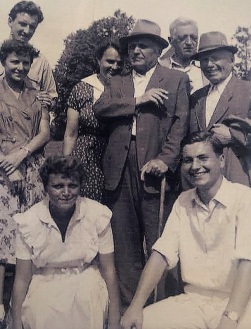 |
matched at tennis and table tennis, so numbers were also fairly easy to pick up.
I remember being grateful to Mr. Hutchison (aka Bunny Hutch, Morgan language teacher) for my limited knowledge of French and German. The problem was that Deso’s mother, known to all as Momi, spoke excellent French and some English, Deso spoke excellent English and German, and his father spoke excellent German but little English. Conversations were never dull!
As part of our further education we were asked to visit some factories and where appropriate make use of their production output. The British Council seemed to think this would be a good introduction to understanding the wonderful communist economy. Deso had volunteered to organise suitable visits. One of these was a cigarette factory and the other was turning out some rather good alcoholic beverages. We followed directions and sampled a good cross section of these.
As far as our little group of eight or nine brave souls was concerned there was only one further group get-together. This was a visit to the caves at Postojna, an enormous cave system about 45 minutes by road from Ljubljana.
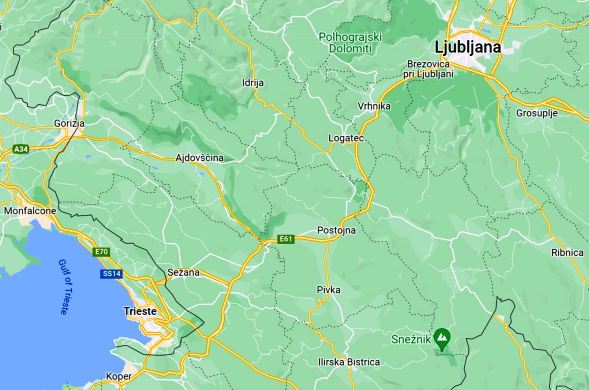 |
| Postojna, between Trieste, Italy and Ljubljana, Slovenia |
Apart from the stalactites and stalagmites the caves are famous for two features. One is a huge cave with a perfectly flat floor. It was used from time to time as an underground concert hall. The other is a unique fish
which is totally blind. Functionally, there was no need for sight as there was no light at all. An excellent example of evolution.
Deso had volunteered to organise the visit. The journey by train wasn’t cheap, but there was a greatly reduced fare for Slovene students. Our party contained about eight British and the same number of Slovenes. So, we paid Deso at the local Slovene student rate and agreed to leave all the talking to the locals especially when the ticket inspector was nearby...
To be continued…
|
|
 |
 |
A Moment in Space and Time
Hugh McGrory |
 |
 |
Funny how you can start thinking about something, which makes you think of something else, which makes you think of….
Recently I saw a video of dogs running the length of a football field to catch a frisbee (apparently my favourite dog, the border collie, is recognised as the best of the best in this role). This made me think of fielders in baseball or cricket who do the same thing – that is, man or beast, they are able to move part of their body into the path of a flying object so as to arrive at the same point in three-dimensional space at exactly the same moment.
This got me thinking of what wonderful organisms brains are – human or animal. Think of it – running at speed, watching an object flying through the sky and instinctively adjusting course and speed so as to arrive at exactly the spot to make the catch. Few of us could perform this feat, though we’ve all experienced it in a small way when someone throws us something to catch...
Finally, that thought of objects coming together in time and space reminded me, strangely, of a story…
In the early sixties. I had just moved to Killin in Perthshire to manage a tiny office of 5 people
as a Resident Engineer for Perth County on road and bridge projects in that part of the Highlands.
I was driving west along the A85 on the north shore of Loch Earn and turning north at Lochearnhead into
Glen Ogle. I was with a local man, though I can’t remember who, and, as we turned into the glen, he told me of an incident that had occurred some time before at that spot.
An army truck loaded with army cadets (much like the teenagers in the photograph) was travelling north on
some kind of training exercise, and they stopped just outside the village for a break. Some of the cadets got
out to stretch their legs while others relaxed in the back. It was probably a Bedford RL Troop Carrier – soft canvas sides with benches down each side facing each other.
As the kids lounged on the benches, leaning on the side canvas, feet up on the supplies in the middle of the lorry, there was a thump. One of them pitched forward – he was bleeding badly from his head – and quite dead!
A heavy vehicle had passed by and the side mirror had brushed the canvas side of the lorry… Later, police tracked down the vehicle in the Glencoe/ Ballachulish area and the driver said
| |
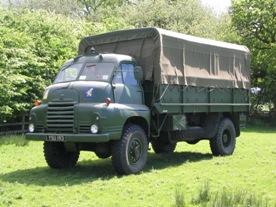 |
that he remembered the army truck but hadn’t felt a thing.
PS
I’ve tried to verify this story more than once to no avail, but:
1. While I can’t remember who the source was, I did believe it at the time, so presumably I felt the person could be trusted.
2. In my research I did find references to accidents of a similar nature with soft-sided army vehicles, and subsequent changes made in army regulations. See here:
|
|
 |
 |
Traffic Control
Gordon Findlay |
 |
 |
Our traffic control training began on a benign square of concrete painted with road markings and equipped with fake traffic lights. We would take turns acting as “traffic”, walking in groups of three (a big truck), two (a van) or singly (posing as a car). The lucky trainee on duty at the crossroad would control the “traffic” flow with hand signals, watched carefully by the sergeant in charge to make sure he did not allow the “traffic” to back up on any one of the painted streets.
And woe betide the trainee if he inadvertently allowed two streets of “traffic” to drive into each other. “You stupid arse!” the sergeant would bellow. “You just smashed up ten bloody trucks!”
But then came the day when we were unleashed on the unsuspecting citizens of Colchester to help control
their traffic flow in and out of the historic old town. One by one we were allowed to pull on the long white
gloves and don the red hat-cover of an active MP. Then we were taken to one of the intersections of town where the traffic lights would be switched off – and we were in control.
What was magical about this exercise was how suddenly and wonderfully powerful you felt. Up went your white-gloved hand and a massive 22-wheel Foden diesel truck would grind to a halt. Behind it, a flock of Austins, Hillmans and Fords coasted to a stop. Keeping that left hand high, you did a sharp turn to your right and firmly waved on traffic in the other lane, sweeping your right hand smoothly past your head from front to back...
| |
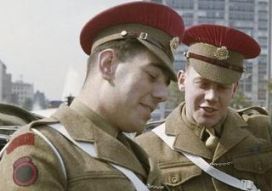 |
and like a solid stream of coloured metal, a column of cars and vans rumbled past your shoulder
You kept a sharp eye on how much traffic was backing up in the stopped lane, and when you guessed they had waited long enough, you raised that right hand again to stop the flow. Then with the left hand beckoned on the lane of traffic waiting patiently for your signal.
For the first few minutes it was nerve-wracking. What if they don’t stop? What’ll I do if some idiot disobeys the signal and crunches into someone’s truck or car?
But slowly you discover that they ARE obeying your signals. You are in charge. Those white gloves on your hands and the red cover on your hat demand obedience from the drivers who approach your intersection. And the sheer power of being in control of all this becomes hypnotic. For those fifteen minutes on duty at that crossroad, you felt twelve feet tall.
|
|
 |
 |
Bearing Witness
Hugh McGrory |
 |
 |
The Charles Smith story reminded me of my own appearances as an expert witness early in my career in Canada...
The Ontario Municipal Board (OMB) was an independent, quasi-judicial body that existed in Ontario from 1906 to 2018. The OMB was an independent administrative board, operated as an adjudicative tribunal, and a very powerful body. One of its major functions was to act as a planning review tribunal – which was where I became involved.
Toronto in the late ‘60s was in the midst of a land development boom. Developers were buying up single-family homes in particular areas with a view to razing the whole area and erecting high rise buildings thus creating a much higher-density environment – and much more revenue, of course.
However, these areas were typically designated as ‘low-density residential’ under the Official Plan of the municipality. Developers would require a variance from the plan – but often local residents didn’t want to sell and move away, and so objected. Eventually this often resulted in a hearing before the OMB which had the power to overrule the municipality and its official plan.
Many objections were often raised against such developments – incongruity with existing low density neighbourhood and violation of the Official Plan; lack of open space; shadows, and loss of sunlight, to name a few. I worked for a consulting engineering and planning company and developers would come to us for help. Another objection often made was that the new building would generate too much traffic for the local street network. Since my background was in traffic engineering, I would be part of the team working on the project.
The way it worked was that I would carry out various analyses (including having people go out and count cars entering and leaving the area, and similar existing high-rise buildings) then write a report for the client. If my report concluded that there was a problem, they would say thanks and pay us off. If, however, I concluded that the traffic generated would not create problems they would hire us to provide expert witness testimony at the OMB hearing – and I would be the designated 'expert'.
The presiding ‘judge’ for these hearings was usually the Chairman of the OMB, Joseph Kennedy, a very powerful character in Ontario because of his position, and followed the strict format of a court of law – witness box, opposing counsel, spectators etc. – just like TV…
This was a great experience for me (not to mention nerve-wracking) since I hadn’t been in the country that long. There was a great deal of money involved, and so the best (and most expensive) counsel in Ontario were hired (and examined or cross-examined me when I was giving evidence). I particularly remember Edwin Goodman (sometimes referred to as ‘Fast Eddie’, a mover and shaker in the inner councils of the
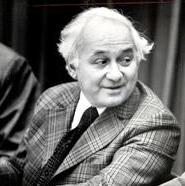 |
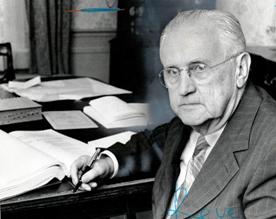 |
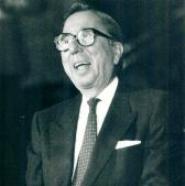 |
| Edwin A Goodman |
Joseph A Kennedy |
Charles L Dubin |
governing Progressive Conservative party of Ontario), and Charles Dubin (later to be appointed Chief Justice of the Supreme Court of Ontario).
Ethically, the role of an expert witness is to present to the court the facts of an issue based on education and experience, and on any specific investigations that they have carried out. They are not supposed to ‘fight’ for one side or the other, regardless of which side hired them. As we have seen, this was one of the deficiencies in Charles Smith's behaviour.
In terms of procedure, the witness is examined and cross-examined by opposing counsel and it is the role of such counsel to ask those questions which help their client's case ("experienced lawyers never ask a question unless they are sure of the answer they are going to get..."). The witness should answer both counsel in the same way – based on the facts and subsequent analysis – and not slanted to either side.
One of the quirky things that I remember from those occasions springs from the fact that the public was allowed to observe, and the seats were often filled with citizens in opposition to the proposal in question. Those citizens were 'armed for bear', not surprising – some of them were fighting to keep their homes of 40 or 50 years – and they were allowed to ask questions of witnesses...
I didn't usually have trouble answering questions, under cross, from opposing counsel, or from the Chairman who, on occasion, would question witnesses himself, but I did have some difficulty answering those from the public benches. Counsels' questions were mostly predictable, they tended to be technical and were mostly anticipated in our pre-trial prep. sessions.
Questions from spectators came from left field... What I wanted to say sometimes was "That's a dumb question", or, "What does that have to do with anything...". That would have been a huge faux pas, of course! I had to be very courteous and try to come up with a reasonable answer.
One way or another, when my testimony was over, I was usually sitting in a pool of sweat – I guess I didn't have Charles Smith's confidence...
|
|
 |
 |
The Odeon Club
Brian Macdonald |
 |
 |
The Dundee Odeon cinema of my childhood stood on Strathmartine Road next to the Coldside branch of the
Dundee public library, just across the roundabout at the bottom of Caird Avenue, where five major streets meet. It had a grand, art deco frontage, with a huge, vertical sign that blasted out the cinema’s name at night in big, red, illuminated letters. It was built in 1936 as the Vogue cinema. A year later, the group of which it was part was taken over by Oscar Deutsch, an English entrepreneur, who went into the picture show business in 1928 and built up a successful chain of Odeon cinemas that covered Britain. It was subsequently re-named The Odeon.
By the end of World War II, when I was seven, the Odeon chain of more than two hundred cinemas had been
sold to the British Rank company. Many filmgoers of my age and much younger will recall the J. Arthur Rank Organisation’s logo of a heroic, muscular, male figure in profile striking a huge gong, complete with sound, at the start of a cinema showing.
J.Arthur Rank was of the family of the same name which already had a Britain-wide flour milling business, which became Rank, Hovis, McDougall, and whose huge flour tankers were to be seen on England’s roads carting bulk flour to bakeries to be turned into
| |
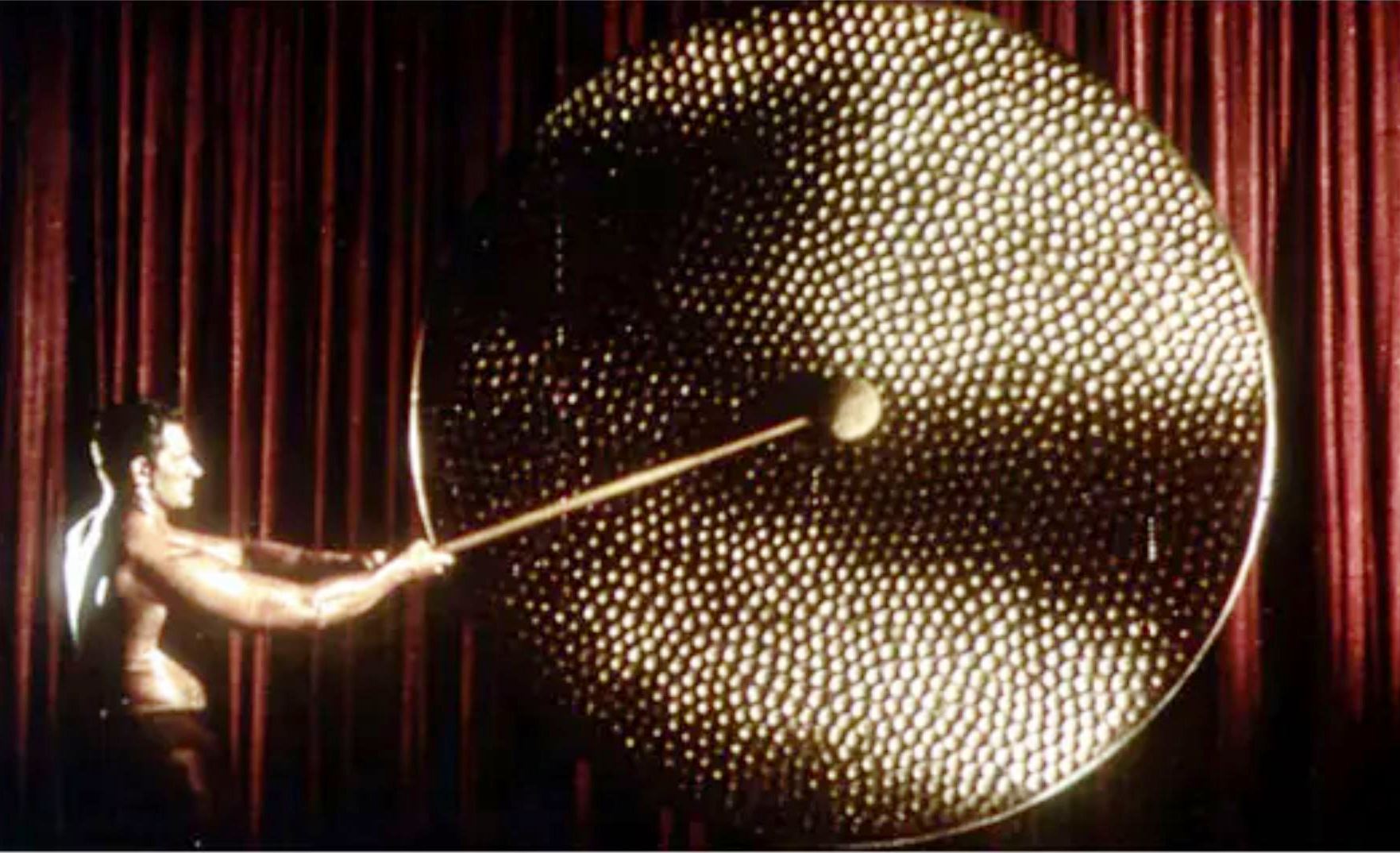
|
loaves of sliced bread.
J. Arthur Rank became the dominant company in film production and distribution in Britain, followed by
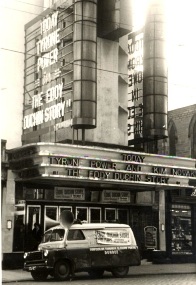 |
 |
Gaumont British and Pathé, both of which had their origins in French companies. The J. Arthur Rank Organisation disappeared before the turn of the last century. Most of Dundee’s cinemas of this era were owned by large cinema companies but an exception worthy of mention was Green’s Playhouse in the Nethergate, close to the city centre, also unashamedly art deco inside and out, with a flamboyant tower that carried the vertical name ‘Playhouse’.
|
 |
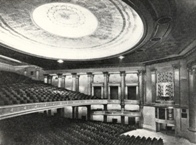 |
Green’s Playhouse was grand and luxurious with a very large auditorium that boasted and often filled four thousand seats in stalls and circle and had in addition a small number of private boxes. It was built and owned by an independent distributor. The complex incorporated a popular tearoom furnished with armchairs,
which enjoyed a vogue as a meeting place among Morgan Academy senior students during my last years at school. On occasion the large tearoom also did duty as a ballroom.
Most of the city’s picture houses(1) were scattered around the city centre and it was a bus or tram ride from where most Dundee citizens lived to get to them. The Odeon, located in what was, in the 1930s and 1940s, an outer, mostly working-class, residential area, was an anomaly. As I lived on the other side of Clepington Road, in the Fairmuir area, with a short-cut leading straight down Fairmuir Street and Caird Terrace, it was a ten-minute walk to reach the Odeon and the library, both of which I patronised. The cinema is gone now, making way for a supermarket and a sun-tan centre, although the Coldside library still stands and serves the local community, thank goodness.
J. Arthur Rank closed the Odeon in 1973 and it was later demolished. The Odeon Cinema name still exists in Dundee but is borne by a modern complex with ten screens, located near the eastern end of the Kingsway, the city’s loop road, where the Kingsway becomes the A92, the coast road heading northward to Arbroath, Montrose, and Aberdeen. In my young days we simply called it the Arbroath Road.
As well as having a well-patronised schedule of general films, the Odeon Cinema of my childhood ran an event very popular with the local kids, the Odeon Club. This was a Saturday morning matinée showing for young people with films to suit. You paid a modest ticket price at the box office, and you could join the club by filling in a form with your name, address, and birth date. You still had to hand over your cash on a Saturday morning (In my day it was sixpence for a stall seat and ninepence for a balcony or circle seat.) but were entitled, as a club member, to a free ticket for the Saturday nearest your birthday. The free pass came in the post, which was much quicker and more reliable in those good old days.
The Odeon Club proved a mecca for us local urchins and there was always a noisy queue on the pavement on Saturday morning before nine o’clock, silver sixpenny pieces clutched in our hands or in our pockets, eager for the doors to open so we could jockey for the best seats. I suppose our parents were glad to be rid of us for a couple of hours too, on their morning off work. Most of us paid the cheap rate, which entitled you to a neck-stretching seat looking up at the screen, and only enjoyed an upstairs balcony seat when we got our free birthday pass. I believe this privilege ended when the balcony was closed for the Saturday morning showing.
The format was always the same. There were a few trailers of coming attractions to whet our appetites for future attendance then the show proper. Laurel and Hardy, Old Mother Riley and the comic genius Charlie Chaplin were favourites. There would be an intermission when we filled ourselves with a Walls’ ice cream slider(2) or a bag of Smiths Crisps, only one flavour, complete with salt in a twist of blue waxed paper. There was always a very popular sing-along session, when we belted out Harry Lauder(3) favourites like ‘I love a lassie’, ‘It’s nice tae get up in the morning’, ‘Roamin’ in the gloamin’’ and ‘Keep right on to the end of the road’, with the words appearing on the screen with a bouncing ball above them, keeping time for us as it followed the words. After the interval there would be a Roy Rogers, Tex Ritter, Gene Autry or Hopalong Cassidy cowboy film and sometimes a short, educational feature.
At the end of the showing, only a reprobate few left before we had obediently stood and sung the national anthem, with a film clip and the music by a military band from the annual king’s birthday(4) Trooping the Colour parade. Then we poured out of the Odeon, a boisterous rabble, blinking in the daylight, ready for another Saturday and Sunday of sport and play before the drudgery of school started again on Monday.
It would be a long time till the next Saturday.
Footnotes
(1) Between 1940 and 1955, Dundee boasted twenty-six cinemas. In the early 1950s, cinemas played to packed houses and large-scale musicals such as Oklahoma (The opening scene of Curly riding his horse out of a huge screen at me while he sings the joys of “Oh, what a beautiful morning” is still in vivid, glorious Technicolor, in my memory.) and South Pacific commanded huge audiences. Now it seems there are only three cinema houses in the city, but each has multiple auditoriums and musical films are now derived from standard stories which are not just the pure entertainment of these mid-20th century indulgences.
(2) A ‘slider’ was an oblong of ice cream held and eaten, with much licking to contain the melting drips, between two thin, flat wafers. Walls ice cream came as a solid, somewhat waxy block wrapped in grease-proof paper but in most cases the softer and creamier local product was scooped from a container and formed in a metal mould with an ejector mechanism. The packaged version was more convenient for the young women who patrolled the cinema aisles with a dimly lit tray of sweets, ice cream and cigarettes slung from their shoulders. The popular and manageable cornet style of the delicacy was known as a ‘cone’ or sometimes a ‘poke’ in Scotland.
(3) Sir Harry Lauder was the most popular Scottish music hall and radio entertainer of the first half of the 20th century. He wore full highland attire and carried a cromach (a Scottish walking stick, usually longer than the standard walking stick and often irregular in shape) and sang Scottish dialect songs, many of which he wrote. His popularity far exceeded his native Scotland. He was said to have been, at one time, the most highly paid entertainer in the English-speaking world. He was knighted for his charitable and fund-raising work during WWI. Lauder’s songs were wholesome, upbeat, and cheerful. It is reported that he was offered Will Fyffe’s ‘I belong to Glasgow,’ a song about a Glaswegian working man somewhat incapacitated by alcohol on his Saturday night out, who is incoherent, dizzy, and garrulous, but that Lauder refused it because it celebrated the consumption of alcohol.
| |
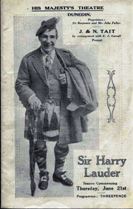 |
(4) King George VI reigned over the United Kingdom from 1936 till his death in 1952. On his death, his older daughter, Elizabeth, ascended to the throne, becoming Queen Elizabeth II of Great Britain. Only then did the national anthem become ‘God Save the Queen’ and the June parade become The Queen’s Birthday Trooping the Colour.
Once again, I am indebted to the memories of Dorothy and Neil Alexander, contemporaries and neighbours of my childhood, and fellow Morgan Academy students, for bolstering my failing memory.
|
|
 |
 |
A Man Called Smith 5
Hugh McGrory |
 |
 |
The Smith affair was a sad commentary on a failure of the Ontario justice system, and one has to ask the question, "How the hell could this have happened?" I want to conclude the series by addressing this...
We’ve seen some of the damage caused to many, many people, not only the principals in each case, but their extended families, friends, neighbours, work colleagues and acquaintances. Of course, some received compensatory damages. The Ontario Government provided some compensation: those 'directly' affected by the debacle were eligible for amounts of up to $250,000, children removed from their parents’ custody were entitled to up to $25,000 and other family members up to $12,500.
Beyond this, some turned to civil law and sued various parties, winning varying amounts – Bill Mullins sued for $14 million and was awarded $4.5 million. It seems however, that for many of the victims the money didn’t really heal the deep wounds left by their journeys through hell.
It doesn’t seem that Smith acted with malice, with intent to harm innocent people – the law system in Ontario seems to agree since no charges were ever brought against him. However, the Goudge Report revealed a litany of problems.
- First, despite his training and experience in pediatric pathology, he knew virtually nothing about forensics. He admitted at the Inquiry that his training in forensic pathology was "minimal", that he was basically “self taught". Adding fuel to the fire, he seems to have been supremely self-confident, believing that he was always right, and when coupled with his manner of presentation, seems to have convinced everyone from police to judges and juries (not to mention his superiors and colleagues…) that he was indeed ‘infallible’.
- He was not properly supervised by his superiors, the Chief and Deputy Chief Coroners for the Province of Ontario (while Smith had no education in forensic pathology, neither of them had any expertise in pathology!)
- Many of his practices in performing autopsies were woefully inadequate – he almost never attended the death scene; he didn’t always ensure that the appropriate medical records of the decedent were available and consulted; he was sloppy and inconsistent in documenting his work; his reports were nothing more than a recitation of his findings and his conclusions were not supported by a persuasive connection to the facts.
- He misplaced evidence that sometimes turned up many months later, and he frequently missed deadlines for producing reports (twice police actually subpoenaed him in order to have him produce the information).
- He did not prepare adequately for his court appearances usually only reading his report from months before to remind himself of the case. This was inappropriate and insufficient and not surprisingly often caused difficulties.
- Finally, he seems to have had a lack of understanding of the independent role of an expert witness, an area in which I have some personal experience... Smith is quoted as saying, in his first day of testimony before the public inquiry probing his work, that he now realised he had little understanding of the criminal justice system or the role an expert witness should play in a trial. "I thought I knew it, but I realize now just how profoundly ignorant I was".
He said he used to think his role as an expert witness in a trial was to support the prosecution. He didn't realize it was his job to be impartial.
"In the very beginning, when I went to court on the few occasions in the 1980s, I honestly believed it was my role to support the Crown attorney," Smith told the inquiry. "I was there to make a case look good. That's the way I felt."
As I end this story that turned out so badly for so many, I can’t help returning to one of my pet themes – the randomness of our lives…. Charles Smith and I crossed paths very briefly more than forty years ago – he was a doctor, and I an engineer, but we were both computer nerds.
When I first came across computers I was hooked, and through happenstance, I went from being a user of computers in my engineering work, to a role providing the software and hardware computer tools that other engineers could use in their work – and had a very satisfying career.
Perhaps if Charles had taken a similar path and concentrated on computing as a tool for doctors, rather than specialising in pathology, the heartache of so many people would have been avoided…
|
|
When we started our sixth year at Morgan Academy (1953) I had heard of Yugoslavia, but that was about it. Little did I imagine that by the next summer I would spend a month living with a family there.
The way it happened was as follows. A UK government organisation called the Education Interchange Council (an offshoot of the British Council) had been set up to offer subsidized travel to the then Yugoslavia and, it was hoped, foster closer ties with that Communist country. To that end, about a hundred UK schools were asked to nominate one sixth former to make the trip. The way the schools were selected should ensure a cross section of the UK. The Yugoslav schools were chosen the same way.
That meant that Scotland would be allocated eight places, one of which would be from Dundee. That place was given to the Morgan, and I was the lucky one to get it.
Sixty-eight years later and sadly my friend Deso (nickname for Desimir) is no longer with us, but we are still regarded as family members, so I suppose the scheme was a success, at least as far as Dundee and Ljubljana are concerned.
Once I heard that I had been accepted for the exchange visit, my first job was to read all that I could about
Yugoslavia and here I was lucky to find a book entitled Eastern Approaches by a former diplomat turned soldier called Fitzroy Maclean. He tells a thrilling tale in a best selling novel, a large amount of which is about his liaison work with Tito and his partisan group during WW2. Incidentally, he became the youngest brigadier ever in the British army.
I read many other books about the country at that time and that helped when I first met my host family and their friends. Thanks are due here to the Dundee library, whose staff helped me with books about the country and its history.
Having got whatever information I could about Yugoslavia I needed spending money plus permission to take it out of the UK – we were all still facing postwar austerity. I have my old passport from that era and it shows that I had
|
 |
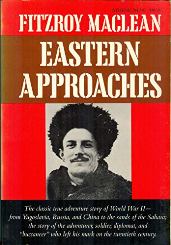 |
 |
permission to take the magnificent sum of £20 to cover my spending money for four weeks.
So, armed with a little knowledge and very little cash, I left Dundee and found my way to London, where the real journey began. I mentioned above that our group was about a hundred strong. We all made our own ways to London’s Victoria Station where we were herded into our various groups, according to our destinations. The biggest group was heading for the capital, Belgrade. The others being destined for Zagreb, Novi Sad, and our little group for Ljubljana.
It took two days to get there. First we went from London to Dover. Next the ferry to Calais and finally on the Simplon Orient express to Yugoslavia.
Two events remain fixed in my memory of the journey. First was passing through Frankfurt in the middle of the night. I was astonished to see building work in the middle of the night with builders working with floodlights to repair the damage done by the RAF and the Americans. It was obvious that the German economy was prospering.
The other memory was as follows. You may or may not be able to imagine the boredom of being cooped up in a train carriage for two whole days. So, passing through Austria and into Yugoslavia, I decided to walk down the train and get the blood circulating again. As I started to enter the last carriage I realized that it was a sort of guard’s van with some big packing cases in the middle. A group of young Yugoslav soldiers were sitting round these boxes drinking and playing cards.
What to do? One of the soldiers started to speak to me in the local language so I indicated that I didn’t understand. Fortunately, I had taken German at the Morgan and this they could speak. I was soon sitting down with them and being plied with the local fire water known as Slivovitz. Welcome to Yugoslavia...
To be continued…
|
|
 |
 |
A Man Called Smith 4
Hugh McGrory |
 |
 |
We previously looked at the first of three types of cases – where people went through hell, but in the end, no charges were laid.
The second type of case:
Where people who were innocent of the charges they were facing, felt obliged to plead guilty to lesser charges to avoid the likelihood of much longer sentences.
In 1992, at the age of 23 and pregnant with her fourth child, Maria Shepherd pled guilty to manslaughter in the death of her three-year-old stepdaughter, Kasandra.
Maria changed her not-guilty plea to guilty, mid-trial, when faced with Dr. Charles Smith's expert evidence that Kasandra had been killed by a blow to the head. Court documents show Kasandra began vomiting and became unresponsive in April 1991 after a long period of ill health. She died two days after being admitted to hospital.
The advice from her defence counsel was that, with Dr Smith’s reputation as an infallible expert, she would in all likelihood be found guilty. Instead, she should accept a deal worked out with the prosecution to enter a joint submission on a sentence of two years less a day with three years probation. This lesser sentence would mean that she would probably be released after about a year, and was a strong inducement to plead guilty, as she may otherwise have faced a much longer sentence.
Maria was incarcerated and taken from her young family for 11 months. Twenty-five years later the
Ontario Court of Appeal set aside Maria’s conviction on the basis of new forensic expert evidence which demonstrated that Smith's conclusions were without scientific basis.
It was believed that Kasandra may have had a previous brain injury, which could have caused seizures. They also believe that she may have suddenly developed a seizure disorder that could have killed her. Her guilty plea was set aside and she was acquitted of manslaughter.
|
 |

|  |
The third category:
Wrongful convictions where the accused maintained their innocence and received long prison sentences.
The most egregious case was that of William Mullins-Johnson (known as Bill Mullins) is an aboriginal man from the Batchewana First Nation in Northern Ontario, a gentle giant of a man. He was described as a six-foot-five, 250-pound, ‘soft-spoken’ man. Sadly, he went partially blind and deaf as an infant and was also left with a speech impediment due to swelling in his brain. This caused him to be deemed ‘different’, even by his own Ojibwe mother.
In 1963, he was living with his brother Paul, Paul’s partner, Kim, and their three children in Sault Saint
| Uncle Bill, and Valin at 10 months old |
Marie, Ontario. Bill got along well with Kim and the children and was very close to his brother. Paul and Kim decided to have an evening out and asked Bill to babysit the children. Next morning, when Kim went to waken the kids, she found her four-year-old daughter, Valin, was dead.
An autopsy was performed by a local pathologist who determined that Valin had been strangled to death; a local pediatrician said the child had been sexually abused – there was bruising on her body and her anus was distended; Charles Smith consulted on the case from Toronto and concurred – he further concluded that the four-year-old was being sodomized at the time of her death.
The police arrested Bill Mullins and he was charged with first degree murder. Paul and Kim did not believe that Bill, the uncle the children adored, was guilty.
The jury decided that Bill had killed Valin while sexually assaulting her – he was convicted of first degree murder and sentenced to life in prison without the possibility of parole for 25 years. At that point, Paul and Kim’s love for Bill turned to hate.
For his part, Bill heard the ‘expert’ testimony in court that the child was sexually assaulted, and , like everyone else, believed it. So, knowing that he was innocent, the only other person who could have done it was his brother who was sitting watching him go to prison. Bill’s love for his brother turned to hate too.
 |
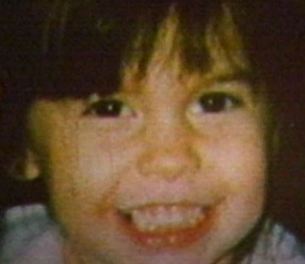
|  |

|
 |
Valin, four years old |
 |
Her father and Bill's brother, Paul Johnson |
Bill continued to maintain his innocence through his years in prison, where, as a convicted baby killer, he was subject to assaults and torture from fellow inmates (everyone needs someone to look down on...)
After 10 years a lawyer from the Association in Defence of the Wrongly Convicted (Innocence Canada) visited Bill. He said that they believed that he was wrongly convicted, that no sexual assault had taken place, and that Valin had really died of natural causes!
They had consulted a number of experienced forensic pathologists and they agreed that the bruising was lividity (blood pooling), and the distension of the anus was a relaxation of sphincter muscle, both natural post-mortem processes.
Eventually the Ontario Court of Appeal agreed to hear the case based on the incompetence of Charles Smith and the new interpretation of the evidence. Bill’s first-degree murder conviction was set aside, and an acquittal entered in its place. Bill was set free.
| Bill, just freed after 12 years in prison, with his mother |
Sadly, by then, Paul and Kim’s relationship had ended, Paul had lost his children, and his life had descended into drugs and alcohol.
(To be concluded...)
|
|
After we had learned most of the rudiments of military discipline and British Army law, we got stuck into motorcycle and truck driving, traffic control and pistol shooting, Although on duty we wore white cross-webbing that included a pistol holster which could accommodate a .38-calibre Webley pistol, we were never entrusted with such a weapon in normal duty. That bulky and imposing holster was stuffed with nothing more dangerous than yesterday’s 'Daily Mirror'.
When we did, finally, get an opportunity to shoot the .38 Webley, we fired at plywood figures some 30 yards away, set up against large mounds of sand and gravel. The Webley always fired high and right. You had to physically force it down and to the left as you fired. You were instructed to hold the Webley with your right hand (if you were right-handed) straight out fully extended... none of this bracing the gun hand with the other hand. That was for American shooters, gangsters, and foreign mobsters – not for British policemen.
|
 |
.jpg)
|  |
The disconcerting fact that emerged from our day at the shooting range came when we 'spotted' for our fellow trainees as they blasted away at the plywood figures. Comfortably, and safely ensconced in ground-level pits, we watched as those .38 Webley bullets barely punched through the plywood before dropping like tired bumblebees into the sand behind. It was pretty obvious our pistols were worn more for their intimidation effect than their stopping power.
We trained on Army-issue 350 and 500 c.c. BSA motorcycles, complete with levers for spark and mixture
control. In theory we should have been able to set our petrol mixture at 'rich' when starting cold, then slowly switch to the “lean” setting as the engine warmed up. Same with the spark control – to be set in the ‘advance' position on starting, then quickly moving to the 'regular' setting to achieve the most economical and advantageous use of our machines. Well, that was the theory...
Unfortunately, these motorcycles were clapped-out old beasts that wheezed and groaned like the pensioners they were. Legions of trainees before us had misused and mangled the levers so that the bikes staggered on as best they could, coughing and farting on a much-too-rich diet of pure petrol and wildly inaccurate spark settings.
As a group, we thundered down the quiet roads of Colchester, belching blue fumes and poisonous smells like a mobile gas attack. On my sagging old machine, I remember, the speedometer was stuck permanently at a highly unlikely 85 miles-per-hour – a speed the machine might have aspired to in its youth but could now only achieve if it were fired from a cannon.
|
|
 |
 |
A Man Called Smith 3
Hugh McGrory |
 |
 |
The Coroner’s Review examined 45 of Smith’s cases; it found problems with 20, of which 13 involved convictions. The 45 cases generally fell into three categories, and we’ll look at an example of each:
Where parents or caregivers were investigated but charges were never laid, or were withdrawn, or in which the accused was acquitted at trial.
Lianne Thibeault's son Nicholas died in 1995, in Sudbury, Ontario. The little boy was 10 months old when
he fell and hit his head on a sewing machine. His mother saw immediately that he wasn’t breathing, called 911, and tried to revive him. Sadly, the baby was declared dead at the hospital. Almost 18 months after Nicholas died, police told Lianne that she was a suspect for her son's death. This is how that came about:
A local pathologist had caried out an autopsy, categorizing the cause of death as ‘SIDS’, (Sudden Infant Death Syndrome). However, months later, a supervisor found an error in the post-mortem report – the cause of death should have been classified by the broader ‘SUDI’ (Sudden Unexplained Death in Infancy) since the baby had not been asleep at the time.
That relatively minor error triggered a review, which fell to Smith – he dismissed the original pathologist’s findings and carried out an exhumation in order to perform a second autopsy. Lianne attended, and when she arrived at the cemetery, she was shocked by what she saw.
"I could see a group standing beside my son's grave and – they were still in the process of pulling the dirt out of the ground," sad Lianne, “and I could see a little boy playing in the dirt. I was furious."
That little boy was Charles Smith's son (seen above, with his father). Smith said he brought his son to Sudbury to help keep him awake during the long drive from Toronto. The Chief Coroner later admitted the child should not have been present at the exhumation.
The Crown did not proceed with charges against Lianne, but that was not the end of her ordeal. She was pregnant, and Children's Aid announced it would be apprehending her unborn daughter at birth because of the police investigation into Nicholas' murder.
"During my first trimester of pregnancy, I was being accused of murder and did not know whether or not I would be going to jail, and in my third trimester, I was being told my baby was going to be taken away."
Children's Aid seized the child at birth and Leanne's name was added to the Sex Offenders Registry. She was placed with her grandparents, who acted as de facto foster parents. Lianne was only allowed limited access and required strict supervision.
Lianne's father, Maurice Gagnon spent more than $100,000 over the next six months hiring a top Sudbury lawyer and searching for medical experts and pathologists to challenge Smith's opinions. He found several who felt Nicholas' death had been a tragic accident.
Faced with competing opinions, the provincial chief coroner's office hired its own independent pathologist to review the case again. Dr. Mary Case's report finally put the matter to rest. She found no evidence of foul play and said Nicholas could have died from bumping his head. Lianne's explanation of what happened was entirely plausible.
It took 18 month's before Children's Aid dropped its application, and, in 1999, return Lianne's daughter to her care.
(To be continued…)
|
|
 |
 |
The Golden Age of Science Fiction 5
Brian Macdonald |
 |
 |
Other notable science fiction writers
Raymond Douglas Bradbury, another from this era, born American in 1920 and dying in 2012, wrote not
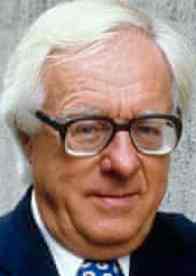 |
 |
only science fiction, both fantasy and hard SF, but also horror and mystery. As was usual, most of his output started as short stories, some later becoming novels. His best-known science fiction work, known even to those with no knowledge of SF, is Fahrenheit 451 of 1953, which tells of a dystopian, totalitarian, future America, where possession of books is a crime and ceremonial burnings of discovered hoards of books are held. A film was made of the book but, maybe surprisingly, not till 2018, and there have been TV series.
|
 |
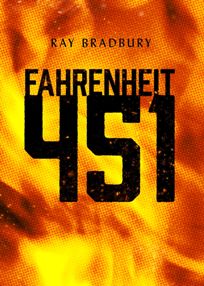 |
Bradbury’s The Martian Chronicles is science fiction only because it is set on Mars. It describes the trials of an Earth colony set up on the red planet and is not rigorous in its science. His The Illustrated Man is not really a novel, more a compilation of short stories loosely linked by a heavily tattooed man who is the protagonist of one of the tales. Because Bradbury was not exclusively or even mainly a writer of science fiction, the style and content of his SF books made SF more palatable to non-SF readers. Ray Bradbury continued to publish until several years before his death.
John K H Brunner (English, 1934–1995) won the Hugo Award in 1969 for Stand on Zanzibar, about a dystopian, overcrowded world. Brunner wrote many science fiction novels, some under the name of Keith Woodcott. Another novel by Brunner on social topics was The Sheep Look Up in 1972. This grim tale forecasts and goes beyond the situation the world finds itself in now, in 2022, when we are slowly and
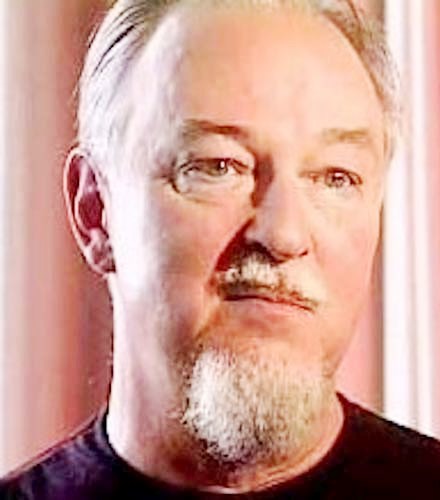 |
 |
inevitably destroying our planet’s ability to support life through our profligate use of natural resources and the consequent, ever-increasing pollution which is changing the atmosphere for the worse.
In doing so it builds on the work of Rachel Carson, whose non-fiction scientific Silent Spring, took the thinking world by storm in 1962.
Carson warned of the damaging effects of the overuse of pesticides. Brunner’s title is drawn from a poem, Lycidas (The hungry sheep look up, and are not fed), by the 17th century Englishman John Milton, author of Paradise Lost. Milton had a strong concern for social issues and the welfare of the poor, whom he likened to sheep needing direction and support. Brunner drew attention to a growing social and economic problem of his time.
Do Androids Dream of Electric Sheep? is a work from 1968 by Philip K Dick, another notable SF writer of the Golden Era. The plot is of a bounty hunter seeking androids (robots) which have gone wild. Earth is dystopian, polluted (common themes), with limited human population, those who could having decamped to other planets. Most other creatures are dead. I mention this tale because it is the inspiration for the very popular Blade Runner film series.
Edward Elmer Smith, better known as E. E. ‘Doc’ Smith, authored the Lensman series, which covers a vast timescape from the start of the universe all the way to the future. It was the runner-up to Asimov’s Foundation series for the Best Series of All-time Nebula Award in 1966.
|
 |
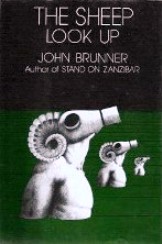 |
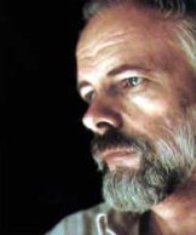 |
 |
 |
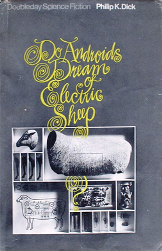 |
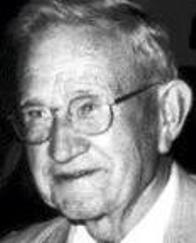 |
 |
 |
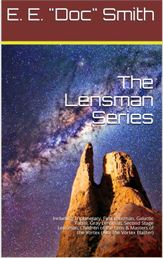 |
Although not from the Golden Era, no article about science fiction authors would be complete without more than a mention of Douglas Noel Adams, born 1952 and, alas, dead in 2001 at the young age of 49. Although Adams wrote in other genres, he is best known for his great set of five books, together named under the title of the first of the five, The Hitchhiker’s Guide to the Galaxy. This is in fantasy mode and intended as light entertainment, not as prophecy or warning of future disaster. It began life as a proposal to the BBC for a short radio comedy series. It grew, topsy-like, into a book, then five books, a TV series which I recall watching, a film and a stage show. The third book in the series has produced a phrase that has entered our consciousness – ‘Life, The Universe and Everything’. Is there anyone in the English-speaking world who does not know that the answer to the question “What is the meaning of life, the universe and everything?” is the cryptic “42” given by the morose computer at the end of the universe.
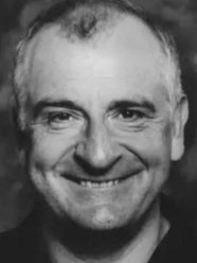 |
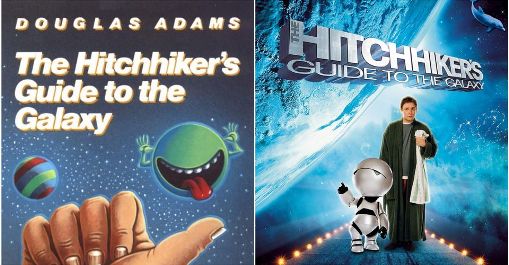
|
If you read no other science fiction, do please read The Hitchhiker’s Guide series of books. At least once!
Readers may remark, if they bother to get this far, that I have dealt almost exclusively with male authors. Regrettably, because female minds might have contributed a very different view, female science fiction
 |
 |
writers are almost non-existent from the Golden Era. I have mentioned Ursula K Le Guin and Anne McCaffrey from this period. Margaret Atwood, who published The Handmaid’s Tale as recently as 1985, writes in a wide range of modes, including poetry. Her recent sequel, The Testaments, is also classed as science fiction. Both books describe the same grim, dystopian, religious extremist, male-dominated, dictatorial, future society, which grew from a disunited USA. How far is this from the
|
 |
 |
extreme religious states that have sprung up in parts of our globe?
Mary Wollstonecraft Shelley(1) lived in the 19th century. Her mother was Mary Wollstonecraft, an author,
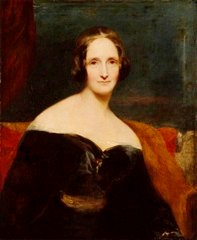 |
 |
and an early campaigner for women’s rights. It was to our advantage that her father, also a writer, saw to it that she was broadly educated, which was by no means universal for females, even of the upper classes, in England then. She married the famed romantic poet, Percy Bysshe Shelley, acted as his editor and promoted his work. Yet Mary Shelley is best known for what is a very early science fiction novel, Frankenstein, (alternatively titled The Modern Prometheus) published when she was only 20. The tale must be known to anyone reading this. The young scientist, Dr Victor Frankenstein,
|
 |
 |
brought to life a creature created by him from human body parts and problems ensued. Frankenstein has been the subject of numerous films, TV series and plays. I recall the hollow-cheeked, grim-looking, English actor Peter Cushing in the title part and the tall, gothic, Christopher Lee as his creation in an early Hammer Film, The Curse of Frankenstein (2). Its fame and interest in it are enduring. In our time we have seen fingers, hands, the major organs, even faces and the skin of heads successfully transplanted. This could never have been contemplated in Shelley’s time, yet Mary Shelley conceived of it and wrote so vividly of it. If H G Wells is sometimes called ‘The Father of Science Fiction’ then Mary Shelley has a good case for being its mother.
I started this essay because of my love for the golden era of English-language science fiction. I am sure many of those who read this far (if, indeed, any do), will have read as much SF as I or more than I have. If I have made errors, they are errors of enthusiasm. For that, I apologise. I also apologise to the many brilliant SF writers whose names and work deserve mention in any record of the period, but this is my recollection and the work of my memory.
If I have inspired in you a desire to venture into science fiction, I advise you could do worse than haunt your local charity shop’s bookshelves. Many books from the Golden Age find their way there.
Science Fiction has never been recognised as ‘serious literature’ and does not win major literature awards, probably because of the subject matter being seen as frivolous. Yet there are novels that would be worthy of respect as ‘literature’, being literate, well-constructed, well-written and grand in concept. The best are worth reading.
If I have inspired in you a desire to venture into science fiction, I advise you could do worse than haunt your local charity shop’s bookshelves. Many books from the Golden Age find their way there.
A visit to the Amazon website to seek out a copy of any of the science fiction short story and novella anthologies compiled by the indefatigable Groff Conklin is another good place to start. Edward Groff Conklin lived from 1904 to 1968, but he did not start serious reading of SF until he was forty, although he had had a brush with H G Wells’ work while at college. Already an editor of skill and experience by1944, he took to SF with enthusiasm and chalked up the compilation and editorship of forty SF anthologies. His early introduction to Wells may have led to Conklin’s anthology of Wells’ short stories, 28 Science Fiction Stories by H. G. Wells, published in 1952, but most of SF’s better authors are represented in Conklin’s collections.
|
 |
 |
 |
The voyage is worth the effort. Happy reading!
Footnotes
(1) Mary Wollstonecraft Shelley (born Mary Wollstonecraft Godwin, in 1797, in London) and given a sound middle class education at her father’s instigation, not often the case for a woman in that period, has an unusual connection with Dundee, the hometown of many readers of this series, me included. In 1812, when fourteen, Mary was sent from London to Dundee by her father, for a period of recuperation after ill-health, to live with the family of her father’s businessman friend, the Dundee jute magnate William Thomas Baxter. The house was in South Baffin Street, then a rural area to the east of the city with views down to the river Tay and the eastern docks, where sailors from Dundee’s then large whaling fleet landed.
Later in life, she reflected on this period that “I lived principally in the country as a girl and passed a considerable time in Scotland. I made considerable visits to the more picturesque parts, but my habitual residence was on the blank and dreary northern shores of the Tay near Dundee. Blank and dreary on retrospection I call them – they were not so to me then. They were the eyry(sic) of freedom and the pleasant region where unheeded I could convene with the creatures of my fancy.” The young Mary Godwin’s eyes would have been exposed to many gruesome sights of the carcasses and parts of whales, polar bears, and seals as well as her nose to the stench of the processing of whale meat and oil during the fifteen months that she spent in her Dundee sojourn, often sitting, thinking, on the slopes above the Tay.
It is conjectured by later literary historians that the first shoots of Mary Shelley’s horror tale may have taken root in her brain at this time. Mary married Percy Bysshe Shelley at age eighteen, only four years after the Dundee stay. Frankenstein, written mostly on the placid shores of Lake Geneva, was published only two years later, at Mary’s remarkably young age of twenty.
Mary Shelley’s later life contains much of tragedy. Her great love, Percy Bysshe Shelley, died aged thirty, after only six years of marriage to Mary. Only the couple’s oldest child, Percy Florence Shelley, survived infancy. Mary, herself, died in 1851, only fifty-three years old.
This link may be of interest as a discussion of whether the Dundee stay was of influence on Mary Shelley’s writing of Frankenstein.
(2)Hammer Films was an English production company best known for its mostly 1950s horror films such as Baron Frankenstein, The Mummy and Count Dracula.
|
|
 |
 |
A Man Called Smith 2
Hugh McGrory |
 |
 |
Previously I told the tale of a doctor named Smith, whom I had briefly encountered many years ago, and the sad death of baby Amber. That case was heard in 1991 – but Dr. Smith’s story didn’t end there… While his case load and his reputation grew, so did the rumblings of discontent regarding his expertise.
However, due to inaction on the part of those tasked with the overview of Smith’s work over the years, it wasn’t until 2002 that action was taken. He was reprimanded by the Ontario College of Physicians and Surgeons. The college said he was being "overly dogmatic" and had a "tendency towards overstatement."
In 2003, he was forbidden from performing further autopsies at Toronto's Hospital for Sick Children. In 2005, he resigned from his position at the Hospital and moved to Saskatoon, Saskatchewan. However, he failed to inform his new workplace of the issues arising from his previous position. When this was discovered after three months – he was fired, and later pled guilty to a charge of unprofessional conduct for his failure to disclose.
In 2005, the Chief Coroner for Ontario, Dr. Barry McLellan, undertook a ‘Coroner’s Review’ of the work of Dr. Smith in criminally suspicious cases and homicides in the 1990s. The inquiry looked at 44 autopsies conducted by Smith , 13 of which had resulted in criminal charges and convictions. The report on his indiscretions was released in 2007, indicating that there were substantial errors in twenty of those cases.
Resulting from this, the Ontario government set up an inquiry led by Ontario Court of Appeal Judge Stephen Goudge, examining pediatric forensic pathology in the Province. Goudge released his report in
| Smith and his lawyers heading to the Goudge Inquiry |
2008. It made 169 recommendations “necessary to restore and enhance public confidence in pediatric forensic pathology.” The judge stated that he found Smith to be arrogant, despite lacking basic knowledge about forensic pathology, provided erroneous opinions, and made false and misleading statements in court. He was equally scathing about Dr. Robert Young, Chief Coroner, and his deputy, Dr. Maureen Cairns for their failure to react to the many complaints about Smith. (By 2004 both had lost those positions).
In 2010, the Ontario College of Physicians and Surgeons entered into undertakings with former chief coroner Maureen Young and former deputy corner Jim Cairns, agreeing to drop investigations into them if they promised never to reapply to practise medicine again. Many of the victims of the miscarriages of justice were very upset with this deal, seen by many as controversial.
On February 1, 2011, the Smith was stripped of his license and never allowed to practice medicine again as a result of the errors he made, and the lives he destroyed. Smith was married with two children, but some time over this period his marriage broke down and led to divorce. He is believed to be living in British Columbia, re-married, and keeping an extremely low profile.
The bare facts as laid out above tell a sad tale of the rise and fall of a man, but they don't touch on the terrible damage that resulted for so many people. To fully understand the scope of this tragedy you need to know some of the details...
(To be continued…)
|
|
 |
 |
All Change for Dinner
Bill Kidd |
 |
 |
I made a chicken curry for dinner the other day. It was served with supermarket bought naan bread and a couple of poppadums that came in a packet and were flash-cooked in the microwave and if I say so myself,
| Some of Many Popular Forms of Poppadoms |
it was delicious. Tomorrow I am thinking of cooking pasta with an anchovy sauce accompanied by garlic bread. Sorry, much as we would love to have you join us, I think it’s best that you cook your own!
How many words in the last paragraph would you have used as a young adult in the 1950s? I am sure that “chicken” would be familiar as a treat on high days and holidays, not yet the ubiquitous meat of everyday life that it has become. “Curry” was almost unknown as a dish and in most Scottish households it was confined to the tin of curry powder lurking at the back of the cupboard. How about “pasta”? It was not a word in many vocabularies although “spaghetti” was a familiar hasty tea-time dish soaked in tomato sauce and coming out of a tin. The Scots word for pasta was macaroni. Normally served with a cheddar-based cheese sauce it did make the occasional appearance with jam as a dessert at school dinners and in some adventurous households. I suspect that to most of us supermarket, microwave, anchovies, garlic, naan bread and poppadums” would also be strangers on our lips. Things have certainly changed in the Scottish diet department in the last seventy years’.
My memories of how we ate pre-1950s were of nutritious, if somewhat bland meals. Breakfast was porridge or some form of cereal with milk, toast and marmalade washed down with tea. On Sundays it would be a cooked breakfast of bacon and egg with fried bread. Lunch, usually known as dinner, was the main meal of the day served shortly after midday. While at primary school I would come home and join my parents. We started with soup followed by some form of meat and potato-based dish – this was followed by a dessert. All of this was prepared by my mother who cleared up after my father returned to work and I went back to school. The final meal of the day was tea. This consisted of a cooked starter followed by bread and teacakes with jam. Sometimes my mother would have baked scones or tea cakes and we would have these over the weekend.
It should be remembered that rationing was in force during the war years and through the rest of the 1940s, it was not until1954 that rationing completely ended. The major effect of food rationing was not to change how people ate but to force the housewife (because it was, she) to make use of the foodstuffs that were available, often substituting the ingredients used to produce the familiar meal. Dried egg was used to make an omelette to substitute for the fried egg that should be accompanying the piece of bacon for Sunday’s breakfast.
Who's for scrambled dried eggs washed down with a glass of dried milk?
(Actually I think the milk shown is the baby version – full cream!) |
Kippers, herring, white fish, rabbits, mealy puddings, black puddings, sausages, corned beef, and Spam all played their part in maintaining the main course at dinner.
Almost forgotten is the importance of soup as the foundation of the nutritious Scottish diet. Scotch broth was based on the ability to find a mutton bone to make the stock, while pea soup was dependent on finding a ham bone. The use of pearl barley, red lentils and split peas combined with carrot, turnips, leeks, and potatoes made sure that any shortcomings of the main course were fully compensated for, and any leftover spaces would be filled by the dessert. The shortages of sugar and fats meant that desserts consisted mainly of Birds Custard, rice pudding, sago, semolina, and tapioca, all of them only too familiar from school dinners. However, on special days and weekends steamed pudding was often served. These could be anything from a syrup sponge to a jam roly-poly and at Christmas we had a Clootie Dumpling with charms and a sixpence in it.
Several factors caused the change from having our main meal at midday to having it in the early evening. The major one was the work pattern – fewer women were content to be housewives. Many women wanted some form of employment to supplement the family income, this led in turn to a better quality and a wider social life. The shortage of labour in the forties and fifties meant that restrictions on married women obtaining employment were disappearing and a woman’s career could be combined with family life. With greater mobility many men could no longer get home for a midday meal and for others there was no one at home to prepare it for him (Awwww!)
As incomes improved eating out and holidays abroad became more popular and during the mid-fifties restaurants serving all sorts of food began to spring up. I had my first Chinese meal in Reform Street around 1958 and couldn’t wait to go back for another dose of MSG! Indian, Italian, French etc. restaurants were big business and inevitably favourite recipes were tried at home. Spag-Bol, curries, noodles, chilli con carne and all sorts of other exotica were prepared, then refined at home. Soup was made from tomatoes, mushroom, and asparagus. Desserts were made from ice cream and merengue, and melons and strawberries were used in sundaes and sometimes weekdays too! Banoffee pie, pear crumble and sticky toffee pudding all made their appearance and thus our present-day diet was born.
I am reconsidering my pasta for tomorrow. Perhaps a pea and Parma ham sauce with the rigatoni….…?
|
|
 |
 |
A Man Called Smith
Hugh McGrory |
 |
 |
In my previous story, I mentioned a fellow called Smith as being one of the more senior members of LOGIC, the Apple computer user group in Toronto in the ‘80s. Apart from being a computer geek, I knew he was a doctor, though I wasn’t aware that he was a pathologist. Based at the Hospital for Sick Children (Sick Kids as it’s known in Toronto), he specialised in pediatric pathology.
Although he didn’t have any formal training or certification in forensic pathology, towards the end of the ‘80s he began to take on pediatric cases that were the subject of criminal investigations. In 1992, he was appointed director of the newly established Ontario Pediatric Forensic Pathology Unit (OPFPU) at Sick Kids.
His star was on the rise and Dr. Charles Smith soon became the ‘go-to guy’ in pediatric forensic pathology in Ontario. He had the cachet of working at the best children's hospital in Canada. Few other pathologists had as much experience. Most of the cases he was involved in hinged on
|
 |
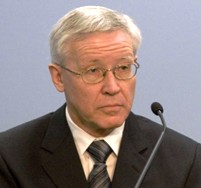
|  |
the manner of death – was it natural or due to some criminal act.
Over the course of the 1990s, Dr. Smith's reputation grew – but public concerns about his professional competence did as well. As early as 1991, a 12-year-old babysitter, referred to as SM, was charged with manslaughter in the death of a 16 month-old girl, Amber, in Timmins, Ontario. The babysitter said that Amber had accidentally fallen down a flight of carpet-covered stairs. No autopsy was considered necessary, and the coroner ruled the death as accidental.
Doctor Smith and some colleagues disagreed, and permission was eventually given for an exhumation. Smith carried out the autopsy, though he had little formal education or experience in forensics. He reported that Amber had died of a head injury caused by severe shaking. Two days later, the police arrested and charged SM with manslaughter.
SM’s father, referred to as DM, did not believe for a moment that his 12-year-old, straight-A, Grade 6 daughter, was guilty. He knew that there had to be something wrong with the evidence as presented. He was a chemist working for a mining company and he put his research skills to work for the next two years.
He read scientific journals on neuropathology and biomechanics, and studied papers on infant head injuries and Shaken Baby Syndrome. The family remortgaged their house twice, cashed in their RRSPs and finally sold the house. The money went to paying the expenses of specialists in the field, and later for the costs of mounting a legal defence. The family had to declare bankruptcy when their money ran out. SM had a hard time over this period, she felt stigmatised (everyone in the small northern town knew the story) – she became depressed and her school grades dropped.
In all, DM found nineteen experts from around the world whose research supported his daughter, and nine of those gave evidence at the trial which took almost two years to complete. The family covered the costs of all nine – including neuropathologists, biomechanics experts and pediatricians specializing in child abuse – to fly to Timmins for the trial. In addition, written opinions from others were provided to the court. The trial was heard before Justice Patrick Dunn of the Ontario Court (Provincial Division), and the star witness was Dr. Smith.
Justice Dunn duly delivered his verdict. He found the young babysitter not guilty, finding that her explanation that Amber had fallen down the stairs was credible and accepted the defence experts' evidence that small household falls could cause serious injury or death in a child as young as Amber. In giving his verdict he said, "When first presented, the Crown's case appeared quite plausible. But after the evidence of the defence experts, it is riddled with reasonable doubts."
He emphatically rejected Dr. Smith's evidence. In a detailed and trenchant review of Smith's forensic analysis and approach, Justice Dunn concluded that he lacked objectivity, failed to investigate thoroughly all relevant facts, and neglected to keep adequate records of his work and findings. He also determined that Dr. Smith lacked familiarity with the relevant scientific literature. The issues raised by the judge regarding the quality of Dr. Smith’s evidence and his lack of experience in the field were brought to the attention of his superiors, and the College of Physicians and Surgeons of Ontario (CPSO).
No meaningful action resulted and Dr. Smith’s work on high-profile cases continued unabated.
(To be continued…)
|
|
 |
 |
My First Game
Gordon Findlay |
 |
 |
The day of my first rugby game for the Depot 1st XV arrived. Getting to the game against REME – the Royal Electrical & Mechanical Engineers was simple – the whole Military Police team was loaded into a couple of 3-ton Army trucks with simple bench seats lined up on opposite sides under the canvas. Sheldrake, and a lieutenant who also played for Depot XV Military Police, rode in the passenger seat of the truck, up front, while we lowly recruits bumped around in the back.
I had a decent game against REME, but they stuck me in at the back row of the scrum – while I was used to playing as an inside or outside centre, where I could use my speed. Oh well. I blasted away from the scrum at every opportunity and managed to get involved in some of the passing plays with the backs, my normal position.
It wasn’t a particularly good game for either side since the field was sopping wet, but we did win, and everyone was in a good mood. We were hoping for a massive feed and piss-up after the game – but no such luck. REME did feed us, and it was somewhat better than the usual Army grub – but really just a good Irish stew with spuds, with plum duff to follow.
On the positive side, they did allow us each a couple of pints of beer before the food – but with typical Army idiocy, the beer was handed to us as we stood around outside the Mess Hall, so we had to quaff it standing around outside. The reason given was: “Can’t allow booze in the Mess Hall, lads. Army regulations, you know. And try not to let the other lads going in see what you’ve got.”
So, we had to stand outside the Mess Hall, hiding our bottles of Tennant’s Lager as best we could from the REME recruits walking past on their way in for dinner. Sgt. Sheldrake and the Lieutenant, of course, were comfortably installed in the Sergeant’s Mess and the Officers’ Club respectively, for their drinks and meal.
However, a week or so later, I heard that my name was posted on the bulletin board for the next game for Depot Military Police against RAMC – Royal Army Medical Corps. And if you think that a bunch of doctors and front-line medics and assistants would be a pushover – quite the opposite. They had an excellent team since many of the doctors were graduates of private schools and had played inter-school and Former Pupil rugby like me. But I was delighted to be chosen again.
|
British Army Cap Badges |
|
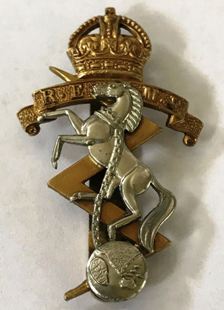 |
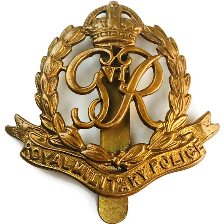 |
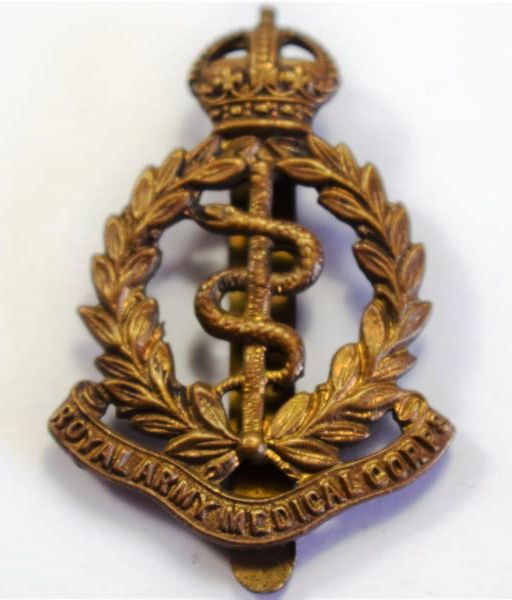 |
| REME |
Royal Military Police |
RAMC |
By this time my dear parents (I'd kept them posted on my life in the Military Police) had mailed me my own rugby boots (Elmer Cotton “Fleets” for the record: a high-end solid leather pair of rugby boot with removable cleats, which were an innovation way back then). So, I didn’t have to depend on the cheap and crappy military-issue rugby boots from the company store. And, even better, when I went to check my name on the official team sheet, I saw that I was written in as an inside centre, paired up with Lieutenant Lennan, a dark-haired Welsh officer who had been a trialist for Cardiff, a team in the Welsh League, and was one of the bright lights of our side.
We didn’t win our game against RAMC but thanks to Lieut. Lennan I scored a try – the one and only try I managed to score in Army life. The good Lieutenant had great speed and midway through the second half took a pass from the stand-off (he’s like the quarterback in football) and burst away from his RAMC opposite number. Lennan then sprinted for the try-line (the “end zone” in football) and drew the fullback to him – slipped the ball to me – and all I had to do was run a few feet and touch down the ball for our score.
Funny how you remember things like that – the unselfish move of a fellow rugger player who makes a clean break, then sets you up for a score you simply cannot miss. The Lieutenant was unquestionably the class of our side and for me, it was a pleasure to play alongside him. Had we not been Lieutenant and Corporal – a huge gulf in Army terms – I think we could have been friends.
|
|
 |
 |
Acronymous Logic
Hugh McGrory |
 |
 |
I like acronyms. I find the good ones make communication more efficient and more effective. As you probably know, there are two ways that acronyms are created:
The best are when the initial letters of each significant word create a pronounceable word. An example would be NASA, for "National Aeronautics and Space Administration". If the resulting word has some relationship to the subject, so much the better... for example, a leadership program – LEAD, for Leadership Education and Development.
Some of the worst are when the inventors have the word they want as the acronym, then come up with some tortured phrase to justify it. An example is an organisation that I was once a member of LOGIC, for "Loyal Ontario Group Interested in Computers". I mean LOGIC is good, but come on... (how about "Lots of Geeks In Computing?")
I first used computers in 1968 when working for the Glenrothes New Town Corporation in Fife, Scotland. These were large mainframe computers in London and Manchester which processed data that we had coded by hand on paper forms and sent off to them in the mail – that’s snail mail, not email... We got the results by snail mail too...
For me, this early experience with computers was frustrating, but also enlightening and exciting. It changed my life, and, though I didn’t realise it immediately, resulted in a career based on the use of computers as tools for engineering and business.
We emigrated to Toronto in 1966, and by the early to mid '70s microcomputers began to appear – small desktop-sized machines which were used initially for game-playing.
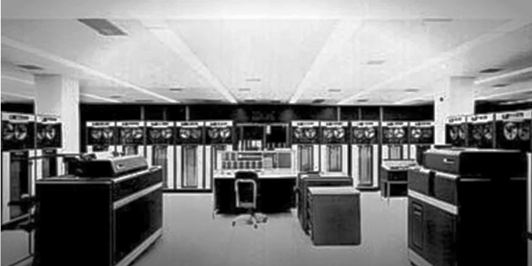
|  |

|
| IBM 7090 Mainframe Room |
 |
Apple II Plus Desktop |
By the late '70s, Apple computers were on the scene and the Apple II Plus was becoming a useful tool for the business world. I persuaded my boss to allow me to buy one and use it at home while I figured out what it could do for us.
Such micros were so new that many people were struggling to learn how to use them and many user groups – such as LOGIC – were formed. As was typical, LOGIC began from a small number of early adopters who had casual contact with each other and shared ideas and assistance. They were an eclectic bunch – lawyers, engineers, doctors, taxi drivers, university students, drop-outs – all with a bit of the geek in them...
As more people became interested, they decided to organise, appointed a President, a Secretary and Treasurer, then organised monthly meetings. (Founded in the early '80s, I was amazed to learn, while researching this story that it was a going concern until 2017!)
I attended quite a few of the sessions in the early '80s – the meetings usually took the format of a presentation by one of the early adopters (who were a year or so ahead of most of us), a Q&A afterwards,
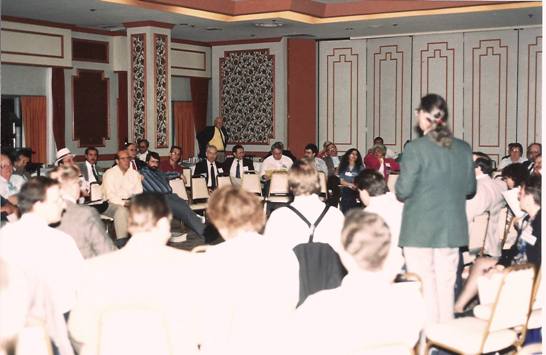 |
| Typical Computer User Group 'Back in the Day' |
then a lot of informal discussions over coffee. I found the meetings to be well worth attending – they often saved me from reinventing wheels...
One of those 'early adopters' was a fellow named Smith. I never actually knew him, but I listened to a couple of good presentations by him and had one brief conversation with him afterwards.
Over the following thirty years his name would become known all across Canada – which, come to think about it, is the story I actually set out to tell – ah well, next time...
|
|
 |
 |
A Ski Trip Down Memory Lane
Murray Hackney |
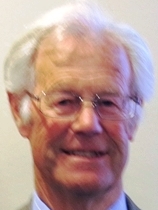 |
 |
Gordon Findlay’s recent story, ‘Skiing in Scotland’, reminded me of my last ski trip up Glenshee. I do remember the rope tow which would give the present day Health and Safety Police a heart attack. The secret was the 'Hookum' a very simple thing! The tow was simply an endless rope, pulleys at top and bottom of the hill, and your hookup was a handle with a 'u' shaped metal hook, a bit like a paint roller without the roller! As you can imagine, when you dropped it over the rope, your weight jammed it, and off you went, hanging on, skis on the snow all the way up.
Easy until you tried to get it off before it was pulled round the top pulley – the technique was to release the tension a wee bit and lift, and if you got it right you were free to go, but if timed wrongly, your hookum could be retrieved from the other side of the wheel. No sweat if it was handheld, but woe betide those who chose to tie it to a rope round the waist! Chances of nipped fingers or even worse were quite high.
But that's not what caused me to stop skiing ( even before I got any good at it). Getting up the hills by car towards Glas Maol (grey-green hill), Gulabin (a Lodge and Outdoor Centre) etc. was fraught with problems in those '50/'60s days. The roads were sometimes ploughed, but not too well, so often you were faced with a slippery and steep surface.
At the most difficult parts collective action came into force, which involved a combination of pushing and bouncing on the boot to gain some traction. Worked most times, but then along came the Mini. First front wheel drive car around here and not good at climbing icy slopes. So, the answer was to REVERSE up the difficult bits with two people sitting on the bonnet to give more weight on the driven wheels.
I don't know if you have ever tried this, but believe me, when you’re facing downhill on a slippery bonnet you really have to hang on. The wipers are no help, so the front door pillar was the favourite handhold-provided the crude sliding window was open...Unfortunately the driver’s door was still open when I grabbed the pillar and the driver (who shall be nameless) slammed the door over my four fingers and took off, obviously looking the wrong way through the rear window.
Now luckily the Mini had pretty floppy window frames so, even though it was the hinge side, i.e., maximum
leverage, my fingers were not actually chopped off. No amount of banging on the windscreen could get the attention of the driver- he was determined to get to the top and the engine was near max revs in reverse. My biggest worry then was, if I fall off will I get dragged along, or will my fingers come off? Neither scenario appealed to me, so I was mightily relieved when we stopped on the brow of the hill. A doctor in another car looked at my fingers and pronounced them very bruised and swollen, but no breaks and some aspirin was prescribed from the first aid kit. Didn't help much, but my distraught driver volunteered to take me home at once.
I never went skiing again...
|
|
 |
 |
A Faint Memory
Hugh McGrory |
 |
 |
When I was young, up to the age of eight or so, I had an aversion to blood. Over that period, I blacked out several times. The sight of blood – particularly my own – would cause me to pass out. This is a reaction that was probably caused by vasovagal syncope – the term for a rapid drop in blood pressure and heart rate which can trigger fainting.
Apparently, it's not an uncommon problem – it’s estimated that 20% of all children will experience at least one episode of fainting before the end of adolescence, and the problem has a natural history of spontaneous resolution or improvement. I never saw a doctor and seemed to 'grow out of it' before reaching double-digits.
When my youngest daughter, Debbie, was around 11 or 12, in the late '70s, in Canada, I got a call at work saying that she had been in an accident and had been taken to hospital. It turned out that she and a girl friend had been sharing a bike, going down an incline, Sharon pedalling, and Debbie sitting on the handlebars and resting her bare feet on the ends of the front wheel axle…
Her left foot slipped off the axle and into the spokes – of course, the bike stopped instantly, and they cartwheeled over the front wheel onto the road. Fortunately, Sharon wasn’t badly hurt, but Debbie had a nasty wound to her foot. It was about two inches by one inch and went into the bone–and a spoke almost took her little toe off. She was taken to hospital by ambulance, treated, and sent home.
Apparently, according to her GP later, she received less than adequate treatment – in the days following, the wound began to swell and became more painful. She decided to try stepping on it without her crutch and the wound split open. Her mother took her to our GP who said she should take her to hospital – it would need surgical debridement to remove dying flesh and blood clots. I again got a call at work and headed for the hospital.
Debbie likes to tell people of that experience:
-------------------
“The nurse took us – me, mum, and dad – into a small examining room. I was asked to lie on the gurney (a wheeled stretcher) and, as my parents looked on, the nurse took off the bandage. The wound looked like liver, and she proceeded to clean it as best she could in preparation for the Doctor's examination – this included remouving some blood clots with forceps.
Suddenly she said to me, ”Debbie, will you please get up”, handed me my crutches then said, “Stand over there.” She then turned to my dad and said, “Will you please lie down”.
He looked puzzled and started to question her and she interrupted and said “Please – lie down now!” So he did…
She then said, “ You are looking very pale – I don’t want you blacking out and falling.”
So, for the next few minutes I, the patient, had to stand, while my father relaxed on the gurney with a pillow under his feet…”
-------------------
Oh, the ignominy…
Afterwards they told us that Debbie would have to have one more operation, plastic surgery to cover the
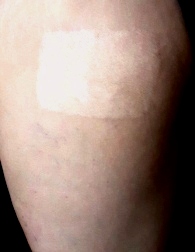 |
 |
damaged area. They removed a patch of skin from high on the outside of her left thigh and used this to cover the damaged area.
Actually, my memory of the above event is that I didn’t really feel faint at the time which was why I was surprised at the nurse’s reaction. She excused herself from the room, I lay there for a few minutes then got up, and felt fine.
Having said that, she was obviously an experienced professional, and may have
|
 |
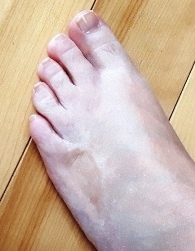 |
seen the initial signs of syncope (blood pressure drop, reducing circulation to the brain causing paleness, and possible loss of consciousness) brought on by the sight of my daughter’s wound – so maybe I was about to faint... I haven't had another occurrence in the past forty odd years, thank goodness – it's not a pleasant experience!
My mother in her old age blacked out several times – until they gave her a pacemaker. She described it as "Feeling a black wave coming over me." She called it "Having a floopie". No idea why...
|
|
| | |
